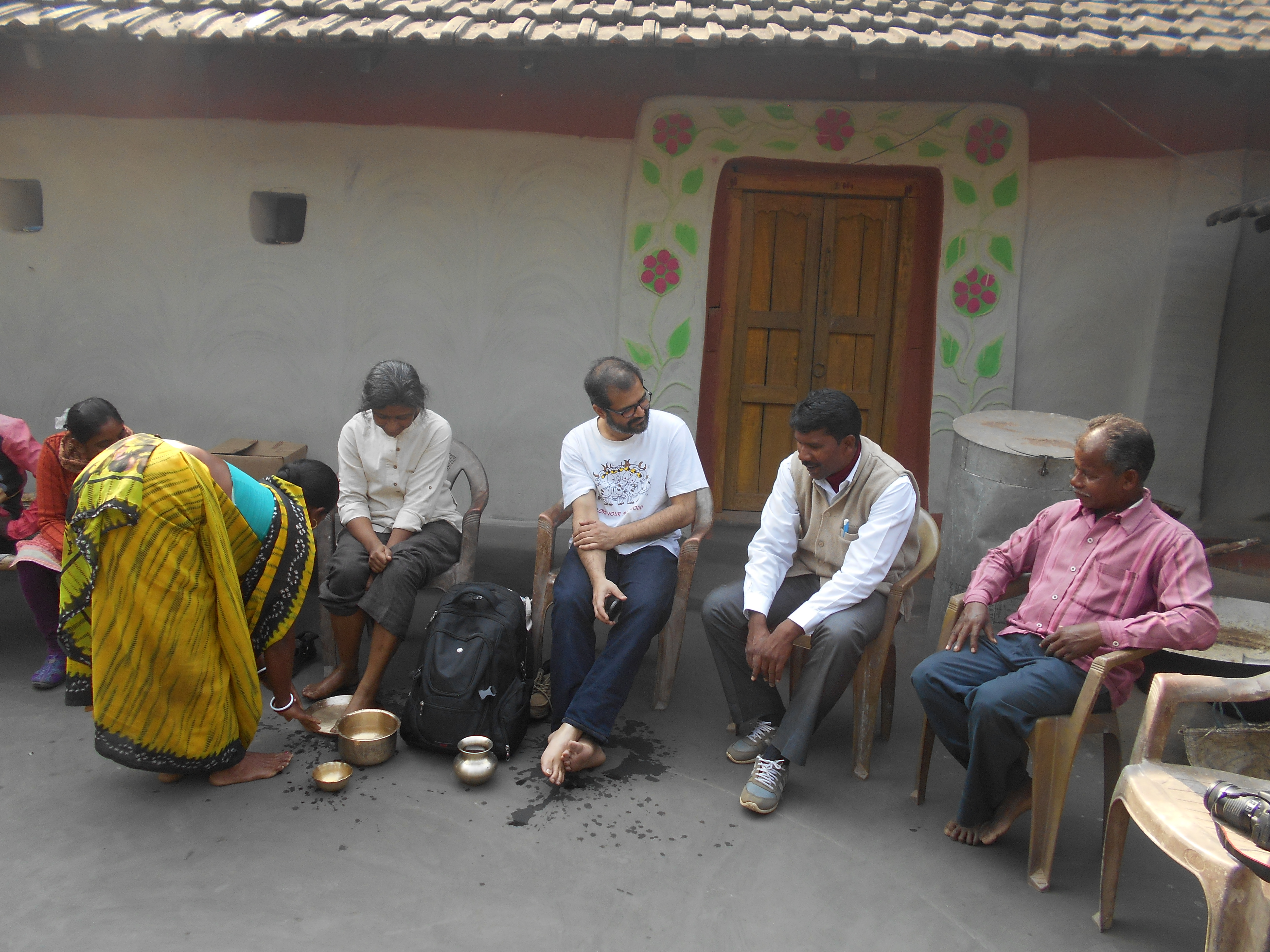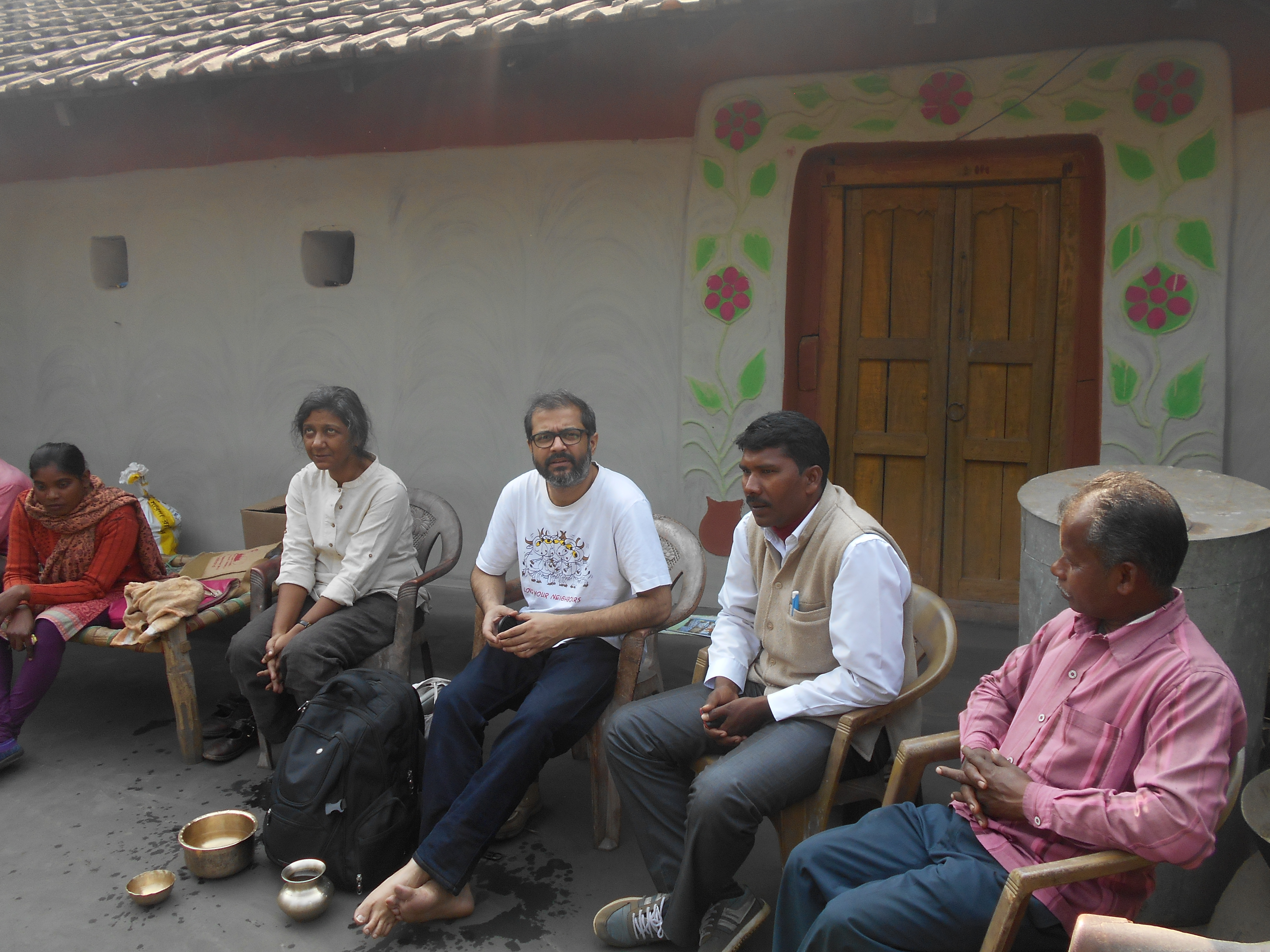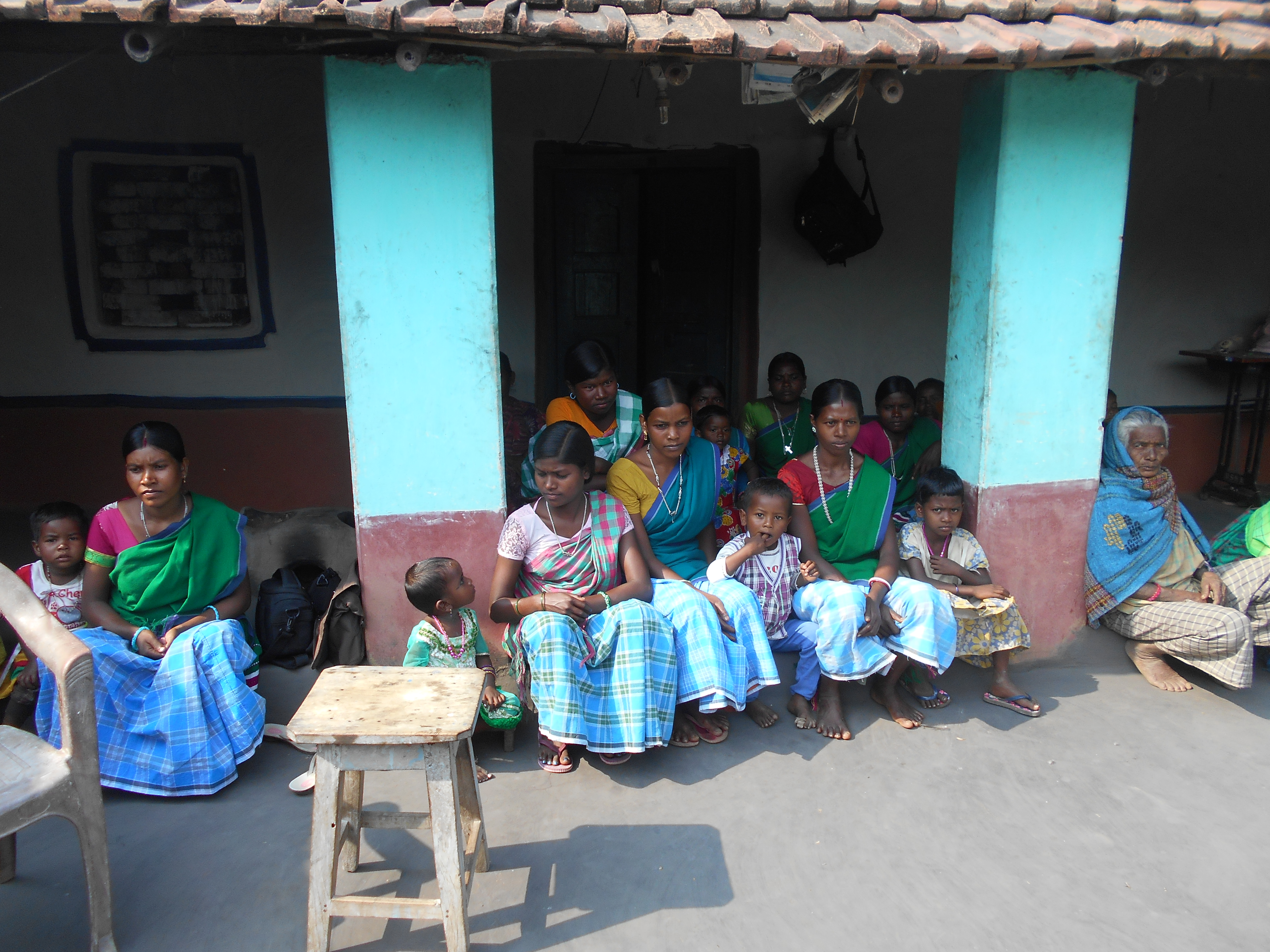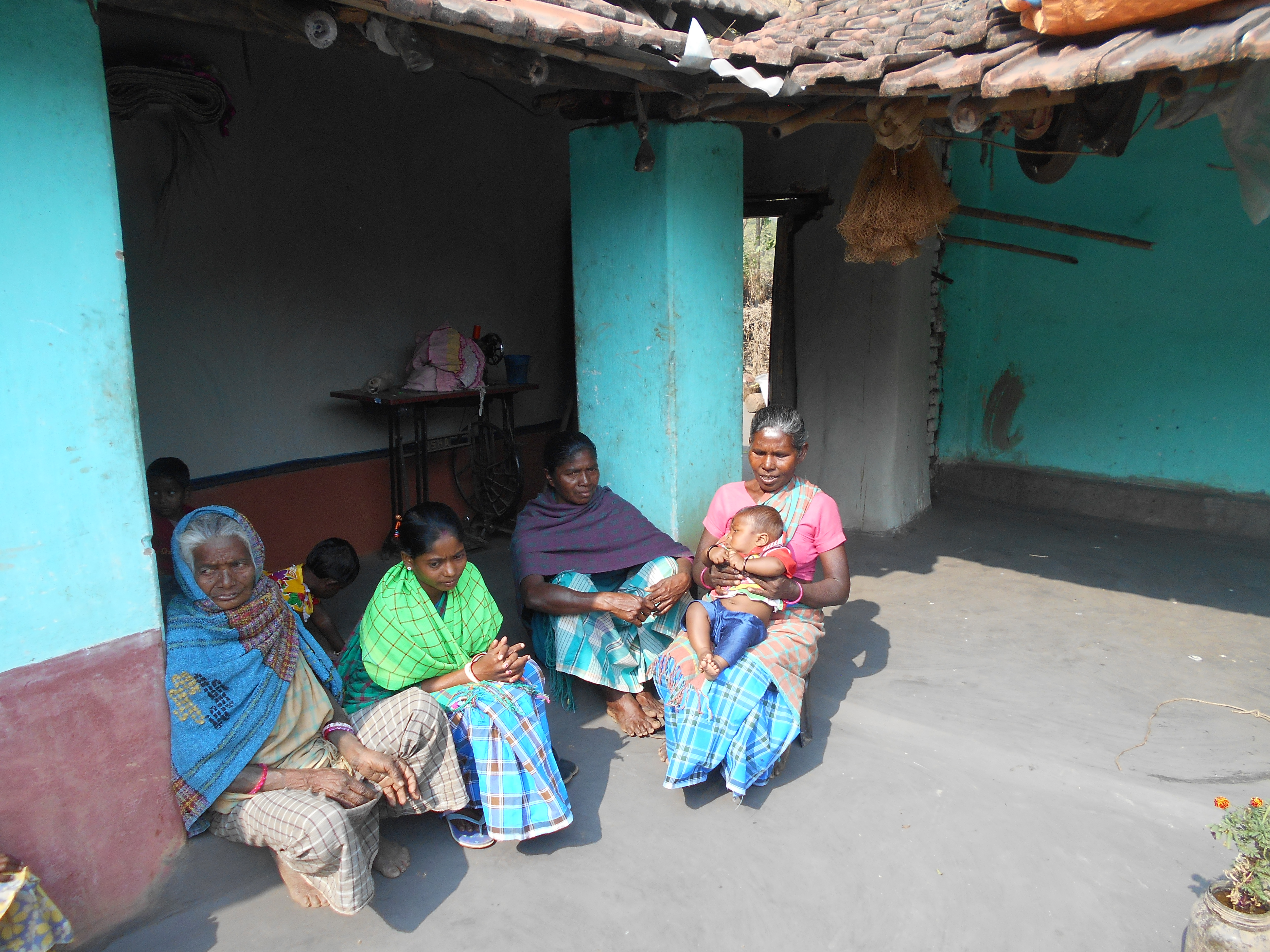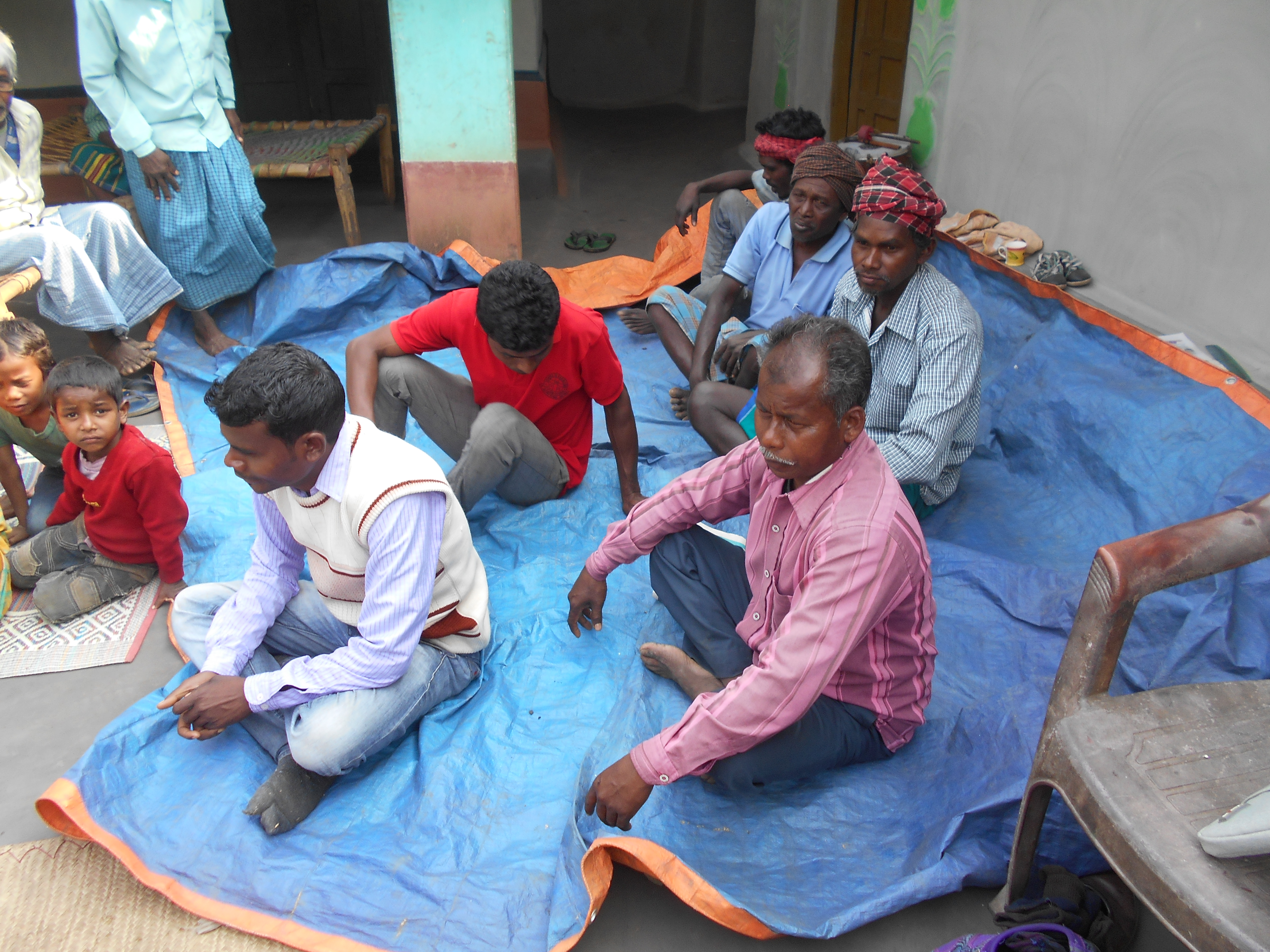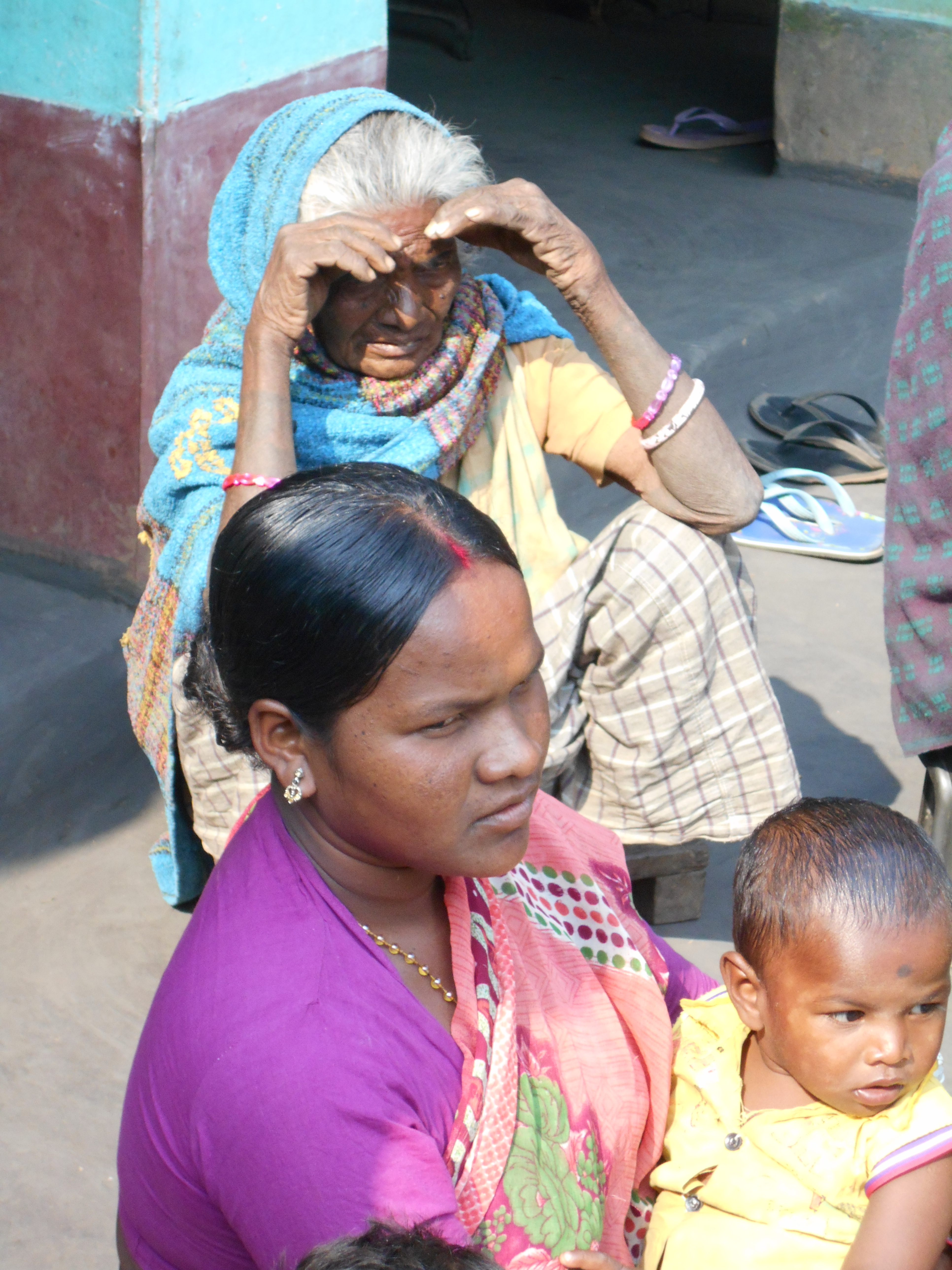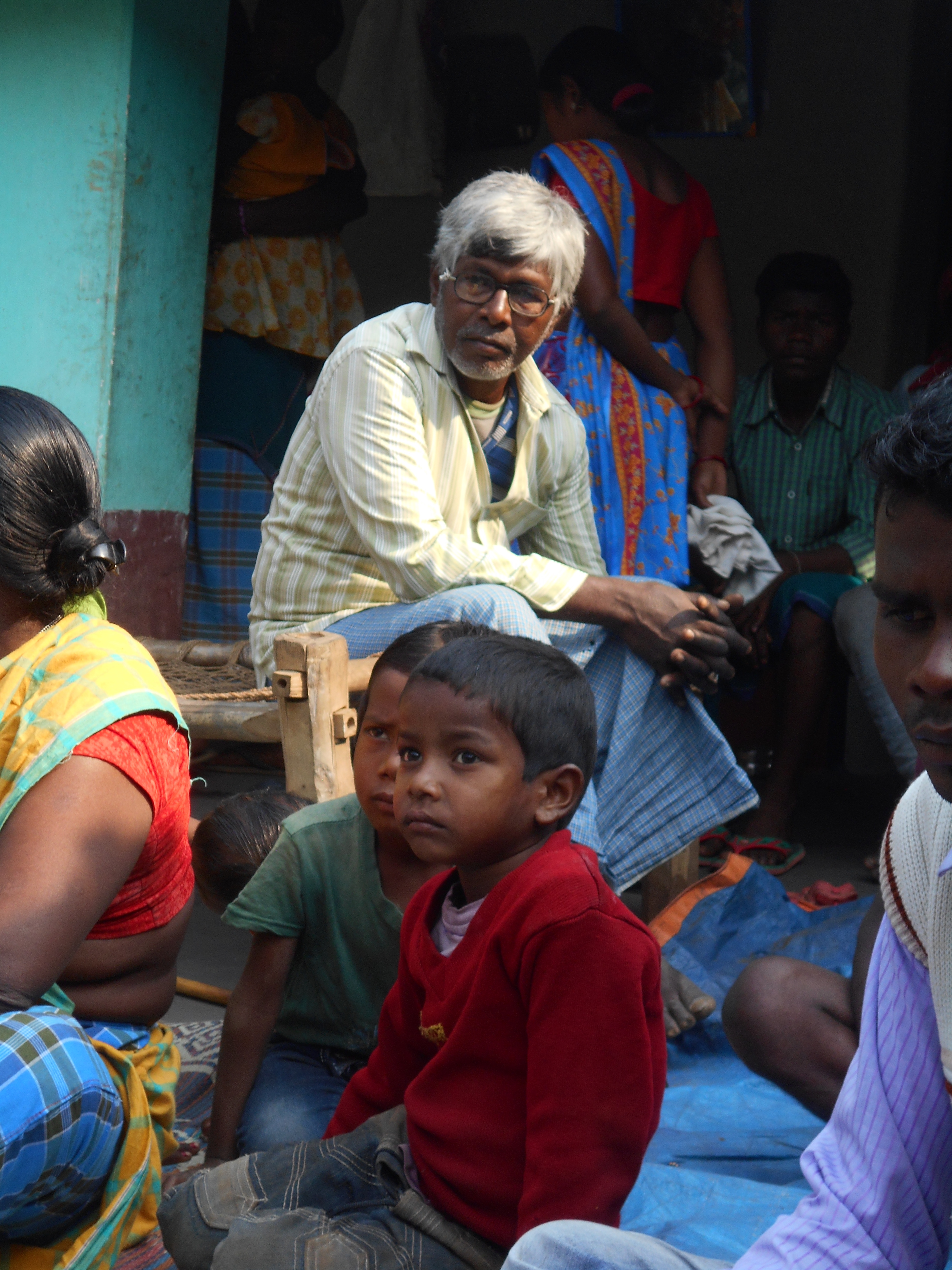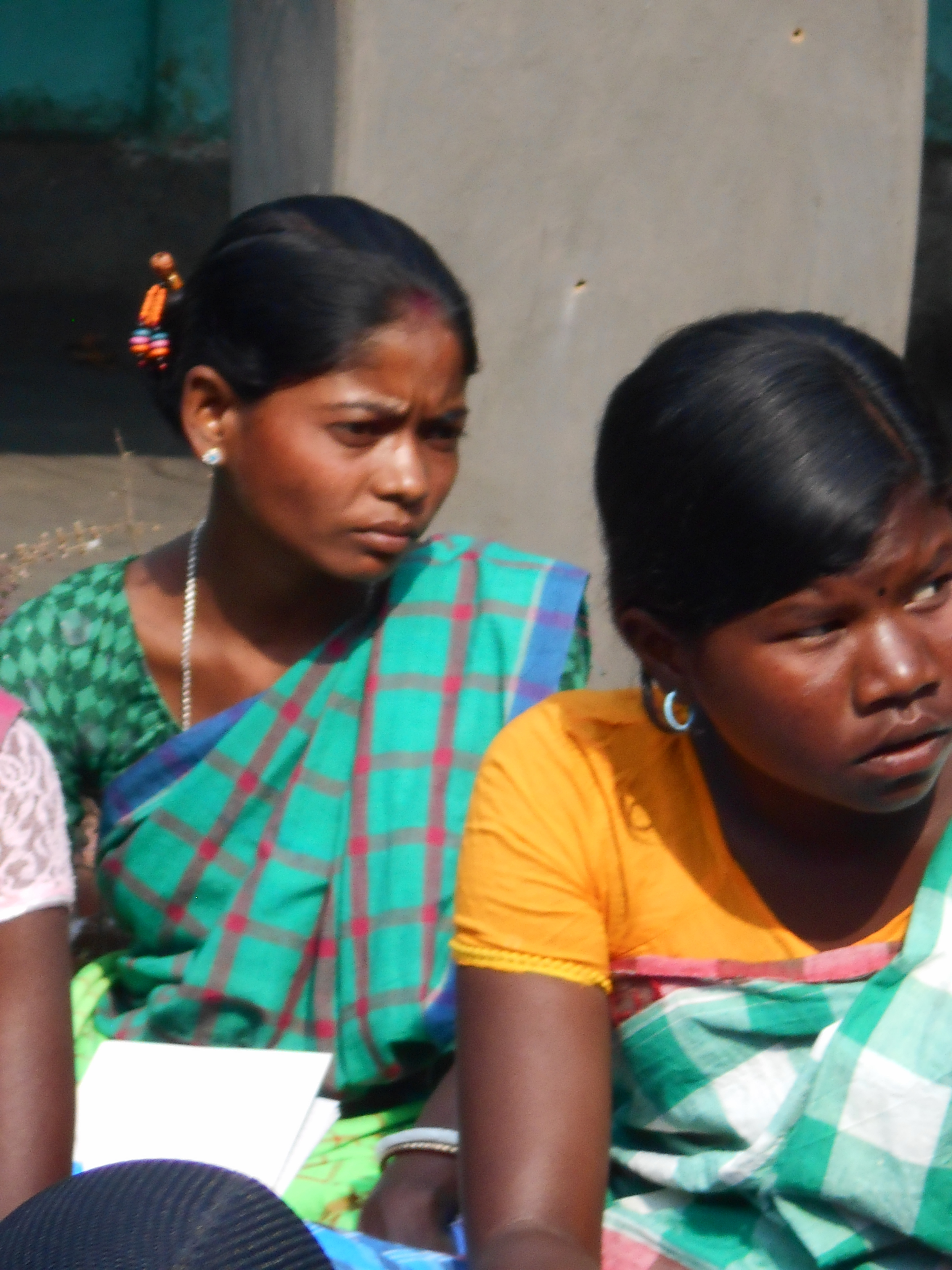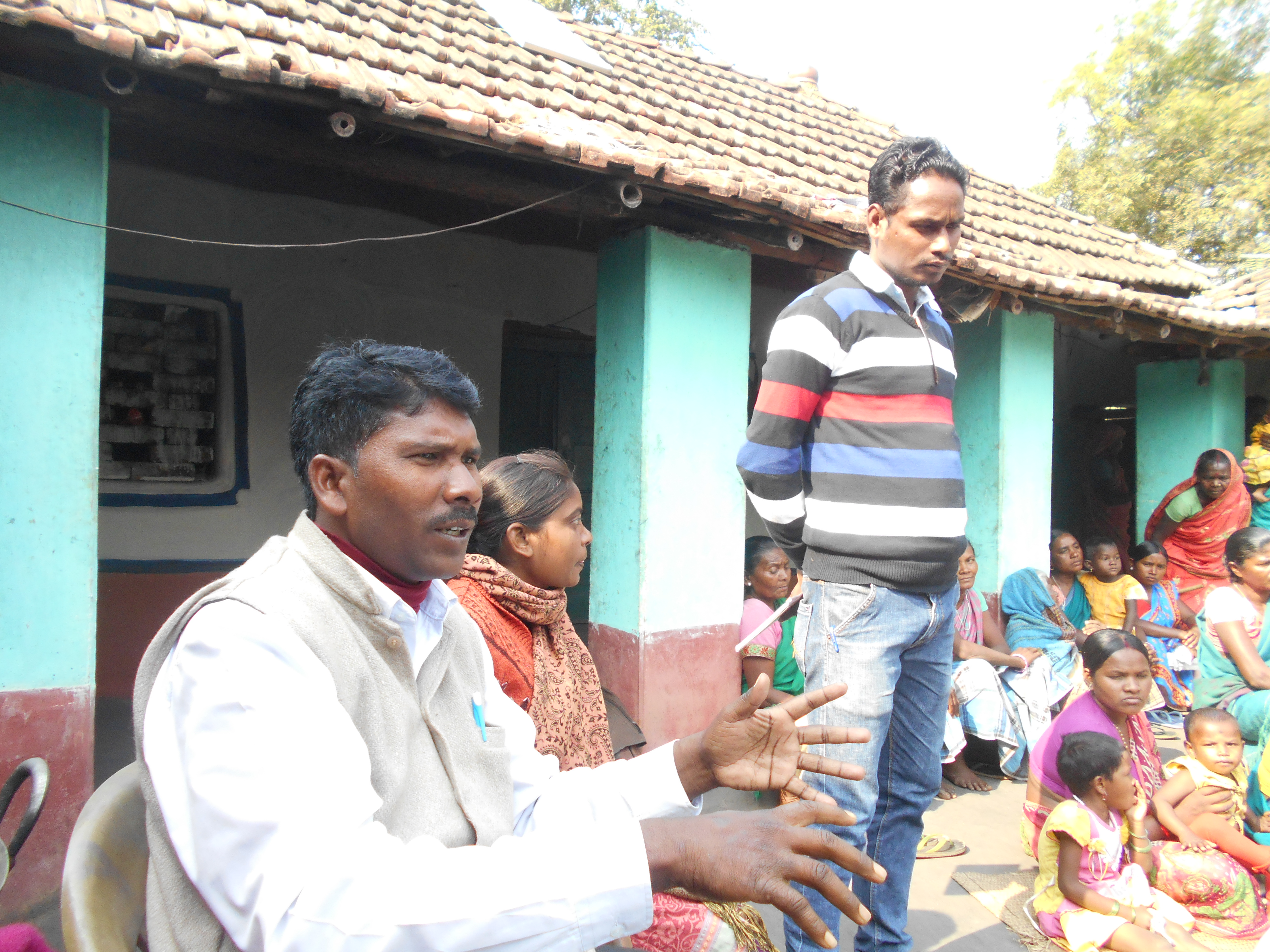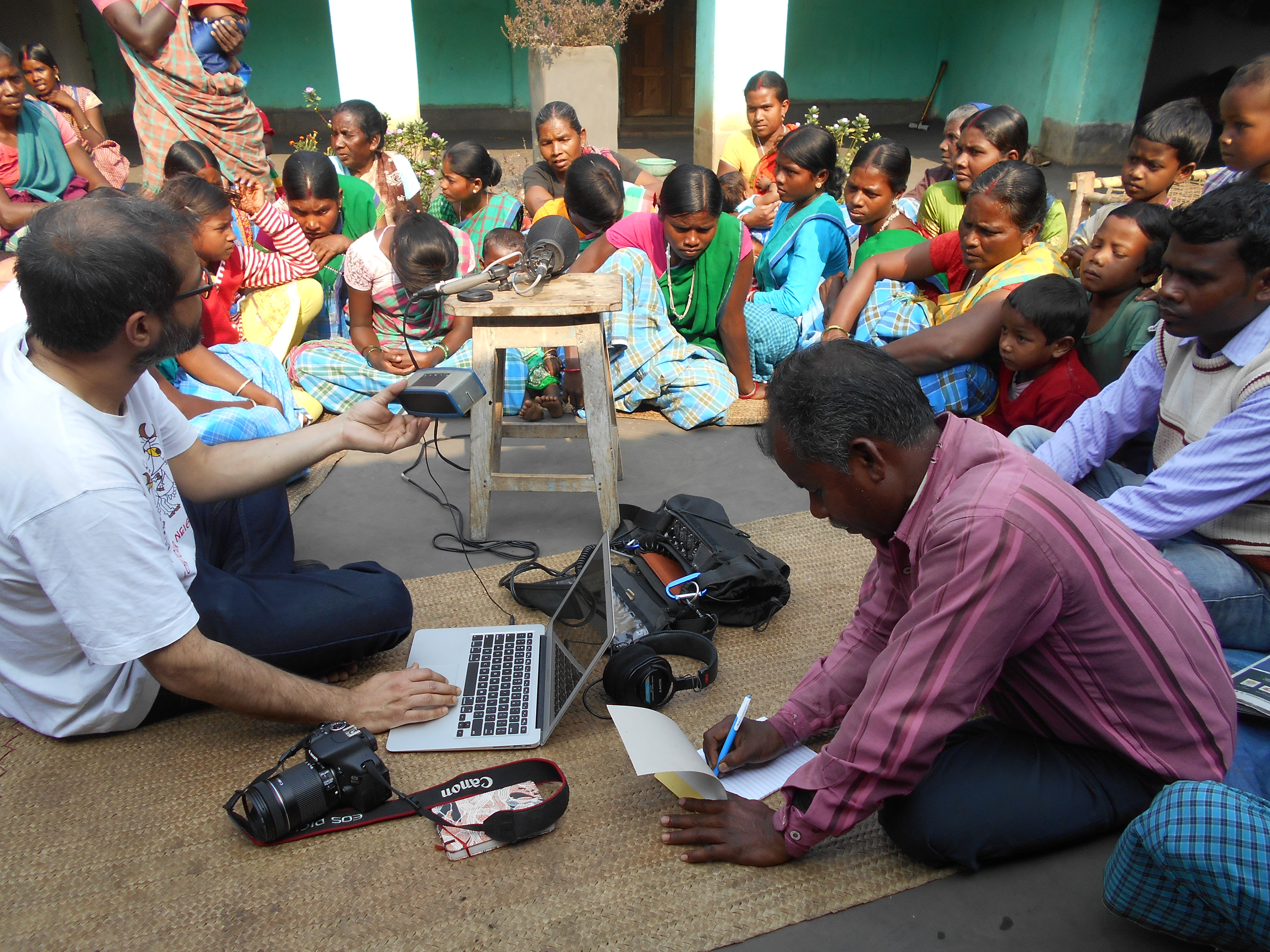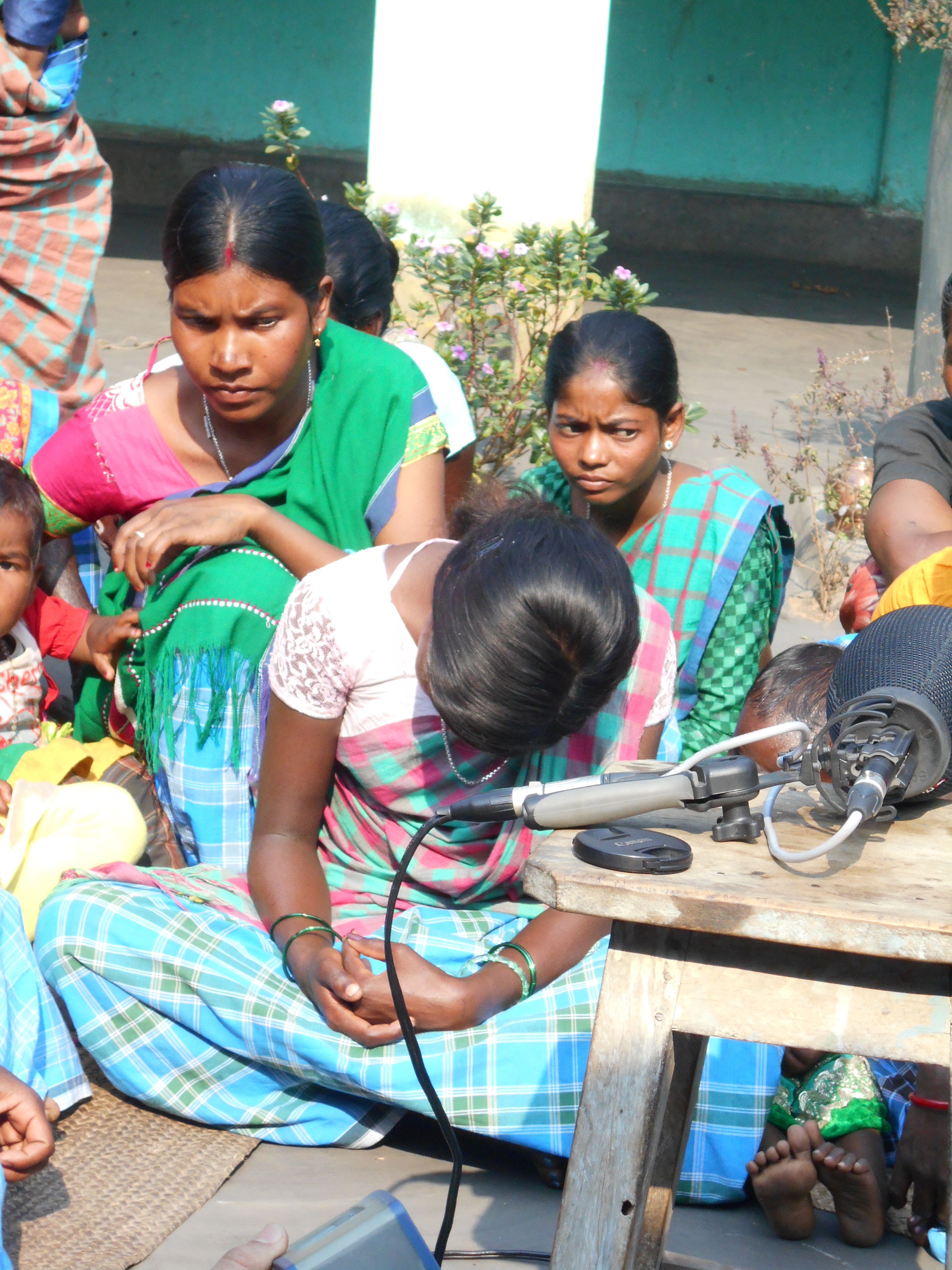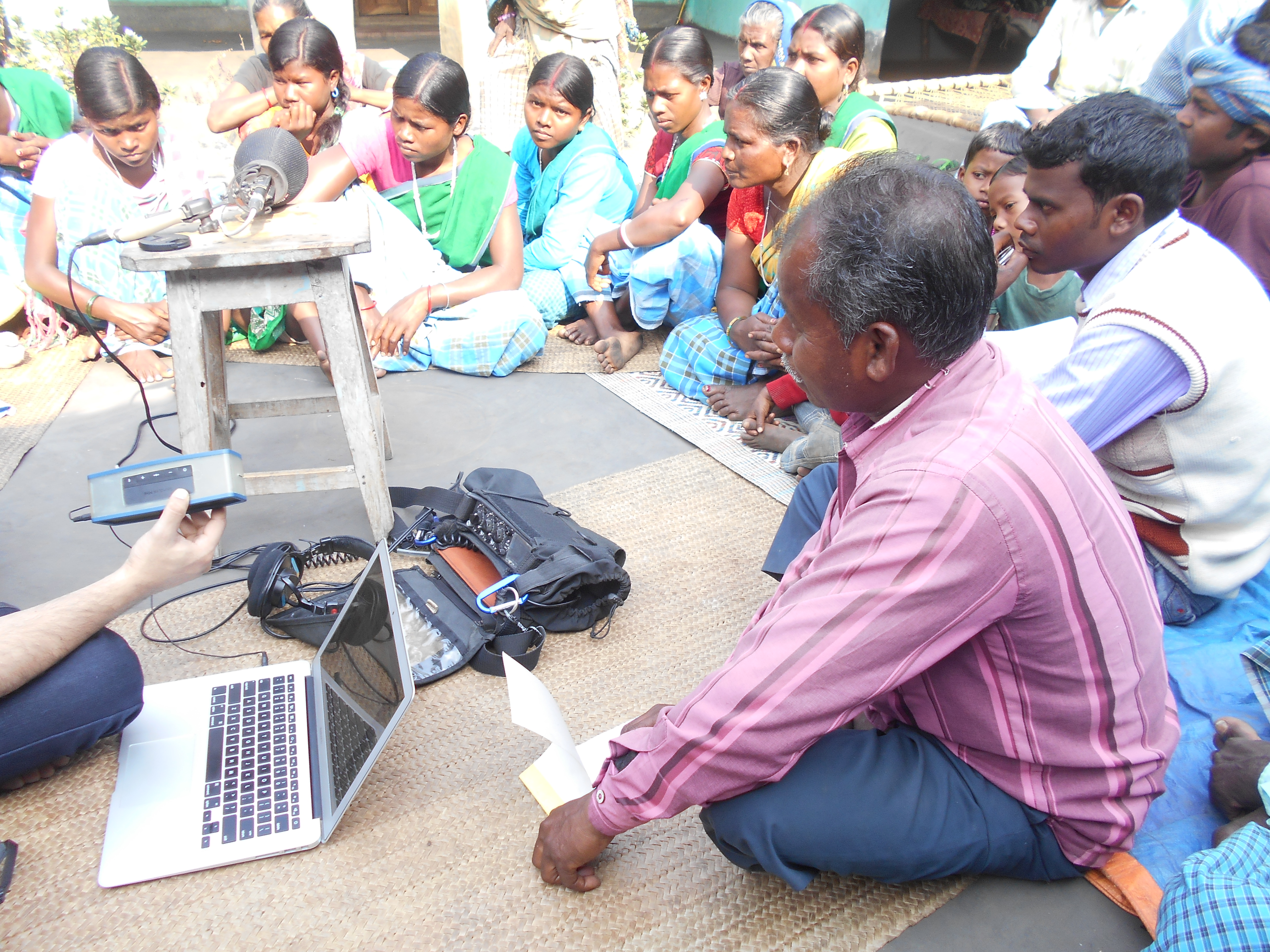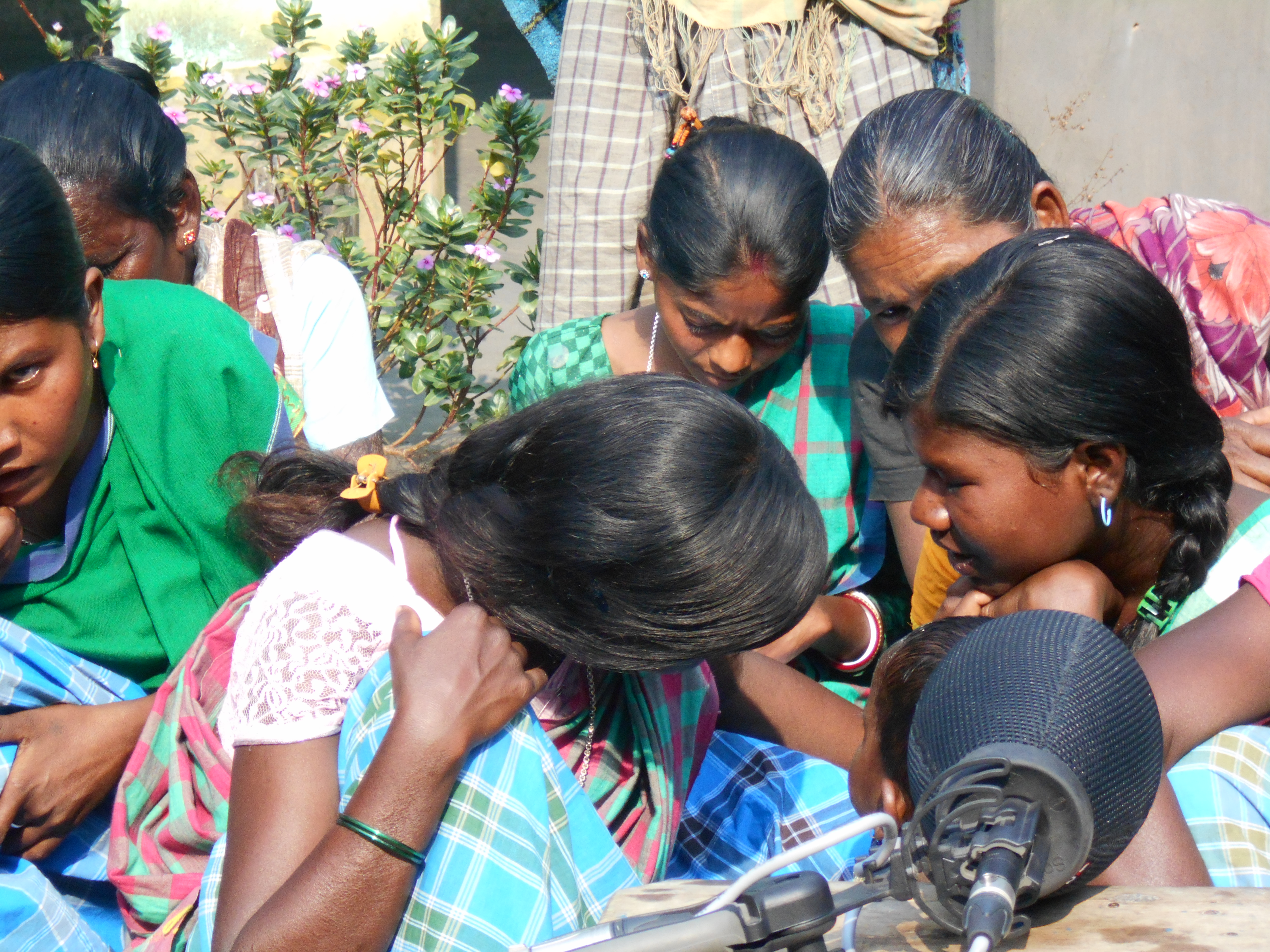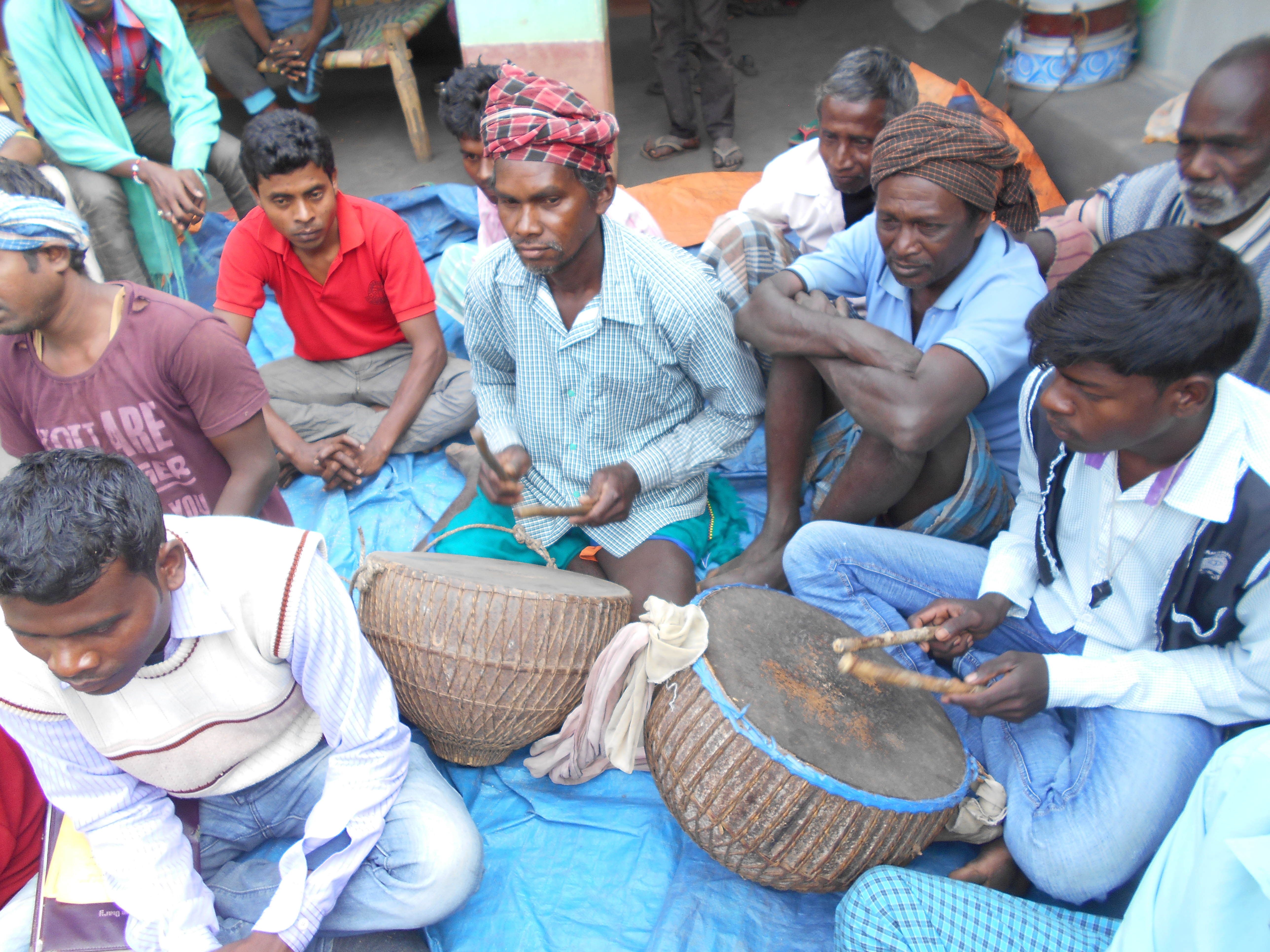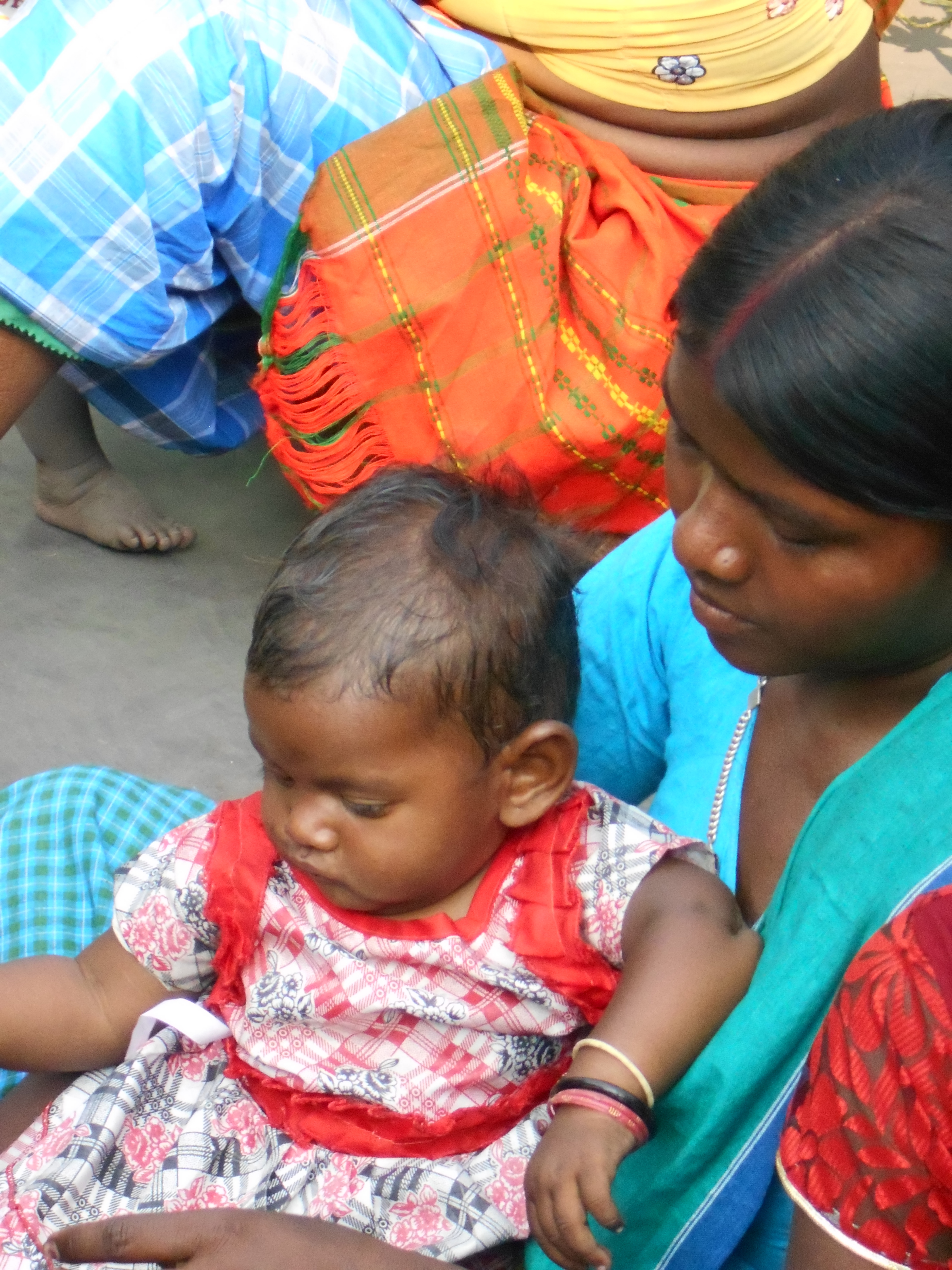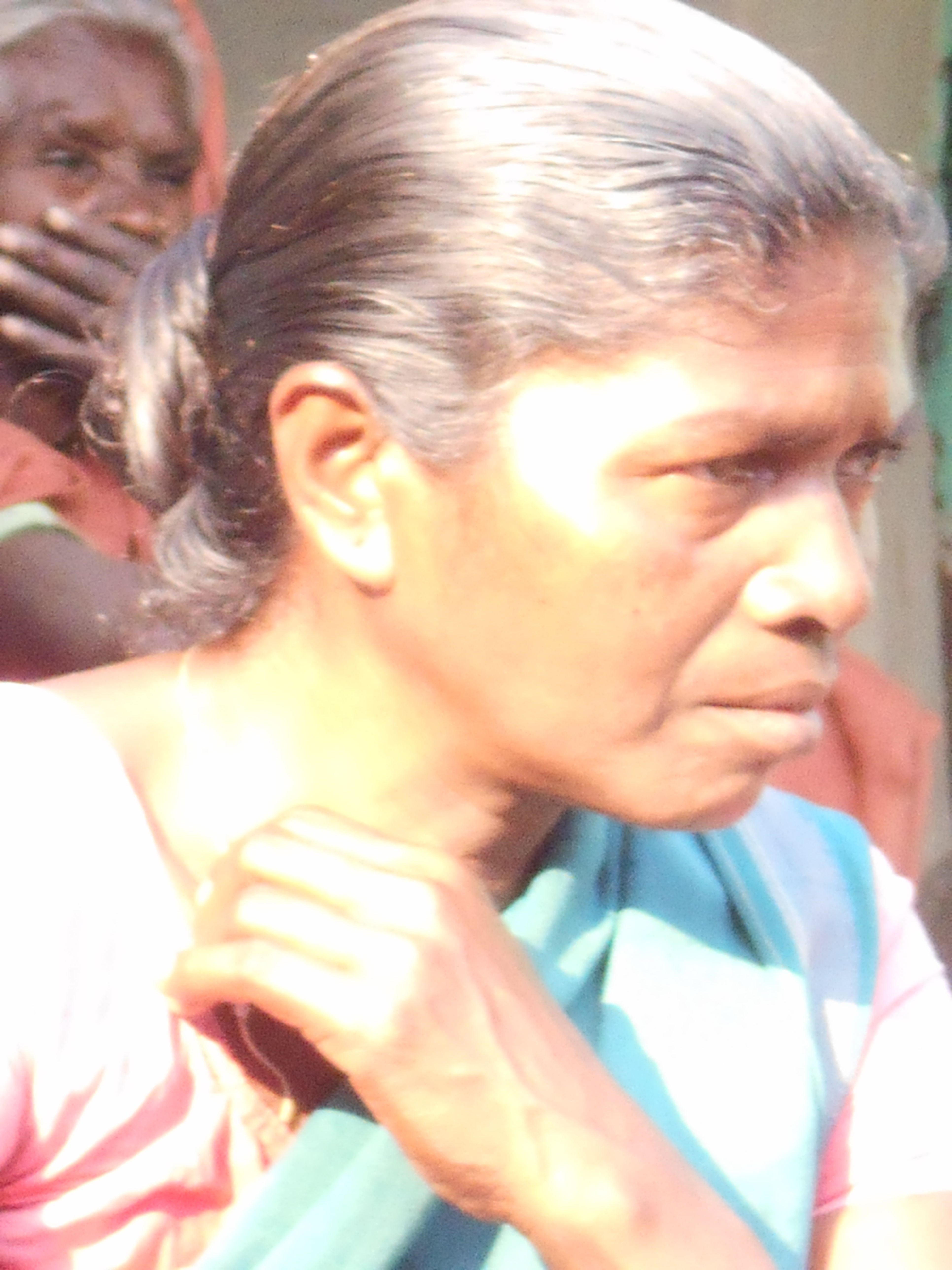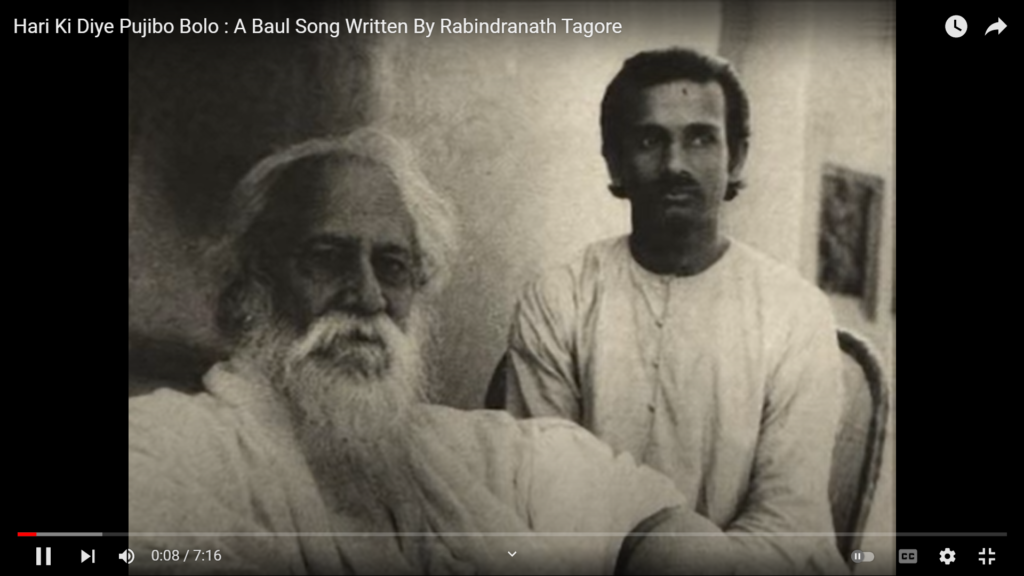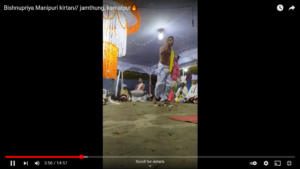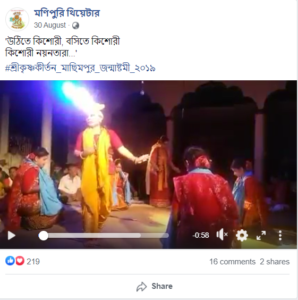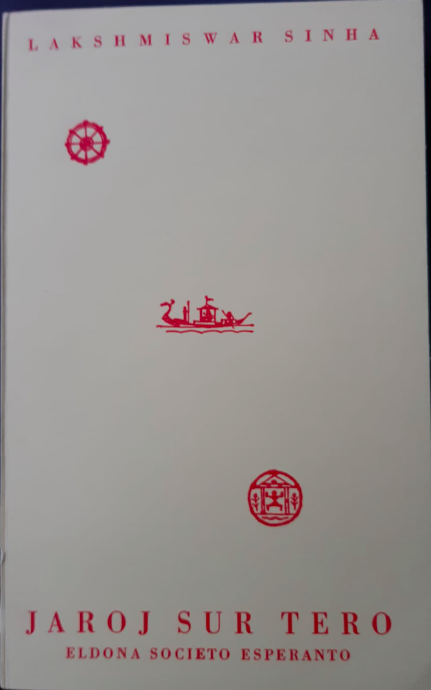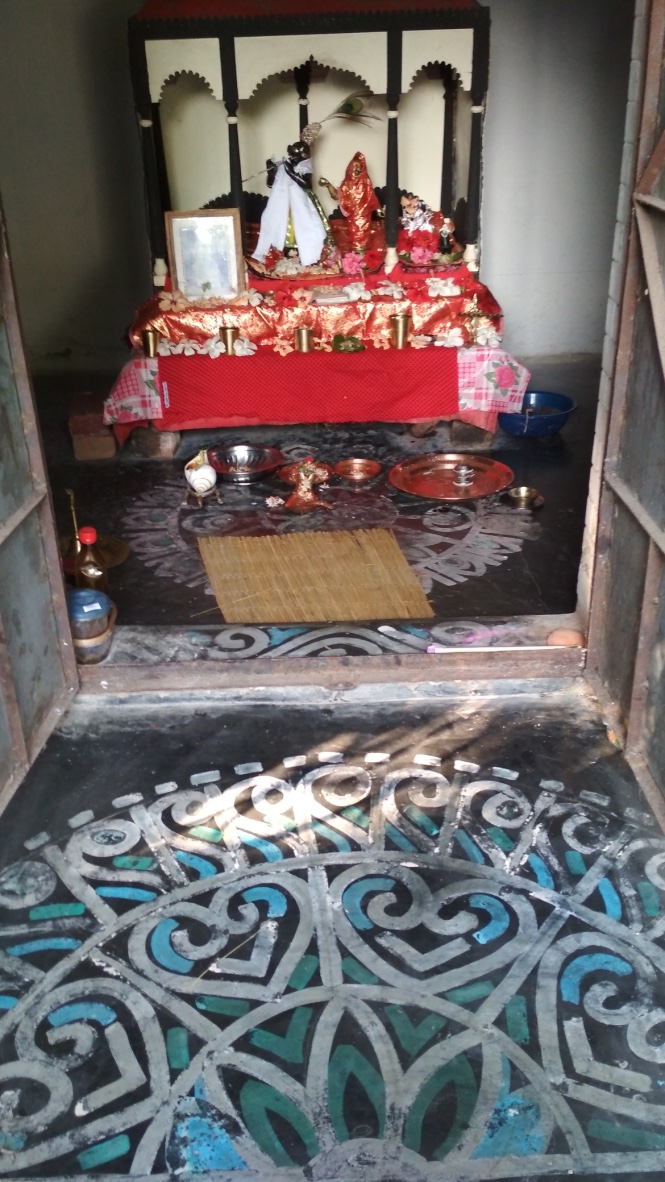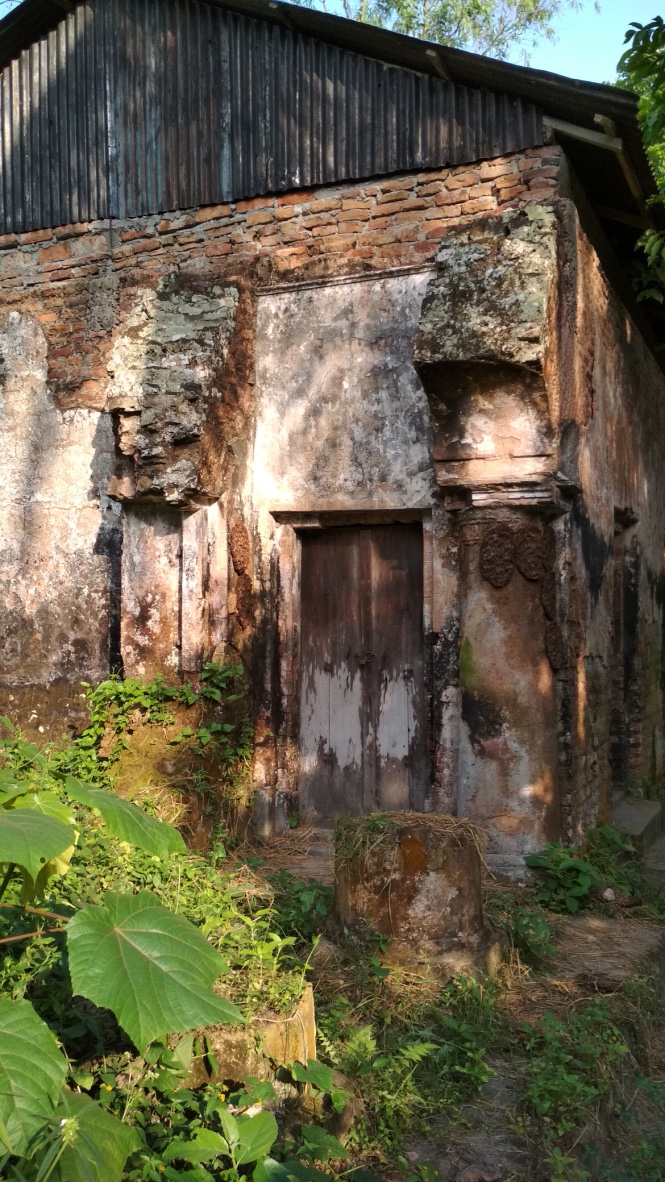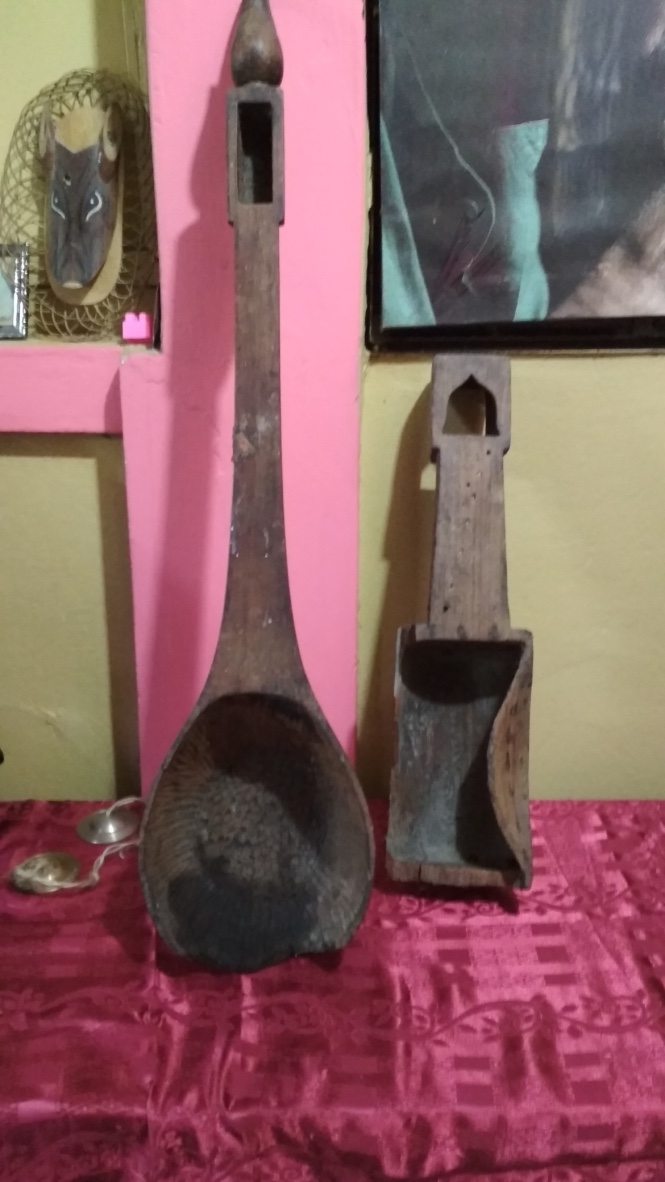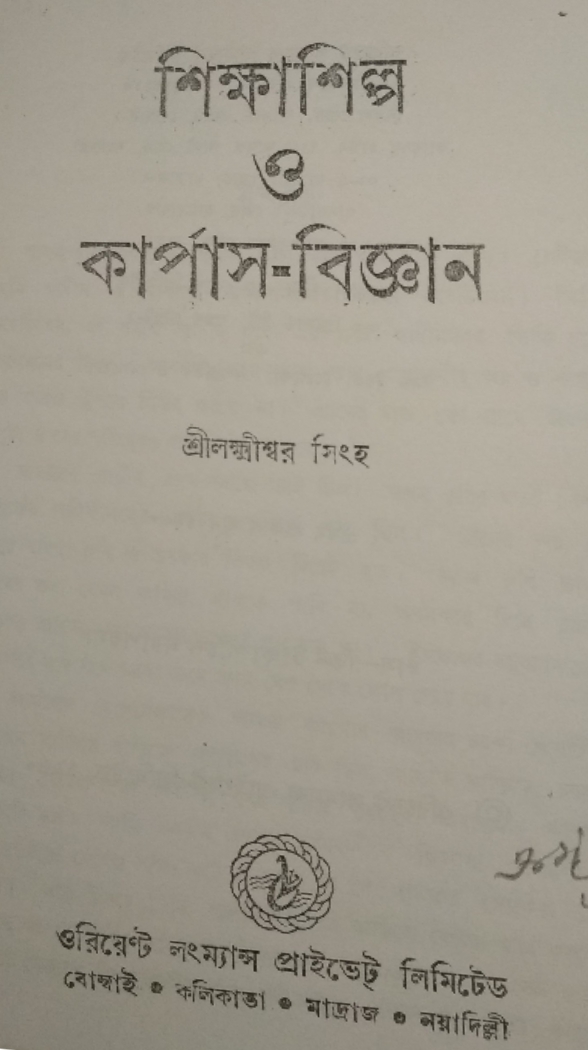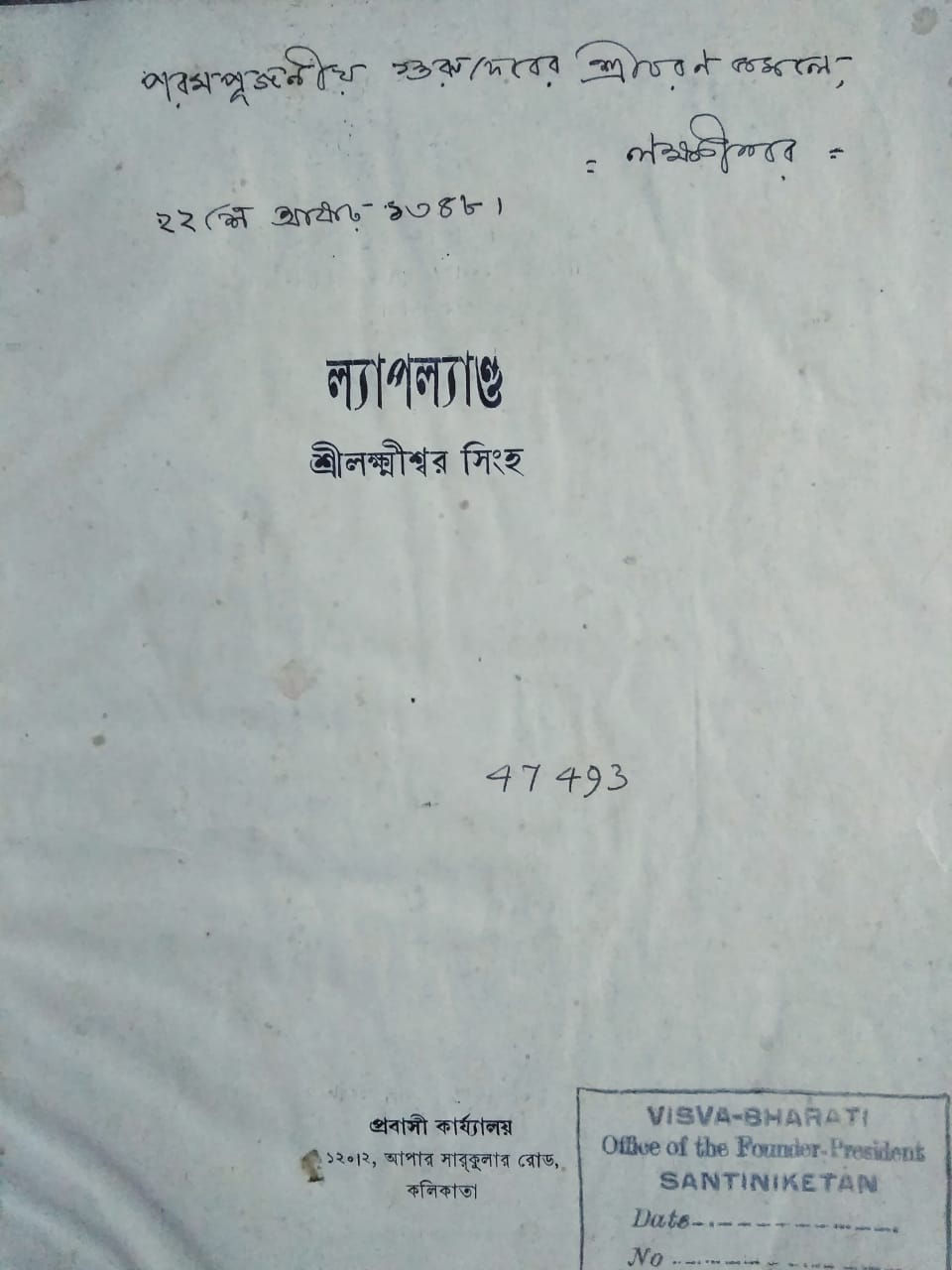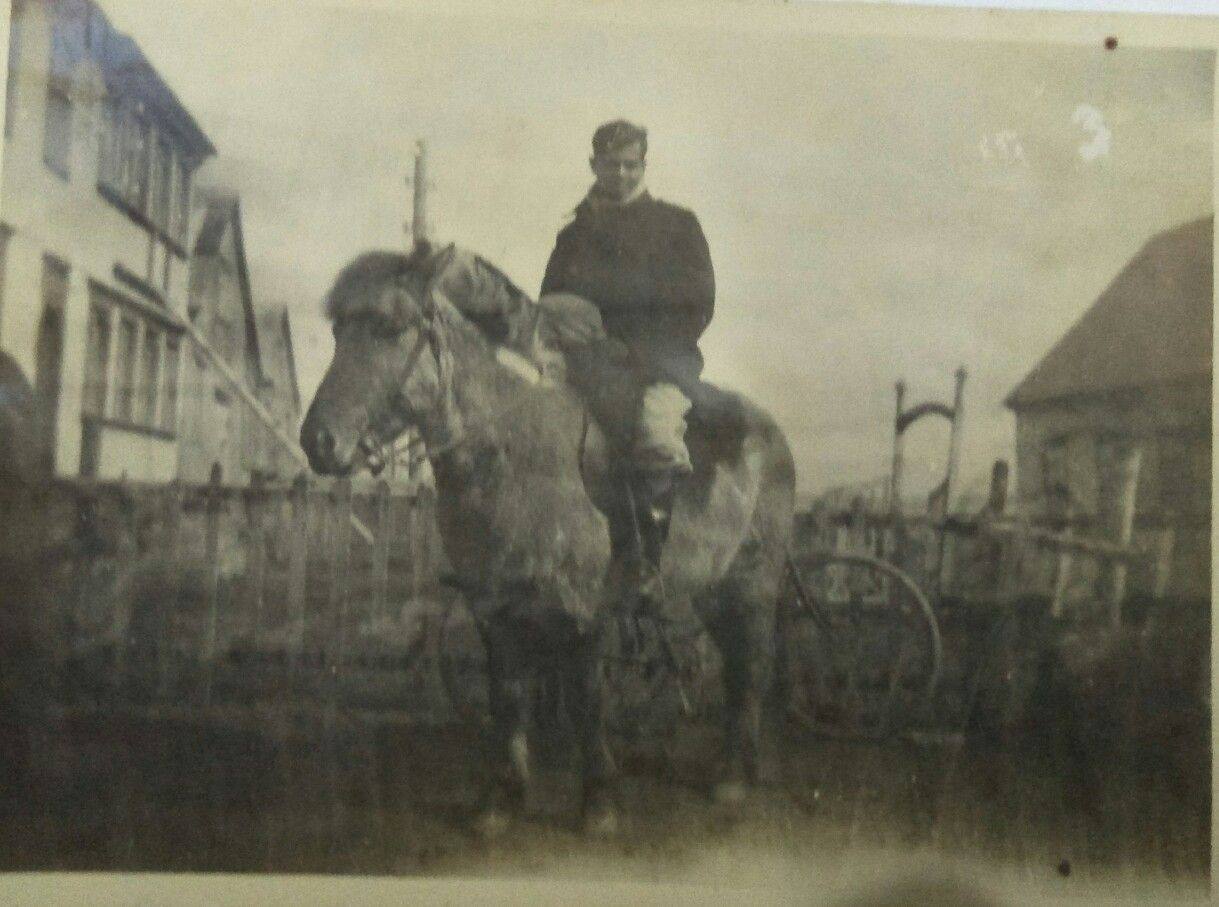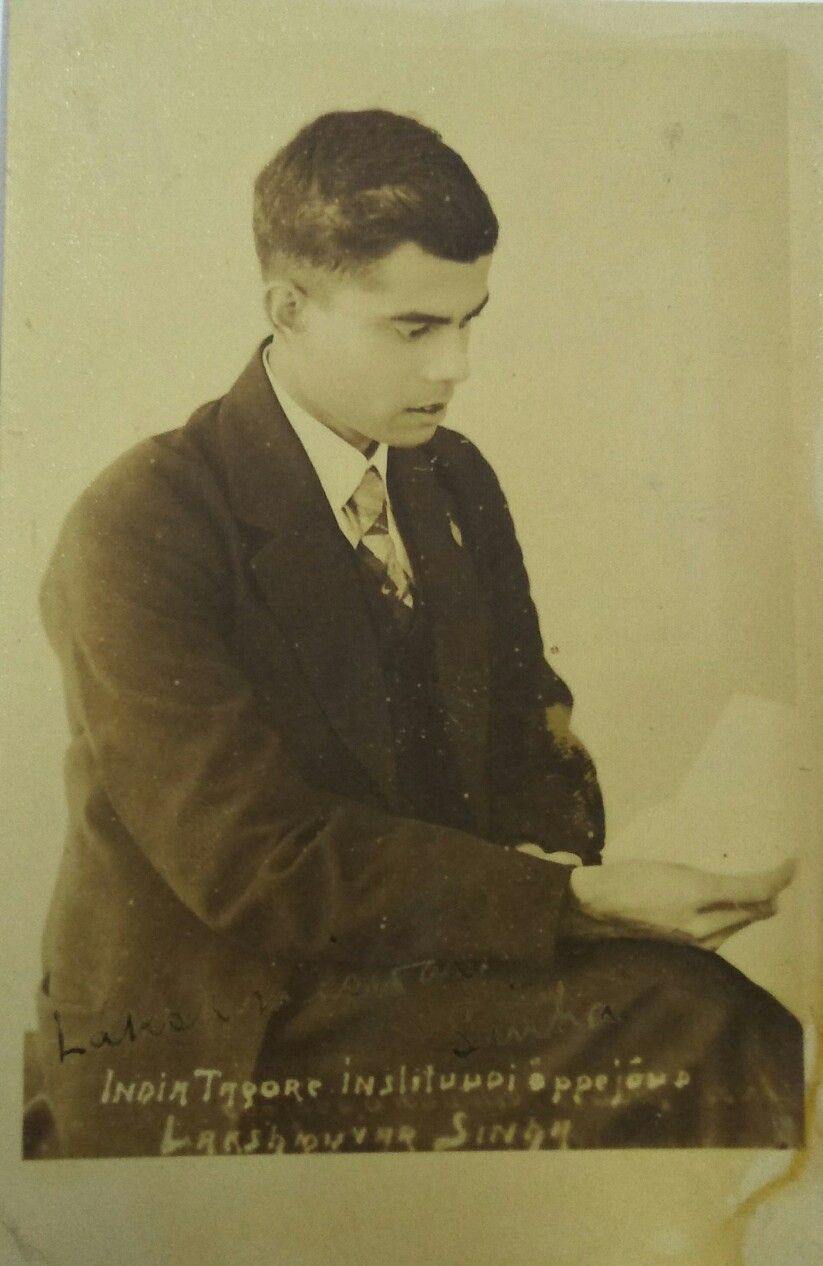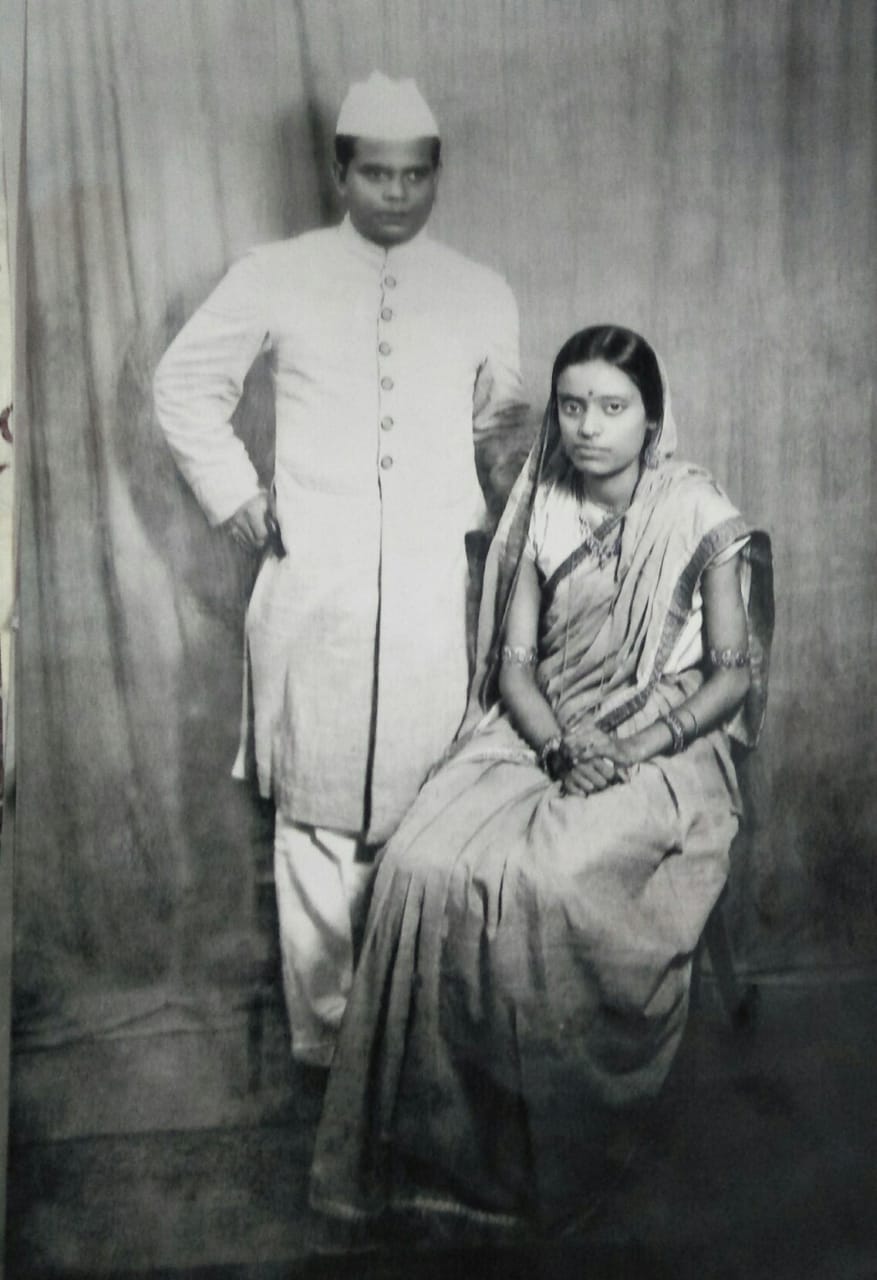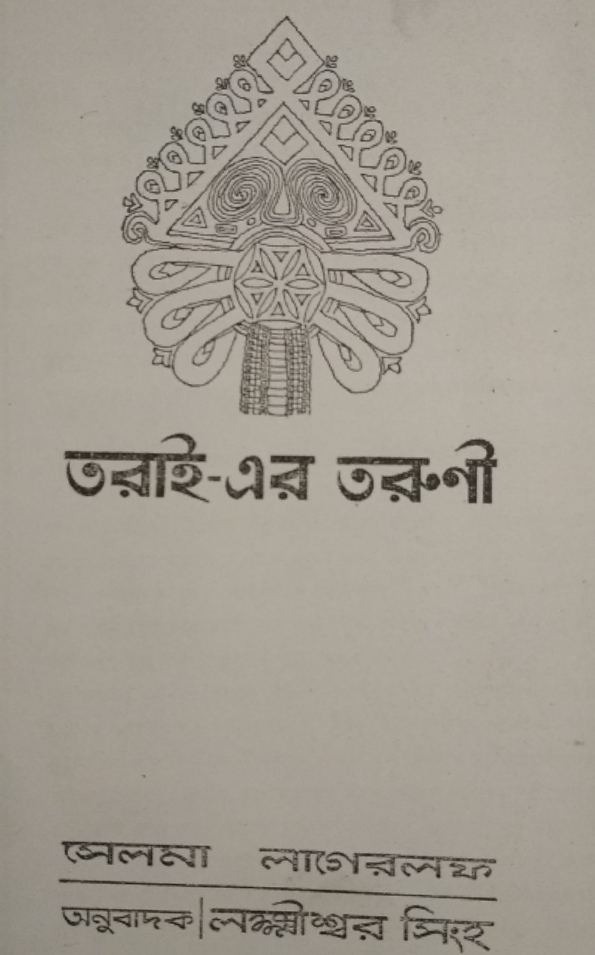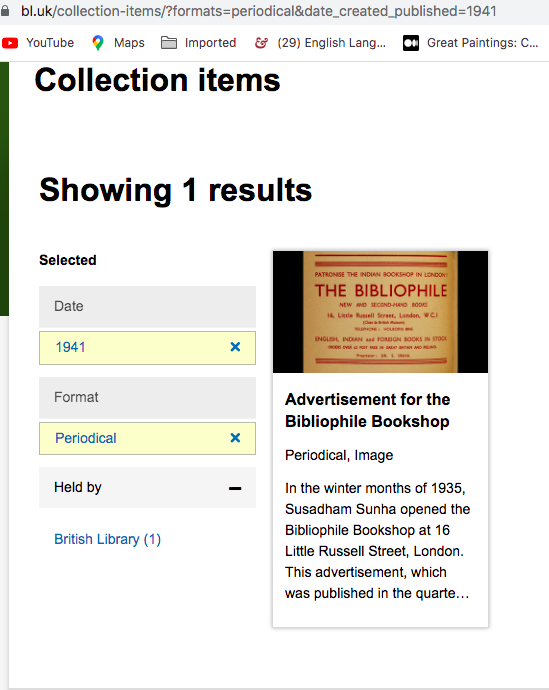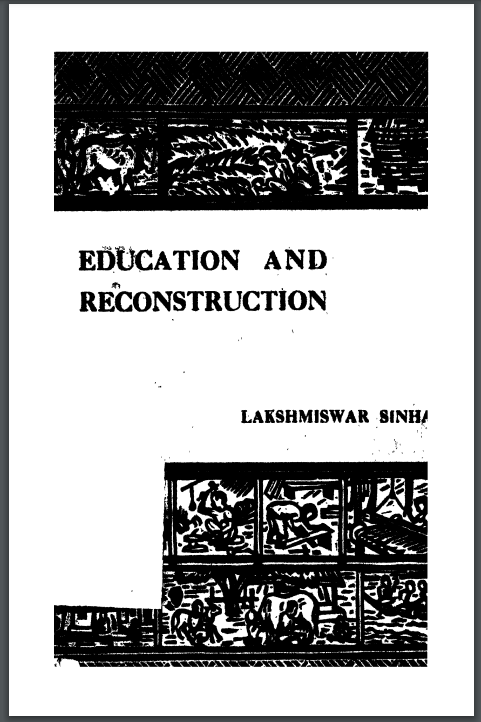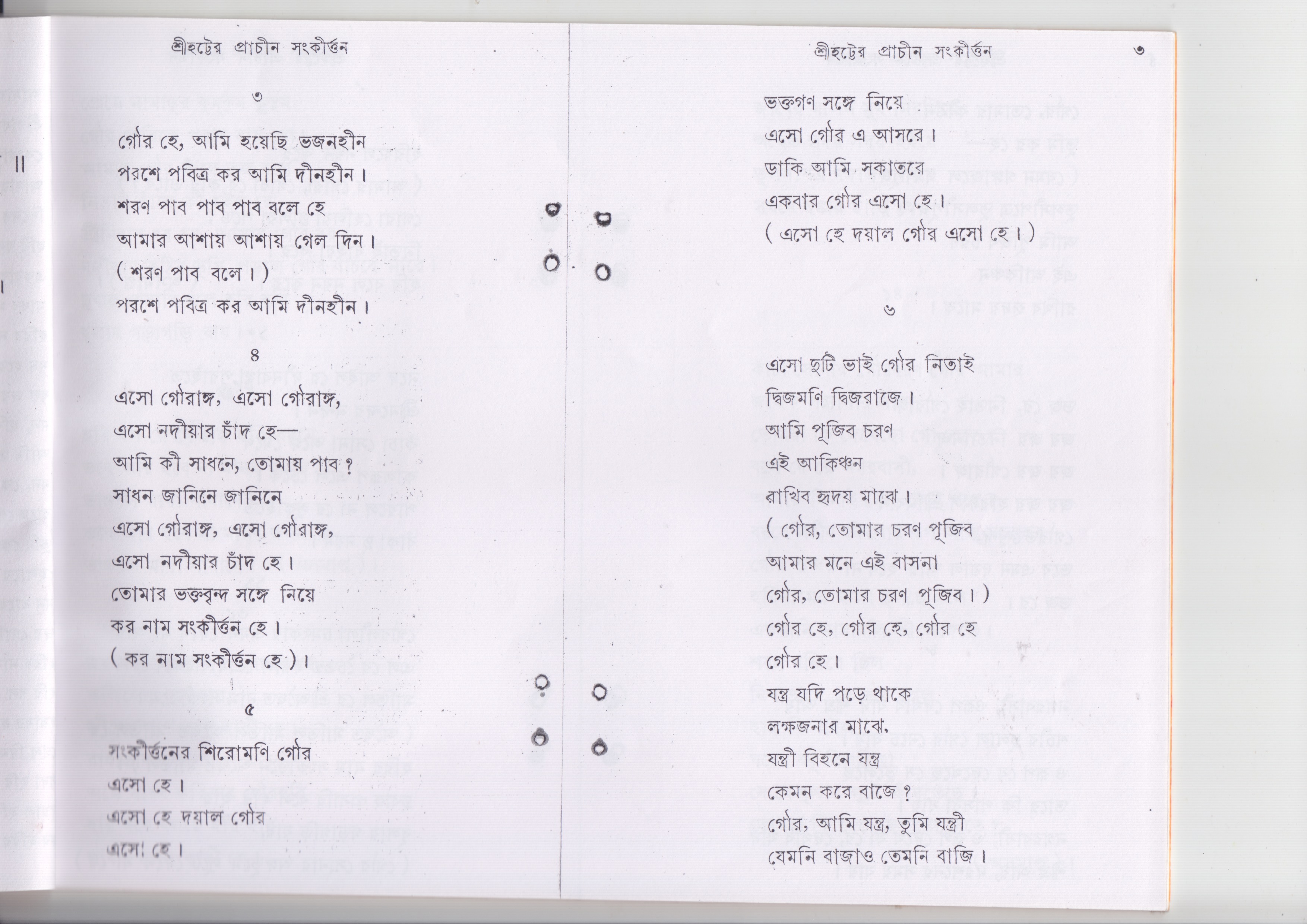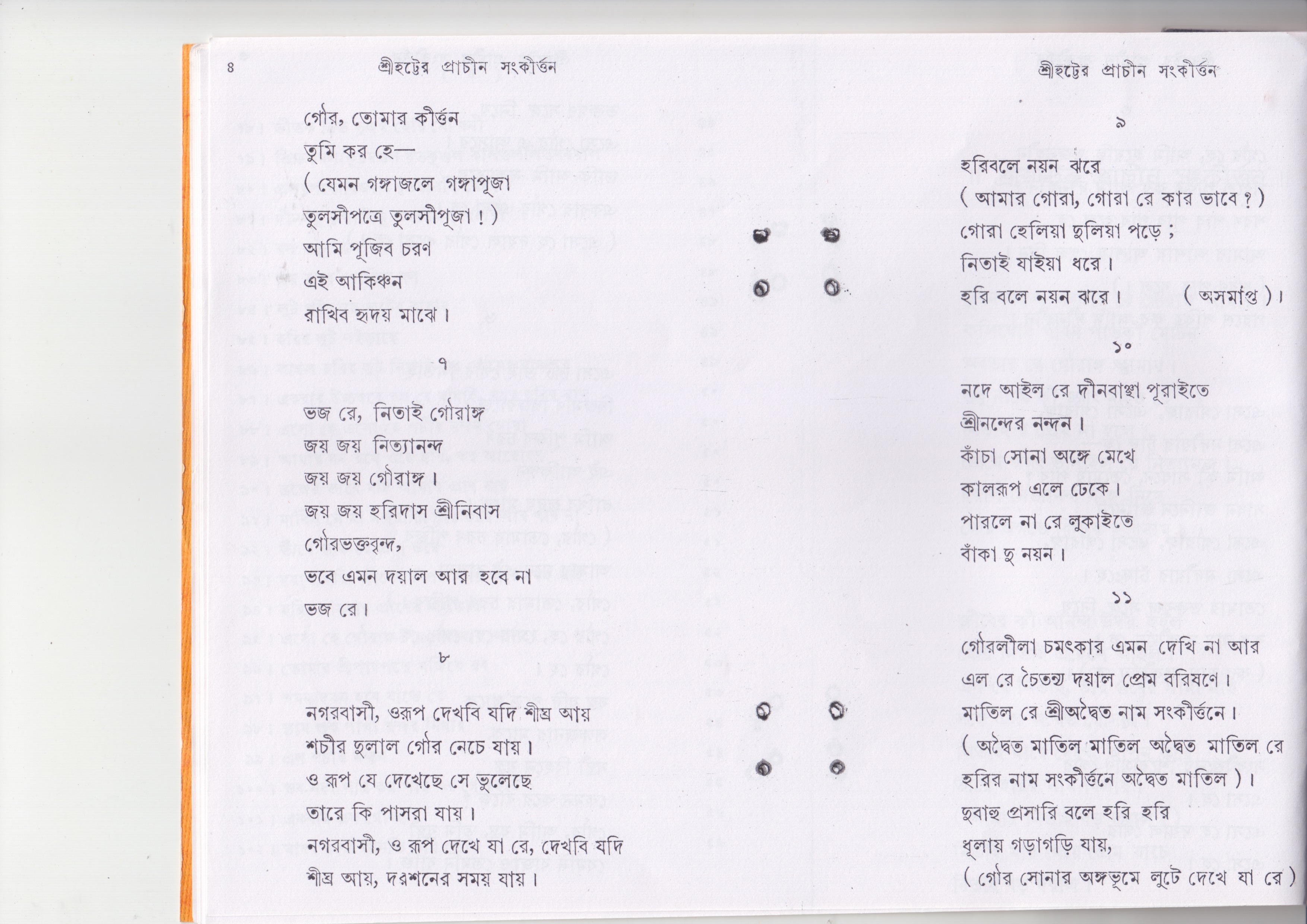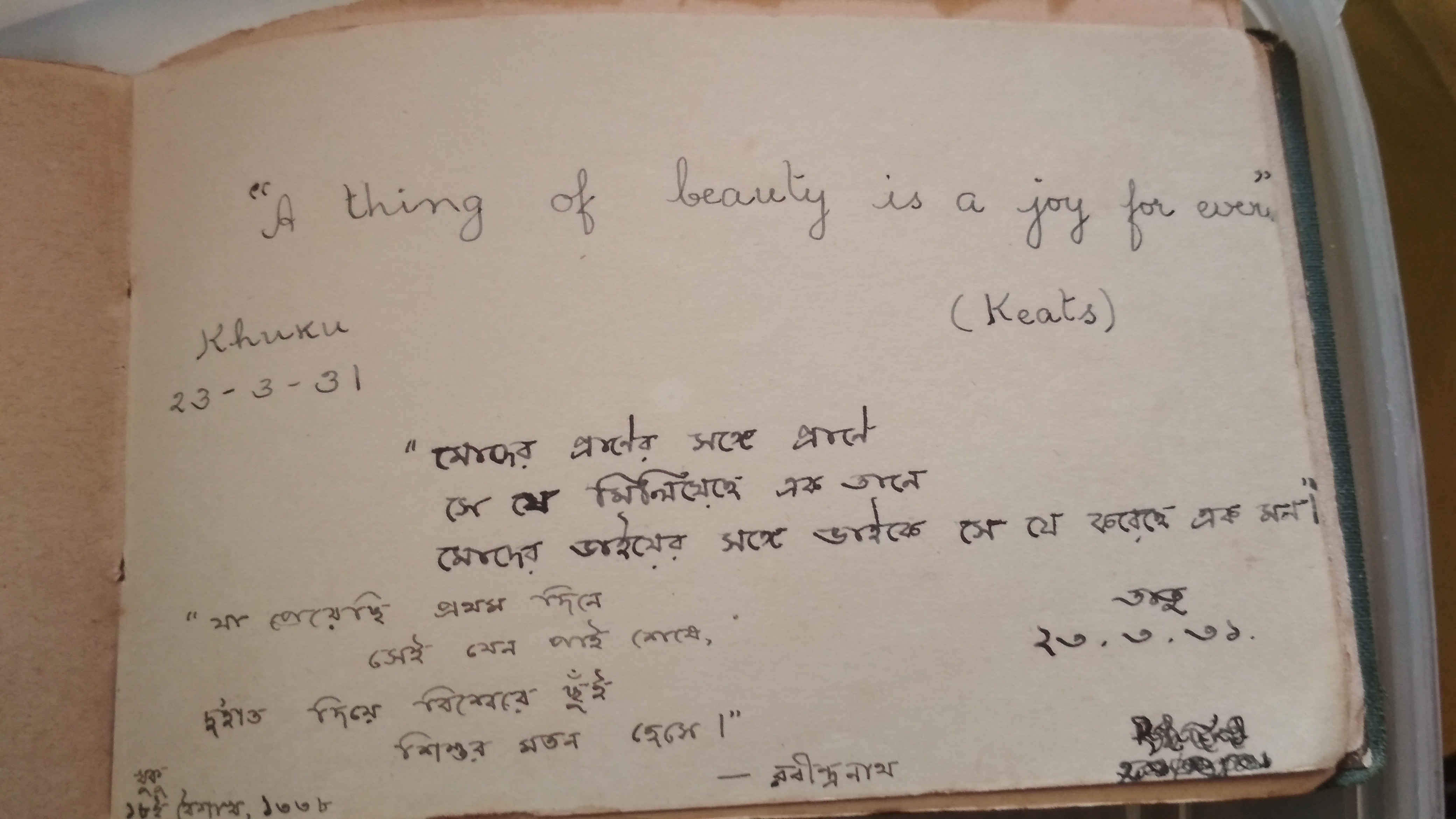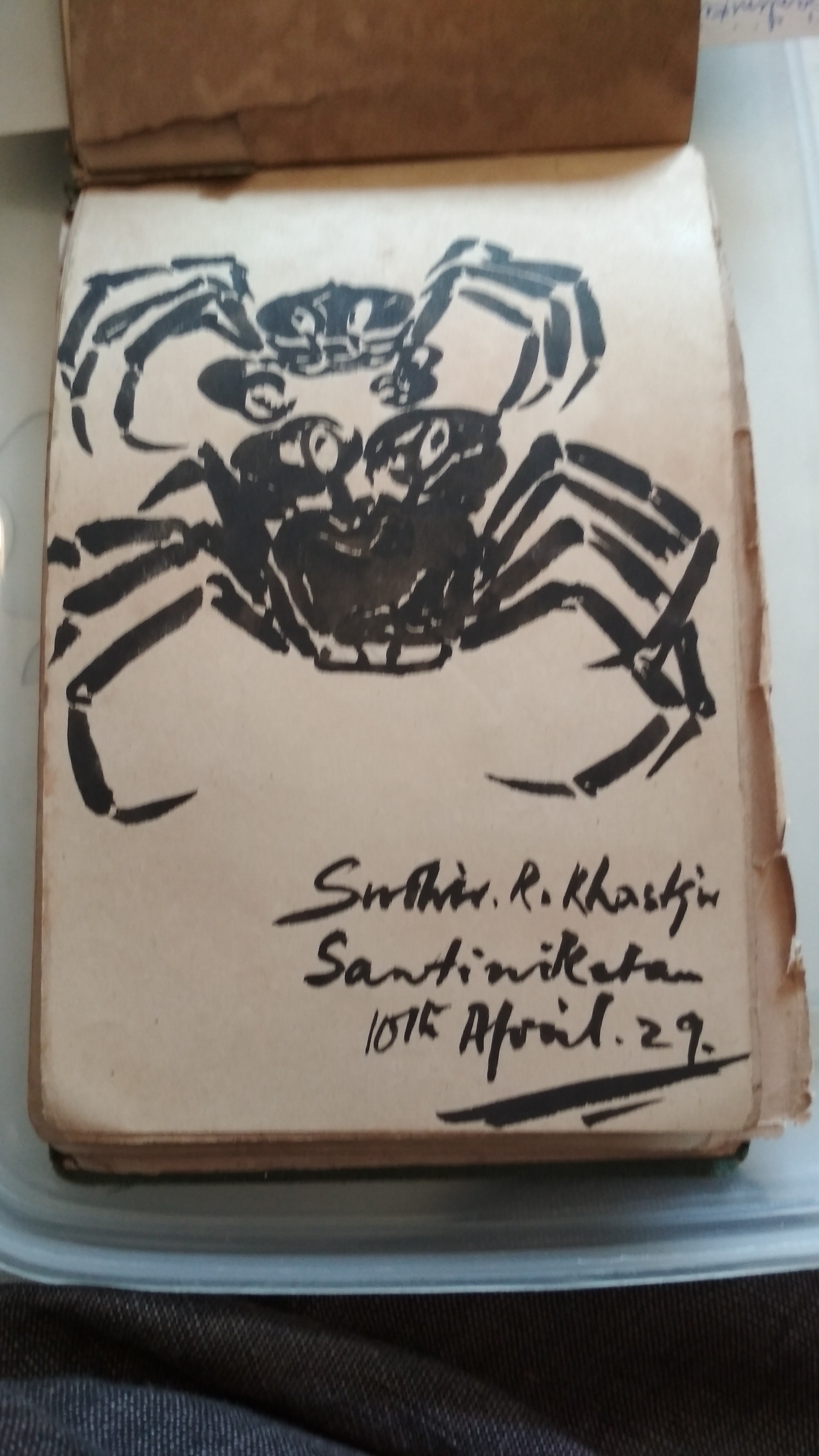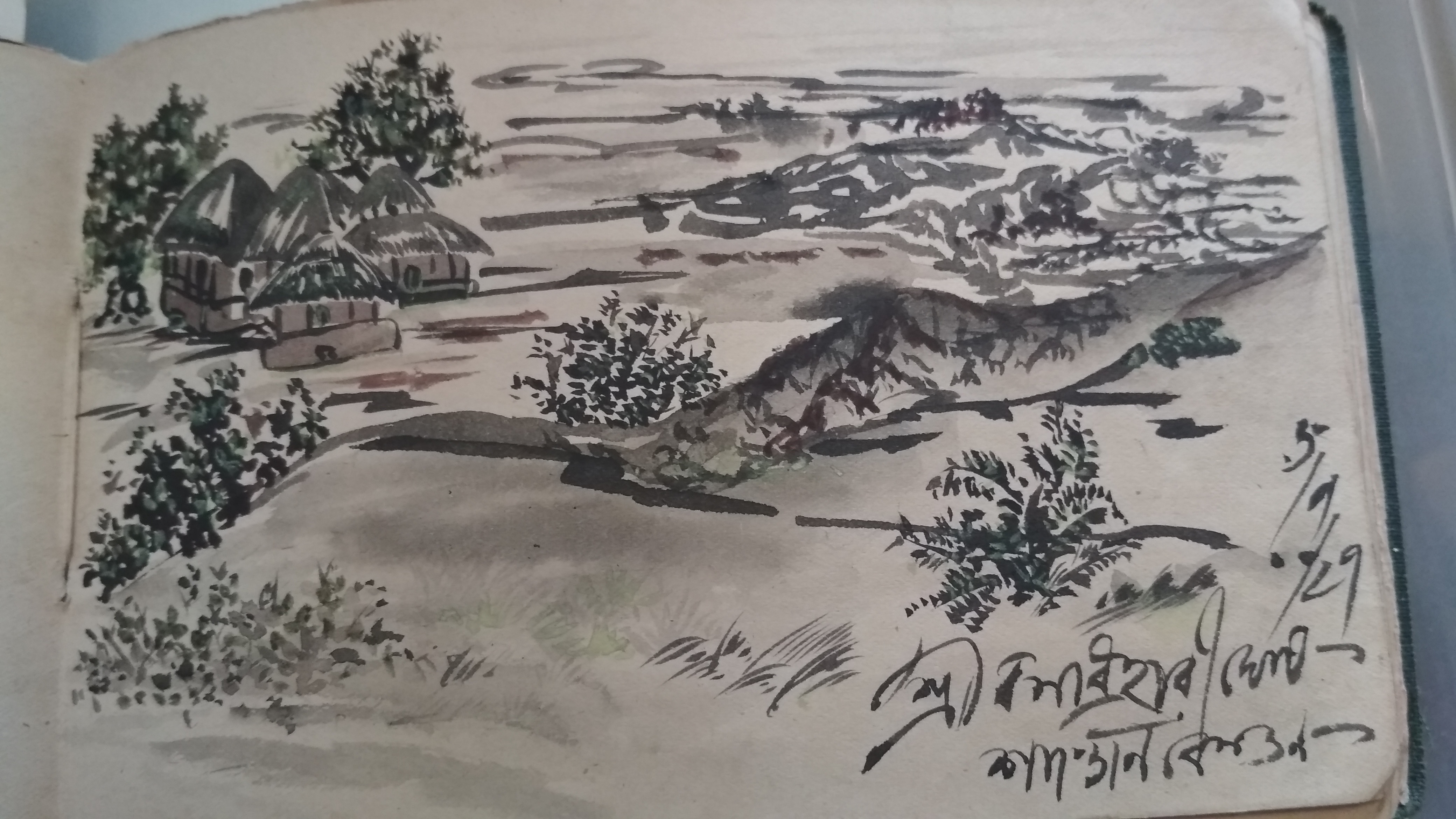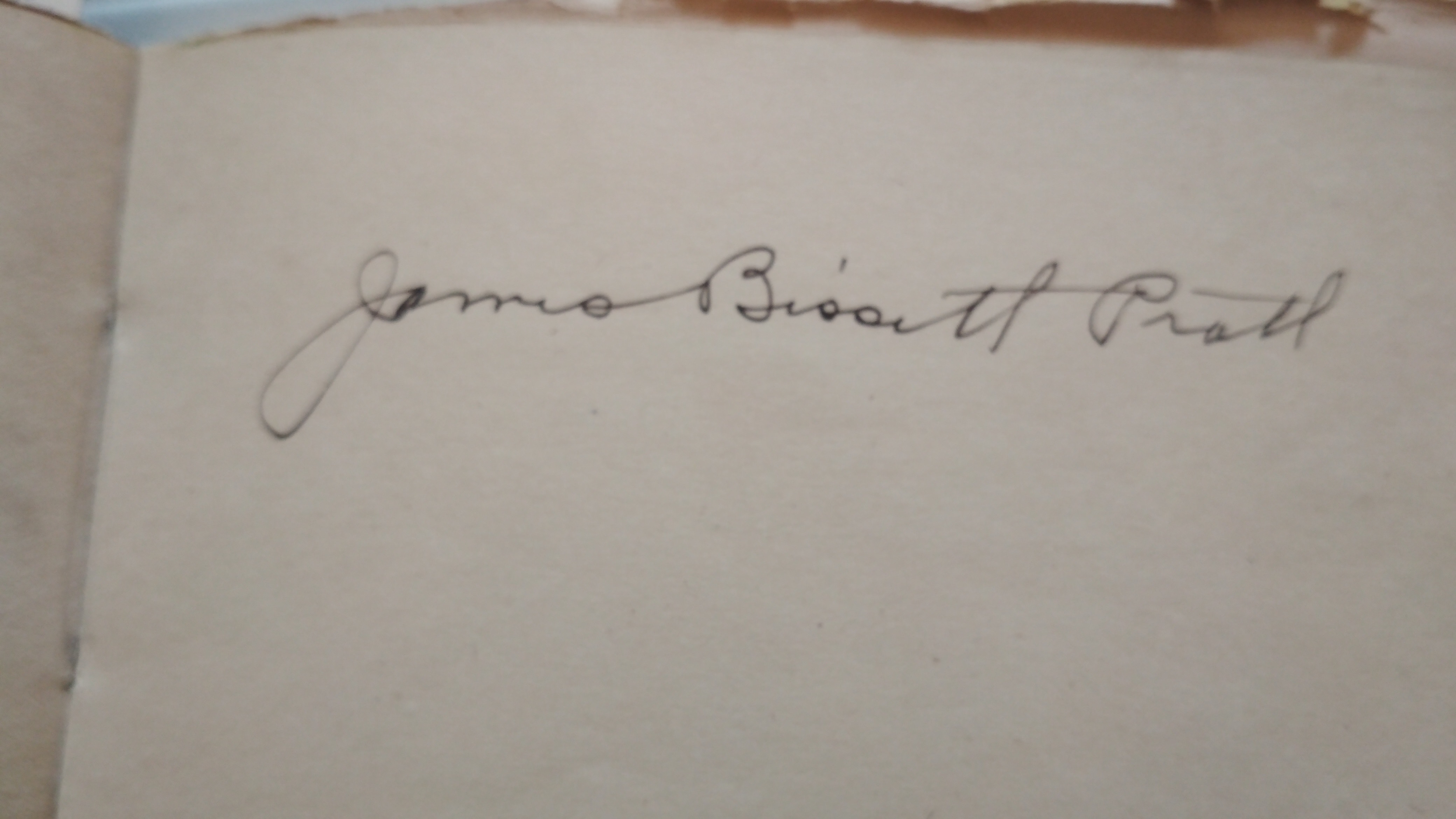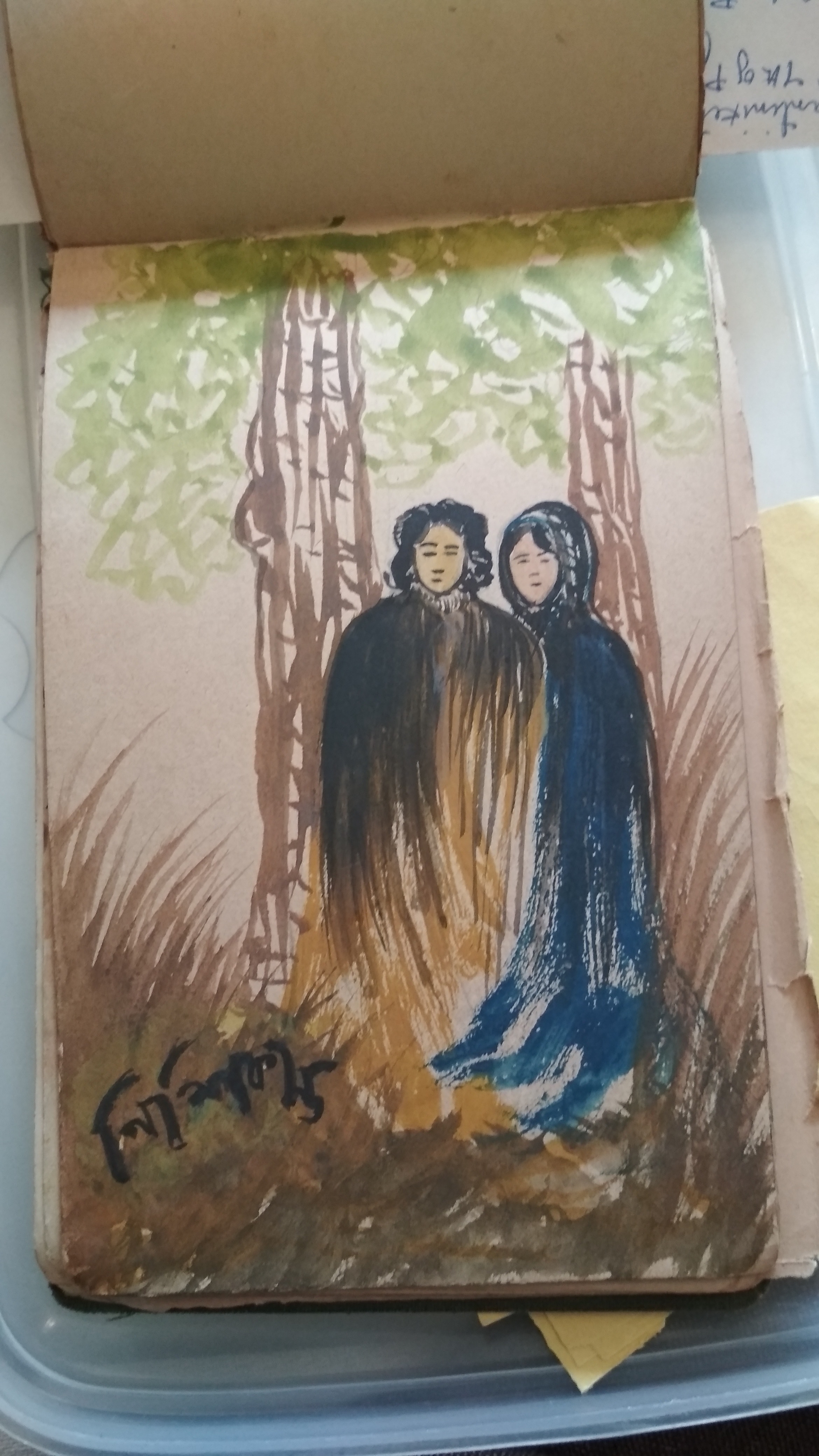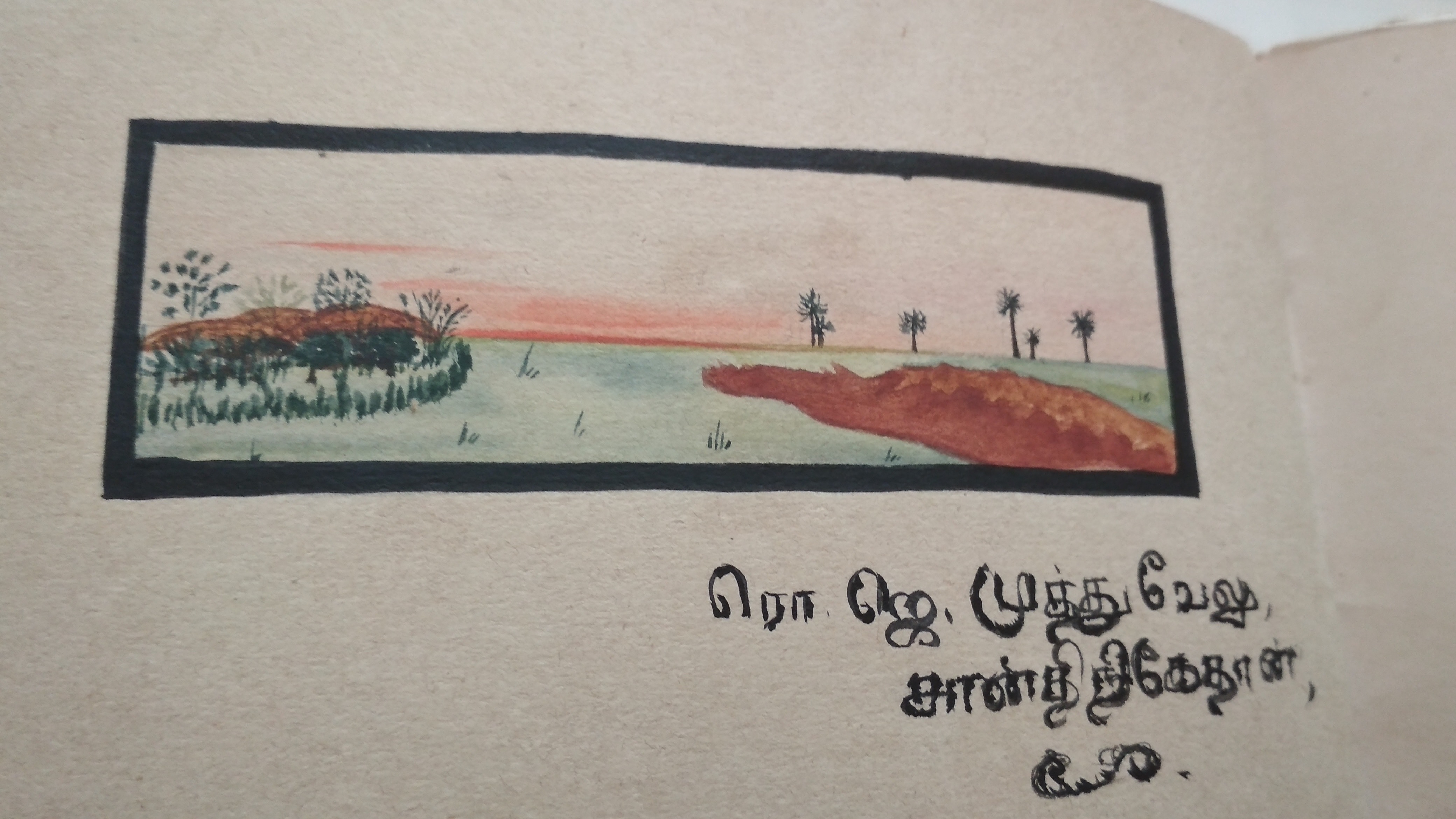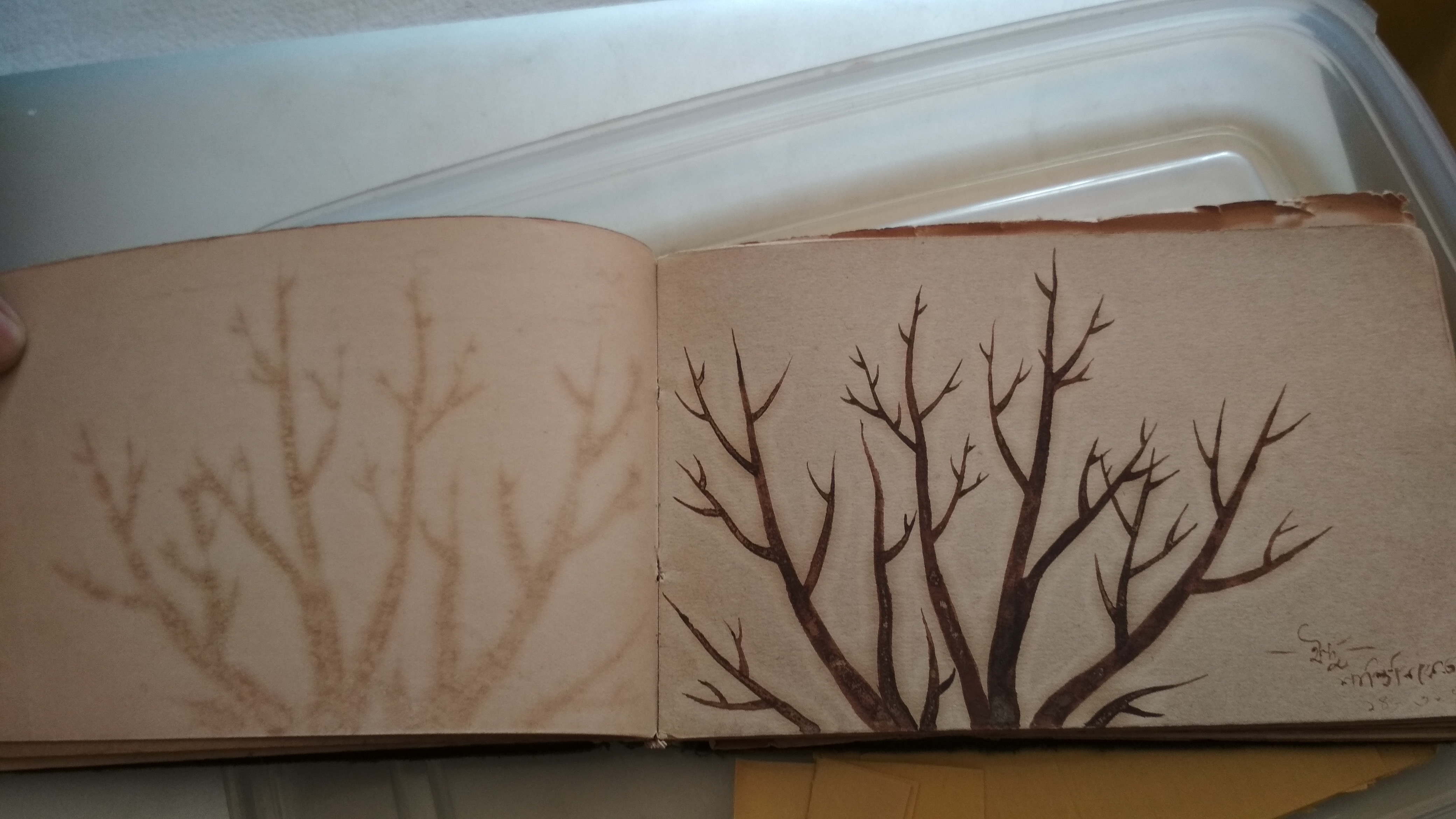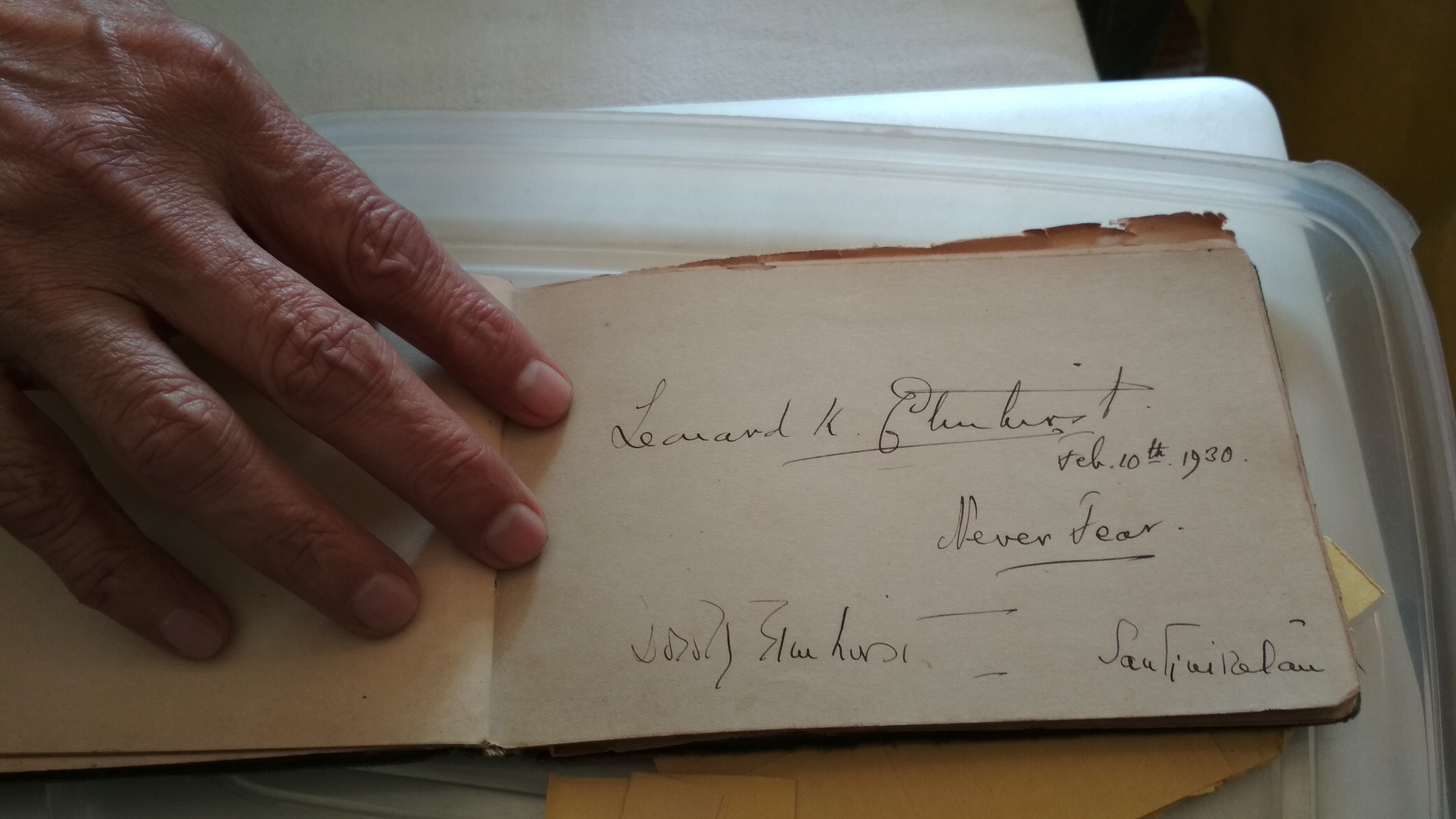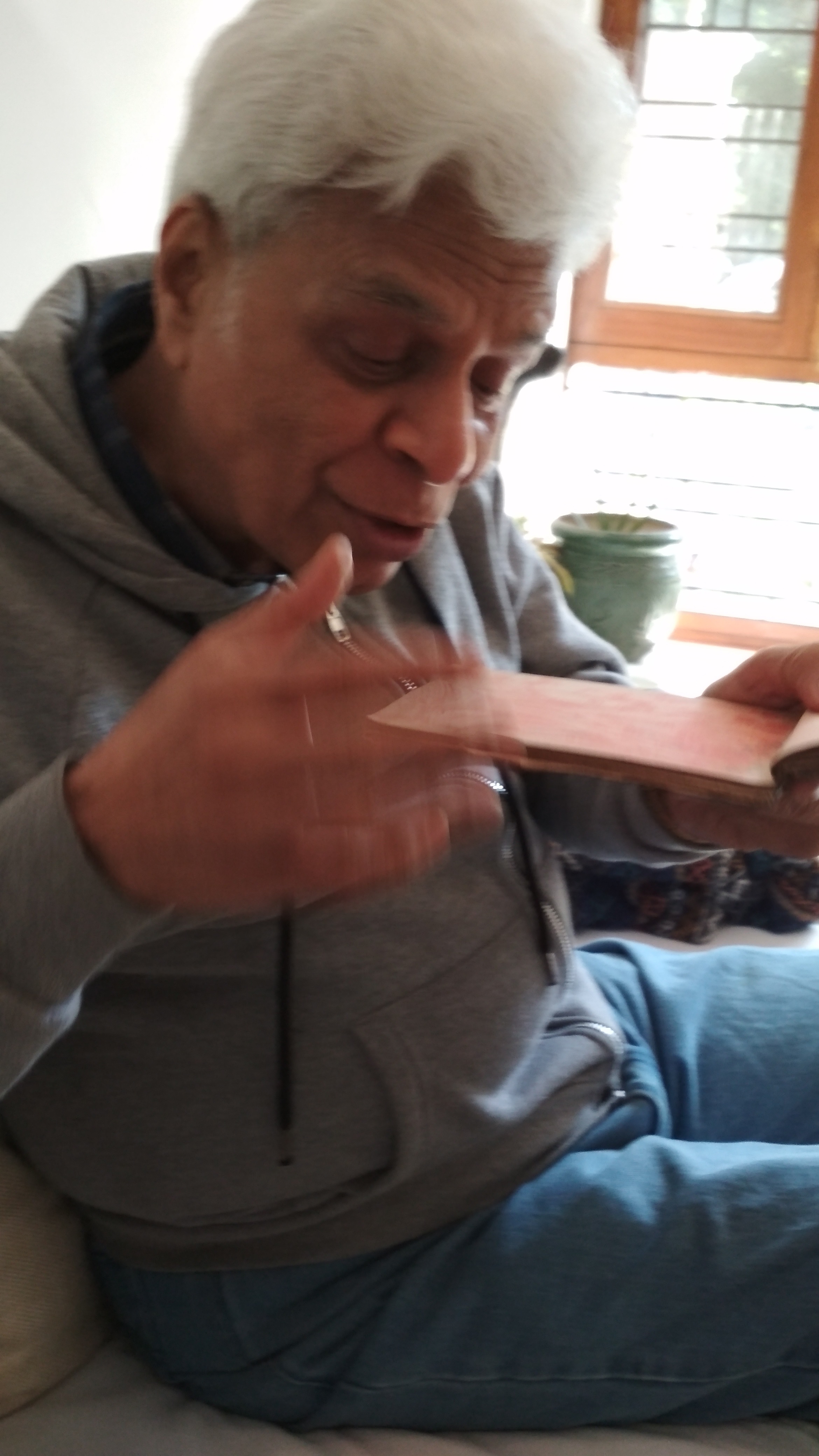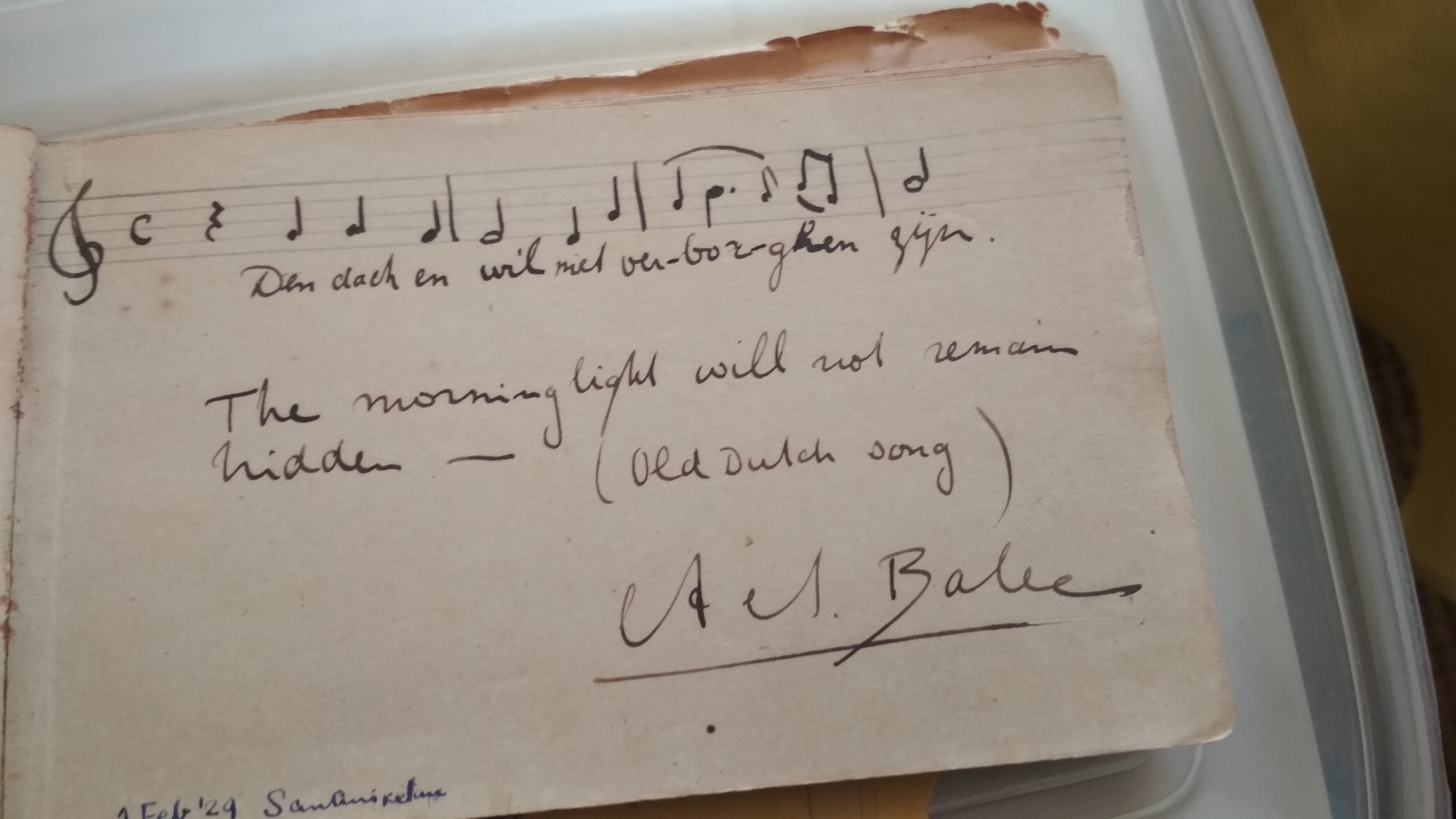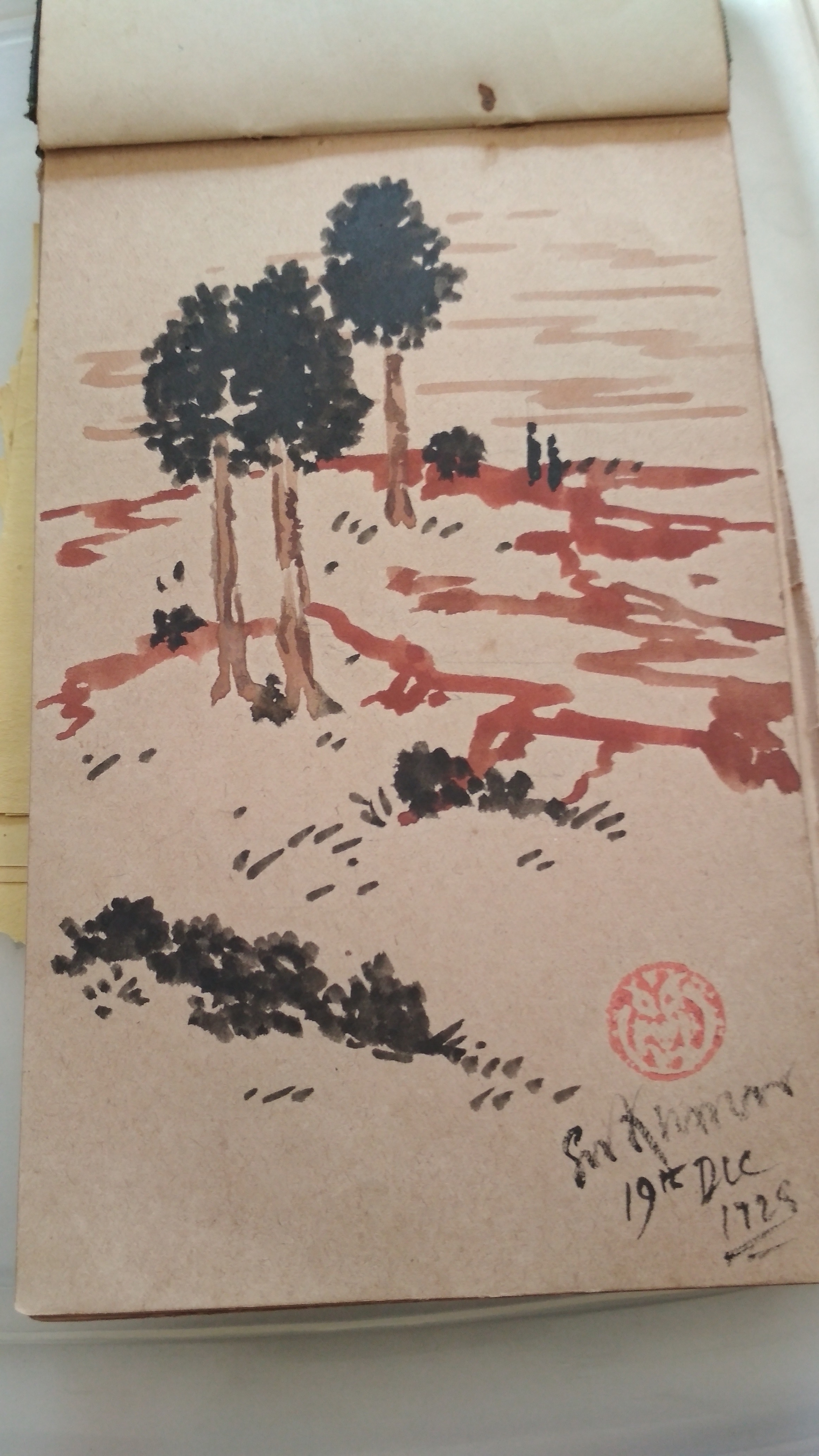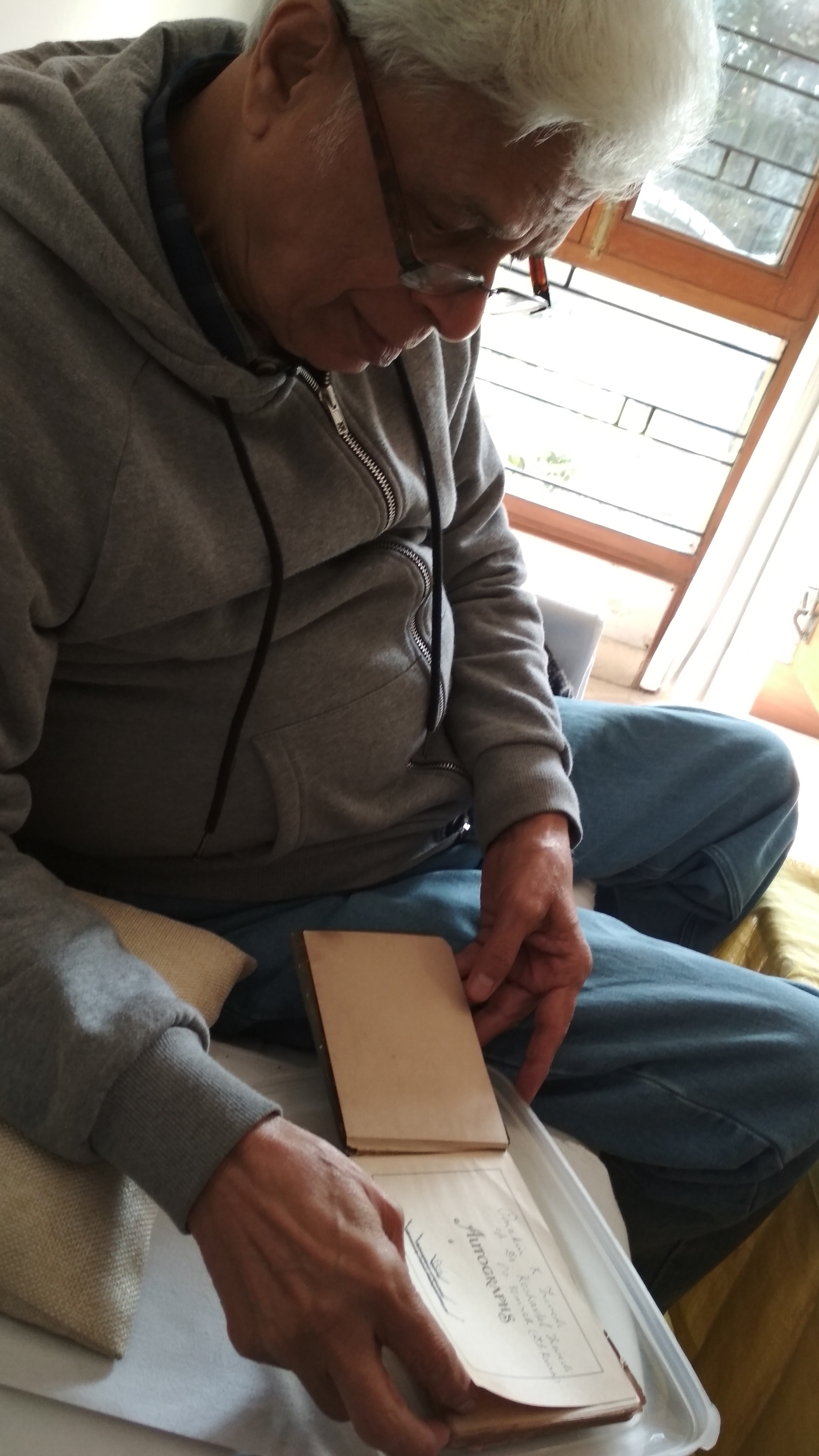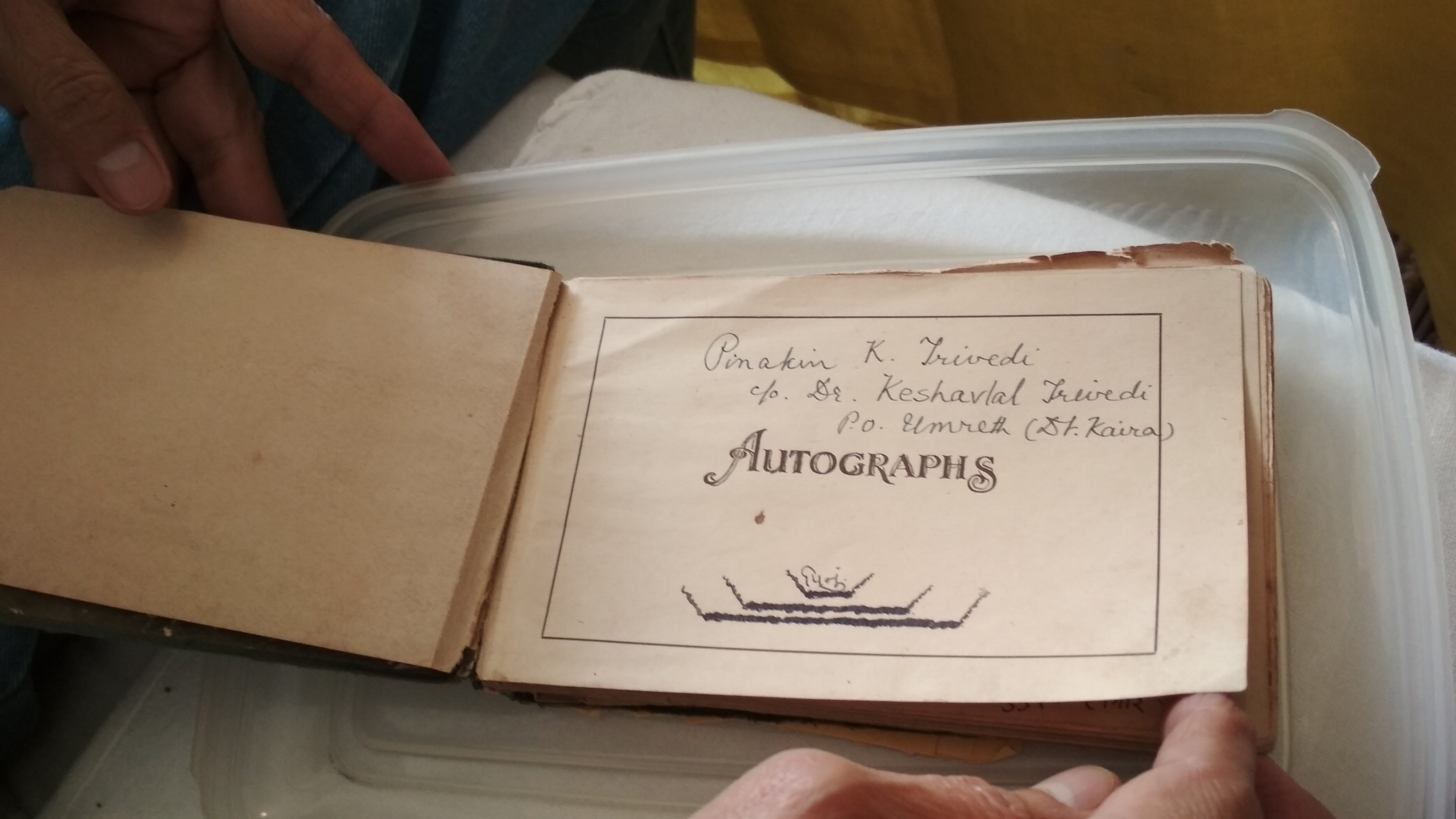Author: Moushumi Bhowmik
এইখানে কীভাবে এসে পৌঁছলাম আমি? How ever did I reach here?
মৌসুমী ভৌমিক
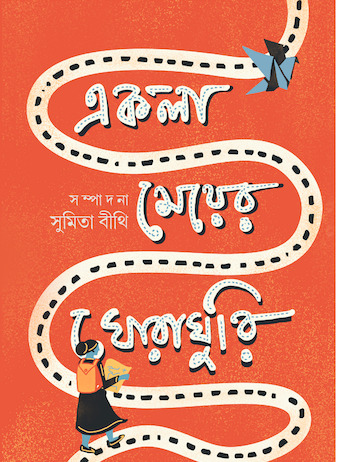
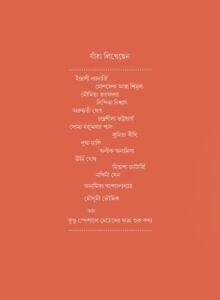
The Bangla book, Ekla Meyer Ghoraghuri, an anthology of women solo travellers, is edited by Sumita Bithi and published by Sumita Samanta of La Strada, Kolkata, January 2025. I am one of the writers but I write less about travelling alone and more about being not quite alone on the road. I write about the many faces and traces of sound, lives and loves that draw me out and pull me in.
My friend Debjani, who lives in Wahlwies in Germany, is central to my story as is the voice of Maria. Maria of Freiburg, we call her. It was a blessing to have heard her on a wet Sunday in October 2022.
My professional sound recordist/sound designer friends complain about the fumbling noises with which all my recordings start. That’s all right. You have to be a little patient. I am walking and recording, the mic of my recorder is brushing against my coat. I am not always aware of the angle of my arm. Then the tram comes, I have to stop, but now I have reached her. Debjani and I. She sings, we talk, she sings again, I hum with her. Beautiful she says. But the beauty was in that day, in Maria’s song and all the stories she has been leading me to.
On that trip in 2022, I was leaving Germany and going to France. I would take a train from Strasbourg. Debjani started with me, and said, I’ll come up to this point. Then she came some more. And some more. Till the border of Germany in Kehl. We crossed over to France by tram. Walked through the market, drank coffee, ate some food. I recorded a man playing accordion on the bridge.Then we went to the station and waited outside. We were sad to part. I was singing this song of D. L. Roy, and Debjani was recording me. How beautiful to be tangled up in love, to feel the pain, to be captive in our prisons of desire.
9 October 2022.
After 2017, I met several people, native speakers of Santali or scholars, with whom I listened not only to Bake’s Dumka recordings but also to The Travelling Archive’s, which came out of listening to those recordings back in the field. Hence it was a kind of exercise in listening to listening that we were trying to do together and recording that process. Listening, recording, listening again, recording that listening, listening to that recording, and recording again—time and voices and interpretations get layered one upon the other.
Those I include in this sub-chapter had an insider-outsider perspective to the recordings. With them, I did not need mediation to communicate, as we spoke a common language—by language, I don’t only mean English or Bangla, but we also had a shared vocabulary of thoughts and ideas. In a sense we were part of a community of our own. But they were also part of their home communities and there they became my mediators, helping me to formulate my questions and grasp the meanings of things.
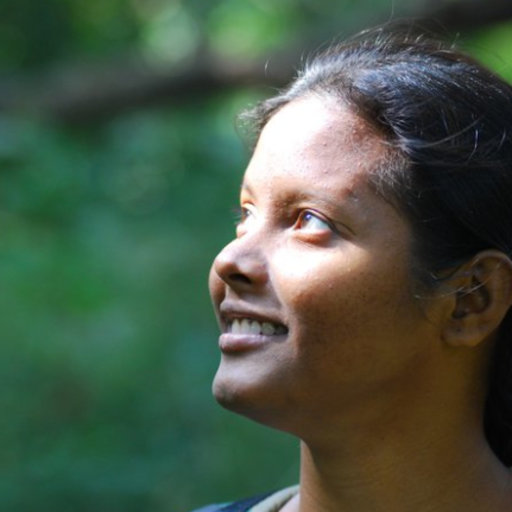
I have been listening to Bake’s and our own Santal recordings with Rahi Soren, a young scientist who teaches in the Department of Oceanography, Jadavpur University, Kolkata. Rahi is keenly interested in exploring her culture and history and the politics surrounding them. With researcher and radio presenter Sitaram Baskey, she has been working on a project entitled ‘Resource Mapping the Early Recordings of Traditional Santali Songs’, creating an Archive of Traditional Santali Music
Rahi describes the Sohrai festival as they used to celebrate at home and questions of patriarchy within the community come up as she talks.
Rahi says that she has been trying to identify variations within the Santali language, by listening to migrant communities. ‘If you listen to Santals in North Bengal and Santals in South Bengal, or in Assam, you will hear differences,’ she says. The variations signal their different migratory paths and final destinations and the dominant language of the places which became their new homes.
Rahi hums tunes and explains the different forms of Santali songs and the meanings of words.
Our first round of conversation was in my home on 20 January 2021 and the above clips are from that session. Then, on 5 June 2021, we met over Zoom and talked some more. The following clips are from that round of conversation and they are interesting also from the technological point of view. I had a recorder placed on my table, Rahi is on screen, talking from her home. Hence the difference in the quality of sound. What is further interesting is that Rahi was playing to me recordings she had made while listening Santali programmes on All India Radio. This range of sound and recording excites me and once we learn to listen to these layers of sound, we can also listen to the many traces of time and place that the sounds hold in them.
We were talking about the Famine song that Bake recorded and all our listeners responded to (here is the response of the Kairabani listeners). I was telling Rahi about Father Solomon’s deeply perceptive and empathetic response to the song. I was connecting it with Father Stan Swamy’s life, politics and killing. Then Rahi said, we should also think about the songs which are absent in the recordings Bake made. Yes, absence in an archive is very important to understand a history of a time and place, I said. Rahi talked about the Hul seren.
She has written about how the Santal Hul (revolution) of 1855-56 was one such landmark revolt fought by the Santal Adivasis and lower caste peasants against the exploitative upper caste zamindars (landlords), mahajans (moneylenders), darogas (police), traders, and imperial forces from the East India Company in the erstwhile Bengal presidency. Then we exchanged books and recordings.
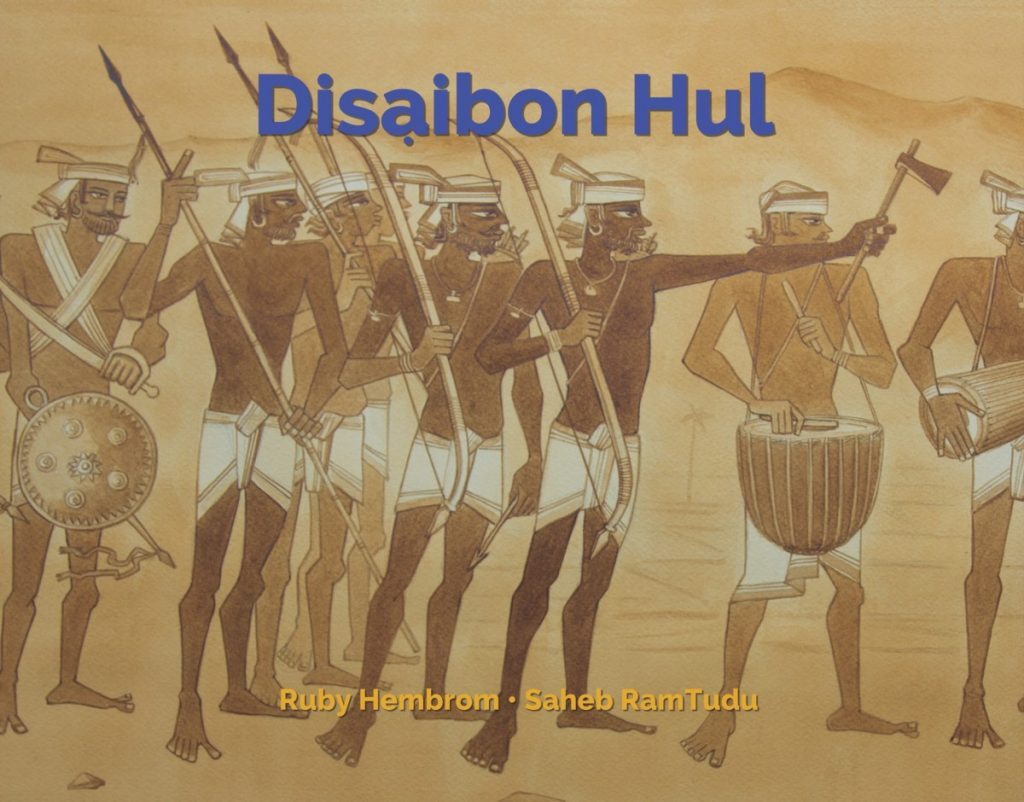
Let’s Remember the Hul (Disaibon Hul), by Ruby Hembrom and Saheb Ram Tudu (Adivani, 2016).
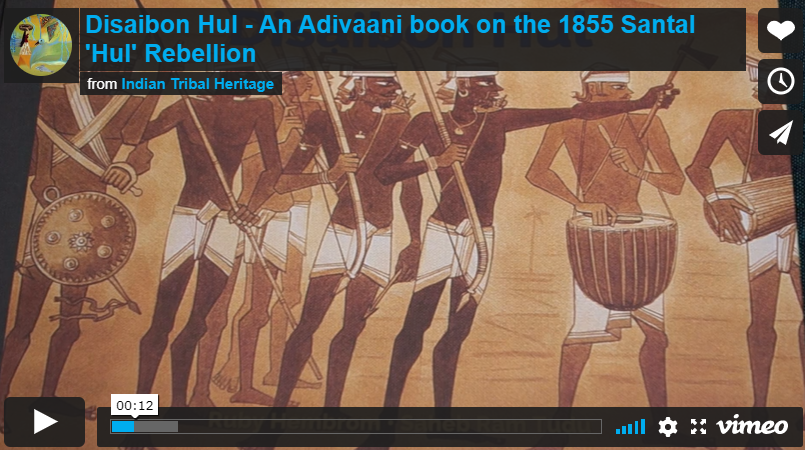
Disaibon Hul – An Adivaani book on the 1855 Santal ‘Hul’ Rebellion
Deben Bhattacharya (1921-2001) , Bengali traveller, field recordist, broadcaster, records producer, filmmaker and translator, who spent many years of his life in Paris, had recorded the Santals near Asansol, West Bengal where they worked in mines and factories, in 1954 and later he came back to make a film, Belpahari: Faces of the Forest on them in 1973. Richard Lannoy, Deben’s photographer friend, had taken a now famous photograph of Deben seated on the ground while a group of Santal women and children look on.
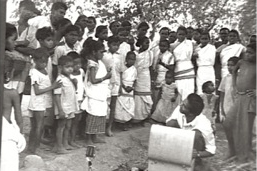
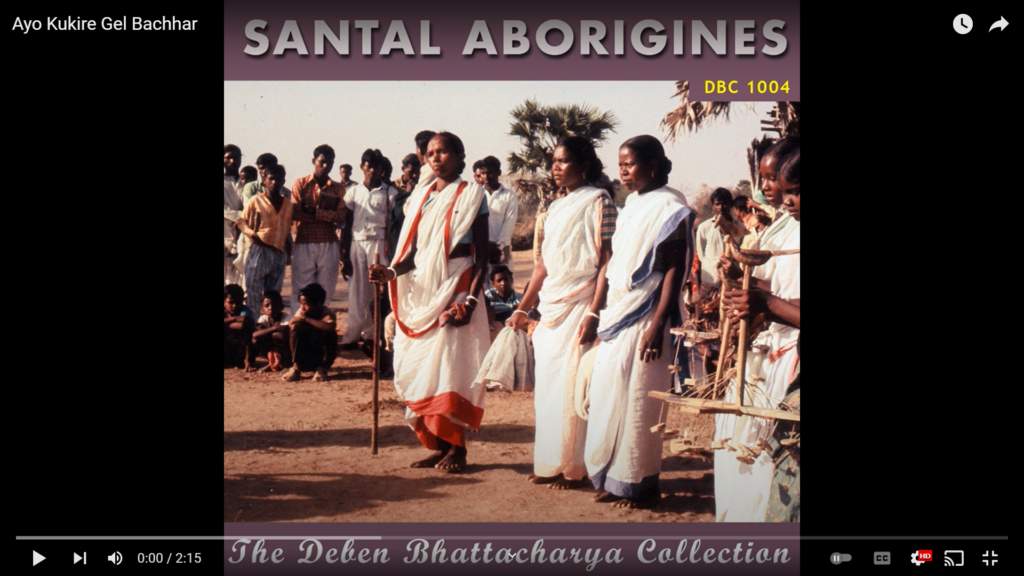
Ayo Kukire Gel Bachhar, a song recorded by Deben Bhattacharya.
Deben Bhattacharya had recorded a Hul seren and Rahi sent me a video with his recording and a more recent recording of the same song. She sent me the words of the song too, which she translated for me.
The words go: ‘Debon tingun Adibasi bir do/Debon tingun Adibasi bir/Marań buru jó me̠nabon/Mit’ho̠rte taram abon/bạiri he̠le̠ćkate abon/Duk Do mabon ńe̠lńir/Debon tingun Adibasi bir do/Debon tingun Adibasi bir.’ In Rahi’s translation, they become: Let us stand together, o brave adivasi /Let us stand together, o brave adivasi /Let us praise the almighty, marang Buru/Let us walk together on the same path/Let us wipe off the enemy and leave our misery/Let us stand together, o brave adivasi /Let us stand together, o brave adivasi.’
Rahi and I have continued to talk. She has introduced me to the writings of Nishaant Choksi, sent me links to interesting archival work and exhibitions on Santal music , reminded me of the recordings of George A. Grierson made in 1914—perhaps the earliest ever.
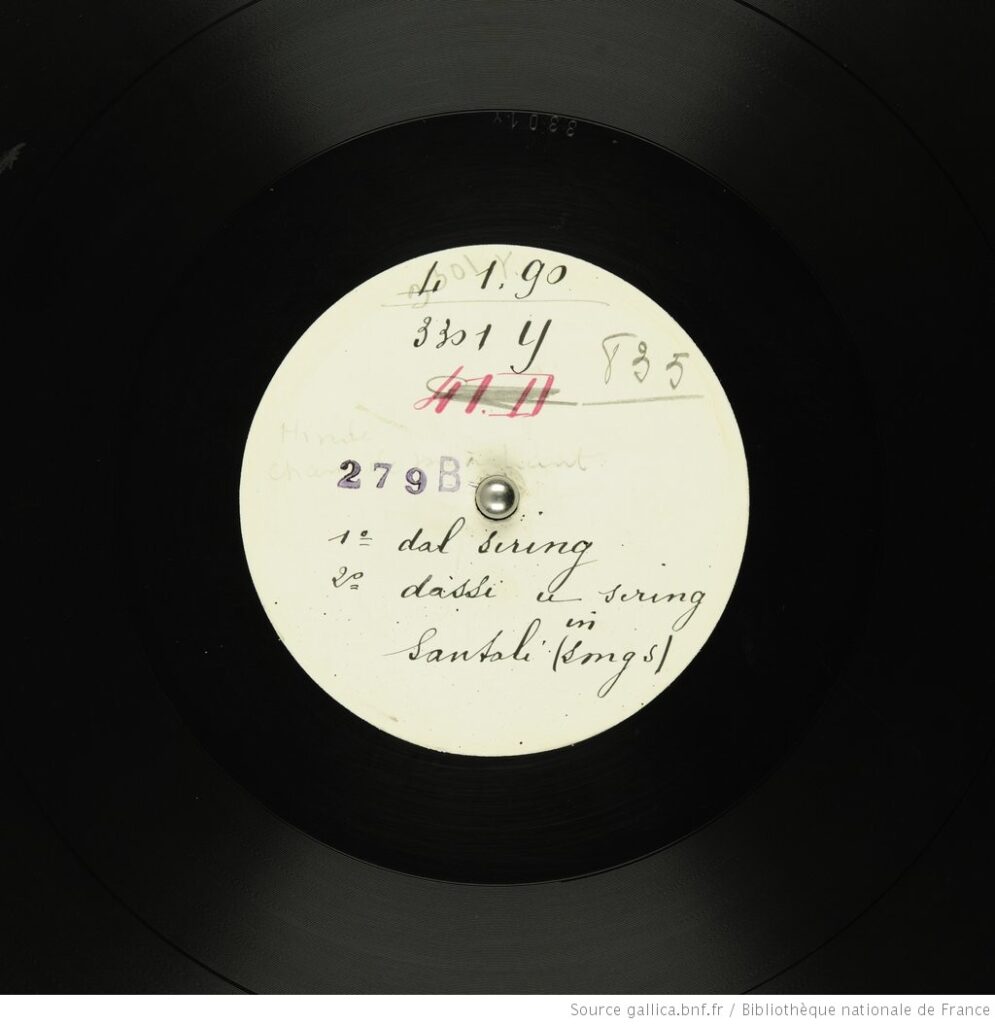
This recording, made for the Linguistic Survey of India, can be heard here. I was playing from my laptop and recording as I listened. In my recording, a dog can be heard barking, even the hum of my refrigerator.
I saw a song and dance sequence in a recent Bangla film featuring Santals and was thinking what Rahi might think of it. The song is in a kind of Bangla that is supposed to represent Santal-speak. She said, there is nothing new in this. ‘Beshirbhag cinema tei bipul misrepresentation dekhechi aage’ (I have seen such massive misrepresentations in most films in the past.) ‘College e poraten ek mastarmoshai jigges korechilen ‘Baha’ TV series e jemon kore prodhan choritro kotha bole, serom bhasai barite kotha boli kina.’ (There was a teacher in my college who asked if we spoke at home like Baha of the TV soap [Ishti Kutum]).
On 9 May 2022, she sent me her own recording from a recent mela in Jhilimili. You will like this one, she said. It is an annual festival. Of course, dancing at home and dancing in a fair are not the same, she reminded me.
This is the note that Rahi sent. ‘Come spring and a quaint little village in Poradi wakes up to the sounds of the Tamah and Tundah at dusk. People from near and far gather at Jhilimili Pata for the night and disperse with the first light of dawn. I was honoured to have been invited to one such event and to witness the amazing gathering and people bustling throughout the Pata. This gathering has been a platform for the revival of Santali culture, religious sentiments as well as for book lovers and merrymakers. The dance form in this clip is one such performance where dance troops came from Bandwan, Khatra, Jhilimili and Ranchi to showcase their talents in rare dance forms. Over the years, people from the community have also learned and re-learned several dance forms which are now threatened with extinction as there are now more ‘popular’ and easily available entertainments for the masses.’
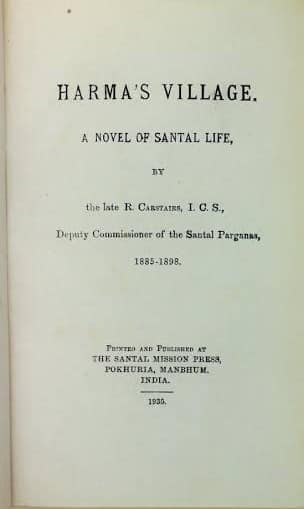
Title page of the novel Harma’s Village, by Robert Carstairs. Photo: From the wall of Soumitra Sankar Sengupta on Facebook.
With Soumitra Sankar Sengupta, an avid reader and collector of books and a writer, also a civil servant, my connection started with a post he had written on Facebook in 2020 on the night before the anniversary of the Hul rebellion, which deeply moved me. It made me write to him and he wrote back and that was the opening of an ongoing conversation, where I mostly question and he answers. Anyway, in this ‘first post’ so to speak, Soumitra wrote about how he had first learned about the Hul from his uncle (his mother’s elder brother), an exceptional teacher in a village school in Birbhum, the headmaster, with whom he went on morning walks, talking and listening along the way. They went up to the narrow stream at the edge of the village and came back home. His uncle washed his feet and entered his study, young Soumitra followed him inside. There was a yellowing map of Birbhum on the wall of this study and many photographs too and books on his desk. They triggered the boy’s curiosity. One framed photograph carried a caption, ‘The banyan in Panchkathia village under which the Santal rebels killed [the word used is boli where the act of killing is a sacrifice, an offering made for greater good; I am not sure how to translate it] Mahesh Daroga’. Soumitra browsed through his uncle’s books. An assignment to transcribe parts of an old manuscript (History of the Santal Hul by Digambar Chakraborty) from a weathered foolscap exercise book, a trip to the Tantlai hot spring on the border of Bihar and Bengal, near the Siddheswari river —all these little things gave young Soumitra the feeling that he was standing within the pulsating heart of the Hul rebellion. Those were the beginnings of a lifelong love of books for Soumitra which taught him to think and write. He felt almost compelled to understand the land he was walking and the people he was meeting and the lives of those who had walked on it before him. Later, when he became an officer in the state administration, he knew that the system had its limitations, but many before him had worked within those limitations and he drew inspiration from them. He chose a path of knowing the land. Around 2004-05, Soumitra came across a chapter of a novel on the internet, which described the killing of Mahesh Daroga in Panchkatia, returning him to the picture on the wall of his uncle’s study. That book was Harma’s Village: A Novel of Santal Life, written by Robert Carstairs, ICS, Deputy Commissioner of the Santal Parganas from 1885-98 and it was published by the Santal Mission Press, Pokhuria, Manbhum in 1935, many years after the author’s death . Later, Soumitra found a Bangla translation of the book, by Subal Mardi, a senior bureaucrat with whom he had also worked. That book was not a direct translation from the original English, but from R. R. Kisku’s Santali translation. He also came across another slim volume entitled Jangale (In the Forest) by Satishchandra Mukhopadhyay which, he realised, was based on Harma’s Village. Many more encounters occurred, with books and real people, that led to the deepening of Soumitra’s relationship with the land, language and life of the Santals. Earlier this year, in March 2022, Asiatic Society, Kolkata published a Bengali translation of Rev. Paul Olaf Bodding’s three-part Santal Folk Tales, edited by Soumitra Sankar Sengupta and Kumar Rana, with contributions from Jaya Mitra and Pritam Mukhopadhyay.
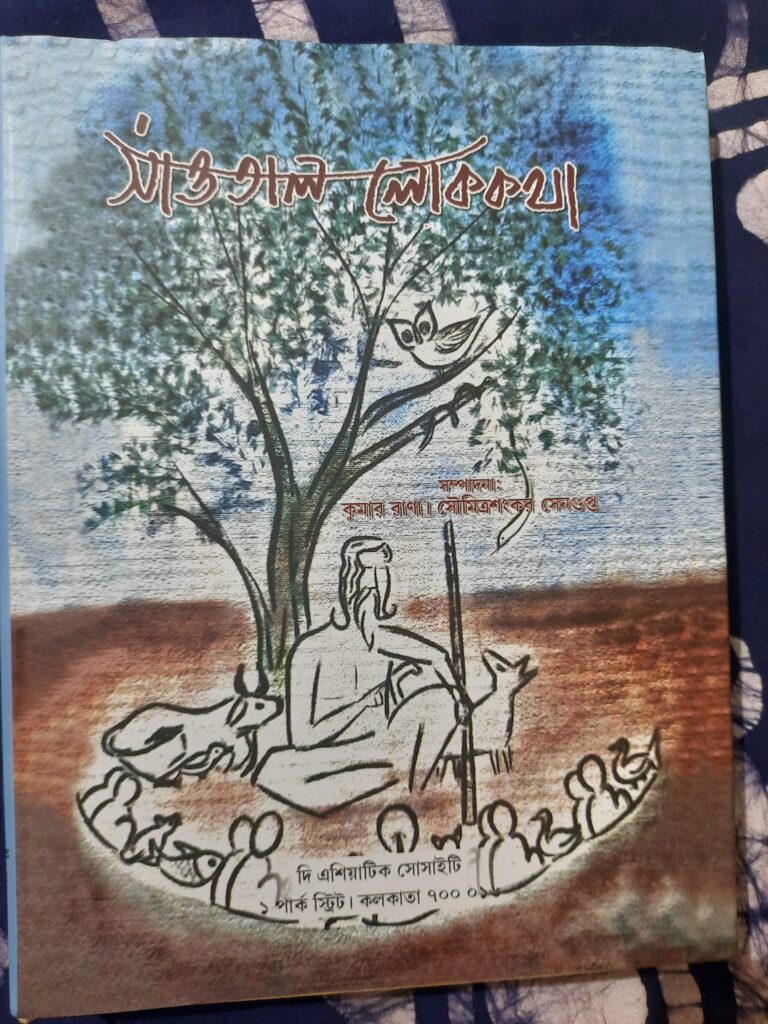
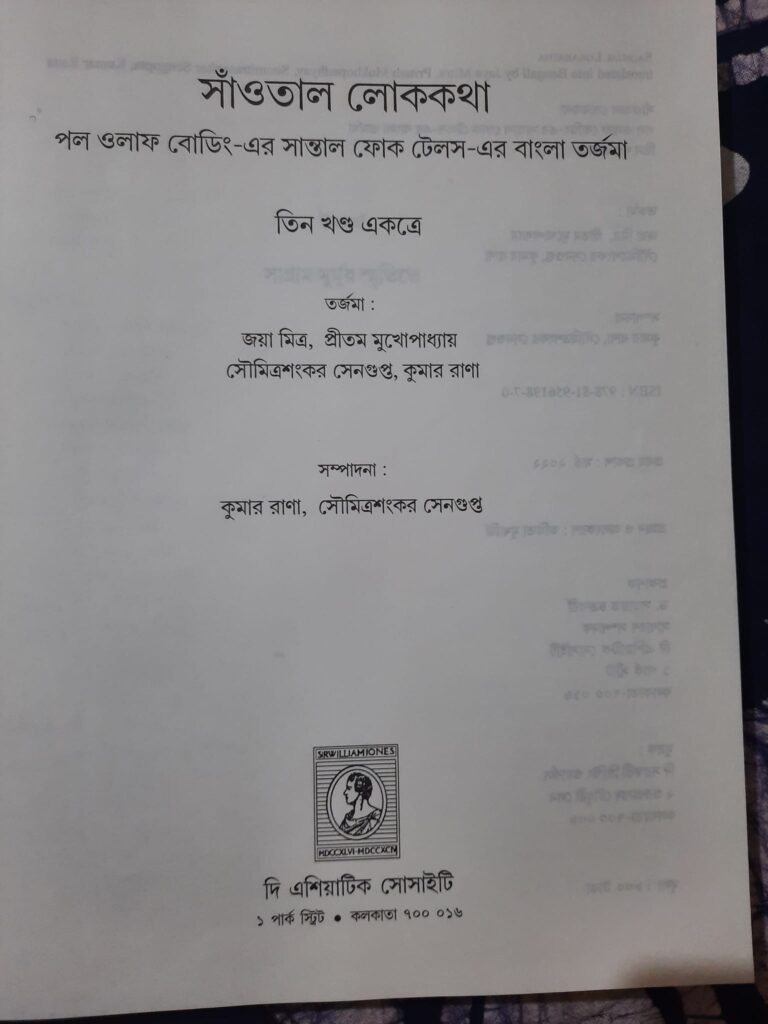
I just had to start talking about Bake’s recordings in Kairabani and the Dumka Mission and Soumitra knew far more than I did, although the matter of the archival recordings was new to him. He said there was probably some mention of the school band and of the music teacher Jacob Soren in Olav Hodne’s The Seed Bore Fruit (1967). By the evening, he sent me pages from the book.
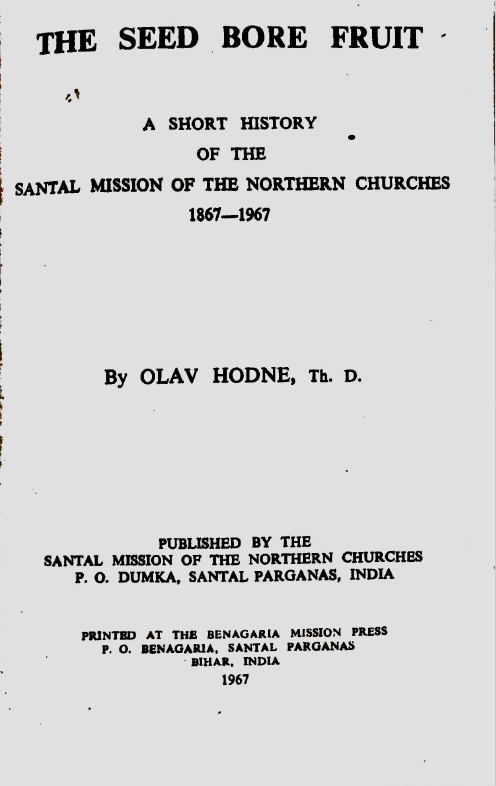
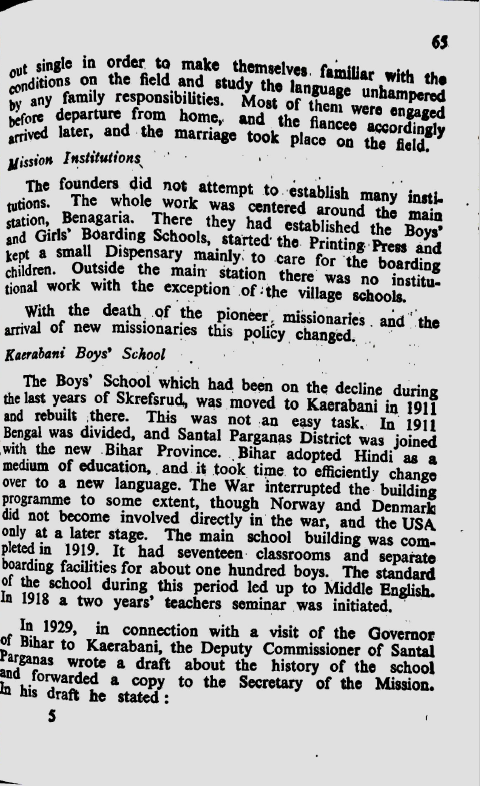
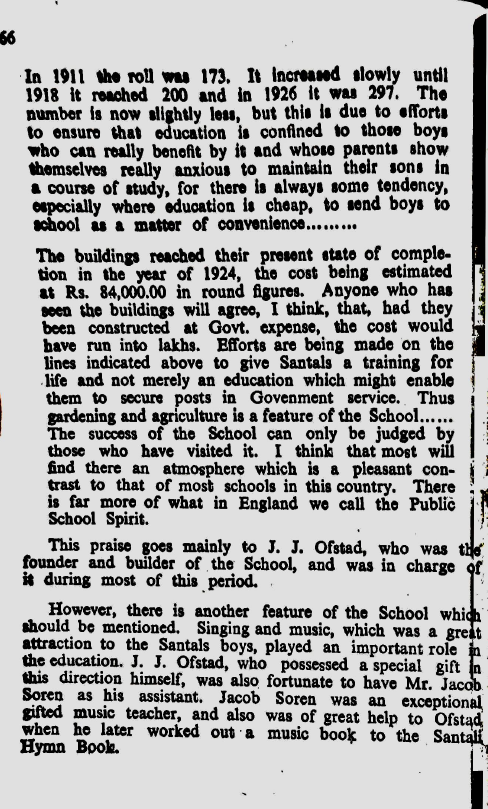
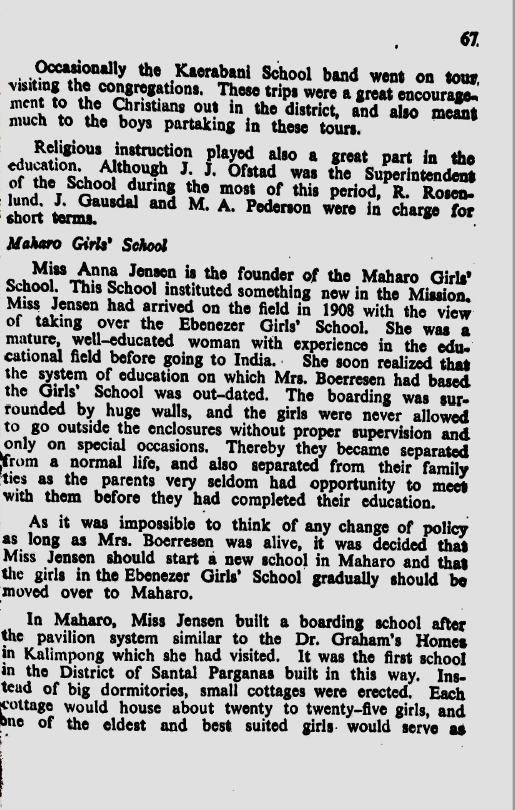
Arnold Bake had written to his mother on 25 March 1931 that he could not record dances in Kairabani but he would try and meet the district commissioner who was apparently interested in such matters and then come back and make more recordings.
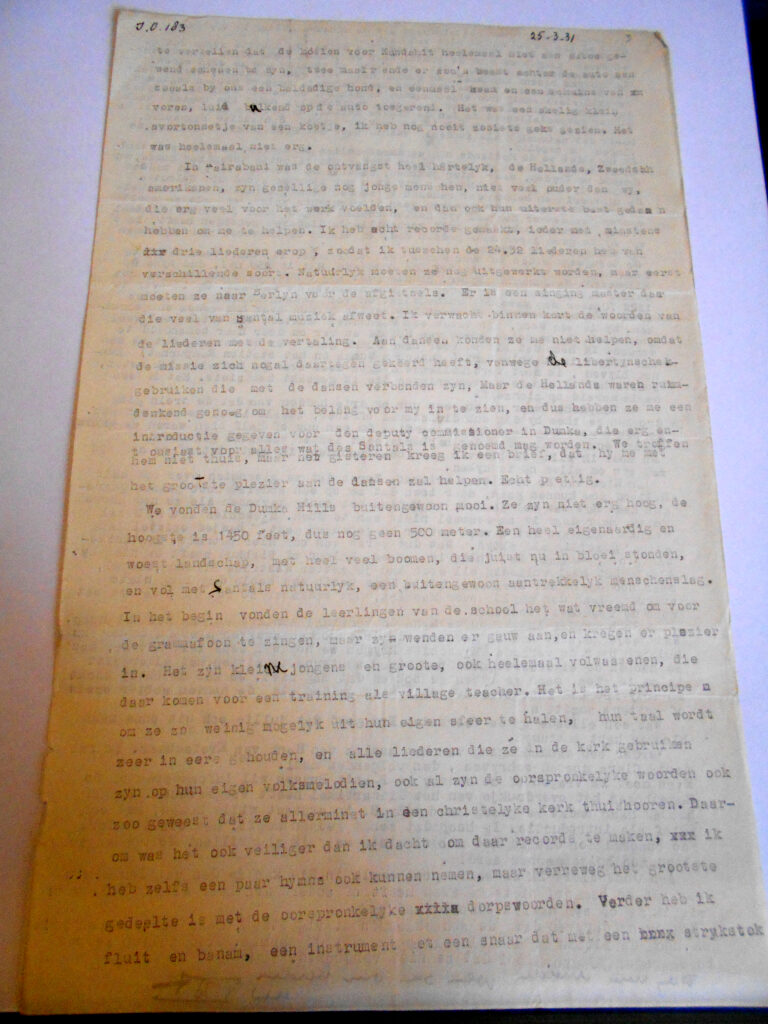
Page from Arnold Bake’s letter of 25 March 1931, written to his mother. Photo of this letter was taken when I was working in Leiden University library in 2015.
So, one of the questions I kept bothering Soumitra with was, who was this District Commissioner Bake was writing about? Give me two days, he replied. Then in an email of 3 March 2020, he wrote, ‘Are you talking about W. G. Archer? He wrote about Santal life, poetry and song in his Hill of Flutes. Archer joined the service in the Santal Parganas in 1931, but he was not a DM, he was an assistant magistrate.’ Names come with their own associations. W. G. Archer also wrote the notes and introduction to Deben Bhattacharya’s Songs of Vidyapati and I had a copy of the book.
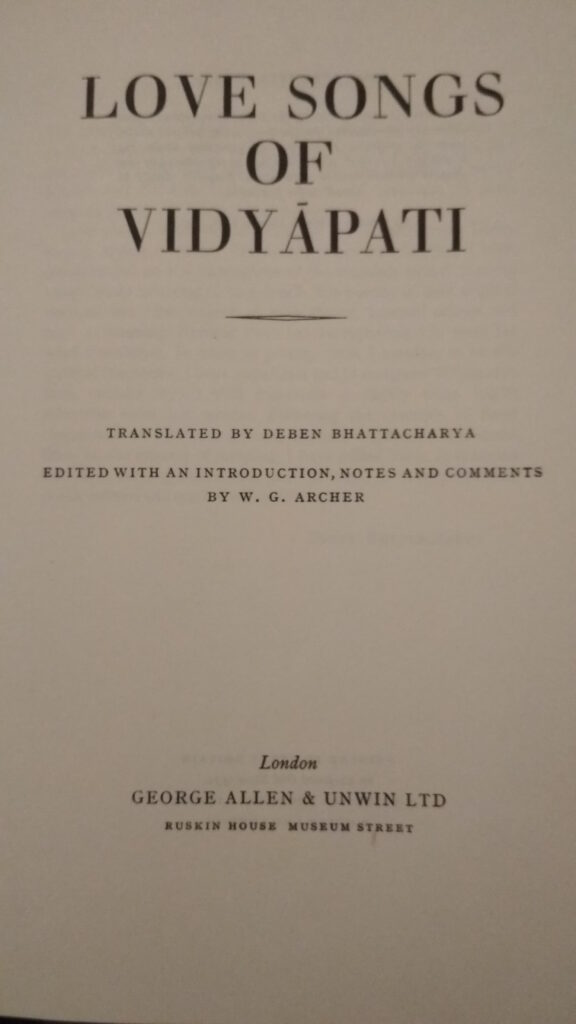
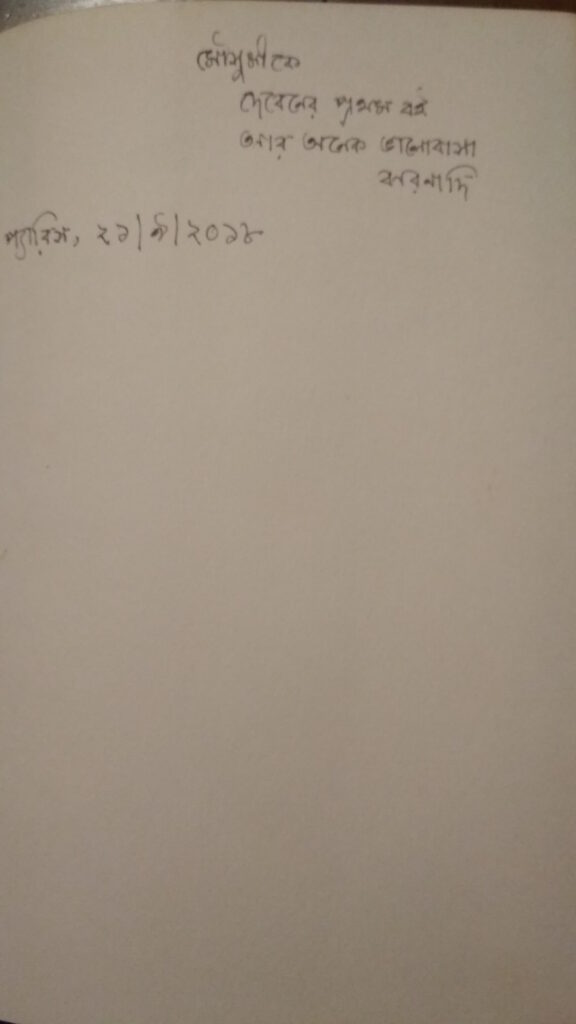
How archives are interwoven in this work. Our personal archives and the institutional archives become part of the same story, one leads us to another. I was in Deben Bhattacharya’s home in Paris in 2019 when his widow, Jharna Bose, the true keeper of his memory, gave me a copy of this book. It was for me like bringing back a handful of soil from an archaeological site.
As we already know, Debenbabu had recorded the Santals in 1954, two decades after Bake, and then again in 1973, and he could record both dance and the Hul seren! Everything seemed to be connected with everything. I got hold of a copy of The Hill of Flutes: Life, Love and Poetry in Tribal India: A Portrait of the Santals (first published in 1974 and republished in 2016), and was struck by its sheer depth and range and wondered how, just how people managed to do so much work in one lifetime.
What is a recording and how does one make a recording, even a sound recording? Here are some pages from W. G. Archer’s Hill of Flutes in which he lists the many riddles he had collected from the Santal Parganas. He wrote: ‘In the following riddles, day to day sights and sounds, aspects of village life and general Santal behaviour are widely invoked.’ I like the word ‘invoked’, the awakening of the sonic and visual, the record of the everyday lives of people through sound and image. Or, recording sound and image through text. Not a direct description of a sound, but a metaphorical, abstract way of talking–a flute is ‘a boy who weeps when he is taken to the end of the village.’ At the same time, if this list also had a transliteration of the riddles in Santali, then the reader would also hear something of the sound of the original language. Below , a piece of Archer’s ‘sound and image archive’.
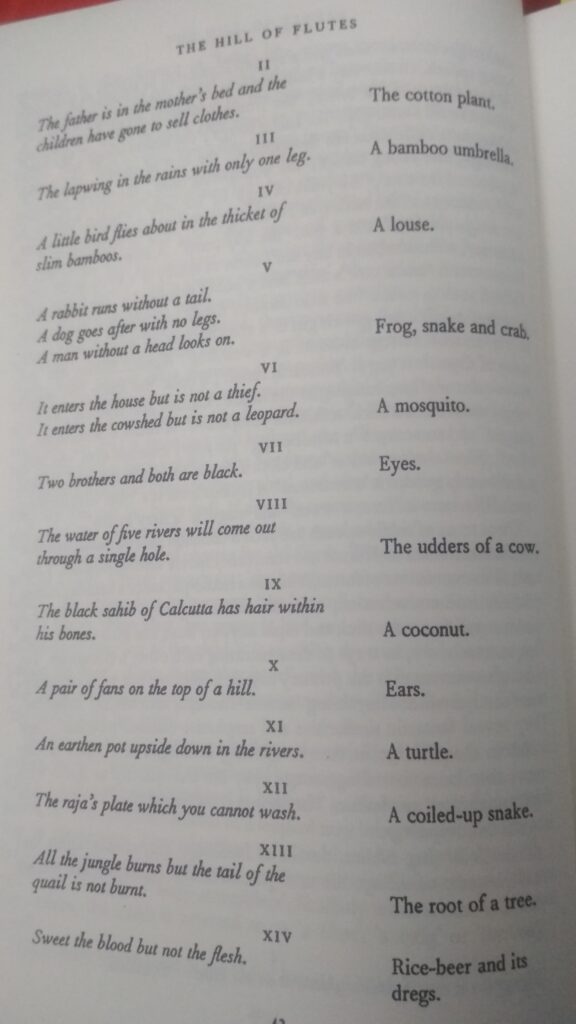
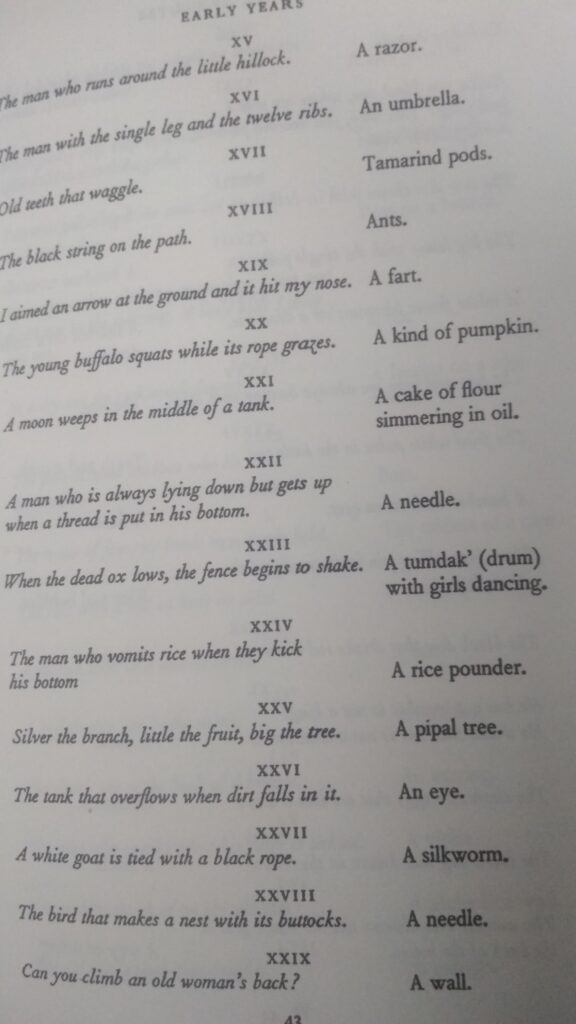
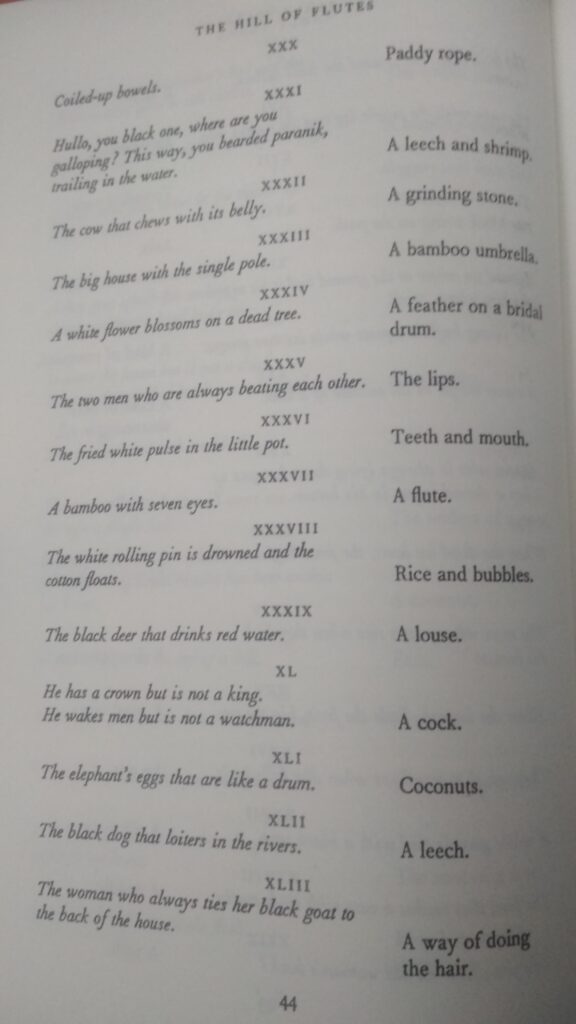
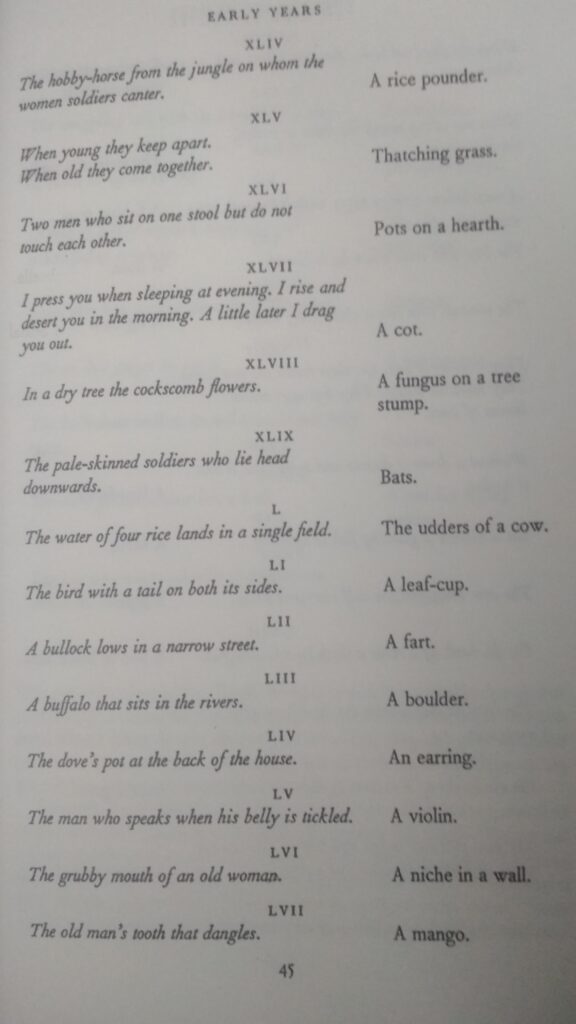
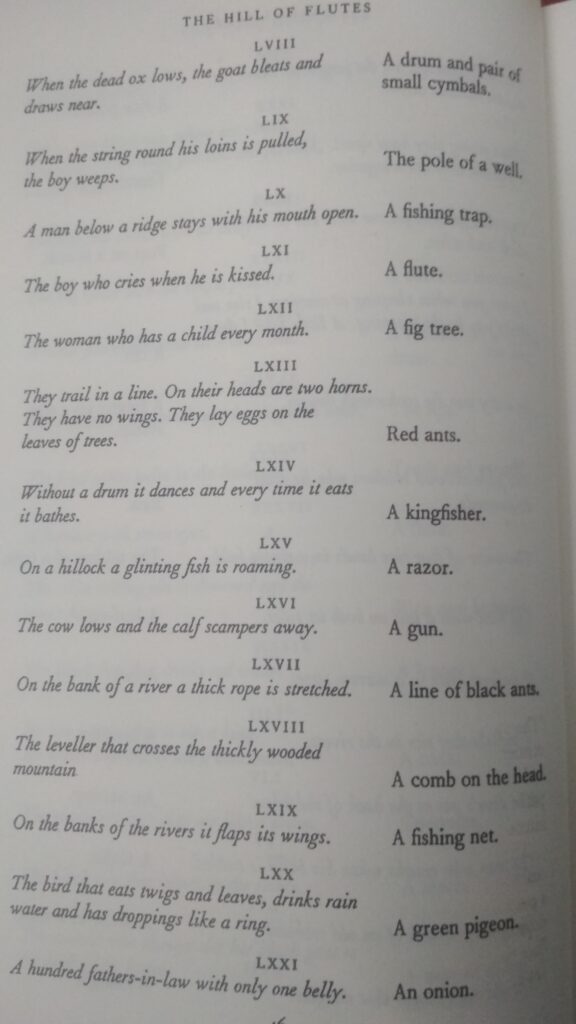
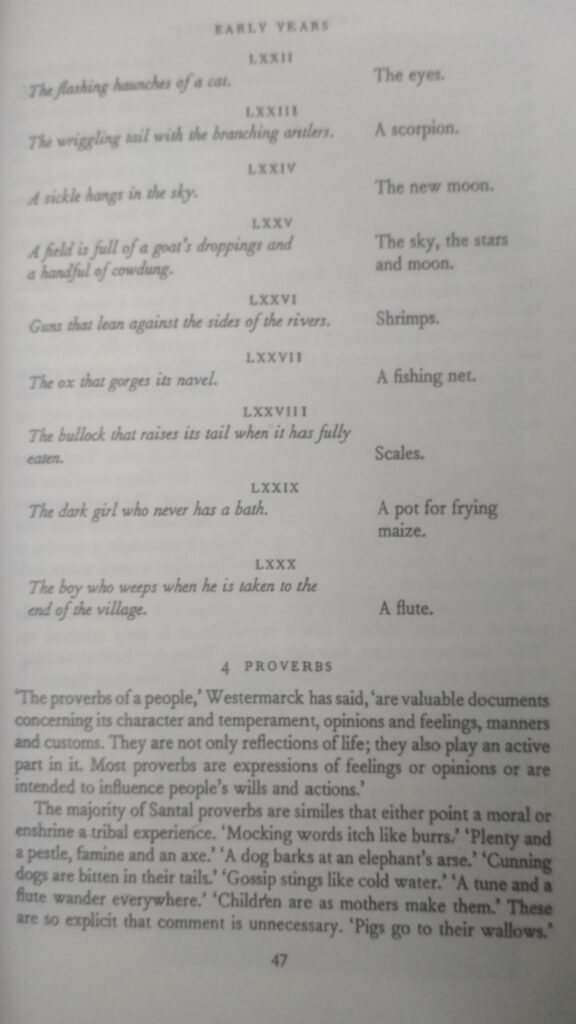
Have you read From Fire Rain to Rebellion by Peter Anderson, Marine Carrin and Santosh Soren ? This both Rahi and Soumitra asked me. And when I would get stuck with something, they would take photos of pages from their own copies and send to me. Then, as I was writing and writing more, and when I was going back again and again to Bodding’s work or to Archer’s like I would go to a library, and I also saw Rahi and Soumitra doing the same, I had to ask them the question on my mind: what then did they think the role of the missionaries or colonial scholars had been? Soumitra quotes Jomo Kenyatta on his Facebook page; that is his opening statement.
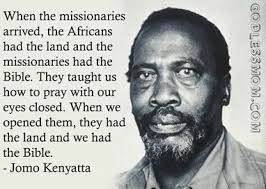
That would make the explanation fairly simple. But isn’t the question more complex, more nuanced? Weren’t there many more layers to this history? He wrote me a beautiful email in response, which I want to keep here in the original Bangla.
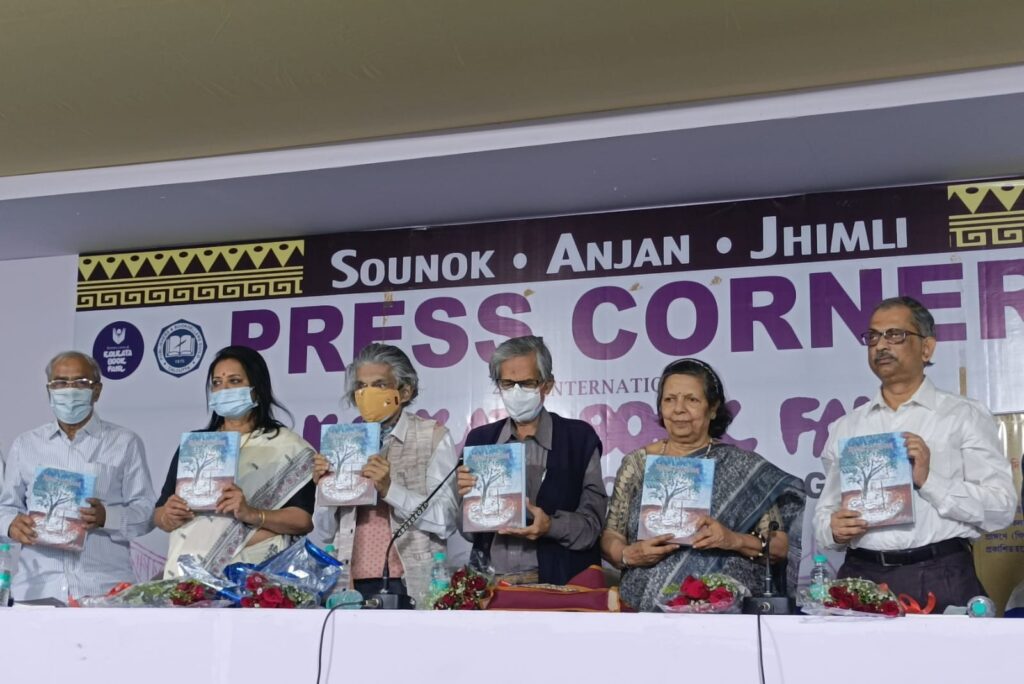
Soumitra Sankar Sengupta (extreme right) with others at the launch of their translation of Bodding’s anthology of Santal folkllore
I will come back to Soumitra again, but for now I want to write about two other Santal scholars and poets who helped me understand Bake’s songs and our recordings in Dumka. One, Susil Mandi and the other Biswajit Hansda, both young students of Jadavpur University, who came over to my home and listened with me to the recordings. We met over three evenings, on 16, 26 and 31 March 2019. My recorder broke on the second day and so the recordings were made on my mobile phone and the quality is poor, but the content of the recordings is lively and full of new ideas. As I have listened back to my recordings and interactions with Rahi or Soumitra or Susil and Biswajit, it has struck me how differently we perceive the same thing, how much of what our concerns are depends on where and how we are socially, culturally and politically located. Sushil, a political activist, talks mostly about social inequalities, Biswajit, barely 21 years old, is very literary and is thinking about words and translations and poetry and books. Rahi talks more about gender relations. Soumitra, older and wiser, has seen more of life. He works meticulously towards building and keeping an archive of archives. And finally Subhomoy Roy, a very young Bengali student of Santali at Visva Bharati, knows but uses his Bengali literary references to understand things, and then he has turn to his Santal teacher to ask for the meanings of things.
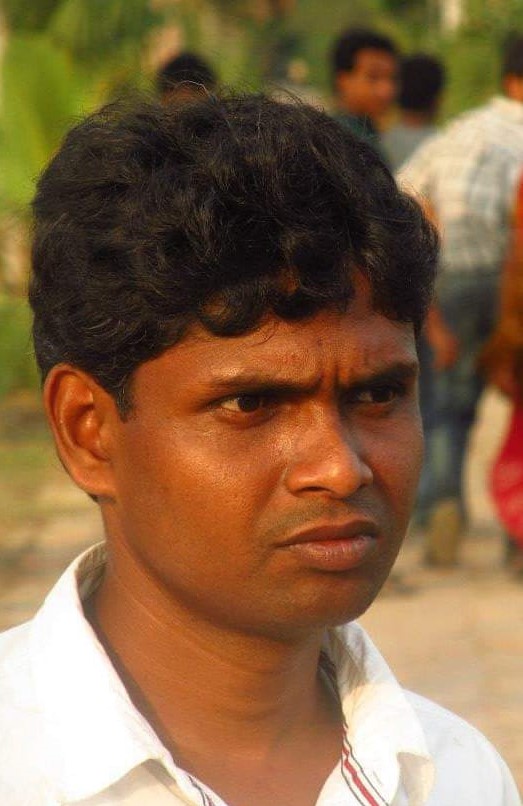
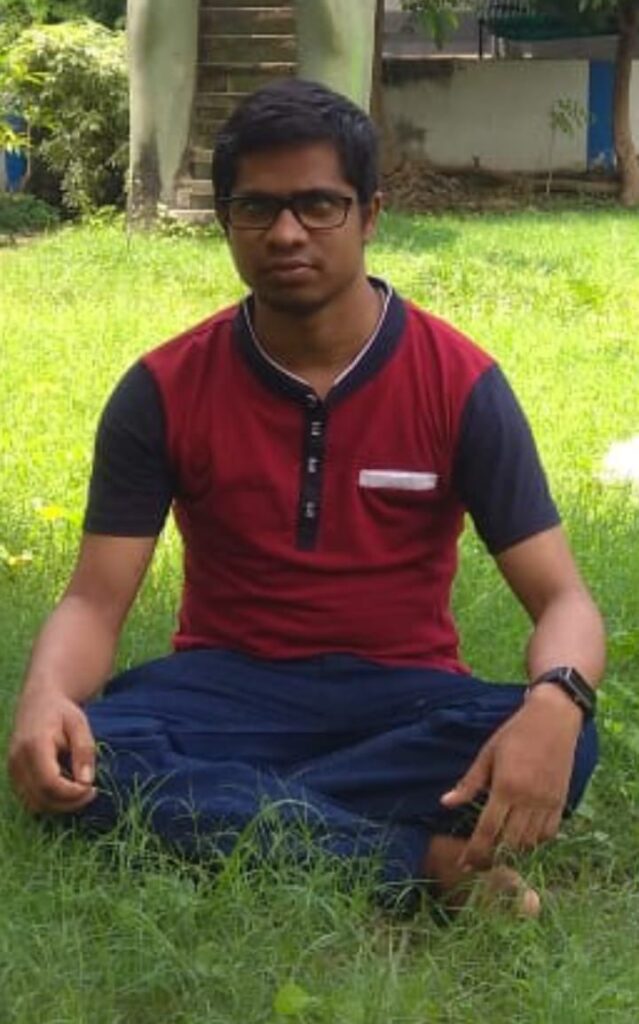
Recent photos of Susil Mandi and Biswajit Hansda which they sent to me. I did not take any photos when they came to my home.
I listened with Susil and Biswajit to the Kairabani recordings that we had made in 2017 (listen to some of those recordings here and in my other sub-chapter on the Santal recordings of Bake). They were interpreting the Santali conversations and adding their comments, while I was asking questions based on what I could hear. I thought I heard them say Marang Buru and then we talked about the importance of mountains in the Santal worldview and the place of mountains in the perpetuation of life on earth, and why the Santals worship the tall (marang) mountain (buru). Out of the two voices, Biswajit is younger and faster-paced, with high energy. Susil pays more attention to his utterances; he is the artiste. Recorded on 26 March 2019
The Arnold Bake recordings from Dumka began with a flute which the Kairabani listeners had identified as the flute played during their sikar or hunting festival. Sushil and Biswajit explain here the meaning of ‘disom sikar’ in which people from all around gather to take part in this communal hunt and merrymaking with music and dance. Recorded on 26 March 2019
What is the sohrai? Is it a harvest festival? I talk with everyone about the same thing, but never fully understand. Because there are many stories about the same thing, many descriptions and explanations. So, I suppose what I need to understand is that sohrai is not one thing, but many things. Such as Dasae is too. And how we describe something, with what references, shows how to relate to the world and what constitutes our worlds. Susil said sohrai was like nabanno, the Bengali harvest festival around new crops, nabo meaning new and anno meaning rice. No one else I talked to had drawn up this reference. Does that mean he is too assimilated into Bengali culture? Not quite. It means his world can hold other worlds and other references too. At the same time, he says what is special about Sohrai, what is uniquely Santal. Because it is not just about humans and their relation to the land, but it is also about other living things. During sohrai, animals of the house, such as cows, are decorated with colour and given special food, while trees are also at the centre of the celebration. Recorded in Jadavpur on 26 March 2019
They talk about different kinds of songs, what song is sung when, the difference between the songs and rituals of those who have stayed back in the land of their ancestors and those who have had to move to other places for work. About the dominating language and the dominated language. Such as Rahi had also said. Then Biswajit sings two don serens.
I had asked about the ‘lagre’ and if, etymologically, the words don and lagre had any special meaning and at first Biswajit said he would have to go home and think and would come back and tell me. Then he thought some more and said there was something he had heard about the word lagre having something to do with invoking rain. Lara means to shake up something and when clouds like the unmovable body of an elephant stick to the sky, there is the singing of the lagre down below, in the centre of the village, to bring down the rains. From lara comes lagre, he said. Even Susil was just listening to him. Whether what he was saying made any sense or not I would not be able to say but from one word we went to another, from thick elephant-clouds to flaky cottonwool, from rimil to rahla. This play of words went on for some time, and then Biswajit said the Kalidasa’s Meghdoot had been translated into the Santali by Shobhanath Besra and it was called Rahla Raibar, raibar meaning doot or messenger. I cannot say anything more about this exchange except that I liked to listen to their conversation and like to listen and learn about lives which are lived right by my side but about which I know so little.
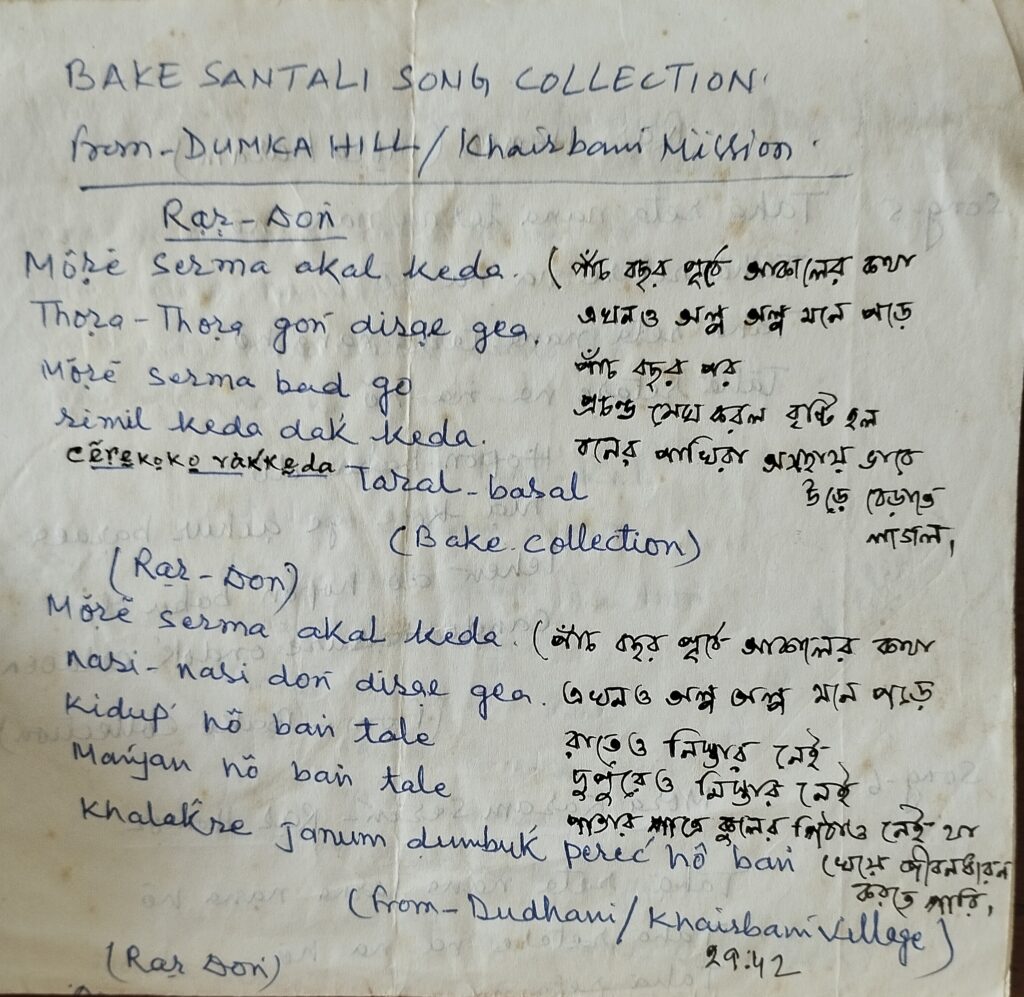
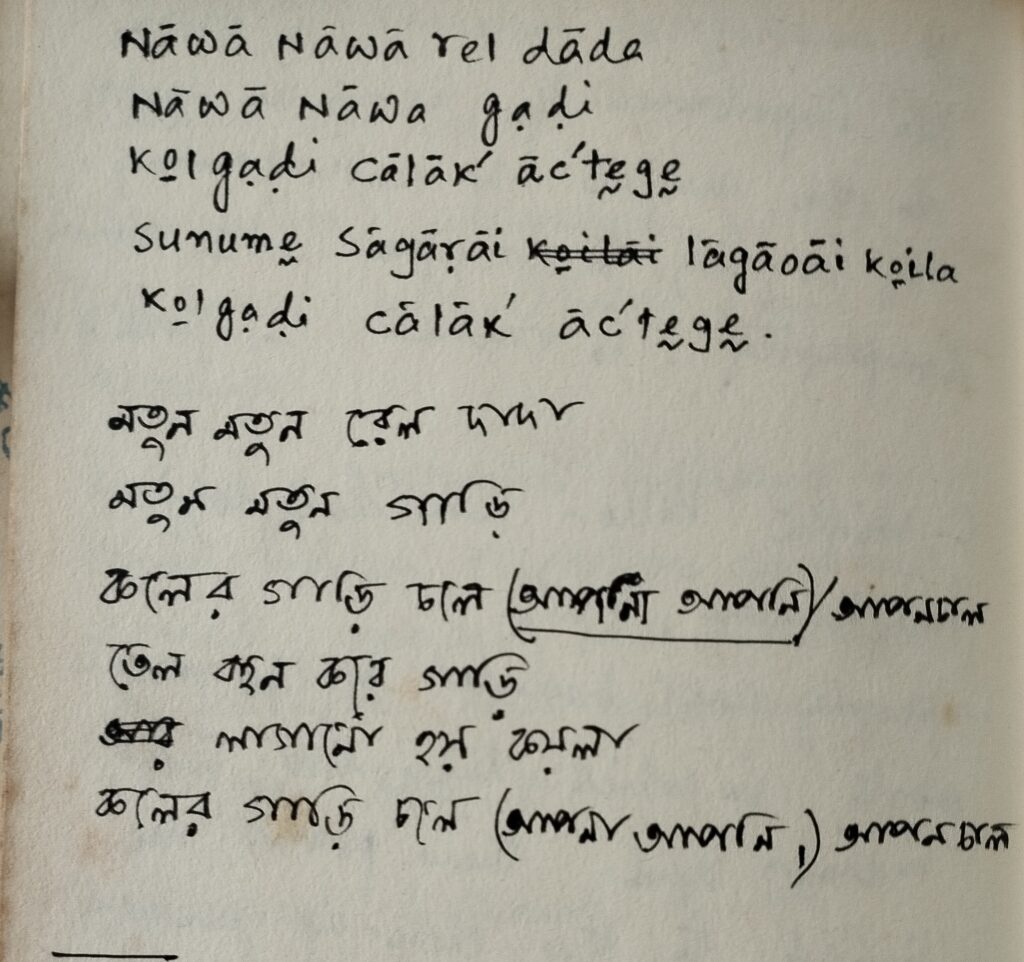
When we listened to the famine song that Arnold Bake had recorded and then to the one we recorded in Kairabani, Susil wrote down the words for me. Then we came to the locomotive song and what Susil wrote was so close to the rhythm and scansion of what we were hearing in the recordings that I began to sing his words, and together we made a song!
The ‘koler gari’ song, sung by Moushumi, Biswajit and Susil Mandi, on 31 March 2019.
Subhomoy Roy, a student of Santali in Visva Bharati in 2018 (teaches in a school since 2021), had connected with me for something to do with my songs and then when we got talking and he told me that he was specialising in Santali, I found that unusual. I told him about Bake’s recordings and mine. Then we met in Santiniketan and in Soumya Chakrabarti’s house we sat and listened to the recordings.
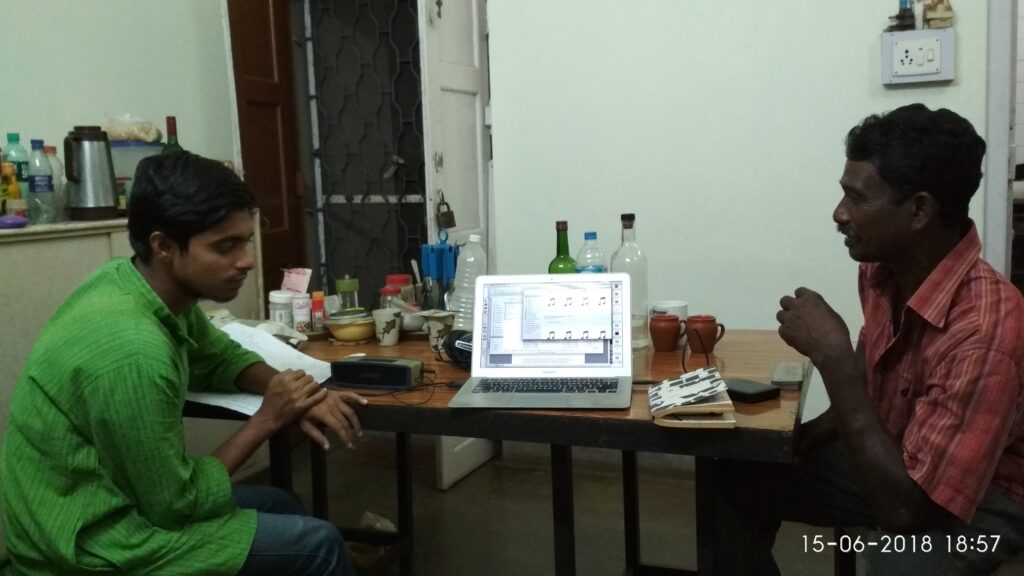
Listening with Subhomoy Roy and Charu Besra, from Kalapukur Danga village, near Santiniketan. 15 June 2018.
Subhomoy took some of Bake’s recordings to his teacher, Krishnapada Kisku, originally from west Midnapore district, who teaches Bangla in Albandha High School near Santiniketan. They listened together, and then his teacher sang him a song about the locomotive while Subhomoy wrote down the words. Then he sent both to me. But first what Kisku had to say about the Bonga song. He explained the words and showed how Bonga is not really shown in a positive light in the song. The second audio is the railgari song.
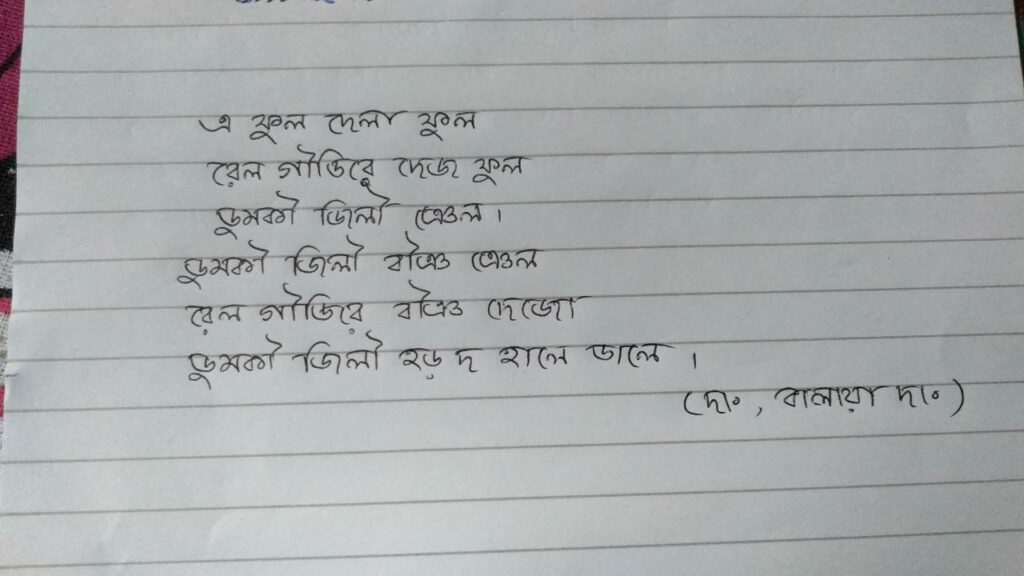
There was an image with Soumitra’s Facebook post, the one about Hul and his headmaster and Harma’s Village. He had got this photograph from his teacher, Arun Chowdhury’s collection. It shows the field of Bhagna Dihi, the village which gave us the leaders of the Santal rebellion of 1855-56, Sidhu, Kanhu, Chand and Bhairab It was taken in 1971. As I listened to Krishnapada Kisku’s locomotive song, I thought I could hear it cutting across this photograph—the sound and image inscribing a text on each other’s bodies, taking us from the past to the future and back.
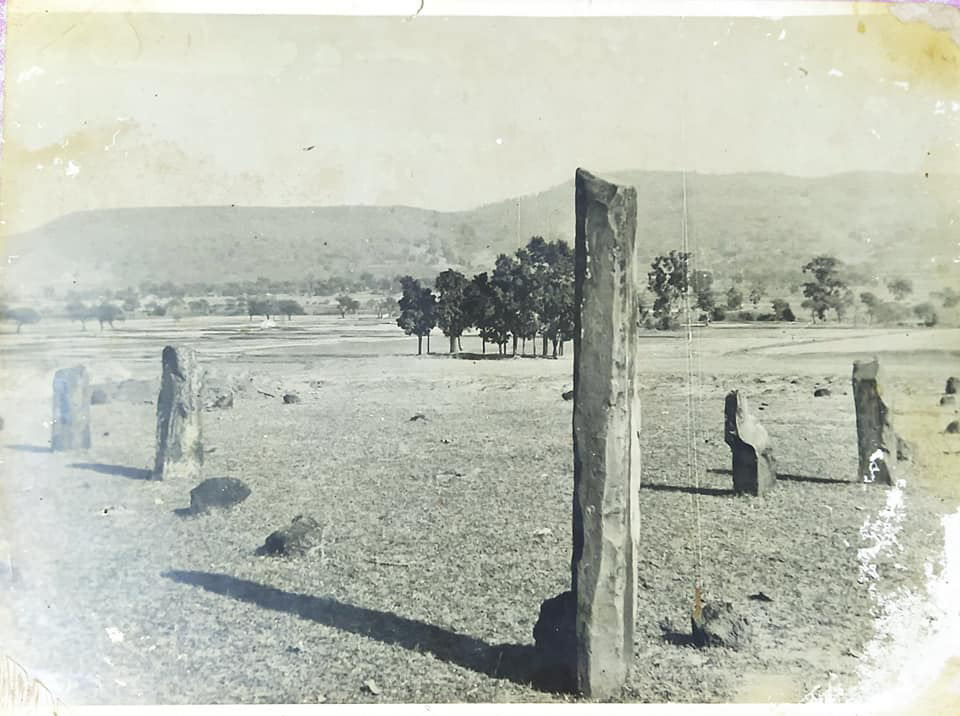
This is where this sub-chapter would end, except that such things can go on forever. I am grateful to Soumitra Sankar Sengupta and Kumar Rana for allowing me to keep here their introduction to their Bangla anthology of Bodding’s folktales collection. I have drawn such inspiration from their writing that it feels selfish not to share it with others.
ভূমিকা
এক
সে অনেক দিন আগের কথা। সাঁওতাল পরগণাতে সাঁওতালদের বসত গড়ার প্রায় একশ বছর কেটে গেছে। লোকে বলে, সাঁওতালরা এসেছিলেন হাজারিবাগ অঞ্চল থেকে। মেলা কথা, এক দল সাঁওতালের বাস হল সাঁওতাল পরগণায়, অন্য দলের হল সিংভূম-পুরুলিয়া-বাঁকুড়া-ঝাড়গ্রাম-ময়ুরভঞ্জের বিরাট অঞ্চলে। কবে কখন কীভাবে হল তার সঠিক হদিশ আমরা জানি না, আর এখানে সে-সব কথার খোঁজও করা যাবে না। কেন না, এখানকার কথা শুরু হচ্ছে সাঁওতাল পরগণা থেকে। কিন্তু, লতায় পাতায়, কথা-কথালির হাত ধরে এখানকার সাঁওতালের সঙ্গে অন্য জায়গার, বহু দূর দেশের, উড়িষ্যা-আসাম-বাঁকুড়া-শিলদার সাঁওতালের যোগ তো থাকবেই। কথায় বলে এক মায়ের ছেলে-মেয়ে, যত দূরে দূরে থাক, ভাই ভাই থাকে, বোন বোন থাকে। তাদের কথাও কথাই থাকে।
তা সাঁওতালরা যখন এখানে আসেন, তখন এ অঞ্চলে পাহাড়িয়াদের বসবাস। তখনো সাঁওতাল পরগণা নাম হয়নি। নাম হল ১৮৫৫ সালে, সাঁওতালদের সেই বিরাট বিদ্রোহের পর। তখন এই অঞ্চলের নাম দামিন-ই-কোহ, যার মানে পাহাড়ের আঁচল। ফার্সিতে কোহ হল পাহাড়, আর দামন হল আঁচল। ইংরেজ কোম্পানি সাঁওতালদের কথা দিয়েছিল, এখানে এসে জমি-জায়গা তৈরি করে বসত গড়তে জমির খাজনা লাগবে না। সাঁওতাল পাহাড়-বন-টাঁড় কেটে জমি তৈরি করতে ওস্তাদ। দামিন-ই-কোহ জুড়ে গড়ে উঠল তাঁদের বসত। পাহাড়িয়াদের সঙ্গে ঝগড়া-ঝাঁটিও হল, কিন্তু আস্তে আস্তে সে সব মিটে গেল। তা করতে সেখানে এসে জুটল বাঙালি-বিহারি ব্যাপারি-মহাজনরা, সাঁওতালের ভাষায় দিকু। তারা ইংরেজের মদত পেল। ইংরেজ তাদের মদত পেল। সাঁওতালের জীবন হয়ে উঠল অতীষ্ঠ, ঋণ-কর্জায় বাঁধা পড়ল তার খেত। যে সাঁওতালের ঘর ভরে থাকত গরু-ছাগল-মুরগি-শুয়োর, যার ধানের মরাই সারা বছর ভরভরন্ত থাকত, যার ঘর ভর্তি বাঁশীর সুর, সাঁঝভর্তি বানাম-টামাক-তুমদার আওয়াজ, রাতভর্তি নাচ-গান-গল্প, শত শত বছর ধরে গড়ে তোলা ঘর-বংশ, ক-বছরের তফাতে সে হয়ে গেল দিনমজুর। তার জমি গেল, আবাদ গেল, খাবারের সংস্থান গেল। তাকে আষ্টেপৃষ্টে জড়িয়ে ধরল ঋণ-কর্জা। সেই অনাচারে দগ্ধ হয়ে সাঁওতাল বিদ্রোহ করল, সে-বিদ্রোহের নাম হুল। সে বিদ্রোহের কথা আমরা কম বেশি জানি। বছর বছর ৩০ জুন নানা লোক-বাক, সরকার-বেসরকার হুল দিবস মানায়। মনে করা হয় কেমন করে দুই বড় ভাই সিধু-কানু আর তাদের দুই ছোট ভাই চাঁদ-ভৈরবের সঙ্গে মিলে সাঁওতালরা লড়াইতে নেমেছিল। সে-সব কথার অনেক কিছুই কিন্তু কথা থেকে পাওয়া, লোকের মুখে মুখে ছড়িয়ে গিয়েছিল যে-সব কথা সেই সব কাহিনি থেকে। আবার অনেক কথা আমরা তেমনভাবে শুনতেও পাইনি। যেমন, সেই চার ভাইএর দুই বোন ফুলো-ঝানো আর তাদের সঙ্গে আরো আরো সাঁওতাল মেয়েদের সেই লড়াইতে যোগ দেবার কথা। সে-কথা থাক। আমরা আমাদের গল্পে ফিরে আসি।
সেই বিদ্রোহের বছর, ১৮৫৫ সালে, বীরভূমের একটা অংশ আর ভাগলপুরের একটা অংশ কেটে তৈরি হল সাঁওতাল পরগণা জেলা, সদর হল দুমকা। দুমকা নামটা এসেছে, লোকে তাই বলে, দামিন-ই-কোহ থেকে। এই দুমকাকে কেন্দ্র করে যেমন একদিন তার সর্বস্ব গেছিল, তেমনি একে কেন্দ্র করেই সংগৃহীত হয়ে উঠল সাঁওতালের প্রাণের ধনগুলো – তার ভাষা-কথা-গাছ-গাছড়া-ওষুধ-দৈনন্দিন চর্চা।
সেই দুমকা জেলায়, আজ থেকে একশ তিরিশ বছর আগে, ১৮৯০ খ্রিস্টাব্দের জানুয়ারি মাসে এসে পৌঁছলেন এক যুবক পাদ্রি। বয়েস মাত্র পঁচিশ বছর, নাম পল ওলাফ বোডিং, পি. ও. বোডিং নামে যাঁর খ্যাতি। তাঁর দেশ নরওয়ে। তাঁকে নিয়ে আসেন নরওয়ে দেশের আর এক মানুষ, লার্স ওলসেন স্ক্রেফস্রাড, এল ও স্ক্রেফস্রাড বলে লোকে তাঁকে জানে। স্ক্রেফস্রাড খুব কম বয়সে জেলে যান, জেল থেকে বেরিয়ে পাদ্রি হয়ে যান এবং ১৮৬৩ সালে গসনার মিশনের কাজে মাত্র তেইশ বছর বয়সে ভারতে আসেন। প্রথমে অধুনা পশ্চিমবাংলার পুরুলিয়াতে কিছুদিন থাকার পর যান রাঁচি, বর্তমান ঝাড়খণ্ড রাজ্যের সদর। ১৯০০ সালে এই রাঁচি শহরের জেলে মারা যান ব্রিটিশ রাজের বিরুদ্ধে মুণ্ডা বিদ্রোহের নেতা, ধারতি আবা, বিরসা মুণ্ডা। সে অন্য উপাখ্যান। শুধু এইটুকু বলে রাখা যায়, মুণ্ডা আর সাঁওতালের সম্পর্ক নিবিড়, বিশেষ ভাষার দিক দিয়ে। পুরোটাই মিলে মিল, ফারাক কম। স্ক্রেফস্রাড সেখানে কাটান চার বছর, ১৮৬৭তে তাঁর দিনেমার সহকর্মী হান্স পিটার বোরেসেন-এর সঙ্গে সাঁওতাল পরগণায় আসেন, সেখানে বর্তমান দুমকা জেলার বেনাগাড়িয়াতে এবেনেজার মিশন স্টেশন প্রতিষ্ঠা করেন। তাঁদের সঙ্গে ছিলেন ব্যাপটিস্ট মিশন সোসাইটির এক ইংরেজ পাদ্রি, নাম এডওয়ার্ড কল্পয়েস জনসন। খুবই সম্ভব যে, রাঁচিতে স্ক্রেফস্রার্ড মুণ্ডারি ভাষার সংস্পর্শে আসেন, যা তাঁকে সহজে সাঁওতালি ভাষার ভিতরবাড়িতে ঢুকে যেতে দেয়।
তা অনেক পাদ্রি তো এদেশে এসেছে, ইংরেজরাও এসেছে, তারা কি কখনো সাঁওতালদের মধ্যে কাজ করার কথা ভাবে নি? ভেবেছিল। যেমন উইলিয়াম কেরি সাহেবই তো ভেবেছিলেন। তিনি যখন মালদার মদনাবাটি থেকে দিনেমার উপনিবেশ শ্রীরামপুরে তখনই তিনি সাঁওতালদের ব্যাপারে খবর নিতে থাকেন। এমনকি তাঁর পাদ্রি বন্ধু উইলিয়াল ওয়ার্ডকে নিয়ে তিনি সাঁওতালদের দেশেও যান। সাঁওতালরা তাঁকে খুব টানে, কিন্তু নানা কারণে তাঁর সাঁওতালদের মধ্যে কাজ করার ইচ্ছা পূরণ হয়নি। সাঁওতালদের ঘনিষ্ঠ সংস্পর্শে আসা প্রথম পাদ্রি ছিলেন রেভারেন্ড এ. লেসলি। সে প্রায় দুশো বছর হতে চলল, ১৮২৪ সালে লেসলি ইংল্যান্ড থেকে ভারতে আসেন। তিন বছর কম কুড়ি বছর কাজ করেন রাজমহল পাহাড়ে সাঁওতালদের মধ্যে, তখনো সাঁওতাল হুল হতে অনেক দেরি। তা করতে লেসলি সাহেব খুব অসুখে পড়লেন, আর চারা না পেয়ে দেশে ফিরে গেলেন। এর তিরিশ বছরের ভিতর কোনো ইংরেজ পাদ্রি সাঁওতালদের মধ্যে কাজ করতে আসেননি। যতদিনে আসলেন, ততদিনে সাঁওতাল হুল হয়ে গেছে। কিছু ইংরাজ পাদ্রি এসে বীরভূমের সাঁওতালদের মধ্যে কাজ করতে শুরে করেন। সেটা ১৮৬৪-৬৫ সাল নাগাদ।
কিন্তু লেসলি সাহেব যখন রাজমহলে, তখন, ১৮৩৬ সালে আমেরিকার নিউ হ্যাম্পশায়ারের ফ্রি উইল ব্যাপ্টিস্ট ফরেন মিশন সোসাইটি এলি নয়েস ও জেরেমিয়া ফিলিপস নামের দুজন পাদ্রিকে কলকাতা পাঠায়। সেখান থেকে তাঁরা যান ওডিশা, করতে করতে তাঁরা সেখানে সাঁওতালদের সংস্পর্শে আসেন। চার বছর পর এলিকে ফিরে যেতে হয়, কিন্তু জেরেমিয়া থেকে যান। তিনি সাঁওতালি ভাষা শেখেন, আর ১৮৪৫ সালে সাঁওতালি ভাষায় একটি পুস্তিকা ছেপে বের করেন, এর লিপি ছিল বাংলা। এটাই হচ্ছে সাঁওতালি ভাষায় প্রথম কোনো ছাপা জিনিস। শুধু তাই নয়, ১৮৫২ সালে তিনি সাঁওতালি ভাষায় একটা ব্যাকরণও লেখেন।
মানে কথা, সাঁওতালদের ভাষা, সমাজ, আচার-বিচার নানা পাদ্রি, নানা বিদেশিকে টেনেছে। তাঁরা খ্রিস্টধর্ম প্রচার করতে এসেছিলেন ঠিকই, কিন্তু তাঁদের অনেকেরই প্রধান কাজ হয়ে দাঁড়াল এই মানুষদের জীবন নিয়ে লেখাপড়া করা, বিশ্বসংসারের কাছে এঁদের অমূল্য সম্পদ সাঁওতালি ভাষাকে তুলে ধরা। বোডিং নিজে মনে করতেন এ ভাষাভাষী লোকেরা এক সময় খুবই চিন্তাভাবনার কাজ করেছে, মাথার ঘাম যেমন পায়ে ফেলেছে, তেমনি মাথার ভিতর অনেক ঘাম ঝরিয়েছে। এমন এগিয়ে থাকা একটা ভাষার ভিতরঘরে কী আছে তা জানতে হবে না? দুনিয়ার লোক জানবে না, এমন একটা সম্পদের কথা? সাঁওতালি হোক বা সংস্কৃত, গ্রিক বা তামিল, এ সম্পদ তো মানুষের – পৃথিবীর সব লোকের। এভাবেই সাঁওতালি নিয়ে শুরু হল নানা চর্চা। এ কাজে সবচেয়ে এগিয়ে থাকা মানুষ স্ক্রেফস্রাড। প্রথম দশ বছর তাঁর সাঁওতালি শেখার সহায়ক ছিলেন খোদো। খোদো মারা যাওয়ার পর তিনি লিখেছিলেন: আমার মাস্টার খোদো বাড়ি ফিরে গেছে। সাঁওতালি ভাষায় মারা যাওয়া বোঝাতে নানা রূপকের ব্যবহার: বাড়ি ফিরে যাওয়া একটা, আবার, এগিয়ে যাওয়া আর একটা। এই পুরি থেকে ওই পুরিতে রওনা দেওয়া অন্য একটা। মানুষ রূপকে বেঁচে থাকে, তাই হয়তো মারা যাবার মতো একটা ঘটনাও ভাষায় প্রকাশ পেতে রূপকের আশ্রয় চায়। যাই হোক, এরপর একুশ বছর ধরে তাঁর সঙ্গে ছিলেন বিরাম হাঁসদা। যে কোনো ভাষার নিজস্বতা ফুটে ওঠে বাগধারাতে। সাঁওতালি ভাষার বাগধারাগুলো বিরাম যেমন জানতেন তেমন নাকি সাঁওতাল দুনিয়ায় কেউ জানতেন না। তাঁর কাছ থেকে মন দিয়ে সেইসব বাগধারা শিখেছিলেন বলেই স্ক্রেফস্রাডের ভাষা এত মিঠে।
তা করতে, স্ক্রেফস্রাডের নেতৃত্বে শুরু হল সাঁওতালি ভাষায় বাইবেলের তর্জমা, তার পর লেখা হল সাঁওতালি ব্যাকরণ। কিন্তু, তার আগেই স্ক্রেফস্রাড শুরু করেন এক বিরাট কাজ। তিনি খোঁজ পেলেন সাঁওতাল গুরু কলিয়ানের। সেই গুরু জানতেন সাঁওতালদের আদি কথা। কীভাবে পৃথিবী গড়ে উঠল, কীভাবে হাঁস-হাঁসিলের জন্ম, কীভাবে হাঁসিল দুটো সমান মাপের ডিম পাড়ল, আর সেখান থেকে জন্ম হল পিলচু হাড়াম আর পিলচি বুঢ়ির, আর তাদের থাকার জন্য ঠাকুর তৈরি করলেন এই পৃথিবী। তারপর সেই পিলচু হাড়াম আরে পিলচু বুঢ়ি থেকে এত লোক হল – এত বংশ হল। তারপর কোথায় সেই হিহিড়ি পিপিড়ি থেকে তারা এসে পৌঁছলো চাঁই চম্পাগড়, সেখান থেকে আবার মাদো সিং রাজার সঙ্গে ঝগড়া, আর সিংদুয়ার, বাহিদুয়ার ভেঙে সাঁওতালরা চলে এল এইদিকে। এই সব কাহিনি, যা জন্ম জন্ম ধরে সাঁওতালরা ছাটিয়ার বিন্তি হিসেবে বলে এসেছে, এক জন্ম থেকে আরেক জন্মে মনে রেখেছে, সেই সব কথা গুরু কলিয়ানের চেয়ে ভাল কেউ জানত না। তা স্ক্রেফস্রাড সাহেব সেই গুরুর চেলা হলেন। চেলা না হলে শিখবেন কী করে? সাদা চামড়ার পাদ্রি তাই শিষ্যত্ব নিলেন কালো চামড়ার গুরুর। তাঁর গুরুভাই হলেন জুগিয়া হাড়াম। গুরু কলিয়ানের কাছ থেকে সেই সব কাহিনি শুনে শুনে স্রেফস্রাড লিখে রাখতে লাগলেন। সাঁওতালদের ইতিহাস, সমাজ, সংস্কৃতি নিয়ে একটা খনি হয়ে রইল সেই লেখা। ১৮৭১ সালের ১৫ ফেব্রুয়ারি কলিয়ান গুরুর কথা শেষ হল, আর ১৮৮৭ সালে সাঁওতালি ভাষায় বই হিসেবে বেরলো সেই কথা: হড়কোরেন মারে হাপড়ামকো রেয়া কাথা (সাঁওতালদের পুরনো বুড়োদের কথা)। অনেক পরে বোডিং এর ইংরেজি তর্জমা করেন। কিন্তু এই ইংরেজি তর্জমা প্রকাশিত হয় বোডিংএর মৃত্যুর ছ-বছর পর, স্টেন কোনো-র সম্পাদনায়, ট্র্যাডিশনস অ্যান্ড ইন্সটিটিউশনস অব দ্য সান্তালস নামে। ১৯৫১ সালের জনগণনার সময় অশোক মিত্র-র অনুরোধে এই বইয়ের বাংলা তর্জমা করেছিলেন বৈদ্যনাথ হাঁসদা। সেটা বাঁকুড়া জেলার জনগণনার হাতড়াতে ছাপা হয়।
কলিয়ান গুরু একজন লোক বটে, কিন্তু তিনি আবার গুরু, মানে অনেক লোক, আর সকলের জ্ঞান, তাঁর ভিতর ঢুকে আছে। কলিয়ান গুরু যে কথাগুলো স্ক্রেফস্রাড আর জুগিয়া হাড়ামকে শোনালেন সে তো আর শুধু তাঁর একার কথা নয় – সব সাঁওতালের কথা। সেই হিহিড়ি পিপিড়ি, কঁয়ডা, কান্দাহারি, চাঁই চম্পাগড় – যেখানে যেখানে ছিল তার ঘর, সেখানে সেখানে সেখানে সে জমা করেছে কথা। সেই হল তার আদি কাহিনি। কিন্তু আদি কাহিনির সঙ্গে সঙ্গে চলতে থাকে তার প্রতিদিনকার কথা। আজ যে সাঁওতাল পরগণায় তার বাস, কিম্বা ওডিশায়, কিম্বা, ঝাড়গ্রাম-সিংভূম-মানবাজার-খাতড়া-হিড়বাঁধ- কোকড়াঝাড়-রাজশাহী-নাটোর – যেখানে যেখানে সে থাকছে, সেই সেই গাঁ-দেশ-লোক-গাছ-পাখি-পশু, সে-সব জায়গার ভাল-মন্দ, হাকিম-হুকুম, সব এসে তার কথায় জমা হয়। হাঁটতে হাঁটতে কথা, কাজের ফাঁকে জিরিয়ে নিতে নিতে কথা, গরু-ছাগল চরাতে চরাতে কথা, শীতের রাতে আগুন পোয়াতে পোয়াতে কথা – কথার শেষ নেই। সে কথার কতক হল যা যা চোখে দেখা যায়, যা যা হাতে ছোঁয়া যায়, আর কতক হল যা খালিচোখে দেখা যায় না, খালিহাতে ছোঁয়া যায় না – তাকে দেখতে হয় মনের চোখ দিয়ে, তাকে ধরতে হয় মনের হাত দিয়ে। আর এক কথা। সাঁওতালের মন উদার। ভাষা বিষয়ে তো বটেই। যেখানে সে মনের মতো, কাজে লাগার মতো শব্দ পেয়েছে, আদর করে তাকে নিজের ঘরে বসিয়েছে, ছুতমার্গ করেনি। তাই তো এ ভাষা এতো বিশাল – কত দিন-দুনিয়ার শব্দ তার ভিতর ঢুকে আছে। আবার উল্টোদিকে দিন-দুনিয়ার নানা ভাষায় কত শত সাঁওতাল শব্দ ঢুকে আছে।
বোডিং কুড়োতে লাগলেন সেইসব কথা। তিনি পাদ্রিও বটে আবার নানা বিষয়ে পণ্ডিতও বটে। তিনি স্ক্রেফস্রাডের সঙ্গে যোগ দেওয়াতে সাঁওতালি ভাষা নিয়ে চর্চা অনেক বেড়ে গেল। স্ক্রেফস্রাড শুরু করেছিলেন সাঁওতালি শব্দ কুড়ানোর কাজ, কয়েক হাজার শব্দ তিনি জোগাড়ও করেন। কিন্তু তাঁর অনেক কাজ, পেরে উঠছিলেন না, বোডিংকে দায়িত্ব দিলেন সাঁওতালি ভাষার একটা অভিধান তৈরি করার। কাজ শুরু হল বটে, কিন্তু শেষ হতে লেগে গেল বহু দিন। অভিধান তৈরি করা তো আর সোজা কাজ নয়, তার ওপর বোডিং-এর তেমন দলবল ছিল না। দল বলতে স্থানীয় সাঁওতালরা, যাঁদের কাছ থেকে তিনি শব্দগুলো জোগাড় করতেন এবং শিখতেন কীভাবে সেগুলোর ব্যবহার হচ্ছে। সেই করতে পাঁচ খণ্ডে সংগৃহীত হল সাঁওতালি অভিধান। প্রথম খণ্ড বেরলো ১৯৩২ সালে, স্ক্রেফস্রাডের মৃত্যুর বারো বছর পর। আর পঞ্চম ও শেষ খণ্ডটি বেরোতে লেগে গেল আরো চার বছর, ১৯৩৬ পর্যন্ত। তার ঠিক দু বছর আগে বোডিং ফিরে যান, কিন্তু নরওয়েতে না থেকে ডেনমার্কে বাসা বাঁধেন। তাঁর নিজের অনেকটাই তিনি রেখে যান সাঁওতাল পরগণায়, হয়তো তাই, কিম্বা অন্য কোনো কারণে তা আমরা জানি না, বোডিং তারপর আর মাত্র দু-বছর এ পৃথিবীতে থাকেন, ১৯৩৮ সালে পৃথিবী ছেড়ে অন্য জগতের দিকে এগিয়ে যান।
দুই
কথায় বলে কথা শব্দ একা থাকতে পারে না, তার সঙ্গী চাই। এই যেমন রাতের ঝিঁঝির ডাক। যেই নিশুত হল, ওমনি ঝিঁঝি রাতের শব্দ পেল। কোথাও কোনো শব্দ নেই, সেই নেই-শব্দটাই ঝিঁঝি শুনতে পায়। আর শুনে ডাক দেয়, রিঁ রিঁ রিঁ। একটার সঙ্গে আর একটা, তার সঙ্গে আর একটা, এই চলছে। কিম্বা ঘোর বর্ষার সময়, যেই মেঘের হুড়হুড় ডাকের আওয়াজ হল, জলের খলখল শব্দ হল, ওমনি সেই শব্দের ডাকে ব্যাং ডেকে উঠল। এক ব্যাং ডাকল তো আর এক ডাকল। ঝিঁঝি ডাকতে ডাকতে থকে গেল, এদিকে সূর্য আড়মোড়া ভাঙতে লাগল, আর মেঘের সঙ্গে তার হাতপায়ের ঘষা লেগে রাত ভেঙে দিন গড়ার শব্দ হতে লাগল, সেই শব্দের সঙ্গে মিলিয়ে জুলিয়ে ডেকে উঠল মোরগ – ছিড়কা মোরগ, কালো মোরগ, লাল মোরগ, শাদা মোরগ। শব্দে শব্দে তৈরি হতে লাগল কথা।
যেমন নাকি মহুয়া কুড়োতে গিয়ে লোকে পাতা তুলে আনে, দাঁতন ভেঙে আনে, তেমনি শব্দ খুঁজতে খুঁজতে বোডিং পেয়ে গেলেন অনেক কথা। আলাদা আলাদা কথা। আর শব্দ খোঁজার পাশাপাশি তিনি কুড়িয়ে বাড়িয়ে রাখতে লাগলেন সাঁওতালদের সেই সব কথা। আর কী সৌভাগ্য তাঁর, এবং আমাদের, এবং এ পৃথিবীতে যারা যারা মানুষের কথা শুনতে চায় তাদের সবার – তিনি পেয়ে গেলেন এমন এক সহকারী যিনি শুধু গল্প বলতেই জানতেন না, সেগুলো লিখেও রাখতে পারতেন। তাঁর নাম সাগ্রাম মুর্মু। সাগ্রামের মতো গল্প বলার গোপী কেউ ছিল না, তিনি অনেক গল্প জানতেন, আর সেগুলো বলে লোকেদের মাতিয়ে রাখতেন।
সাগ্রামের বাড়ি ছিল এখনকার গোড্ডা জেলার কোনো গ্রামে, কাজের খোঁজে এসে মহুলপাহাড়িতে বোডিং-এর সঙ্গে দেখা। বোডিং তাঁকে কাজ দিলেন, যে গল্পগুলো তিনি জানেন সেগুলো লিখে রাখার কাজ, আর যেগুলো তিনি জানেন না, কিন্তু অন্যেরা জানে, তাদের কাছ থেকে সেগুলো শুনে এসে লিখে রাখা। বোডিং-এর সঙ্গে কাজ করতে করতে অনেক গল্প জড়ো করেছিলেন সাগ্রাম। সাগ্রাম বুড়ো হবার পর বোডিং লিখেছিলেন তাঁকে দেখে গল্প বলার বাহাদুর ছাড়া আর কিছুই মনে হয় না। আর বলেছিলেন সাগ্রাম যেভাবে গল্পগুলো বলতেন, সে ধরনটাই একেবারে আলাদা। তিনি মাঝে মাঝে গল্পের মধ্যে নীতিকথা ঢুকিয়ে দেন। কথার মাঝে অমন নীতিকথা গুঁজে দেওয়াটা ভাল হলে ভাল, খারাপ হলে খারাপ, তা নিয়ে আমরা কিছু জানি না। কিন্তু, বোডিং বলে গেছেন, সাগ্রাম গল্প বলতে বলতে নীতিকথাগুলো এমন ভাবে কাহিনীর ভাঁজে ভাঁজে ঢুকিয়ে দিতেন, যে গল্পের নেশা কেটে যেত না। আর খুব সহজেই বুঝে ফেলা যেত কোন গল্পটা সাগ্রামের বলা।
এই কাজে আরো অনেকে ছিলেন, যেমন, দুর্গা টুডু, মোহন হেম্ব্রম, ভুজু মুর্মু, কানহু মারাণ্ডি, সোমায় মুর্মু, কান্দনা সোরেন, হরি বেসরা, এস হাঁসদা, সুগরি হাড়াম, ফাগু, শাঁখি হাঁসদা, ধুনু মুর্মু আর সোনার কথা শোনা যায়। শাঁখি হাঁসদা, ধুনু মুর্মু আর সোনা ছিলেন মহিলা। বোডিং বলে গেছেন যে, সাগ্রামের স্ত্রীও বোডিং-এর জন্য অনেক কটি কথা লিখে রেখেছিলেন। গল্পের টানে বোডিং এমন মাতা মাতলেন যে, তাঁর অভিধান ছেপে বেরোবার আগেই সাতটা কম একশ গল্প তিনটে বই হয়ে বেরিয়ে গেল। ১৯২৫ সালে প্রথম খণ্ড, ১৯২৭ ও ১৯২৯-এ দ্বিতীয় এবং তৃতীয়। সে বই-এর বাঁদিকের পাতায় সাঁওতালি ভাষায় লেখা মূল গল্প, আর পাশের পাতায় বোডিং-এর করা ইংরেজি তর্জমা। আমরা আজ আপনাদের হাতে যে কথাগুলো তুলে দিচ্ছি, সেগুলো হুবহু এই গল্পগুলোই, শুধু ভাষাটা বাংলা।
যেমন মহুয়া কুড়োতে কুড়োতে ঝুড়ি ভরে ওঠে, আর একটা একটা মহুয়া মিলে এক ঝুড়ি হয়ে যায়, কেউ আর তাদের আলাদা করে হিসেব রাখে না, বলে এক ঝুড়ি মহুয়া, তেমনি আলাদা আলাদা গল্পগুলো শুনতে শুনতে কখন যেন সাঁওতালদের গল্প হয়ে উঠল। হয়তো তিনি জানতেন এরকম হয়, কিম্বা জানতেন না, সে কথা আমরা বলতে পারব না। কিন্তু হতে হতে তাই হয়ে গেল। হবার আগে অবশ্য তাঁর শোনা এবং লিখে রাখা গল্পগুলোর একটা ছোট ঝুড়ি ভরে রেখেছিলেন ইংরাজ রাজপুরুষ এবং বিদ্যান্বেষী সিসিল হেনরি বমপাস। বমপাস কাজ করেছিলেন মানভূম ও সিংভূমে, তাঁর নিজের সংগ্রহ করা কাহিনীও ছিল। এগুলো তিনি প্রকাশ করেন ১৯০৯ সালে। তার অনেক পরে আরও ছোট কয়েকটা ঝুড়ি বোডিং বেঁচে থাকতেই ছেপে বেরলো। কিন্তু তিনি যে অনেক ঝুড়ি ভরে গেছিলেন, সেগুলো এখনো জমা আছে নরওয়ের অসলো ইউনিভার্সিটিতে। সেই কবে, প্রায় পঞ্চাশ বছর আগে ১৯৭১-৭২ সালে সন্তোষ সরেন সে-সব পাণ্ডুলিপি – সাগ্রাম এবং অন্যেদের হাতে লেখা সেই সব জিনিস – দেখে এসে তৎকালীন কেন্দ্রীয় মন্ত্রী অমিয় কিস্কুকে বলেন কিছু একটা করতে। কিছু কাজ এগোয়, বেশ কিছু পাণ্ডূলিপি মাইক্রোফিল্ম করে নিয়ে আসা হয়। তুলে দেওয়া হয় কলকাতার এশিয়াটিক সোসাইটি, বিশ্বভারতী বিশ্ববিদ্যালয়, রাঁচি বিশ্ববিদ্যালয় এবং অ্যান্থ্রোপোলজিক্যাল সার্ভে অফ ইন্ডিয়ার হাতে। কিন্তু তার বেশি কিছু হয়নি। আমরা এখনো সাঁওতাল লোককথার সেইটুকুই পাই যেটুকু বোডিং বেঁচে থাকতে ছেপে বেরিয়েছিল – সেগুলোই বার বার ছাপা হচ্ছে। বোডিং, সাগ্রাম এবং তাঁদের সহযোগীরা যে বিরাট সংগ্রহ গড়ে তুলেছিলেন, সন্তোষ সরেন তার একটা তালিকা তৈরি করেছেন। তাতে দেখা যাচ্ছে পাণ্ডুলিপিগুলোর শিরোনামের সংখ্যাই দেড় হাজার, সব যে গল্প তা নয়, তার মধ্যে গানও আছে, অন্য কথাও আছে। নরওয়েজিয়ান পাদ্রি ও সাঁওতাল বিশেষজ্ঞ রেভারেন্ড জোহানেস গাউসদাল এই পাণ্ডুলিপিগুলো সম্পর্কে বলতেন, “নওয়া দ হড় হপনকোয়া মারাং উতার ধন কানা – এগুলো সাঁওতালের অতি বড় সম্পদ!”
শুধু কি সাঁওতালের? মানুষের এই কথাগুলো, আর আর ভারতবাসীরও কি সম্পদ নয়? পৃথিবীর অন্য মানুষেরও কি নয়? লোককথা কি কেবল গোষ্ঠীর ধন হতে পারে? মানুষ যবে থেকে কথা বলতে শিখেছে তবে থেকে কাহিনি তার সঙ্গী – ছবি আকারে, গান আকারে, গল্প আকারে। সেই কাহিনি, কতক পৃথিবীর নানা বস্তু, মানুষের চারপাশের মাটি-গাছ-পাথর-প্রাণী, আর কতক যা এ পৃথিবীর লোকে দেখতে পায় না, যেমন হাওয়াপুরী, যেমন মানুষ ধরে খাওয়া রাক্ষস-রাক্ষসী, যেমন পিঠে বসিয়ে নিমেষে ভিনদেশে উড়িয়ে নিয়ে যাওয়া ঘোড়া, এই সব মিলে মিশে সে তৈরি করে নতুন নতুন কথা। পুরনো কথার ওপর নতুন কথা জমে, নতুন রঙের পোঁচ পড়ে, নতুন মসলা জোড়ে, এক গাঁ থেকে আর এক গাঁয়ে যেতে গিয়ে কাহিনী বদলে যায়। কিন্তু আবার অনেক কাহিনীর ভিতর তার আদি কাণ্ডটা একইরকম থাকে, তাকে ঘিরে ডালপালা গজায়, ছায়া হয়, ছায়ার ফাঁক দিয়ে রোদ পড়ে।
যেমন, ধরা যাক, কথা বলা পাখির কথা। সে কি শুধু সাঁওতালের কল্পনা? একইরকম কাহিনি তাহলে আমরা দুনিয়া জুড়ে লোকেদের মুখ থেকে কী ভাবে শুনি? সাঁওতাল লোককথায় আমরা যে পাখির কথোপকথন শুনি তারই অন্য একটা ধরণ শুনি বাংলায় ব্যাঙ্গমা-ব্যাঙ্গমীর গল্পে, কান্নাড় গল্পে, মালয়ালাম বা রাজস্থানী কিংবা কাশ্মীরি কাহিনীতে। সেই রকম কথা শুনি নাইজেরিয়া, কোরিয়া, চিন, পেরু, আজারবাইজান বা জার্মানির লোকেদের মুখে। পাখি কি কথা কয়? কইলেও সে-কথা কি মানুষের মনের ভাবের সঙ্গে বদলা-বদলি করতে পারে? সে-কথা আমরা বলতে পারি না, কিন্তু পৃথিবী জুড়ে মানুষ তাই মেনে এসেছে – পাখির সঙ্গে, শিয়ালের সঙ্গে, ঘোড়া বা কচ্ছপের সঙ্গে, কেঁচো, হাতি, চিতাবাঘ, সাপ, খরগোশ – সবার সঙ্গে কথা বলা চলে। এমন কল্পনা করতে পারে বলেই সে কাঠবিড়ালি বা হনুমান নয়, ভালুক বা চড়ুইপাখি নয়। সে মানুষ – তার দেশ যেখানেই হোক না কেন। তাই বোধ হয় নানা দেশে নানা মানুষ যুগ যুগ ধরে যে-সব কথা ধরে রেখেছে বলতে বলতে আর শুনতে শুনতে সেগুলোই তো একটা ভাষা। বাংলা বা সাঁওতালি, কন্নড় বা কিনৌরি, ইংরেজি বা চিনা – যে ভাষাতেই সে-সব কথা বলা হোক সেগুলোর ভিতর ভিতর বইতে থাকে একটা ঝর্ণা। কত যুগ কত বংশ ধরে কত কত লোকে হাঁটতে হাঁটতে ক্লান্ত হয়ে সেই ঝর্ণার জলে দু-দণ্ড পা ডুবিয়ে, দু আঁজলা জল খেয়ে আবার চলবার শক্তি পেয়েছে। চলতে চলতে কেউ এগিয়ে গেল দেশ-পৃথিবীর সীমানা ছাড়িয়ে, তার জায়গা নিল তার পরের লোক। কিন্তু চলার বিরাম নেই। তাই তার কোনো এক দেশে, এক ভূগোলে আটকে থাকার উপায় নেই। তার দেশ চলতে থাকে।
দেশ মানুষ গড়েনি, মানুষই দেশ গড়েছে। গড়তে গড়তে সে কতক নিয়ম তৈরি করেছে, যার সঙ্গে তার ভাষা, গায়ের রঙ, খাদ্যাভ্যাস, বসবাস, কোনো কিছুরই সম্পর্ক নেই। যেমন ধরা যাক, ভাই-বোনে বিয়ে না হওয়া। যেমন আমরা শুনি, সেই যখন পিলচু-হাড়াম আর পিলচু বুঢ়ি – যারা ছিল ভাই-বোন, আর যাদের ‘খারাপ’ কাজ থেকে জন্ম নিল মানব জাতি – তখন থেকে ঠাকুরের নিষেধ ভাই-বোনে বিয়ে হবে না। তাই নিয়ে তৈরি হল কত কাহিনি। কিন্তু, সে কি কেবল সাঁওতালদের মধ্যে? তা-তো নয়। সাঁওতাল ভূমি থেকে কয়েক হাজার মাইল দূরে ভারতের আর এক প্রান্ত কন্নড় দেশে এ. কে. রামানুজম শুনছেন একই রকম কাহিনি। যাঁরা সে-কাহিনি বলছেন তাঁদের সঙ্গে সাঁওতালদের কোনোরকম সম্পর্কের চিহ্ন পাওয়া যায় না। তাহলে দুই ভিন্ন গোষ্ঠীর মানুষের মধ্যে পাওয়া কাহিনি প্রায় খাপে খাপে মিলে যায় কী করে? কে জানে, হয়তো, যে নীতিবোধ পিলচু হাড়াম ও পিলচু বুঢ়ির ছেলে-মেয়েরা সাঁওতাল দেশে মেনে চলেছে, একইরকম কোনো নীতিবোধ সেই কন্নড় দেশের বংশধারায় কথা হিসেবে বয়ে চলেছে।
আবার মানুষ বলেই সে জানতে চায়। সাঁওতাল হোক বা হুতু, টুটসি হোক বা মাওরি, সে নানা কিছু জানতে চায়। যেমন আমরা আমাদের এক সাঁওতাল মেয়ের মুখে শুনি, “আমাকে এই বর দাও যেন আমি জানতে পারি যে, মরার পর আমাদের জীবন কোথায় যায়, কোথা দিয়ে সে শরীর ছেড়ে যায়, নাক দিয়ে না মুখ দিয়ে, এখান থেকে বেরিয়ে সে কোথায় যায় – এই সব কিছু আমি যেন দেখতে পাই।” কিম্বা সেই সাঁওতাল ছেলেটা যে তার বাপের বকা খেয়ে জ্ঞানের খোঁজে বেরিয়ে পড়ল, আর জ্ঞান সে পেল এক চাষির কাছ থেকে।
লোকেদের বলা-শোনা গল্প শুধু কথা নয়, কেবল কল্পনাও নয়। এ কল্পনার পরতে পরতে মিশে আছে বুদ্ধি। বুদ্ধি কথাকে অন্য মাত্রা দেয়। ‘আমার বাবা গেছে বৃষ্টির সঙ্গে দেখা করতে’, কিম্বা, ‘আমি একটাকে দুটো করি’ – এরকম শুনতে আবোল-তাবোল কথাগুলোকে নিয়ে গল্প হয়ে ওঠে গাছ-গাছালির বন, সে বনে অর্ধেক আলো, অর্ধেক অন্ধকার। সে জন্যই তার এত মান। কেবল কথা হলে কে তার এঁজোর প্যাঁজোর শোনার জন্য বসে থাকত?
পৃথিবীর মাটি, ঘরের খড়-কুটো, আর মানুষের বুদ্ধি ও কল্পনা মিলে এইরকম কত কথা যে সারা পৃথিবীময় ছড়িয়ে আছে। সেগুলো আলাদা বটে আবার আলাদা নয়ও বটে। একটার সঙ্গে একটার ফারাক ততটুকু, যতটুকু সেই দুজন লোকের, যাদের বাড়ি এক গাঁয়ের কুলহির এ-পারে ও-পারে। সে ফারাক কখনোই মানুষ আর শিয়ালের ভেদ নয়।
এই করতে, এক জনের কথা আর একজন শুনতে শুনতে, কখন যেন নিজের করে নেয়। যেমন সাঁওতালের ঘরে বন্দুক থাকে না, কিন্তু অন্যদের থাকে, সেখান থেকে বন্দুকটা আসে না, কিন্তু তার কথাটা ঢুকে পড়ে সাঁওতালের কথায়। সাঁওতাল রাজার বিরাট লোকলস্কর সিপাইসামন্ত থাকত না, অন্য রাজার থাকত, সেই লোকলস্কর কথায় কথায় মিশে গেল সাঁওতাল রাজার গল্পে। তেমনি, বাংলা ভাষার গল্পে সাঁওতাল কথাও রক্তেমাংসে মিশে আছে। সে সব আমরা খুঁজতে যাব না, গেলে আমাদের এই কথা আর শেষ হবে না।
তিন
আমাদের এই কথা, মানে তিন খণ্ডে প্রকাশিত “সান্তাল ফোক টেলস”-এর কাহিনিগুলো বাংলা ভাষায় তর্জমা, শুরু হয় বছর তিনেক আগে। তার অনেক থেকেই আমরা সাঁওতাল সমাজ এবং বোডিং-এর কাজ সম্পর্কে খানিক খানিক জেনেছি। বোধ হয় জানা থেকে আরো জানার ইচ্ছা নিয়েই এই তর্জমার কাজ হাতে নেওয়া। কিম্বা অন্য কিছুও হতে পারে, সে আমরা ভাল বলতে পারব না। তবে কাজটা যে করা দরকার সেটা আমাদের খুব মনে হচ্ছিল। সাঁওতালের গল্প শুধু সাঁওতালের গল্প তো নয়, সে তো আমাদের সবার গল্প। কিন্তু ভারতের কপাল খারাপ, একদল খালি “আরো নেব, আরো নেব” করতে করতে আসল জিনিসটাই নেওয়ার বেলা ফাঁকিতে পড়ে গেল। সেটা হল জানবার নানা কথা। এমনকি বোডিং উৎসাহ করে সংগ্রহ না করে রাখলে আমরা এগুলোর হদিশই পেতাম না। ভাষা সম্পর্কেও একই কথা, স্কেফস্রাড আর বোডিং-এর আয়োজন ছাড়া সাঁওতালি ভাষাটা যে আমরা যাকে দেশ বলি, সেই ভারতের কত বড় সম্পদ তা জানও সহজ হত না।
কী ভাবেই বা হত? সাঁওতালের সঙ্গে অন্যেদের সম্পর্ক প্রধানত শোষণের। ফন্দি-ফিকিরের মোকাবেলা করতে না পারা সাঁওতাল তার জমি-জায়গা, গরু-বাছুর, এমনকি নিজের জন্মভিটাও হারিয়েছে। এমনকি সাঁওতালদের একটা অংশ আদিবাসী পরিচিতিও হারিয়েছে। যে রাজ্যগুলোতে সাঁওতালদের বাস তার মধ্যে ঝাড়খণ্ড, পশ্চিমবাংলা, ওডিশা, বিহার ও ত্রিপুরাতে সাঁওতালদের তফসিলি জনজাতি হিসেবে গণ্য করা হয়, কিন্তু আসামে হয় না। আসাম সরকার তাঁদের এই স্বীকৃতি দেয় নি। উল্টে ১৮৫৫-র বিদ্রোহের পর যে সাঁওতালদের সাঁওতাল পরগণা থেকে আসামে নিয়ে গিয়ে সেখানকার বনভূমি ও পতিত জমিকে চাষযোগ্য করিয়ে তোলা হল, যে সাঁওতাল সেখানকার চা-শিল্পের অন্যতম প্রধান মেহনতি, সেইখানেই গত শতাব্দীর শেষার্ধে দেখা গেল রাষ্ট্রের প্রত্যক্ষ মদতে কয়েক হাজার সাঁওতালের হত্যা।
অন্য রাজ্যগুলোতে যে তাঁদের অবস্থা খুব ভাল তা নয়। ভারতের জনগণনার হিসেবে, ২০১১ সালে দেশে ৬৫,৭০,৮০৭ সাঁওতালের বাস (ঝাড়খণ্ডে ২৭,৫৪,৭২৩; পশ্চিমবাংলায় ২৫,১২,৩৩১; ওডিশায় ৮,৯৪,৭৬৪; বিহারে ৪,০৬,০৭৬; ত্রিপুরাতে ২,৯১৩। যেহেতু আসামে তাঁরা তফসিলি জনজাতি হিসেবে গণ্য হন না, তাই জনগণনার হিসেবে আসামের সাঁওতালদের খোঁজ পাওয়া যায় না, কারণ, জনগণনা কেবল তফসিলি জাতি ও জনজাতিভুক্ত সম্প্রদায়গুলো সম্পর্কেই আলাদা আলাদা তথ্য দেয়। অবশ্য আসামের অল সান্তাল স্টুডেন্টস ইউনিয়ন নামক সংগঠন একটি হিসেব কষে সেখানে সাঁওতালদের সংখ্যা অনুমান করেছেন ১২ লক্ষ।)। যে জনগোষ্ঠীর আছে এত বিপুল শব্দভাণ্ডার, এবং যে ভাষা দেশের অষ্টম তফসিলের অন্তর্ভুক্ত, সেই জনগোষ্ঠীর লোকেদের মধ্যে, ২০১১ জনগণনা অনুযায়ী, ছয় বছরের উর্ধ্বে প্রায় অর্ধেক লোকই নিরক্ষর। এঁদের জীবিকা অর্জনের প্রধান উপায় মজুরি (পশ্চিমবাংলায় ও বিহারে খেতমজুরের শতাংশ যথাক্রমে ৬৩ ও ৭৩), এবং চাষবাস (ঝাড়খণ্ড ও ওড়িশাতে কৃষক পরিচয় দেওয়া লোকের শতাংশ যথাক্রমে ৪৩ ও ৩৭)। বলে রাখা দরকার চাষবাস থেকে সারা বছর গ্রাসাচ্ছাদন চলে এমন পরিবারের সংখ্যা নগণ্য, কিন্তু সাঁওতাল নিজের অতীতকে মনে রেখে নিজেকে চাষি ভাবতেই ভালবাসে।
অর্থাৎ কিনা, বোডিং-এর সময় সমাজ যেমন সাঁওতালের প্রতিকূল ছিল আজও তাই। সাঁওতালের সকাল থেকে রাত পর্যন্ত খেটে যাওয়া। অত খেটে পুরো ভাত জোটে না, তা না যদি খাটে তাহলে তো ফাঁক-ফুঁক। ভাতের জন্যই সাগ্রাম মুর্মু নিজেদের গল্পগুলো বোডিং-এর জন্য লিখে যান, বিনিময়ে পান দৈনিক মজুরি, গল্পের সংগ্রাহক হিসেবে সাগ্রামের নাম চলে গেল পাদটীকায়। তাঁর কথার ওপর তাঁর নিজের কোনো নাম রইল না। আজও সাঁওতালের পক্ষে নিজের কথা বলতে পারা সহজ নয়। সরকারিভাবে পরিচালিত স্কুল শিক্ষাব্যবস্থার দুরবস্থা, খাদ্য-বস্ত্রের সংকট, রাষ্ট্র ও শাসকীয় সমাজের কাছে নিজের প্রকৃতি-পরিবেশ হারানোর দুঃসহ ধারাবাহিকতার পাশাপাশি আছে রাজনৈতিক সমস্যার কারণে বুদ্ধিচর্চার সীমাবদ্ধতা। নানা রাজ্যে নানা সরকার। বাংলা, ওডিয়া, হিন্দি, অসমিয়া – নানা ভাষায় তাঁদের লেখাপড়া করতে হয়। সাঁওতালি স্বীকৃতি পেলেও লিপি নিয়ে এখনো ঐকমত্য গড়ে ওঠেনি, এবং এখনো তাঁদের ভিন্ন ভিন্ন রাজ্যে দেবনাগরি, বাংলা, ওডিয়া, রোমান, ইত্যাদি ভিন্ন ভিন্ন লিপিতে সাঁওতালি ভাষার চর্চা করতে হয়। দিনের পরে দিন চলে যায়। এক রাজ্যের সাঁওতাল অন্য রাজ্যের সাঁওতালকে কোন ভাষায় কোন লিপিতে চিঠি লিখবেন, সেই প্রশ্নের মীমাংসা হয় না। সাঁওতালের বলার জন্য কথা আছে অনেক।
বোডিং কর্তৃক সংগৃহীত কাহিনিগুলোর মাত্র সামান্য অংশই প্রকাশিত। তাও মাত্র একটি অঞ্চলের, এবং সেই সংগ্রহের কাজের একশ বছর পার হতে চলল। এর মধ্যে আরো কথা জমেছে। সাঁওতালরা, নানা সংকট কাটিয়ে নিজেদের মতো করে নিজেদের কথা বলবার চেষ্টা করছেন। সে কথা অন্যরা যত শোনে ততই ভারতের লাভ। তামিল পাখির গানে, ডোগরি পাখির কথা আর সাঁওতালি পাখির সুর মিলে যে অপূর্ব সঙ্গীত উঠে আসতে পারে ভারতবাসীর কাছে সেটা এক কল্পনার রূপে হাজির করতে হলেও অনেককে অনেক কিছু করতে হবে। আমাদের এই তর্জমার চেষ্টা তারই সামান্য একটা উদ্যোগমাত্র।
আমরা বর্তমান তর্জমার কাজটি করেছি কয়েক ধাপে। প্রথমে বোডিং মূল সাঁওতালির পাশে যে ইংরেজি তর্জমা করেছিলেন, তার তর্জমা। দ্বিতীয় ধাপে, সম্পাদনার পর্বে, সেগুলোকে মূল সাঁওতালির সঙ্গে মিলিয়ে দেখা এবং প্রয়োজনমতো সম্পাদনা করা। তৃতীয় ধাপ ছিল, তর্জমা করা বেশ কিছু গল্প কিছু সাঁওতাল ও কিছু বাংলাভাষী লোককে শোনানো। এটা ঠিক যে, একই মজার গল্প সাঁওতালরা শুনে যতটা মজা পেয়েছেন, সব বাংলাভাষী কিন্তু ততটা পান নি। তাঁদের মন আর সাঁওতালের মন এক পরিবেশে গড়ে ওঠে নি। কিন্তু মানবমনের যে মূল, যার ভেতর দিয়ে মানুষ রস সংগ্রহ করে লতায় পাতায় বেড়ে ওঠে, সেই মূলের একটা সন্ধান গল্পগুলো পড়ে শোনাবার সময় আমরা পেতে লাগলাম। আমাদের বিশ্বাস, তর্জমার কাজটা যদি ভালভাবে করতে পারতাম তাহলে হয়তো এই মূলের গভীরতাটাও আরো বেশি করে তুলে আনা যেত।
আর একটা কথা না বললেই নয়। সাগ্রাম এবং তার সহযোগীদের বলা ও লেখা কথা তর্জমা করার সময় বোডিং পাদটীকায় কিছু কথা লিখে গেছেন। যে গল্পগুলো সাগ্রাম নিজে বলেন নি, অন্য কোন কথকের মুখে শুনে লিখেছেন, সেই সব গল্পের পাদটীকায় কথকের নাম আলাদা করে লিখে দিয়েছেন। কিন্তু আরো একটা ব্যাপার আছে। বোডিং তো তর্জমা করেছেন ইংরেজিতে। তার মানে তাঁর পাঠক ইংরেজি ভাষার। সে পাঠক বাংলা এবং সাঁওতালি ভাষা জানেন না, কারণ, এই কথাগুলো তাঁদের দেশে খুঁজে পাওয়া না। সেই পাঠকদের কাছে কাহিনিগুলোর ধারাটা কিছুটা সহজ করে দেওয়ার জন্য বোডিং পাদটীকার ব্যাখ্যাগুলো দিয়েছেন। তিনি এটাও জানতেন লোককথা কোন একটা অঞ্চলের নয়, সারা দুনিয়ার সব মানুষের। ইংরেজিতে তর্জমা করা মানে একটি অঞ্চল থেকে কথার ফুল-ফল সারা দুনিয়ার মানুষের কাছে পৌঁছে দেওয়া। তাই সেকালের বাংলা বিহার সীমান্ত অঞ্চলের, বীরভূম থেকে ভাগলপুর পর্যন্ত বিস্তীর্ণ সাঁওতালভূমির জীবনযাপনের খুঁটিনাটি, রীতিনীতি, ঘরদুয়ার, তৈজসপত্র সব কিছুই তিনি নিখুঁতভাবে পাদটীকায় লিখে গেছেন। কেমন হয় একটি সাঁওতাল গ্রামের বাড়ি, কীভাবে বিয়ের কথা পাকা হয়, কেনই বা ভাল শিয়াল সাঁওতালিতে কথা বলে আর চতুর বদমাস শিয়ালের মুখের ভাষা বাংলা, কেমন করে ঝুড়ি বোনা হয়, কীভাবে লাঙল বানানো হয়, আর সেই লাঙল চাষজমি তৈরির জন্য কীভাবে মাটির উপর দিয়ে টানা হয়, কেমন করে বাঁশের টুকরো কেটে বানিয়ে নেওয়া হয় তেল বয়ে নিয়ে যাওয়ার পাত্র – সে সব নিখুঁতভাবে লিখেছেন বোডিং। বাংলা বিহার থেকে দূর দেশে, ভারতের অন্য প্রান্তে, দুনিয়ার অন্য কোন শহরে বা গ্রামে বসে কেউ যখন বোডিং এর তর্জমা আর পাদটীকা পড়বেন তিনি চোখের সামনে দেখতে পাবেন উঁচু-নিচু কাঁকুরে পথে এক সাঁওতাল দম্পতির হেঁটে যাওয়া। একজনের মাথায় ঝুড়ি, অন্যজন বাপের বাড়ি থেকে ফেরার সময় উপহার পাওয়া একপাত্র তেল হাতে ঝুলিয়ে নিয়ে চলেছে।
কিন্তু আমরা তো তর্জমা করেছি বাংলা ভাষায়। এ বই যাঁরা পড়বেন, একটি দুটি বিষয় ছাড়া আর সবই তাঁদের চেনা জানা। তাই বোডিং এর পাদটীকার অল্প কয়েকটিই আমরা রেখেছি। কোথাও কোথাও দরকারমতো সেটাকে গল্পের সঙ্গেই জুড়ে দেওয়া হয়েছে। আমাদের বিশ্বাস এতে কোথাও গল্পের অঙ্গহানি হয় নি, গতিও আটকায় নি।
কাজটা করার ব্যাপারে কী উৎসাহই না পাওয়া গেছে! এশিয়াটিক সোসাইটির সঙ্গে যুক্ত বিভিন্ন বিদ্যাবেত্তা, বিশেষত সত্যব্রত চক্রবর্তী ও রামকৃষ্ণ চট্টোপাধায়ের আগ্রহ এ কাজের প্রধান প্রোৎসাহন। তর্জমার কাজে আমাদের সহকর্মী জয়া মিত্র ও প্রীতম মুখোপাধ্যায় কাজটা করতে এক কথায় রাজি হলেন, এবং যথাসময়ে তাঁদের ভাগের কাজটা শেষও করলেন বলে আমরা এতদূর পৌঁছতে পারলাম। সম্পাদনা বিষয়ে আমরা যেটুকু শিখতে পেরেছি তার বেশির ভাগটাই তরুণ পাইনের হাত ধরে। এই বইটি তর্জমা ও গ্রন্থনার কাজেও তাঁর উদার বিদ্যাচিন্তা আমাদের সহায় থেকেছে। গল্পগুলোর খসড়া তর্জমা শুনবার জন্য রানি মুর্মু, ভজন কিস্কু, দুলি হাঁসদা, রাবণ মার্ডি, বিশু মুর্মু ও ছবি টুডু আমাদের প্রচুর সময় দিয়েছেন, আপ্যায়নও করেছেন। তাঁরাও কার্যত এই কাজের সহযোগী। আর যাঁরা এর সহযোগী তাঁরা হলেন বড়ো বাস্কে, মেরুনা মুর্মু, অচিন চক্রবর্তী, অনির্বাণ চট্টোপাধায়, দিলীপ ঘোষ, উর্বা চৌধুরী ও সীমান্ত গুহঠাকুরতা। খসড়া তর্জমাগুলোর কিছু কিছু অংশ তাঁরা পড়ে দিয়েছেন। শুভ্র ভট্টাচার্য পাণ্ডুলিপি তৈরি করতে খুবই সাহায্য করেছেন। আরো অনেকে এঁর সঙ্গে নানা ভাবে যুক্ত থেকেছেন, তাঁদের সবার কথা বলা মুস্কিল। তাই আরো অনেক ত্রুটির সঙ্গে এই ভুলের জন্য মার্জনা চেয়ে নিচ্ছি।
লোকতত্ববিদ এ কে রামানুজন কর্ণাটকের এক গ্রামে শুনেছিলেন একটা গল্পের গল্প। এক নারী গল্প জানতেন, কিন্তু তিনি সেগুলোকে বাইরে বেরোতে দিতেন না। তা, গল্প তো বন্দী থাকার লোক নয়, তাই সবাই ঘুমোলে তারা বেরোতো, নিশুত রাতে। কোরিয়া দেশের এক কাহিনিতে শোনা যায় কীভাবে এক রাজপুত্র শোনা হয়ে গেলে গল্পগুলোকে একটা ঝোলাতে ভরে রেখে দিত। আর সেই রাগে তারা রাজপুত্রের ওপর শোধ নেবার কতরকম চেষ্টা করল! আমাদের এখানে, ঝাড়গ্রাম জেলায়, এক বৃদ্ধ সাঁওতাল থাকতেন। গল্প শোনানো তাঁর নেশা, কিন্তু কক্ষনো তিনি কোনো ঘরের ভিতর গল্প বলতেন না। বলতেন খোলা বারান্দায়, দাওয়ায়, কুলহির ধারে, কিম্বা মাঠে বা পুকুর ঘাটে। তাঁর কথা, ঘুরে বেড়ানোতেই গল্পের প্রাণ, আটকে থাকলেই তার মরণ। তাই গল্প বলতে হয় খোলা জায়গায়, যাতে তারা নিজের ইচ্ছামতো এদিক ওদিক, কে জানে কোন দিক, ছড়িয়ে যেতে পারে। বর্তমান তর্জমার কাজটাতেও চেষ্টা করা হয়েছে খোলা জায়গায় গল্পগুলোকে মেলে দিতে। কতটুকু পারা গেল, সে-কথা গল্পগুলোই পাঠককে বলে দেবে। এইটুকুই ছিল আমাদের কথা। সবাইকে জোহার – নমস্কার।
কুমার রাণা
সৌমিত্রশংকর সেনগুপ্ত
কলকাতা
আগস্ট ২০২০
From Rana, Kumar and Soumitra Sankar Sengupta ed., Santal Lokkatha: Paul Olaf Bodding-er Santal Folktales-er Bangla Tarjama (Kolkata: The Asiatic Society, 2022)
They were all insiders to the sound of Arnold Bake’s recordings from the Dumka Hills, yet they were all different too. The listening sessions in Kairabani, Harinsingha, Jamuasol and at Johar and NELC in Dumka in Dumka town, revealed a range of reception and interpretation of the sounds held in Bake’s Santal cylinders. The insider-listeners responded from their individual social, economic, historical and cultural locations, since any community is not one homogenous group but it is complex, fragmented and layered; an assemblage of multiple communities within a community.
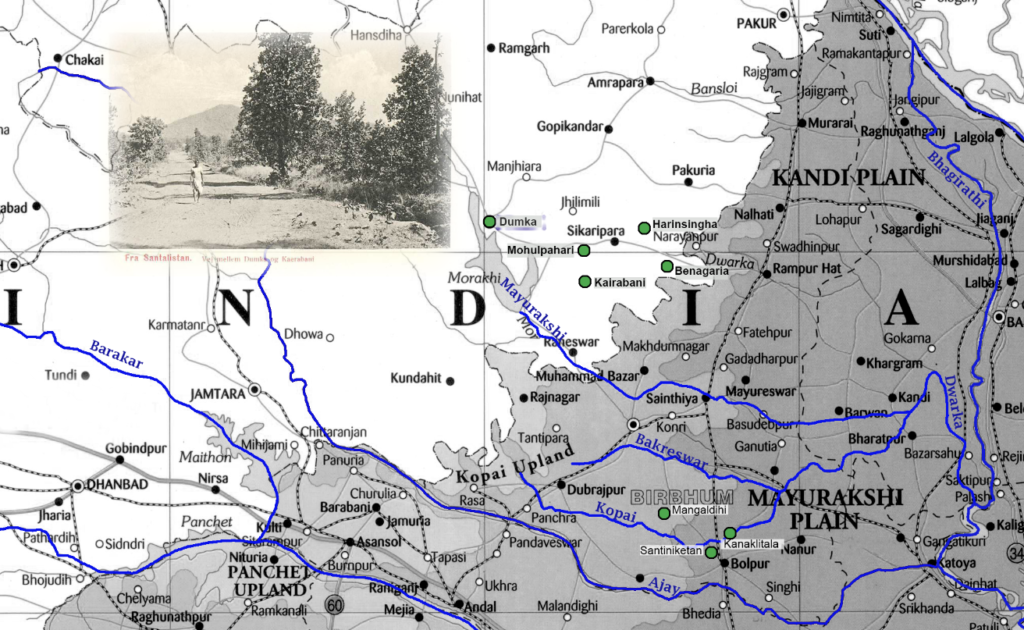
The Dumka Hills. Map designed by Purba Rudra, 2021.
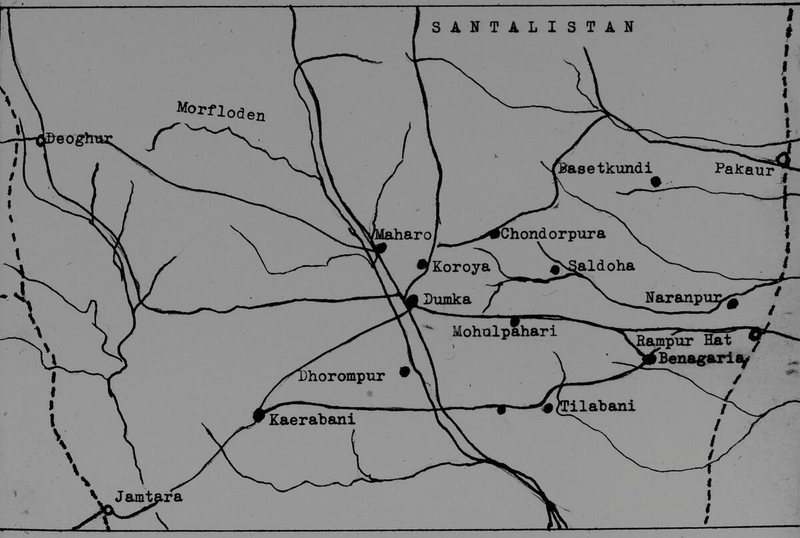
Old map of Santalistan, from the digital library of the University of South California. Source: Danmission Photo Archive. Rights: CC Attribution (CC BY). https://creativecommons.org/licenses/by/3.0/ Permanent link: http://doi.org/10.25549/impa-c123-104208
In 1931, within a couple of months after returning to India and settling back in Santiniketan, Bake had started to make preparations for going to the Dumka Hills in the Santal Parganas (now the state of Jharkhand). He got in touch with the Norwegian missionary and pioneer scholar of Santal Studies, Dr Paul Olaf Bodding (1865-1938), who was secretary of the Santal Mission of the Northern Churches and was stationed in Mohulpahari. Dr Bodding was not only a great scholar and linguist, but he was a collector of local knowledge and an archivist. His work can be seen as a living archive of the Santali language, grammar, folktales and folk medicine.
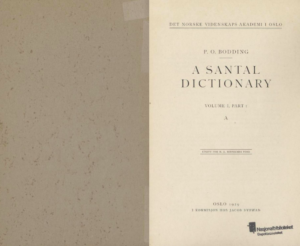
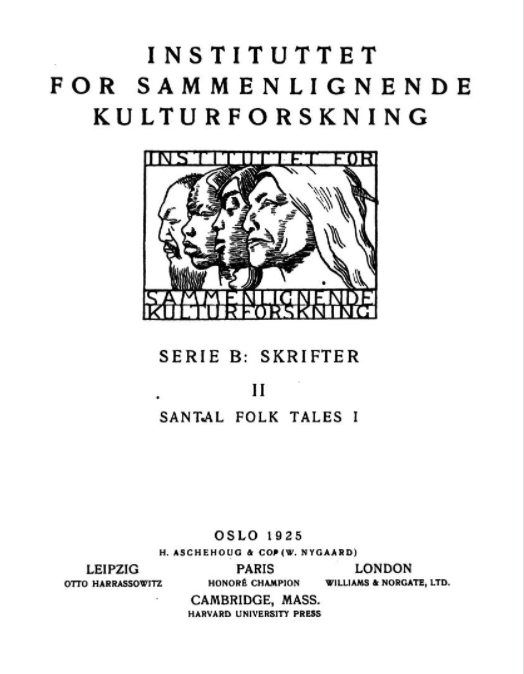
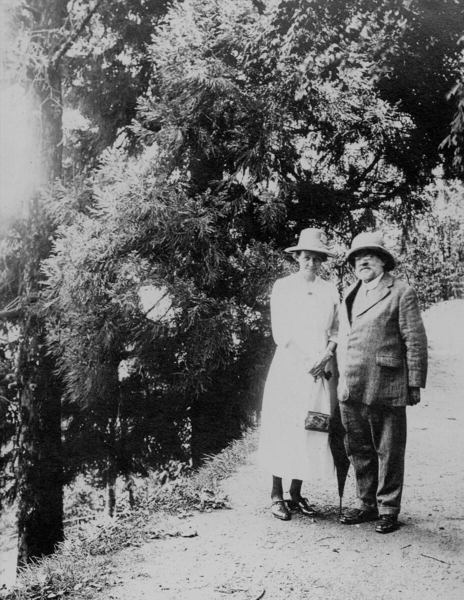
This photograph, of Dr Paul Olaf Bodding and his wife Christine, was taken in Darjeeling in 1930. Therefore, this is how Dr Bodding would have looked when Arnold Bake met him. It’s source is the digital library of the University of South California. The Danmission Photo Archive. Rights: CC Attribution (CC BY). https://creativecommons.org/licenses/by/3.0/ Permanent link: http://doi.org/10.25549/impa-c123-98677
The Santal Mission ran a boys’ boarding school and church in Kairabani, which also had a choir and a brass band. It was Bake’s friend, the American missionary Boyd W. Tucker, close associate of Gandhi, who taught English in Santiniketan, who connected him with Rev. Bodding, and the latter then invited him to Kairabani, since he was interested in recording Santali music. After a few aborted plans owing to bad weather and the unavailability of Mr Gurusaday Dutt–the district magistrate of Suri, who would facilitate the trip–the Bakes finally set out for Kairabani, 30 kilometres southwest of Dumka, on 17 March 1931.
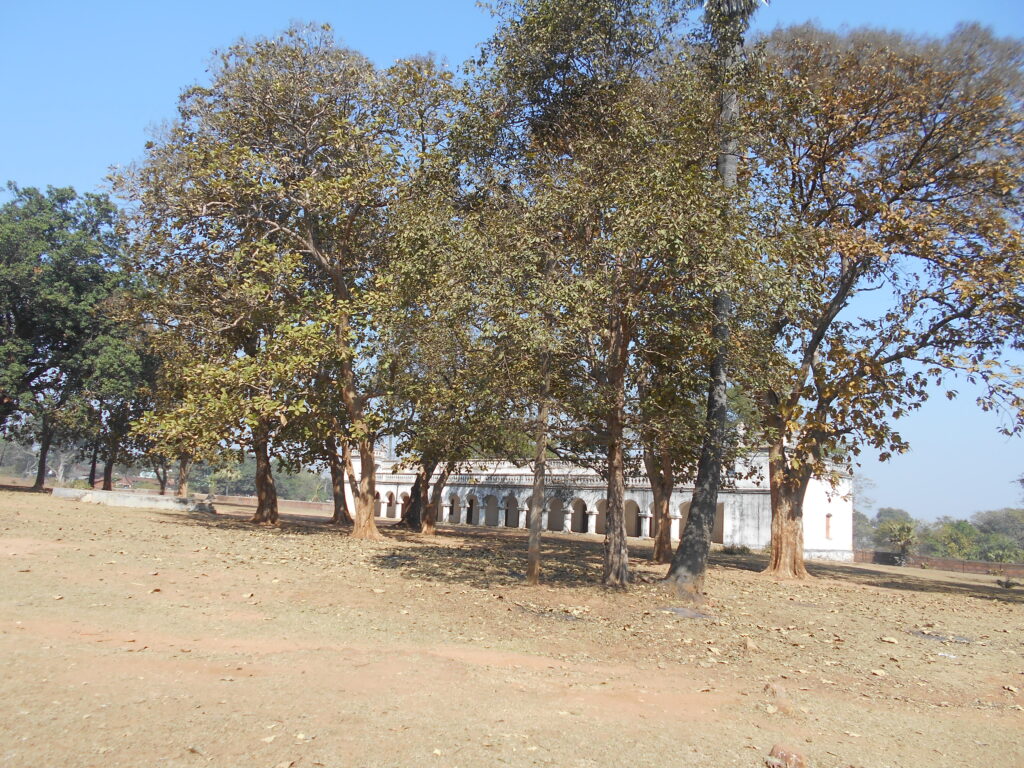
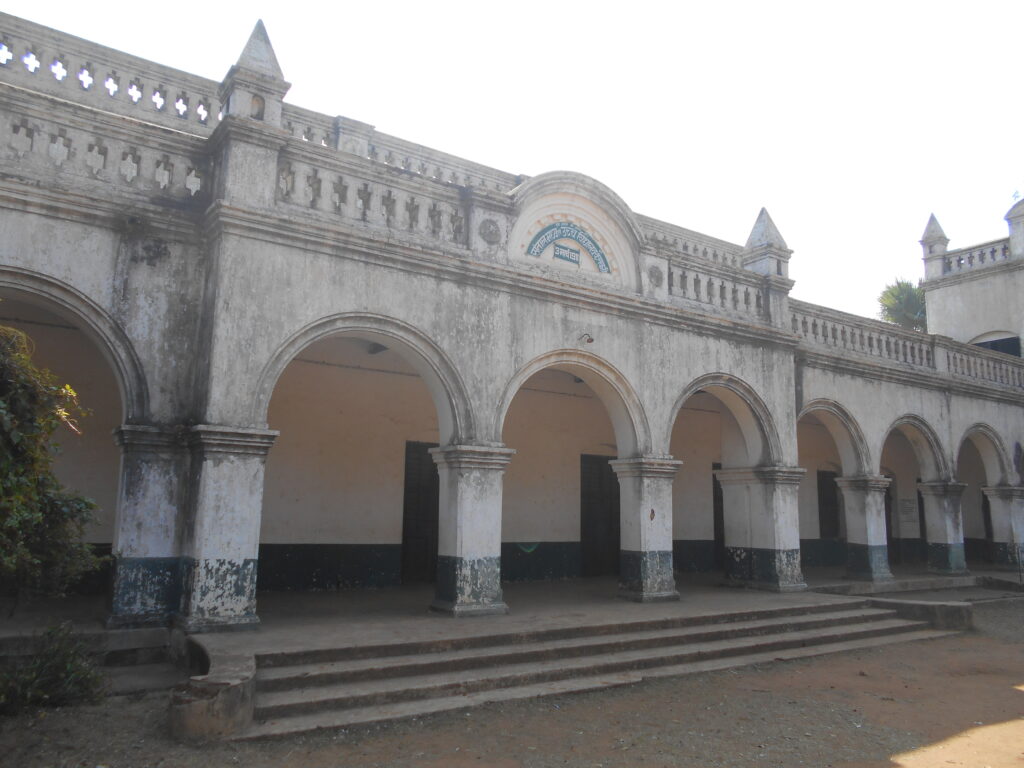
The Kairabani Mission school now, photographed by me in January 2017.
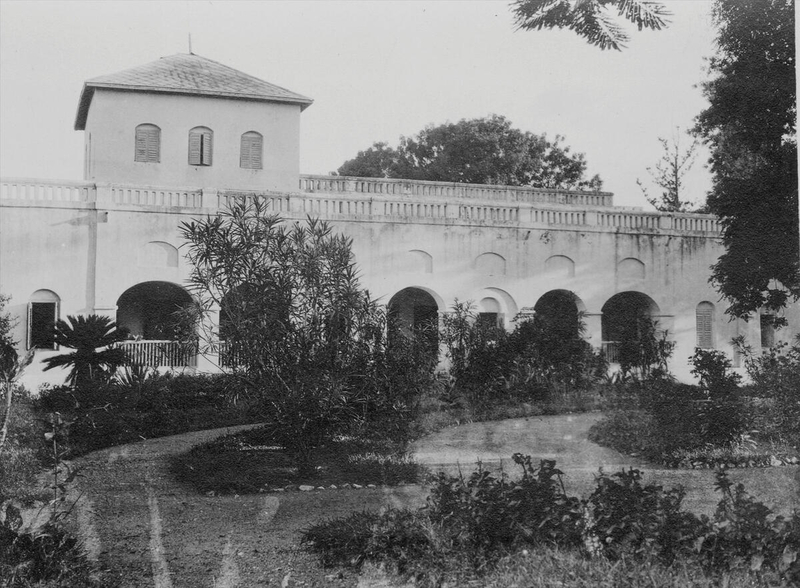
Kaerabani (Kairabani) missionary bungalow, built by the German Baptist Missionary, Albert R. Haegert, who died 1904 (then the house was bought by the Santal Mission in 1905). The photograph is from the digital library of the University of South California. Source: Danmission Photo Archive. Rights: CC Attribution (CC BY). https://creativecommons.org/licenses/by/3.0/ Permanent link http://doi.org/10.25549/impa-c123-98602
After the trip, Bake wrote to Erich M. v. Hornbostel at the Berlin Phonogramm-Archiv that this was just the first trip, he would have to go back to record the Santals again. Mostly because he could not record Santal dance in the mission as those who rain the mission were not keen on dance. Bake could not go back to Dumka, however; instead, he the recorded and filmed the Santals at Kankalitola and Mongoldihi, nearer home, in Birbhum later that year.
Film copy received from Archives and Research Centre for Ethnomusicology (ARCE), Gurgaon.
Bake India I, Cylinders 1-8, were recorded between 17-20 March 1931 in Kairabani. It is with those recordings that I went with sound recordist Sukanta Majumdar to Dumka on 21 January 2017. Some recordings from that trip can be heard here. Achyut Chetan, who taught then in the local S. P. College and whom I knew through a friend in Santiniketan, put me in touch with Father David Madhava Solomon, SJ, Director of Johar Human Resource Development Centre, also in Dumka, Jharkhand and that became our starting point. Sushant Soren, a young activist who worked with Johar, was our main guide and interpreter on this trip. I have travelled to the field with companions but rarely with an interpreter or guide, but this trip was different. I was consciously aware of my distance from the field, the language and the subject I was seeking to explore, from the very onset of the journey.
On 22 January 2017, we went to Kairabani Dudhani, the village where the Kairabani Mission was situated. We sat on the veranda of a house from where the Mission could be seen, but the villagers who had gathered were not attached to the church. Rather, they were quite critical of the role of the church in their communal life. Slowly a crowd of some 20-25 people gathered as we sat on the floor and played the songs. I explained the context in Hindi, Sushant Soren translated what I was saying into Santali, and the songs were played from the laptop, through portable speakers. The villagers listened and responded and chatted amongst themselves and Sushant translated some of their responses back to us and some things he left out.
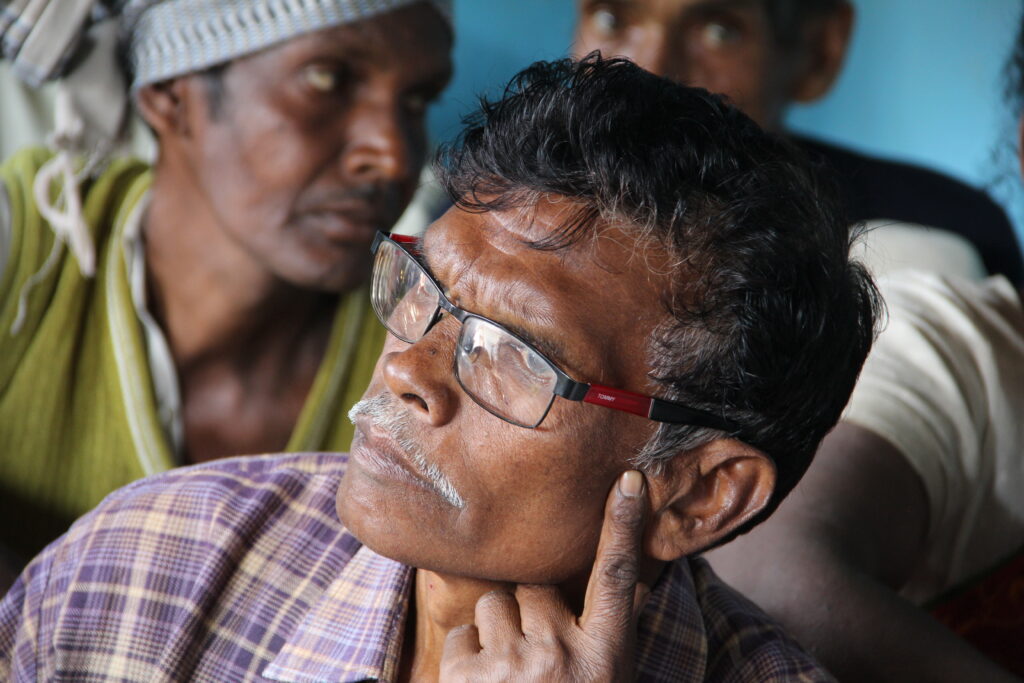
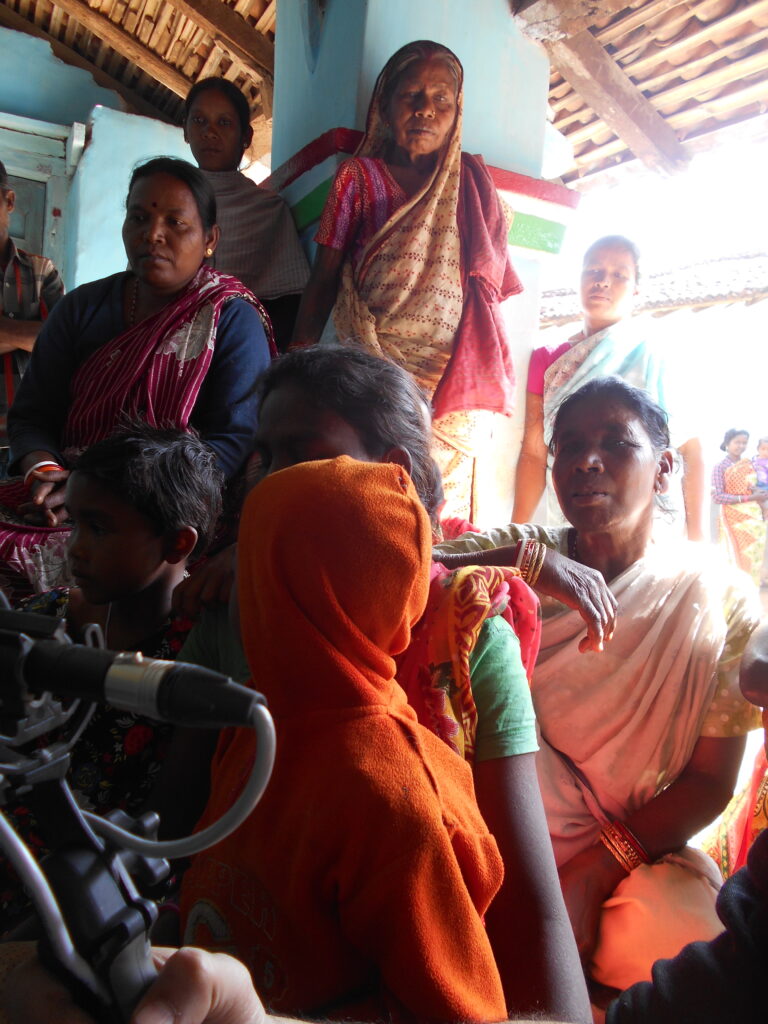
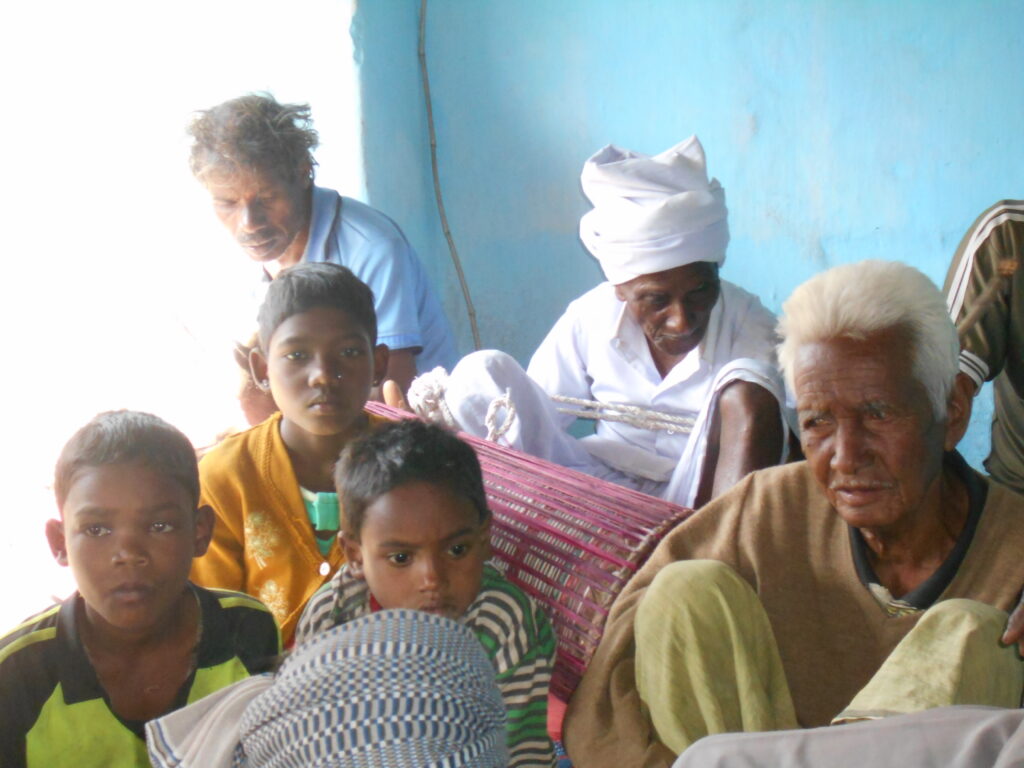
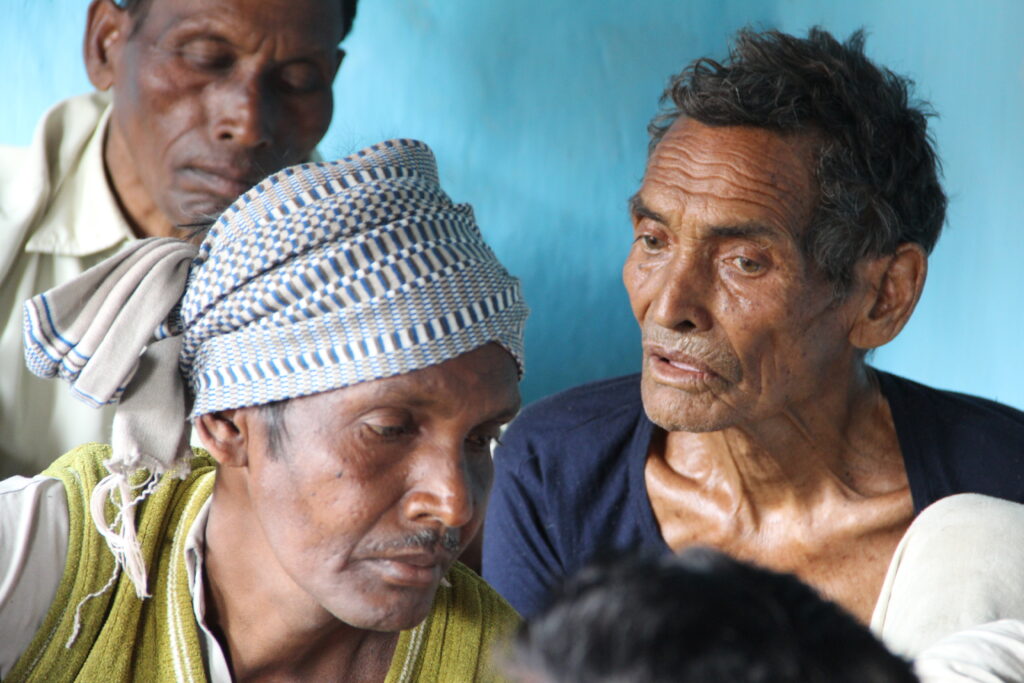
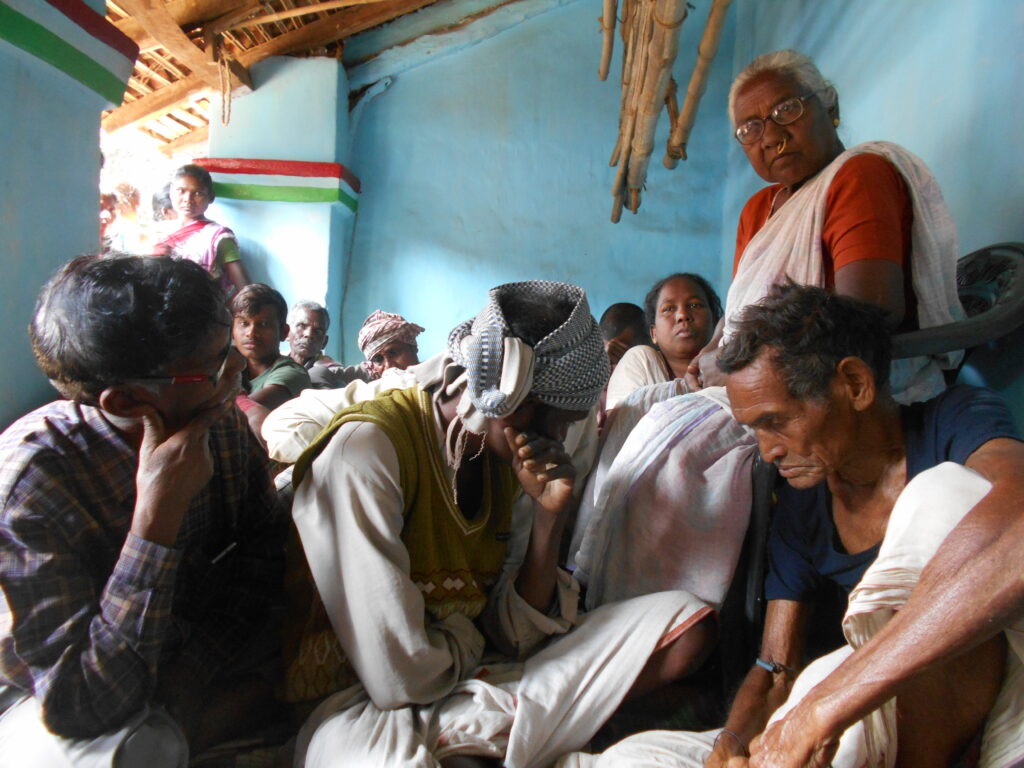
Listening in Kairabani, 22 January 2017. Photos, The Travelling Archive.
Interestingly, Sushant Soren, with his notebook and pen, was also an outsider in Kairabani. What he said was explained to the villagers by one member of their group who had a job with Calcutta Telephones, Shivsadhon Kisku, about 55 years old. Kisku spoke fluent Bangla and Hindi.
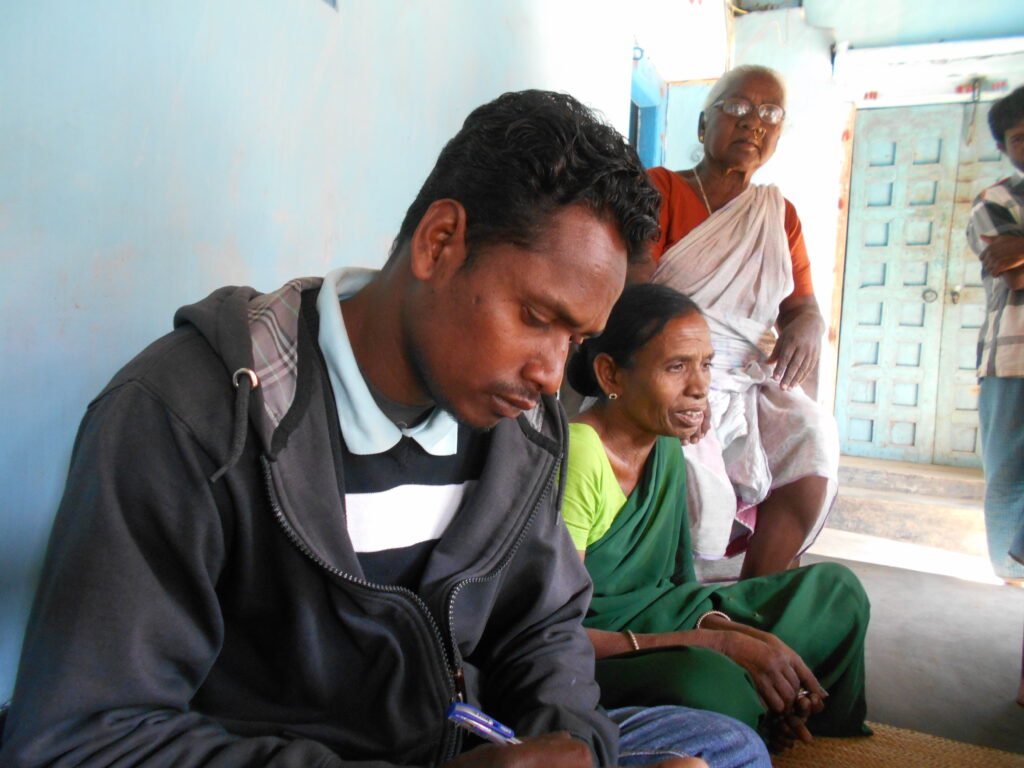
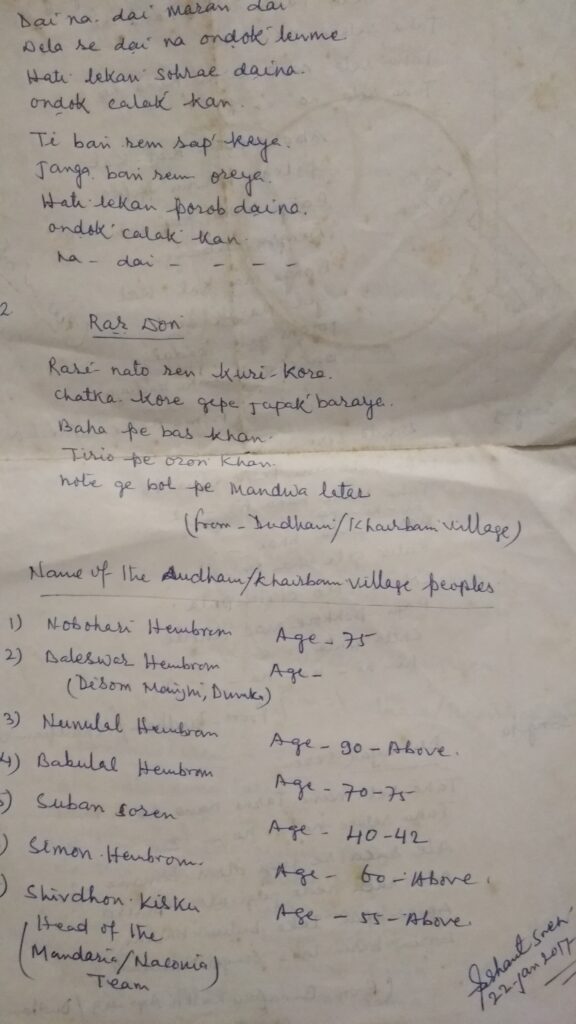
Sushant Soren and some of his field notes.
Arnold Bake’s Dumka recordings are of songs ranging from the Santali church song of the good shepherd, composed by the Norwegian missionary Lars Olsen Skrefsrud (Boge gupi do, song 2 of cylinder 1) to the same song sung as a four-part harmony (song 1 of cylinder 2), a do̠ń seren or wedding song about the ‘famine which happened five years ago’ (More serma akal keda, song 3 of cylinder 1). Then there was a flute tune (song 1 of cylinder 1) which the community of listeners in Kairabani Dudhani identified as a melody played during Sika̠r, which is the annual hunt festival—a communal gathering of only men, when disputes are resolved, while there is singing and dancing, food and alcohol through the night. There was also a song about the train (Nawa nawa railga̠di, song 2 of cylinder 7) and a song about Boṅga buru or the nature spirits (Abo manwa kal kal, song 1 of cylinder 6, identified as Sõhãṛe by BLSA, but described as rar danta by the Kairabani Dudhani people).
That morning, we recorded for more than two hours. I am keeping here some short video clips from that session. They were recorded by Sushant Soren (where I am seen) and by me too.
While traditional instruments such as the tirio flute and ḍhud̠ru banam are played in these recordings, sometimes to accompany the song and sometimes as solo pieces, the songs are marked by the absence of percussion. This absence somewhat denaturalises the songs, because Santali songs are essentially about drums, beats and rhythms; the songs are also inseparable from dance. When we were recording in Kairabani Dudhani in 2017, the crowd which had gathered were slowly warming up to the session and finding it fun to listen, talk and sing, and seemed to like the idea of being recorded. The madol player was also there. Before starting a song , they said, there is no madol here. They could distinctly hear, despite the noise of the cylinder. Can we play ours? they asked, much to our embarrassment. As if it was for us to decide.
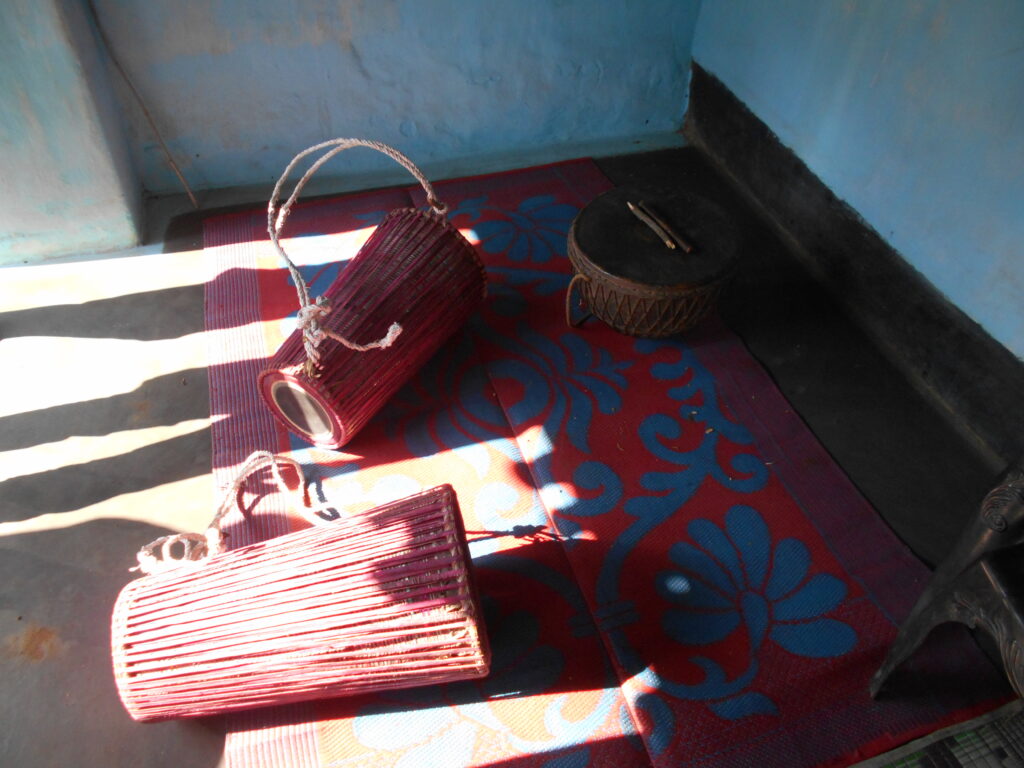
They brought their drums to the listening session in Kairabani. January 2017. Photo, The Travelling Archive.
Who exactly were the singers Bake recorded in Kairabani? Did they stay in the boarding? This question has kept coming back to me. It troubles me that here are no name for the singers for these archival recordings. ‘There are young boys and older ones, and also adults, who come for training as a village teacher,’ Bake had written in a letter to his mother on 25 March 1931. There is no other detail.
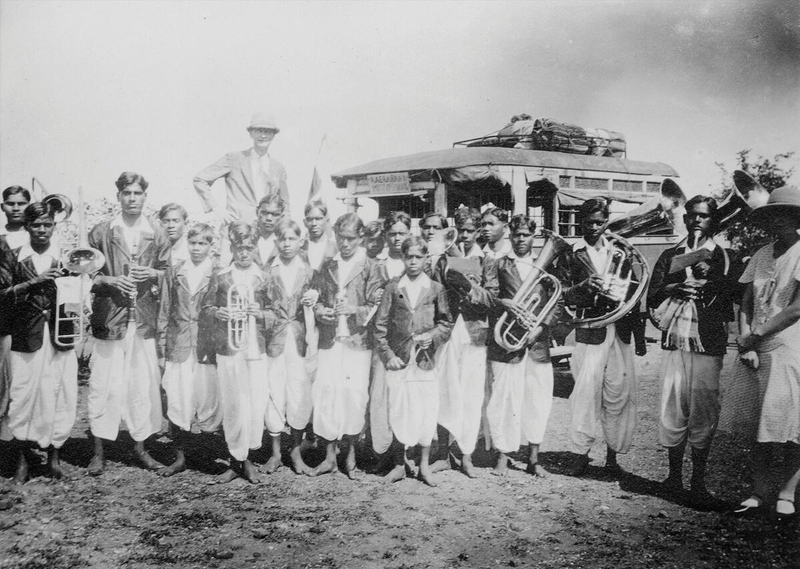
The Kaerabani (Kairabani) School Brass Band visiting Narainpur on 9 March 1931. Standing on the left are David Jha, Bernhard Helland. Muriel Helland and Jakob O. Soren are on the right. The photograph is from the digital library of the University of South California. From the Danmission Photo Archive. CC Attribution (CC BY). https://creativecommons.org/licenses/by/3.0/ Permanent link: http://doi.org/10.25549/impa-c123-98657
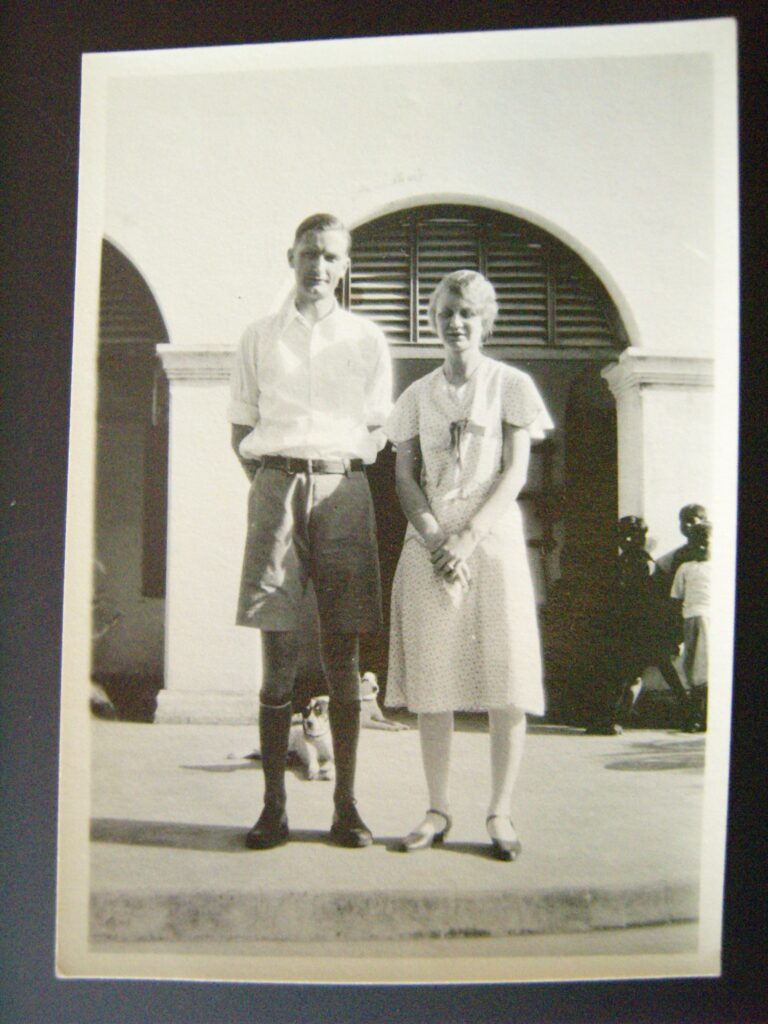
The Norwegian director of the school, Rev. Bernard Helland, and his wife Muriel hosted the Bakes in Kairabani. This is a photo of a photograph from the Arnold Bake Collection, Special Collections, Library of the University of Leiden, taken during my first visit to the library in 2010.
I made inquiries after the Dumka trip to see if there was any way I could have a register which gave the names of the Kairabani singers. After all, they were members of the mission choir. However, for now all I know is that J. J. Ofstad (Rev. Johan Johansen) was the music teacher of the school, Jacob Soren was his Santal assistant. I believe that Ofstad wrote a booklet about the Kairabani Mission, perhaps it has some names, but I have not had the opportunity to see it. All I have seen are the song books Seren Puthi and Rar Puthi. On 24 January 2017, we had gone to Jamuasol near Dumka to meet Mathias Hansda, who was a student of Kairabani High School for eleven years from 1951 and later became a teacher. He was also a member of the school’s brass band. He could fill in some details about the school and the practice of music; the school’s music teacher was Benjamin Murmu, who was a student of Jacob Soren, who in turn was a student of J. J. Ofstad. But he did not have any specific information about the singers, perhaps I could contact Benjamin Murmu’s daughter, Gloria, he suggested. That is as far as I have been able to get in my search for names, which is not saying much, I am afraid. But the important thing about research is also the questions, I think. Someone else can then try to answer them, if we can’t.
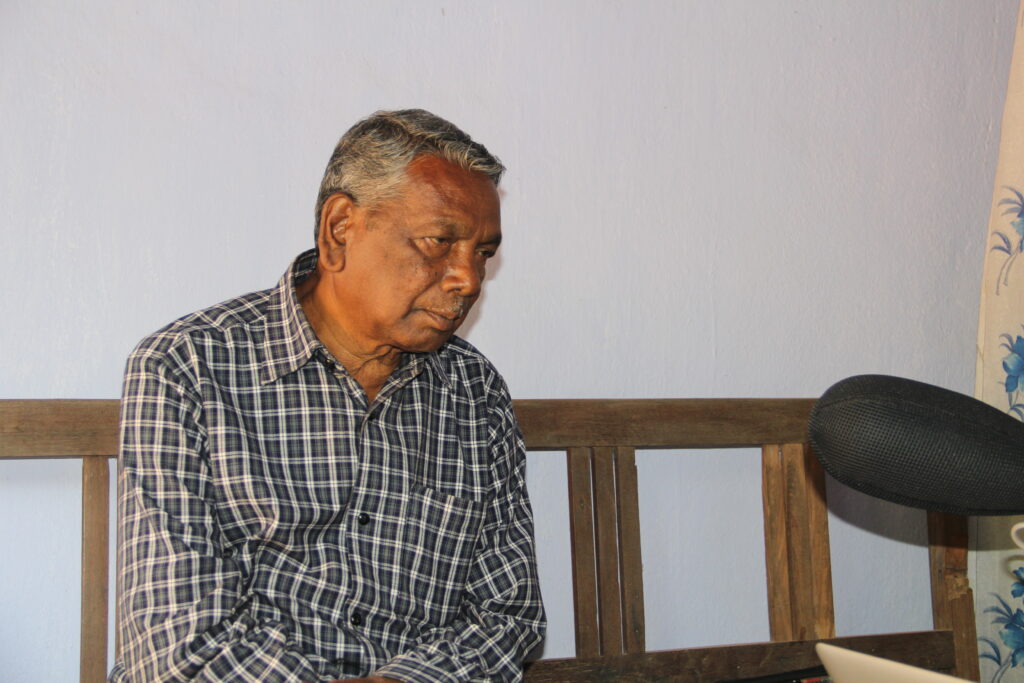
Mathias Hansda reminisced about his days in the Kairabani Mission school, as a student and teacher, about the school band, his teacher Benjamin Murmu, listened to the recordings, sang a little bit and talked about how things change over time, through rahan-sahan; that is, in the course of one’s life. This is a short clip from that conversation, in Hindi. 24 January 2017. Photo: The Travelling Archive.
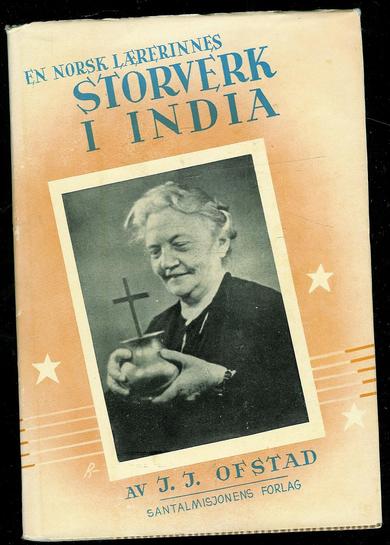
En norsk lærerinnes storverk i India (A Norwegian Teacher’s Great Work in India), by J. J. Ofstad (1879-1963)
Before visiting Mathias Hansda, that morning on 24 January 2017, we had been to the NELC radio station in Bandorjori, Dumka, from where they broadcast church-related programmes in Santali. The Northern Evangelical Lutheran Church (NELC) in Dumka is the successor of the Santal Mission of the Northern Churches. Mathias Hansda also mentioned the NELC radio station, which used to be run by the American missionary, Naomi Torkelson. A radio station, even if it is set up for the purpose of spreading the faith, will have sonic records of history, just as Arnold Bake’s cylinder recordings from Dumka are also a record in sound of a time.
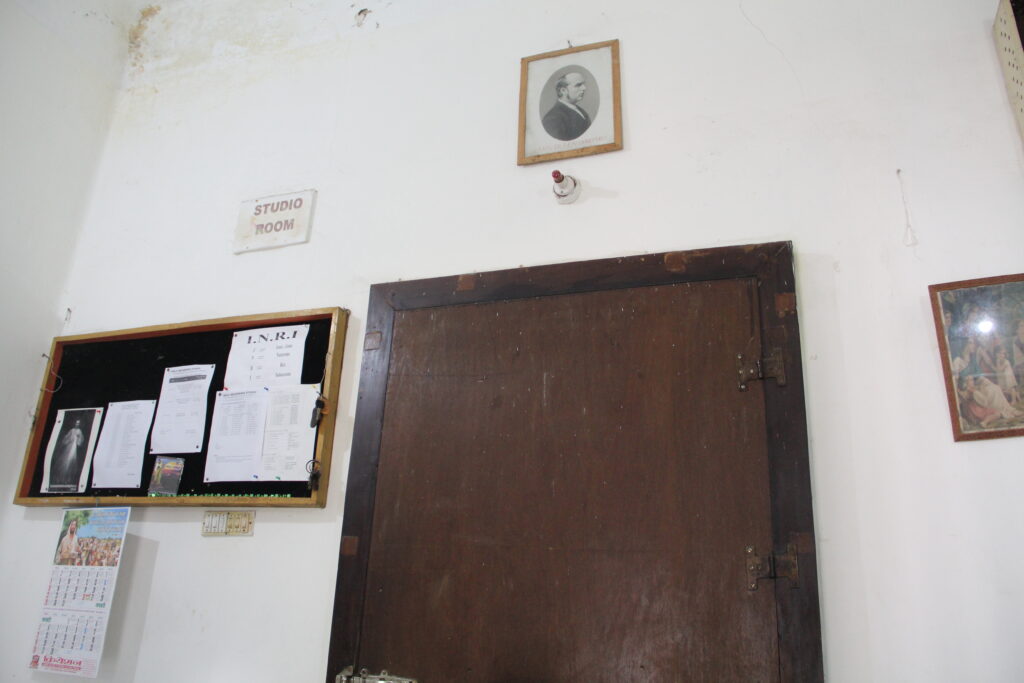
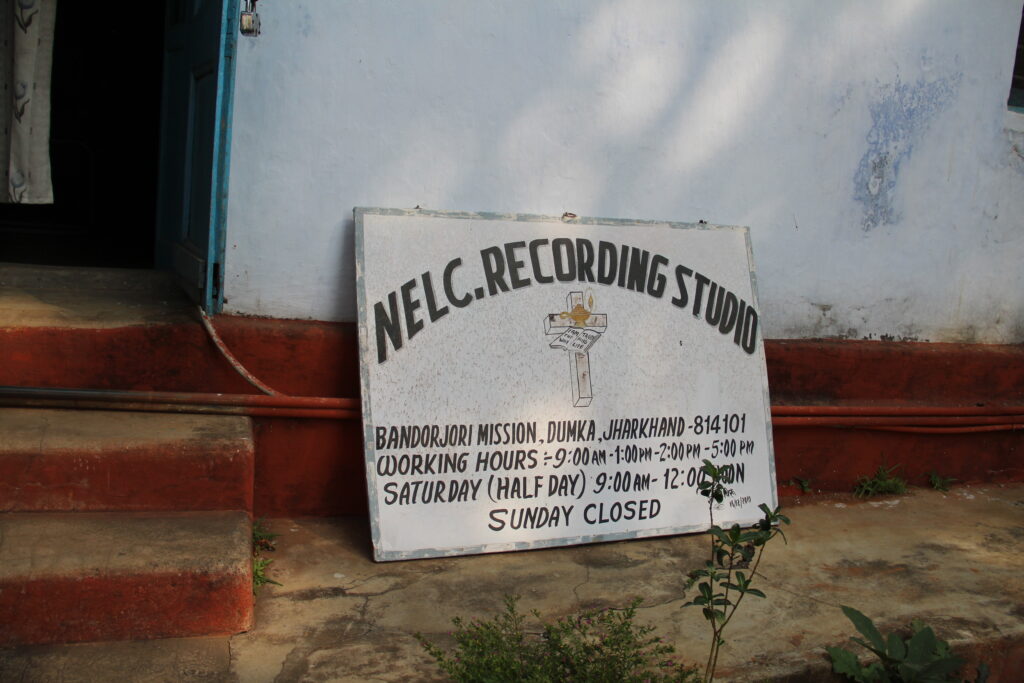
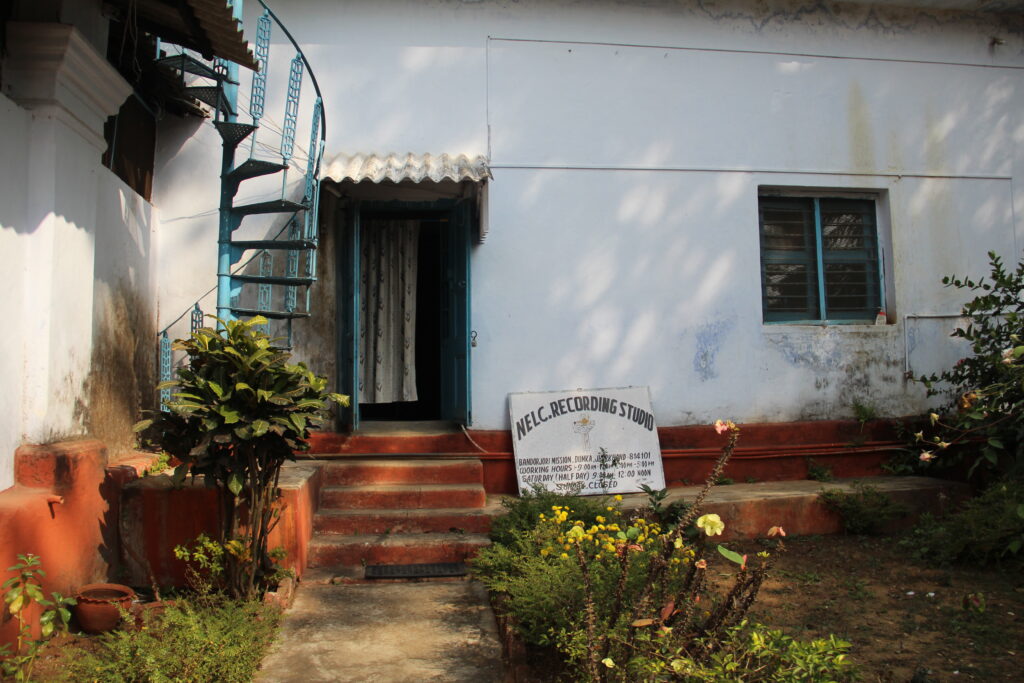
On the wall of the NELC recording studio in Bandorjori, Dumka hung a photograph of Lars Olsen Skrefsrud, the Norwegian missionary who had composed the song of the good shepherd, ‘Boge gupi do’, which Bake had recorded. Photographs: The Travelling Archive, 2017.
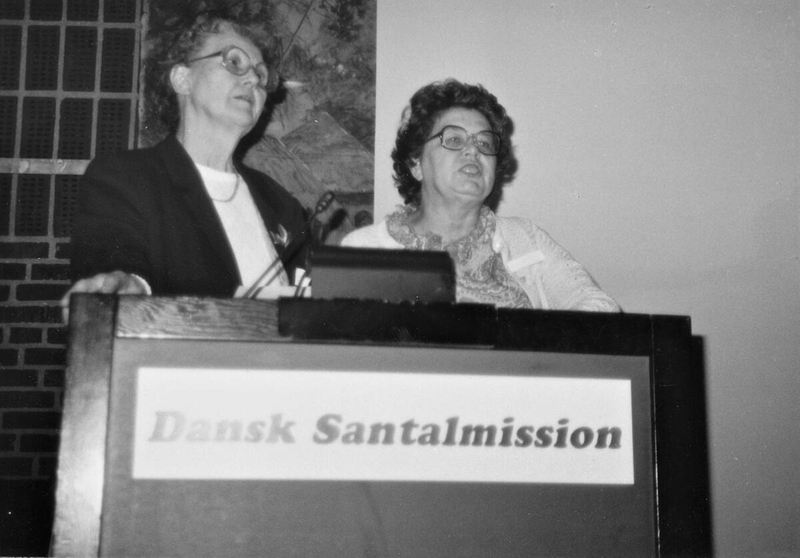
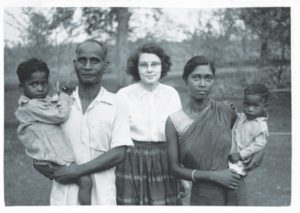
What drove a young woman all the way from Ohio to the Santal Parganas and what kept her stationed there for decades? I arrived at these images from the sounds of Arnold Bake’s cylinders. The photographs provoke such questions and the answer is never simple. The more I have delved into Arnold Bake’s Santal recordings, the more inadequate I have felt while also knowing that here lay a vast site worthy of long-term excavation. The photograph on the left is from the Danish Santal Mission or DSM’s annual meeting in Nyborg, 1986, where the American Missionary Naomi Torkelson (right), secretary of NELC, is seen speaking to the audience, with Rev. Inger Krogh Nielsen translating. The photograph is from the digital library of the University of South California. Source: Danmission Photo Archive. CC Attribution (CC BY). https://creativecommons.org/licenses/by/3.0/ Permanent link: http://doi.org/10.25549/impa-c123-99919. The photograph on the right, which I sourced from the internet, can be shredded and each strand separately analysed. Who are the people in it? What is Naomi’s relation to them?
The photo on the right is as thought=provoking as as some of the songs Bake recorded; they led to so much debate and discussion. Take the song ‘Boge gupi do’. In Kairabani Dudhani, the listeners could not really engage with the song. That is a church song they said, listened once, listened again and got busy talking among themselves and then they said they did not know what song it was. So, we moved on to the next song. In Johar Human Resource Development Centre in Dumka, on the evening of 22 January 2017, a group of artists and intellectuals sat in a circle and listened to Bake’s recordings, and they were led into the discussion by Father Solomon. They were all connected with Johar and all of them were possibly church-going Christians. Their connection with the song was immediate.
Listening to Boge gupi do in Kairabani. Recording by Sukanta Majumdar.
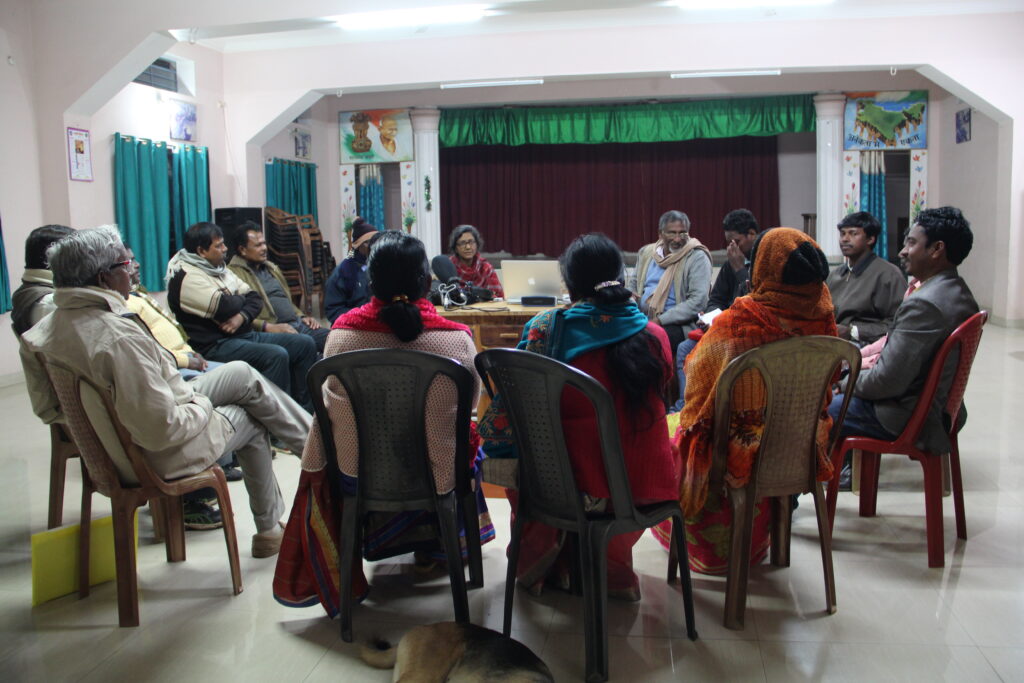
In Johar, we sat in a meeting with a group of Santali intellectuals and artistes, including singer Babita Murmu, Sebastian Soren, musician, Emanuel Soren, social actvist, Bijoy Tudu, government officer, Suleman Marandi, teacher, Sanatan Murmu, bank manager and others; Father Solomon, a Tamil who spoke many languages with great ease, navigated the course of the listening session. There were more nuanced debates here on the significance of words, form of song, slight regional variations of style.
Boge gupi do at Johar. The listeners immediately connected with the song.
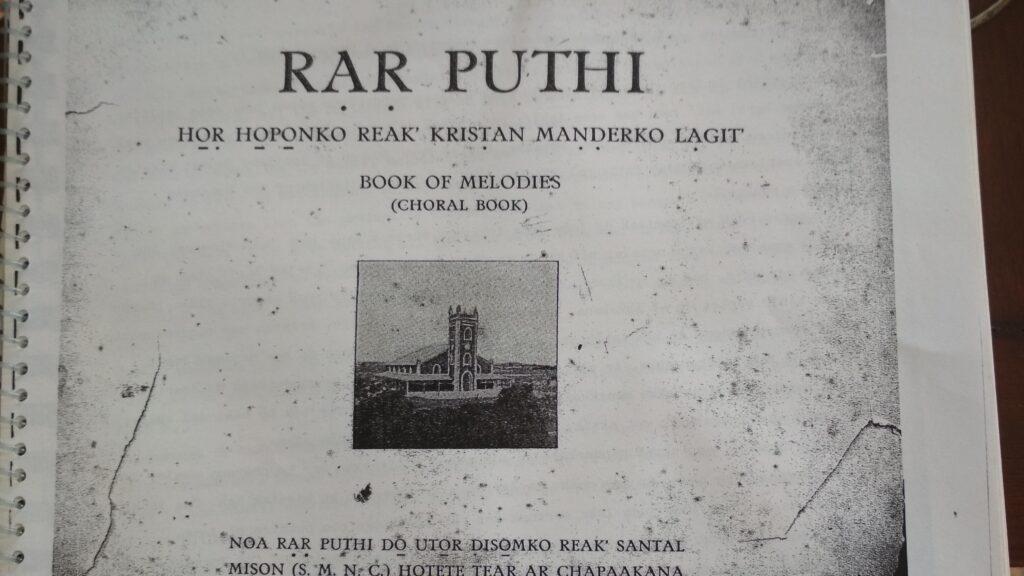
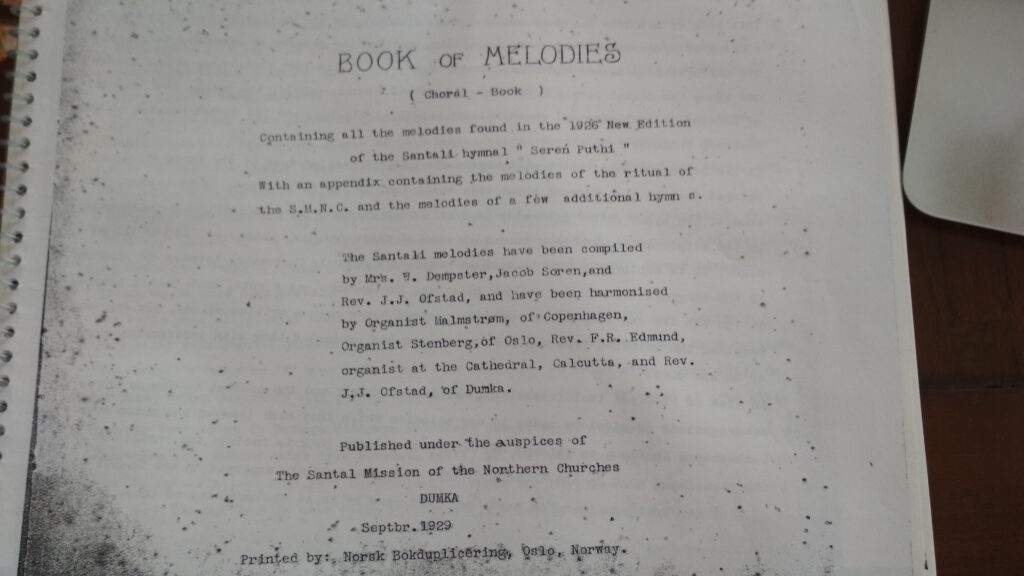
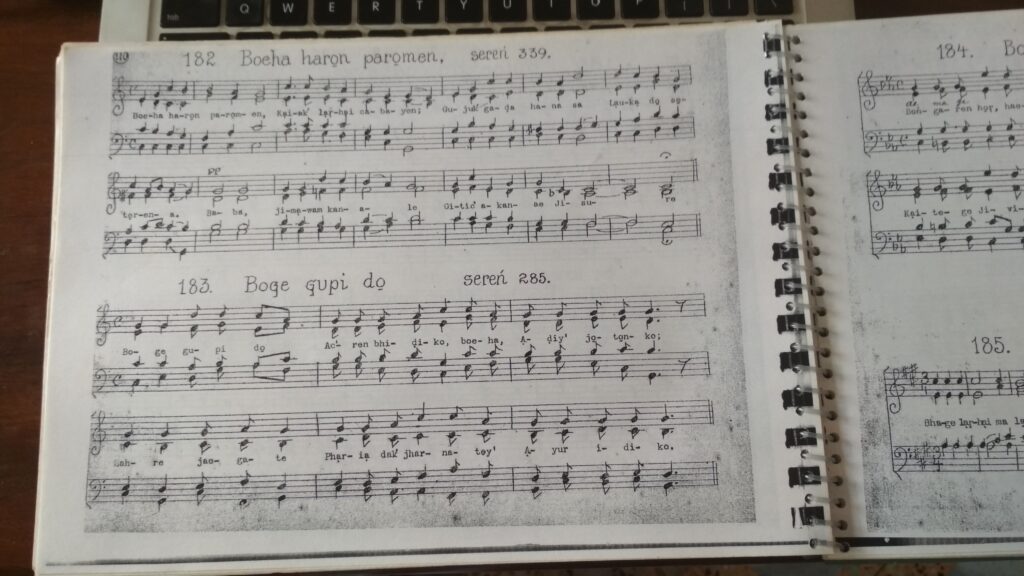
Pages from J. J. Ofstad’s Rar Puthi: Book of Melodies (Dumka: The Santal Mission of the Northern Churches, 1929), including the song Boge gupi do. We got a copy of the book from NELC.
While the church was taking root among the Santals, songs and rituals and local knowledge were also getting recorded for posterity.
There was a song the listeners of Kaiarabani Dudhani sang for us, ‘Ot́ma lo̠lo̠’ (song 3, cylinder 4), which is sung during Dasãe. Rev. P. O. Bodding, in his Studies in Santal Medicine and Connected Folklore (Kolkata: The Asiatic Society, first published in 1925), wrote in detail about the annual Dasãe festival in the month of the Dasãe or Ashwin, which is also the time of the Hindu festival of Durga puja. ‘This is naturally not a Santal festival; it is celebrated by the many Bengalis living in the country, the Santals participating as active spectators.’ Bodding wrote about young Santals going to see the idols and ‘sometimes [they are] even hired to carry it [the idol].’ This is the annual festival which marks the end of a three-month training the ojha or guru, the master medicine-man who knows all about plants, medicine and healing, has given to his all-male students. The festival marks this passing down of knowledge, as the young men and their teacher, dressed in kạcni (kind of skirt) instead of the ordinary ḍeṅganak’, or loincloth, and wearing turbans (there are aspects of cross-dressing here), carrying peacock feathers and the musical instruments buan and kabkubi, go wandering through villages, singing and dancing, gathering food from the people for the feast later in the evening.’
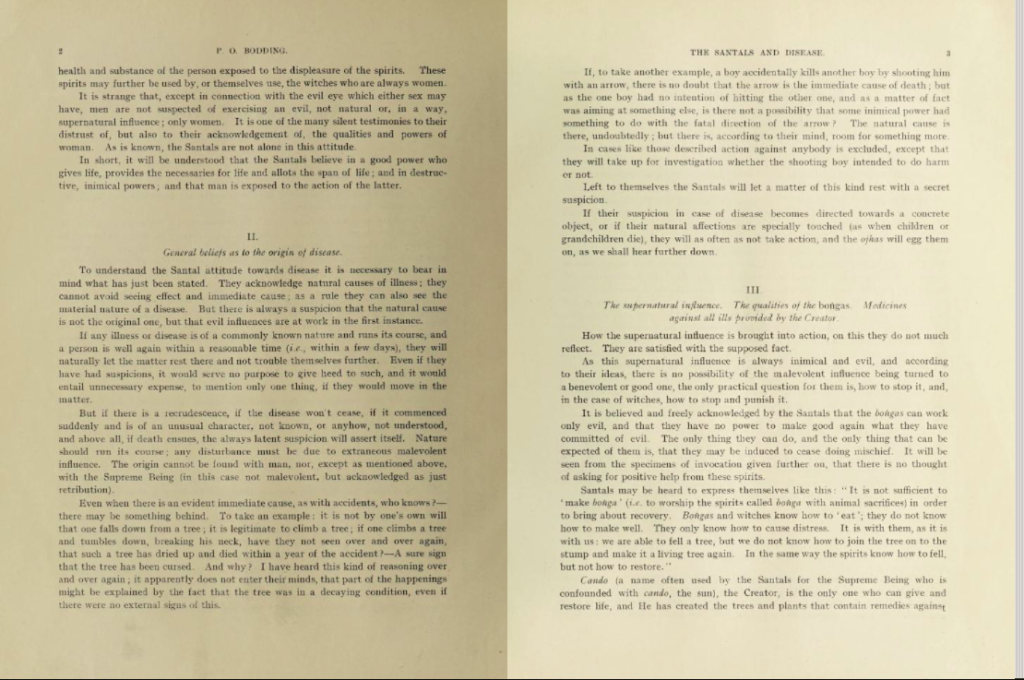
Page from Bodding’s book
The day after we went to Kairabani, on 23 January 2017, we went to Harinsingha, a village also in Dumka.
Sushant Soren, Habil Murmu and Aruna Hembrom, all Johar Human Resource Development Centre staff, took us to Harinsingha, where they run advocacy projects, making people aware of their deprivations and the rights they are entitled to, and help them fight for those. This village was very different from Kairabani Dudhani. Things were far more in order, organised, and the people seemed also economically better off. Many men and women had gathered in the house of village jo̠g ma̠ńjhi (community leader) Motilal Murmu; they had brought their children along. The women were beautifully dressed for a special day, in their traditional green two-piece saris. The courtyard was teeming with life. This was clearly a village where they were taking special care to reclaim their heritage, they had songbooks, practiced music and dance, and thus they were also especially interested in the songs we had brought with us. It felt like there was a kind of cultural revivalism going on here, as the women washed our feet first while we sat on chairs; they said that is how guests are treated in their culture, while I felt that in order to be the good guest and good researcher, I was having to throw all class, caste and gender consciousness to the winds. (I am glad I haven’t had many such experiences over my decades of fieldwork.)
If we listen to the Harinsingha listeners’ response to the railgadi (locomotive) song that Arnold Bake had recorded (Bake India I, Song 2 Cylinder 7), we will be able to hear the confidence in their voices and preparedness.
Kolgadi calak acte’ge sung by the villagers of Harinsingha, Dumka
In his 1937 essay, ‘Indian Folk-Music’, published in Proceedings of the Musical Association 63 (1936-1937), Arnold Bake had written of the Santals, ‘an aboriginal tribe of Munda stock which inhabits the hilly country on the borders of Behar and Bengal in the middle South-east’, that these people, ‘agriculturists where they have not flocked away to rice-mills or railway stations in which they work as labourers, are great hunters with bow and arrow. Even when living amongst the Bengalis where there is no hunting to be done, the men are very often seen carrying bows and arrows, Next to the drum, their beloved instrument, is the bamboo flute of unequal length with six holes. They often use their flutes as walking sticks and once I saw a combination of flute and stringed instrument where a Santal had fixed one string along the length of his flute and used that after the fashion of religious beggars to give the drone to his songs. This however was definitely an innovation not belonging to Santal music proper. They have preserved their independence of language, religion and music through decades of close contact with Bengalis and it is only under mission influence that they are now changing all of these, It was a sad experience to hear them sing their changed folk-melodies, in four parts, to religious words after the fashion of our hymns. The fact that their music has not reached the melodic perfection of Hindu India apparently makes them take to part-singing with greater ease than I have noticed anywhere else in India.’ Much prejudice in this remark, ideas of cultural evolution at work, but here in this video, the listener-performers of Harinsingha were demonstrating how a certain flute is made and how it works, to the great amusement of others.
Arnold Bake spent time measuring the distance between the holes in the Santal flute and sent his measurements to the archive in Berlin. On 15 April 1931, he wrote to the director, Austrian ethnomusicologist Erich M. von Hornbostel, ‘I include here two pictures of the Santal instruments, flute (which I have here) and banam. I will take pictures of the drums later. The drum is the most important. The flutes are always made in pairs. The two big ones are a pair. I will send you the measurements:
Length (of the great flutes, which are exactly the same) 72 cm
Thick (measured in a circle) 10 cm
Average (Outside Dimension)
Average (internal dimension) 22 millimetres
Length (up to the knot of the bamboo) 12 Ω cm
Length (up to the middle of the blow hole) 18 // 4 cm
Removal of the first finger hole from the blow hole 25 cm…’ (Translation from the German original by Debjani Das. Letters kept at the Berlin Phonogramm-Archiv, copies of which were kindly given by Professor Lars von Koch)
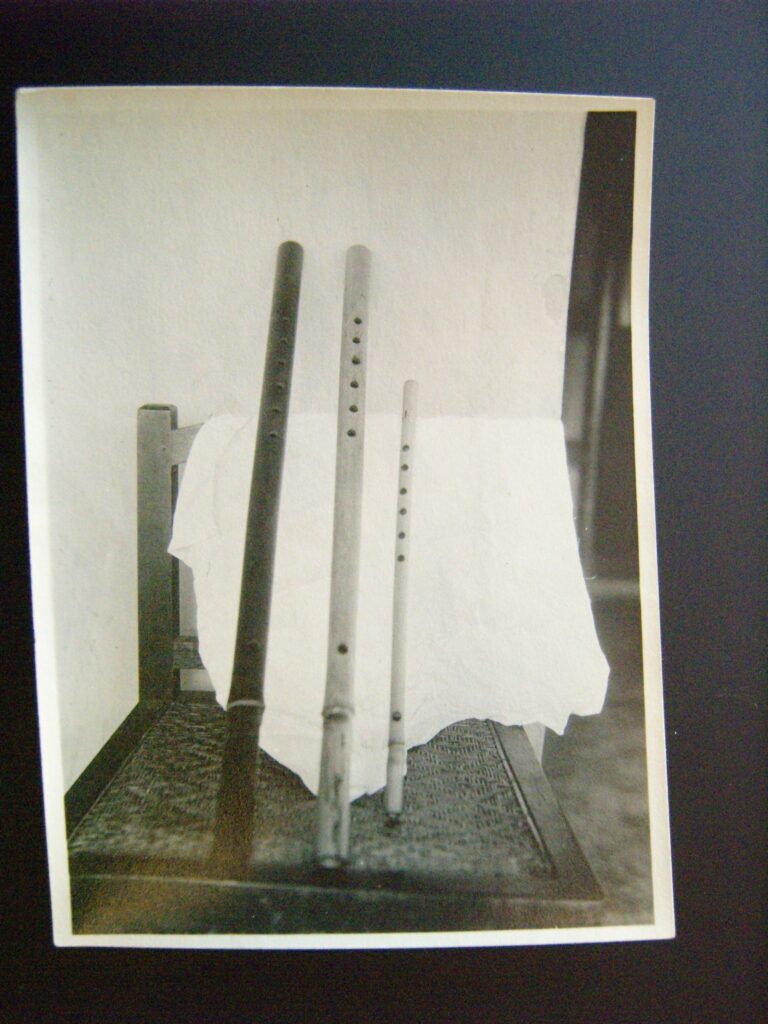
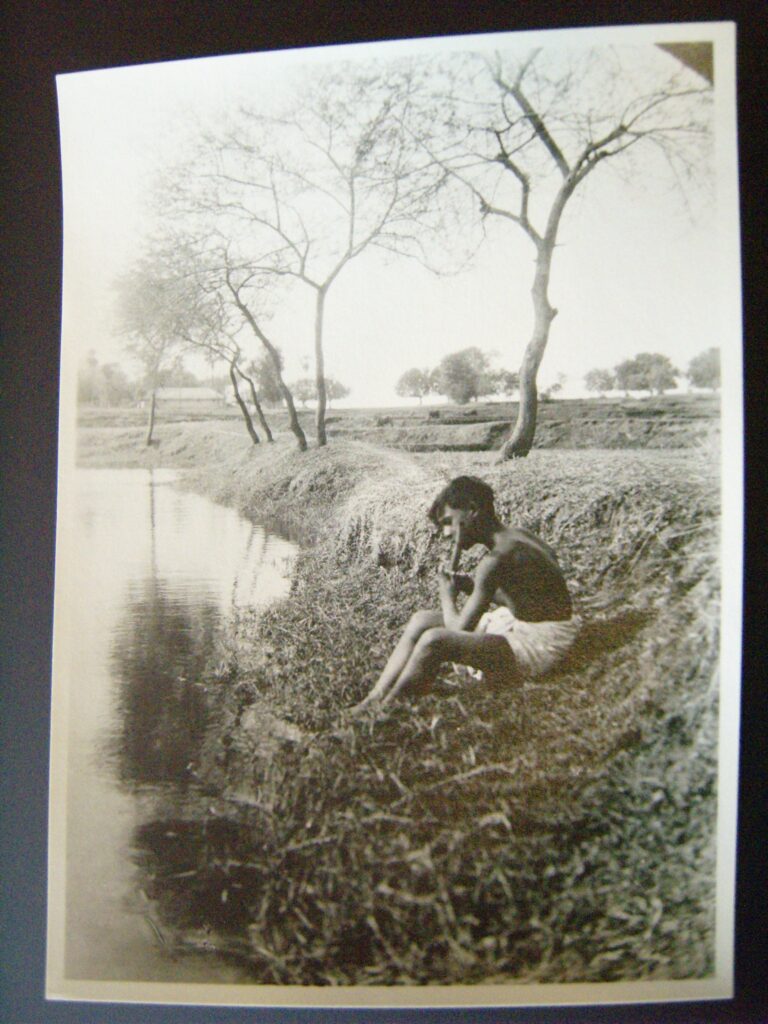
Photos of photos which I took while studying the Arnold Bake Collection at Special Collections, Library of the University of Leiden in 2015.
On the first day, when we met artistes and intellectuals at Johar in the evening, as we were playing Bake’s Santal recordings, they listened to the first flute of the fourth cylinder and responded with a beautiful song about the jugi, who goes from house to house gathering alms in exchange for telling people about their forefathers, even showing them their ancestors’ face. That song is in our recording session note for that trip in 2017, Babita sang it a second time for us to record better, coming closer to Sukanta’s microphone. ‘The jugi or traveller has come visiting, and the poet requests him to show the face of his dead parents. Show me my parents’ face, because after death, they have become faceless. How will I see their “roop”, how will I get their love?’ They explained the song to us and told us about ‘jong baha’, the ritual of floating the ashes of the dead. In a sense, Bake’s cylinder recordings are like the ‘jugi’; they have the power to show us the ancestor’s face.
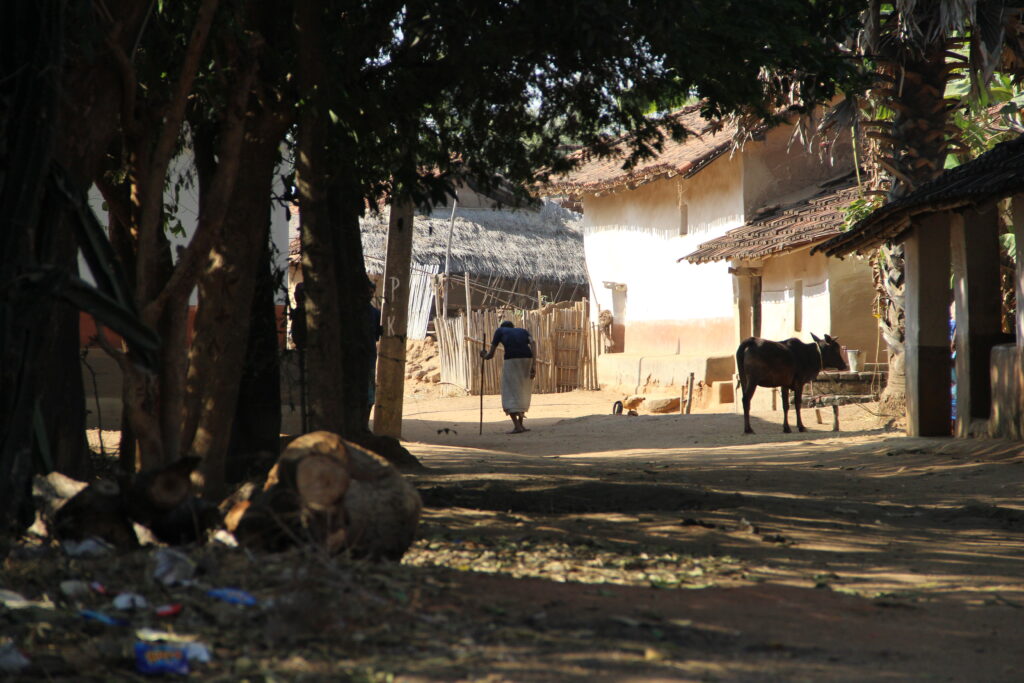
Nunulal Hembrom, more than 90 years old in 2017, walks back after our listening/recording session in Kairabani. I do not know where he is now. Photo: The Travelling Archive.
Postscript
My friend and longtime collaborator, musician Satyaki Banerjee, shared a video with me, some time in May 2022. A friend of his, Sukrit, had recorded it when he went to a workshop on Adibasi (indigenous people) dance in Tepantar Theatre Village in the border of Birbhum and Barddhaman. I was quite startled to see it. There was someone playing a flute of the kind the listeners of Kairabani were describing to us (see video above). This seemed to me to be that flute with two parts. Sukrit wrote to Satyaki that the man with a hibiscus in his ear is Subal Hembram, he makes his own flute, which is supposedly called the ‘chyng murli’. He plays for himself, just like that.
Sukrit’s message to Satyaki: ‘Ami 11mile er tepaantar e ekta adibasi nacher kormoshalay chilam bigoto der mas, eta sune khub valo legechilo, tai tomake pathalam. Olpo olpo bujhi, je mul harmony ta lead korche tar nam mungli di, onake jigges korle valo bolte parbe. Eta bodhoy biyer gaan […] tumi chaile tomar satheo kakhono alaap koriye debo, manush gulo koto sundor, churaanto aesthetic. Hyaa go, nijer monei bajiye Jay, etar nam naki chyng murli, r ek kaane jobar dnati kaner fnuto diye dhokano, odbhut ei lok ta satyaki da. Ei jontro ta enari nijer haater banano, subal hembram.‘
She can hear what we can’t because she knows what to listen out for. She can also listen to absent sounds, because she knows where they were supposed to be. I went to meet her with her with the disembodied voices of Arnold Bake’s seamen, plucked from the sound archive. On 15 January 2018 Ambarish Datta and I went to meet 88-year-old Sushoma Das, for she is someone who keeps songs in her body. We knew she would hear more in those recordings than most people we know.
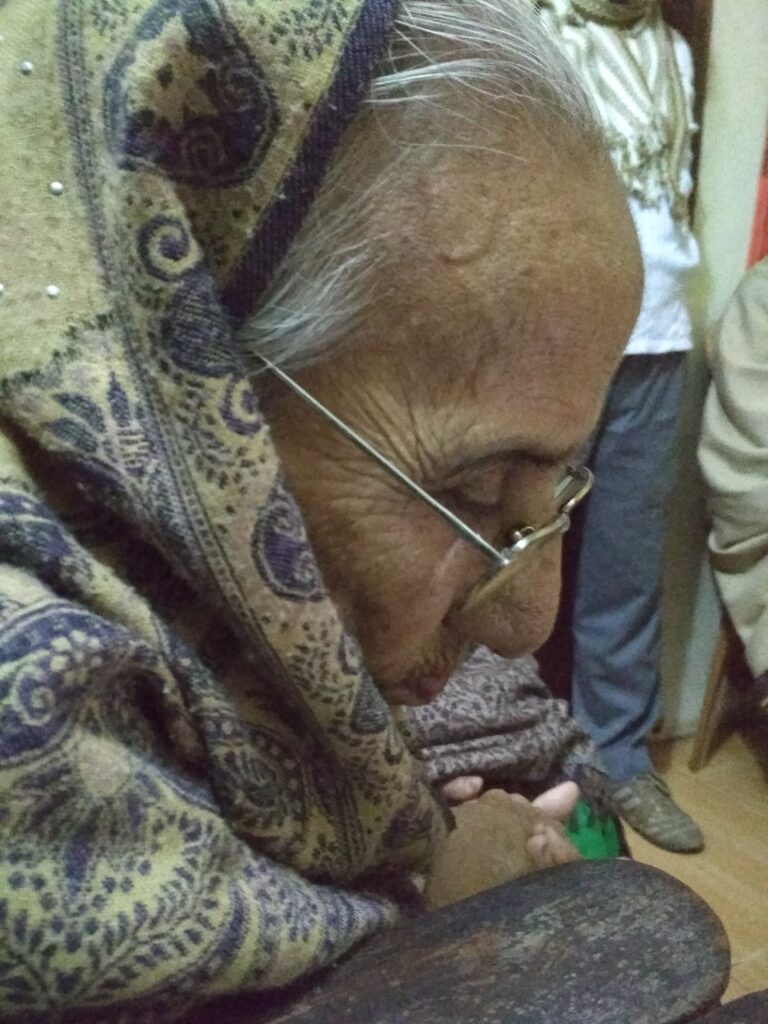
Sushoma Das in her home in Sylhet in January 2018
I first met Sushoma Das in 2006, through Ambarishda, whom I also met for the first time that year. I have gone back to Sylhet many times since and recorded Sushoma Mashima (mashima meaning aunt) and many others over the years, while Ambarishda has become like family. In 2012 we brought out an album of field recordings of Sushoma Das and Chandrabati Roy Barman (1931-2014) . Sushoma Mashima has the strongest voice and a phenomenal memory even at this advanced age; she stands like an old banyan tree in our present time of feeble voices and callous oversights. On this day in 2018, when I was visiting Mashima with Bake’s recordings, she sat there in her room, frailer and thinner since the last time I saw her in 2015. Besides Ambarishda, and the Sylheti folk song collector and researcher-writer Suman Kumar Dash (who came in late), her daughter Bashona, sons Prashanta and Probir, and a neighbour, Madhab Chandra Das, were present in the room, while other family members walked in and out with water, tea and sweets. I sat on a chair next to Mashima and play her Bake’s sailors’ songs from my laptop. The noise on the surface of the cylinder envelops the voice, it is not easy to listen to the song, especially from the speakers of the laptop, what with outside noises of people talking, work in the kitchen and vehicles on the streets below and beyond. Yet Mashima became immediately alert. In fact, it wasn’t just Mashima, but everyone in the room seemed able to listen to something that we could not hear, as they listened with their insider knowledge, as we have seen in many other places.
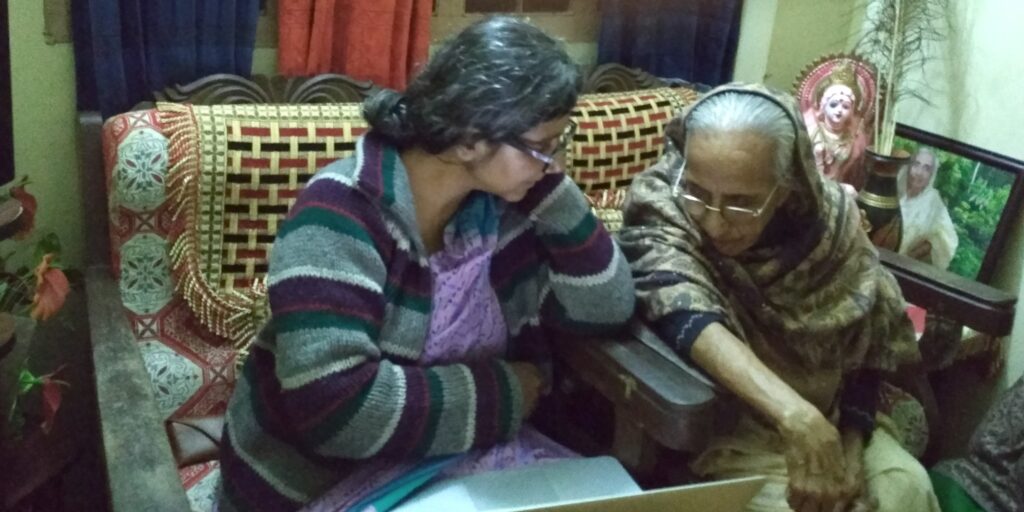
I begin by playing two songs recorded on Bake India II Cylinder 341 A, recorded on 1 April 1934. They are credited to Sayed Ali, sailor from Hirpur (Comilla p.o.). One is labelled in the archival note as ‘Hridoy jole’ (The words go, ‘Elo re basanta, hridoy jwole’, meaning, it is springtime and my heart burns). The other has a one-word description, it is called just ‘Amay’. The line sounds like this: ‘Bhuilo na bhuilo na amare’, do not forget me. Sushoma Mashima says each place has its own way of singing, but these were not from Sylhet. I say, yes, that is what the note says. The singer was from Comilla. ‘Wherever it is from, the song about basanta or spring is a biraha (song of separation and longing)’, she says. She is slowly getting used to the sound of the cylinder. Then I play ‘Pranonath bondhure’, sung by Fayazullah, stoker from Damrasari, Sylhet.
Out of the 15 cylinders on which Arnold Bake recorded the sailors on board the Streefkerk, five (nos. 343, 347, 348, 349 and 350) were of Fayazullah. I played cylinder 348, recorded on 14 April 1934, titled ‘O pran nath’, and Sushoma Das was in her element. ‘Shakkhater gaan, shakkhater pod. Radha Krishner milon hoise, miloner pore ei gaanta’ (This is a song of meeting, Radha and Krishna have met and this is song which comes after their union). And then the words began to flow out of her. Mashima recites:
Pranonath bondhu re, bohu dine paiasi tumare.
Kato batshar hoilo gato, ore bondhu
Tilek na herilam tumare, bohu dine paiasi tumare.
Bondhu re, amar moto katoi nari
Ase tumar aggakari
Sheba kore tumake paia, o bondhu re.
Ore, ami noi tor shebar jugyo,
Kun gune paibo tumare, bohu dine paiasi tumare.
O bondhu re, adhore adhoro diya
Srubone srubon mishaiya
Noyone noyon rakaiya
Sudhamrito borishone, o bondhu shushitol koro amare.
Friend, lord of my heart, I have you to me after ages.
Many years have passed, O friend
I have not had even a glimpse of you.
I have you to me after ages.
O friend, so many women like me
Are happy to obey your orders
They serve when they have you for them.
Am I even worthy of serving you?
What gift do I have to ask you for me?
I have you to me after ages.
O friend, touching with lip on lip
Listening from ear to ear
Holding your eyes in mine
Showering me with your nectar of life,
Make me quiet and calm.
These are not the exact words that Fayazullah sang, but it is a variation on the same song. Mashima first spoke the words and then as I kept requesting her to sing the lines, and as she kept saying, I cannot sing these days, amar gola khyan khyan kore, my voice cracks up, I knew that she would ultimately give in. Of course when she sang it was pure gold.
Mashima listens to cylinder 347, labelled ‘Shunu bondo shivsarane koi’. Even before I play the song, I tell her the name and she says that there is such a song indeed. ‘Shuno bondhu tumar sricharane koi,’ she corrects me.
Bake’s notes were clearly flawed in many places, or at least in the way the notes have come down to us, there appear to be many errors. So, for both Ghutia in Noakhali Sadar and Damrasari in Hirpur Bazar, Sylhet, it is likely that he had got the names wrong. Perhaps they told him something in their Sylheti or Noakhailya way, and he wrote down what he heard. The sailors were in all likelihood unlettered and so they would not be able to spell the names or the names of their villages for Bake. Again, this is only a speculation based on thin evidence or plain common sense. ‘Shunu bondo shivsarane koi’, that line makes no sense whatsoever. I played the song and then Mashima began to speak the words, and out flowed a whole song.
Shuno bondhu tumar sricharane koi
Mor ki loy re bondhu, tumay chara roi
Bondhu re, jothay tothay jao tumi, ami chaiya roi
Koite na’ri shoite na’ri, kuno jwala shoi.
Bondhu re, tumar monete mon mishaiya moner dukkho koi
Amar mone shadh re bondhu, tumar dashi hoiya roi
Shuno bondhu tumar sricharane koi
Bondhu re, tumi na korile doya ami jabo koi?
Tumi bine Radharaman parobashe roi.
Friend, see, I beg at your feet.
How, my dear, can I stay without you?
Wherever you go, Friend, I look your way
It is hard to tell and hard to bear, the suffering this brings.
My Friend, I meld my heart with yours and tell you my pain
I wish in my heart to serve you all life long
Friend, see, I beg at your feet.
O Friend, if you do not care, then where shall I go?
Without you, Radharaman feels banished from his land.
‘That’s how the Radharaman song goes, but this singer has mixed up the verses (ultafalta korse) and has also not signed off with Radharaman’s name as the rosit (রচিত, which is a very Sylheti way of saying writer/composer and it is utterly untranslatable),’ Sushoma Mashima said. She sang the song her way, rhythmically different from the recording. I asked her about the rhythm in the recording and she said, he is a singing the song as a dhamail, a dance of Sylhet. Can you sing your song that way? I asked. Can I? she laughed. Of course, she could. She sang a few lines of the song as a dhamail.
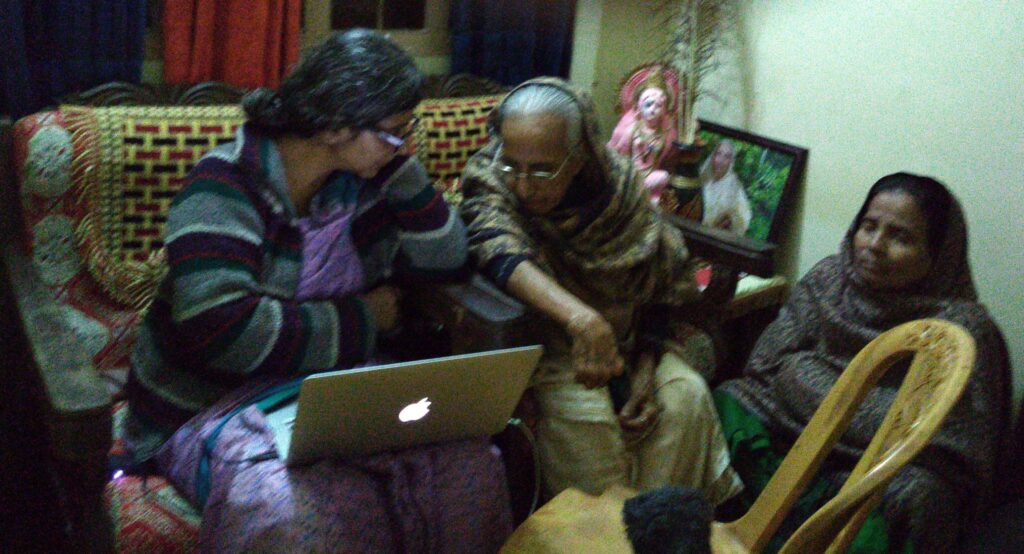
Listening together. Mashima, her daughter Bashona and I. Sylhet, 15 January 2018.
On 2 April 1934, his second day of recording the sailors, Fayazullah of Damrasari, Sylhet sang a song which began with the words ‘She dukh’. This is the song which had made me think of Ranen Roychowdhury. As the song plays, Mashima and her son and daughter all listen with rapt attention and then she starts to speak out the words.
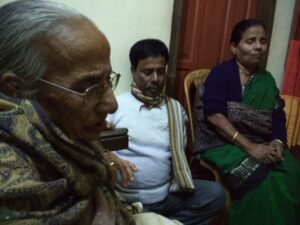
Caption: Mashima listens with her son Probir and daughter Bashona
সে দুখ কইবার কথা নয় গো বলিব কারে?
যার অন্তরে জ্বালাপুড়ায়, সখী,
সে নিবে কি অন্য জানে?
সে দুখ কইবার কথা নয় গো বলিব কারে?
Shey dukh koibar katha noy go bolibo kare?
Jar antore jwalapuray, shokhi,
Shey bine ki onyo jane?
Shey dukh koibar katha noy go bolibo kare?
It is such an unspeakable pain, who can I tell?
She whose heart is scorched and scathed, my friend
Can anyone but she know?
It is such an unspeakable pain, who can I tell?
They are listening together and everyone in the room in chipping in words. This is such an informed community of listeners! ‘Keu ba parobashi,’ one says. ‘No no, it was bonobashi,’ says another. ‘Keu hoitechhe shmashanbashi, or was it deshantori?’ ‘There is also keu ba bhikharini.’ They hear different things, but basically variations on the idea of the dejected, almost destroyed lover, who is either leaving home, or is beggared or is choosing to stay in the smashan or crematorium or is going on exile. Finally, we come to the word Deenoheen. Is it a song of Deenoheen, Deenoheen, the folk poet? Or is the poet describing himself as deenoheen, one stripped of all riches, ready for total submission?
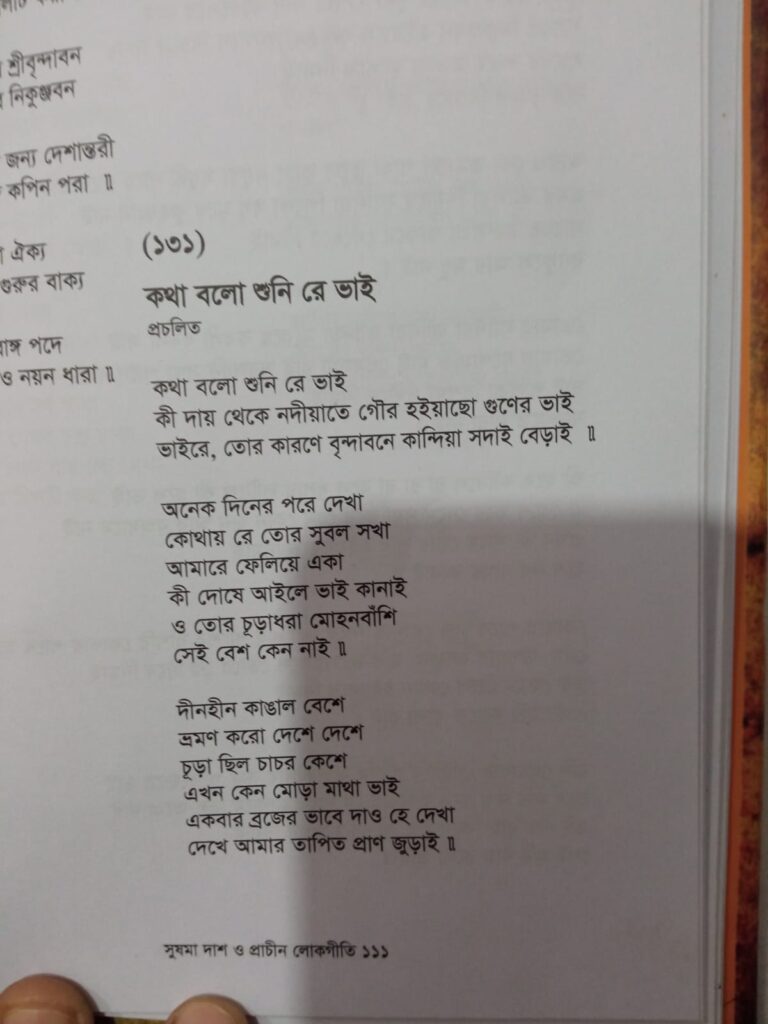
A young student of Sylhet in London, Azimul Raza Chowdhury, who is very close to Sushoma Das and her family, sent me this page with an anonymous song which has the word ‘deenoheen’ in it. Not as a name but as a state of being. ‘শাহ আবদুল করিম এক গানে বলেছেন আমি দীনহীন তুমি বাসিয়ো না বিন।‘ দীনহীন এই ক্ষেত্রে সম্ভবত স্রষ্টার কাছে কাতর হয়ে নিজেকে তুচ্ছভাবে প্রকাশ করতে গিয়ে ব্যাবহৃত হয়েছে।
Probir Das, Sushoma Mashima’s son, recalls songs in which poets use the word deenoheen to describe their state of ultimate devotion. He starts to sing the song for which Azimul had sent me the words.
We listen together to ‘Shey dukh koibar katha noy go bolibo kare’, cylinder 343, sung by Fayazullah. Then Probir sings ‘Katha bol shuni re bhai’, a song about Chaitanya, the 16th century Bhakti saint of Bengal, who renounced home to reach his god, and sang the Name (of god) as his way of devotion and love. From Arnold Bake’s ship, through the temperature-controlled space of the archives in Berlin, to Mashima listening to Fayazullah’s song, to her son singing songs learned from the mother—we have crossed many borders of time and space, backwards and forwards, in the course of that one evening.
Ambarishda had posted a beautiful song of the composer Deenoheen on Facebook recently and I asked him to send me a copy. Here it is.
Ambarish Datta who is also deeply knowledgeable about songs of Sylhet sang this song recently, which is a composition of the folk poet of Sylhet, Deenoheen (don’t know where exactly he was from) and goes thus: Tumi thako bondhu hiyaro majhare (Stay friend in the core of my heart)
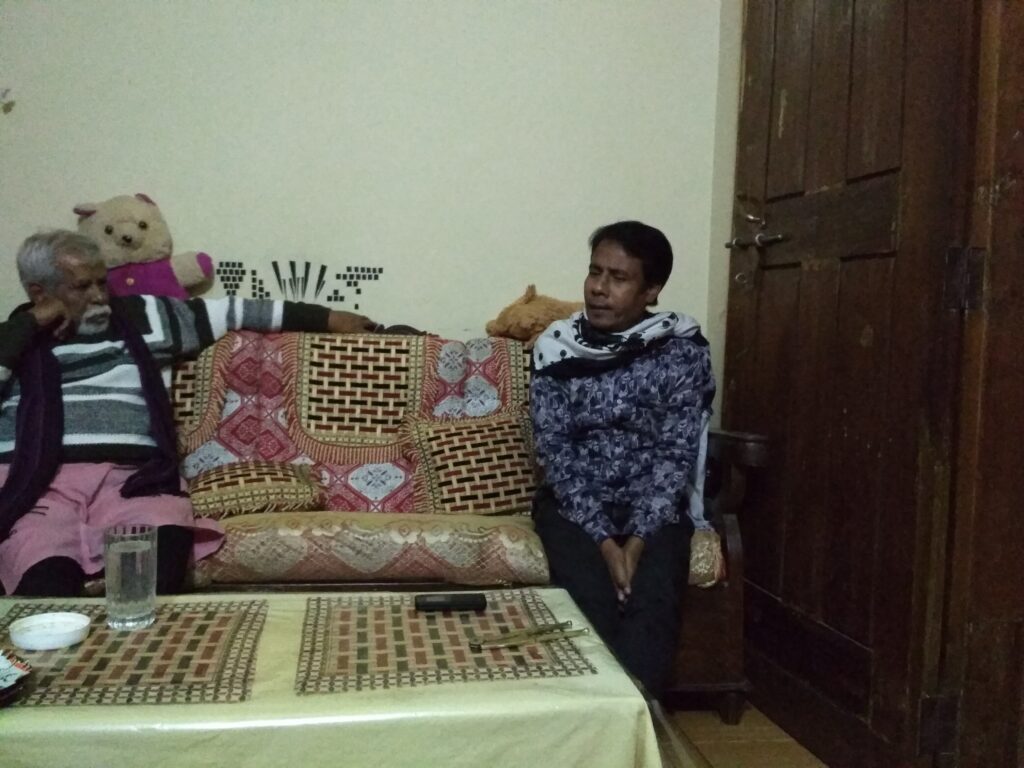
Ambarish Datta with Sushoma Das’ son Prashanta in their home in Sylhet on 15 January 2018
We listen to cylinder 350, recorded by Bake on 15 April, which is described as a ‘sari gan’ (boatmensong). The words go ‘Sarati jibono gelo morome mojiye’, it was sung by Fayazullah. Is it a sari gan? I ask Mashima. No, Mashima says. This is a ‘Monoshiksha dehotottwo’ song, she says. A didactic song about ways to cleanse the soul.
I also played Cylinder 351, the song that Sawabali had sung on the last day of Arnold Bake’s recordings on the Streefkerk, the song with which we had gone searching in Harikalash and had finally found Sawabali’s sons in Alapur
Mashima and others in the room listen to Sawabali’s ‘Je din jaabe akher tori’. Again, this is a ‘Dehotottwo’ song, Mashima tells us. ‘Jokhon asbe shomon jari, shob jaabe tolaiya’. A song about the final crossing, the final day when all things will cease to matter. ‘Monshikkha go ma,’ Mashima says. These are lessons for the soul. ‘Bujha jaay, bujha jaay na’—I get some of it and some I can’t. Then she comments: ‘Onek puran sur, this is an old old melody’.
Then a lot of discussion followed on the question of the rosit, the songwriter, and how people sing without naming the rosit. It started with one of Fayazullah’s songs. Sushoma Mashima is clearly troubled by such matters. She talked about a song she had heard someone sing, crediting Radharaman, while it was in fact a song of a rare woman composer of Sylhet, Rupmanjari.
Mashima expresses her disappointment with the words of songs as they are sung nowadays. She cites examples, then sings, ‘Haro go, Bridaban aaj preme bheshe jaay’, singing her bhonita to Rupmanjari. Her sons beat the rhythm and daughter Bashona joins her voice.
Bashona Das lives under the shadow of her mother, as do all of Sushoma Das’ children. Mashima is such a strong personality, after all! Bashona had visited Kolkata with Sushoma Mashima in 2011 to perform at the Jadavpur-Shaktigarh Baul Fakir Utsav, a folk festival organised by friends, including us. Mashima had also joined The Travelling Archive’s website launch at Jadavpur University on 11 January. I thought it would be interesting for us to see Bashona Das dance and sing at the launch—such a joy to watch her. Moreover, she is dancing the dhamail here, the dance we mention above, in the context of the song Shuno bondhu tumar sricharane koi.
The dhamail is not meant to be danced alone. But here as Bashona Das is singing and dancing, with her mother sitting behind her and providing support, we have to imagine the other women and listen to the chorus in that solo voice. 11 January 2011.
From the Rupmanjari song, the conversation turned to the topic of women composers. Did your mother Dibyamoyee compose, I asked Mashima. She might have written one or two songs, wedding songs and so on, but they are not so important to me, ami oto gurutto dei na, Mashima replied. ‘But my father Rasik lal wrote several good songs.’ Then Mashima and her children and Ambarishda and Suman Kumar Das all started to talk about the songs of Rasik Lal Das. Finally, Mashima’s third son, Prashanta sang a composition of his grandfather.
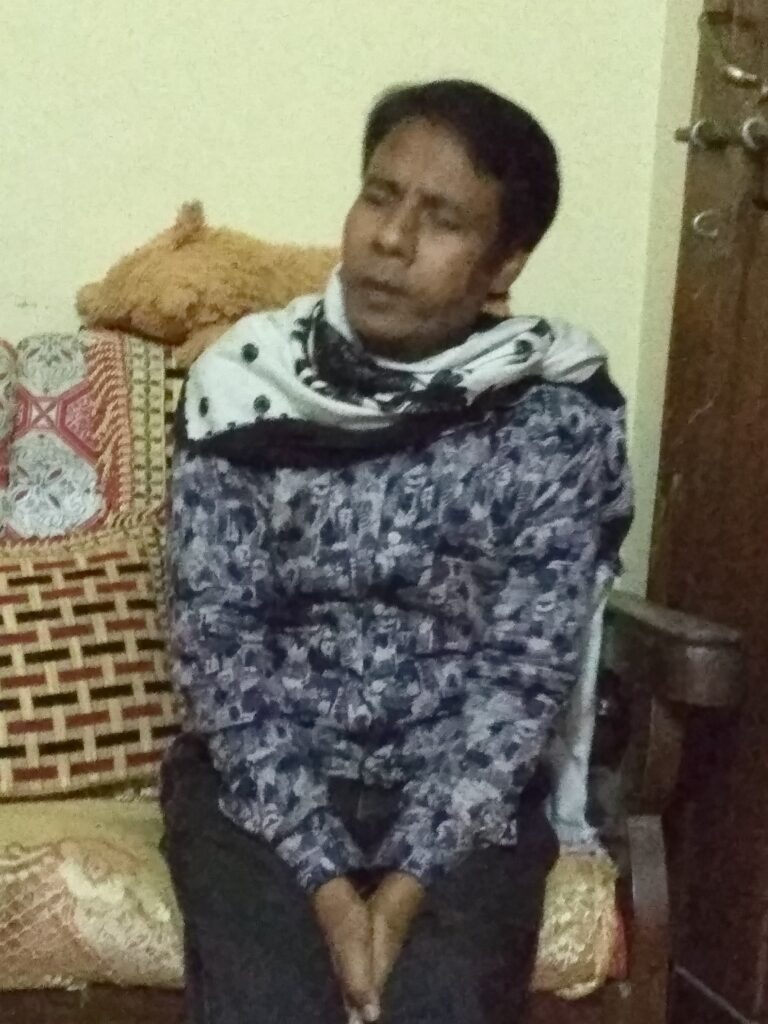
Sushoma Mashima mentioned a composer Rukmini in the context of women’s songs and sang a few lines of the song. Then she was out of breath. Then Prashanta sang ‘Amar bhanga naiyer naia’ (sailor of my broken boat)
Prashanta had quite got into the mood of singing that evening and he sang a song he had learned from his mother, ‘Shudhu bhakti korle’. There was a touch of regret in Prashanta’s voice. ‘I don’t get much of a chance, ami to shujog ujog pai na. Mone iccha hoy je di ekta gaan kori.’
Mashima was getting quite impatient about journalist-writer Suman Kumar Das; why is he not coming, she kept asking. Then he came.
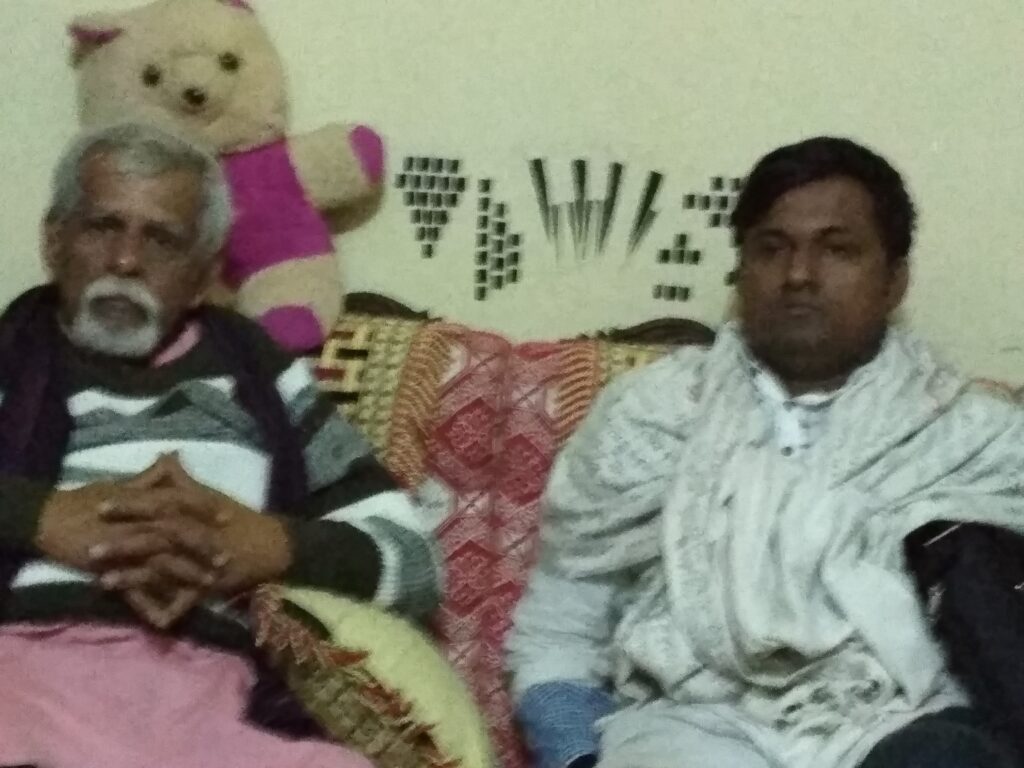
Suman Kumar Das works for a national daily, while also being a prolific song collector and writer. Here he is with Ambarishda.
Finally, when she was sufficiently relaxed, Sushoma Mashima sang the Rukmini song, concluding though that the songwriter might not have been female. They deliberated on the ambiguity of the matter.
How did Mashima learn these songs? I asked her. Just by being in an environment where music filled up every bit of life. ‘Luker mukhe shune shune,’ she said. By listening to others. Then she sang the Rukmini composition. ‘Prano bondhu re dile dekha bohudiner pore’.
When we were leaving, Mashima came to the door as always and as I touched her feet she said, ‘Will I see you again?’ She says this every time we meet.
This rare and precious recording of Nabani Das Khepa Baul and others would likely have stayed in the British Library Sound Archives, unnoticed, unnamed and unplayed for some more time, had I not accidentally come across it in 2018. I am not making a claim to any special talent as a researcher, but I suppose I was fortunate to have been at the right place at the right time with the right curiosity. I have written a detailed session note on the recording in The Travelling Archive’s Recording Sessions page for 2019. The process of putting the names of the iconic Nabani Das Khepa Baul (1890-1964), his son Purna Das Baul and others to file numbers C52/NEP/67 and 68 was a longwinded journey. It was like an archaeological excavation, এটি একটি খননের গল্প, as I wrote in the Sunday supplement of Ananda Bazar Patrika in August 2020. Young Purna Das Baul was performing at the third Banga Sanskriti Sammelan in Kolkata, with his father Nabani Das in 1956. In 2019, it was very emotional for Purna Das to listen to his father, sister, Radharani, brother-in-law, Gopal Das, and friend, Sudhananda Das Baul, as well as to himself when he was 22, going on 23. It was even more emotional as everyone except Sudhananda is no more. He remembered details of the performance, of the audience, the ambience. Perhaps he was not remembering everything exactly as it happened, but from what he was saying it was clear how things used to happen between them those days, how his father would perform, what they sang and the dynamic on stage.
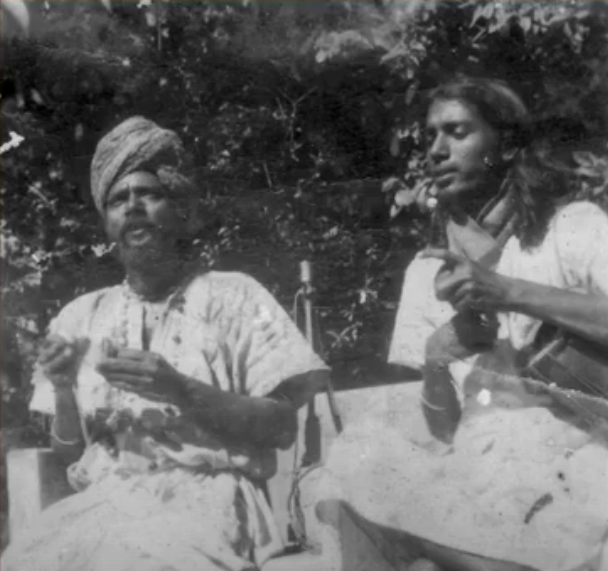
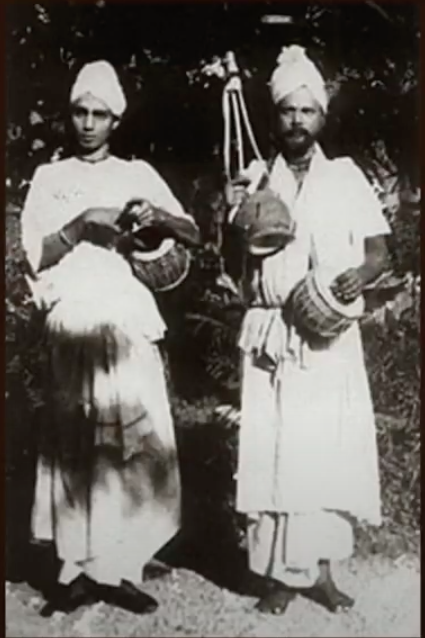
I suppose that in 1956, this is how father and son would have looked. Photos: From Purna Das’ family.
Since my meetings with Purna Das Baul in his home in 2019, and ever since we were able to identify the 1956 reel-to-reel recording of Nabani Das Khepa Baul, and copies were sent by the British Library to his family, after which I wrote my aforementioned session notes and the newspaper article in 2020, I have had some interesting exchanges with other researchers and collectors. I have looked through my own collection and gathered some fresh photos and recordings and other paraphernalia, all related to the Bake baul recordings of 1956. Here is an assemblage of some of that material, dated and labelled, for us to work together later.
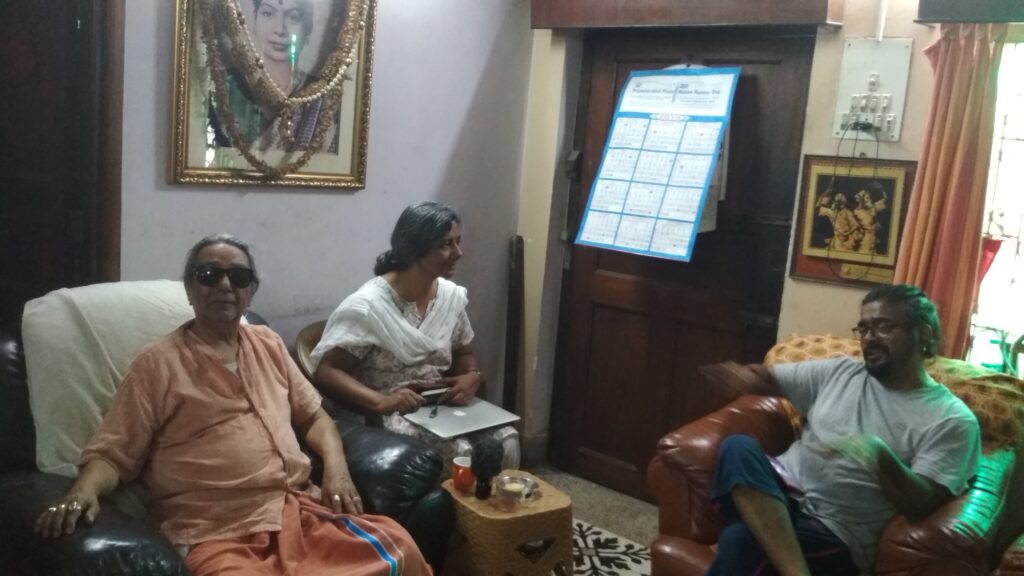
With Purna Das Baul and his son, Dibyendu Das Baul or Chhoton, in their home in Dhakuria, south Kolkata on 6 May 2019. Photo by Aditi Das.
After my Ananda Bazar article came out, and I posted the piece on my Facebook wall on 24 August 2020, researcher and activist Debi Roy wrote a comment about the research and recordings of bauls that they had made at Chitrabani, one of the oldest media training institutes of Kolkata, between 1979 and 1984.
‘নবনী দাসের বিখ্যাত গান, ” ভালো করে পড়গা ইস্কুলে “। রবীন্দ্রনাথের প্রিয় বাউল সাধক। কবি শান্তিনিকেতন গেলেই তাঁর গান শুনতেন। Arnold Bake-এর রেকর্ডিংটা কীভাবে শোনা যাবে?
‘আমি চিত্রবানীতে “বাউল-ফকির প্রজেক্ট ” -এর সঙ্গে 1979-1984 যুক্ত ছিলাম-একজন মাঠ গবেষক হিসাবে কবি দীপক মজুমদারের সঙ্গে। দীপক মজুমদার কৃত্তিবাস পত্রিকার প্রতিষ্ঠাতা ও প্রথম সম্পাদক। তিনি আমার গুরু। আমরা প্রচুর বাউল গান রেকর্ড করি, প্রচুর ইন্টারভিউ নিই বাউলদের, সেই সঙ্গে প্রচুর স্টিল ছবি-চিত্রবানী লাইব্রেরীতে আমার হাতে লেখা ” বাউল প্রসঙ্গে” বলে বাঁধানো বই আকারে আছে। আমার সহযাত্রী ছিলেন-সুনেত্রা ঘটক, গৌতম চ্যাটার্জী (মহীনের ঘোড়াগুলি), সতীনাথ চ্যাটার্জী, অনিরুদ্ধ ধর, সেলিম পাল ও আরো অনেকে। আমি নবনী দাস সমন্ধে জেনেছি-তাঁর মেয়ে রাধারাণী দাসের একটি সাক্ষাৎকার থেকে-সেইটার রেকর্ডিং ছিল-ওই গানটার উল্লেখ ছিল- আর একটা পাঁচসেরি মালা পরে নবনী ক্ষ্যাপা পৌষমেলায়, কলাভবনে নেচে নেচে গান করতেন। তাঁর সমসাময়িক ছিলেন বেতালবনের নিতাই ক্ষ্যাপা আর মনোহর ক্ষ্যাপা। আমি সেইসময় লক্ষণ দাসের সঙ্গে নবনী দাসের ভিটেয় যাই। পূর্ণদাস বাউল আর রাধারাণীর সঙ্গে সেখানেই পরিচয় হয়। এইটুকুই। আমি গোষ্টগোপালের বাবা দীনবন্ধু দাস-বিশাখা দাসীর বাড়িতে গিয়েছি-থেকেছি। দীনবন্ধু আলাউদ্দিন খাঁ সাহেবকে বাউল গান শুনিয়েছিলেন। আর স্বয়ং রবীন্দ্রনাথ নবনী পুত্র পূর্ণদাসকে আশীর্বাদ করে বলেছিলেন, তুমি বিশ্বখ্যাত হবে। এইটুকুই।’
Debi Roy had asked about this song in his note. ‘Bhalo kore por ga iskoole’. A song credited to Nabani Das Baul. I found a video in which Purna Das sings only a few lines of the song. As I listened, I made a recording on my Zoom H2N.
I wrote back to Debi Roy that indeed, I had heard mention of that song and heard people sing it too. ‘হ্যাঁ ওই গানটার প্রসঙ্গ তো বার বার এসেছে, আমার সঙ্গে কথা বলার সময়ও পূর্ণদাস বলেছেন গানটির কথা। আমি যেটা বুঝতে চাইছি তা হলো সবাই বলেন, নানা ভাবে নবনীদাসের রবীন্দ্রনাথের আদর পাবার কথা বলেন, সবার স্মৃতিতে সেই কথা ধরা আছে, তারপর স্মৃতি থেকে স্মৃতিতে বাহিত হয়ে এটি একটি সাধারণ সত্য হয়ে গেছে, যা প্রশ্নাতীত। যে কারণে আমি ঠিক সেইভাবে না লিখলেও আনন্দবাজারের ব্লার্বে এইভাবেই ভূষিত করা হলো নবনীকে–রবীন্দ্রনাথের স্নেহধন্য নবনী বলে। কারণ আমরা এভাবেই জানি। সবাই জানেন। আমিও জানি। প্রশ্নও করছি না। আমি শুধু ভাবি কারো যদি সরাসরি কোনো লেখা থাকতো এই বিষয়ে। আছে নিশ্চয়। আমি তো সব কিছু পড়িনি। […] আমি এটাও বুঝতে চাইছি, নবনীদাস শান্তিনিকেতনে, কলাভবনে কোন সময়টা থেকে আসতে শুরু করলেন। কুড়ির দশকে? তিরিশের দশকে? বাকে সাহেব তাঁকে দেখেছিলেন কি না, এটা তো আমার একটা unresolved প্রশ্ন হয়ে থেকেই যাবে। এই আর কি। চিত্রবাণীর ওই সময়ের কাজ রেকর্ডিং হিসেবেই release করা হতো যদি। না কি, হয়েছে? এত সব অমূল্য জিনিস। আমার আসলে সময় নিয়ে বেশি আগ্রহ। এই সব রেকর্ডিং শুনলে, এইসব গল্প শুনলে অন্য সময়, অন্য মানচিত্রে পৌঁছে যাই। এর বেশি অত কিছু আমি জানি না।’
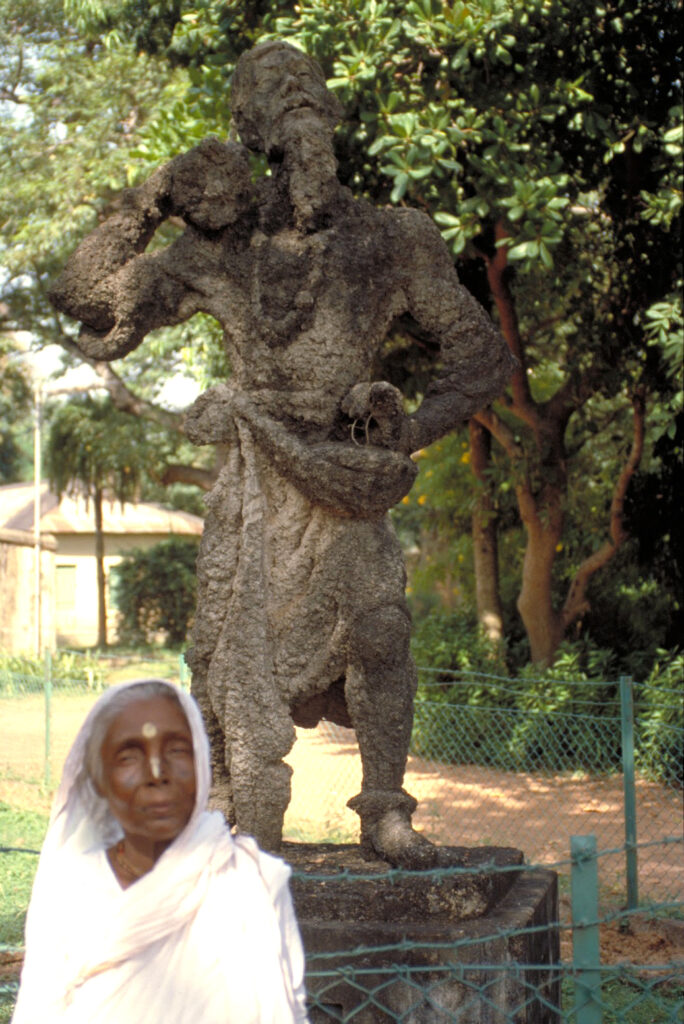
Within the Nabani Das family, there are all sorts of myths which do the rounds. Over the years, Nabani Das , Purna Das and Lakshman (also spelt Laxman and Luxman) Das became part of something big, a kind of establishment, studied by scholars and the latter two recorded by major international labels, performing in music concerts around the world, especially Purna Das Baul. Which is why family members are careful to mark their individual place within that lineage. For example, one of Purna Das’ sons who lives in the USA now, Krishnendu Das Baul aka Babu Kishan Das, makes many claims about Nabani Das ’ associations with Santiniketan, particularly with Tagore. This sculpture is of a baul and it is on the outskirts of Santiniketan. The claim is that it was made by the famous Ramkinkar Baij and was inspired by the figure of Nabani Das Baul. The truth of this claim is disputed by art historians such as Sushovan Adhikary, who is a professor of Kala Bhavan, Santiniketan. But I do not know who made it. Here Nabani Das Baul’s wife, Purna Das-Lakshman Das-Chakradhar-Radharani’s mother, Brajabala is seen standing before the sculpture.
Brajabala sang too and we had talked about her on 6 May 2019.
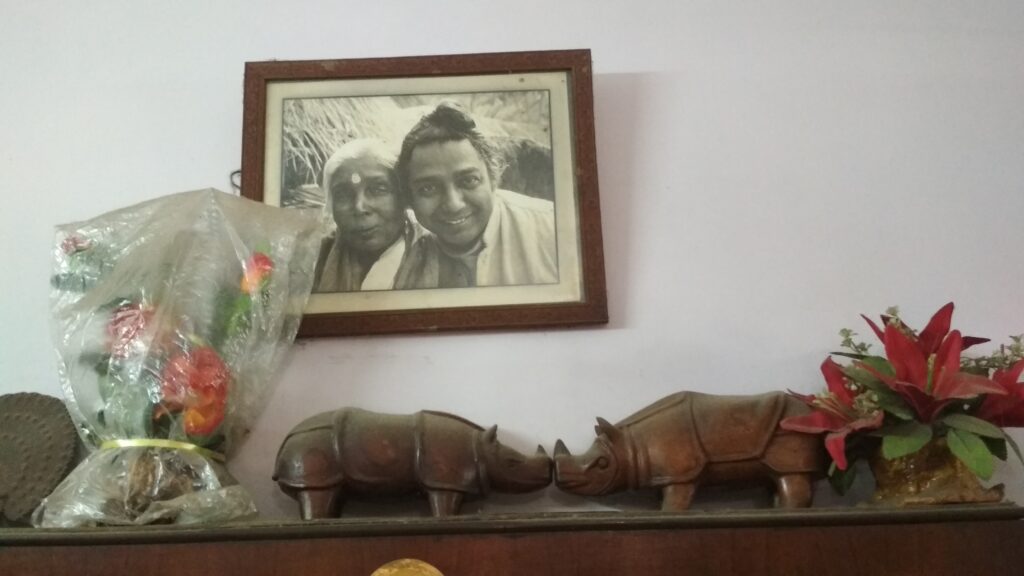
I took this photo in Purna Das Baul’s home in Dhakuria, Kolkata in 2019. The date of the photograph of Purna Das with his mother on the wall is unknown; my guess is that it is from the later part of the 1960s.
On the question of myths surrounding Nabani Das Baul, in a recent article, journalist Snigdhendu Bhattacharya wrote that one of the songs in Purna Das Baul-Lakshman Das Baul’s 1967 album from Elektra, ‘Bauls of Bengal’, ‘Ki Diye Pujibo Hari Charono Tomar’ was ‘one that Tagore composed as a baul and gave Nabani to set to tune’.
Hori ki diye pujibo balo ranga charano tomar/ Ore kon phule pujile balo puja hoy tomar… and then the bhonita, the signature, Thakur Robi bole… How to get to the bottom of this claim? Was it truly a Tagore song set to tune and sung by Nabani Das Baul?
Around the same time when I was working on Arnold Bake’s 1956 recordings, Carola Erika Lorea, a scholar of Bengali oral traditions, led a research under the British Library’s Endangered Archives Project entitled ‘Songs of the Old Madmen’ (2019-2020) in which she is ‘recovering baul songs from the notebooks of 19th and 20th century Bengali saint-poets’. One of the collections which comes out of the project is on and around Nabani Das, in which mainly old notebooks containing texts of songs composed by Nabani and his contemporaries and older bauls have been scanned and digitised. One of chapters of this project is the Mahadeb Das Baul Collection, Mahadeb being the son of Nabani Das’ son Lakshman, whom we had also recorded in Suri in 2009.
One of the notebooks in the Mahadeb Das collection has songs of Nabani Das Baul. In general it has handwritten song texts ‘composed between the 1790s and 1980s. The notebook itself was compiled during the second half of the twentieth century.’
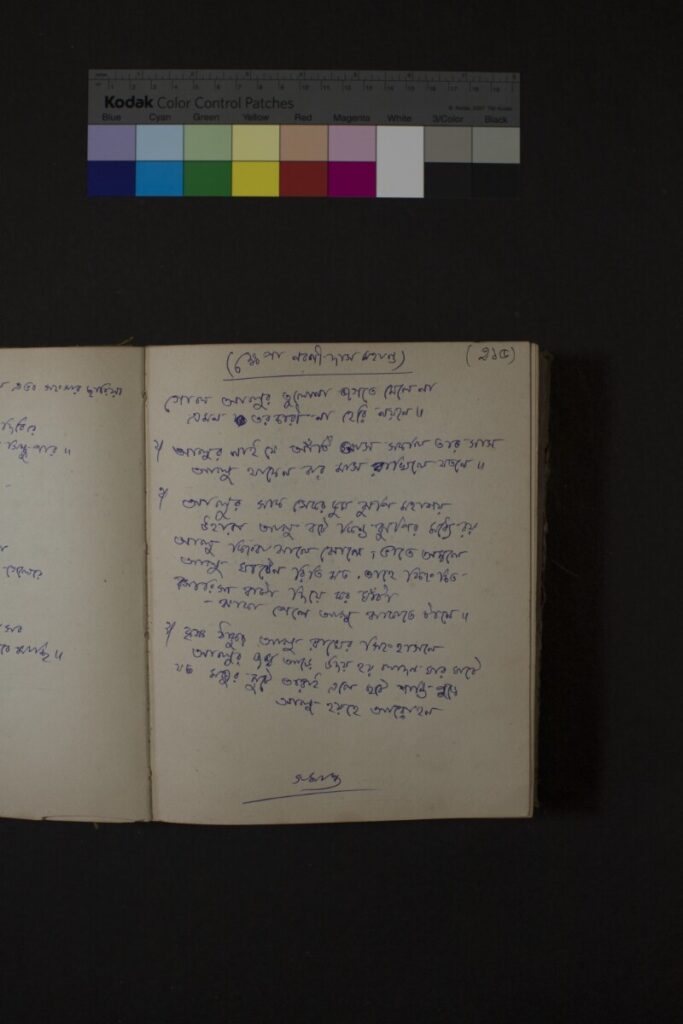
Dowloaded from the British Library archives. This open access file has a Creative Commons attribution non-commercial licence.
Interestingly, I found a clip of the song sung by Purna Das Baul, which I recorded while playing from the Internet.
Carola too wrote to me after my Ananda Bazar article was published. On 27 August 2020, she wrote in an email: ‘My empirical data around Nabani […] comes from various strings that often are not interwoven at all. The Bengali bhadralok and American counterculture is just one stream of threads, and quite rich, relatively speaking; if compared to other rural artists of his times, it is well documented or at least approachable through the notes and memories of Sally Grossman, Purna, and so on. A parallel stream runs through the oral tradition of sadhakas who remember and value things about Nabani that are probably not so palatable for the glorified folk Nabani of the Babu realm. The ways he used to smoke his chilum with poisonous datura sacred, the way he raised in the air when reaching samadhi, the heartbreaking moment they had to cut his long jota, and many other stories that no hard scientist will ever prove and that will never be part of canonical historical evidence. When I heard about Nabani for the first time, it was from meditators who address him as avadhut — a term used in local taxonomies of liberation, which is not single or absolute, but passes through several degrees and stages.’

Bob Dylan wanted his manager’s wife, Sally Grossman, to appear on the cover of his 1965 album. The photo was taken at her home in Woodstock, N.Y. The source of the image can be found here.
I had also sent links to the Nabani-Purna-Lakshman sessions to Sally Grossman, whom I first met possibly in 2010, when Charles Capwell’s book on the bauls of Bengal was being launched in Kolkata. She wrote back on 24 August 2020 to say ‘how fantastic’ it was to find these recordings and then she seemed brimming with remembrance of songs and stories from the past, because the mention of Lila Ray prompted her to write ‘Lila Ray was great. Spoke about Nabani.. not a great voice but oh so charismatic a singer.’ Sally remembered Purna, Lakshman, Sudhananda, Hare Krishna, Jibon Das in Bearsville and the Bengali Bauls at the Big Pink. ‘Like with the Elektra record, some thought they were being cheated out of income but of course the truth was even if popular with some people, it didn’t sell a lot. No real money after recording costs, album production, travel, … hard to understand that I guess.’
She sent me a song.
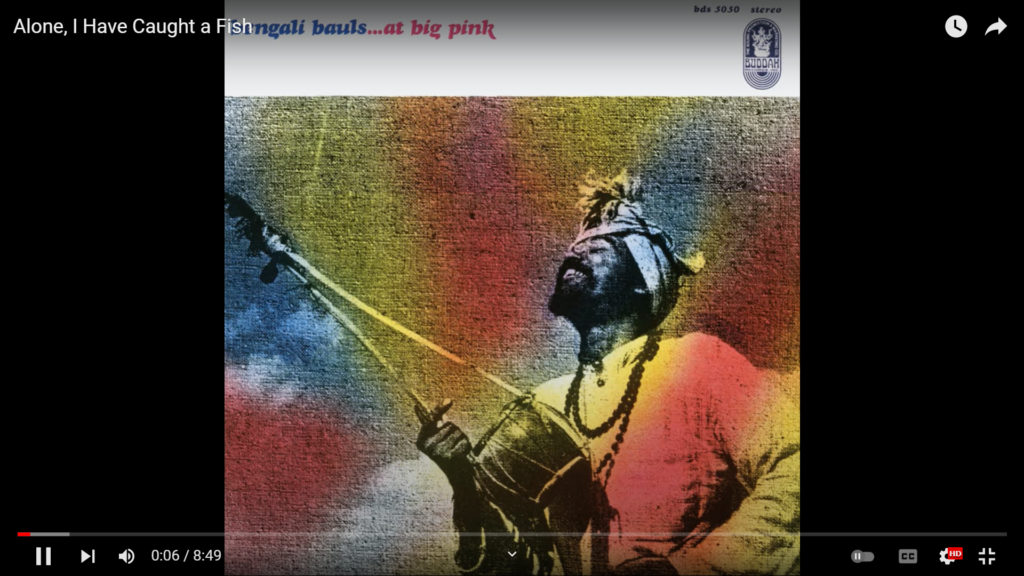
Sally sent me something about the Canadian multi-instrumentalist Garth Hudson, who had produced the Bengali Bauls at the Big Pink (1969) album. In an interview, Garth had said about the bauls: ‘We were also listening to East Indian music a little bit, and the Bengali Bals [sic.], which is more basic than the sitar music from the north. They’re from an area near Bengal in India. Albert [Grossman] had them over – he was Bob Dylan’s manager. […] Perna daus, Luxman –this was the early group – and Hari Krishna Das… Was there five of them or three? Luxman is back in his home town. He is a real ball. He is exceptional. His town people revere him. Perna is the laureate, the bell cantor, and he goes all over the world. He is successful, he comes to America often. He plays a kramk. There are three or four spellings to be found. It’s unique and is from that area. It’s the only place you’ll find it in India. It’s a great instrument. My percussionist Steve said, “What is that sound?” He heard it on the record. I said it was a kramk. He’d never heard of it. He said, “I gotta get one!” They’re Latin players – I got two in the section, Ernie Colon and Steve Elson. It’s a wild sounding thing. I won’t describe it to you. Look it up. You’ll hear it on ‘The Seas Of The North’. We’ll just leave it at that.’
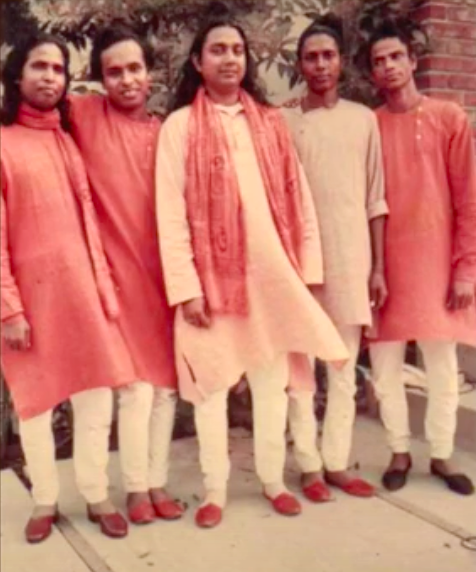
Left to right, Hare Krishna Das Baul, Jiban Krishna Mondal, Purna Das Baul, Lakshman Das Baul, Sudhananda Das Baul . Source: Purna Das’ family
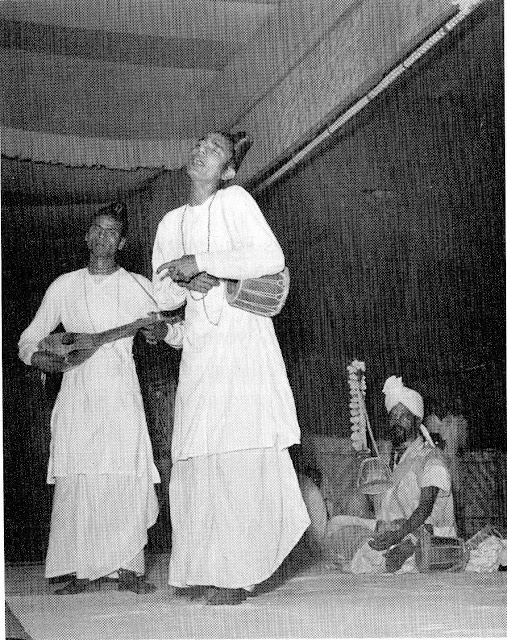
This would be an image from the time of Arnold Bake’s 1956 recording at Banga Sanskriti Sammelan. If not exactly then but around that time. Purna and Sudhananda play and sing, Nabani Das Baul, sitting on the floor, looks on. Source: Purna Das’ family
Sally had also written this little footnote in her email of 24 August 2021: And the $5K I brought from Garth Hudson for Bengali Bauls at Big Pink …
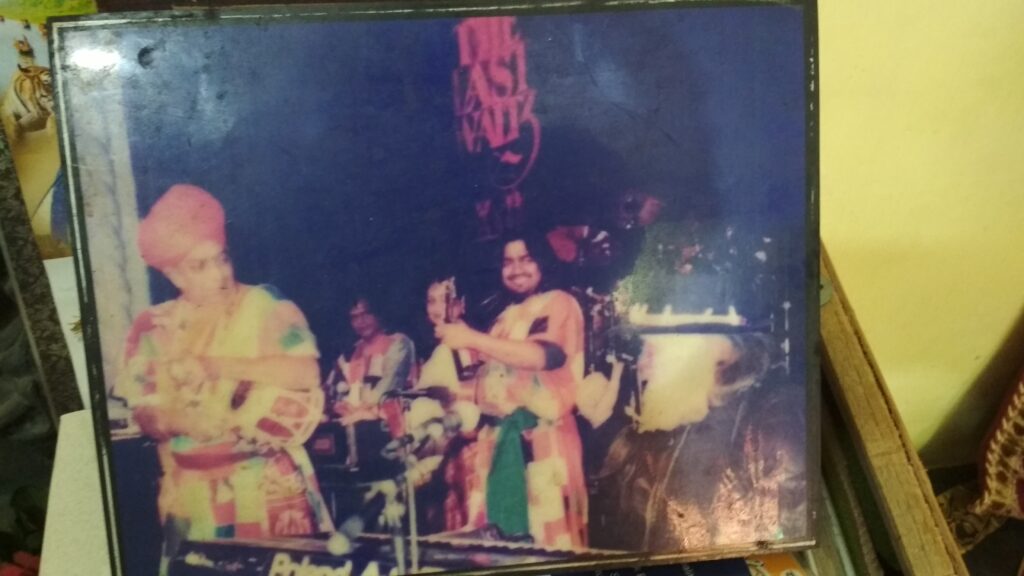
From the wall of Purna Das Baul’s home in Dhakuria, Kolkata in 2019
When I met Purna Das Baul and his son Chhoton in 2019 to talk about Arnold Bake’s baul recording from 1956, we journeyed through history and remembrance. Chhoton showed me a photo from when they had been invited by Garth Hudson to perform at the opening of the digitised version of The Last Waltz, Martin Scorcese’s film on the band called The Band. He talked about limousines and red carpets. But they had no photographs of the event apart from this hazy one, which they had mounted on their wall. I heard a lot of talk that day of lost photographs and recordings and unpaid royalties and researchers writing their thesis on baul studies and so on.
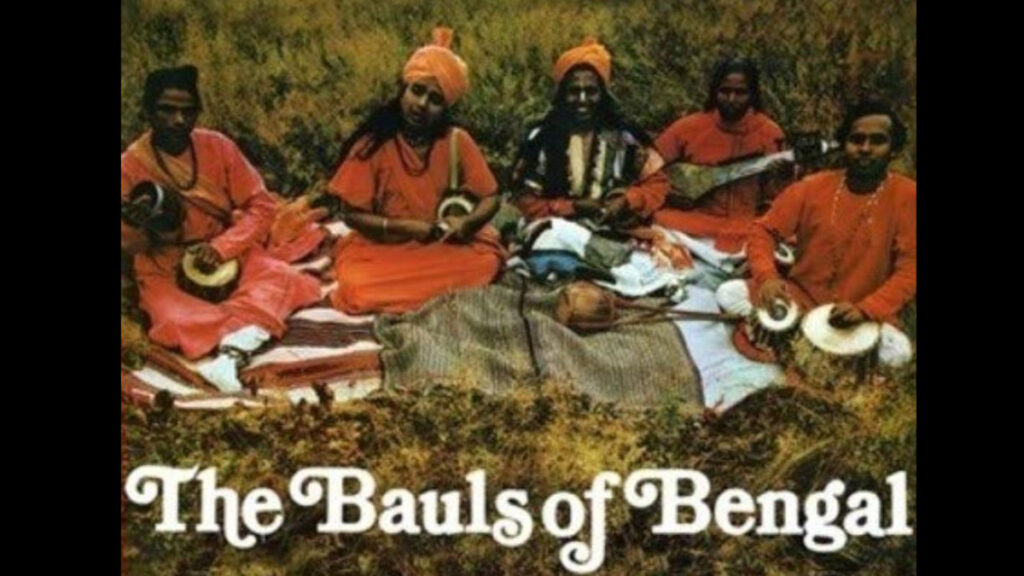
Among the names which came up in Purna Das Baul’s conversation that day on 6 May 2019 were those of Charles Capwell, Sally Grossman and Professor Dimock. Names, like new lands, had entered the soundscape of these travelling minstrels.
Before the trip to the USA in 1967, the voices of Nabani Das Baul and his sons had already travelled to Europe and America. For example, there was this record.
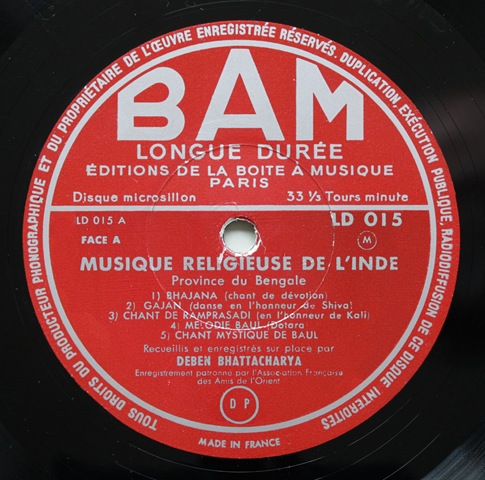
Nabani Das Baul was recorded in 1954 by Deben Bhattacharya and the recordings of Nabani and Purna and Lakshman/Luxman had been put in various anthologies released in France and elsewhere from the fifties onwards.
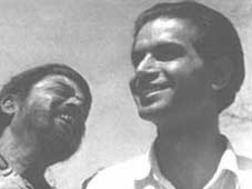
Song collector and field recordist Deben Bhattacharya with Nabani Das Baul, photographed by Richard Lannoy, possibly in Nabani Das’ home near Suri in 1954.
What kind of baul and other folk songs used to be recorded in Bengal prior to the 1950s, both commercial and non-commercial? Finding the Nabani Das record and then following conversations with Purna Das provoked the question. I re-read Amitabha Ghosh’s 1999 essay, ‘Pre-Commercial Era of Sound Recording in India’ published in the Indian Journal of History of Science, 34(1) and searched and found on the internet this iconic photograph of mostly people from the ruling elite class, listening to the phonograph in 1892, that Ghosh writes about. ‘The year 1892 has left us with a visual document of the phonograph in India. This is a photograph dates 22 May and was taken by Lala Deen Dayal in Hyderabad.’
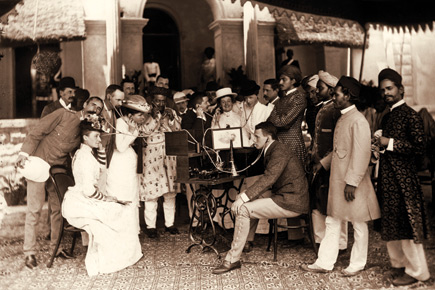
The phonograph in India photographed by Raja Lala Deen Dayal (1844-1905). A Hyderabadi Nawab and his friends listening to the phonograph on 20 May 1891, according to Wiki Commons, from where this image has been sourced. Whether the date was 22 May 1892 or 20 May 1891, I have not been able to find out.
Ghosh writes about how the Bengali poet, singer and journalist Nalinikanta Sarkar (1889-1984) had an experience of listening to a phonograph in a tent in a village fair in Murshidabad. The bifurcated pipe from the box with holes, which looked ‘something like a stethoscope used by physicians’ was plugged into his ears. ‘Within a few seconds the machine started to sing, Aar ghumao na man, mayaghore aar katakal rabe achetan’. Who might have recorded such a song? Ghosh also writes about a bhatiyali or boatman’s song ‘Majhi tor baitha ne re ami aar baite parlam na’, that had been recorded in 1902 by Hemen Bose ‘Whether these recordings as well as other contemporary ones were commercially released as H. Bose’s records from his Talking Machine Hall, 41 Dharamatalla Street (presently Lenin Sarani), cannot be ascertained,’ Ghosh writes.
Interestingly, my friend, sound artist, musician and record collector Robert Millis, shared with me a recording from around 1908 of this very song, ‘Mon majhi tor baitha ne re’, sung by ‘Mr. J. N. Bose (amateur)’.
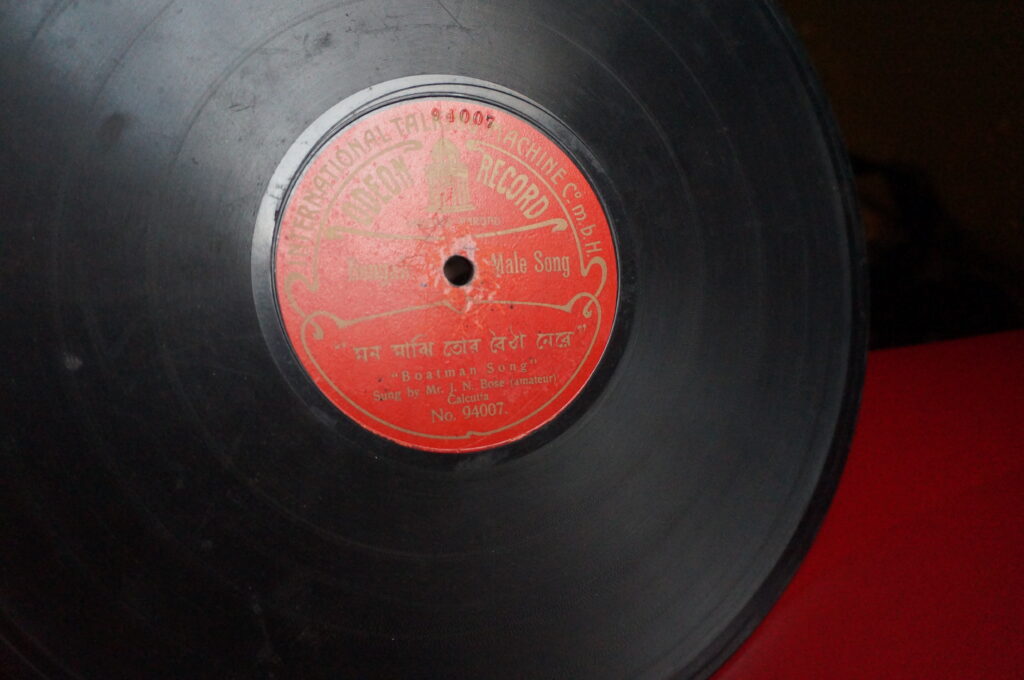
In his book Indian Talking Machine, Robert Millis writes about a 78 rpm by M. N. Ghosh, alias Monta Babu, recorded in 1919. He had asked me to listen to it and asked for my impression. While I am no expert, I could hear both the khamak and the harmonium in the recording. The melody and even in the way the words are pronounced, the singer seems like a trained urban artiste to me, affecting baul ways, incorporating baul sounds into his work, but creating a song for the record company, to sell to buyers of 78s who would have a gramophone record player in their homes, I told him.
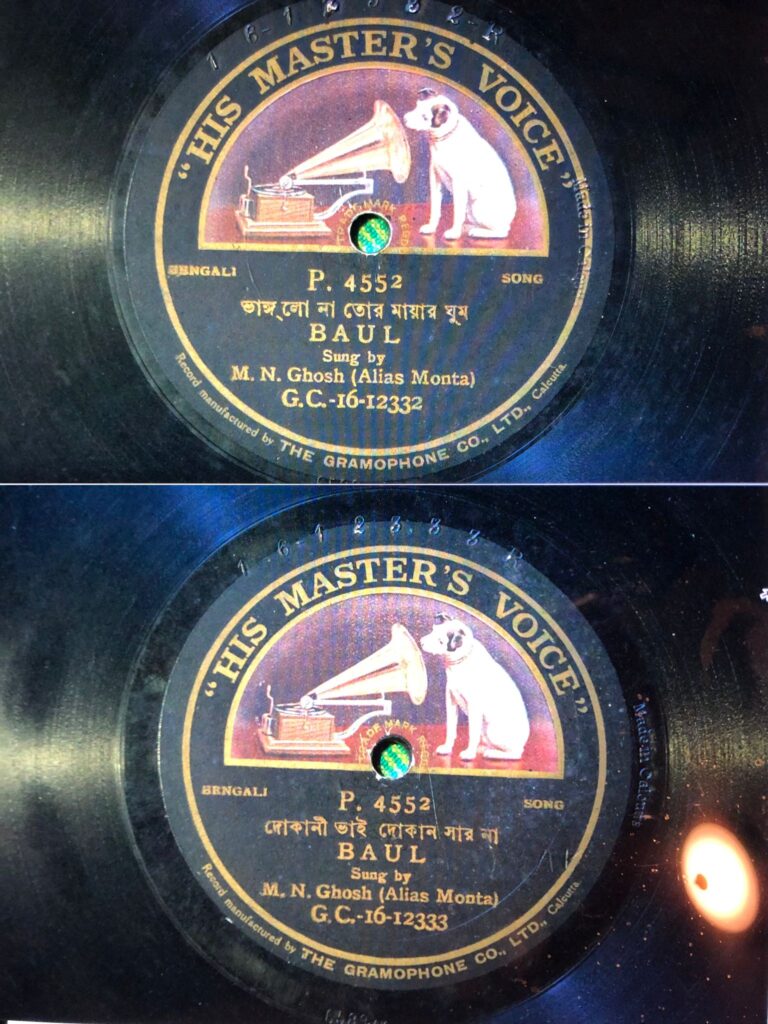
Songs on both sides of 78 rpm disc; the songs have been described as baul. The digital copies were shared with me by Robert Millis
These recordings were clearly paving the way for the records of baul and bhatiyali which began to come out in the 1950s. There are the Deben Bhattacharya recordings of Nabani Das and Purna from two years before Bake’s. There are Bake’s own wax cylinders from Kenduli. There might well have been other recordings, things we will unearth in the future, not me perhaps but others–recordings tucked away in someone’s home or archive.
On 6 May 2019, during our conversation, Purna Das Baul was telling me how he had been recorded for the first time in May 1956, which would be after Arnold Bake had recorded them at the Banga Sanskriti Sammelan in February-March that year. This was a Hindustan Record, H1639, a 78 rpm disc, with ‘Eto loke periye gelo’ on one side and ‘Majhigiri jani bhalo’ on the other.
In 2005, The Travelling Archive had recorded Debdas Baul singing ‘Majhigiri’ in Santiniketan.
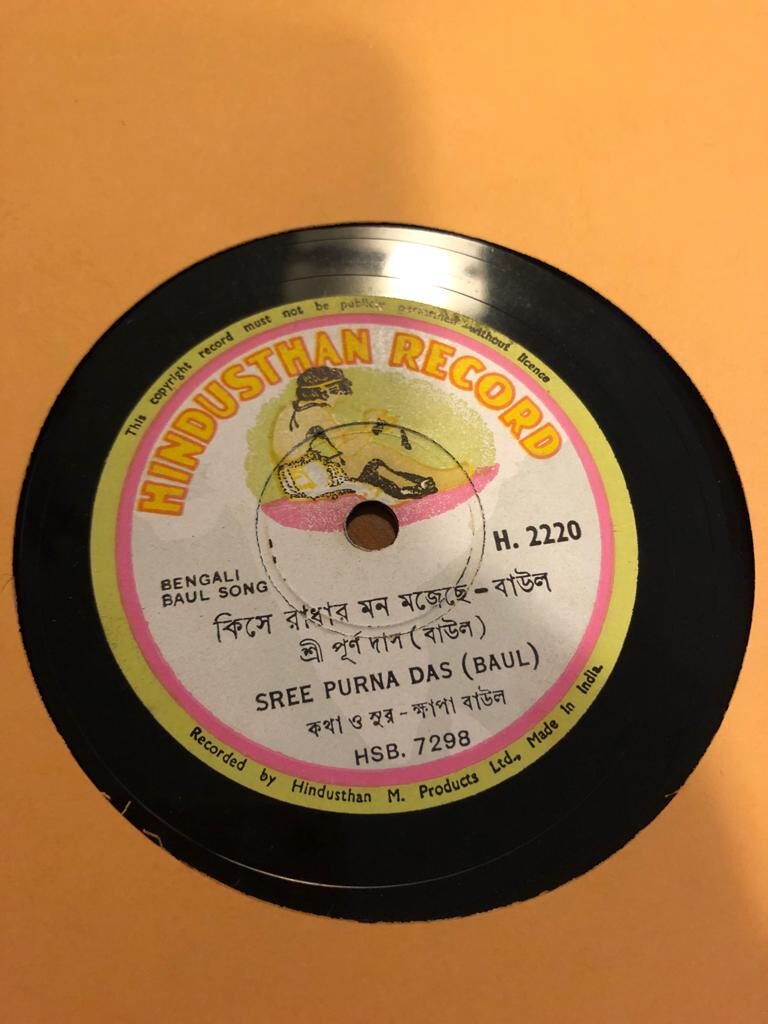
This record will be from the early 1960s.
Purna Das Baul had told us how at first, he failed the audition and how the record company was quite keen to have Radharani, and how she declined the offer, since her younger brother did not pass the test. Radharani was also recorded by Arnold Bake in 1956.
These images have been shared with me by Purna Das Baul’s family. Radharani sings here with her husband Gopal Das, who was also on Arnold Bake’s tape.
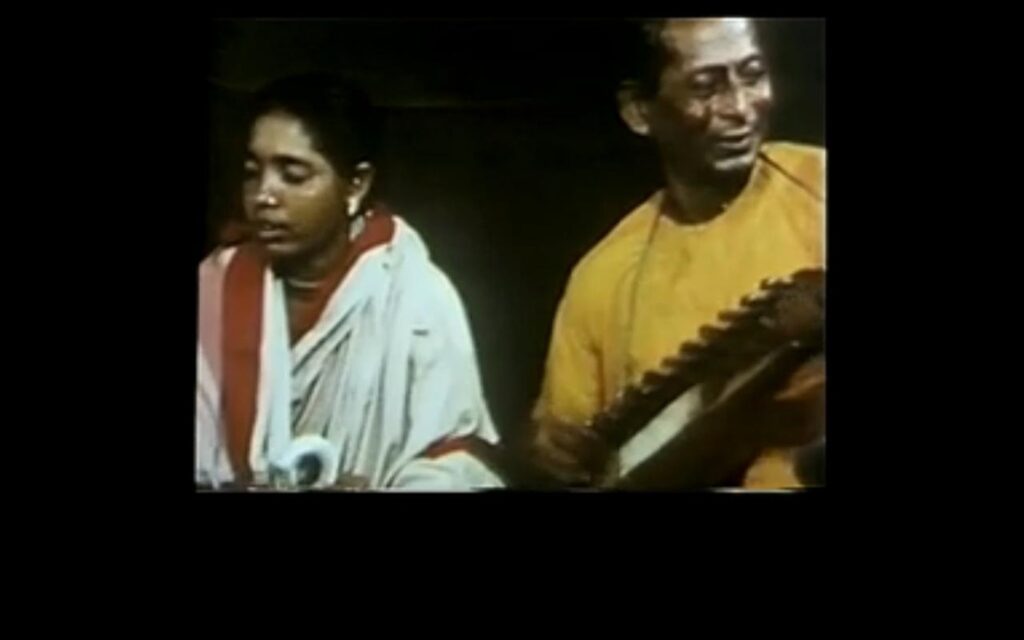
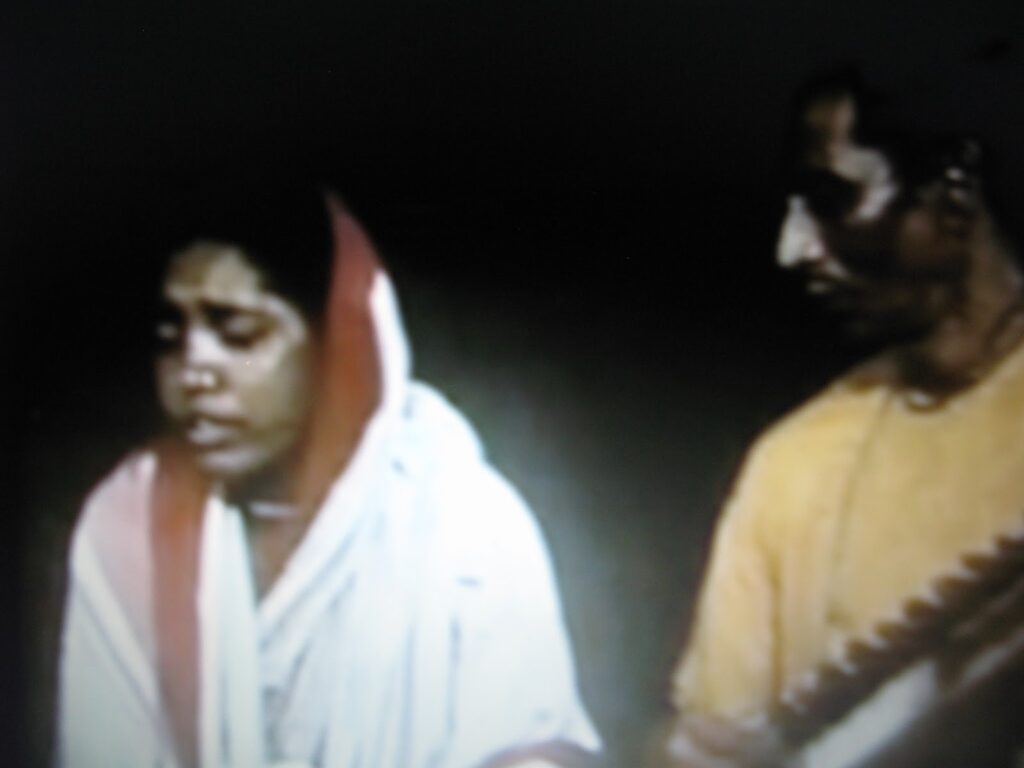
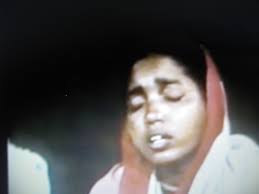
On 8 March 1956, Arnold Bake had recorded Indira Devi Chaudhurani (1873-1960), Rabindranath’s niece, in her home in Santiniketan. The recording is numbered C52/NEP/71 C1 on the British Library Sound Archive catalogue. Indira Devi was 82 at the time of the recording, but her voice was still steady and her memory intact. About this recording Bake wrote later in his field report: ‘I had the opportunity to make some interesting records of Oriya folk music and Bengali songs, including the rendering of one of Tagore’s songs by his niece, aged 82— the Acting Vice-Chancellor of Visvabharati University – a remarkable achievement on the part of the old lady.’
Indira Devi Chaudhurani, singer, musicologist and writer, was the daughter of Rabindranath’s elder brother, Satyendranath Tagore, the first non-white officer of the Indian Civil Service. Her mother Jnanadanandini Devi was a writer and social reformer. Her brother, a year older than her, was Surendranath Tagore, also an author and translator. On 21 January 2016, I went with sound recordist Sukanta Majumdar to meet Supriyo Tagore, Surendranath’s grandson, to listen together to his grandaunt’s song. (Incidentally, Jaya Sen (Tagore), whose photograph we also found in Arnold Bake’s Santiniketan archives, was the daughter of Surendranath.) Supriyo Tagore (born in 1938) used to be the principal of the secondary school of Sanitiniketan, Patha Bhavan. His wife, Shubhra Tagore, who taught small children, was also present at this listening session. As Supriyoda listened to his father’s aunt, who used to live with them in the later part of her life and whom they used to call Na’di, memories happy and sad came flooding to his voice. They had no recordings of her songs, he said, and so this was the first time he was listening to something like this. It is interesting that even in elite homes such as the Tagores, audio recordings were not at all common till maybe 20 years later, when people started to have tape recorders for domestic use.
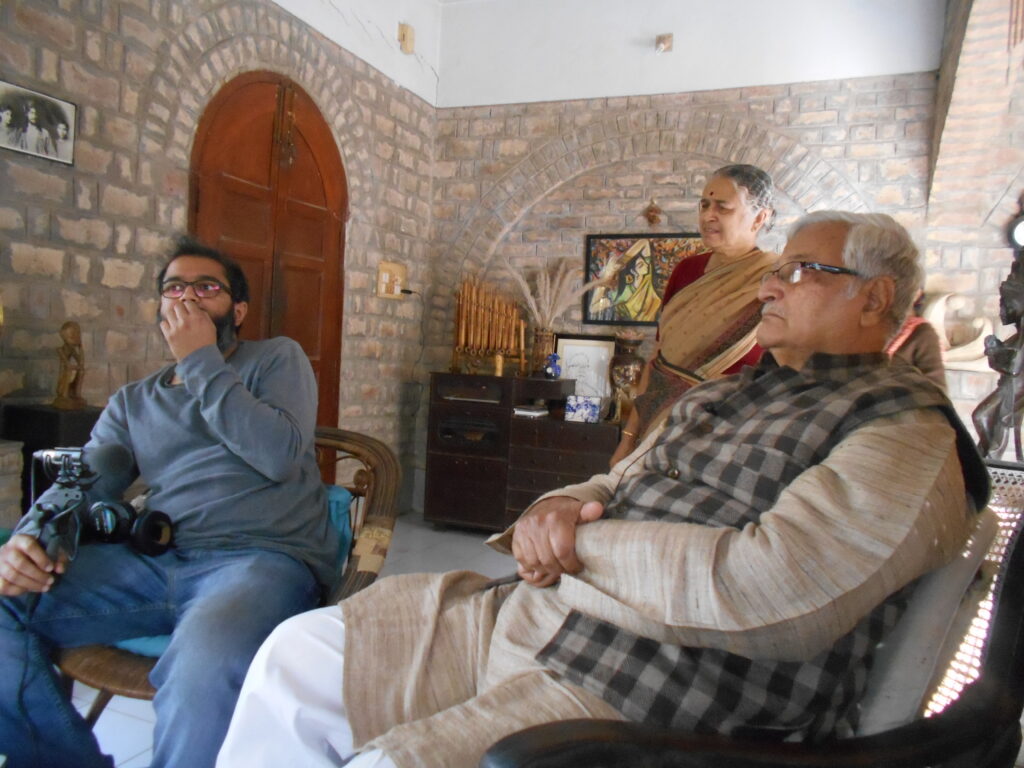
Supriyo and Shubhra Tagore listen to Bake’s recording in their home in Santiniketan, while Sukanta Majumdar records their listening. On the wall is a photograph of the siblings Surendranath and Indira Devi, with Rabindranath.
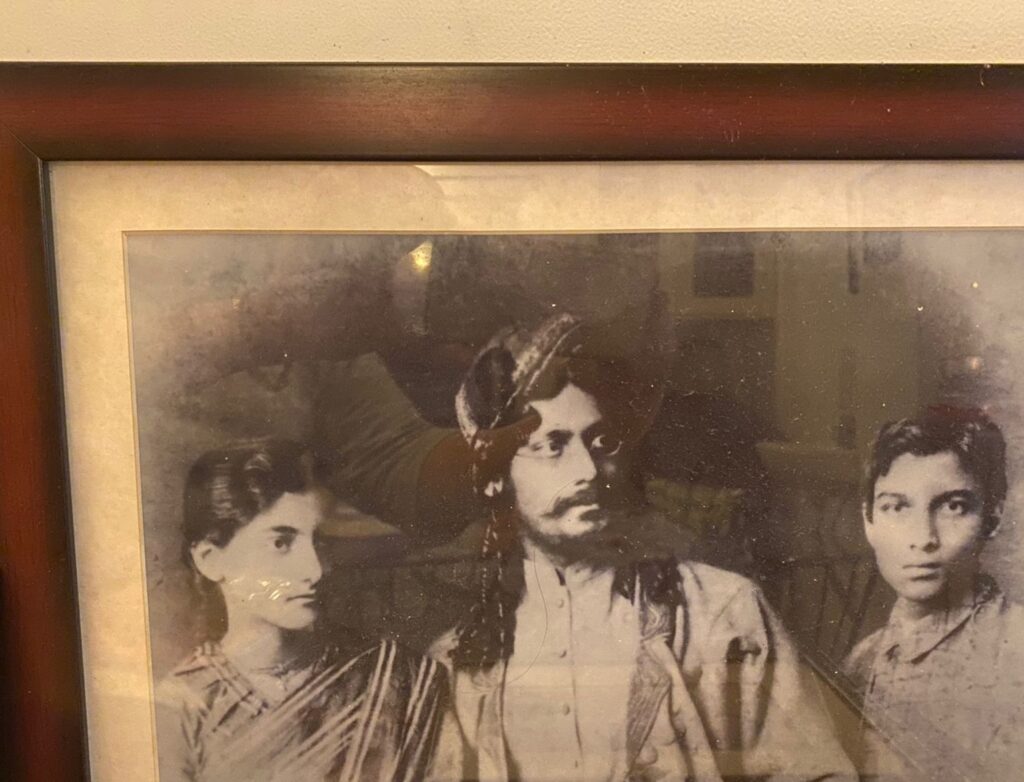
This photograph, which was on the wall of Supriyo Tagore’s home, is framed in the houses of many other family members. Indira Devi and Surendranath with their Robika, uncle Rabindranath, not that much older than them. I got the photograph from my old friend Ishani, granddaughter of Jaya and Motru Sen. Jaya Sen (Tagore), as we know, was one of Surendranath’s daughters and they were friends of the Bakes in the 1920s. The date of this photograph is unknown, but from the way they look, the siblings must have been in their teens and Rabindranath would be in his twenties.
The exclamation in Supriyoda’s voice as soon as Indira Devi’s song starts to play strikes me every time I listen to this recording. Supriyo Tagore was 22 when Indira Devi died, and he had spent many years in the same house with her. So, her voice must have startled him, given him a sense of her presence, as if she was in the room, as if she had come back, because that is what I hear when he says, ‘Ah!’
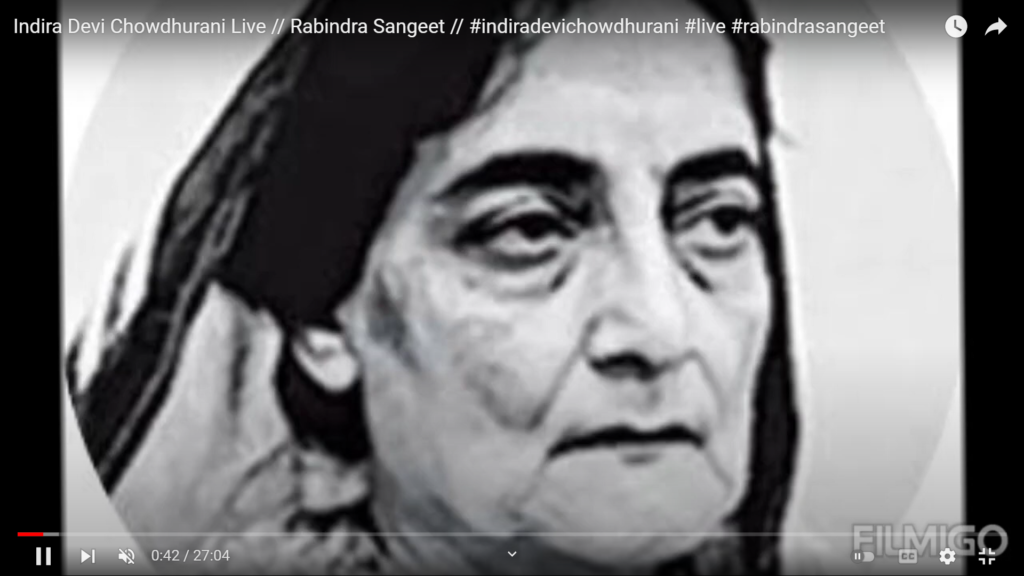
Interview of Indira Devi Chaudhurani taken in May 1960 by Kshitis Roy.
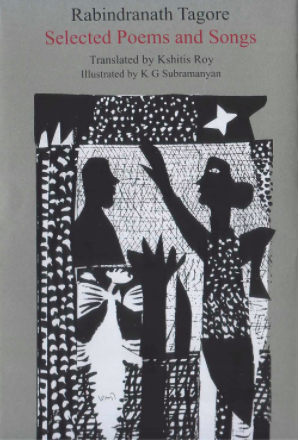
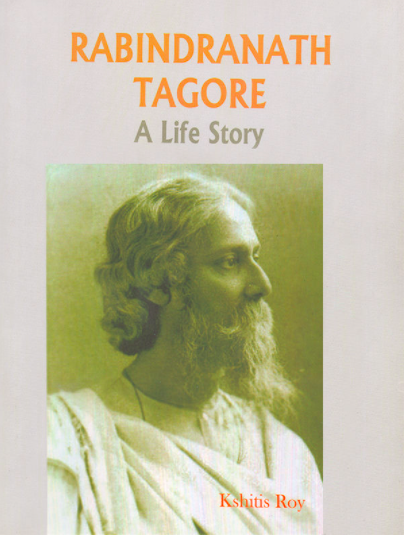
In her interview with Khitis Roy, translator and curator of the Rabindra Bhavan archives of Visva Bharati, in May 1960 in Santiniketan, on the occasion of Tagore’s centenary, which was broadcast on All India Radio, Indira Devi Choudhurani talked about many aspects of Tagore’s musical genius and the ‘universal appeal’ of many of his melodies. This interview was probably one of the last times when she talked at such length about Tagore’s songs and his creative process which she had so closely observed and of which she had also been a part, because Indira Debi passed away in August 1960, barely three months after this conversation. She was 87 at the time of this conversation and the clarity of her mind and her speech was truly remarkable. She remembered details from Tagore’s first visit to their home in Brighton in 1878, songs he used to sing and make them laugh, his wonderful tenor, the range of his musical interest and his amazing power of absorption of various influences, from the Irish melodies of Thomas Moore to Nidhubabur tappa and so much in between.
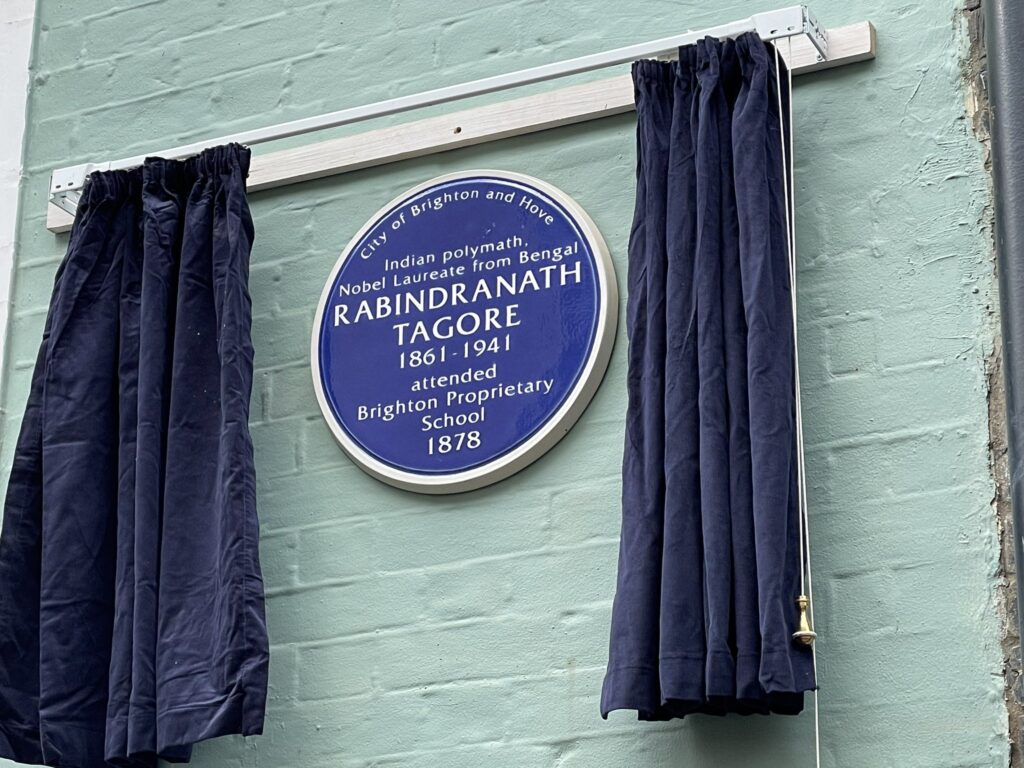
A plaque to commemorate Rabindranath Tagore’s stay in Brighton was unveiled in the city in November 2021. The plaque was the culmination of years of effort by Brighton-based social and cultural anthropologist and a specialist on Bauls of Bengal, Jeanne Openshaw. Photo: Internet
Listening to the 1960 conversation between Kshitis Roy and Indira Devi Chaudhurani, I have been reminded of the close friendship between Robika (Uncle Robi) and Bob or Bibi, as Tagore called Indira, which we have witnessed in his letters to her written between 1887 and 1895, compiled later as Chinnapatrabali (Torn Leaves).
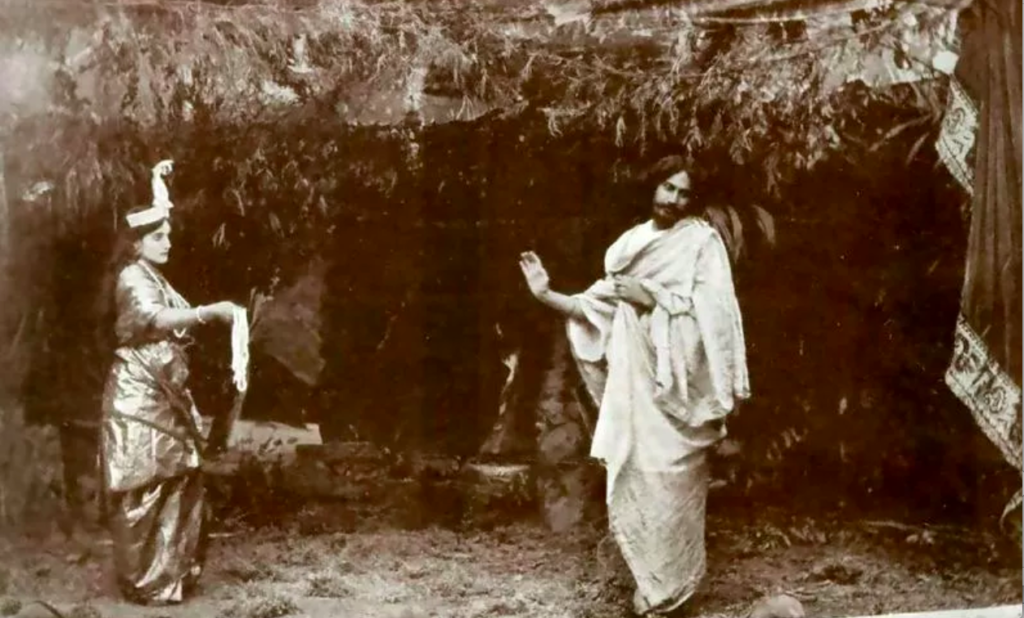
Indira Devi as Lakshmi in the 1881 play Balmiki Pratibha of Rabindranath, in which the poet/playwright played the role of Balmiki, who wrote down the ancient epic Ramayana. The photograph is probably from 1893, although internet sources put the date as 1881, when the play was first staged. Trouble is that Indira Devi was a girl of just eight in 1881 and she did not act in the play till much later. In 1881, another of Rabindranath’s nieces, Pratibha, eldest daughter of his third elder brother Hemendranath, played the part of Saraswati, while another of his nieces, Sushila, acted as Lakshmi. Interestingly, this photograph can also lead us to muse over the figure of Pratibha, who was a gifted musician and composer in her own right and who had notated many of Tagore’s songs, but who was somewhat eclipsed by other luminaries of the Tagore family.
Bake’s recording of Indira Devi’s song ‘Katobar bhebechhinu’ is beautiful. It starts with Bake prompting her with ‘korun’ or ‘ok, you may start now’ and ends with Indira Devi’s ‘thik achhe?’—’was that all right’? Supriyo Tagore told us little details of their childhood family house in Calcutta, where Indira Devi too used to live, and about the time when they came and settled in Santiniketan.
Supriyo Tagore recalls, among other things, the communal riots of 1946 in which their house in Palm Place, near Park Circus, Calcutta, was burned down. Their Calcutta house was called Lalbari or The Red House. They lived there as a joint family.
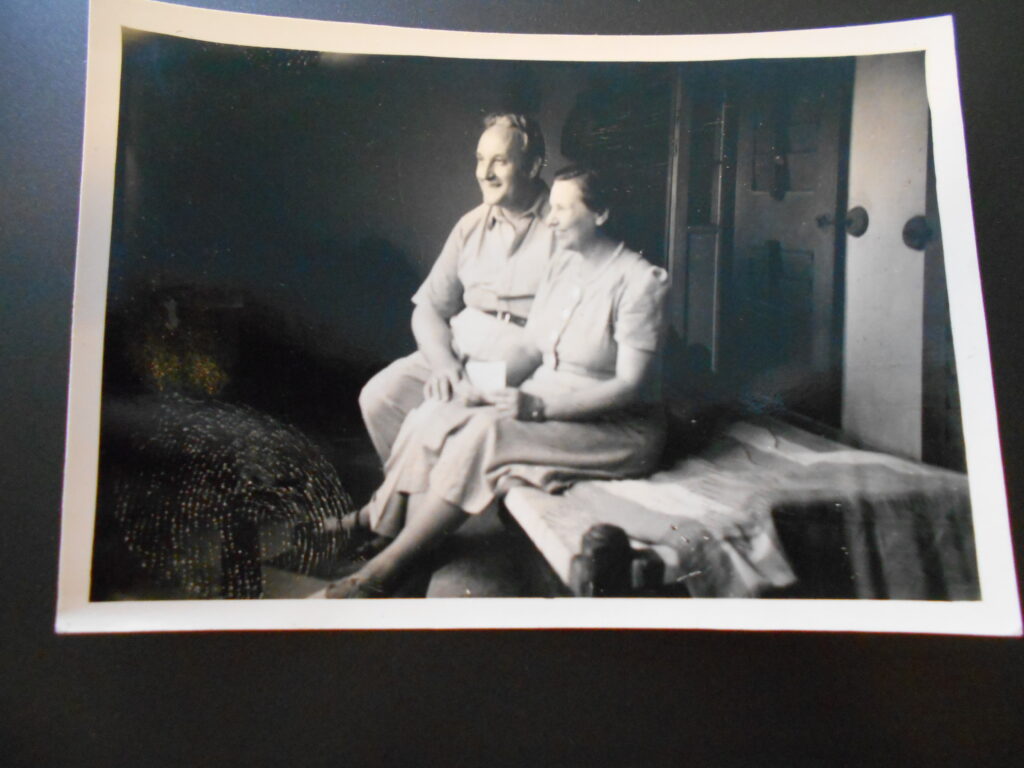
This photograph of a photograph in the Arnold Bake Collection at the Library of the University of Leiden, which I took in 2015, is possibly from the Bakes’ last visit to Santiniketan in 1956.
Supriyoda could not remember seeing the Bakes but said that it must have been in the house next to Ananda Pathshala, the nursery, which was the university quarters Indira Devi had been allotted at the time, as the interim Vice Chancellor of Visva Bharati. Interestingly, during her conversation with Kshitis Roy, Indira Devi had also mentioned the Bakes’ visit, but she had got the dates slightly mixed up and said they came in 1953. She remembered talking about the song ‘Katobar bhebechhinu’, based on the old English song ‘Drink to me only with thine eyes’, at which Bake had said, why don’t you sing it for me and I record with my tape recorder? This meeting not only gave us the recording numbered C52/NEP/71 C1, but it also led Arnold Bake to publish a comparative study of the two songs, based on Indira Devi Chaudhurani’s rendition of ‘Katobar’.
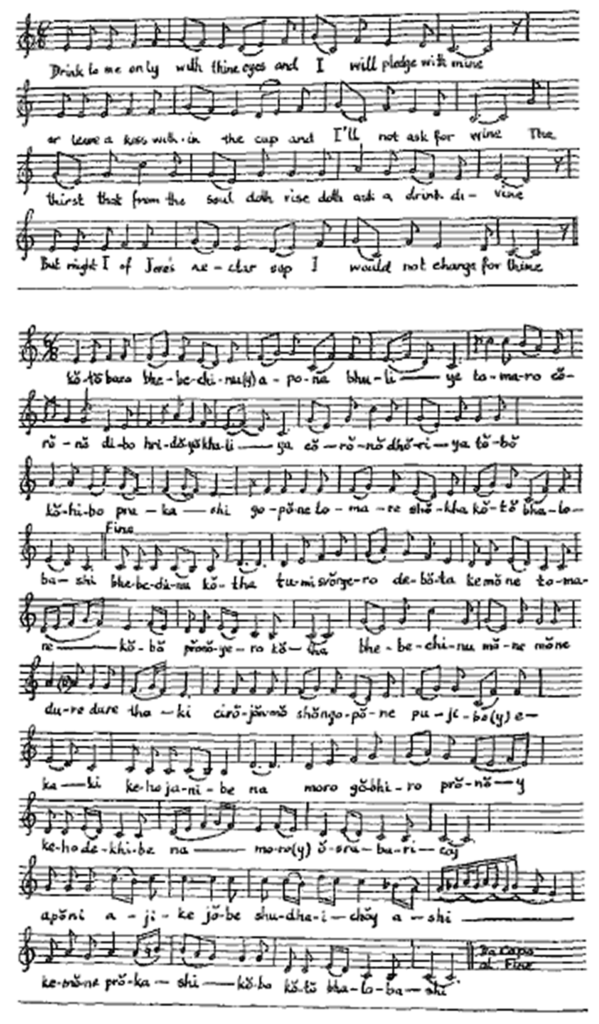
Page from Arnold Bake, ‘Tagore and Western Music’, in Rabindranath Tagore: A Centenary Volume, 1861–1961. (New Delhi: Sahitya Akademi, 1961), pp. 88–95.
The conversation with Supriyo Tagore moved from Indira Devi’s song to other questions centred on Bake’s 1956 visit and his Santiniketan friends. We looked at photos and letters. ‘Your old cook Ganapati is now with Professor Roy North at Malancha,’ Annada Sankar Ray had written to Bake. Who was Professor Roy North? I asked Supriyoda. He taught us English, he said. And Ganapati, yes, that name does ring a bell.
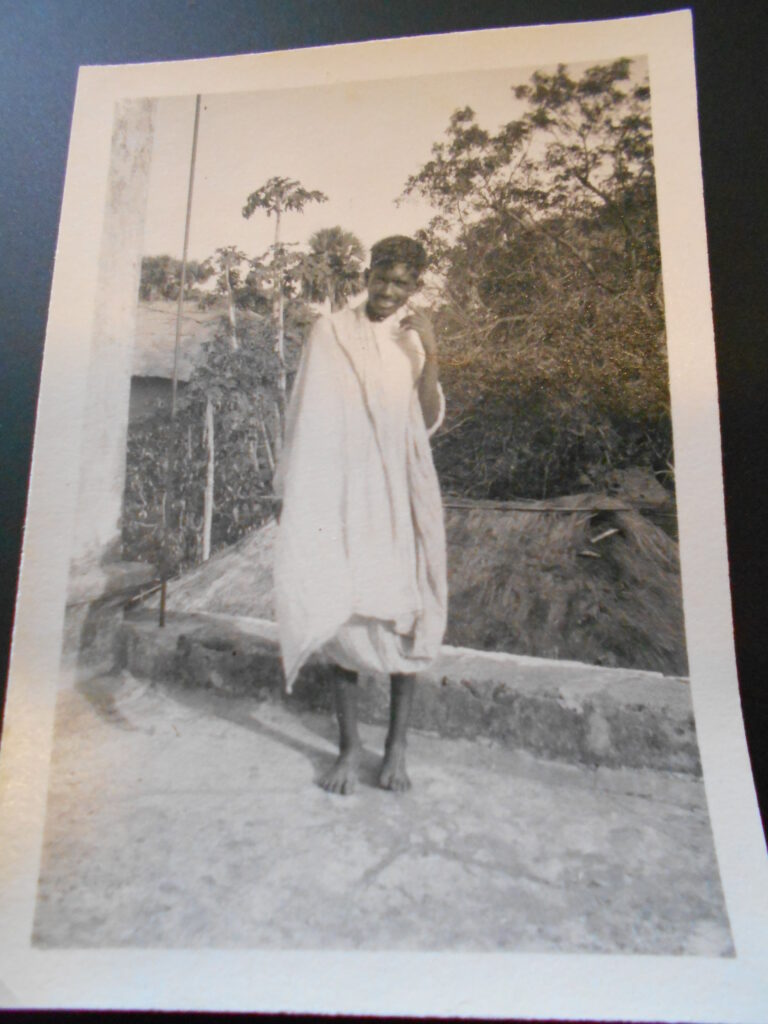
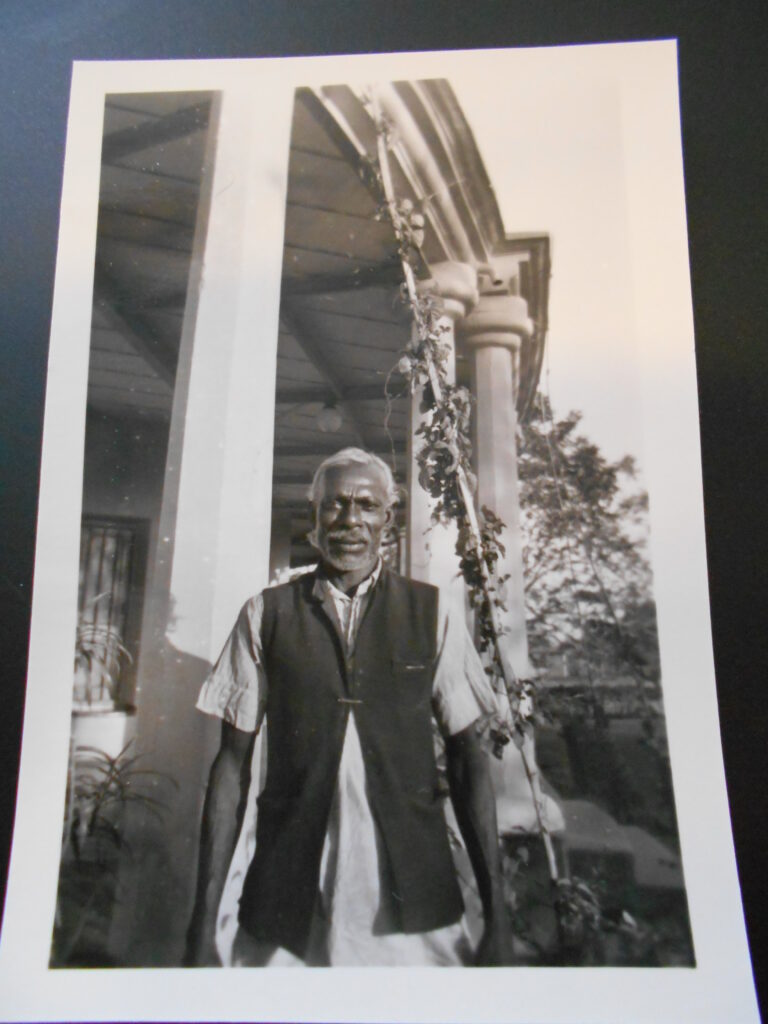
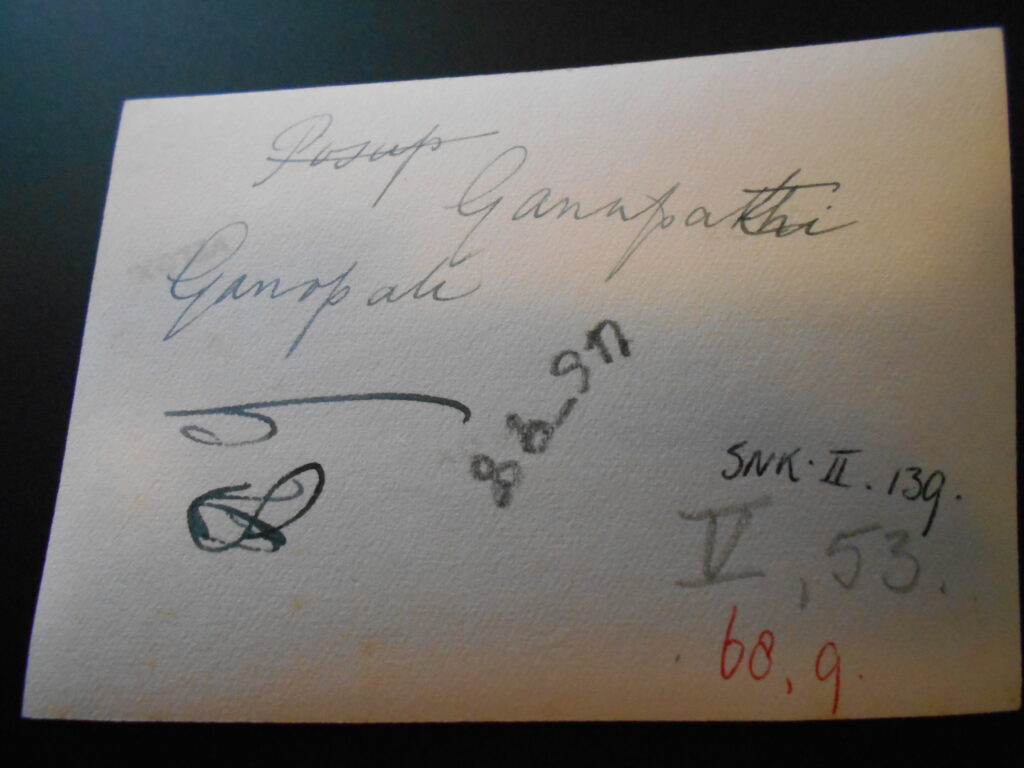
With Ganapati, Bake went back a long way. He was his companion on his trip to Mainadal in 1933. In 1931, Arnold and Cornelia Bake had gone to Pasupati and Ganapati’s village to listen to kirtan. So, in 1956 it must have made them both so happy to meet again.
On an earlier visit to Santiniketan on 19 January 2016, we had met Bithika Mukherjee, an old Santiniketan resident, whose sister was the famous Tagore singer Kanika Bandopadhyay. We had listened together to Bake’s recordings, while she had delighted us with stories of the asram in the early days. She told us how they had come to live in Santiniketan and how people came from their village in Bankura to work in the Santiniketan institution and people’s homes.
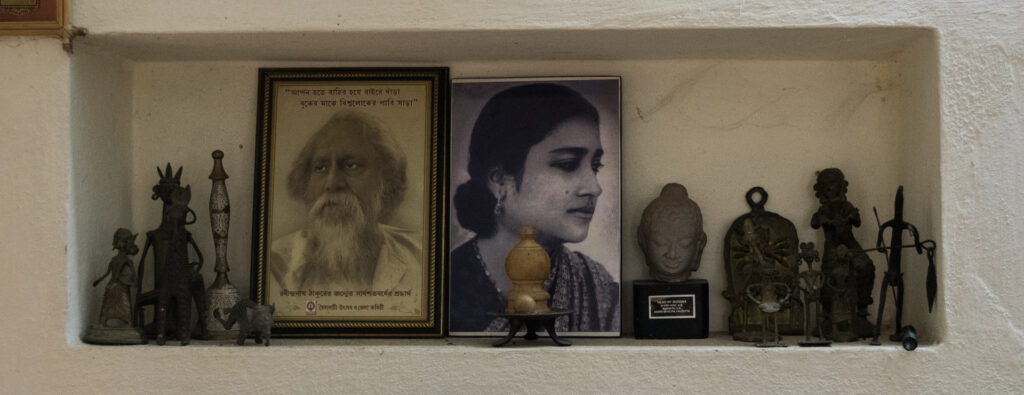
A portrait of Kanika Bandopadhyay (1924-2000), or Mohor as she was more popularly known, on the shelf in her sister Bithika Mukherjee’s living room.
We began by listening to Indira Devi’s recording with Bithika Mukherjee and her son Priyam, who is also a Tagore singer and researcher.
There was my Dutch friend and translator, Jan Sijmen Zwarts, who was with us on this day and he too joined the discussion on the Indira Devi recording.
Through our conversations with Bithika and Priyam Mukherjee on the one hand, and with Supriyo and Shubhra Tagore, on the other, a layered picture of Santiniketan in the early years was unfolding. It is interesting I think to listen to these many voices talking about the same place and the same time, told from a range of perspectives, in conjunction with and in opposition to one another. What we see in/of a place depends so much on who we are and where we come from and where we are placed in the place.
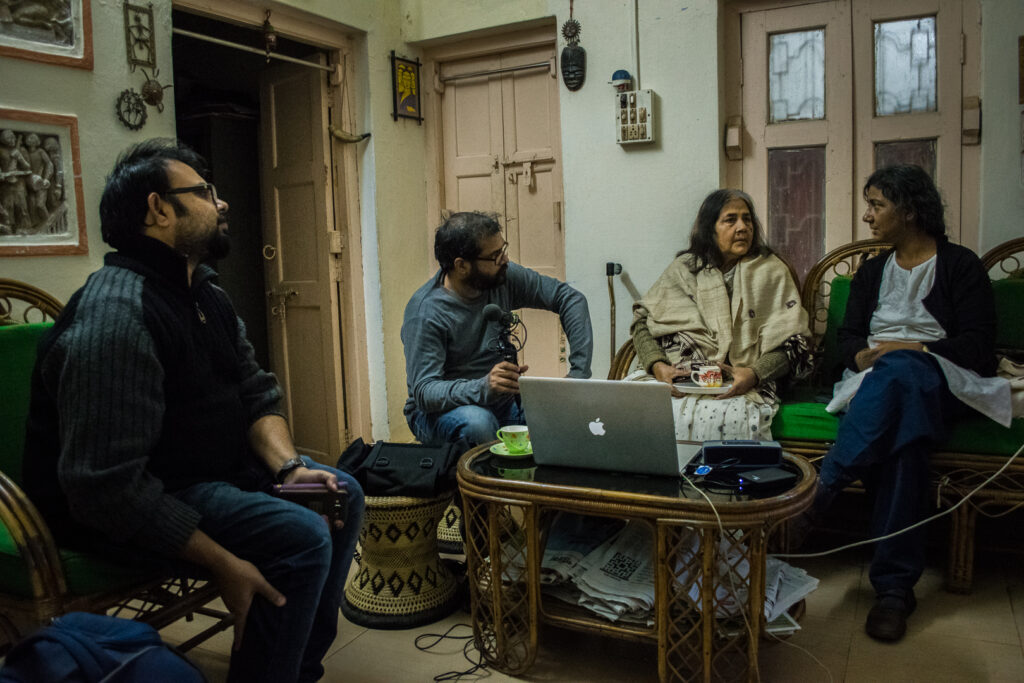
In Bithika Mukherjee’s home, 19 January 2016. From left to right, Priyam Mukherjee, Sukanta Majumdar, Bithika Mukherjee and Moushumi Bhowmik. Photo: Jan-Sijmen Zwarts.
With Bithika and Priyam Mukherjee, we listened to several of Bake’s recordings, including Savitri Govind’s. Priyam said, Indira Devi had written in her notes about some troubles in Savitri’s life which had forced her to leave Santiniketan.
I asked Supriyoda if he had been taught by Kshitimohan Sen. And he told us a beautiful story about Kshitimohan in his late age, possibly the same time when Bake was coming to Santiniketan for the last time, when he had gone to him to learn some Sanskrit sloka to recite at a ceremony. Then, on the actual day of the performance, Kshitimohan, who was infirm at the time, had insisted on coming to the celebration. So, he was brought in. Then, as Supriyoda was reciting the sloka, he heard the voice of Kshitimohan; the master had joined him in the recitation!
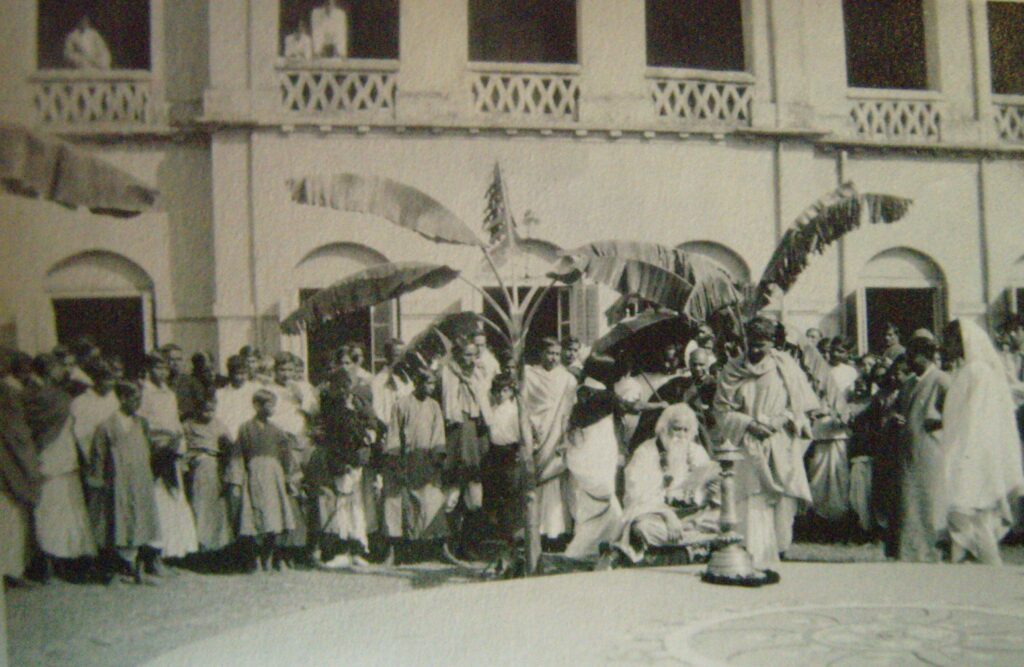
This photograph was taken by Arnold Bake, possibly in the late 1920s. Could this be one of Tagore’s birthday celebrations? The place and the occasion were not clear to anyone who saw this, perhaps it was Sriniketan, the old Kuthibari perhaps–there were many opinions. However, standing to the left of the poet is Kshitimohan Sen, who was always there to recite Sanskrit slokas at every auspicious occasion. I took this photo of the original photo while working in the Arnold Bake archives at the library of Leiden University in 2015.
Talking about festivals and ceremonies, Bithika Mukherjee had told us how they celebrated Basantotsav, what flowers they made garlands with and how totally unostentatious everything was when they were small. She talked about how people dressed in those days, what floral ornaments they made, how the girls decked their hair, what saris they bought and how simple life was in the asram. People were content with whatever they had, she said. She talked about Gurudayal Mallik and Laksmisvar Sinha and how down to earth they were. The land too was plain and barren and that itself was its beauty, she said.
Bithika was married to Naba Kumar Mukherjee (1930-2015), an agro-economist and senior faculty of the Sriniketan Rural Reconstruction department of Visva Bharati, who later founded the Elmhirst Institute of Community Studies. She had spent many years in Sriniketan and on 19 January 2015 she talked candidly about the difference between Santiniketan and Sriniketan as she felt it; about the warmth and intimacy of Sriniketan and its hands-on approach to life as opposed to the art and artifice of Santiniketan. She had once been part of a mission to Dartington Hall in Devon, the institute Leonard Elmhirst had set up on the model of Rabindranath’s Visva Bharati. Interestingly, during our conversation two days later with Supriyo and Shubhra Tagore, they too had talked about visiting Dartington Hall.
Bithika Mukherjee talks about Sriniketan and Santiniketan
Bithika Mukherjee talks about visiting Dartington
Shubhra and Supriyo Tagore talk about visiting Dartington Hall and being taken by Elmhirst to the top a hill overlooking the meadows. Apparently, it was here that Dorothy and Leonard Elmhirst had brought Gurudev and asked, Will this do, Gurudev? Tagore surveyed the land and said, it will.
The excitement Supriyo Tagore showed upon seeing the photos of his aunts Jaya and Monju was similar to his excitement at listening to the recording of Indira Devi.
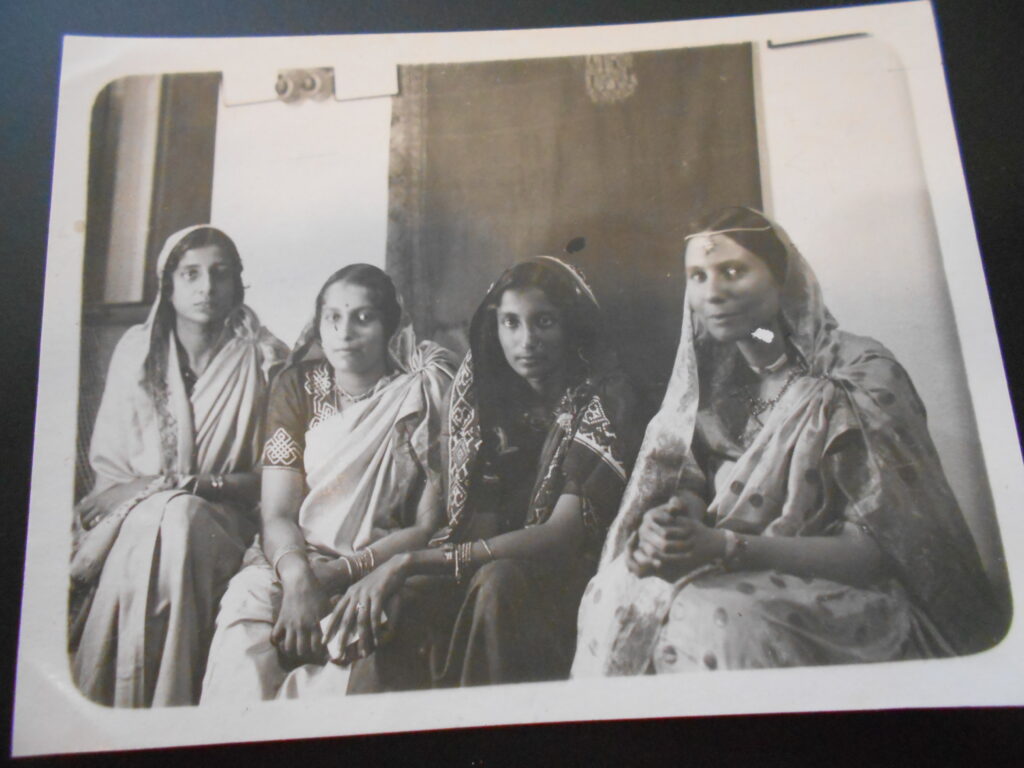
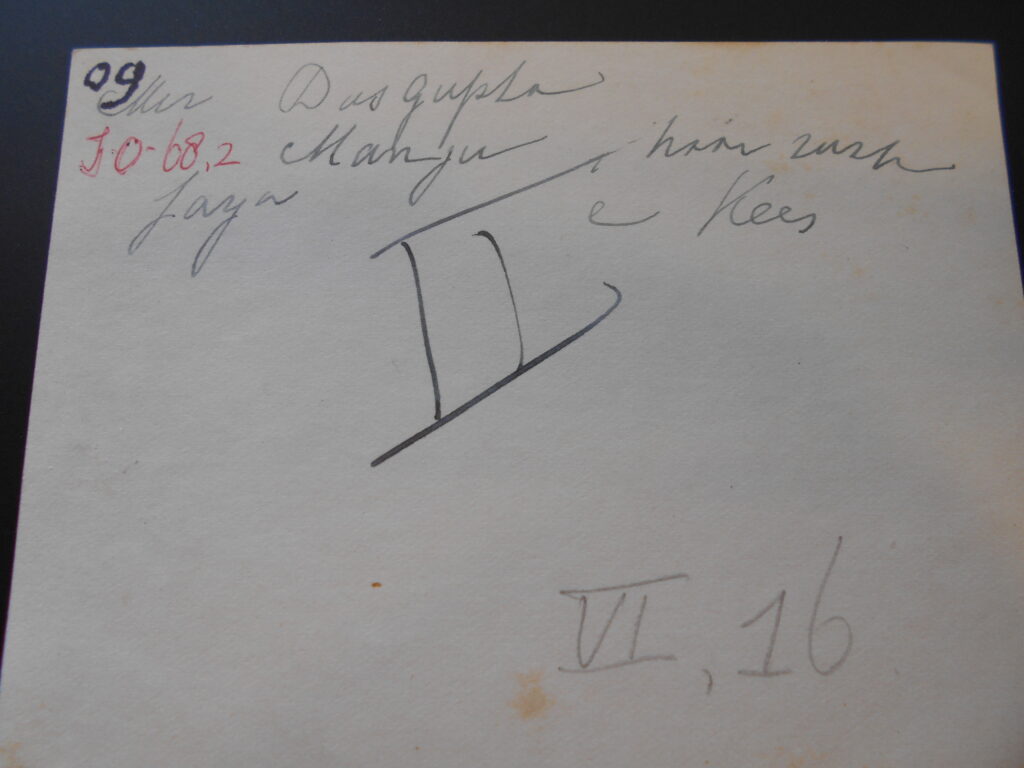
Photo of photos from the Arnold Bake Collection, Special Collections, Library of the University of Leiden, 2015.
What kind of a person was Pratima Devi, wife of Rathindranath, daughter-in-law of Rabindranath? Supriyo and Shubhra Tagore’s answer shows how much of a clan the Tagore family was, how everyone was related to everyone and how in the end they were a world unto themselves.
Supriyo Tagore listened to Bake’s Pathe records of Rabindrasangit and was most pleasantly surprised. As he listened to Megher pore megh, he kept saying, There, see! He is missing the nuances of the tappa! How was Indira Devi as a person? Independent and active till the end? I asked him. He said, yes, that is how she was. Supriyoda also listened to the Chitralekha Chaudhury recording of Arnold Bake. She was my classmate, he said. Then he said how there used to be some competition among the girls for who would get the Dinendra Prize for best singer—Chitralekha, his sister Supurna, and Manju were the contestants. One would win and the others would cry, he said, and we laughed.
Supriyo Tagore listens to Bake’s Rabindrasangit
Supriyo Tagore talks about Indira Devi
Supriyo Tagore on Chitralekha Chaudhury
Postcript
In 2019, I was in Totnes, Devon, for some work with the photographer, Mohini Chandra . And we went walking along the Dart river towards Dartington Hall and these recordings of Arnold Bake, and the photographs and my own conversations with various people from some years ago were playing in my head. Will this do, Gurudev? Leonard Elmhirst is said to have asked the poet. I looked at the vast empty spaces, the beautiful green. I thought how Santiniketan used to be an open empty space once, arid and beautiful.
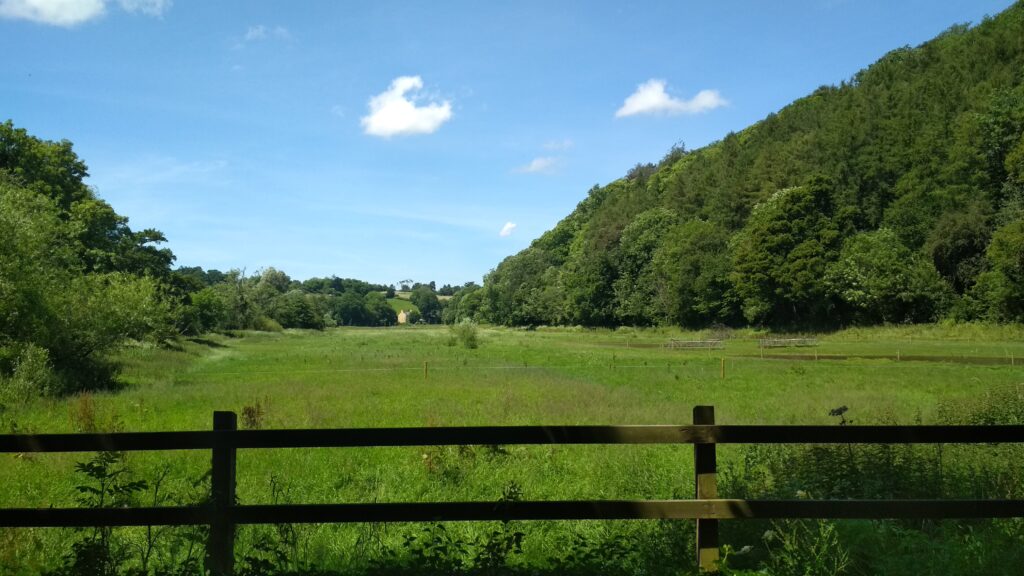
Fayazullah (stoker) from Damrasari, Hirpur Bazar, Sylhet became a story about a lost place and a found song. Looking for Damrasari, I went from place to place, met a curious bunch of people, almost reached the Indian border at Tamabil and recorded song and dance I wasn’t at all expecting to find.
Out of the 15 cylinders on which Arnold Bake recorded the sailors on board the Streefkerk between 1 and 15 April 1934, five (nos. 343, 347, 348, 349 and 350) were of Fayazullah. Out of these five songs I was drawn to two in particular–cylinder no. 343 entitled ‘Shey dukh’ and cylinder 348, ‘O pran nath’. Something seemed very familiar to me, something I could hear under the noise of those cylinders, in the skidding, and in the undecipherable words of the songs. And then as I kept listening, I knew what the reason for this attraction was. The style of singing was so much like that of Ranen Roychowdhury of Ritwik Ghatak’s films.
This then was perhaps what Ranen Roychowdhury used to hear? This was perhaps the kind of person whose company he used to keep in the shrine of Shah Jalal, and from whom he learned many songs?
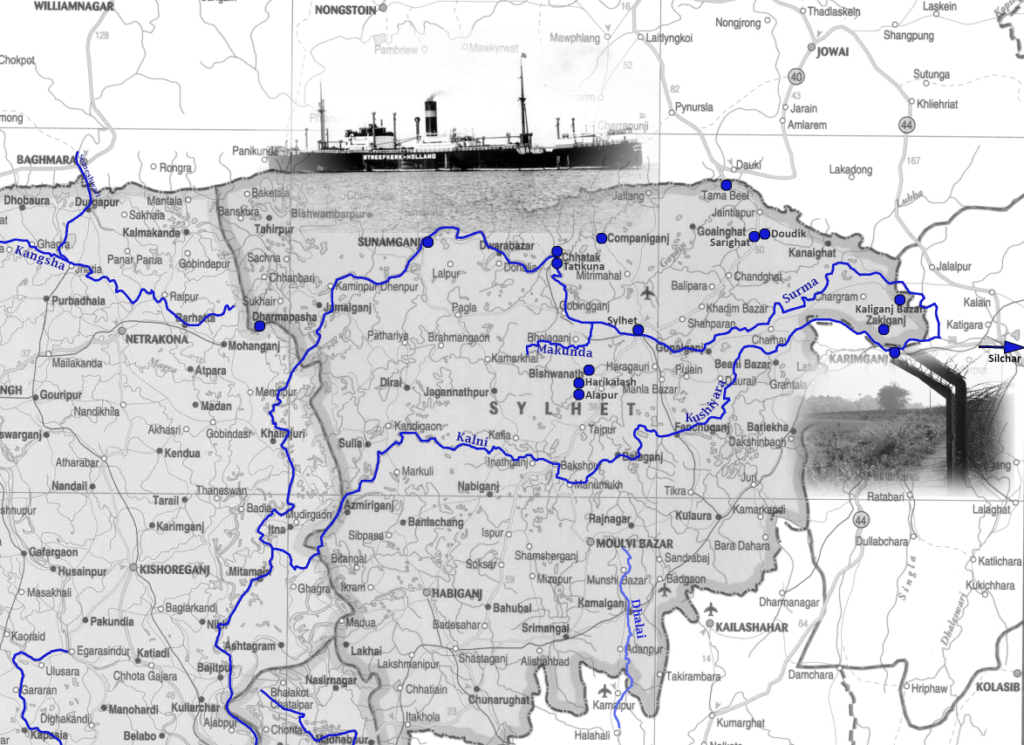
Some said, maybe Fayazullah was from Dharmapasha. But why would Bake write Damrasari for Dharmapasha? So, we went in the opposite direction, following clues from the place-names in the archival note. Map by Purba Rudra.
On 15 January 2018, I went with my long-time friend and guide in Sylhet, Ambarish Datta, to meet the 90-year-old Sushoma Das, whom we first met in 2006 and have been recording since. Sushoma ‘Mashima’ as we call her, mashima meaning aunt, holds a very special place in the life of The Travelling Archive and I personally see her as a repository of the deepest and most profound knowledge of the music of her region; a living archive of songs. We will talk about this particular meeting with Sushoma Mashima in another sub-chapter , but what we are talking about here is the journey Ambarishda and I made three days later, on 18 January 2018 in search of Fayazullah’s village.
Damrasari did not immediately suggest any place to my friends, but since Sari is the name of a river and there is a place by the name of Sarighat on the way from Sylhet town to the Tamabil border with India and since there is a Haripur on the way, which is soundwise close enough to Hirpur, we decided to go and look around there.
Ambarishda used to work as a banker when I first met him in 2006, all ‘suited and booted’ as we say in Bangla. But, since he left his job, he has let go of his attire and many old habits and has taken to growing things in a small plot of land, while cultivating the poetry and song which is part of his inheritance and rests in his soul (he used to be into theatre in his youth and his father, as we know, was a kirtan singer. On our way to Haripur, we stopped in his garden in Noagaon, which is near the dargah of Shah Poran.
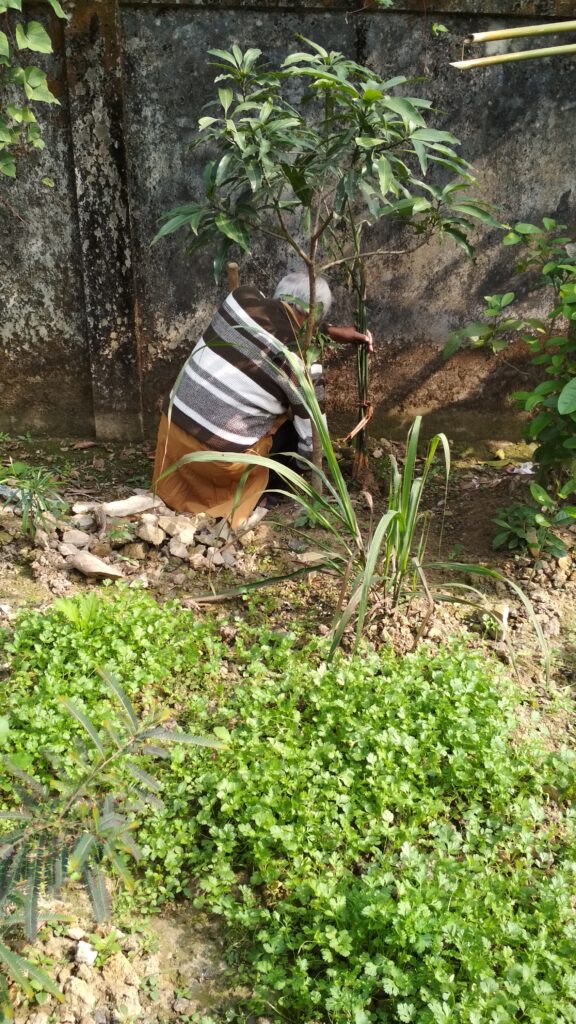
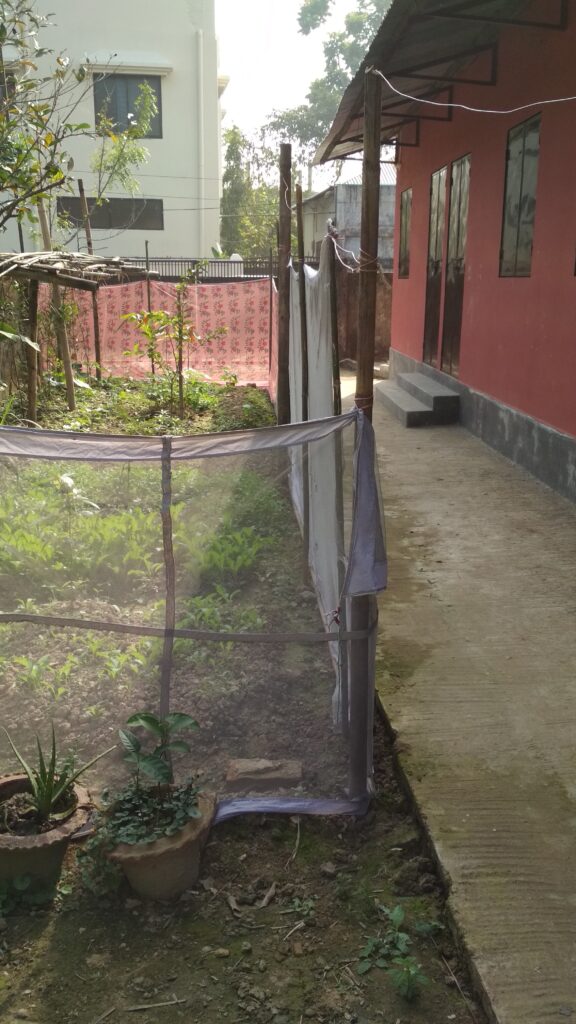
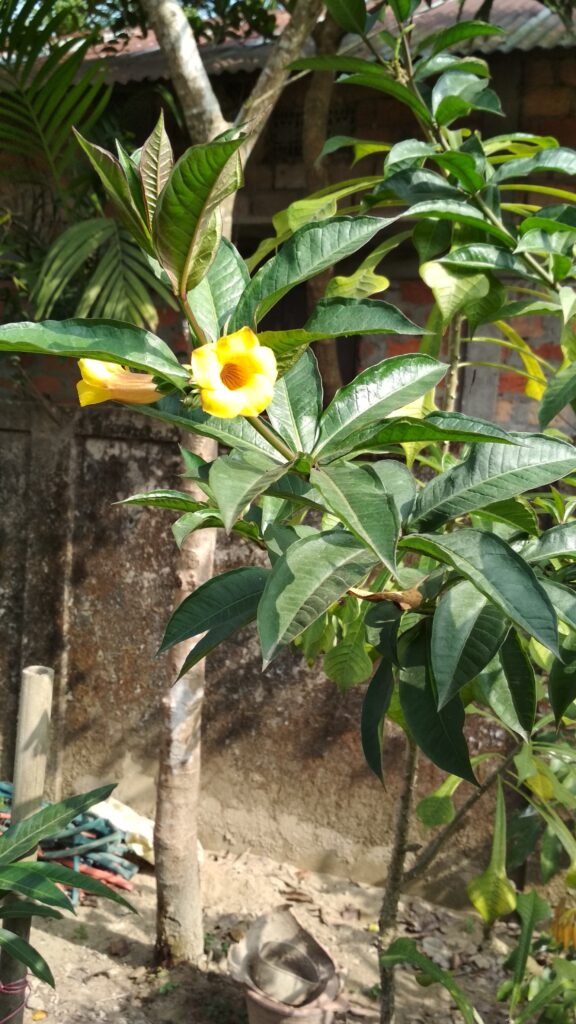
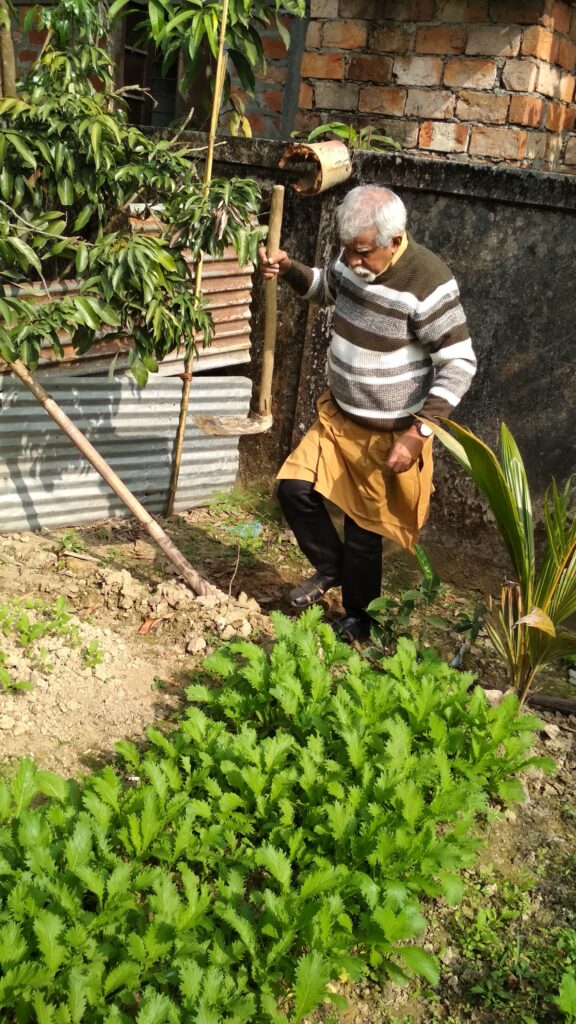
Ambarishda’s garden, 18 January 2018. Photo: Moushumi
In Haripur Bazar, we stopped to ask people about Damrasari but no one could say anything. A man by the name of Azad Miah got interested in our story and got into our three-wheeler and joined our search. From this point it is Azad bhai who took the initiative to explain to people the story of Fayazullah’s song.
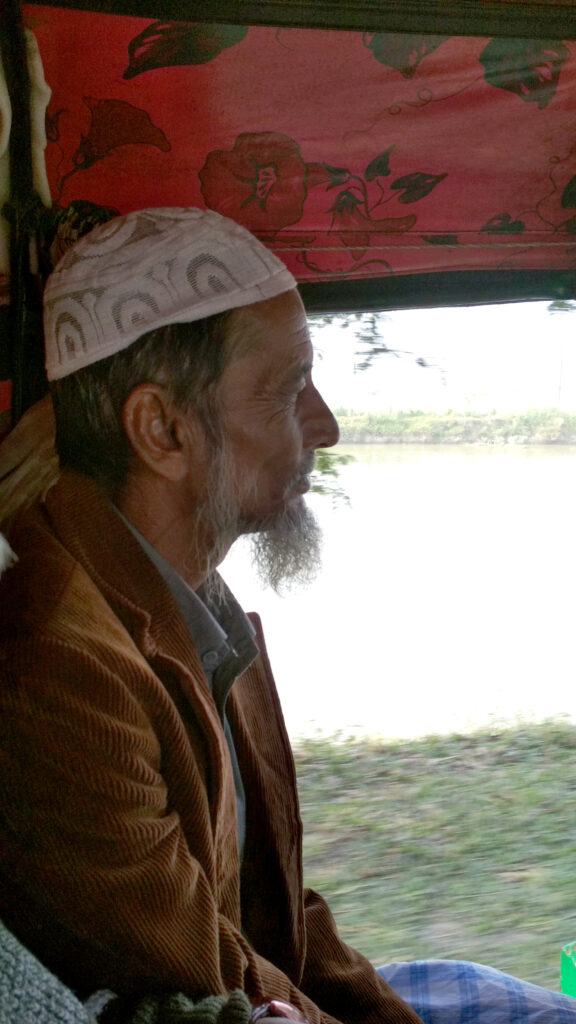
Azad Miah joins the search party. Photo: Moushumi
We stopped at Sarighat and went to a tea shop by the river and while Ambarishda and Azad Miah did the talking, I took some photos.
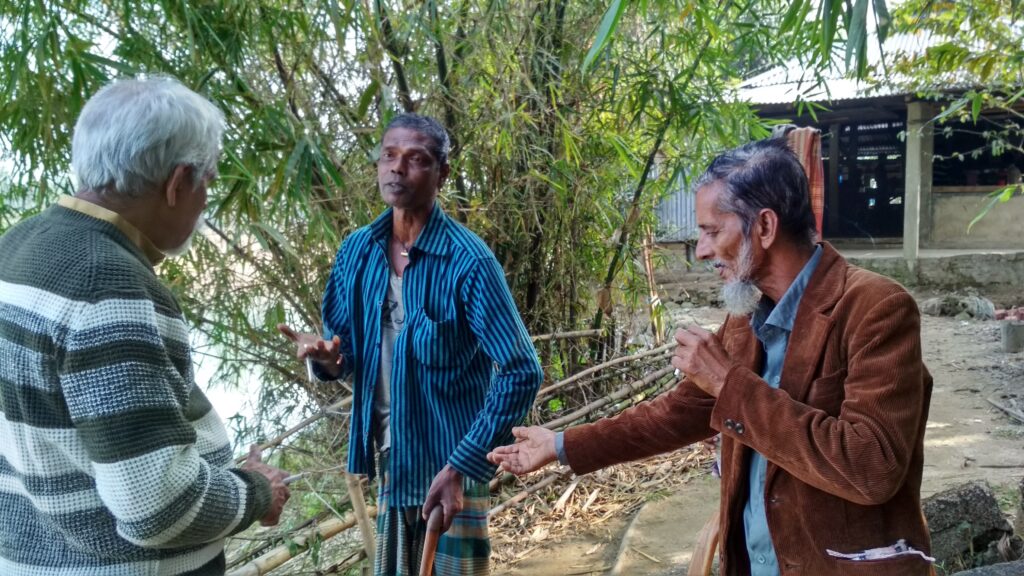
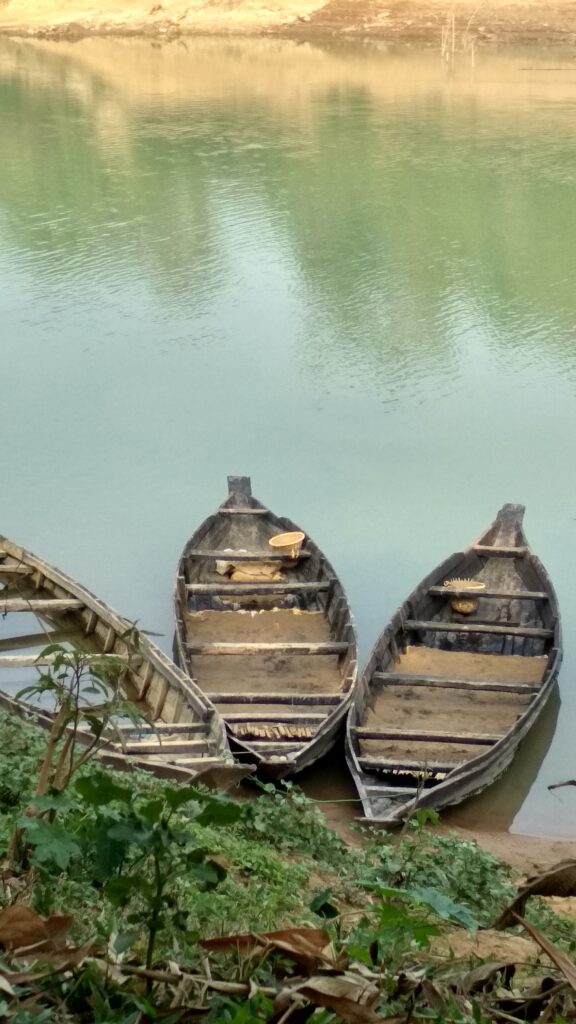
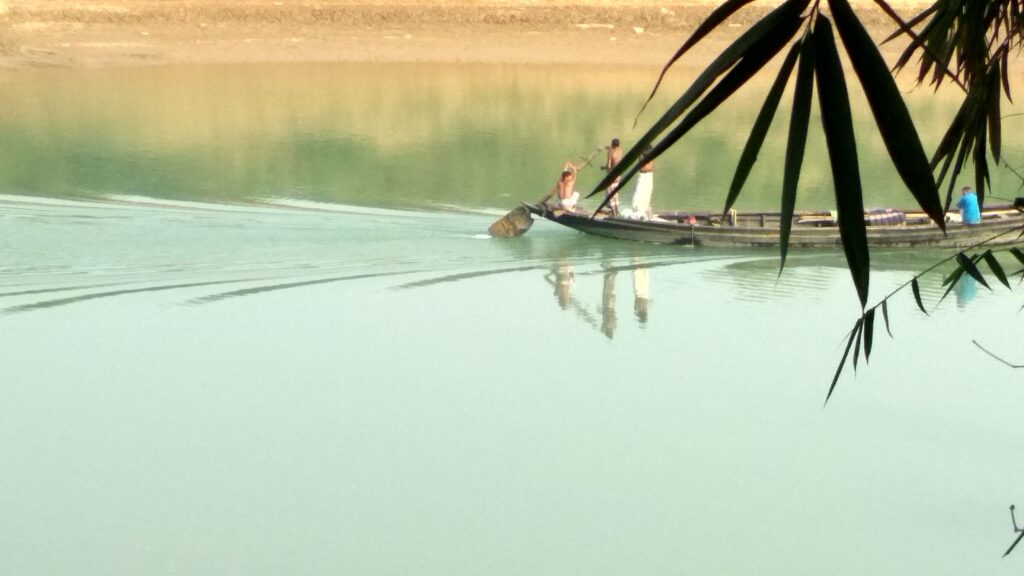
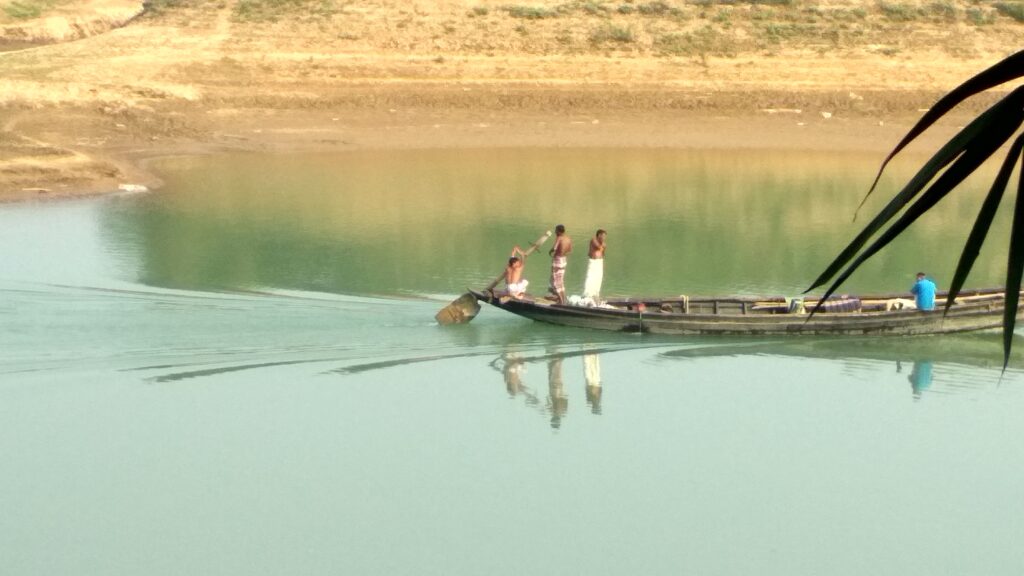
People said, if we went further down the road, we were likely to find houses of old jahajis or seamen. Not much of a lead, but we carried on going. Then we reached where there were ruins of the old Jaintia kingdom in the middle of the road; here the road turned right towards Doudik village.
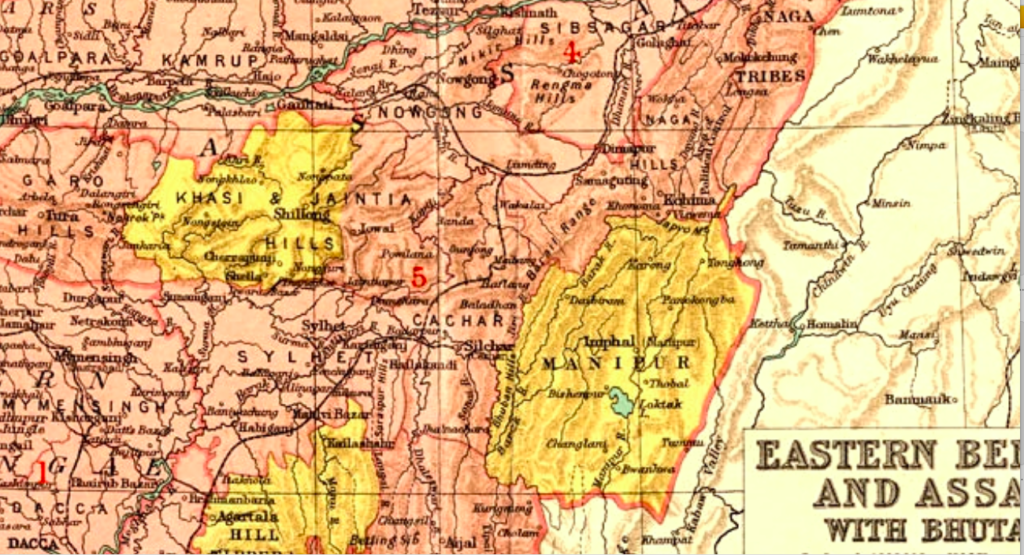
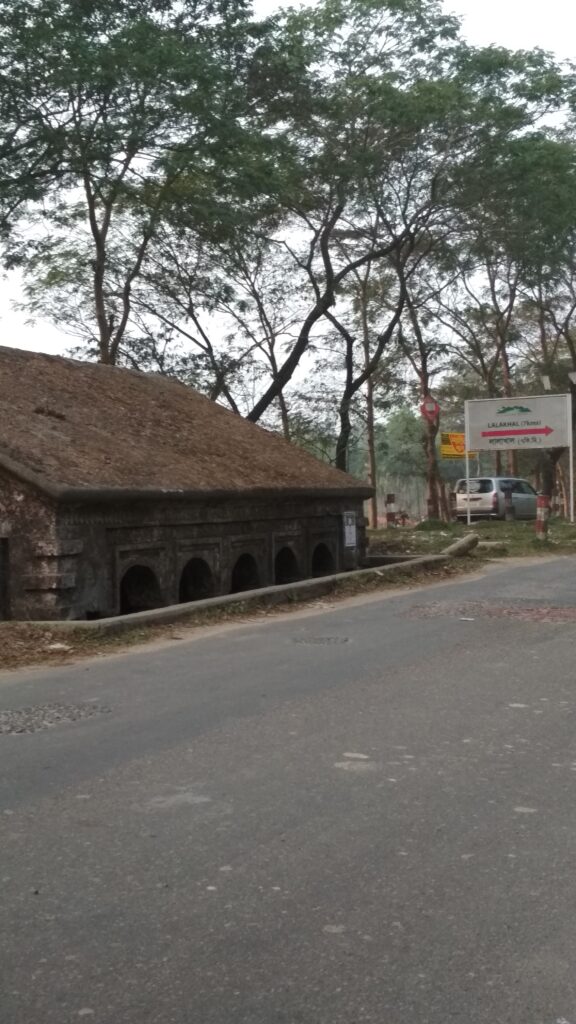
Left: Section of map of the Khasi and Jaintia Hills from the Bengal Gazetteer, 1907. Source: Internet. Right: Jaintia monument, said to be the Inn of Princess Irawati. Photo: Moushumi, 2018.
There was a grocery there, where we asked the shop-owner the same question that we had been asking everyone else: Do you know of a place called Damrasari? Do you know where old families of seamen from about a hundred years might live? Was there a Hirpur around here? The man at the shop had no clue.
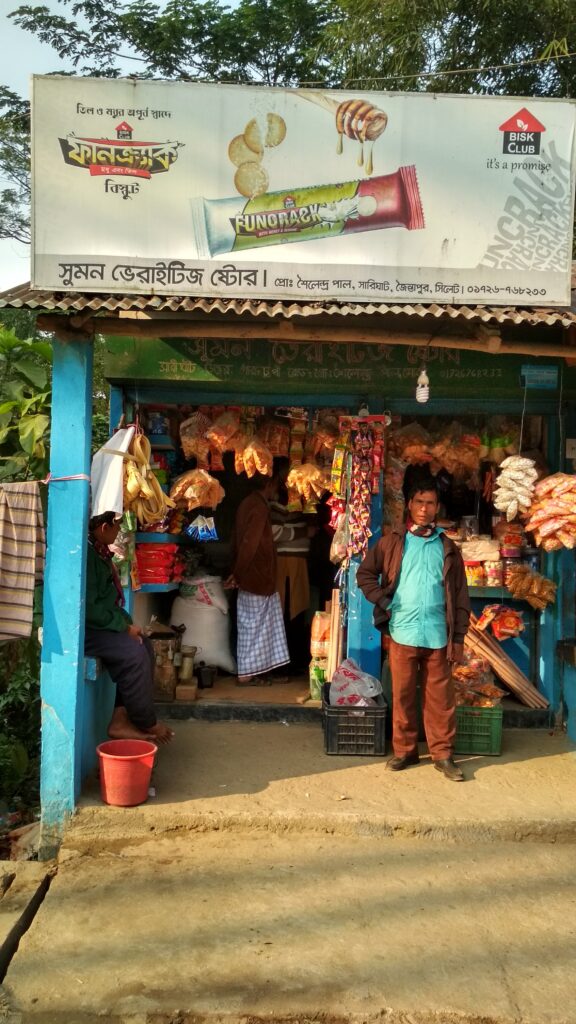
Suman Variety Store, Sarighat, Jaintapur, Sylhet. Proprietor: Shailendra Pal. Photo: Moushumi, 2018.
As I was trying to revise my memory of that afternoon, I sent some photos to Ambarishda and asked for details. He wrote back to say, আমরা যেখানে দাঁড়িয়েছিলাম এর ডান দিকে বাম দিকে উভয়দিকেই ডৌডিক। Doudik was on both sides of where we were standing, left and right. We were following Azad Miah’s directions and looking for Dharma village. The river was the Sari-Goain, but usually called the Sari. The monument in the middle of the road used to be a gate of the Jaintia kingdom and an inn. A few kilometres from there was the capital of the Jaintia kingdom. The Tamabil border would be 15 or 20 km down the road. There was an earthquake in 1897 which destroyed the old Rameswar temple of the kingdom, but a few years ago there were heavy rains and some old archaeological remains surfaced, which are now in the care of the government. We bought satkora lemons from Haripur Bazar. আমরা আসলে ধর্ম গ্রাম খুঁজছিলাম। আজাদ মিয়ার কথায় ঐদিকে কোনো সন্ধান পাওয়া যায় কিনা তাই গিয়েছিলাম। নদীর নাম সারি-গোয়াইন নদী। ঐ এলাকায় সারি নামেই অধিক পরিচিত। আমরা সারিঘাট গিয়েছিলাম। রাস্তার উপরে যে ঘর ওটা ঘর নয়, জৈন্তা নগর তোরণ। কয়েক কিলো সামনেই জৈন্তা নগর রাজ্যের রাজধানী। আর তামাবিল আরো পনেরো কুড়ি কিলো সামনে এগুলে। যে রাস্তা ধরে ডৌডিকে গেলাম চা নাস্তা খেয়ে মানে সুমন ভেরাইটি স্টোর যেখানে, ওখানে টিলার উপরর ছিল জৈন্তিয়া রাজার প্রতিষ্টিত রামেশ্বর শিব মন্দির। আর আরেকটু সামনে এগুলে অন্য টিলার উপরে ছিল ঢুপির মঠ। ১৮৯৭ সালের ভূমিকম্পে ধ্বংস হয়ে যায়। বছর কয়েক আগেও প্রবল বৃষ্টিপাতে মাটি ধসে পড়লে বেশ কিছু প্রত্ন নিদর্শন জলস্রোতে বেরিয়ে আসে। সরকারি হেফাজতে চলে গেছে। সাতকরা লেবু হরিপুর বাজার থেকে কিনেছিলাম। রাস্তার উপরে ওটা ছিল নগর তোরণ ও পান্থশালা। জৈন্তিয়া গেট নতুন নামকরণ। (From Whatsapp message sent to Moushumi on 26 January 2022)
So far finding Fayazullah or his village is concerned, there is not much more that happened that day. Yet there is a post-script to our story of sounds from Fayazullah’s unfound village. It goes thus. As we were standing in front of Suman variety stores, I saw a bunch of schoolgirls in full niqab walking in haste down the road, and two young men in a bicycle following, seemingly keeping a watch on them. They saw me watching the girls, taking a photo with my phone, and they did not seem to like it; at least that is how I felt. Azadbhai said these parts were becoming increasingly orthodox Wahabi. That got me thinking. I thought, even if Fayazullah went to sea from these parts, if we were to find him today, perhaps he would be under pressure not to sing his Sufi songs, such as we had seen with Ibrahim Boyati in 2013.
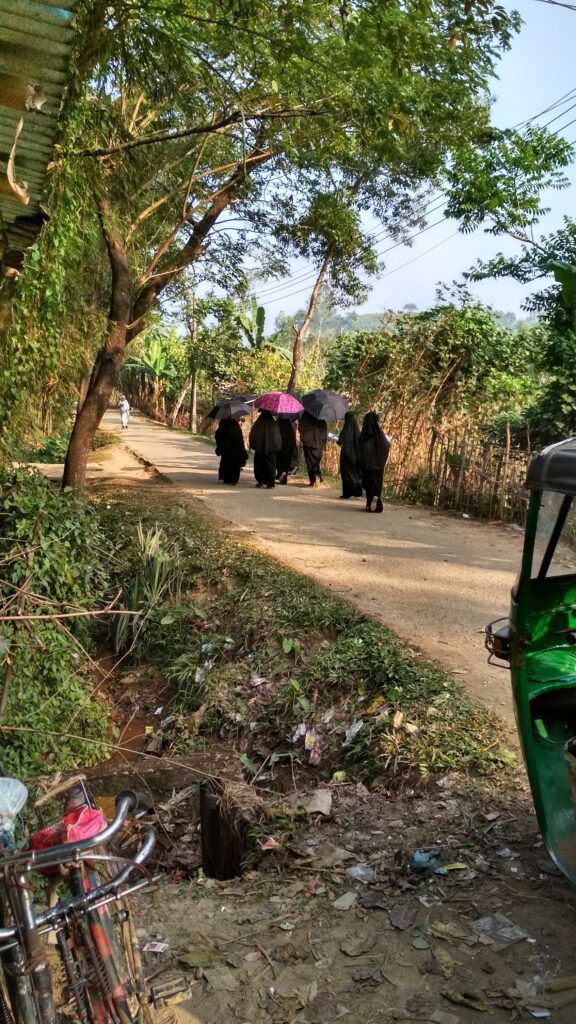
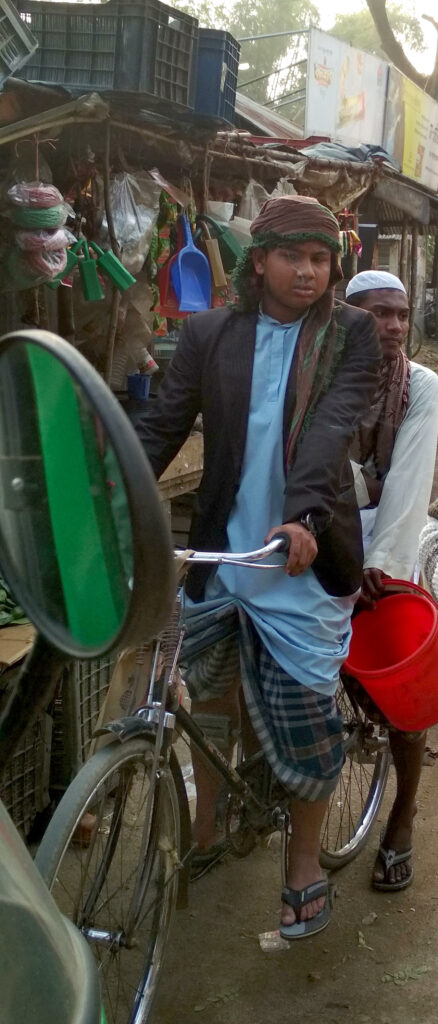
This was January and the sun was most pleasant. Yet the girls were carrying umbrellas, as if to make invisible whatever could still be seen. Perhaps I was reacting from my position as a woman, with my own ideas of freedom and bondage. Perhaps the girls did not feel the pressure that I was feeling. Photo: Moushumi, 2018
We started to walk in the direction of Doudik village, someone suggested we look for a man named Moyna babu, who could know something. But the man was not to be found; we found his house but learned that he had gone to Sylhet that day.
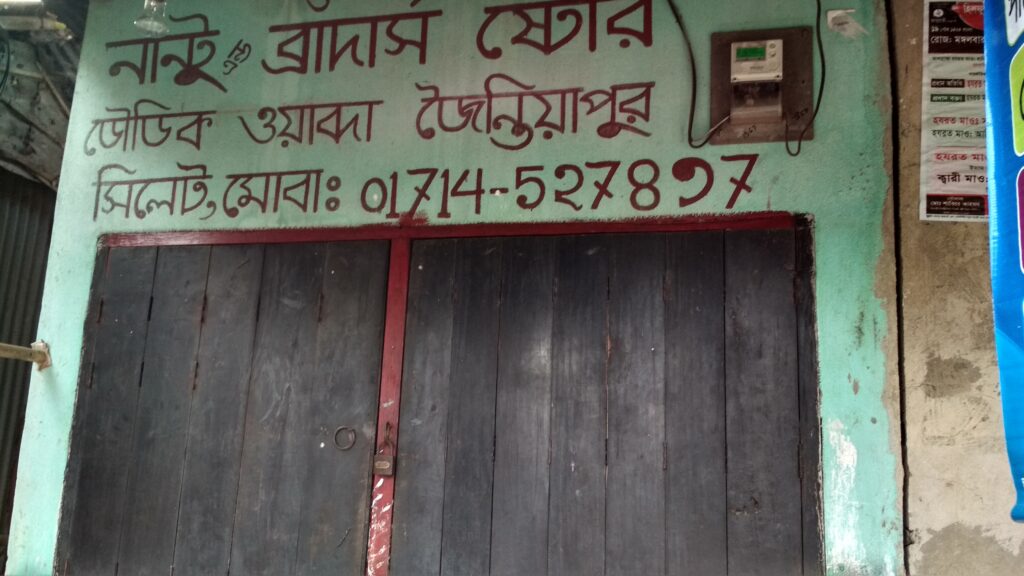
Nantu and Brothers Store, Doudik, Jaintiapur, was closed at the time of our visit. There was a mobile number to contact the shop-owner. Photo: Moushumi, 2018
We found however a house full of women. The courtyard was decorated with alpona, or auspicious patterns drawn on the floor with rice paste. This was a Hindu household. The ever-friendly Ambarishda got talking with the women. They were busy, some taking utensils to clean at the hand pump, some tending to their children. Ambarishda convinced them that there should be some singing and dancing; I added my request to his, as did Azad Miah. There was one elderly man, he said his name was Parindra Namo. The women were Sitarani Namo, Anjali Rani Biswas, Kajoli Rani Biswas, Dipali and others. So, this was a Namasudra village. The women were not at all shy and seemed quite eager to sing. They said, if you come back on Sunday, we will sing more properly that day. Then they left whatever work they were doing and brought their songbook and sang and danced around the alpona. They sang about Lord Krishna’s childhood, and their voices reminded me of the Janmashtami songs that Sudheer Palsane and I had recorded during a field trip in Cachar on the other side of the border, all the way back in 2005.
I love this recording for all the layers of sound it holds. The laughter of children, the sound of the clatter of utensils, of drawing water from the hand pump and then probably a loudspeaker in a village mosque, behind the foregrounded women’s chorus singing of Lord Sri Krishna, with one strong voice providing lead. Recorded on my Zoom H4N recorder.
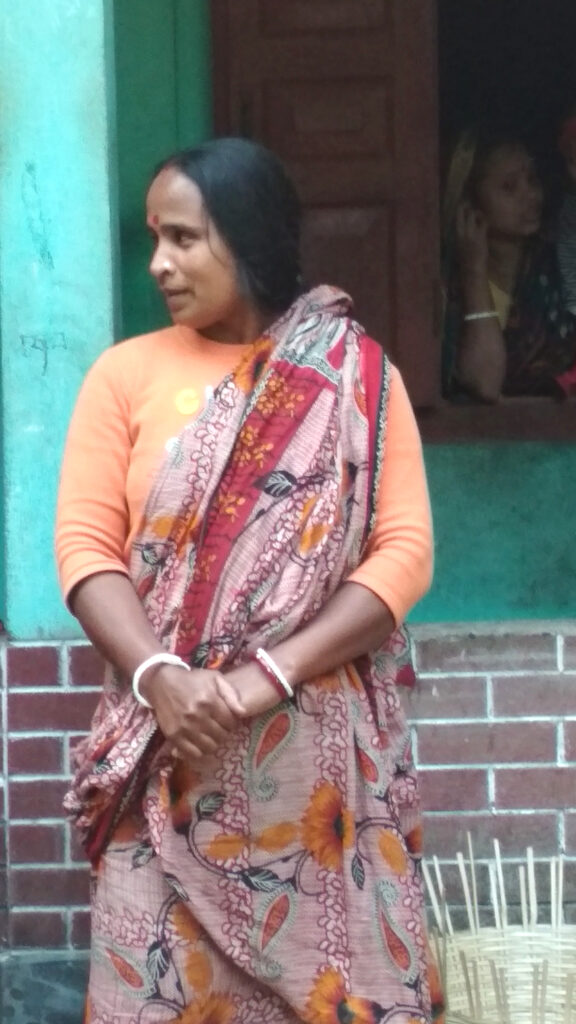
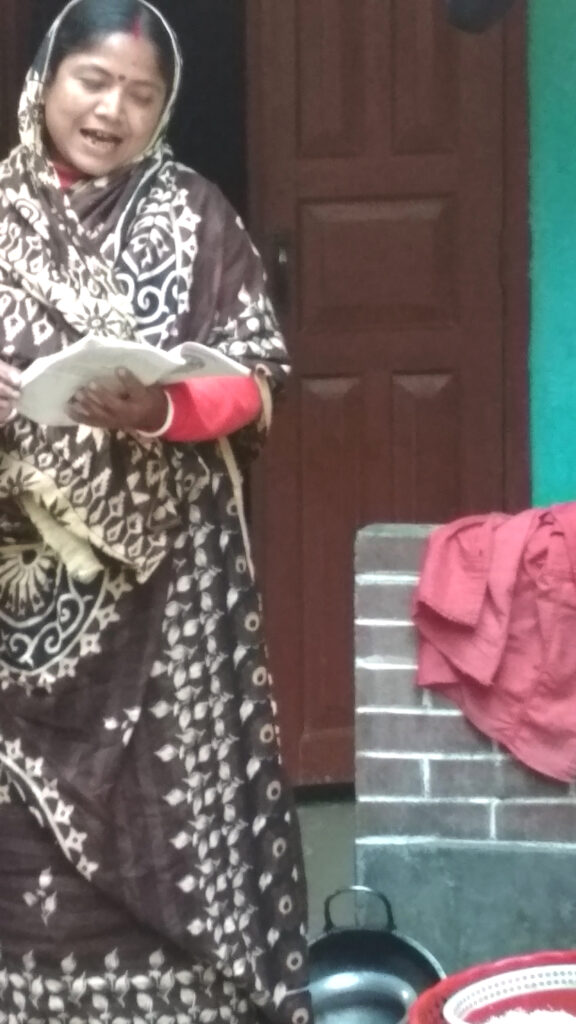

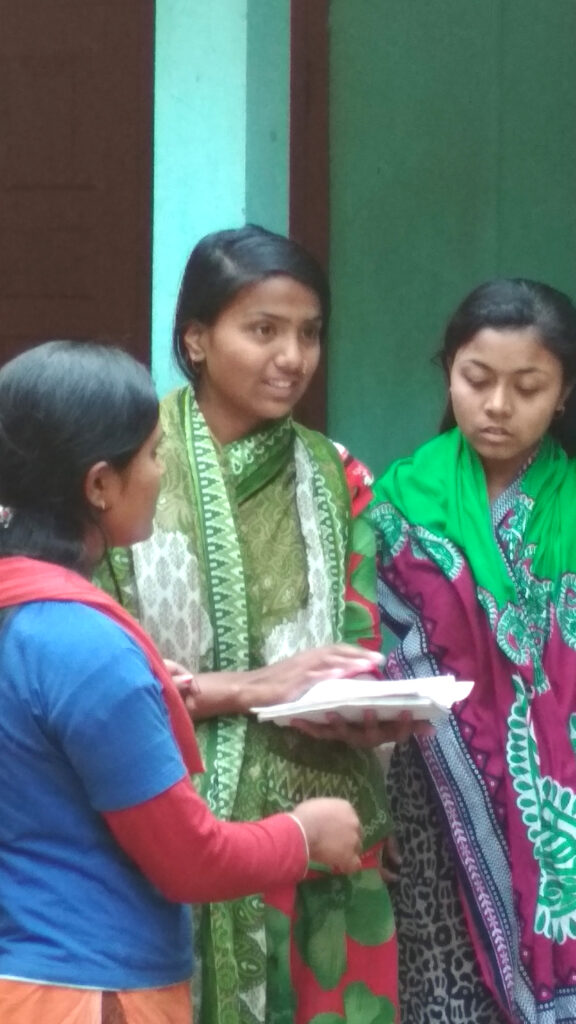
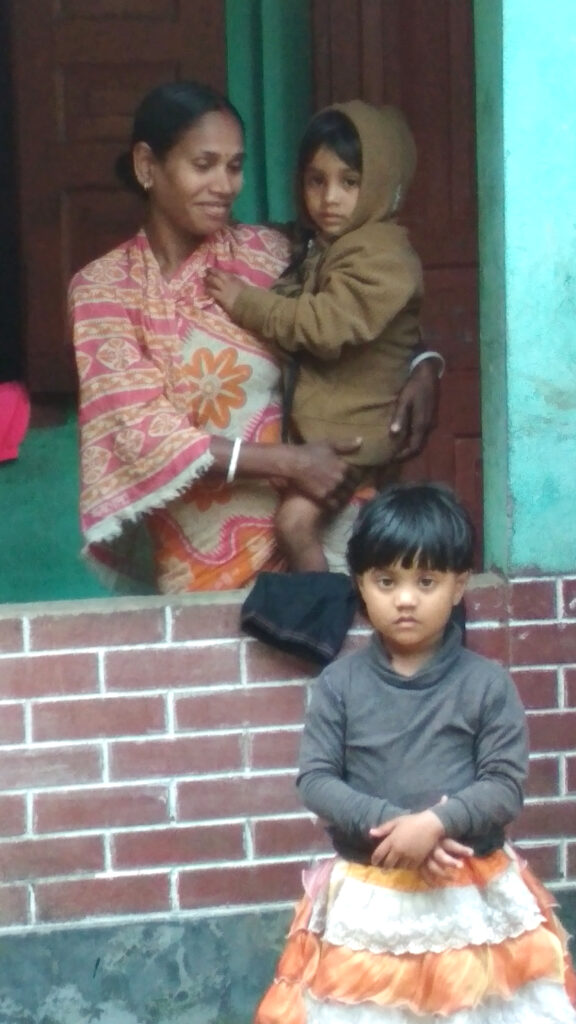
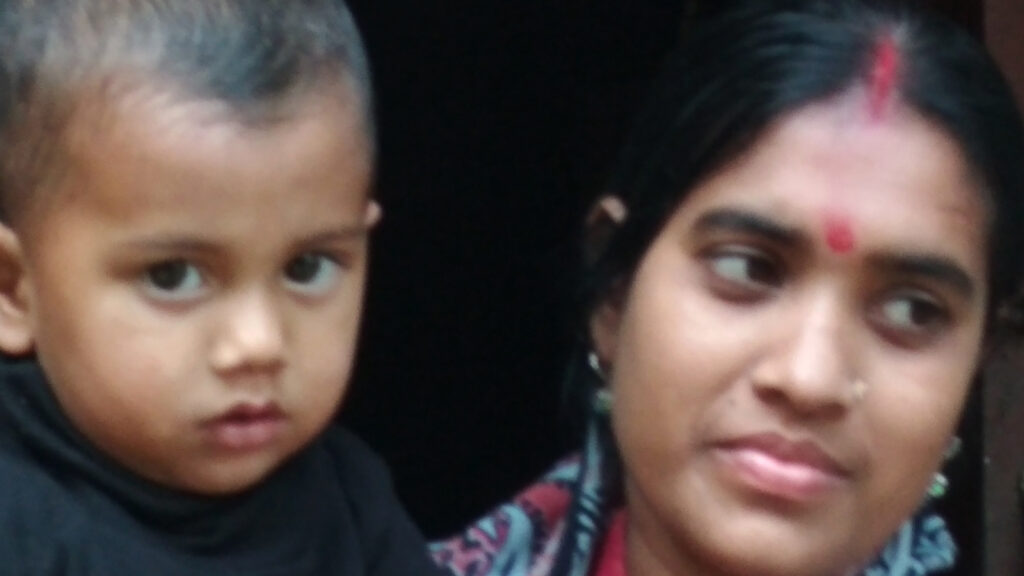
The women of Doudik who sang for us. Photo: Moushumi
‘Let us sing a doodhjaaler gaan.’ ‘Let us sing a song about boiling the milk,’ the women said. ‘Sing as you please, sing what gives you ananda or happiness’ Ambarishda said. ‘No, we will sing to please you, for your ananda.’
These are songs of the cowherd community. Radha was a maiden of the community, a gopika. Krishna, a leader. But actually a god. Radha the supreme devotee. The song they sing is about when Krishna was a little boy, waiting for his creamy milk. And his mother milks the cow and brings the milk to a boil and then she put it in a earthen pot.
Rani dugdho de go jaal / Shorononi khaibare naase Nondolal / Dhenu duaiya Rani/ Choliya aila ghare/ Boshaila dudher hnari/Chularo upore/ Aguro chandano kashthe/ Aguni jwalaiya/ Ego, utholiya pore dugdho / Asharero chula/ Dugdho jaalo diya rani/ Namaiya rakhila /Shitolo koriya dugdho/ Bhandete rakhila
Boil the milk, Rani [Jashoda, mother of Krishna, queen of the cowherds]. Nandalal or little Krishna dances with joy at the thought of eating the creamy delight. Rani milks the cow and brings in the milk, puts it on the stove and lights the fire with sandalwood and agar [the sweet smell of the fire therefore fills the air]. The milk boils and rises in a wave, she takes it down from the fire and pours into a clay pot.
Video recorded by Moushumi (asking Ambarishda to hold the Zoom H4N) on her Redmi phone-camera. 18 January 2018.
After this trip Asadbhai would call me from time to time, as long as I was in Bangladesh and my local sim was still active, and say: ‘Apa, we will find Fayazullah’s village, I am sure that we will. I have talked with so and so. Don’t you worry. We are getting close.’
On 24 November 2016, I went to Noakhali in eastern Bangladesh with sound recordist Ali Ahsan, searching for Tazal Ahmed, who had sung two songs for Arnold Bake on board the Streefkerk in 1934. Following the leads from the catalogue of the Berlin Phonogramm Archiv, I wondered if some family of Tazal Ahmed could still be found in his village Ghutia in Noakhali Shadar (usually written as Sadar, but Bake was probably writing as he listened; he was writing the sound)? The recording was more than 80 years old, so there was of course no chance of finding the singer. But perhaps someone with some connection would tell us something? Perhaps he had settled in London or somewhere else in the UK, as many sailors did? Perhaps someone would be able to say something about the song? So, the first stop would have to be Noakhali Sadar. Ali and I took a bus from Dhaka to Noakhali and went to the office of the District Magistrate. No one seemed to have heard of Ghutia, but some people talked about Sholla Ghutia. So that is where we went, but realised that it was a fairly new place, formed as a result of the rising of a new char or silt island. They talked about the River Bhulua, which had changed its course over the last forty years, washing away places which would have existed in the 1930s. Sadar now is not how Sadar was then. Could it then be that the river had washed away Tazal Ahmed’s Ghutia village?
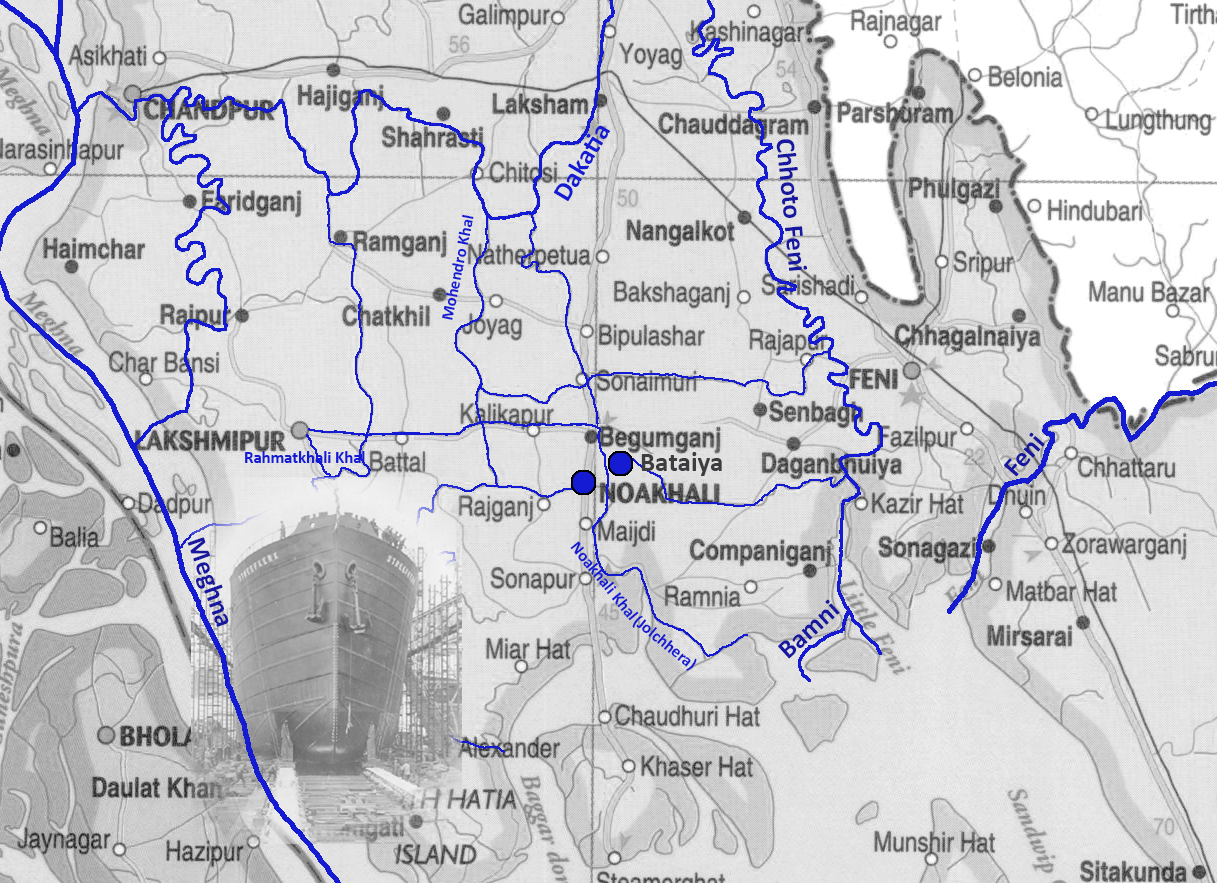
Map with image of the Streefkerk. Designed by Purba Rudra
The three-wheeler driver took us to a place when we told him we wanted to go to Sholla Ghutia. There we made random acquaintance of a man of about 50 years named Ali Ashraf Uddin and he said the name of his village was Purba Shullukiya and we were in Dharmapur Union; place-names were already getting mixed up. He had not heard of Ghutia, but he fetched an older man who could know something.
Caption: Ali Ashraf Uddin, my friend Ali Ahsan and I talk and I explain a few tings about my work. Then Ashraf Uddin sends someone to get an older man who might know something more. We talk about many things, rivers and chars and his children and his wish to go to Kolkata. There is one thing from this conversation which has stayed with me. I am looking through the archival notes for Bake’s sailors’ songs and I mutter names of the other places from where the seamen came. Hirpur Bazar in Comilla, Dhamrasari in Sylhet. ‘That would be in Uttar Banga [north Bengal],’ Ali Ashraf Uddin says. ‘Not Uttar Banga, it is Sylhet,’ I correct him. I think North Bengal is the Rangpur and Rajshahi region of Bangladesh, bordering Indian North Bengal. ‘Sylhet is our Uttar Banga,’ Ali Ashraf Uddin corrects me. This thing about how locations on a map are relative had not occurred to me before, and it was a lesson beautifully learned. At about 00:13:34 into our conversation above, the older man we were waiting for, Abdul Ali Bhuiyan, arrives.
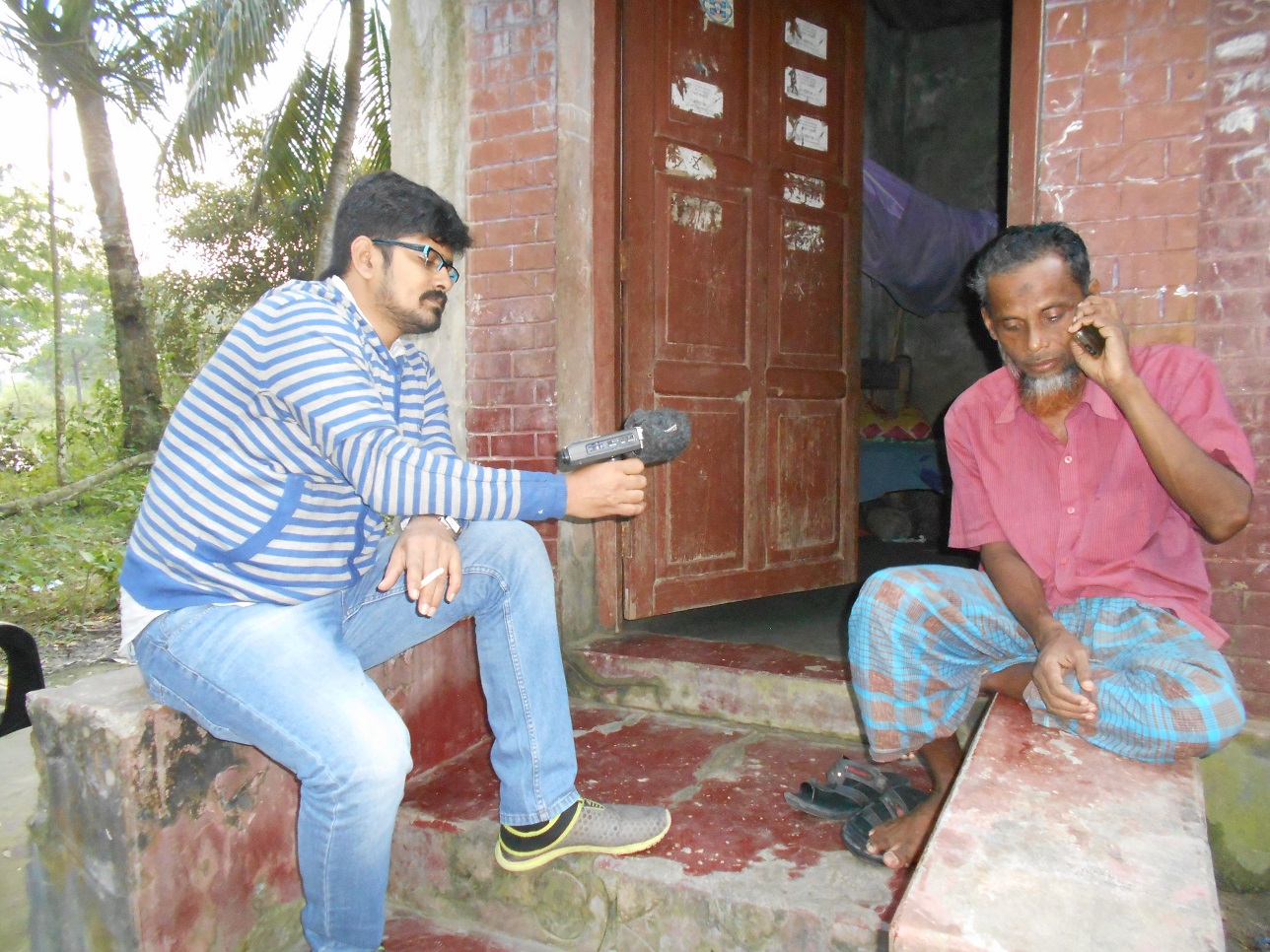
Caption: Ali Ahsan records Ali Ashraf Uddin on my Zoom HN4 recorder. 24 November 2016. Photo: Moushumi
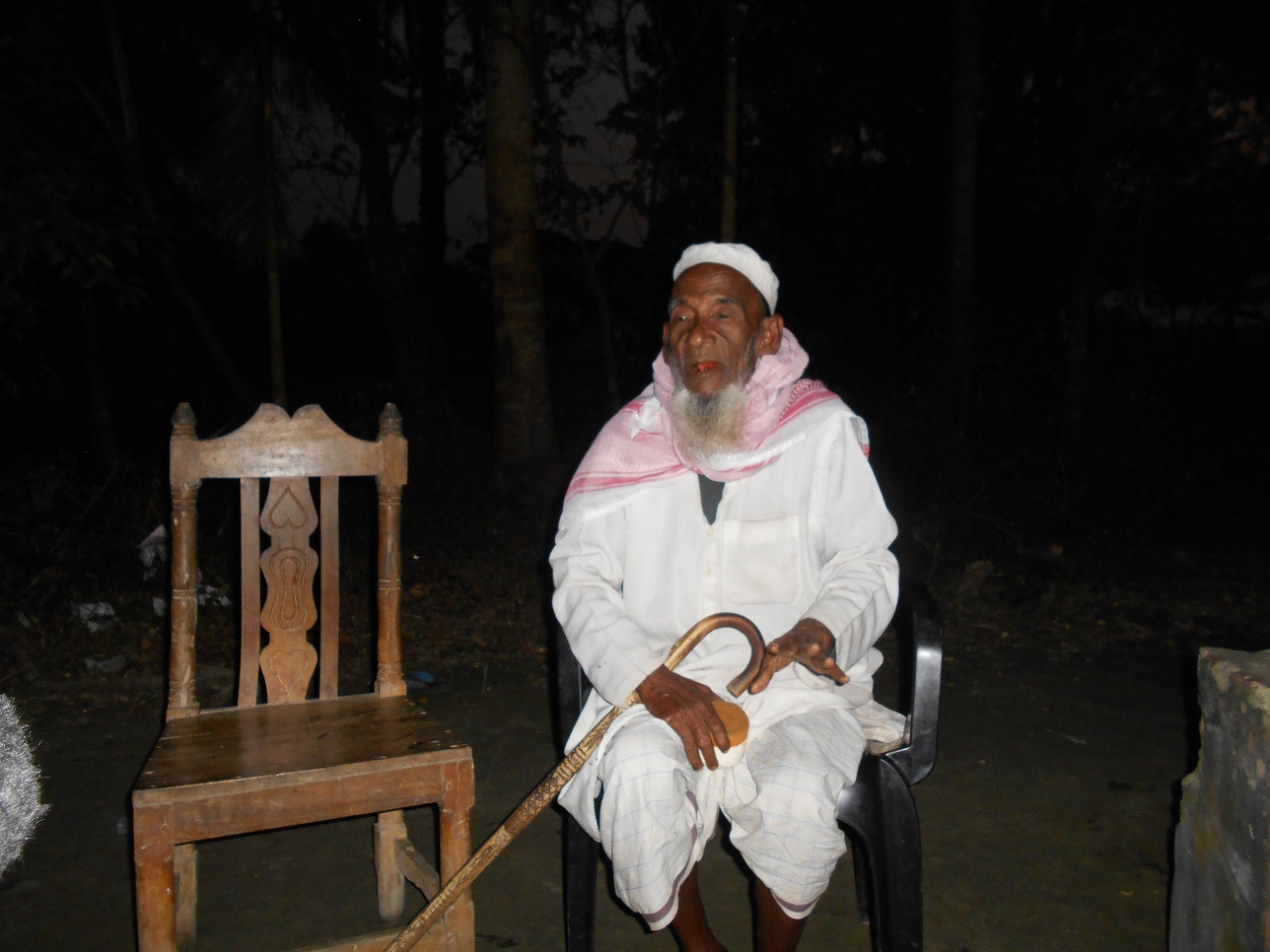
Caption: Abdul Ali Bhuiyan, 90, in Shullukia village, Dharampur Union, Noakhali. Photo: Moushumi
Caption: The conversation with Abdul Ali Bhuiyan continues. He is about 90 years old. He has seen rivers changing their course, battles for independence, floods and famines; he has seen countries break up and new countries rise like new silt islands.
Abdul Ail Bhuiyan did not know about Ghutia either. ‘Many Hindu names have changed after Partition,’ he said. ‘But, Ghutia is neither Hindu nor Muslim,’ I said. There was another possibility. Could it be that Bake had heard the name of the place wrong, or he had misspelt it? Perhaps the archivist had wrongly deciphered Bake’s handwriting? Ali Ashraf Uddin said there was an even older man who lived west of Maijdi, west of Rowshan Bani cinema, with whom we could take a chance. So, Ali Ahsan and I went to meet Dilmohor Talukdar. The whole journey had a charm of its own, although I had a sense we were walking through a maze. But once you are in it, you have to go through the whole trail. I did not take out my recorder, everything cannot be recorded with a machine.
Dilmohor Talukdar had an innocence which comes with age and it was just beautiful to be in his home. He was keen to go on this place-hunt with us. ‘We will go to the river with a picnic, light a fire, cook a duck …’ he began to dream. His family members joined in the game. People started to make phone calls to various people. Someone suggested we go to Bataiya, since there seemed to be no place called Ghutia, and since these were similar sounding names (if you think of ‘Ghut’ being pronounced not as ‘hoot’ but as ‘hut’). Perhaps it was Bataiya then, an older village, from where it seems that people went to work on ships? Could it be that someone who has worked on ships in the last 50 years would have heard the name of Tazal Ahmed?
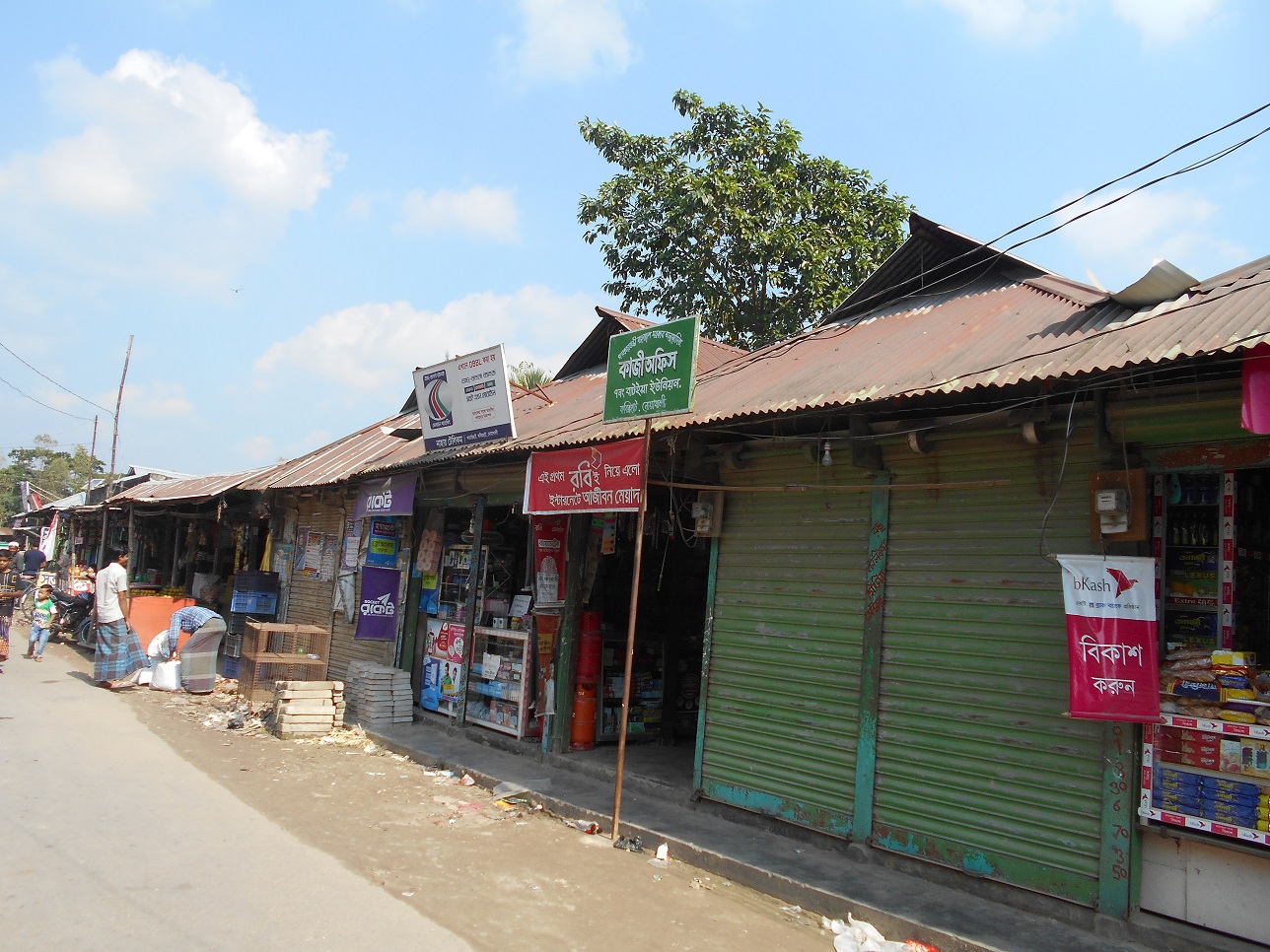
Bataiya, 25 November 2016. Photo: Moushumi
So, the next day we went to Bataiya, without Dilmohor Talukdar, though. That is all there is to this story. That is the closest we could get to Tazal Ahmed’s village. I found nothing which could conclusively tell me whether or not I was on the right trail. There was a seaman in Bataiya, someone who would be far younger than Bake’s Tazal Ahmed. He had his own stories from post-Partition days; about people from his region who went to work on ships, about names of vessels and ports and about the War of 1971.
Haji Muhammad Shamsul Huq had gone to Karachi from Chittagong in the 1950s, looking for work. But he was too young and they did not give him work. Later he became a seaman. He said there was no one left now to remember the olden times.
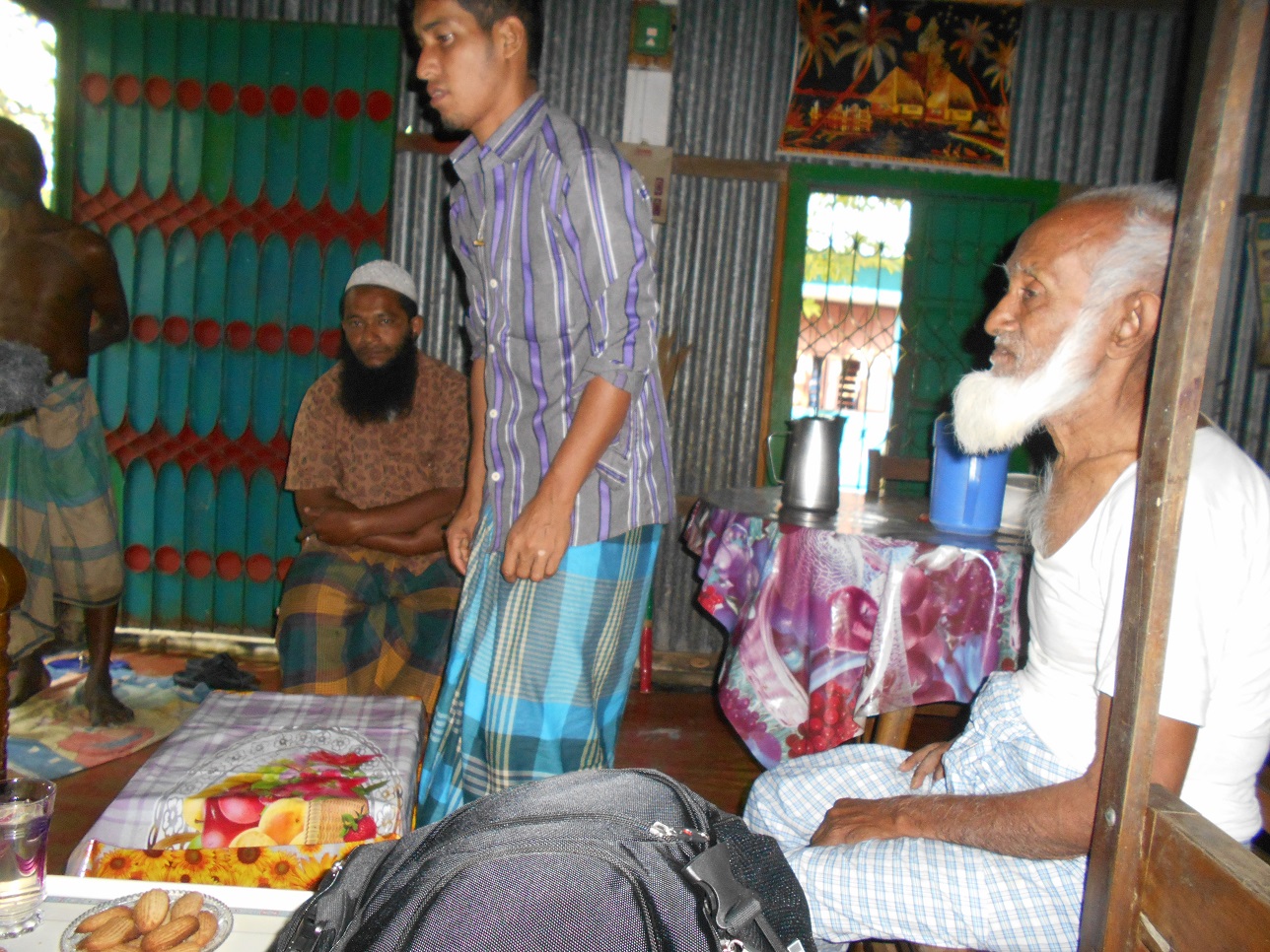
Haji Muhammad Shamsul Huq in his home in Bataiya. Photo: Moushumi
Noakhali’s old name was Bhulua. The official name of Noakhali was given in 1868. It comes from a noa- khal (new canal) built in mid-17th century, to protect the place from severe annual floods. The district is bordered by Comilla in the east and the Meghna estuary and Bay of Bengal in the south. Again, all of these places border one another also in Arnold Bake’s Bengal archives. Hirpur in Comilla was the home of our sailor Sayed Ali; oilman Sawabali and stoker Fayazullah came from Sylhet. I am yet to go to Comilla.
Sawabali of Bake Indien II cylinder 351, like the other seamen on the Streefkerk, was recorded and his disembodied voice was taken to an archive. There it lay for about 85 years. Then I, through a fortuitous string of events, became a vessel for the song to return home. Yet, when I reached his home, I realised that Sawabali’s song had never left at all. A man long dead, he felt like a living presence in his home, a light that gently burned. If anything, the returned voice made that presence even more real.
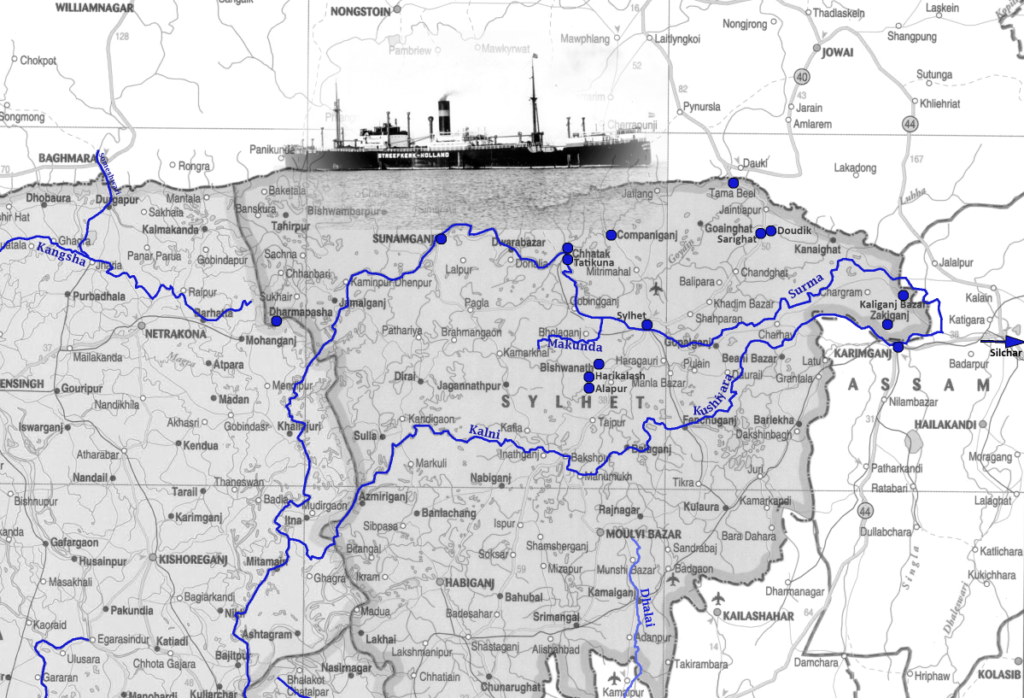
Map designed by Purba Rudra, showing the places where we went looking for the Sylheti seamen Sawabali and Fayzullah whom Arnold Bake had recorded in 1934
Songs about voyaging towards the unreachable shore and searching for the majhi to take us across abound in the repertoire of spiritual songs from this eastern part of Bengal. Sawabali was a man who sang such ‘pir-murshider gan’; he had a job as an ‘oilman’ on the ‘Streefkerk’, a cargo ship sailing from India to Europe; he was recorded by Arnold Bake on board this ship on 15 April 1934, on Bake India II, cylinder 351.
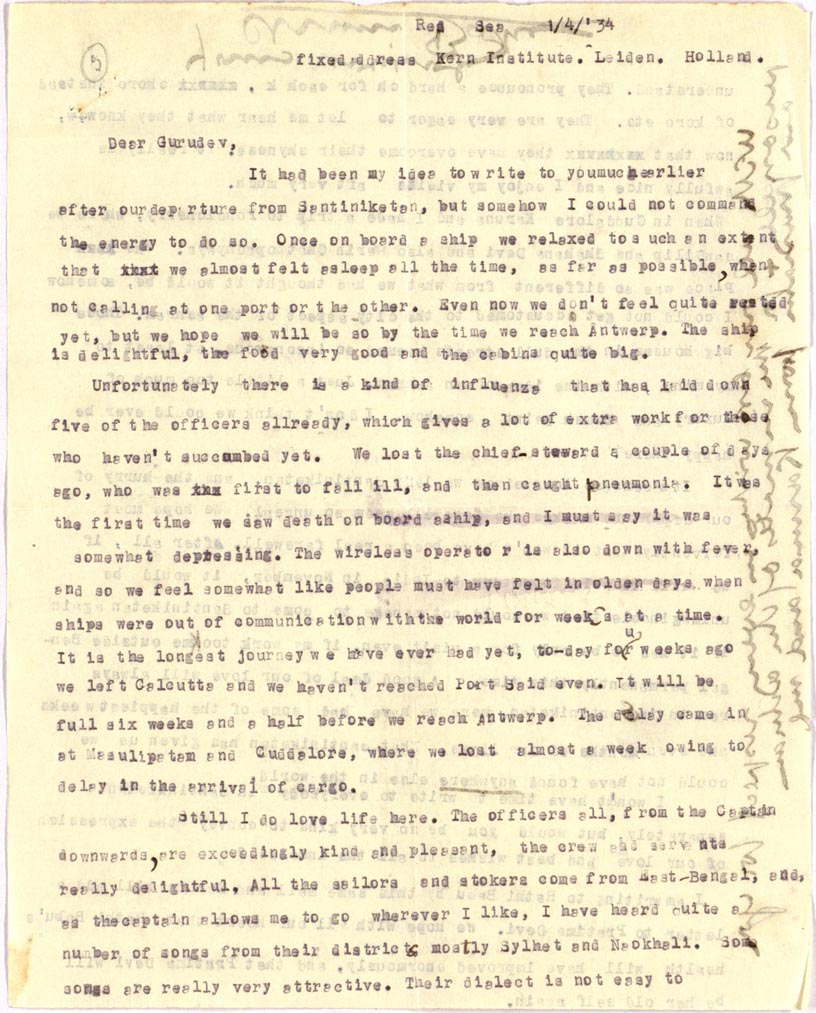
Letter from Arnold Bake to Rabindranath Tagore. Courtesy: Rabindra Bhavan archives, Visva-Bharati, Santiniketan
‘… I do love life here,’ Bake wrote to Gurudev Rabindranath Tagore, from his ship on 1 April 1934, while sailing on the Red Sea. ‘The officers all, from the Captain downwards, are exceedingly kind and pleasant, the crew and servants really delightful. All the sailors and stokers come from East Bengal, and the captain allows me to go wherever I like. I have heard quite a number of songs from their district, mostly Sylhet and Noakhali. Some songs are really very attractive. Their dialect is not easy to understand. They pronounce a hard ch for each k, choro instead of koro etc. They are very eager to let me hear what they know, now that they have overcome their shyness. It is really awfully nice and I enjoy my visits aft very much’ It must have been this dialect, ‘not easy to understand’, which resulted in some errors in the notes that we have for the recordings, and which led me for several years through a maze of broken roads and changed place-names till I found the home of Sawabali in 2018.
According to the archival notes, ‘Sawabali (oilman)’, was from ‘gram Harikhailash. po. Bisvanath, Sylhet’. When I had sent these details to friends Ambarish Dutta and Suman Kumar Dash, journalist, music researcher and writer, they said as far as they knew, there wasn’t a Harikhailash in Bisvanath but a village by the name of Harikalash in Bishwanath thana area.
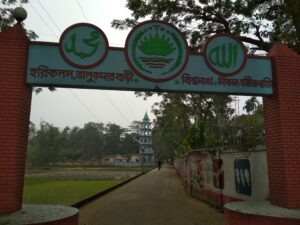
I went with friends Ambarish Datta and Tushar Kar to look for Sawabali in Harikalash on 16 January 2018. Photo: Moushumi
Ambarishda had a contact in the ‘Hindu para (neighbourhood/mohalla)’ of Harikalash, so that became our first stop. The people in this house weren’t very friendly or helpful, but a young man started walking with us as we were leaving and he said he would take us to an old man of about 80 or 90 years, in their same neighbourhood, who might know something. Our next stop was at 83-year-old Pachon Malakar’s house. And it was from here that the story of Sawabali began to slowly reveal itself. I am consciously using the word reveal here, because that afternoon, after a point, it seemed that we were no longer in control of the story, but something was happening before our eyes and all we could do was to submit ourselves to this revelation.
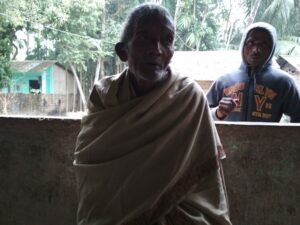
Pachon Malakar, Harikalash, 2018.
Pachon Malakar (Fyason Malakhar is how they pronounce the name), a little short of hearing, had to be asked the same question more than once. But he remembered a lot. He remembered the brothers Sawabali, Meher Ali and Akon Ali; the latter had gone to London and then came back and died here; Sawabali too had gone to London. Sawabali was a piraki, this was a prominent family, a piraki household. Sawabali’s father was Romdi Pir, an interpreter of life and a spiritual healer. With the pirs, the interpreting and healing is often done through the means of music. Ganja khaita, Sawabali smoked ganja. Ambarishda and Pachon Malakar talked, I mostly listened. I had to be extra attentive to their Sylheti accent and words, so that I did not miss anything. He said the old house of Sawabali was east of Tamizullah’s house, তমিজুল্লার বাড়ির পূবের বাড়ি; he gave directions to the young man who had brought us to him.
From Pachon Malakar we walked through this typical Londoni village of massive (alishan, as Ambarishda was saying) empty houses, the kind of place that Katy Gardner writes about, to an old house which used to be Sawabali’s.
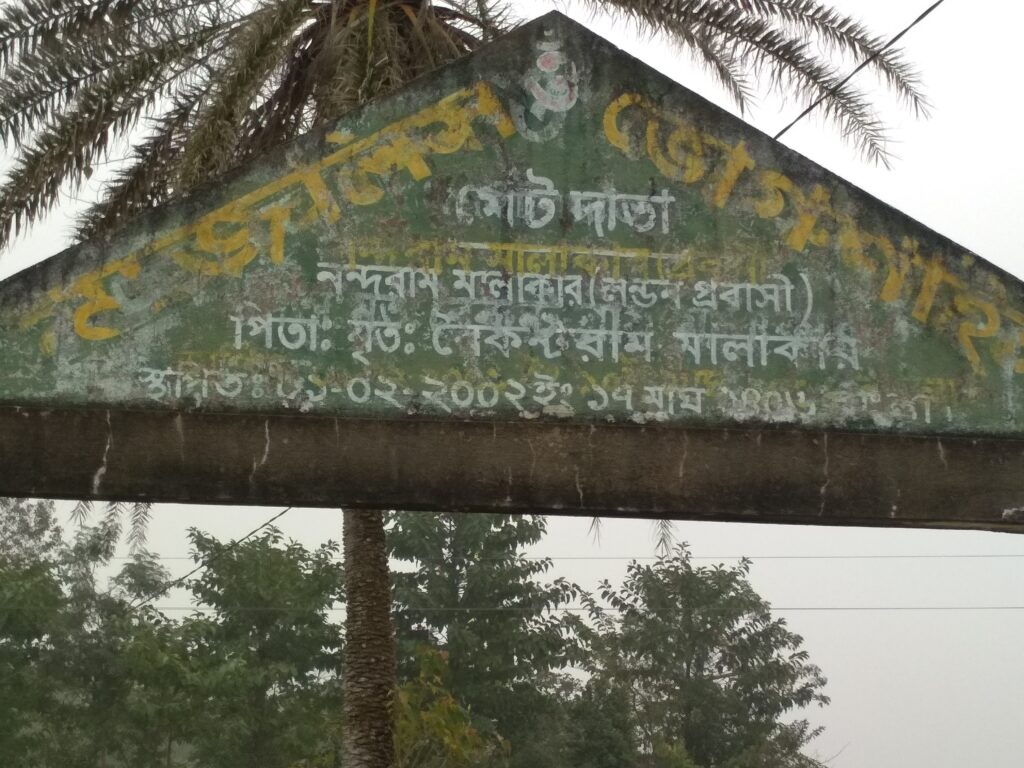
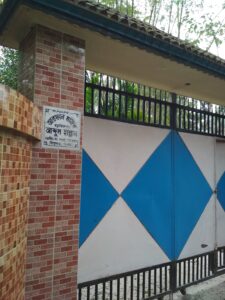
The massive houses have massive gates and plaques announcing that the owner is a Londoni. Photo: Moushumi
Recording from the courtyard of the house which used to be Sawabali’s. 16 January 2018. Recorded by Moushumi on a Zoom H4N recorder.
Here we moved one step further, learning more about Sawabali and his brothers. In the courtyard there were several people who had gathered, some who lived in the house, some younger and older people of the neighbourhood. The murubbi of the village—wise women and men who had seen and heard about other times. Sitara Bibi, Abdul Kader, Hajera Bibi. Ambarishda explained the context, it was better he did the talking, because he was sonically and idiomatically closer to those we were meeting. Sawabalir fochashi bosorer recording tain tukaiya faisoin, she has searched and found Sawabali’s record from 85 years ago, Ambarishda was explaining the reason behind our visit. The audience was amazed. They knew about Sawabali, some had even seen him. They weren’t his relatives and this wasn’t their family history. But Sawabali’s story was part of the memory of the community. ‘They had fallen into hard times,’ people remembered. Sawabali sold off the house and went away somewhere, with his family. People talked about his two marriages (dui torof), death of his daughter (his furi), Mala, from his first marriage. His return from years on the sea to Harikalash, his second marriage to Tezab, there was a son who died, then she had two more sons and a daughter, Minara, who also died. Gaan bazna je korten dekhsen? Did you see him make music with friends here? Oy dekhsi gaaner ashor, ganjar ashor. Yes, we have seen gatherings of smokers and singers. Did he play any instrument? Dofki? Did he play the hand drum dubki? Did he play the dotara? There used to be a lot of people who gathered, Aaro manushjon aisha boita, okhon keu nai duniyat, they have all left this world
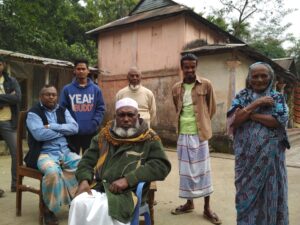
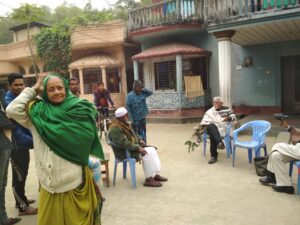
In the courtyard of Sawabali’s old house in Harikalash, Bishwanath, Sylhet.
The older men and women who had gathered in Sawabali’s old house talked about how he sold off his property and moved to Alapur, not far from Harikalash. Then he left Alapur too and went somewhere in the mountains and died there, they said. But they were not in touch with his family anymore. There might be some family in Alapur, his sons should be there, don’t know their names, but if you go to Kaliganja Bazar and ask Munir Daktar, he should be able to show you the way, they said. That is the route we took to go to Kaliganja first and then to Alapur. The doctor said, walk down that road and ask anyone where Anfur Ali’s house is.
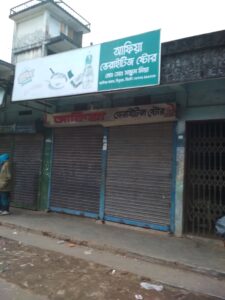
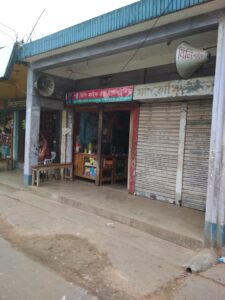
From Harikalash to Kaliganja Bazar, did not take more than fifteen minutes to reach by a three-wheeler auto rickshaw. Photo: Moushumi
Before we go to Alapur, let us dwell a little longer on Harikalash. In Sawabali’s house, I kept looking around at the house and the courtyard, at people’s faces, thinking of traces. It felt unreal that I was actually in a place where Sawabali was no longer just a voice, but a son of a pir, a husband and a father, with children who had died—so Sawabali now becomes a man with a burden of grief. Here this voice used to fill the air of the courtyard where we were sitting. I could smell the incense and the ganja of the ashor and hear the music. As I looked at the unusually tall women with light brown eyes I was thinking of other journeys into this land which people had undertaken in a distant past–journeys of pirs and fakirs from other geographies with their songs and stories, the coming of Islam to Bengal… thoughts whirled inside my head. There was a middle-aged man who was dressed as a hujoor (Islamic clergyman) in a long kurta, fez (hat) and checked scarf, and he was saying the most interesting and informed things. His name was Maulana Abdul Kadir Kobiraji. A medicine-man by profession, a song-collector by passion. He said it would be good if we stopped by his place before going to meet Munir Daktar.
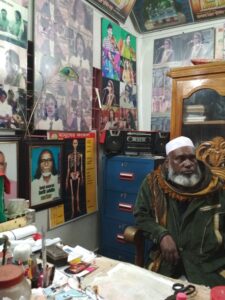
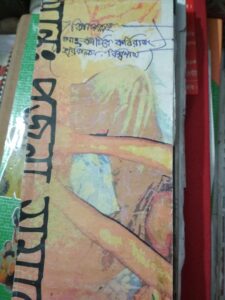
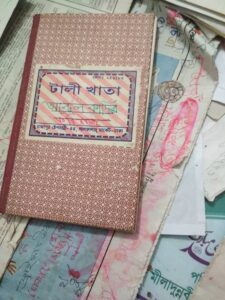
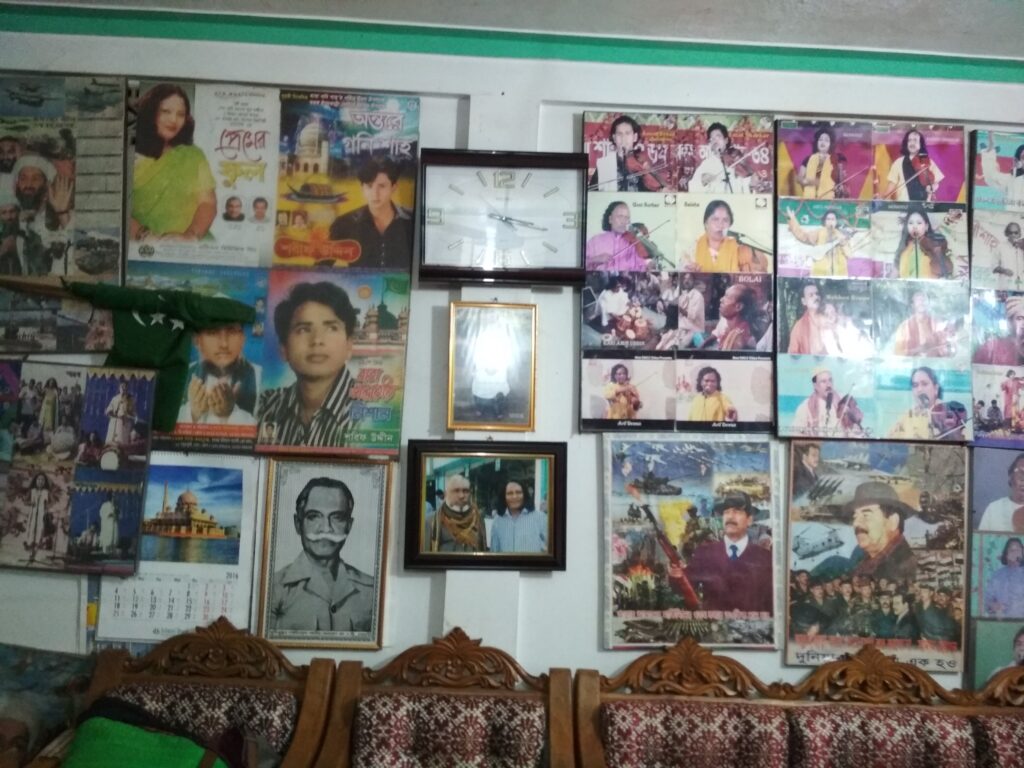
Maulana Adbul Kadir Kobiraji, a collector of songs. Photo: Moushumi
So we went with Abdul Kadir Kobiraji to his amazing room covered from all to wall with cassettes and CDs and covers of tapes and posters of pallagan concerts, first releases, photos of old dead artists when they were young, shelves lined with radios and cassette players covered with embroidered silk—it was a kind of a magic room which we had entered. There were also photos of Saddam Hussain and Muhammad Ataul Goni Osmani in the midst of the singers, to celebrate a kind of Islamic glory. The maulana gave us his calling card and someday I will have to go back to Harikalash to dig into the wealth of music Abdul Kadir Kobiraji holds in his archive.
Conversations with Maulana Abdul Kadir Kobiraji about his music collection, about 1971 and other things. Recorded by Moushumi on a Zoom H4N. 16 January 2018.
We took a three-wheeler to Kaliganja Bazar and there we met Dr Munir who knew about Sawabali and his sons. He found someone to take us to Alapur.
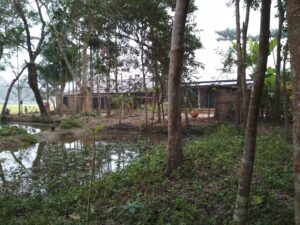
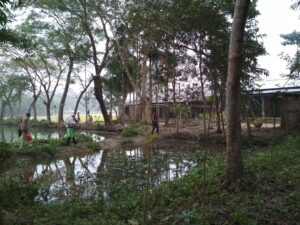
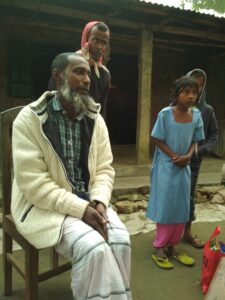
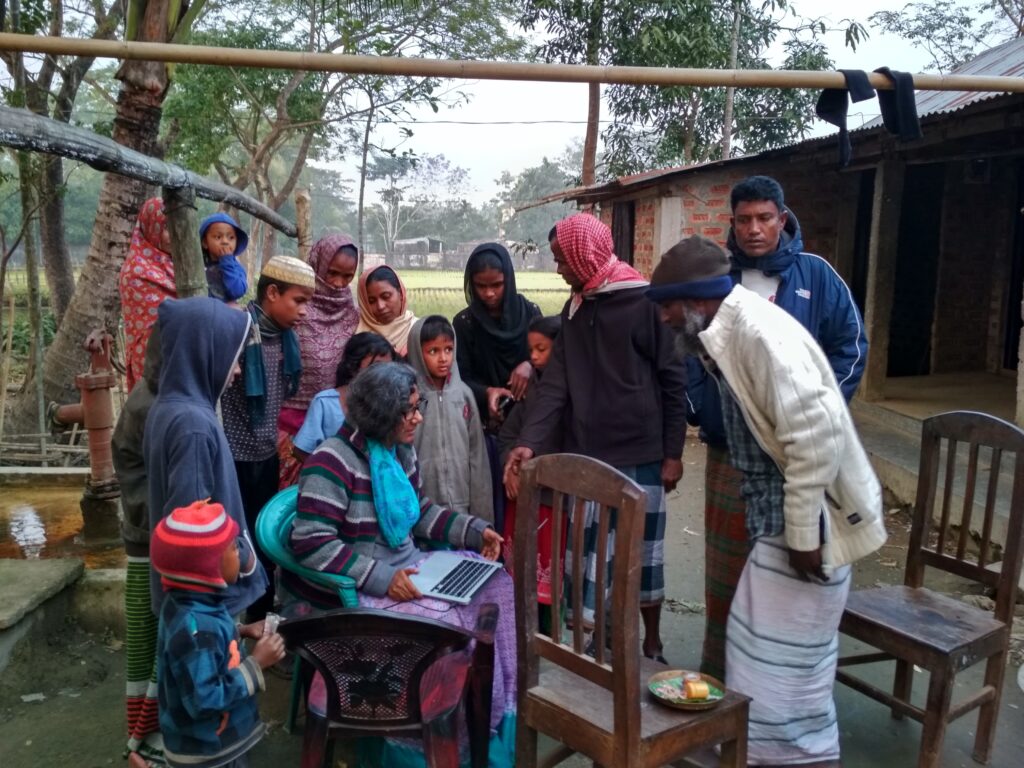
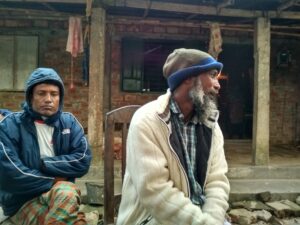
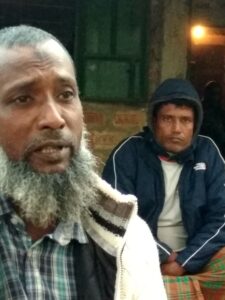
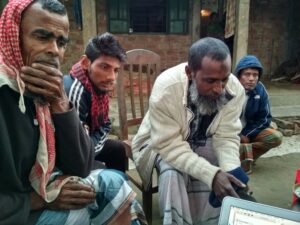
A beautiful man with a greying beard and very kind eyes met us as we entered his courtyard; the tall betel nut trees (gua gaachh/gaas) stood around, watching. This house was nothing like the Londoni houses of Harikalash, but just a row of rooms with a tin roof and a veranda, all doors open, the rooms quite dark inside, a yellow light glowing like a candle. Anfur Ali? Ambarishda had asked. Yes. Was your father’s name Sawabali? Yes. Sawabullah, actually. The man spoke so softly that you had to strain your ears to listen. He could well have been a poet. Or a pir. So, this was Anfur Ali, the second son of Sawabali, from his second wife, whom he had married late in life. That explained Anfur Ali’s age of 53 years and his younger brother’s, who was just a year-old baby when their father passed away around 1983. As I explained the purpose of my visit and Anfur Ali was getting us chairs to sit, ‘Make some tea,’ he said to the women. ‘Please don’t bother, we have just had tea at Kaliganja Bazar.’ ‘Paan (betel leaf ) then?’ he asked.
Anfur Ali, his younger brother Asar Ali (who was first named Asman), a friend Batir Ali, the women of the house, children, us who had gone from the outside, the young man who showed us the way—we all sat still in their courtyard in the fading winter light, listening to the voice of Sawabali as it flowed under the surface noise of the cylinder. Then, as the song is playing,I hear in my recording of that day, Anfur Ali’s voice above his father’s. ‘Make some tea, make it strong. Said to whom, I do not know.
Anfur Ali is so overwhelmed to hear his father’s voice that he finds it hard to talk. Recorded by Moushumi on her Zoom H4N
The song was over. Everyone was silent. ‘Dhoinyobad, thank you,’ Anfur Ali whispered. The song had opened old wounds, while also taking him to memories of a beautiful time of loving. ‘My father loved me very much, he used to call me Afu.’ He spoke a little, then stopped. Then someone else spoke, maybe his much younger brother, who was sleeping inside the house when we went. He drives long-distance trucks through the night. Anfur Ali works as an electrician, he works when he is hired; they struggle to make ends meet. There was grief in his eyes, but no grievance about anything. It was probably a sense of grief that ran in the blood of this piraki family, a line of seers, poets and healers. Music flowed through them. ‘I don’t usually sing,’ Anfur Ali said. Besides, it is expensive to hold ashors at home, where musicians gather and smoke and have tea and sing, as it used to happen in his father’s time. ‘I go to different shrines and some nights when the song rises in me, I sing all through the night, sometimes all alone.’
Several times in the course of that evening, while sitting in their courtyard or while walking us to the road, Anfur Ali said, ‘Abbay koita, Abba used to say…’, and then maybe just recited a few lines of a song. ‘Will you sing for us please?’ I asked. He said, ‘It is hard you know, when the air is so heavy with remembrance. Who would have thought a voice from so long ago, Abba’s voice… this really is jotheshto paona for us, more than what we could have ever imagined, we shall never forget this day.’
I said, it was actually jotheshto paona on both sides, far greater than what a researcher or field recordist can ever ask for. This is a blessed moment in anyone’s life.
Bake’s Sawabali or Sawabullah was an other-wordly man, his son said. He knew 12 languages, sheltered Hindus and Muslims in his home at the time of the Shongram, meaning the 1971 War of Liberation, went out and spoke to the Pakistani soldiers in Urdu or Hindi or whatever language it was, till they were gone. ‘Just today Nripendrababu came and he sat here and was talking about Abba and weeping,’ he said. Nripendrababu, Umeshbabu, Ashwini Nath—all the Hindu families who were given shelter in their house in 1971. He had brought back some money from his job as a sailor, and also from his stay in London, but he also gave it all away. Gave food to so many. Gave home to all sorts of fringe people, the blessed and the mad ones. ‘Abba had brought with him one Koilkattai Pir.(a pir from Kolkata, possibly because their ship would dock in Khidpirpur, Kolkata.) The man was so mad, he could bite into hard iron and bamboo. Then there was one Hoq Bhandari, who went round and round crying “Hoq Bhadari Hoq Bhandari!” They lived for 12 years in this house. Called our Amma Ma. They were like children. When people teased them, they went to Amma and cried.’
As Anfur Ali remembered things, others around him also started to remember. A collective memory of joy and pain began to rise and fill up the space of the courtyard of that humblest of houses, as the azaan of Maghreb (call to evening prayer), was heard from the mosque nearby. Then from another mosque in the distance, then from another further away. It was so beautiful. I folded up my laptop, packed my things and rose to leave.
‘”Uchana dolane boshi, ki koro mon parobashi re/ Amar parobashi, oshar ei jibon re” (Sitting in that lofty house, what to do, O exiled mind?/This exile life has no meaning at all.—Abba used to sing this song. After he lost everything and went to Companyganj in search of work, he would sit and sing this song. He badly missed his close ones whom he had left behind.’
Ambarish Datta and Anfur Ali sing and talk as the latter walks with us to the main road from where we will take a vehicle to Sylhet
It is through Akhu Chingambam that I got connected with his bandmate Sunil Loitongbam and through Sunil, with the voice of his mother, Sumati Devi. Had Arnold Bake visited Manipur in 1956, he would probably have met Sumati Devi’s gurus, because she was a teenager then. Who knows? Like fifteen-year-old Chitralekha Choudhury in Santiniketan, maybe he would have met and recorded Sumati Devi too with his reel-to-reel recorder?
Born in 1940, Sumati Devi (Srimati Haobam Ningol Loitongbam Ongbi Sumati Devi) of Nagamapal Kangjabi Leirak, Imphal, Manipur, is one of the few women who still sing the Monoharsai or Monorsai style of kirtan, which is a dying art form of the state. However, she has worked all her life to revive this art.
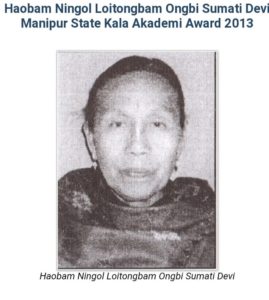
Sumati Devi received her initial training in music as a child from L. Ibopishal Singh. Later she studied north Indian classical music and received her Sangit Visharad degree from the Bhatkhande School in Lucknow. She went on to become an approved singer of All India Radio, Imphal. It was following her marriage with the tabla guru Menjor Singh that her career as a kirtan singer took off, as she began studying with her father-in-law, the master of Manoharsai, L. Ibomcha Singh. Sumati Devi also took lessons from Gurumayum Robindro Sharma, H. Modhu Sharma and Gurumayum Bhagendra Sharma. All her life Sumati Devi has performed in numerous festivals and ceremonies across her state. For her contribution to Manoharsai kirtan, Sumati Devi has been awarded the Manipur State Kala Akademi Award.
Conversation with Sunil on the phone about his mother on 3 December 2021
Though in her eighties and frail now, Sumati Devi still sings the Manoharsai with grace and beauty. I am grateful to her musician son, Sunil, for sharing her songs, photos and their knowledge with The Travelling Archive. As I was telling Akhu and Sunil, my initial curiosity was about the journey of the kirtan of Bengal to Manipur and its flowering into a song of its own in another soil. I was thinking of traces—what remain from the past and what get added over time, for the future.
In response to my questions, Sunil recorded this song in Bangla, what he calls the ‘Gourchandrika’, song in praise of Gouranga Mahaprabhu, taking his mother to his own studio ‘Hayum Lab’ in Imphal in late 2021.
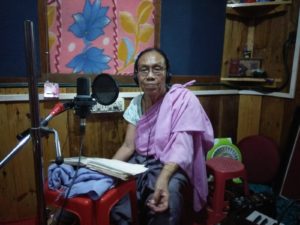
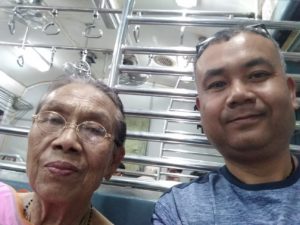
Interestingly, in 1944 Arnold Bake had notated several Gourchadrikas which he had learned from his teacher, Sadhu Baba. Oliver Weeks had sung the song notated below, while Nirmalendu Mitra Thakur had sung the same song as he knew it when we went to Maindadal for the third time in January 2016.
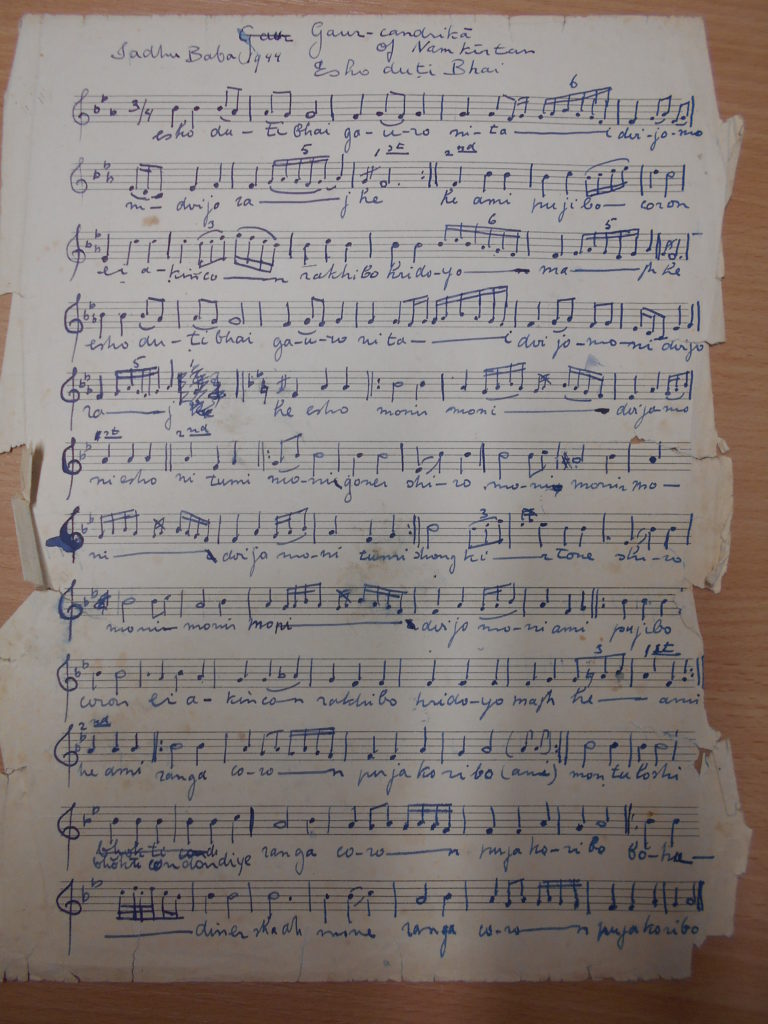
Arnold Bake’s kirtan notations are archived at the School of Oriental and African Studies in London. I looked at them and took some photographs while working at the library in 2015. This is one page from the collection. with a Gourachandrika
Oliver Weeks sings from Bake’s Gourachandrika notation. He recorded himself in London in February 2016.
Nirmalendu Mitra Thakur sings the same Gourachandrika as he knows it, as he had learned from Gobindagopal Mitra Thakur. Recorded by Sukanta Majumdar for The Travelling Archive in Mainadal on 20 January 2016.
Around 2016-17, Sunil had recorded his mother singing the ‘Murli Horon’, a song in nine parts, which is a story from the life and divine love of Radha and Krishna; murli referring to Lord Sri Krishna’s bewitching flute and horon meaning to steal; it is the story of the flute of Krishna which steals the heart of Radha.
Sunil had recorded his mother in his studio, and the accompanying khol player was Bhramacharimayum Gopiromon Sharma. Sunil wrote to me: ‘She learned all the above songs from her late guru Gurumayum Bhagendra Sharma. According to her, the lyrics are translations from Bengali texts and her guru just taught them his compositions and she is not quite aware as to how and from where it was compiled by him. It’s more like in the mode of guru shishya parampara [the oral tradition of the guru passing the song to the pupil], the way they have learned these songs over a period of several years. I have not myself quite dug into this form of music in detail till now; further research is needed in terms of highlighting and understanding this dying art form known as monorshai– a kirtan style of music prevalent in Manipur.’
In 1955, when Arnold Bake, now a professor at the School of Oriental and African Studies (SOAS), London, was planning his trip to India after a gap of a decade, which would be his last trip, he had strong desire to go to Manipur to listen to their kirtan. He knew that students from Manipur used to come to Mainadal to their tol or residential school and learn kirtan from the Mitra Thakurs. He wanted to know more. Unfortunately, during his 1955-56 study tour, he could not include Manipur in his itinerary.
What kirtan would Arnold Bake have heard if he went to Manipur in the mid-1950s? What has become of that song now? I have tried in my work to ask these questions and listen for those ‘absent’ sounds. Absent because they are absent from the oeuvre of Arnold Bake.
This sub-chapter is written as a bilingual script, with extracts from emails and Messenger messages which I exchanged with two sets of young Manipuri singers from India and Bangladesh respectively, from around May to December 2021. The conversation continues. I must say that I have barely started to scratch the surface of things and there is so much left to listen to and to understand. However, the questions I posed to my young Manipuri friends have got them thinking too, thus making them part of this search/research.
Correspondence with Akhu
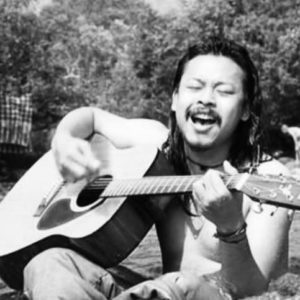
Akhu or Ronid Chingambam, of the band Imphal Talkies and The Howlers has researched folk music and memory in the Manipuri diaspora, besides being a prolific singer and songwriter from the northeast of India, whose songs are sharp and critical of the state and its power, and deeply committed to resistance.
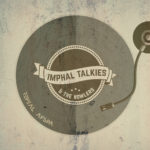 Imphal Talkies’ Youtube channel
Imphal Talkies’ Youtube channel
Moushumi to Akhu (12 May 2021)
I am thinking of how kirtan was practised in Manipur in the first half of the twentieth century. Yesterday I just chanced upon an essay from which I understand that Bengali texts are no longer sung but would you be able to tell me what texts used to be sung in the past … are there any old recordings of Manipuri kirtan that you are aware of?
I have heard from a friend in Sylhet that he remembers Manipuris coming to kirtan singing sessions and singing songs of Jnanadas and other composers, but the style would be very different. … As a lay person, I hear echoes of South East Asian music in the singing, the vocal style reminds me of Chinese music, but I might be wrong. You will know these things and I shall be grateful to learn from you. Are there writings on your kirtan talas?
I am asking all these questions because I know that students from Manipur used to go to Mainadal, a centre of kirtan in Birbhum, for lessons in the early twentieth century. Mainadal is associated with the Manoharsahi style of kirtan and when I read this article, I thought of these connections.
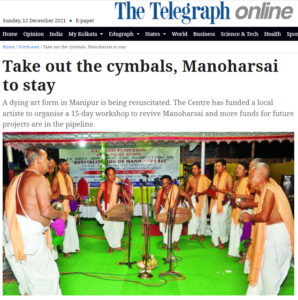
Moushumi to Akhu (13 May 2021)
I am thinking, even though Bake did not get a chance to listen to kirtan in Manipur in 1956, the music did exist. What became of that music over the next six decades, given the revivalist movements, the reclaiming of pre-Vaishnava practices and the rejection of Bangla? If I were to go now, what would I find? What of the past will I be able to find? What is lost? What is new?
Akhu to Moushumi (12 May 2021)
I am not an expert on the subject of Nat Sankirtan but this form of music has been part of Meitei communities for ages.
Our birth/death/wedding ceremonies and rituals are incomplete without this form of music. I think it is a very recent transition from bangla to meiteilon regarding the Sankirtan. Of course it came to Manipur post the vaishnavism invasion and it evolved to become our own form of music. One of the pioneers in the field is Oja Lakhpati, i think he can still sing Nat Sankirtan in Bangla. but they are no longer sung in rituals as there is a movement of revivalism.
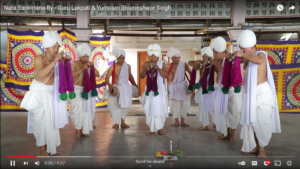
Nata Sankirtana By – Guru Lakpati & Yumnam Bhumeshwor Singh
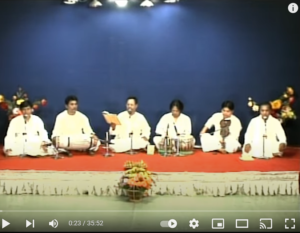
Mana Shikhya/Guru Lakpati/Lyrics: Late Guru Khangenbam Gullapi Singh
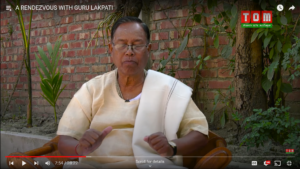
A rendezvous with Guru Lakpati
Akhu to Moushumi (12 May 2021)
After I read your email I spoke to my bandmate (Sunil) as his mother is one of the last exponents of Manoharsai…and Sunil also has interest in Sankirtan and been wanting to document his own mother,
Below is what he shared after i shared the mail with him:
‘I guess the Chinese style she is mentioning is our folk and penasaishak. Kirtan to my understanding has two main schools being practiced in Manipur: natsankirtan and monorshai. Monorshai style is very close to Indian classical compositions it has flair of ragas and talas whereas natsankirtan sounds like fusion of Manipuri Folk and bangaliKirtan styles but with unique percussion compositions of Meitei pung. There are my personal thoughts and my own analysis,you can ask my mom for details of monorshai and may be someone else for natsankirtan.”
I also spoke to his mother Sumati on phone, she said she can still sing in Bengali (Manoharsai) but she doesn’t [know] the meaning of it. She learnt it from a guru named Bagendra Sharma in Imphal. I have her phone number if you wish to speak to her.
Sunil has recorded her mother on some occasions. I believe he got those recordings still. He said he will share it soon with me as soon as his wife is healed from covid. Including my generation i can still read and write in Bengali. That’s what we learn growing up in school.
Yes our pronunciation would be very different and unique. I think Sunil has further plans to record his mother. I think we can trace thru these Gurus that from whom and where they learnt the songs and whose original composition are they..
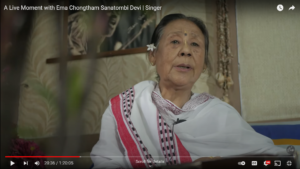
A Live Moment with Ema Chongtham Sanatombi Devi | Singer
Ema Chongtham Sanatombi Devi (b. 1938). If we take her story, for example, we see she started training in Nabadwip as a girl, having arrived there with her family as refugee from East Pakistan in 1947. Her guru Wangoi Chaobi Devi taught her kirtan such as Nimai Sanyas, Nouka Bilas, Man Bhanjan—the many episodes in the lives of Radha, Krishna and Sri Chaitanya Mahaprabhu.
Moushumi to Akhu (13 May 2021)
Firstly, can you please tell me more about how in this revivalist movement the politics of reclaiming, remembering and recreating has taken shape? What are the new forms and icons of the new identity? I think that with remembering is also attached the question of forgetting.
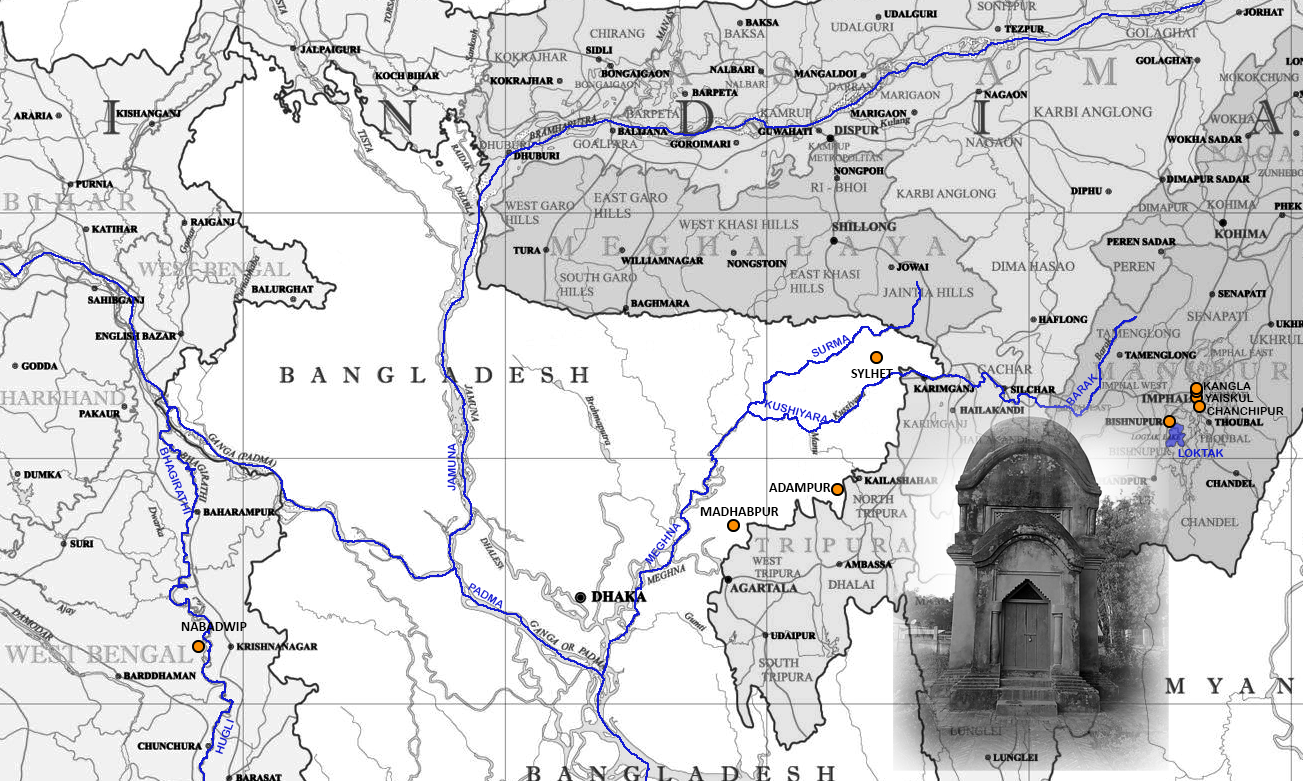
Map by Purba Rudra
Akhu to Moushumi (16 May 2021)
If you refer to the history of Manipur you will know how our own scriptures were burned down in the advent of Vaishavism in the 18th century.
18th and 19th century is even called ‘dark age’ in the history of our literature cos everything slowly replaced by Bengali. with the scripture, also our indigenous scripts called Meetei Mayek. What happened post the coming of Vaishnavism was a disaster culturally and traditionally. It totally changed everything. the society was divided. There were people who refused to follow the impositions of a foreign religion. These sections of the society are still present in today’s Manipur, in places like Kakching, Phayeng, Sekmai, Khurkhul, etc. (This is where i also do my annual festival “Where have all the flowers gone?”)
The revivalist movement that happened in early 20th century was started by this man named ” Naoriya Phulo”, He was from Cachar, Assam. He was successful in reviving our indigenous deity “Sanamahi”and then much later the most profound revivalist was Chingsubam Akaba, under his leadership the indigenous script “Meetei Mayek” was brought back forefront. Now it is taught in school and colleges officially. Akaba was shot dead in 2007 by some unknown persons.
There various other organisations that looks after our culture practices, they try their best to safeguard our culture and identity. But at times they can be quite annoying also as they are into moral policing. 🙂
Moushumi to Akhu (17 May 2021)
Everything cannot be erased, right? I mean, a language, yes, poets, yes. But what about the rhythms and melodies which have found a home in your land?
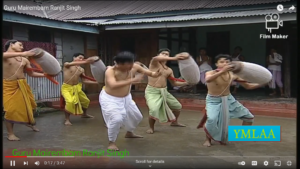
Akhu to Moushumi (16 May 2021)
Khol is very popular here. it is what is accompanied in Ras Leela. I used it once also in my recording.
It would be interesting to find out who actually went to Birbhum back then and from which school/gharana they learnt. I am sure the surviving gurus can shed some light on it.
Moushumi to Akhu (13 May 2021)
It would be so wonderful to trace what connections still remain despite the passage of time and changed political consciousness and context. I am always interested in listening to traces of the past in sound, because sound is ever layered and it carries so much history in its body. I think that even when they were singing Bengali texts in Manipur, the song was marked by the land and it would never have been a Bengali song. Similarly, today if the Bengali text is replaced by Meiteilon, or if the Bengali text is translated, then too the history that the Bengali text used to be sung once, that history will remain. It will remain inscribed in the new song too. This is what I mean by traces. We can try to dig into these songs, by removing layer after layer of knowledge, like an archaeologist. Treating sound as soil.
Akhu to Moushumi (16 May 2021)
Yes it will be very exciting to find traces of the past in these songs. We can study how it evolves in parallel to revivalist movements. I am sure All India Radio Imphal must be having old recordings of Sankirtan. it will be interesting to listen to these recordings.
Moushumi to Akhu (13 May 2021)
I know a Manipuri theatre director in Sylhet, Subhashis Sinha and it seems to me the reverse has happened there. There everything has got Bengalicised. Not many remain to sing the songs as they used to be sung fifty or 70 years ago. But the voice still carries traces, it still belongs to the past, and remains connected with other geographies. Those traces are carried in the style of singing. Something only a Manipuri will do, even if he or she has lived in a Bengali-majority land for half a century.
Bishnupriya Manipuri kirtan// jamthung, kamalpur
Akhu to Moushumi (16 May 2021)
Through my work with IFA, I worked for two years on the Manipuri Diaspora in Assam and Bangladesh. they have very interesting stories. Some of the music were made post the war in the mid 1970s, they were highly influenced by Rabindra Sangeet yet it is in Manipuri, so is the theme. These artists are still alive and they shared the stories how they started writing these songs out of compulsion as a minority in Sylhet. I am only grappling with these questions but would like to work on them. I do not have the depth of knowledge to deal with them. And I cannot do it alone. Will be great if we look into these things together.
Here is an article about my project on diaspora
The music album is available on youtube.
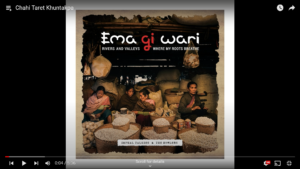
Moushumi to Akhu (2 June 2021)
Do you know about the theatre company Manipuri Theatre in Sylhet. The director is Subhashis Sinha. They are Bishnupuri Manipuris. I get confused as I don’t understand the subtle differences and do not know the history. His sister Sharmila is a beautiful singer. I did not know about her but have recently discovered her songs and I try to listen for traces of her ancestors’ voices in her voice. Sometimes she sounds like old Nazrul singers Firoza Begum or Suprabha Sarkar or Juthika Roy, and then she might be singing a Raslila song in Bangla, but from the way she uses her voice, I know that this could not come so naturally to a non-Manipuri. So, again, what we keep, what we have, what we might not be aware of–such thoughts come to my mind.
Subhasish sent me some kirtan recordings on youtube–clear Bengali diction, a very Nabadwip, Shantipur kind of Bangla, very Chaitanya-centric. But there are vocalisations here which I have heard in sankirtan.
Akhu to Moushumi (5 December 2021)
Today I recorded a sankirtan singer/performer named Thiyam Arun, who was a student of Lakpati. The recording was part of a museum of people’s music I am curating. I believe by the end of august [2021] i can share the audio. The artist could sing in bengali also. We did a bit of recording of it too.
The Manipuris in Bangladesh are three communities, Meetei, Meetei Pangal (Muslim) and Bishnupriyas. Meetei are the original Indigenous Manipuris in Bangladesh. Bishnupriya is a different ethnicity. I have been doing a bit of research on the Manipuri diaspora there. As the elders from Sylhet shared, there have been a lot of conflicts between the Meetei and Bishnupriyas. I am sure the Bishnupriyas must have their own practices and understanding of sankirtan. And it will be interesting to find out. Among the Meetei community in Sylhet also there are sankirtan singers.
As I said earlier, I am not an expert on sankirtan, I don’t think i am fit to write at length about sankirtan.
Moushumi’s correspondence with Shuvashis and Sharmila Sinha, Bishnupuri Manipuri artistes from Komolganj, Moulavibazar, Sylhet.
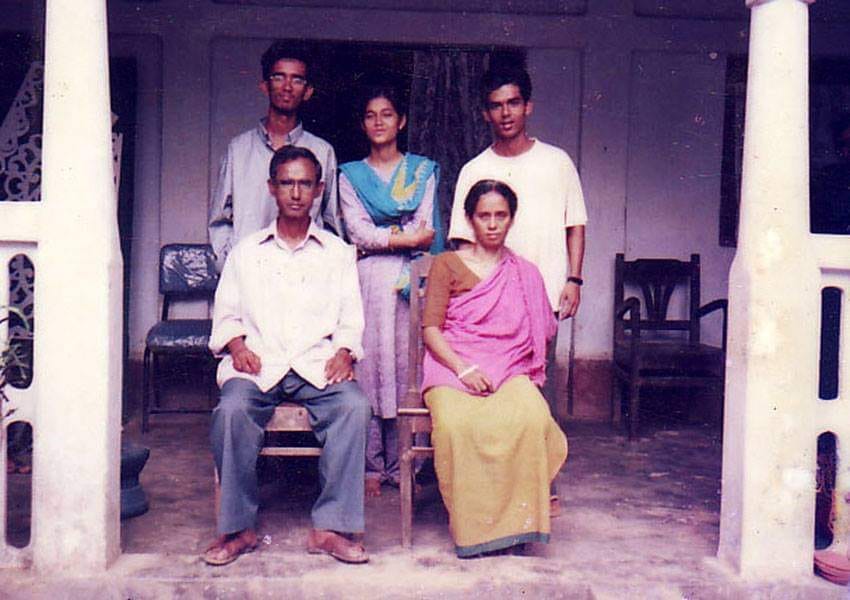
The Sinha siblings, from left to right, Shuvashis, Sharmila and Debashis with their parents in Kamalganj, Moulavi Bazar, Sylhet, Bangladesh. Shuvashis is a theatre director and runs Manipuri Theatre, a company which turned 25 this year. Sharmila is a singer and music director of their theatre company. Debashis is a paediatrician. Their father was a school teacher and mother too is a cultural activist.
[The following text is in Bangla, but there are interesting videos, so do scroll down and there will also be a description in English.]
কথা শুরু হয় শুভাশিসের সঙ্গে।
শুভাশিসকে মৌসুমী (12 May 2021)
প্রিয় শুভাশিস, তুমি বলেই লিখছি, আপনি লিখতে একটু অশ্বস্তি হচ্ছে। অম্বরীষদা’র কাছে তোমার অনেক গল্প শুনেছি। তুমিও আমার কথা শুনে থাকবে, হয়ত গানও। আমি আসলে যাঁকে নিয়ে গবেষণা করছি অনেক বছর ধরে, তাঁর নাম আর্নল্ড বাকে, তিনি হল্যান্ডের মানুষ ছিলেন। ভারতে এসেছিলেন ১৯২৫-এ, শান্তিনিকেতনে, প্রথম পর্বে ডক্টরাল স্টুডেন্ট হয়ে ছিলেন ২৯ পর্যন্ত, সেই সময় বাংলায় এবং ভারতের অন্যান্য অঞ্চলের গান ওঁকে আকৃষ্ট করে, মূলত রবীন্দ্রনাথের গান, আর বাউল কীর্তন, নানা কিছু। ৩১ সালে আবার ফিরে আসেন একটি মোমের সিলিন্ডারে রেকর্ড করার যন্ত্র নিয়ে, এবং আমাদের বঙ্গদেশে ঘুরে ঘুরে অনেক ফিল্ড রেকর্ডিং করেন, ১৯৩৪ পর্যন্ত, অন্য জায়গায়ও করেন, যেমন নেপালে। আমি বাকে সাহেবের বেঙ্গল রেকর্ডিং নিয়ে কাজ করছি। আমি ওঁর এক একটা রেকর্ডিং ধরে সেই মানুষ আর স্থান আর ইতিহাসের সন্ধানে ঘুরে বেরিয়েছি অনেক দিন ধরে। শ্রবণ দিয়ে কীভাবে আমরা ইতিহাস রচনা করতে পারি, সেটা আমার কাজের একটা দিক, আর আর্কাইভ কীভাবে তোইরি হয়, সেটা কাজের অন্য দিক। আর্নল্ড বাকেকে কীর্তন খুব টেনেছিল, গুরুদের কাছে কীর্তন গাইতে শিখেছিলেন, ওঁর তৃতীয় দফায় ভারতে আসা (৩৮-৪৫) এবং থাকার শেষ পর্বে এমনকি বৃন্দাবনে গিয়ে কীর্তন গেয়েওছিলেন। ১৯৩৩-এ বাকে ময়নাডাল বলে বীরভূমের একটি কীর্তনের পীঠস্থানে গিয়ে ওঁদের গান আর তাল রেকর্ড করেছিলেন, ময়নাডালে কীর্তনের টোল ছিল, সেখানে ছাত্ররা আসতেন বিশেষ করে খোল বা মৃদঙ্গ শিখতে। মণিপুর থেকেও ছাত্ররা আসতেন। ১৯৫৬ সালে বাকে সাহেব শেষবার ভারতে আসেন। তখন তিনি লন্ডনের SOAS-এ ভারতীয় সঙ্গীত এবং সংস্কৃত পড়ান। সেটা ওঁর স্টাডি লীভ ছিল। ইচ্ছে ছিল মণিপুরে যাবেন, কীর্তনের সন্ধানে। যাওয়া হয়নি। আমি আজ যখন বাকে কে নিয়ে কাজ করছি, তখন দেখার চেষ্টা করছি, আজ বাকে’র রেকর্দিং থেকে আমি কেমনতর শ্রবণের কাছে পৌঁছতে পারি। মণিপুরে বাকে যেতে পারেননি। কিন্তু যেতেন যদি কেমন কীর্তন শুনতেন। আজ সেই কীর্তন কোথায় দাঁড়িয়ে আছে? আমি পড়ছিলাম ৬৩ সালের একটি লেখায়, একজন মেইতেই স্কলারের লেখা, যে তখন যে টেক্সট গাওয়া হতো তা বাংলায় ছিল। অথচ মনীপুরের নিজস্ব গায়নে, উচ্চারনে সেই গান মনিপুরি কীর্তনই হয়ে যেতো, এক আশচর্য সংমিশ্রন ছিল অতএব সেই সংকীর্তনে। আজ তোমাদের দিকে সব গান শুধু বাংলাতেই হয়। মণিপুরের নিজস্ব ভাষায় হয় না। ওদিকে মণিপুরে আমার পরিচিত শিল্পী এবং স্কলারদের বক্তব্য হলো, ওখানকার পুনর্জাগরণ (revival) অন্দোলনের ফলে বাংলা সম্পূর্ণ মুছে দিয়ে শুধু মেইতেই ভাষাতেই ওঁরা এখন সংকীর্তন করেন। জাস্টিস আসলে ওইভাবে হয় না, পুরনো আধিপত্যকে আমরা কেবল নতুন আধিপত্য দিয়ে replace করি। আমার সেইরকমই মনে হচ্ছিল।
তোমরা যেহেতু এহেন চর্চার ভিতরে আছ, তোমাদের ওখানে কেমন কীর্তন হতো আর আজ কেমন হয়, সেই বিষয়ে আমাকে বলতে পারো। পুরনো রেকর্দিং থাকলে আমায় দিতে পারো? আজ কেউ যদি গান, তোমার আশপাশের কেউ, তাঁর গানের কিছু নমুনা রেকর্ড করে আমায় পাঠাতে পারো। তোমাদের ওখানে মণিপুরী মুছে যাচ্ছে, এদিকে বাংলা।
আমার এই ভাবনার সম্পর্কে তোমার কী মনে হয়? জানিও। তোমার চিঠির অপেক্ষায় থাকবো।
মৌসুমীকে শুভাশিস (14 May 2021)
দিদি, আমাদের এখানে যে কীর্তন গাওয়া হয় তা হরিনাম সংকীর্তন বা পদাবলী কীর্তন থেকে বেশ ভিন্নএখানে এই পরিবেশনা নটপালা নামে অভিহিতনটসংকীর্তনও বলা হতো এক সময়এটি গায়ন অভিনয় নৃত্যভঙ্গি বাদ্য ইত্যাদি নানান শিল্পরূপের এক ধরণের নাট্যিক প্রকাশ, যদিও গীত বা পদগীত তার মূল ভিতকিছু নমুনা পাঠাতে পারবএর পদগুলো বাঙালি বৈষ্ণব পদকর্তাদের রচনা থেকে গৃহীত হলেও গায়কীতে মণিপুরি সুর ও স্বর প্রক্ষেপণের সংশ্লেষ আছেআমিও এ নিয়ে বেশ অভিজ্ঞ নয়, আমি ইমপালসটা বুঝি,,অনুভব করি, আমাদের এখানেও অনেকেই মণিপুরি ভাষায় পালা গাওয়ার চেষ্টা করেন, পদ বাঁধেন, কিন্তু বাংলা ভাষার পদই বেশির ভাগ গী’ত হয় কখনো বা ব্রজবুলি…আরো কথা হবে
মৌসুমীকে শুভাশিস (2 June 2021)
দিদি, লকডাউনে সব বন্ধএখন তাদের সাথে বসা যাচ্ছে নাতাই কিছু লিংক দেব। পরিবেশ পরিস্থিতি অনুকূল হলেকয়েকটি পালার গান মোবাইলে ধারণ করে দেব।
ইনি বাংলাদেশের
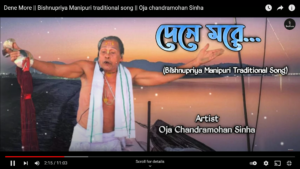
Dene More || Bishnupriya Manipuri traditional song || Oja chandramohan Sinha
এঁরা ত্রিপুরার
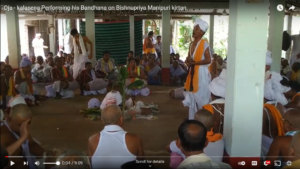
Oja – kalasena Performing his Bandhana on Bishnupriya Manipuri kirtan
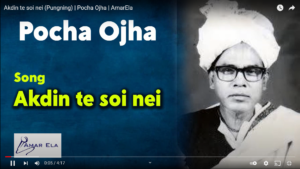
Akdin te soi nei (Pungning) | Pocha Ojha | AmarEla
শুভাশিসকে মৌসুমী (2 June 2021)
এই মেইতেই আর বিষ্ণুপ্রিয়া বিষয়ে কোনো লেখা থাকলে আমাকে বোলো। আমি বীরেন্দ্র সিংহ’র গানটা শুনছিলাম, উচ্চারণ এত বেশি পশ্চিমবঙ্গীয়।মানে, সিলেটের ভাবও নেই।
মৌসুমীকে শুভাশিস (2 June 2021)
সিলেটের ভাব থাকে না, মণিপুরি গায়নভঙ্গি ।
শুভাশিসকে মৌসুমী (2 June 2021)
সেটা কী করে হলো? অর্থাৎ, যে পরম্পরায় শিক্ষা, সেই পরম্পরা পশ্চিমবঙ্গের
উচ্চারণের কথা বলছি
মৌসুমীকে শুভাশিস (2 June 2021)
নদীয়া, নবদ্বীপ, পশ্চিমবঙ্গ সেখানকার পদকর্তাই বেশিতাদের রচনার যে ভাষিক প্রকাশ, তার অনুসরণ করা হয় বোধহয়। আমি একজন বড় পালাকারের নাম্বার দেব, আলাপ করে নেবেন একটু, দিদি
শুভাশিসকে মৌসুমী (2 June 2021)
ধরো, তোমার দিদির যে গান, তাতে কিন্তু অঞ্চলও ধরা আছে, এক ফাঁকে আঞ্চলিক উচ্চারণ শুনতে পাওয়া যাবে। এখানে সেটা হচ্ছে না কেন, আমি ভাবছি
মৌসুমীকে শুভাশিস (2 June 2021)
ভাষাটাকে শুদ্ধভাবে ধরাটাও তাদের আকাঙ্ক্ষায় থাকে হয়তো বা
সেটাও এক অর্থে রিচুয়াল
ডিকশনাল রিচুয়াল।
শুভাশিসকে মৌসুমী (2 June 2021)
আমিও তেমনই ভাবছিলাম। এটাই শিক্ষার রীতি।
পারফেক্ট, এই ডিকশনাল রিচুয়াল কথাটা।
ইম্পাল টকিজ ব্যান্ডের আখু চিঙ্গাম্বামকে চেনো? ও তোমাদের ওদিকে গিয়েও কাজ করেছিল। ওদের ওদিকে বাংলা টেক্সট ওরা বর্জন করে একটা নিজের ভাষা আর আইডেন্টিটি রিক্লেইম করার প্রক্রিয়ার ভিতর দিয়ে গেছে, যাচ্ছে, বলছিল। যাঁরা বাংলা গান গাইতেন, তাঁরাও বাংলা না জেনে স্রেফ গানগুলো শিখেই গাইতেন। ওদিকে তোমাদের ওদিকে বাংলার আধিপত্যে তোমাদের নিজেদের ভাষা শুধু না গানের ভাবেরও হয়ত বাঙালিকরণ হয়েছে। এই আইডেন্টিটি পলিটিক্স নিয়ে ভাবছিলাম এই কীর্তনের কন্টেক্সট-এ। তাহলে এই শিল্পীরা কোথায় মণিপুরী। আর ওখানকার শিল্পীরা কোথায় বাঙালি, এখনো? কারণ সবটা তো মুছে যায় না।
আখু একজনের গান আমায় শুনতে দিলো, কীর্তন না। সিলেটের মণিপুরী। ধরো, এতে তো লতা মঙ্গেশকরের লগ যা গলে, আর মৌবনে আর মৌ জমেছে আর কত কত সুর মিশে আছে। থাকারই কথা।
মৌসুমীকে শুভাশিস (2 June 2021)
হ্যাঁ দিদি, খুবই প্যারাডক্সিক্যাল ব্যাপার।
কথা শুরু হয় শুভাশিসের সঙ্গে, ওর দিদি শর্মিলা কথোপকথনে জড়িয়ে যায়। অগাস্ট ২০২১ থেকে ব্যাপারটা এমন দাঁড়ায় যে,শর্মিলা আর আমি গল্প করি রাত ধরে।
শর্মিলাকে মৌসুমী (10 August 2021)
আমি একভাবে ভাবার চেষ্টা করেছি, যদি ১৯৫৬ তে বাকে সাহেব মণিপুরে যেতেন, কী শুনতে পেতেন? মণিপুরে ইতিমধ্যে revivalist আন্দোলন শুরু হয়ে গেছে, প্রাক-বৈষ্ণব ইতিহাসের দিকে ওরা ফিরে যেতে শুরু করেছে, বাংলা,বাঙালি, বৈষ্ণব সংস্কৃতিকে ঔপনিবেশিক আগ্রাসন বলে চিহ্নিত করতে শুরু করেছে, যেমন করে ওদের প্রাচীন লিপি, পুঁথিকে বিলুপ্ত করা হয়েছিল, তেমন করে বাংলাকে মুছে দেবার চেষ্টা শুরু হয়ে গেছে। আমি আমার কাজে ইতিহাসের অস্পষ্ট রেখা, হারিয়ে যাওয়া, মুছে দেওয়া রেখা যে সম্পূর্ণ মুছে যায় না, তাকেই দেখার চেষ্টা করেছি। যেমন তোমরা একটা সম্পূর্ণ বাংলা সংস্কৃতির ভিতরে থাকো, কিন্তু তবু তোমার কন্ঠে, তোমার গায়নে মণিপুর রাখা আছে। কীভাবে থাকলো? কীভাবে মণিপুরের হারিয়ে যাওয়া সংস্কৃতির দিকে ফিরে যেতে শুরু করলো মণিপুরের মানুষ? কিছু সূত্র ছিল বলেই তো পারলো? আবার, আজ যে বাংলাকে মুছে দিচ্ছে, সবটা কি মুছে যাচ্ছ? যেতে পারে কি? আমি গানের ভিতর এই অস্পষ্ট রেখাগুলোকে শোনার চেষ্টা করতে চাই। এ-ই হলো ব্যাকগ্রাউন্ড। ফলে ধরো একটু বয়স্ক যাঁরা (তোমার গুরুর ওপর প্রিয়াঙ্কা চৌধুরীর লেখাটা পড়লাম) তাঁদের সঙ্গে একটু কথা বললে,তাঁরা গাইলে, এই দ্বান্দ্বিকতাটা হয়তো একভাবে ধরা যাবে।
একেও এক মৌখিক সংস্কৃতি বলা চলে। শুনতে আসলে পাওয়া যায়, আমি তোমার গলায় শুনতে পাই এমন কিছু যা তোমার অতীত থেকে আসা। এই সব কথা কি আর ক্ষুদ্র বাক্সে [Messenger-এ মেসেজ চালাচালি হচ্ছিল] লিখে বলা যায়? এতো গেয়ে গেয়ে, কথায় গল্পে বুঝতে বুঝতে চলি আমরা। তবু তুমি দেখো, যেমন করে তোমার ভাবনা এগোয় , আমায় জানিও। তোমার গুরুর কথা, গান এমনিতেও রেকর্ড করে আমার আর্কাইভে রাখলে ভালই হবে, তাই না? কথা বলবে যখন তখন একটু ভিডিও ও কোরো। আর মায়ের সঙ্গেও তো বসে কথা বলে রেকর্ড করতে পারো, তাই না?
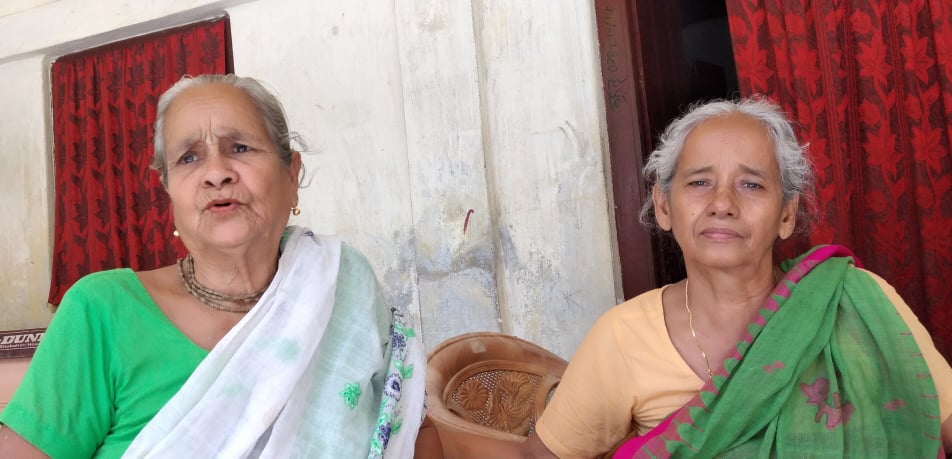
Sharmila’s mother Fazatambi Sinha and guru Krishnakumari Sinha.
মৌসুমীকে শর্মিলা (28 November 2021)
মৌলভীবাজার জেলার কমলগঞ্জ উপজেলায় মূলত মণিপুরিরা থাকি বিভিন্ন গ্রামে।আমাদের গ্রাম ঘোড়ামারা, জ্যোতিরও [actor, dancer Jyoti Sinha],ও আমার কাকাতো বোন।আমার গুরু থাকেন পাশের আরেকটা গ্রামে ‘মাধবপুর’ নাম। সেখানেই পাশাপাশি তিনটা মণ্ডপে আমরা ‘জোড়ামণ্ডপ’ বলি, সেখানে কার্তিক মাসে পূর্ণিমা তিথিতে মহারাসলীলা অনুষ্ঠিত হয় তিনটি মণ্ডপে তিনটা একযোগে, লাখ লাখ মানুষের সমাগম হয় সেদিন। দুপুর থেকে শুরু হয় গোষ্ঠলীলা, মেলা থাকে দু’দিনব্যাপী, মেলায় আমরা বইয়ের স্টল দেই রাত ১০/১১ টা পর্যন্ত, তারপর রাস ১১ থেকে শুরু হয় ভোর পর্যন্ত চলে।
আমি গুরুর সাথে কথা বলবো এ বিষয়ে, রেকর্ড করে রাখব আলাপচারিতা, তারপর পাঠাবো আপনাকে, কিন্তু একটু সময়সাপেক্ষ হবে হয়তো। এ ছাড়াও এ সম্পর্কিত তথ্যাবলী জানতে চেয়ে একজন গবেষকের কাছে মেসেজ করেছি, তিনিও বলেছেন দেখছেন তবে সবকিছুই একটু সময় সাপেক্ষ। আশা করি, কয়েকদিনের মধ্যে কিছু তথ্য আপনাকে জানাতে পারবো, দিদি।
গুরুর সঙ্গে কথাবার্তা। Conversations with her guru.
শর্মিলা বুঝিয়ে দেন এই কথোপকথনের অর্থ। Sharmila explains the content of this [telephonic] conversation.
গুরু শিষ্যের আলাপচারিতা, ভালোমন্দ জিজ্ঞাসাবাদ আর মাসী (গুরুর) কণ্ঠে রাসলীলার দু’একটি অঙ্গের কিছু গান।গানগুলি বাংলায় আর কথাবার্তা মণিপুরি ভাষায়।বিষ্ণুপ্রিয়া মণিপুরিদের ভাষা অসমীয়া-বাংলার মিশেলে গঠিত। সিলেটি শব্দও ঢুকেছে অনেক।এমনিতে কুশল জিজ্ঞেস করলাম গুরুর।
A conversation between guru and shishya, master and disciple. We start with a cordial exchange of greetings and everyday news. Then Masi (guru) sings some extracts from Ras Lila. The songs are in Bangla but the conversation is in Manipuri, with some Sylheti words thrown in for flavour.
তারপর গানের ব্যপারে জিজ্ঞেস করলাম যে, মাসীদের গলায় সুরের যে কারুকাজটা থাকে সেটা আমাদের গলায় থাকে না কেন, মাসী কার কাছে গান শিখেছিল ইত্যাদি ইত্যাদি।উত্তরে মাসী বললেন এটা তাঁর/তাঁদের সাধনার ফল। তিনি আমাকে আগে একবার দেখিয়েছিলেন গলায় থুতনির ঠিক নীচটাতে একটা জায়গা কাঁপিয়ে গলায় কারুকাজটা কীভাবে আনেন, সেটাকে তিনি বলেন ‘কালাবাতি’, সম্ভবত ‘কালোয়াতি’ হবে।সেটার উল্লেখ করলেন, তাঁর গুরুরা মণিপুর থেকে শিক্ষা নিয়ে এসেছিলেন, একজন সেনা সিংহ অন্যজন কামিনীমোহন সিংহ। তাঁদের কাছে নিরন্তর শিক্ষা গ্রহণ করেছেন, সাধনা করেছেন, অনেকগুলো রাসে সূত্রধারী করেছেন। আর আমাদের গলা একটা নির্দিষ্ট ছাঁচে ঢালা গান গেয়ে অভ্যস্ত হওয়ায় গলায় উঁচু নীচু এই মণিপুরি সুর বসতে সময় লাগছে, তবে তিনি আশাবাদী, একদিন হবে।
Then we talked about vocal technique. The embellishments which come to them so naturally, the classical style, ‘kalowati’ or virtuosity, which we find hard. She showed me how to do it, where the vibration under the chin should be. She told me how she had learned these things from her gurus, Sena Sinha and Kaminimohan Sinha. They had gone to Manipur for training.
আরও বললেন যে, এখন রাসলীলা গান কিছু কিছু মণিপুরি ভাষায় অনূদিত হচ্ছে, এটা বিভিন্ন স্টেজ প্রোগ্রাম বা বেতারে প্রোগ্রমের প্রয়োজনে গেয়েছেন কিন্তু রাসলীলায় বাংলা বলন্তা মানে পদকর্তাদের রচিত গানগুলোর যে ভাব, রস তা সেইমতো বজায় থাকে না বলে তাঁর বাংলাতেই এই ভাবরসের গানগুলো গাইতে ভালো লাগে এবং তিনি তাই করেন। সেইমতো গান রচিত হলে বা অনুবাদিত হলে সেটা অন্য কথা।
Then she said that now some Raslila and Natapala songs are being written in Manipuri, for the radio and stage. However, the ‘rasa’ or juices which the age-old Bangla poetry holds, is lost in the Manipuri. So, she prefers to sing in Bangla.
তারপর রাসে যুগলরূপবর্ণনার একটা গান ‘ভুবনমোহন রূপ’ গাইলেন। অভিসার অঙ্গের কিছু টুকটাক গানও করলেন। সেটা বাংলায় হওয়ায় নিশ্চয় বুঝতে পেরেছেন, দিদি।
She then sang a song describing the beauty of Radha and Krishna in union, jugalroop, ‘Bhubanomohonoroop’. She also sang some lines from the Abhisar chapter of the Radha-Krishna story in which Sri Radhika has set out on her own, in secret. to meet Sri Krishna.
মৌসুমীকে শর্মিলা (10 August 2021)
Sharmila gives a historical context for the Manipuri people’s adoption of Vaishnavism; to escape the repression of the Burmese rulers, she says. This is a different reading of history from Akhu’s.
দিদি, আমাদের প্রজন্মের শিল্পীদের গলায় সেই অরিজিনালিটি এখন আর তেমন নেই যেটা এখনও আমাদের মা বা মাসী (গুরু) র গলায় আছে।এটা হয়তো বিবর্তন বা অভিবাসনের প্রভাব। আমাদের পূর্বপুরুষেরা প্রায় ২০০ বছর পূর্বে মণিপুর থেকে বিতাড়িত হয়ে কিছু অংশ আসাম, ত্রিপুরায় আর কিছু অংশ বাংলাদেশে অভিবাসিত হয়েছেন।ধারণা করা হয়, পাহাড় ছেড়ে যখন সমতলে এসে বসতি স্থাপন শুরু হয় তখনই গলার মধ্যে মণিপুরের সেই Authentic সুরও আস্তে আস্তে বিবর্তিত হয়ে গেছে।যদিও এখন হিন্দুস্থানী ক্লাসিক্যালের সাথে রবীন্দ্রনাথ, নজরুল, অতুলপ্রসাদ, রজনীকান্ত, ডি. এল রায়, হিমাংশু দত্ত, এস. ডি বর্মণ ইত্যাদি ছাড়াও বাংলার বাউল, ফোক, কীর্তন, জারি, সারি, ভাওয়াইয়া, ভাটিয়ালী ইত্যাদির মিশ্রণের মাধ্যমে মণিপুরি সুরের অরিজিনালিটি অনেকাংশে চলে গেলেও পরম্পরাগতভাবে বা জিনগতভাবে কিছুটা হয়তো রয়ে গেছে।আর আপনি যদি কোনোদিন আমাদের এদিকে আসেন তবে দেখবেন, মণিপুরি জাতিগোষ্ঠীর মধ্যেপ্রায় সবারই গলায় সুর আছে এবং আমাদের পূর্ববর্তী প্রজন্মদের শিল্পীদের গলায় সুরটা এখনও মোটামুটি বজায় আছে।আমরা সংকরায়িত হয়ে গেছি অনেকখানি। কারণ আমরা বাংলা ভাষায় পড়াশুনো করেছি স্কুল, কলেজে। আমাদের সাংস্কৃতিক পরিবেশ, প্রতিবেশ বাংলা পরিবেষ্টিত। আমরা ছোটবেলা থেকে বাংলা গান শিখেছি, বড় হওয়ার পর নিজের সংস্কৃতি নিয়ে সচেতন হওয়ার পর আমরা ফিরে তাকাতে শুরু করেছি।তাই আজ আমার গানের গলার সাথে একজন বাঙালির গলার তেমন কোনও তফাৎ নেই, গভীর মনোযোগ সহকারে শুনলে হয়তো কিছুটা ফারাক বোঝা যাবে।
বর্মিদের অত্যাচার থেকে আত্মরক্ষার উপায় হিসেবে মণিপুরিরা, বিশেষত বিষ্ণুপ্রিয়া মণিপুরিরা বৈষ্ণব ধর্মের অনুসারী হন এবং সেই সময়ে বৈষ্ণব পদকর্তাদের রচিত পদ আর সুরকে আত্মীকরণ করে এবং নিজের সুরের সাথে মিলিয়ে স্বাতন্ত্র্য বজায় রেখে একটা মৌলিক শিল্প তৈরি করেন।তদ্বকালীন মহারাজাদের পৃষ্ঠপোষকতায় এসব গড়ে ওঠে। যেমন, মহারাজ ভাগ্যচন্দ্র স্বপ্নাদিষ্ট হয়ে তাঁর রাজসভায় প্রথম নিজ কন্যাকে দিয়ে রাসলীলার আয়োজন করেন।
এসব আমার জ্ঞানলব্ধ।এর পরের বিষয়াবলী সম্পর্কে আমি অবগত নই তেমন, আমি আমার একজন মেসতুতো দাদার লেখা কিছু টপিক আপনাকে শেয়ার করবো পরবর্তীতে, তিনি এ সংক্রান্ত পড়াশুনো করেন বিশদ।
আর এ কয়েকদিন লকডাউনের কারণে মাসী (গুরু)র সাথে দেখা হচ্ছে না, আমি ফোনে কথা বলি তাঁর সাথে। কাল পরশু এ ব্যাপারে তাঁকে জিজ্ঞেস করব, তবে তিনি এ সব বিষয়ে কিছু বলতে পারবেন বলে মনে হয় না।আমাদের মণিপুরি গুরুরা তাঁদের পূর্ববর্তী গুরুদের থেকে রাসলীলা বা নটসংকীর্তন পালার লিখিত পদগুলি দেখে গুরু শিষ্য পরম্পরায় শিক্ষালাভ করেন। এগুলো তো বিশাল গবেষণার বিষয়।
শর্মিলাকে মৌসুমী (22 August 2021)
আমি তোমার এই লেখা আর ব্যাখ্যা কপি করে রাখছি। এই যে কথাটা যে দু’টো ভাষার মধ্যে চলাচল করে চলেছেন আর কিন্তু রাখা রয়েছে জন্মজন্মান্তর থেকে আর কিছু নতুন জমিতে নতুন ফসল ফলেছে–এইসব কথাই আমাকে নাড়া দেয়। তোমার গানও যদি পাঠাও, পাশাপাশি রাখতে পারি। এসব আমার ওয়েবসাইটের জন্য, দেখেছো হয়তো।
Sharmila sings a song from Raslila.
She writes about the song: মণিপুরি রাসলীলার একটি গান.. একটি ভীরু প্রয়াস…আমার মণিপুরি সঙ্গীতগুরু অজা কৃষ্ণকুমারী সিনহার প্রতি শ্রদ্ধা…’এই হেন নিশীথকালে’ অজাদের মুখে মুখে ফিরতে ফিরতে ‘ই হেন’ হয়েছে, আমিও সেইমতো গাইলাম।রাসে কৃষ্ণের রূপ বর্ণন অংশের শুরুটা এই গান দিয়ে হয়।
শর্মিলাকে মৌসুমী (25 October 2021)
এটা যে পাঠিয়েছ, এ তো অসম্ভব সুন্দর। আর, এটাই আমি বুঝতে চাইছিলাম। এউ যে বাংলায় গাইছ, কিন্তু কাকে গানের ভাষা বলবো? এ তো কেবল বাংলা গান না। এই স্বর প্রক্ষেপণ, এই সুর, এই কন্ঠস্বর, এই ভূগোল—এসব কোনো একটা ভাষা দিয়ে ধরা যাবেই না।
মৌসুমীকে শর্মিলা (25 October 2021)
একদম। ভাষা আর সুর বহু বছর ধরে এমন মিলেমিশে গেছে যে বাংলা পদকর্তাদের রচিত এইসব গান আজ মণিপুরি রাসলীলার গান হয়ে গেছে।
আর, এটা ২০১৯-এর জন্মাষ্টমীতে গাওয়া গান। ‘উঠিতে কিশোরী, বসিতে কিশোরী
কিশোরী নয়নতারা…’। মধ্যযুগের কবি বড়ু চণ্ডীদাস রচিত ‘শ্রীকৃষ্ণকীর্তন’ কাব্যগ্রন্থ থেকে নির্মিত আমাদের থিয়েটারের সোয়াএকঘন্টার প্রযোজনা ‘শ্রীকৃষ্ণকীর্তন’ এর একটা ছোট্ট অংশ।
এগুলি হলো মানত করা এক রাসলীলার রিহার্সেলের অংশ বিশেষ।
শর্মিলাকে মৌসুমী (28 November 2021)
আচ্ছা, একটা অন্য কথা জিজ্ঞেস করি। সাম্প্রদায়িক দাঙ্গা হয় যখন, নিদেনপক্ষে টেনশন সৃষ্টি হয়, তখন তোমাদের ওপর তার কোনো প্রভাব পড়ে? Are there communal tensions between the Vaishnava Manipuris and Bengali Muslims when there is tension between Hindu and Muslim in the country? Moushumi asks Sharmila.
মৌসুমীকে শর্মিলা (28 November 2021)
Actually, we live in peace and harmony here, Sharmila says.
সত্যি বলতে দিদি, আমরা চারপাশে মুসলিম পরিবেষ্টিত থাকি যদিও কিন্তু আমাদের সাথে ওদের সম্পর্কটা সৌহার্দপূর্ণ। এখানটা বেশ জনবৈচিত্র্যপূর্ণ। এখানে মুসলিম মণিপুরি, আমরা বৈষ্ণবানুসারী, বাঙালী, চা-জনগোষ্ঠী, শব্দকর, খাসিয়া ছাড়াও আরও ক্ষুদ্র জনগোষ্ঠীর সহাবস্থান আছে, মিলেমিশেই থাকি। আমাদের রাসে মুসলিম দর্শকদের আধিক্য দেখা যায় আর মেলায় তো সারা দেশ থেকে বিভিন্ন জিনিসের পশরা নিয়ে মুসলিমরাই আসেন।কোনোদিনই তেমন কোনও অঘটন ঘটে নি, তবে এবারের দুর্গাপূজোয় চা-শ্রমিকদের দু’একটা মন্দিরে ভাংচুর হয়েছে। এটা রাজনৈতিক স্বার্থেই হয়েছে বলে ধারণা করি, সাধারণ মানুষদের মধ্যে আসলে সাম্প্রদায়িকতার বীজটা এখনও গভীরে প্রোথিত হয় নি।
Related reading
শুভাশিস সিনহা, মণিপুরী সংস্কৃতির অন্তর্গত লড়াই ও রাসলীলা, পথিক, সাহিত্যের ছোট কাগজ,৯ নভেম্বর ২০১০।
In my doctoral research, I worked on Arnold Bake’s wax cylinder recordings from Bengal from the 1930s as a listener and a music practitioner and here in this concluding section, I am presenting a soundtrack which I have created by stitching various sounds and songs together. Let this soundtrack speak for itself, without too much explanation. All I can add here is some bits of information. I conceived this soundtrack and recorded myself partly at home and partly in Suchal Chakraborty’s Little Peak Studio in Kolkata. The parts I recorded at home on my Zoom H2N recorder in the middle of the night are intimate, but rough and noisy. You can hear me shuffling in my seat and turning pages of my book. I am not such a good recordist and do not have the skill to pay attention to technical perfection while performing and recording myself. The noises are audible and we did not try to erase them—let them be as they are. Such noises also contain critical information about the recordist and the context of the recording.
Then I carried my recordings to sound designer Sabyasachi Pal and together we sat and mixed the track, over two days. It is Sabyasachi who did the actual work of mixing; I merely told him what was on my mind.
This soundtrack is made of two main songs. Rabindranath Tagore’s composition ‘Amar Sonar Bangla’, which is also the national anthem of Bangladesh, and ‘Ami Kothay Pabo Tare’—the song of the nineteenth century composer Gagan Harkara. In my singing I move from one song to another, back and forth, as I stitch the two songs together, also bringing in the sounds from Bake’s wax cylinder recordings. In the course of this work I have realized that home and homeland are as illusory as the moner manush, the one whom the heart desires and for whom the search never ends.
On 15 May 2017, Bob van der Linden, Arnold Bake’s biographer had written the following email to me: ‘By the way, did you already visit “Pandit Nabadwip Brajabasi Sangit Mahavidyalaya”, 31 Haramohan Ghosh Lane, Calcutta? Perhaps they have something there (letters, photographs, stories)? I am still dying for a photograph of Nabadwip Brajabashi to include in my book. Also of course it would be great for your work. Love the idea of going there together… but unfortunately I won’t be in Calcutta, at least before November.’
(There is a whole range of spellings for both Nabadwip and Brojobashi—different scholars use different spellings. Bake wrote in one way, the family writes another, Bob van der Linden and Eben Graves in yet other ways. So, I too took the liberty and wrote my own way, more to suggest the sound of the name. Braja is more upcountry sounding, in Bangla we tend to have a more round sound).
I did indeed go to the house of Arnold Bake’s kirtan guru on 21 December 2017. The experience was quite curious, but I could not follow it up with more, and for my second trip I had to wait till May 2022, about which I have written in my post-script note below. For a long time I did not have much material to share on the website, barring a few photographs.
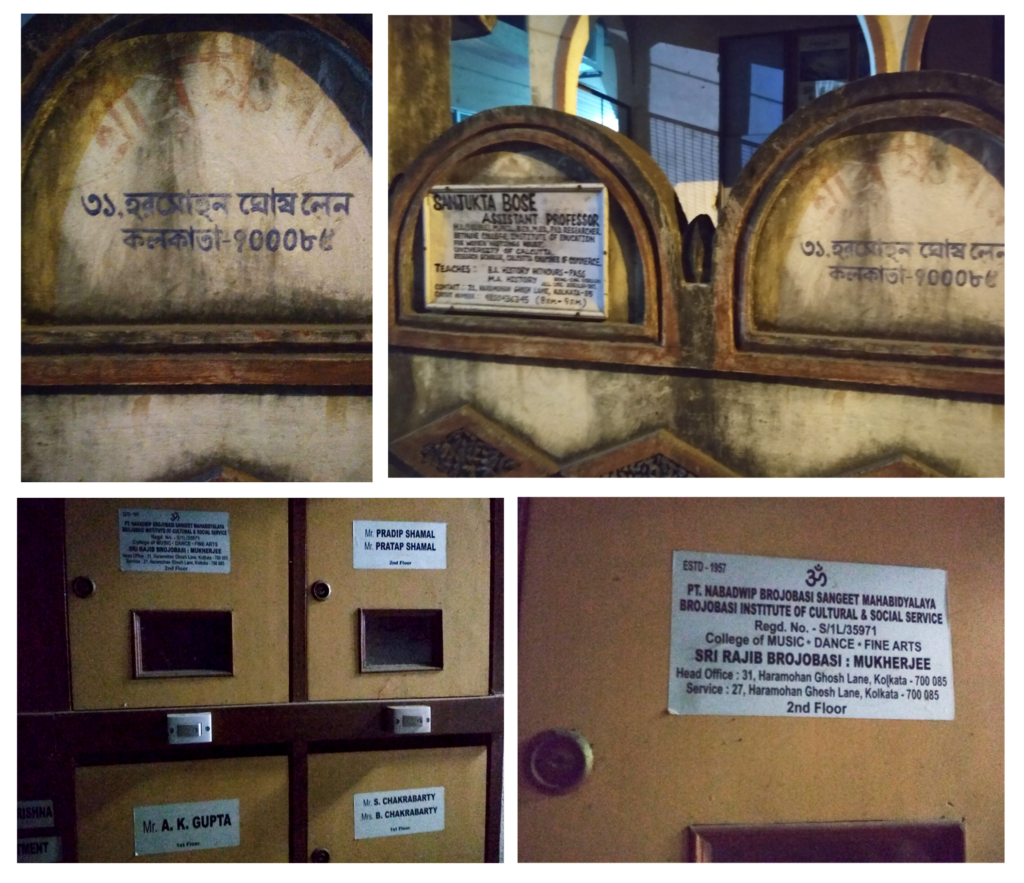
The original house on 31 Haramohan Ghosh Lane near Beleghata in east-central Kolkata must have been different from this apartment house, but some signs of the past are still intact.
Bob van der Linden’s biography of Arnold Bake came out from Routledge, in 2018. In it he wrote, ‘During his kirtan studies, Arnold became well acquainted with Professor Khagendranath Mitra (1880–1961) of the University of Calcutta, who studied the genre extensively. Indeed, he argued that saving it from extinction, and specifically from the hands of courtesans, “should be a national commitment of all Bengalis”. In addition, Bake came to know Mitra’s kirtan guru Nabadwip Brajabashi, who was born in Brindavan to a family of temple priest- proprietors. [… ] In general, Mitra and Brajabashi are credited with bringing the devotional genre of Vaishanavite kirtan to the attention of the Bengali elite (bhadralok). They not only standardized and shortened songs, but also connected the genre with a base of Sanskrit aesthetic theory to make it respectable for the bhadralok. As a matter of fact, Brajabashi was especially responsible for this. Together, they compiled an anthology of kirtan songs, Sri Padamrita-Madhuri or “The Sweet Elixir of Verse” (1910). At the time, Bake had only a few lessons with Brajabashi and made some recordings of his singing. During the early 1940s, however, he would study with him more extensively and embrace him as his true guru.’ (p.29)
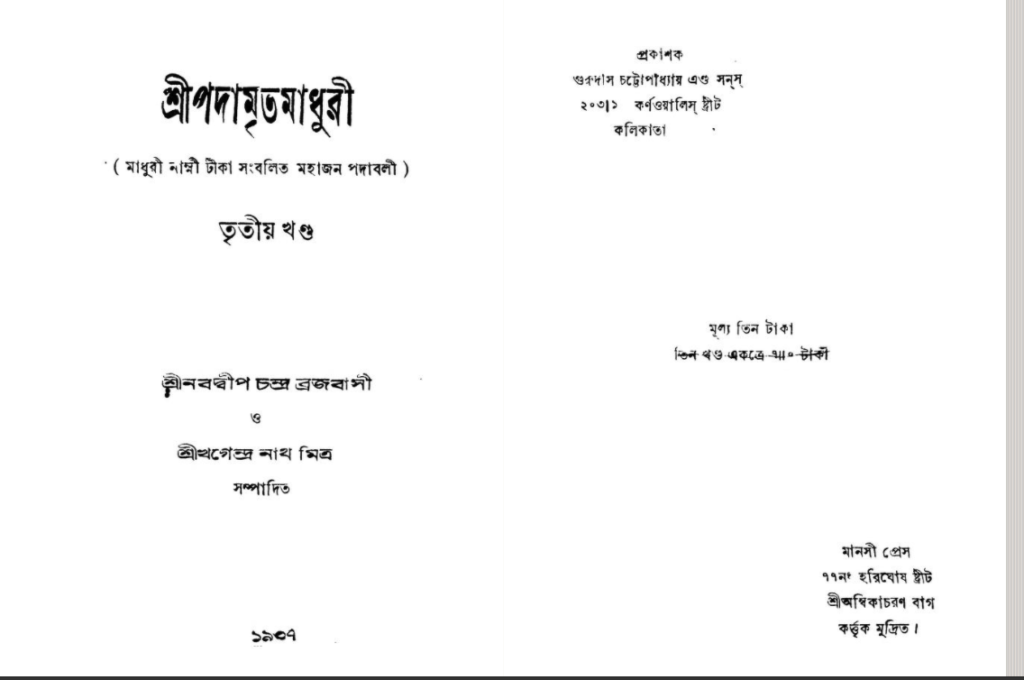
Sri Padamrita Madhuri by Khagendranath Mitra and Nabadwip Brojobashi
In 2017, ethnomusicologist Eben Graves who has a special interest in South Asian devotional music, wrote an essay entitled ‘Kirtan’s Downfall: The Sadhaka Kirtaniya, Cultural Nationalism and Gender in Early Twentieth Century Bengal’, about Khagendranath Mitra’s ‘mission’ to ‘establish padavali kirtan in bhadralok society. Mitra was a key actor in the formulation and promotion of the image of the sadhaka kirtaniya, a multivalent term that referred to a kirtan musician (kirtaniya) who was a sadhaka or “one who performs sadhana”.’ Brojobashi, Mitra’s guru, was such a religiously devout, musically skilled musician, who became part of a process of classicisation that worked to ‘distance Bengali kirtan from a group of female courtesan singers who performed in a popular devotional musical style known as dhap kirtan.’ This was a project in cultural nationalism and identity formation, in which Mitra played a leading role.
There were some elite women who fitted this image of the ‘sadhaka kirtaniya’ too. I am thinking of Chhabi Bandopadhyay, a student of Nabadwip Brojobashi. When we went to her shishya Seema Acharya’s home in February 2016, there was the shelf dedicated to Seema’s gods and gurus, on which stood the framed photo of Chhabi Bandopadhyay, alongside Baba Loknath, Anandamoyi Ma and idols of Radha-Krishna.
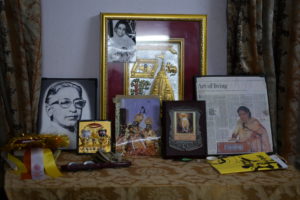
The shrine in kirtaniya Seema Acharya’s home. Kolkata, March 2016. Photo: Jan-Sijmen Zwarts.
Parallel to this, I am thinking of my visit to 31 Haramohan Ghosh Lane, where Nabadwip Brojobashi’s grandson, Rajib Brojobashi now lives. He wasn’t home that evening, but his wife opened the door. She said her husband was out for political work and her daughter was at work in Rajarhat-Newtown, in the I-T hub of Kolkata. She asked us to come in. As we entered the drawing room, some beautiful blown-up black and white photos of a most glamorous couple welcomed us from the wall. They looked like fifties’ film actors. ‘They are my in-laws,’ the woman explained. They were Nabadwip Brojobashi’s son and daughter-in-law who were professional dancers and travelled to many countries with their troupe. Gopal Chandra Brojobashi and his wife.
Rajib babu’s wife called him and introduced us over the phone; ‘Ram Ram,’ he greeted me.
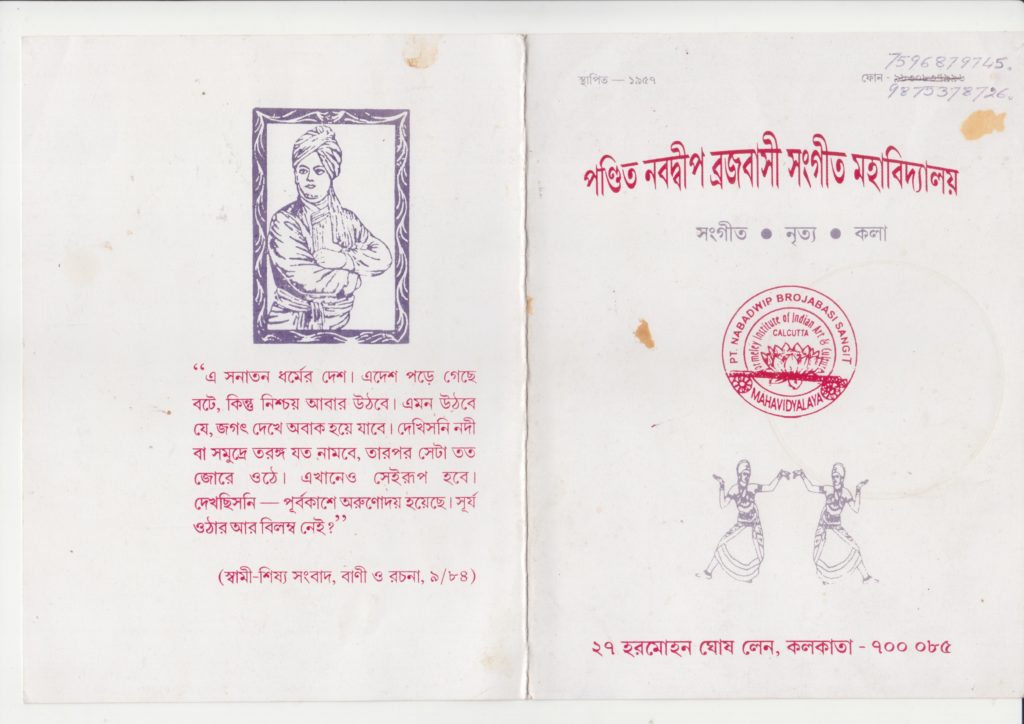
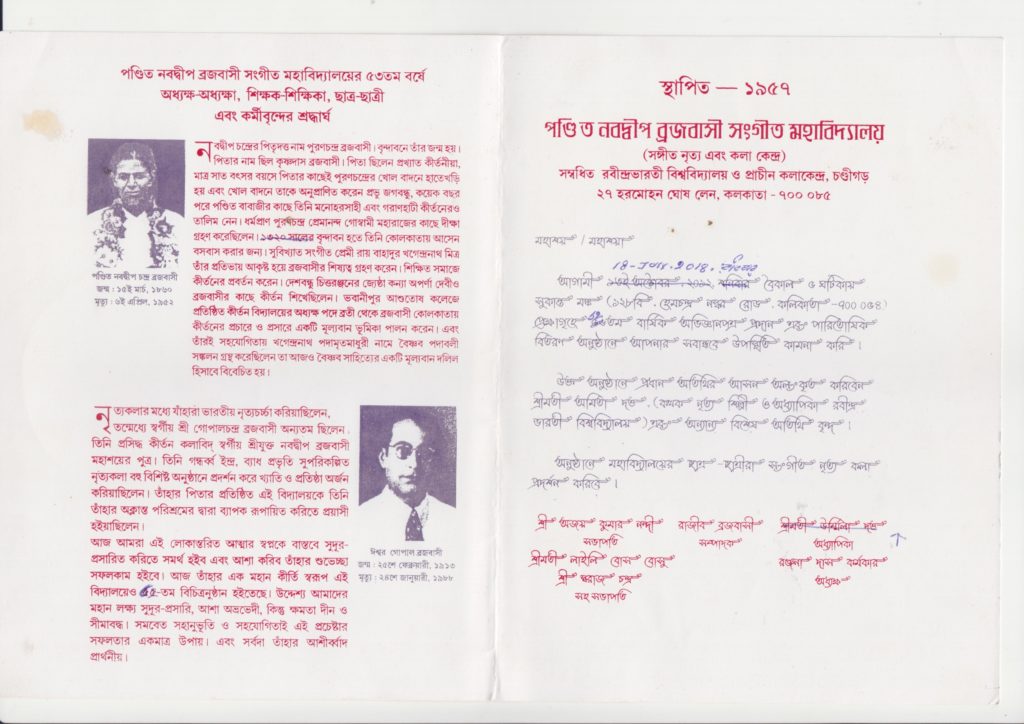
Programme of annual concert of Pandit Nabadwip Brajabashi Sangit Mahavidyalay, 2018
Rajib babu’s wife was unprepared for our visit (I went with my old friend, theatre director Sudipto Chatterjee and his actor wife Anwesha, who live in the neighbourhood), but she was also very kind. She did not know how to entertain us, what to say about her husband’s paternal grandfather. She told us that after the old building was taken down and this apartment house was built, the old temple was shifted to the top floor and the gods were newly housed there. We could see the temple if we liked, she said. So, we went up and she opened the collapsible gates and the locked door of the temple, and turned on the light. A Chinese Laughing Buddha with LED lights, waved and greeted us, while a chime started to play. There, among the many gods and goddesses, were photos of Nabadwip Brojobashi, Balak Brahmachari as well as Brojobashi’s dancer daughter-in-law.
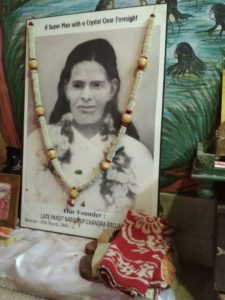
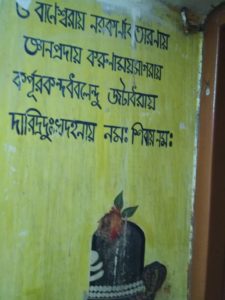
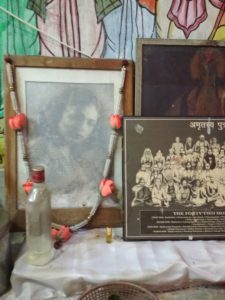
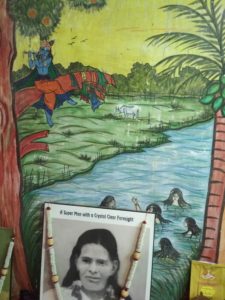
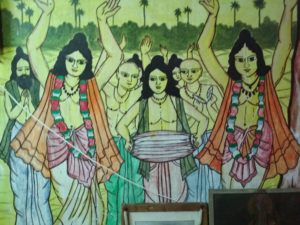
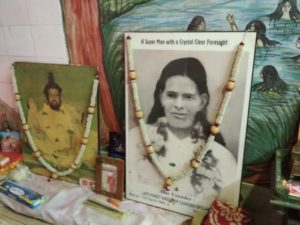
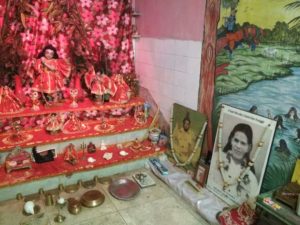
Temple on the terrace, 31 Haramohan Ghosh Lane, Kolkata 700085
There is so much left to know and I do want to go back to 31 Haramohan Ghosh Lane. I sense a continuity in this story of nation-building. From Vrindavan, to singing and teaching in Calcutta’s elite circles of the Rai Bahadurs through representing India as cultural ambassadors to the ‘Ram Ram’ greeting and working for global capital in Sector V, here is a story of a journey of not just a family but also of a nation. A story which begins for us in the circular motions of a wax cylinder numbered 98, Bake Indien II of the Berlin Phonogramm-Archiv, recorded in Calcutta on 5 January 1932.
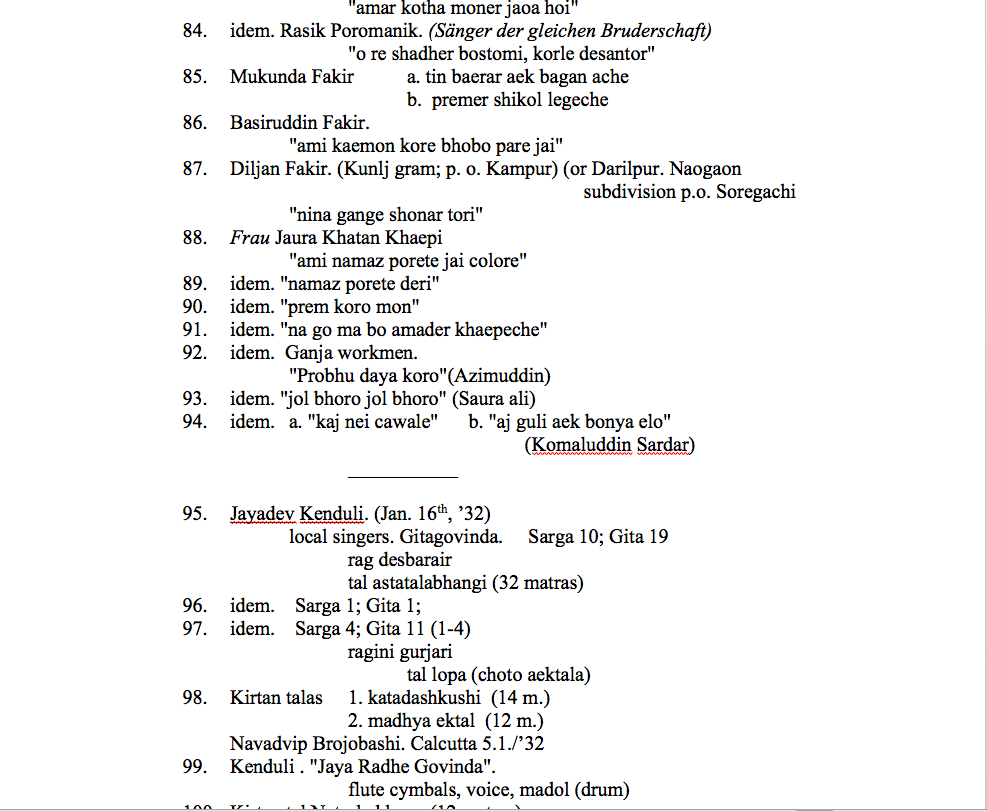
Arnold Bake cylinder documentation from Berlin Phonogramm-Archiv. Copy of file shared with me in 2016.
Postscript, 15 May 2022
Over four years have passed since I went to Beleghata, in search of Nabadwip Brojobashi. But all along I knew that I would have to go back to his home. Then, on 15 May 2022, Sunday, I finally went to meet Rajib Brojobashi, Nabadwip Brojobashi’s grandson. I did not know where he would be, as I was not being able to reach him on the phone number I had. So, I just took a chance. By now I have submitted my thesis and there is no real hurry to finish anything.
I went with a friend to Haramohan Ghosh Lane and as I was a little confused about the exact location of the house, I asked people in the neighbourhood and they said I would find Rajib babu in his music school. So that is where I went. He was not expecting to see me but he was very warm and generous with his time, although he did seem awfully busy. He said, it was good I had come on a Sunday, as he worked in the school during weekends and did not leave the neighbourhood. Rest of the week, there was no knowing where he could be. Although he was retired now from his government job in the tax department, he had organisational work to do, which was likely political too. But I did not ask such questions.
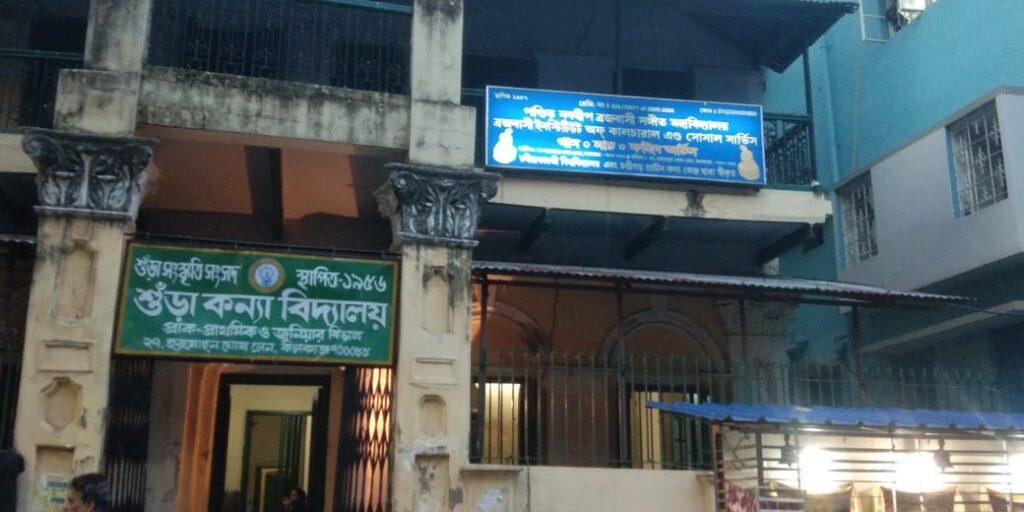
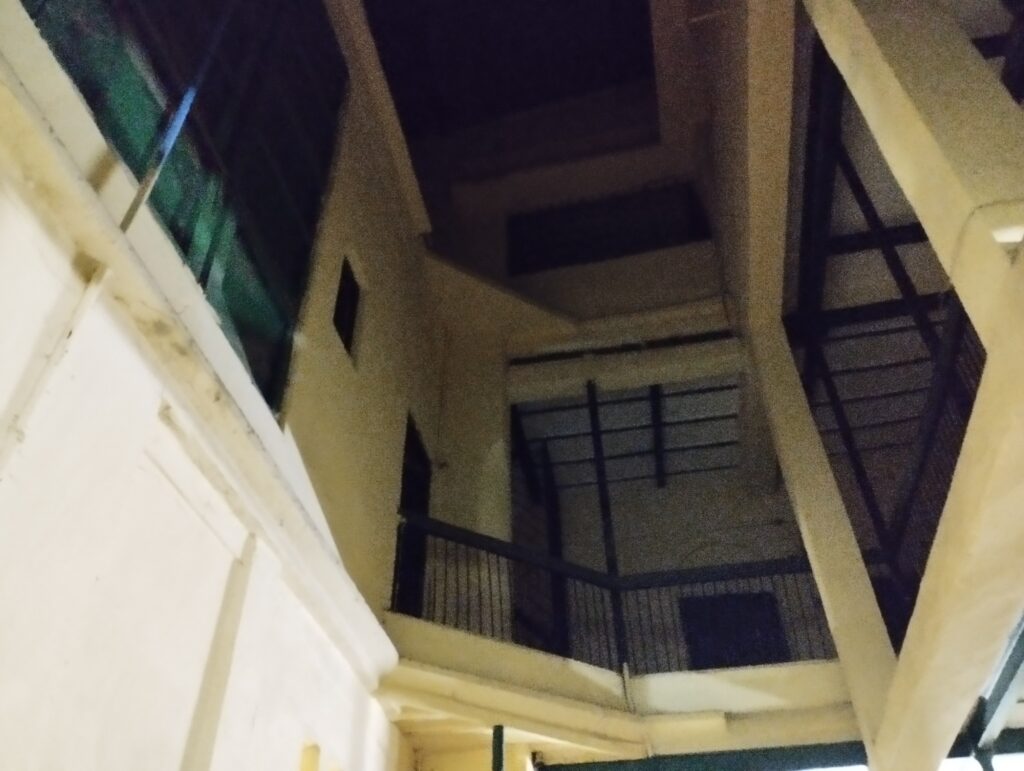
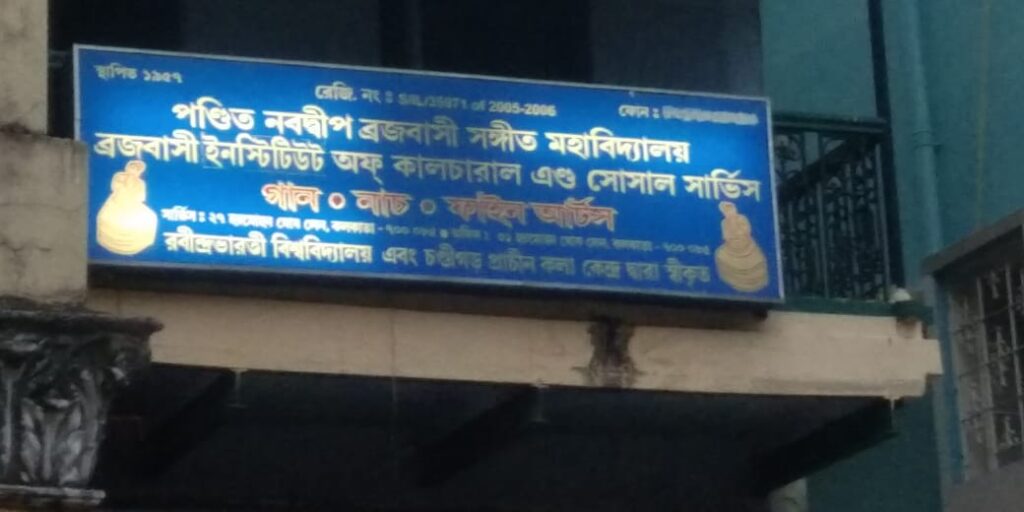
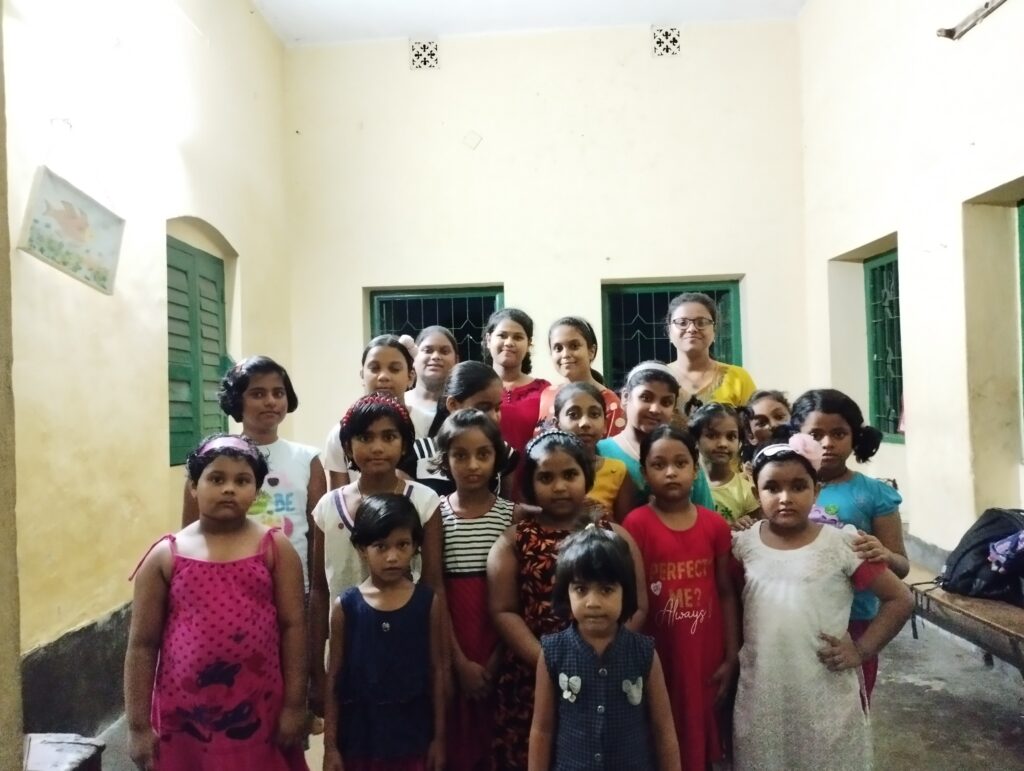
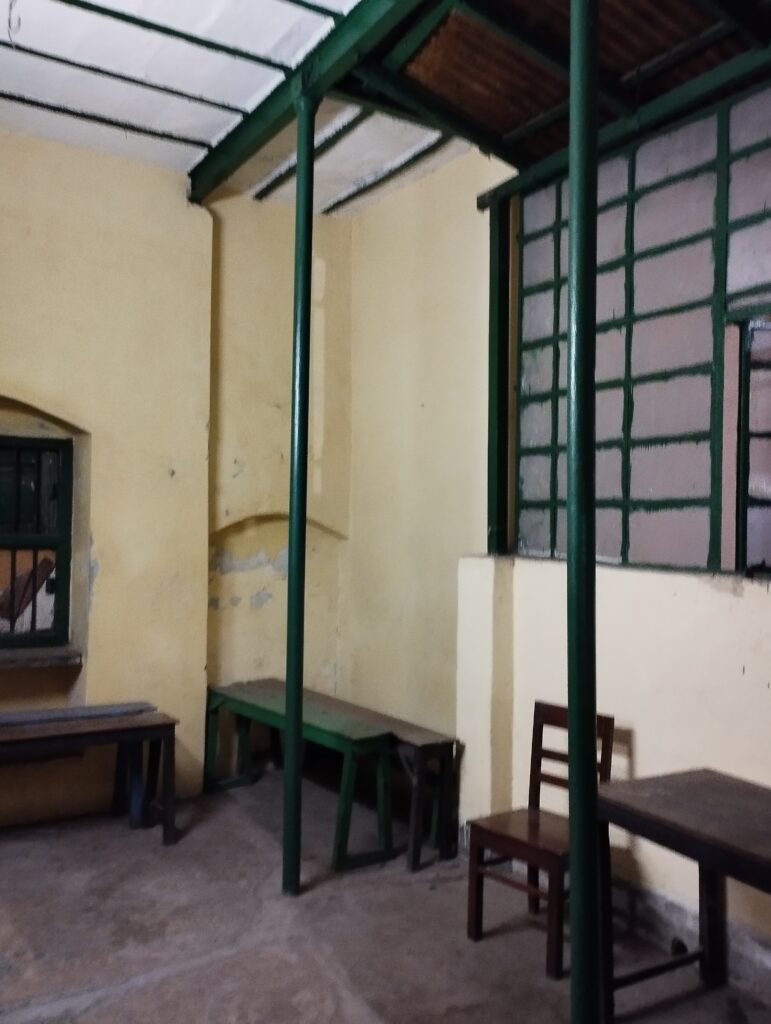
Pandit Nabadwip Brojobashi Sangit Mahavidyalay, 27 Haramohan Ghosh Lane, Beleghata, Kolkata 700085
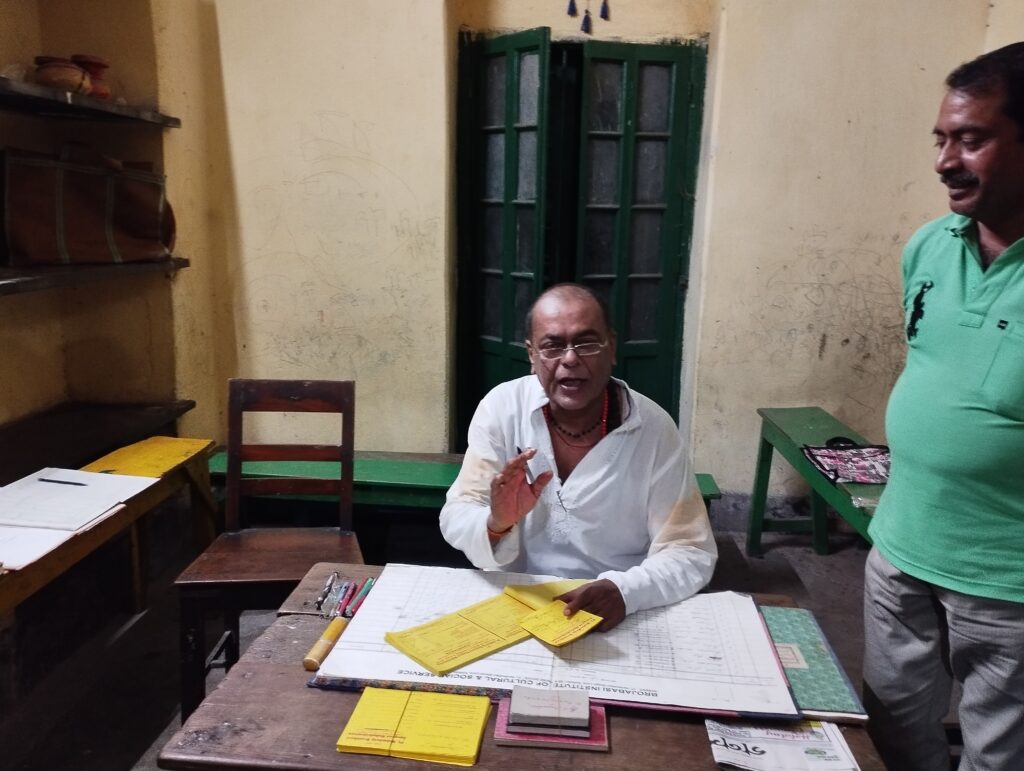
Rajib Brojobashi, who runs his father’s school now.
I explain my work to Rajib babu, tell him that I am interested to know about the trajectory from his grandfather at the turn of the twentieth century, through his own parents, down to him in his own time. Rajib babu says he will help me in whatever way he can, with photos and other details. He talks about their family of kirtaniyas, who hail from Vrindavan and the precious idol of Sri Krishna that one of their forefathers had found lying in a forest, and which Nabadwip Chandra’s father had brought with him when they migrated to Kolkata.
Rajib babu talked about his plans, with the school, about the asrams I could go to, to learn more about his grandfather and how he would take me to those places. His father had set up the school in 1953, a year after Nabadwip Borjobashi died. It was first called the Institute of Indian Art and Culture. Then, on the advice of kirtan scholar Khagendranath Mitra, historian Pratap Chandra Chandra and others, it was named after Nabadwip Borojobashi. He talked about how they came to set up their school in this beautiful old building. He talked about his mother’s family, his aunts who were all into dance and cinema. He talked about Partition and killings in Calcutta; stories he had heard from others. At the end of the conversation, it felt like there was so much left to know. And we made plans for more visits. Important people from the film industry and the world of politics, performing arts and police officials were connected with their lives from the time of Nabadwip Brojobashi down to the present time. I have to keep going back, as I have done with many of the other Bake recordings. One thing remains common in all these stories. It is the delight of listening to the voice of the ancestor, buried under the surface noise of the cylinder. As he listened, Rajib babu said, ‘I am getting goosebumps.’
Video recorded by Subrata Sarkar, 15 May 2022
Then Rajib Brojobashi took me home and I met his daughter Rakhi, who works for the IT company, Wipro. She was working from home on her computer. Like the first time I went, I was once again struck by the glamorous portrait of his parents, Gopal Chandra Borojobashi and his wife, Asha. I was struck because it stood out among the rest of the photographs and also the general ambience of the room. Above his parents was a framed photograph of Nabadwip Brojobashi, decorated with a saffron silk scarf. (I wonder why Arnold Bake never photographed his teacher.) On the right-side wall, there were portraits of various heroes of Bengal, red vermillion smeared on their foreheads—Swami Vivekananda, Netaji Subhas Bose, Sri Aurobindo. The rest of the wall was covered with photographs from functions in their schools and other events.
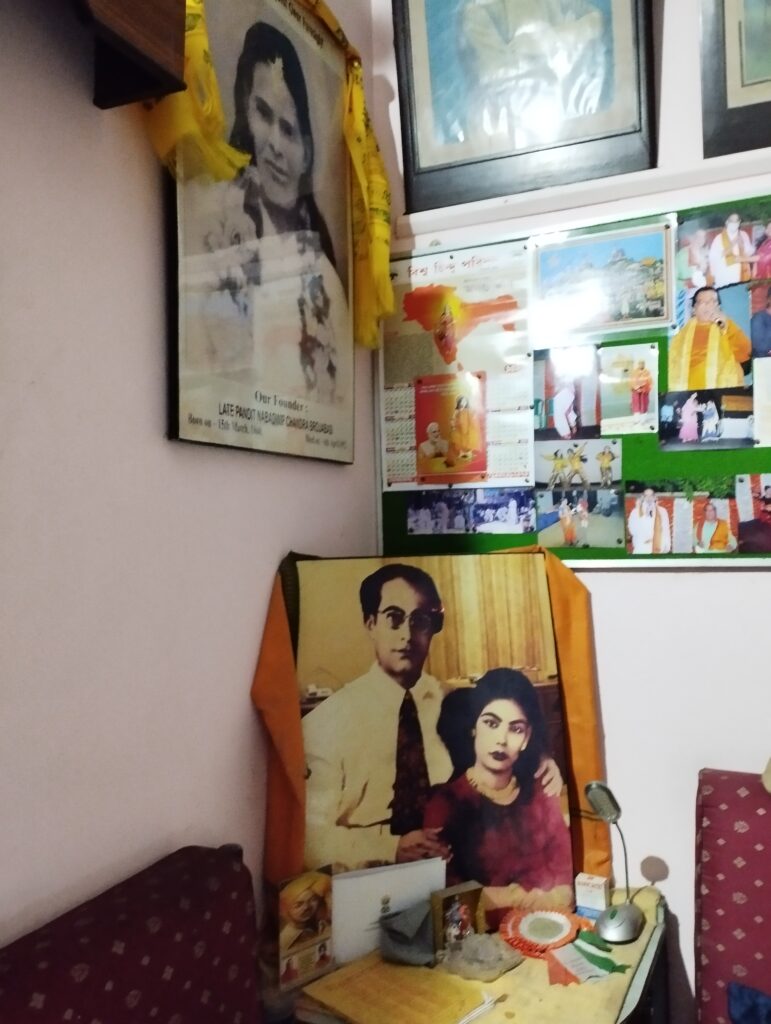
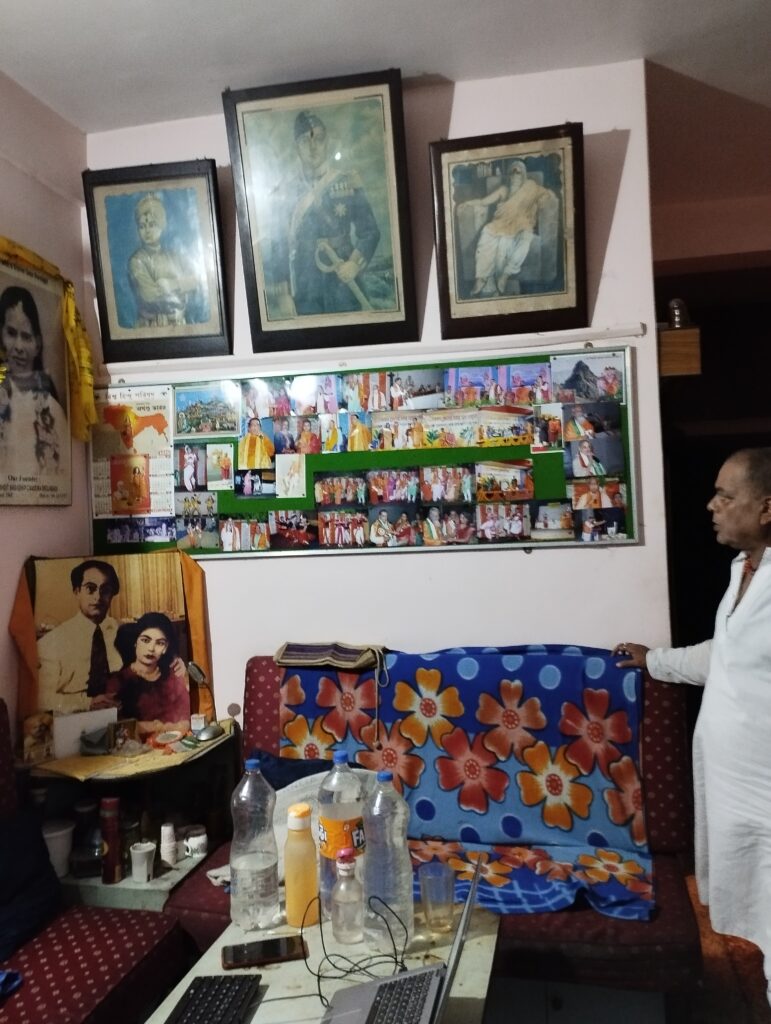
Recorded on my Zoom H2N on 15 May 2022.
It is interesting how in my work, different erstwhile unconnected places and people have got connected through the act of shared listening. Nirmalendu Mitra Thakur of Mainadal, whom I first met in 2014 and who has become something of a teacher over the years, has taught me how to listen to Bake’s recordings from not only his village, Mainadal, but also from Kenduli and Mongoldihi. Here is my telephonic conversation with Nirmalendu Mitra Thakur on Bake’s kirtan recordings from Kenduli and Mongoldihi on 22 January 2021.
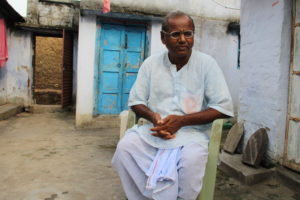
Nirmalda in the courtyard of his house in 2014
I had sent Bake’s kirtan recordings to Nirmalendu Mitra Thakur to listen and get back to me.
We begin talking on the phone. The conversation begins with Brojobashi’s recordings from 1932, Gourchandrika that Brojobashi sings in ‘madhyam dashkushi’ taal.
We move between the Kenduli kirtan (Badashi and Rati shukho shaare and Jaya Radhe Gobinda) and Brojobashi’s songs and there is a second one (Aaju Shyamo rasho rongiya). Nirmalda sings this song; he recalls learning this song from Gobindagopal Mitra Thakur, singing in chorus at Vrindavan.
Then we talk about Raash Utshob in Mongoldihi, the place of various instruments such as the shinga and shahnai in this music, the recordings Bake made. “Balaram used to play the shinga,’ he tells me. Nirmalda sings bits of song to explain more clearly.
The conversation ends with difficulties faced by kirtaniyas during Covid19 lockdown. Nirmalda explains how hard it has been for those like him who sing kirtan also for a living. Now there is no place to sing, hence no income either.
It is hard to sum up in one sub-chapter the life-story of Laksmisvar Sinha (1905-1977) and my many stories of looking for, and finding him, in many places. He should be a book, a film; he can be many things.
The spelling of his name that I have used is the spelling on Arnold Bake’s catalogue. He might have written his name as Lakshmiswar Sinha, because that is the spelling on his autobiography, in Esperanto.
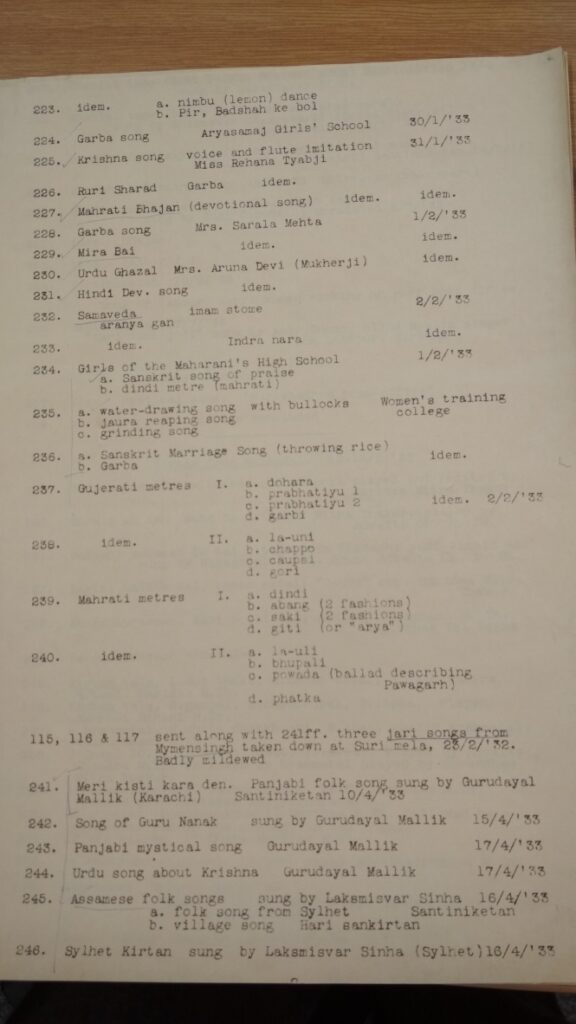
There are many versions of this catalogue with various archives which house Arnold Bake’s work. This is the original list, collectively produced by various scholars including Alistair Dick, based on Bake’s own papers. As scholars have worked on the cylinders, the notes have been revised. I have the same pages from the British Library, the ARCE, Berlin Phonogramm-Archiv and also what was shared by Amy Catlin-Jairazbhoy; therefore, the same list must be with UCLA too.
The British Library and the Berlin Phonogramm-Archiv’s catalogues had the following description for Bake India II, cylinder 245: ‘Assamese folk songs sung by Laksmisvar Sinha [recorded at] Santiniketan 16/4/’33 a. folk song from Sylhet b. village song Hari sankirtan’ (there are two songs on the cylinder). Assamese folk songs, but from a village in Sylhet? That got me thinking. When I listened, they were Bengali songs, not Assamese. This is what had initially drawn my attention. What then could Assamese mean in this context? It wasn’t too difficult a question. Bake must have written Assamese because Sylhet was part of Assam in the 1930s when he met Laksmisvar. In fact, from the time of the arrival of the British to the region in the mid-eighteenth century, right upto 1947 when it went to East Pakistan, Sylhet has swung between Assam and Bengal, belonging to one, then the other, back and forth. Then in 1971, when the nation of Bangladesh was born, it assumed another identity. It has a special place within Bangladesh too, for it is from here that large numbers of people have scattered to all regions of the globe, with a large diaspora in the UK. Besides, the Sylheti people of Cachar in Assam are geopolitically Indian, even partly Assamese in identity, but distinctively Sylheti too. Hence, when Arnold Bake recorded Laksmisvar Sinha’s songs in 1933, he wrote Assamese as a geopolitical marker and not a linguistic one. He did not record the name of Sinha’s village.
(Interestingly, the British Library catalogue has been revised from the time I first came across the above note around 2013, and in the latest version, the word Assamese has been erased. That to my mind has led to a kind of erasure of history. How to revise archival metadata but also also retain old traces?)
From 2015, owing to The Travelling Archive in East London exhibition when the British Library gave us copies of the recordings we requisitioned for display at the exhibition, and which anyway got copied on our own computers, I began to carry the Arnold Bake recordings wherever I went, and any occasion I got, I played the songs to those who might know something. After the Santiniketan exhibition in 2016, when the Berlin Phonogramm-Archiv gave us copies of a whole set of the Bake cylinders from Bengal as part of an unfinished collaboration, I had more recordings to journey with. Of course, the first few copies of Bake’s recordings that I had were given to me by the Archives and Research Center for Ethnomusicology, Gurgaon, when The Travelling Archive website was being launched in 2011. Therefore, on a visit to Sylhet in 2018, I thought of playing the songs of Laksmisvar Sinha to Ambarish Datta, my friend and guide in matters relating to Sylhet.
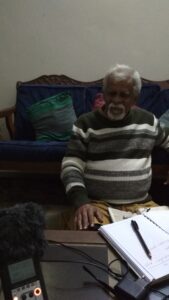
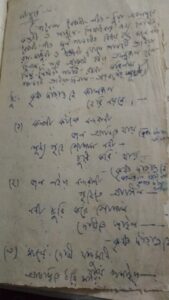
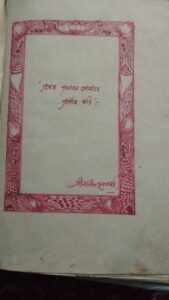
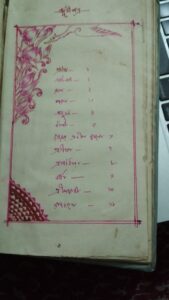
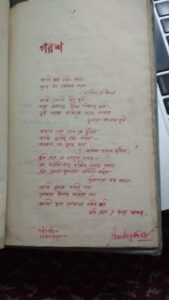
Ambarish Datta in his home on 18 January 2018. He comes from a Hindu Vaishnava family of musicians; his father, Anil Kumar Datta, was a well-known kirtan singer. Ambarishda has deep local knowledge about the varied cultural and spiritual traditions of Sylhet. I have travelled in the field with him on so many occasions, since 2006. Here he is surrounded by pages from his father’s handwritten anthology of songs.
In January 2018, I was in Sylhet to follow up on the sailors’ songs that Bake had recorded in 1934. On both 16 and 17 January, Ambarishda and I were moving around on the trail of the sailors. The following day, in Ambarishda’s home, we spent the evening talking about things. I wanted to also know about Ambarishda’s father and the kind of kirtan they sang in their home, at akhras and ashors (communities of Vaishnava singers and devotees). He told me stories about the teachers his father had, the types of kirtan they used to sing, the difference between the kirtan of West Bengal and that of Sylhet (‘Palit babu used to sing Pashchimbangiyo Manoharshahi kirtan’). He was touching upon questions of class and caste, and religion too, but it was all happening in the natural flow of the conversation. ‘There were Bijit Chowdhury, Harendra Bagchi, Dinen Saha of Kushtia, all of whom sang kirtan in Sylhet. There used to be a singer from Chandpur who used to come. Khol and kartal were the main accompanying instruments. Then there was Nader Chand Khan who played the sitar, esraj, flute and many other instruments, and whom I remember accompanying my father; by then he was an old man. Nader Chand’s home was in Brahmanbaria, and he came from the family of the famous Allauddin Khan. He had a Muslim name, but before Partition he played in the court and temple of the Hindu raja of Tripura. They had problems with someone with a Muslim name playing their religious music, which is why he took the name Nader Chand (নদের চাঁদ another name for Sri Chaitanya Mahaprabhu). He came over to Pakistan after 1947.’ Thus, tales were spun that evening, weaving myth with memory, while Ambarishda broke into song from time to time, remembering songs his father had taught him. The session however had started with me playing Laksmisvar Sinha’s cylinder recordings to Ambarishda. My Zoom H4N-recorder had developed a problem at this time and we can hear a constant noise in the recording.
Ambarish Datta and I talk in his home in the Uposhohor area of Sylhet town on 18 January 2018
With Arnold Bake’s Santiniketan recordings, just as they represent a range of sounds, experiences and histories, it is interesting how diverse my journey following those sounds has been. For some of the recordings, the sounds constitute a world of Santiniketan where the continuity from Bake’s time to the present remains unbroken. Which is why it was possible to easily meet people such as Kshitimohan Sen’s grandson or Indira Debi’s grand-nephew or Jaya Sen’s daughter and granddaughter. For some such as, say, G. Mapara, the sounds led to a lot of speculation, which had nothing to do with Santiniketan. With Pinakin Trivedi, the songs led to a whole rich Santiniketan archive kept with the family, but there is no memory of the man within Santiniketan and no awareness about his personal archive. Savitri Govind’s story is recorded in some memoirs and the recordings of her songs remain, especially because her story is woven with the birth of some iconic Tagore songs. But she is more material for musicological analysis than family history. Even if we think of all of them–including Gurudayal Mallik–as some kind of ‘outsider-visitors’ to asram, pulled in by the name and charm of Tagore, Laksmisvar Sinha had a far more sustained relationship with the place, built over a lifetime. He brought so much to Visva Bharati in the shape of manual work-based pedagogy and weaving patterns, taught there and lived on campus till the end of his life. Yet to find him, I had to begin my journey from his ancestral home, a place he had left a long time ago. Later I also found some of his traces in—rather, around—Santiniketan.
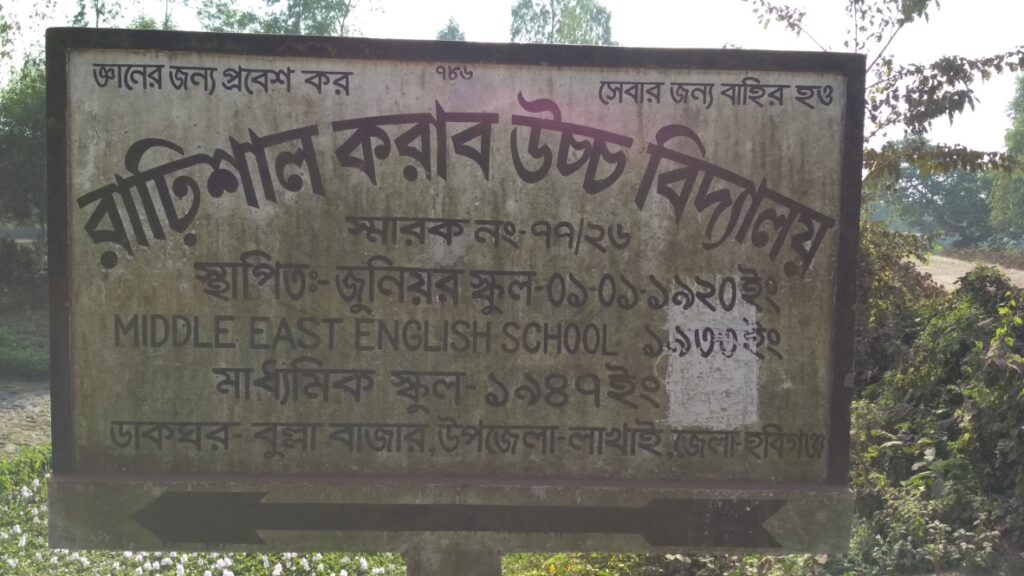
A signboard in Rarishal village. Photo taken by me during my visit in November 2018.
The songs I had played to Ambarish Datta in January 2018 had stayed with him and towards the middle of the year, he sent me a message to say that he had been able to locate the family of Laksmisvar Sinha. In November 2018, I went back to Sylhet and with Ambarishda went to Rarishal, the village in Habiganj district which used to be the home of Laksmisvar. The name Rarishal is interesting as the Sinhas had gone to Sylhet from the Rarh region in the west of Bengal in search of fortunes and gradually became rich and powerful landowners in this village in the far east of Bengal (Rarhishal is a more accurate spelling, but since the official spelling in Bangladesh is Rarishal, I am sticking to it.). I went there on 19 November 2018 and met Laksmisvar Sinha’s extended family—that branch which never left the village, and don’t intend to either, while many did at various points of time, especially after Partition in 1947 and the Bangladesh Liberation War of 1971. Those I met had never seen Laksmisvar. The oldest person I met, 68 at the time, Dilip Sinha Chowdhury, was a distant nephew. He said he had heard Laksmisvar Sinha’s stories from the latter’s brother, Jogeswar, who had remained in the village for much longer. They said there was a songbook in which Laksmisvar Sinha had written down many of the kirtans they sang in their family—they could not find it while we were there and haven’t found it yet. I often send messages to Bappi (Sanjit Sinha Chowdhury), a young man who would be some great grand nephew of Laksmisvar, and ask him to look for the book. Bappi does political theatre, and goes by the name of Bappi Sramik (Worker Bappi) on Facebook. Each time I ask, he politely says, ‘I am looking Didi.’ They are all perfectly aware of the rich history and heritage of their family and when we went, they showed us a family tree going back some fourteen generations. I played them Laksmisvar Sinha’s songs and made recordings as they listened and sang.
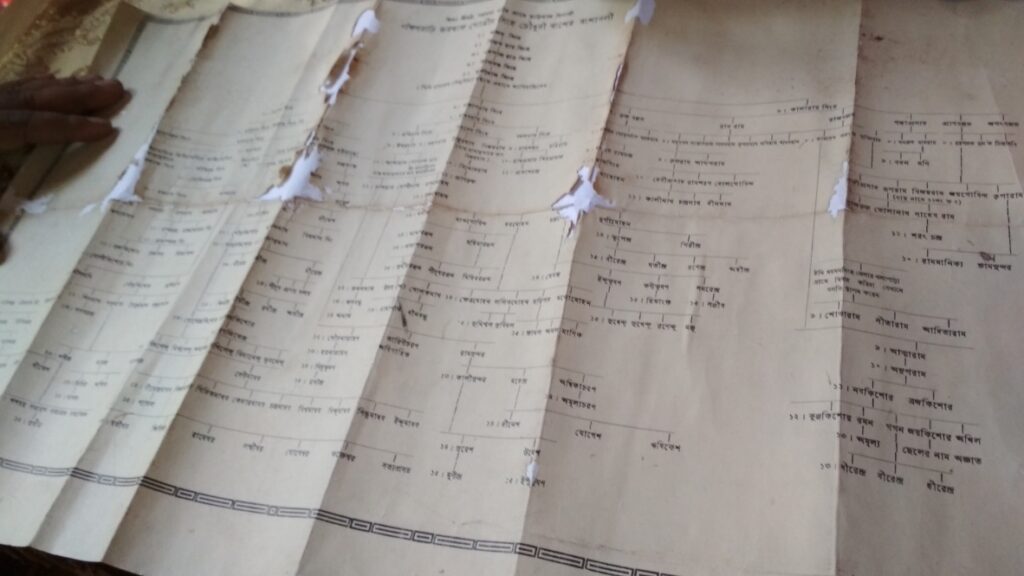
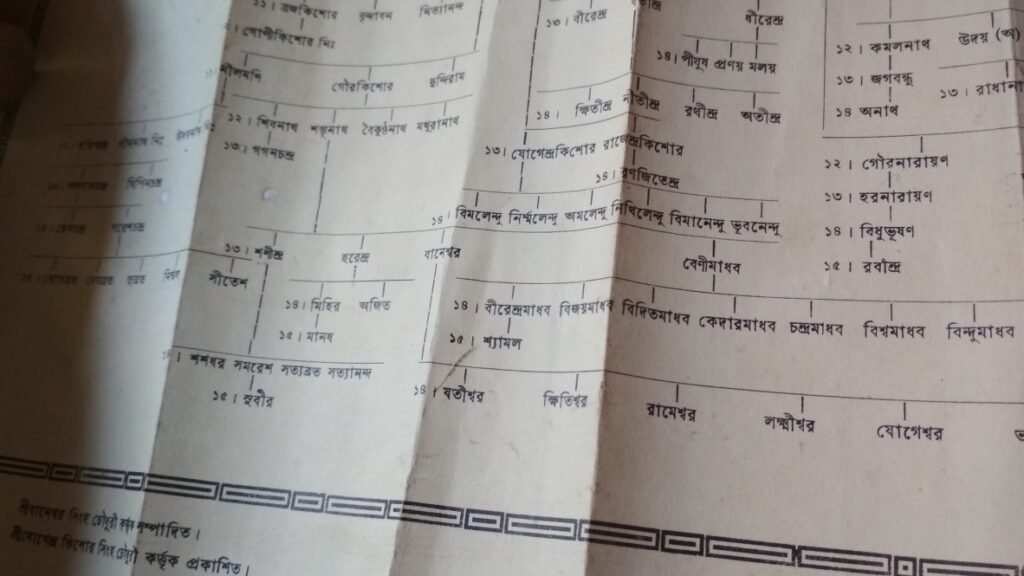
The family tree
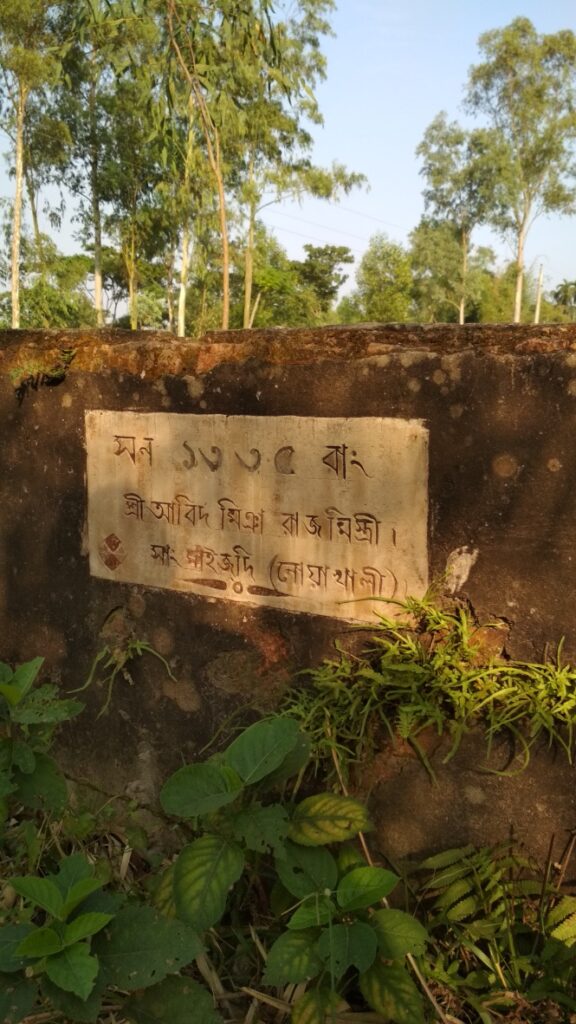
A piece of an old wall in Rarishal. The year of construction and name of the head mason is inscribed. In 1335 BS (1928 CE) Sri Abid Mian of Maijdee, Noakhali had worked as a ‘rajmistri’ for the Sinhas. I think of Laksmisvar Sinha. 1928 is when he is sent to Naas in Sweden by Rabindranath Tagore to study the Sloyd system of handicraft; something he will bring into the pedagogy of Visva Bharati in 1932. Around 1934-35, two Swedish women will come to Santiniketan to teach in the Sloyd system: one, Miss Inga Jeanson and the other Miss Aina Cerderblom.
Dilip Sinha, Bappi and another young singer of Sylhet who had come to meet us in Rarishal, Ashim Kumar Das, listen to Laksmisvar singing ‘Dinobondhu kripasindhu’, Bake India II, cylinder 246
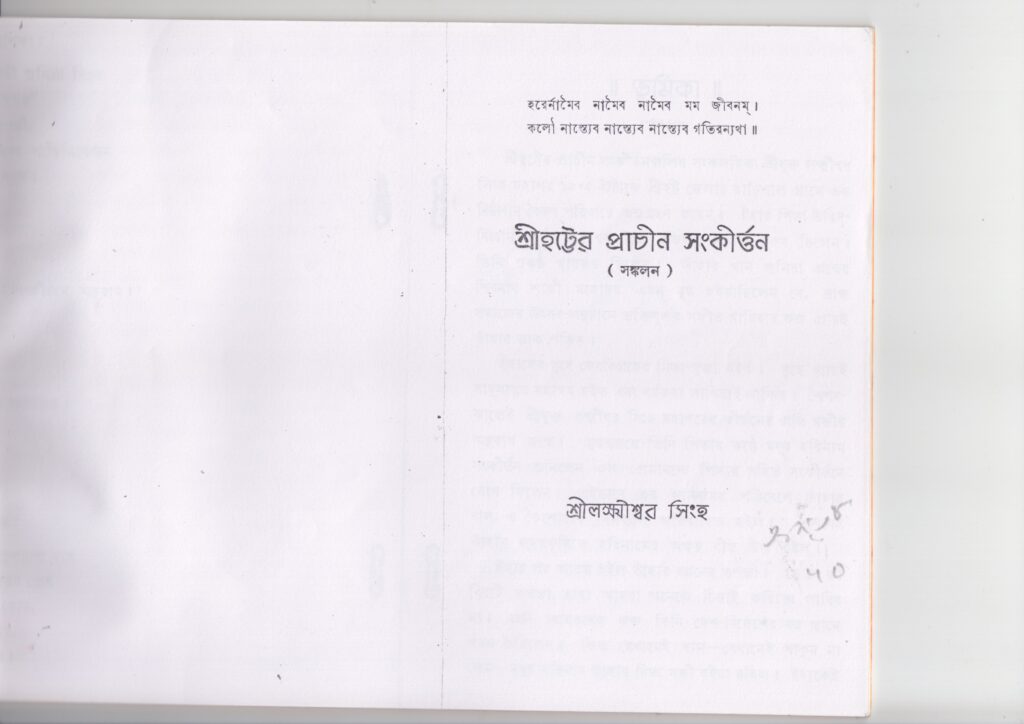
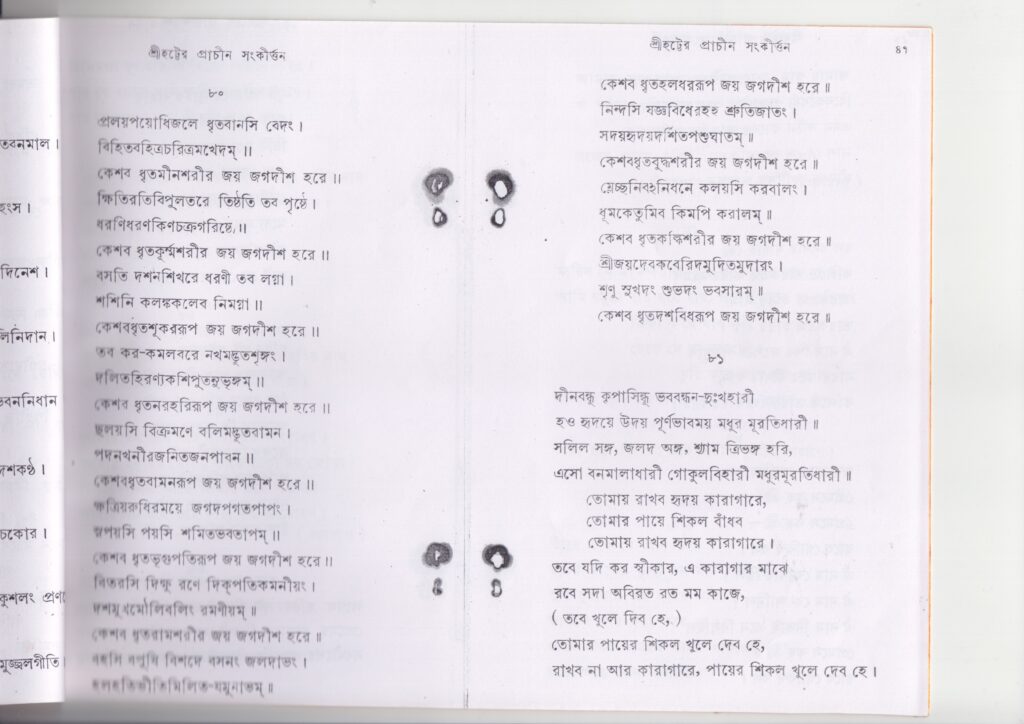
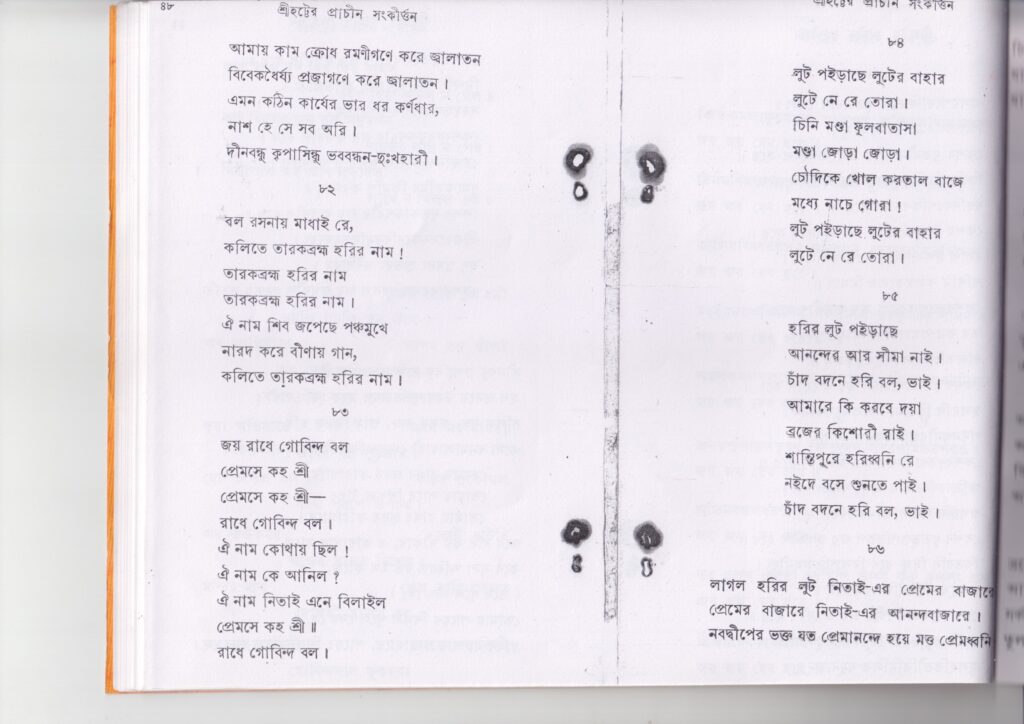
Pages from Laksmisvar Sinha’s anthology of kirtan from Sylhet, Srihatter Prachin Sankirtan, published in 1963. The song ‘Dinobondhu kripasindhu’ is part of the anthology.
Gour Sonar Manush. Dilip Sinha, Bappi and others listen to Laksmisvar’s recording, the second song of Bake India II, cylinder 245 . ‘We still sing this song,’ Dilip Sinha Chowdhury says. I request him to sing it for us.
Within the Sinha clan, Dilip Sinha Chowdhury is a nephew of Laksmisvar Sinha’s. He sings some of the songs Laksmisvar sang for Arnold Bake and talks about the Sinha family, their history and the days of the Liberation War in 1971.
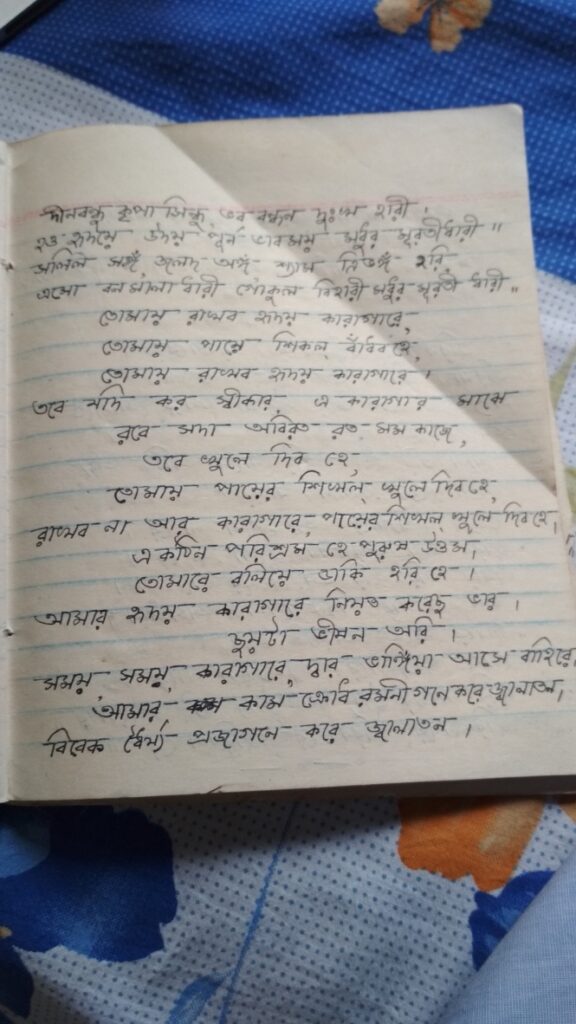
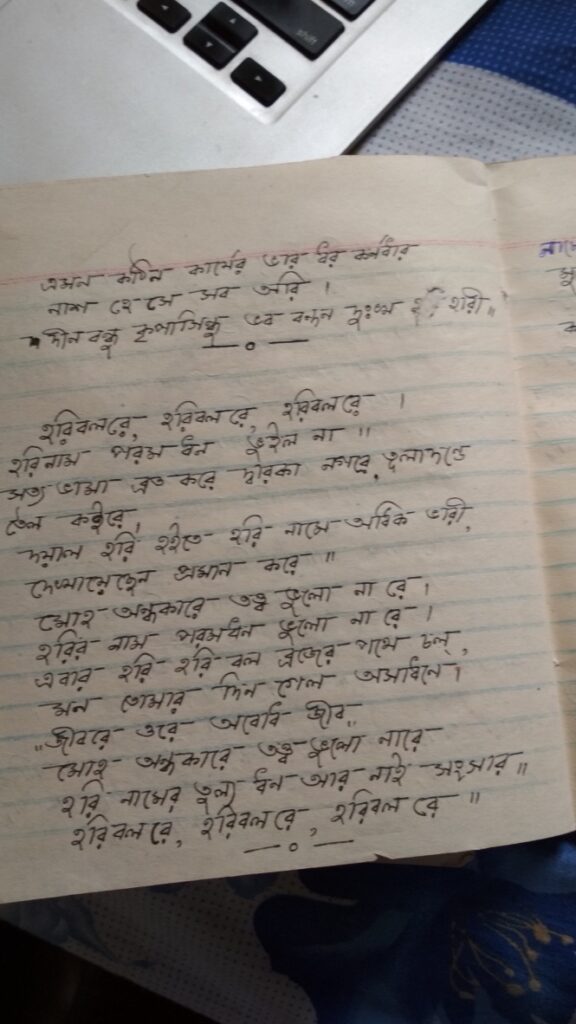
Pages from Dilip Sinha Chowdhury’s handwritten songbook, in which some of the songs Laksmisvar sang for Bake are also written.
Ashim Kumar Das of Dhirai, Sunamganj, comes from a family of performing artistes. This track is from Habiganj bus station where Ambarish Datta and I had gone from Sylhet and where Bappi and Ashim had come to meet us. We went to Rarishal village by a three-wheeler CNG, while Ashim went with Bappi on his bike. I am chatting with Ashim and he is talking about his parents, both of whom are jatra (folk theatre) artistes.
Turns out Ashim is a beautiful singer. He was very quiet throughout our interactions in the Sinha house, and then came a point when it became clear he was a singer. And, he sang so beautifully. Here are three songs; the Lalon song right at the end was quite unlike how Lalon Shah’s songs are usually sung, especially in the western side of Bengal, including Kushtia, Nadia and Birbhum-Barddhaman. I am also keeping that one here, to show a trend, because Ashim is not alone in what he is doing with the song. His take sounds ‘adhunik’—pop and filmy. He says he learned this song from a record of Shafi Mondol.
Once I had written a Facebook post on Laksmisvar Sinha in Bangla and I feel tempted to add an extract from that text here, because some things are so hard to translate. So here is a little bit in Bangla for those who will be able to get the রস (rasa) of the language. We will go to the story of Laksmisvar Sinha’s daughter and his books after this.
আদিতে ধ্বনি ছিল। In the beginning was sound. আমার বহু গল্পই শুরু হয় সুর শব্দ থেকে।
হল্যান্ডের সেই সাহেব আর্নল্ড বাকে, যাঁর কথা আমি মাঝে মাঝেই বলে থাকি, তিনি ১৯৩৩-এ শান্তিনিকেতনে লক্ষ্মীশ্বর সিংহ নামের এক যুবকের গান রেকর্ড করেছিলেন। নোটে লেখা ছিল, Assamese folk songs sung by Laksmisvar Sinha [recorded at] Santiniketan 16/4/’33 a. folk song from Sylhet b. village song Hari sankirtan. (এখন পরিমার্জিত ক্যাটালগ থেকে আসাম শব্দটি বাদ গেছে, এবং তার ফলে একটুকরো ইতিহাসও বাদ গেছে)।
লক্ষ্মীশ্বরের বাড়ি কোথায় ছিল বাকে লিখে যাননি, হয়তো জানতেনও না। আমার সিলেটের বন্ধুরা খুঁজেপেতে জেনে দিলেন। তাঁদের সম্পন্ন ঘর ছিল, তাই হদিশ মিলেছে অপেক্ষাকৃত সহজে। কিন্তু, কে জানতো যে সেই ১৯২০ নাগাদ সিলেটের হবিগঞ্জের রাঢ়িশাল থেকে পথের টানে বেরিয়ে পড়া একটি ছেলের গলার সুর ধরে প্রায় ৮৫ বছর পর অম্বরীষদা আর আমি ২০১৮’র এক শীতের দুপুরে তার কোন কালে ফেলে যাওয়া বাড়ির দাওয়ায় গিয়ে হাজির হবো? কে জানতো যে লক্ষ্মীশ্বরের সেই উত্তরপুরুষ (সরাসরি নয়, তবে জ্ঞাতিগুষ্টির ব্যাপার এই সব), যে আমাদের এত আদর যত্ন করে নিয়ে যাবে তাদের বাড়িতে, সেই গ্রুপ থিয়েটর করা যুবকটির দেয়া নাম সঞ্জিত সিংহ চৌধুরী হলেও, নেয়া নাম হবে বাপ্পী শ্রমিক? সে ঘুরতে ঘুরতে দেখাতে থাকে আমাদের–ওই যে লঙ্কার ক্ষেত, ওটা লক্ষ্মীশ্বর, আর ওই যে তার পাশের জমি, ওটা … ভাগ হওয়া পরিবারের ভাগ হওয়া পূর্বপুরুষের নাম বলতে থাকে বাপ্পী।
এক রকমের বাঙালি বাড়ির দেয়াল জুড়ে বিগ্রহের ছবি, রবীন্দ্রনাথ থেকে শেখ মুজিব, তারই মাঝখানে চে, আবার এক দেয়ালে সত্যজিৎ রায়, পাশে বাপ্পীর বাবার মুক্তিযোদ্ধার স্বীকৃতি পাবার ছবি, অন্য দেয়ালে শামসুর রহমানের কবিতার লাইন: ‘তোমাকে পাওয়ার জন্যে, হে স্বাধীনতা,…/তোমাকে পাওয়ার জন্যে/আর কতবার ভাসতে হবে রক্তগঙ্গায়?’
এহেন বাড়ির উঠোনে শুকোনো গামছার লাল রং আমাদের এক মৃত্যুহীন স্বপ্নের সাধের কথা মনে করিয়ে দেয়।
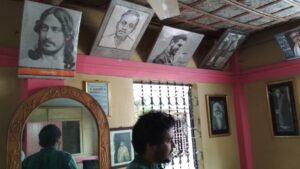
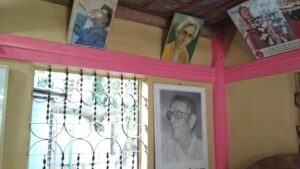
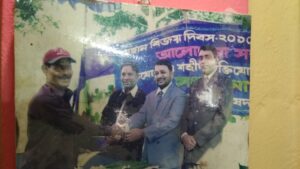
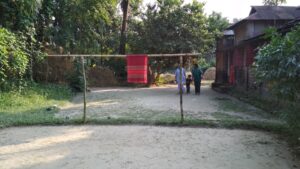
Inside the Sinha home in Rarishal and the courtyard, 2018
বাপ্পী ‘শ্রমিক’ থেকে লক্ষ্মীশ্বরের দিকে ফিরে যাই। দেখি, ১৯২৫-এ বিশ্বভারতী-গ্রন্থালয় থেকে ‘কাঠের কাজ’ বলে একটি বই ছাপা হয়েছিল। ভূমিকায় রবীন্দ্রনাথ লিখেছিলেন, ‘শ্রীযুক্ত লক্ষ্মীশ্বর সিংহ “কাঠের কাজ” বইখানি লিখিয়াছেন; ভদ্রলোকের ভয়ে “ছুতারের কাজ” লিখিতে পারেন নাই’!
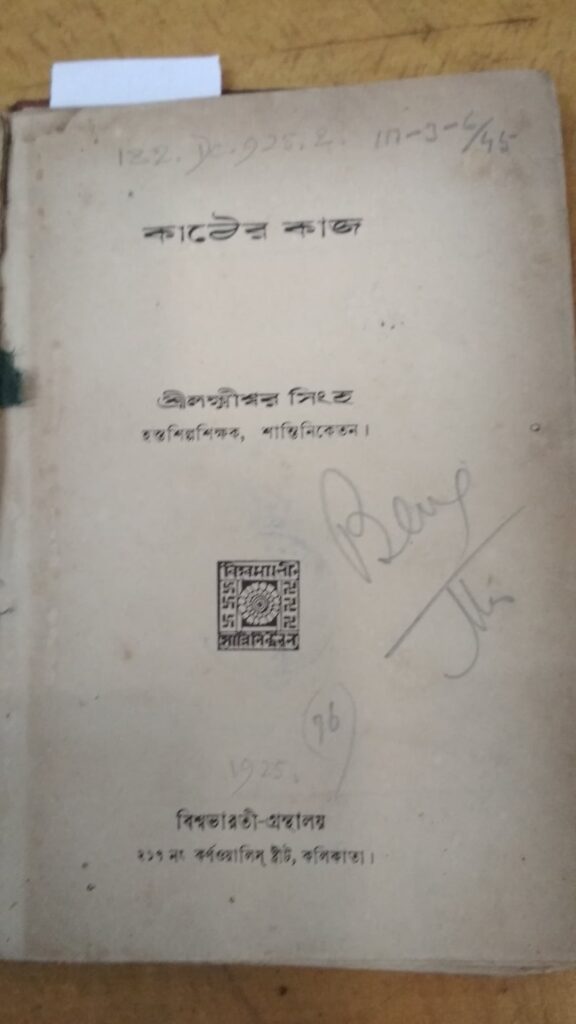
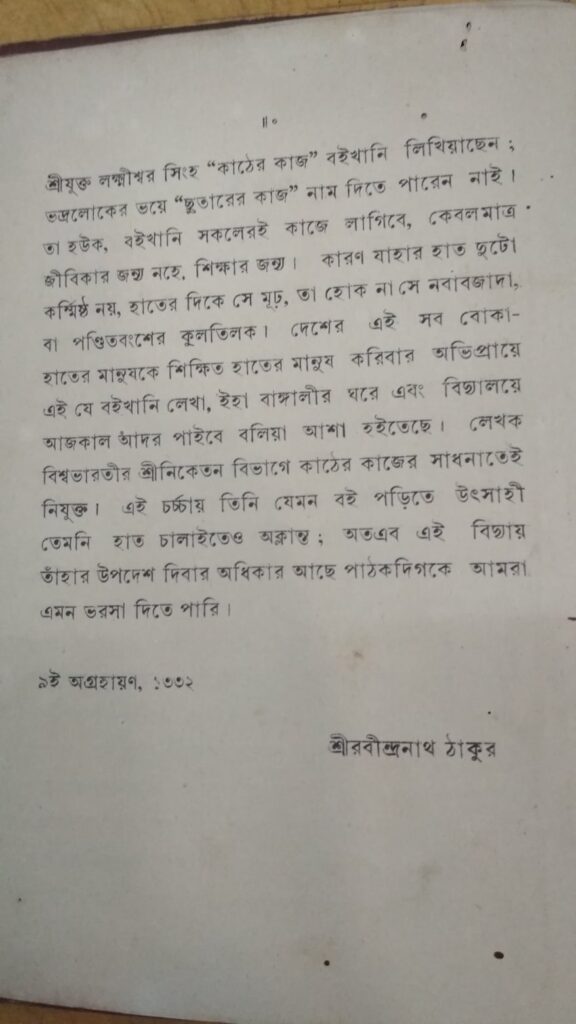
Laksmisvar Sinha’s book on carpentry, Kather Kaj, published by Visva Bharati Granthalaya in 1925
After the trip to Rarishal, I went on another trip to Santiniketan in April 2019, to follow up on some of the work I had done the previous year, mainly around the recordings of Pinakin Trivedi. It is then, just by chance, while talking with Bithika Mukherjee, whose husband, Nabakumar Mukherjee (1930-2015) had set up the Elmhirst Institute of Community Studies , that I came to know the whereabouts of Laksmisvar Sinha’s younger daughter Sumitra (born 1942). Nabakumar Mukherjee had worked in the Rural Reconstruction Centre of Sriniketan, Visva Bharati and had been taught by Laksmisvar Sinha. So, I met Sumitra Sinha on 28 April 2019 in a place called Banalakshmi near Santiniketan with a history of its own. Sumitra Sinha, quite infirm now, had no idea there could be a recording of her father’s voice from long before her birth, when he was a young man. As expected, she was truly overwhelmed to listen to his songs. She began to talk about her father, brought out old photos, talked about her elder sister who lives in Sweden, about their mother, and about songs their father used to sing, his time in Gandhi’s Sevagram, books he wrote, his autobiography in Esperanto. She talked about Laksmisvar’s early travels, an uncle who lived in London, the Swedish loom which came to Santiniketan through her father, a Swedish woman who came to her some years ago, on the trail of an aunt who had come to teach weaving in Santiniketan in the 1930s. Like Laksmisvar’s own life, Sumitra’s stories too were going in many directions.
I had gone with my friend, publisher Sumita Samanta to meet Sumitra Sinha and the following videos were all recorded by Sumita on her phone.
Sumitra Sinha talks about memories of her childhood in Rarishal, relatives in Shillong, her father’s songs and how there might be some recordings with the family of a deceased student and colleague.
Sumitra Sinha listens to her father’s songs. Her eyes light up. When he sings ‘Hari bolo nouka khulo’, she says, ‘Bhatiyali!’
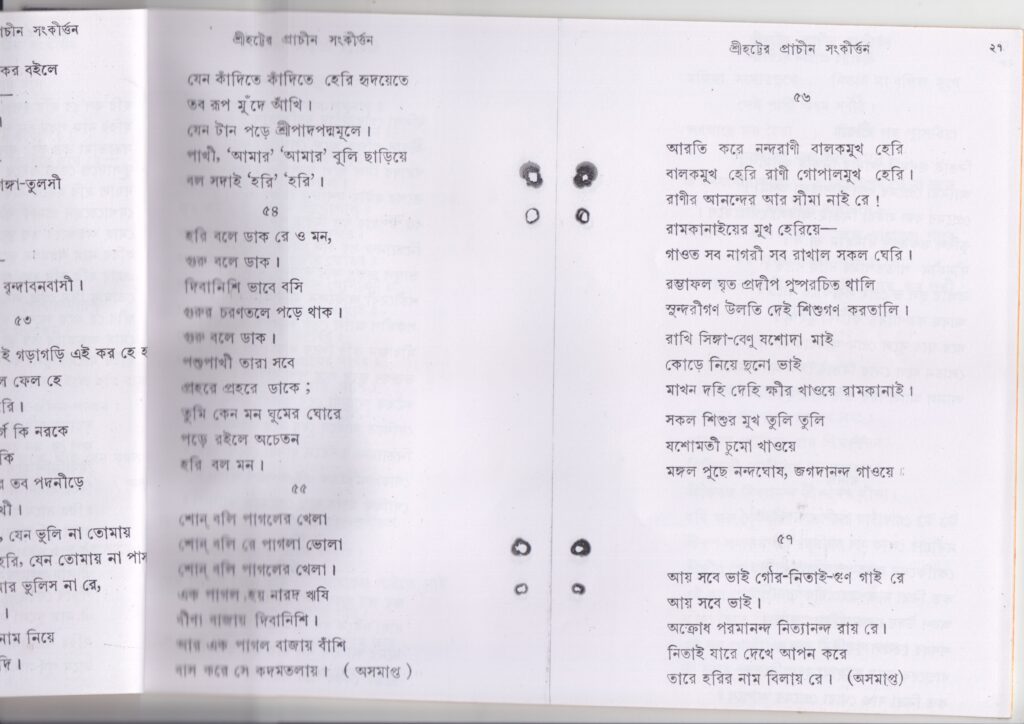
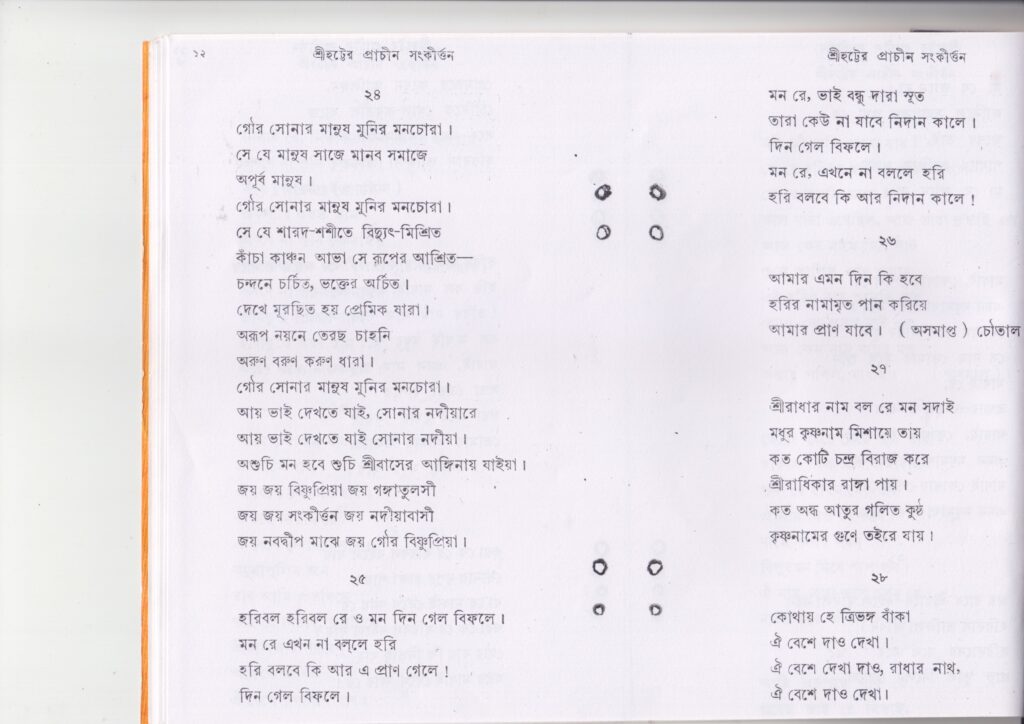
Pages from Srihatter Prachin Sankirtan, with the song ‘Gour Sonar Manush’.
Sumitra’s stories about her father’s travels in Europe do not all corroborate with Laksmisvar’s autobiography in Esperanto, Jaroj Sur Tero, published in 1966. This leaves us thinking about how the same things are remembered differently by different people and how they are recorded. Whose version is most correct? Why does Sumitra have a version which is different from Laksmisvar’s? Details of the stories she is recalling have probably got jumbled up in her head, the chronology might not be correct, but surely such things happened; surely she had heard such stories from her father. Stories such as her father rescuing a little girl on a ship on a stormy night, the girl’s grandfather sending him a parcel of clothes in London to say thank you and so on. If I could talk with Sumitra’s sister, Tapati, who lives in Sweden, perhaps she would have another version of the same story?
Sumitra Sinha shows us photographs of her parents and from Laksmisvar’s journeys. Sumita takes photos of the photos. The second video was recorded by me on my mobile phone
Sumitra Sinha says her father spoke mostly with a Sylheti accent, while her mother, although she too was from Sylhet, was a Calcutta girl and spoke like one.
Sumitra Sinha tells the story about how a few years ago a Swedish woman came to visit her in Banalakshmi. She said her aunt used to teach weaving in Santiniketan and she had come because Laksmisvar Sinha had been to Sweden. Sumitra had with her some old Swedish weaving patterns from her father’s time, so she gave those to her Swedish guest. What would I do with them? I felt quite relieved after giving them to her, she said.
According to Sumitra Sinha, her Swedish guest (whose name was Margareta F. Berg, and who was from Uppsala; Sumitradi gave me her contact details) later went around Santiniketan, looking for people who had old bedspreads and tablecloths with Swedish designs, and ended up finding twelve looms and many related documents. Ms Inga Jeanson or Ms Aina Cederblom—whose niece was Margareta? I wrote to Ms Berg and she wrote back to me on 17 January 2021. Her aunt was Ms Jeanson, one of the two Sloydists sent to Santiniketan in 1934-35 by Countess Hamilton, on Laksmisvar’s request on behalf of Rabindranath Tagore. Margareta said in her email to me that she would not write any book, because she was 80 now, and did not have enough material for a book.

Swedish weaving. Source: internet.
Sumitra Sinha had told me about Laksmisvar Sinha’s student and later his colleague, Aboni Halder, who had recorded her father’s songs quite late in his life. Aboni Halder has passed too, but his wife and daughter, who live in Bolpur, might have the recordings, Sumitradi had said. Sumita Samanta and I went to meet Roma Halder, Aboni Bhusan Halder’s widow in her home on 29 April 2019. She and her daughter Amrita were very warm and welcoming and we chatted for long, and saw the beautiful woodwork of Aboni Halder, heard his stories and another world began to open up for us. Mother and daughter confirmed that there were recordings; Aboni Halder had brought a tape recorder from Denmark. Laksmisvar Sinha was his guru, not only in carpentry but he had also instilled in him an interest in Esperanto. I asked Amrita to look for the tapes because they were so precious.
Roma Halder, also originally from Habiganj in Sylhet who had grown up in Hailakandi in Cachar, talks about her mother and her husband, Aboni Bhusan Halder, and his world of ideas and experimentation. Laksmisvar Sinha was a key person in Halder’s life.
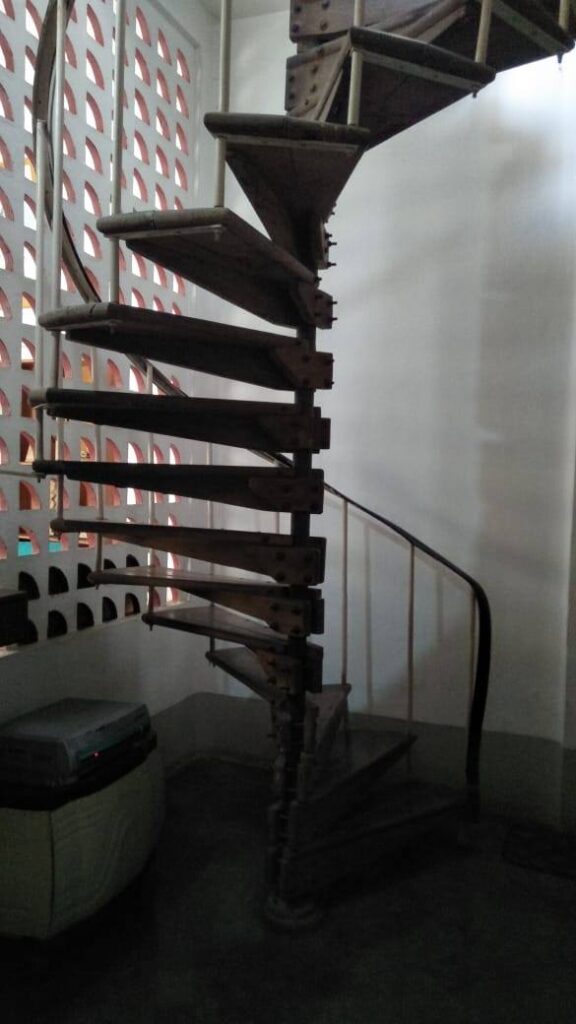
Stairwell crafted by in Aboni Halder in his home in Bolpur, near Santiniketan.
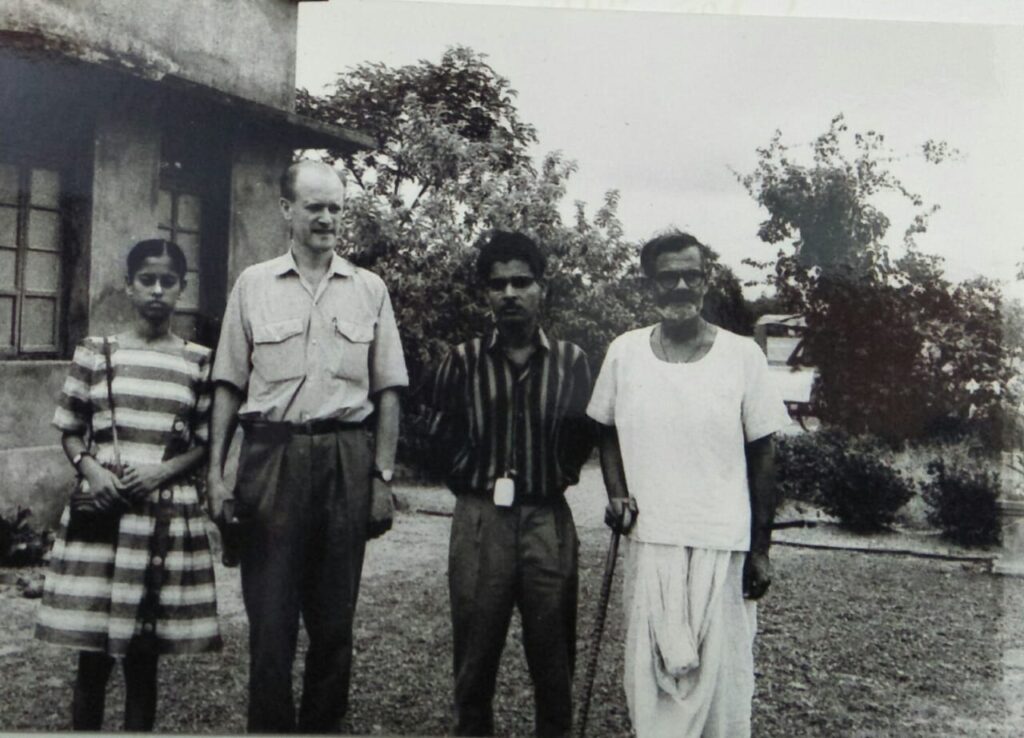
Laksmisvar Sinha stands at the far right and next to him is Aboni Halder
For a whole year I would prod Amrita from time to time about the tapes, although I did not have much hope. In 2020, to my utter surprise, Amrita sent me a message to say the tapes had been found. Then things happened in quick succession. I was helped by friends to bring the tapes from Bolpur and finally digitise Laksmisvar Sinha’s songs recorded by Aboni Halder in 1968. When I heard the song ‘Amay par koro he’, it brought tears to my eyes. For people like me who have spent many years working with field recordings and recording in the field, this was truly a blessed moment. Among other things, Laksmisvar also sang the song ‘Hari bolo nouka kholo’, as he had done in 1933. I do not know whom I must thank for this chain of events and accidents of meetings which led to us these rare recordings of Laksmisvar Sinha. But I am grateful to record collector Rajib Chakraborty for taking these old and delicate reel-to-reel recordings to sound engineer Abhimanyu Deb and to Abhimanyu for the passion he put into the transfer. Therefore, listeners, listen with the attention that all these beautiful people deserve. Listen to the layers of time in these recordings, listen to the ageing of the voice, the deepening of the sound. Laksmisvar Sinha was no ordinary man.
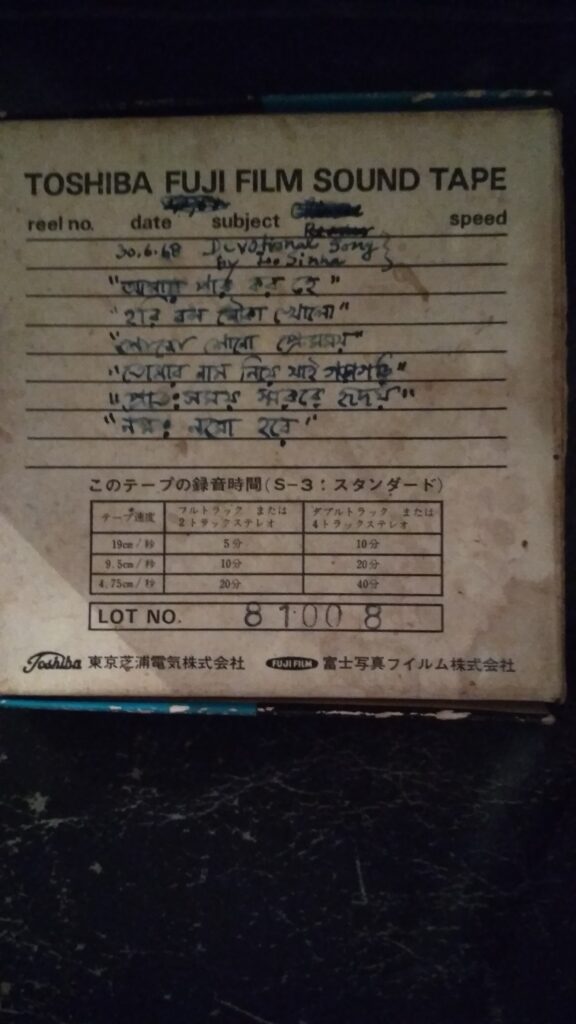
Amay Par Koro He
Hori Bolo Nouka Khulo
Shuno Shuno Premomoy
Joto Shob Kanar Hat Bajar
Tomar Nam Niye Jai Goragori
Bramhasangeet
Nomo Nomo Hare
Nomo Nomo Hare take 2
Esperanto
These recordings from 1968 should not need any explanation, except that there is a subtle difference between Tracks 7 and 8. In 7 we will hear that Laksmisvar Sinha was forgetting one word and so we can assume that he asked to record the song again. The second take of ‘Nomo Nomo Hare’ does not have the spontaneity of the first take, however. There were several other tapes in the lot. Some recordings of Esperanto, the value of which only scholars and specialists can tell us. Interestingly, some of the songs Laksmisvar Sinha sang for Aboni Halder are also in his anthology of kirtan from Sylhet.
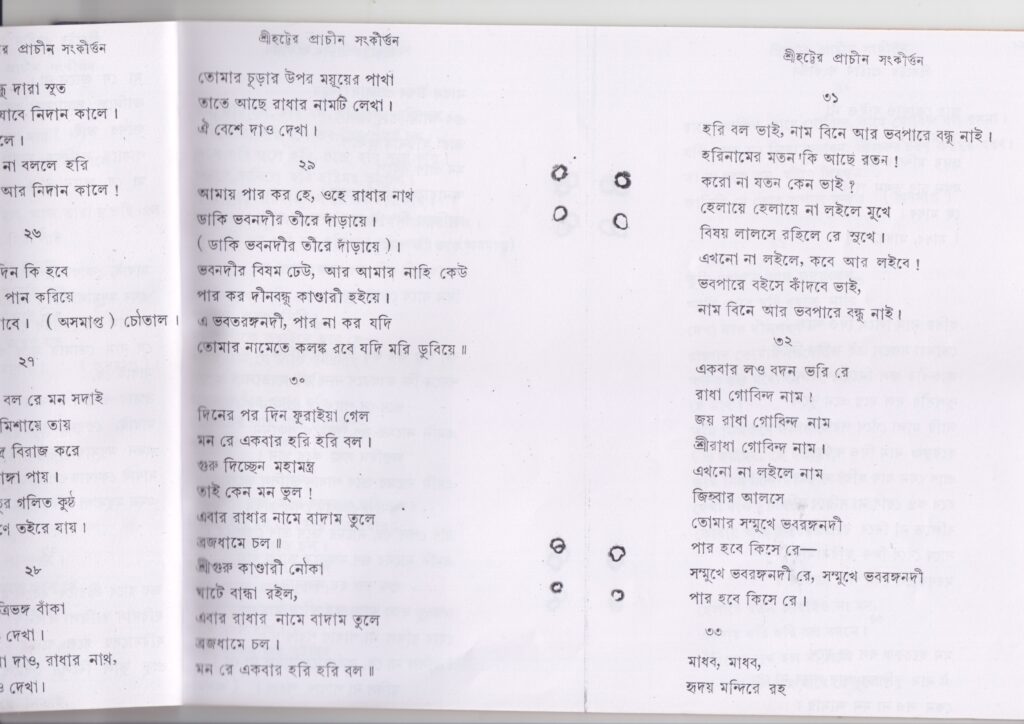
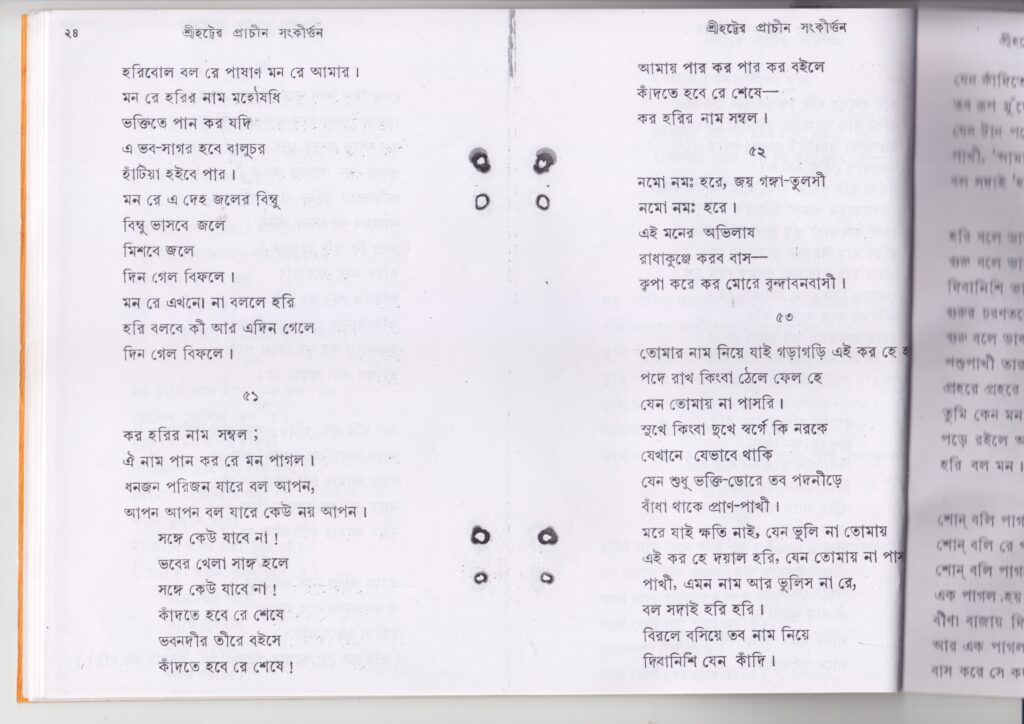
Songs from Srihatter Prachin Sankirtan
I shall end this piece here, as I am not equipped to write about Laksmisvar Sinha the Esperantist. Professor Probal Dasgupta, the linguist’s essay ‘Recontextualizing Lakshmiswar Sinha’ gives an idea of the man’s importance as an Esperantist from South Asia on the one hand and his manual labour-based pedagogy on the other. Professor Sajal Dey, also a linguist, has translated Sinha’s autobiography, Jaroj Sur Tero, from the Esperanto into English and Bangla. When the translations are published, readers will know more about Laksmisvar Sinha and better understand the man behind the voice recorded on Arnold Bake’s wax cylinders. For me, my journey began with this voice, and slowly I have come to find his books, learned about his journeys, understood somewhat the impulses which drew him to the world of carpentry from when he was a boy, to cotton cultivation, to Esperanto, to translations of Swedish texts into Bangla, while he held his songs of devotion from his village home close to his heart.
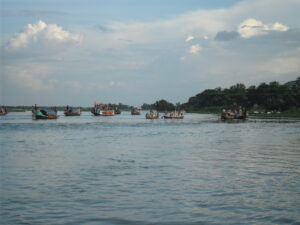
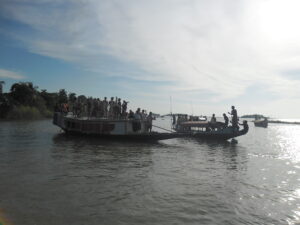
I end with one question which is more about Arnold Bake and less about Laksmisvar Sinha. By the time Bake met Sinha, the latter had returned from Sweden trained in Sloyd. Here was a man who had journeyed from the far end of Bengal to its centre, a man interested in Rabindranath and Gandhi, who had been taught by Leonard Elmhirst. It was Tagore who had sent him to Sweden. Here was a man who came from a curious family of artistes and intellectuals–his cousin the Leftist intellectual and scholar Sasadhar Sinha had studied at the London School of Economics and ran an eclectic bookshop in London . This man whom Bake was recording had travelled across many places in Europe. Yet Bake did not seem to take any particular notice of him. Of course, he recorded him and those recordings are invaluable and without those I would not have done this work, but that is not the point I am trying to make here. I wonder what it was in a song or a singer that used to catch Arnold Bake’s imagination and draw his attention? Likewise, what does this absence of information tell us about Bake? Or does it tell us something about the place of Laksmisvar in the world of Santiniketan?
Finally, in the mid 1940s, Laksmisvar Sinha had planned to start a whole agriculture and other handicraft-based holistic project in near Rarishal, for the ‘villagers’ as he wrote in his autobiography, in the place where his father, Baneswar Sinha, had his farm when they were small. That was also the place where his father went alone, to meditate. That project had taken off alright and Laksmisvar had hopes of going far with it, working with the people in his homeland. Then came Partition and the riots and his dreams were shattered, the place and the project destroyed. Laksmisvar had to take a job in Sriniketan, Visva Bharati where he was mainly based for the rest of his life. I asked Bappi, my friend from the Sinha family in Rarishal, about Sinhagarh. He said there was no Sinhagarh, but Sinha Gram, a village not far from Rarishal. And he sent me these photos from Sinha Gram on 17 January 2022.
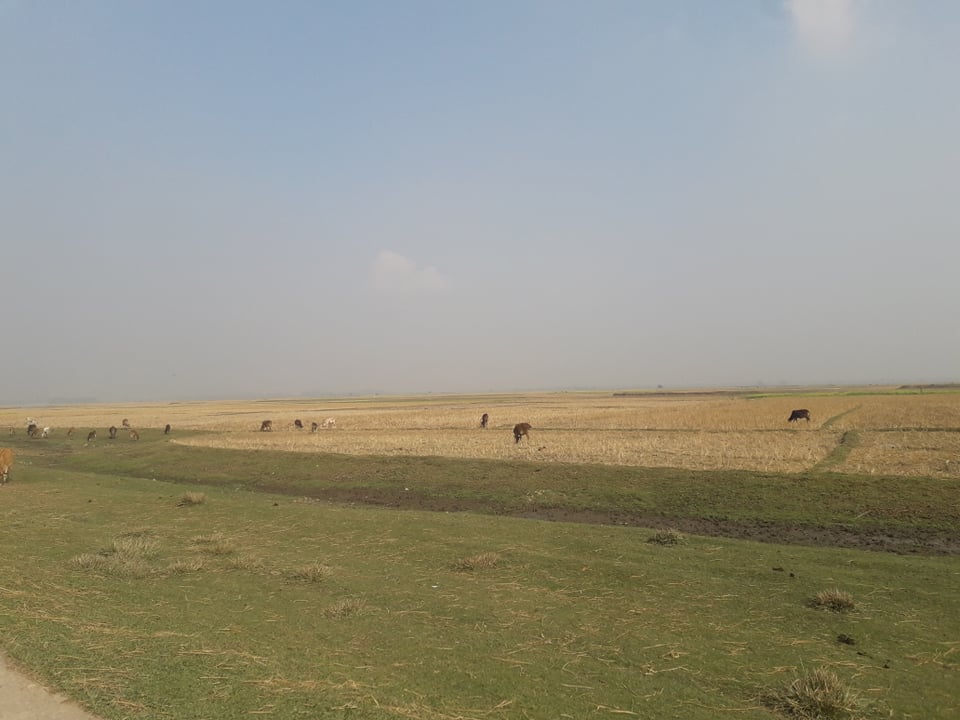
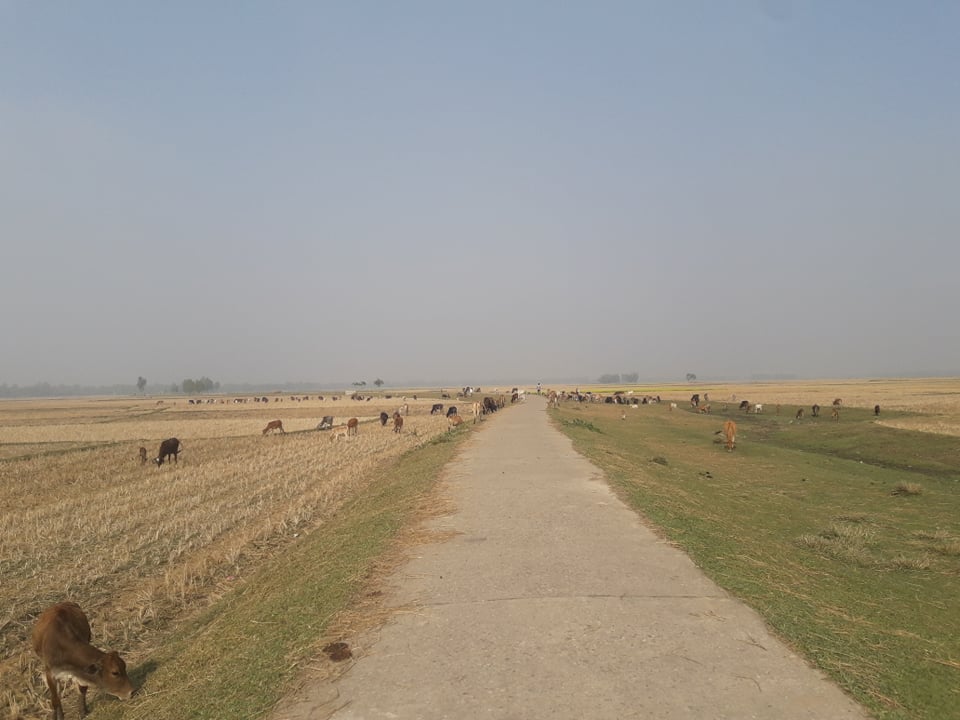
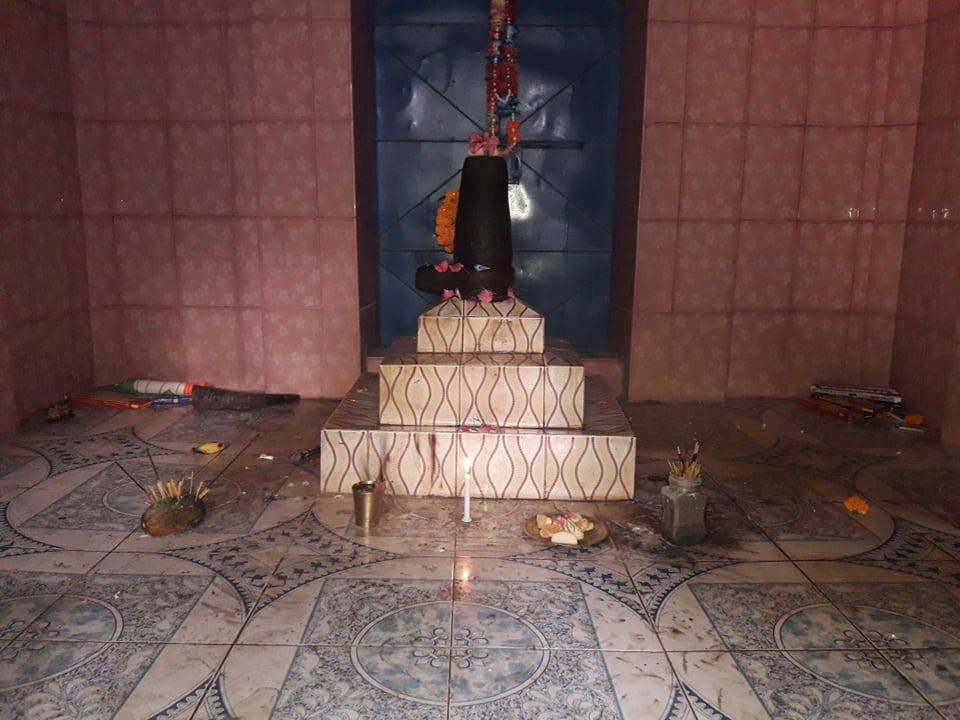
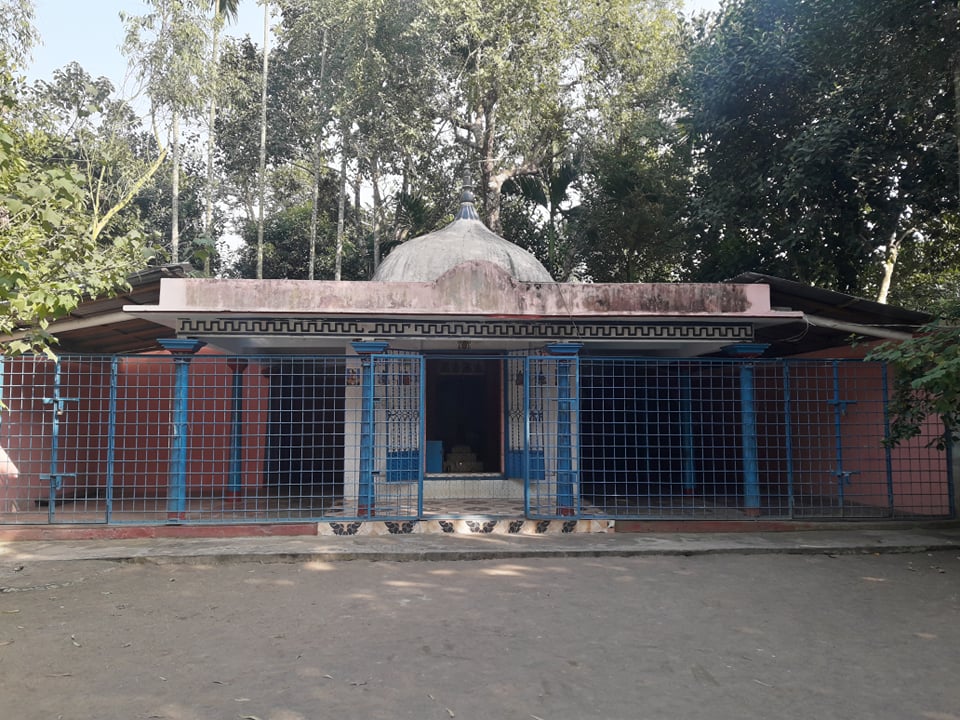
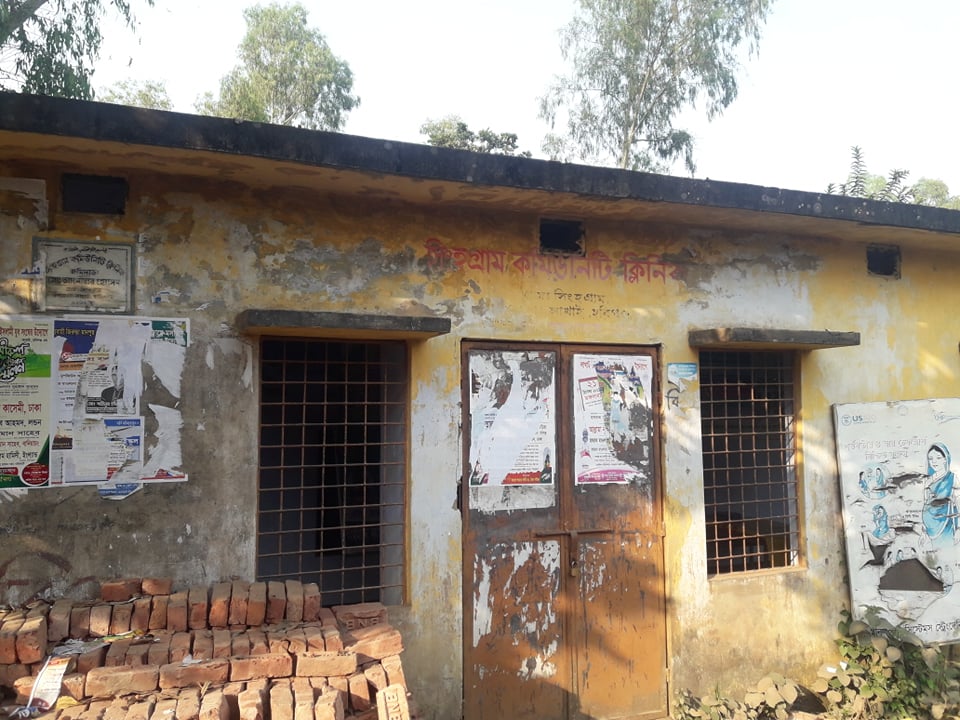
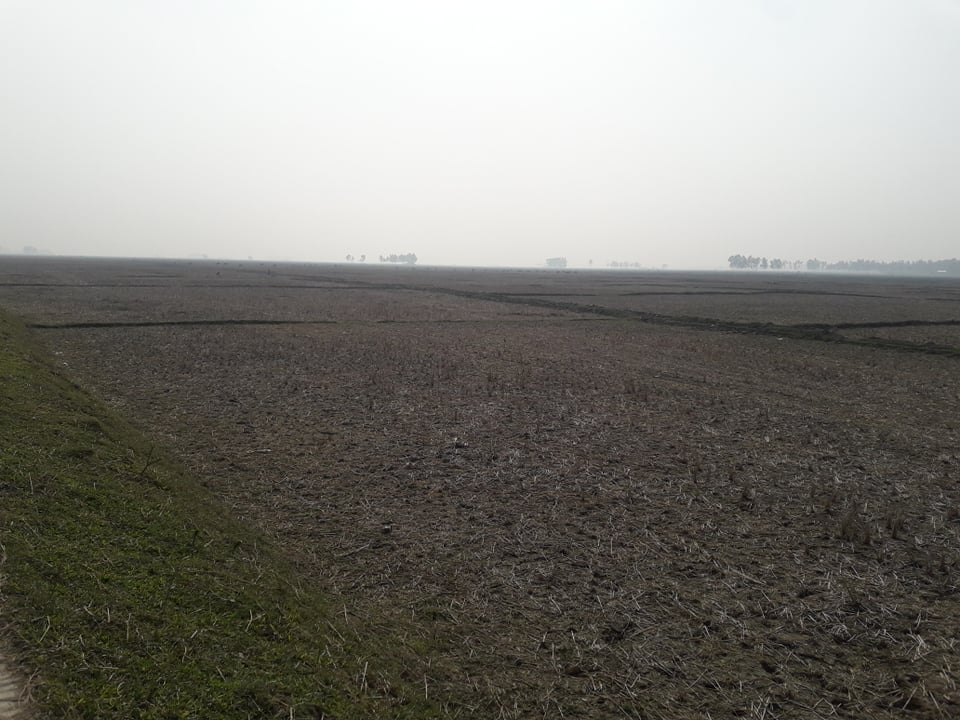
Postscript
I had closed this sub-chapter with the above photos. However, on 8 August 2022, I had a message from Bappi in Rarishal, the distant great grant nephew of Laksmisvar, after he read this piece. He sent me another photo of the temple in Sinha Gram. (Above, in the bottom left photo, Sinha and Gram are written as two words. The photo below has the name as one word). Now he has got the temple committee to write the name of the temple, place and year it was established on the parapet of the roof. In a sense this is like filling up gaps in archival notes, labelling unnamed objects in an archive and here the place itself is the archive. Bappi wrote to me that our trip to their home in 2018, with Laksmisvar Sinha’s songs and our continued communication over the years have given him another consciousness about the importance of their history and the need to tell and retell the stories of this place and mark it with signs.
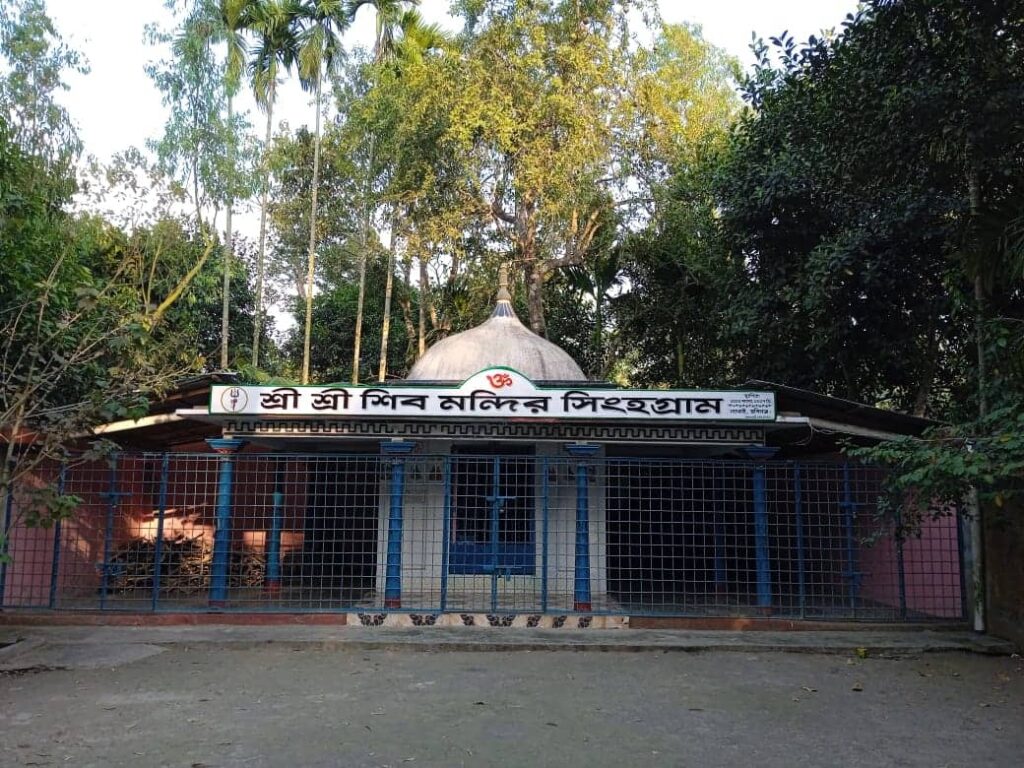
Bappi wrote, আমার চাকরি সিংহগ্রামেই তবে মন্দিরে খুব একটা যাওয়া হয় না। সেদিন গিয়ে যখন দেখলাম নামটা নেই, খুব খারাপ লাগল। সেদিনই কমিটির লোকদের বলে আসছিলাম যে আমি মন্দিরের নামটা লিখিয়ে দিব। আসলে সেটাতো আপনার জন্যই হল দিদি না হলে হয়তো যাওয়াও হত না সেখানে। ‘Sri Sri Shib Mandir, Sinhagram. Lakhai, Habiganj. Established 1313 Bangabda, 1907 CE’–this is what is written on the board. Photo: Sanjit Sinha Chowdhury.
These are 17 clips of varying length of found footage from 1994, which was given by the Mitra Thakurs of Mainadal to The Travelling Archive, after several visits to the village between August 2014 and January 2016. Our visits, with recordings of their ancestors’ voices from archives and records released in Europe, about which the family was not aware, aroused in this old family of kirtan singers, a certain renewed interest in their past.
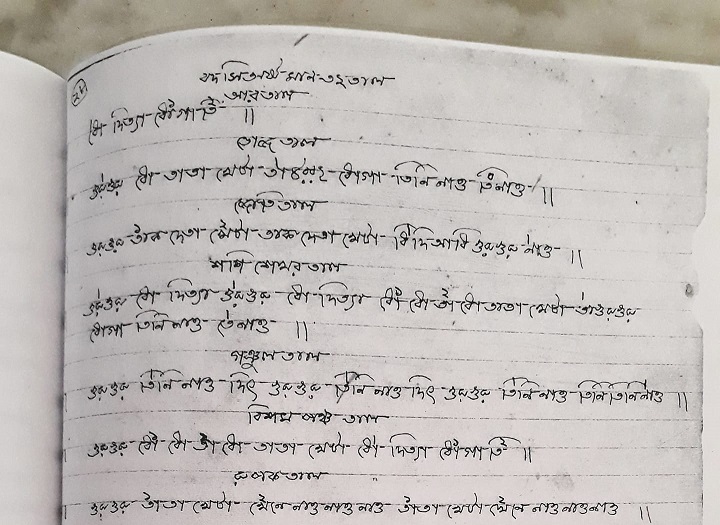
This page is a from a notebook of one of the Mitra Thakur elders, Sakalananda Mitra Thakur (1915-1989). He was a master khol player and here he has written out the bols (the rhythmic pattern) of the many tals or beats which accompany the song ‘Badasi’, which, interestingly, Arnold Bake had recorded in both Mainadal and Kenduli in 1933. We do not know when this notebook entry was made. Milan Mitra Thakur has written about his uncle Sakalananda thus: In our family, as much as I have seen, most of those who excelled in singing and khol playing never stepped into any formal school. The reason is that, the time when children go to school with books in bags slung over their shoulders, our elders would carry their drums and accompany their guardians to kirtan sessions; they sang and played along with them. Thus, my uncle Sakalananda never went to school, yet his neat and beautiful handwriting amazes me. আমাদের পরিবারে, আমার দেখা গান বাজনায় যাঁরা পারদর্শী ছিলেন, অধিকাংশ তাঁরা স্কুলের মুখ দেখেন নি ; তার কারণ যে বয়সে সবাই বই কাঁধে নিয়ে স্কুলে যায় সেই বয়সে, এঁরা কেউ খোল কাঁধে নিয়েছেন কিংবা অভিভাবকদের সাথে গানে গলা মিলিয়েছেন। তেমনি আমার জ্যেঠা, খোলবাদক সকলানন্দ মিত্রঠাকুর … আমার জ্যেঠা স্কুলে যাননি কিন্তু তাঁর সুন্দর হাতের লেখা দেখলে অবাক হই। জ্যেঠা শেষ বয়সে তাঁর একটি খাতায় খোলের সমস্ত বোল এবং তালের অঙ্কপাত করে লিখে রেখে গেছেন যেগুলি আমাদের ঠাকুরবাড়ির বিভিন্ন উৎসবের গানে এবং মনোহরসাহি ময়নাডাল ঘরানার কীর্তনে বাজানো হয়।
This matter of digging into their own past is interesting. In a sense, the family has never been disconnected from its past, because what the Mitra Thakurs sing comes from a past and moves into a future. However, till recently, there was not much of a conscious effort to keep records of a particular time within the flow of time; I think they did not feel the need for it either, because they were part of that flow. They could more or less take preservation and continuity for granted. Their lives had little connection with the world from which Arnold Bake came, with its growing interest in knowledge-production through recording and archiving and the power it generated. Perhaps they had encountered the camera, but even if they had a longing to be photographed, where would they find the means? The voice recorder would be a greater rarity.
Arnold Bake had met the Mitra Thakurs for the first time in 1931 in Ilambazar, during a communal ‘naam sankirtan’ singing and dancing event, where they gave him their address and invited to come to their village during Nandotsav. Bake could go after two years, in August 1933. This must have been the Mitra Thakurs’ first encounter with the recording machine and they were very keen to sing to the horn of the machine, as Bake wrote in his letters home, yet they might not have cared so much for what happened after they sang to the horn.
There is a highly interesting paradox in this story. Kirtan was so central to Arnold Bake’s life as a scholar and singer, till the end he longed to return to Mainadal, to learn more, or go to Manipur to learn about their practice of kirtan.
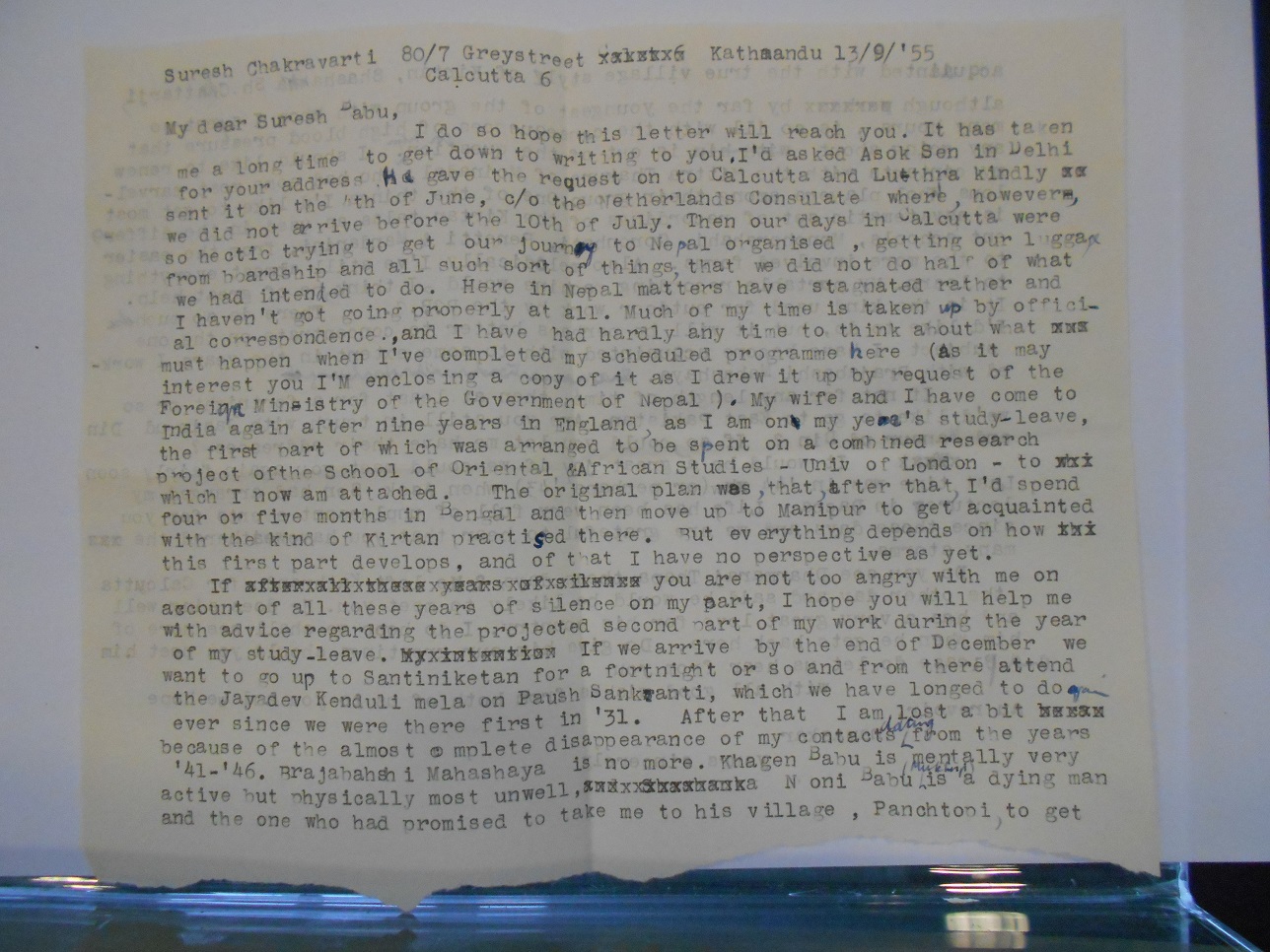
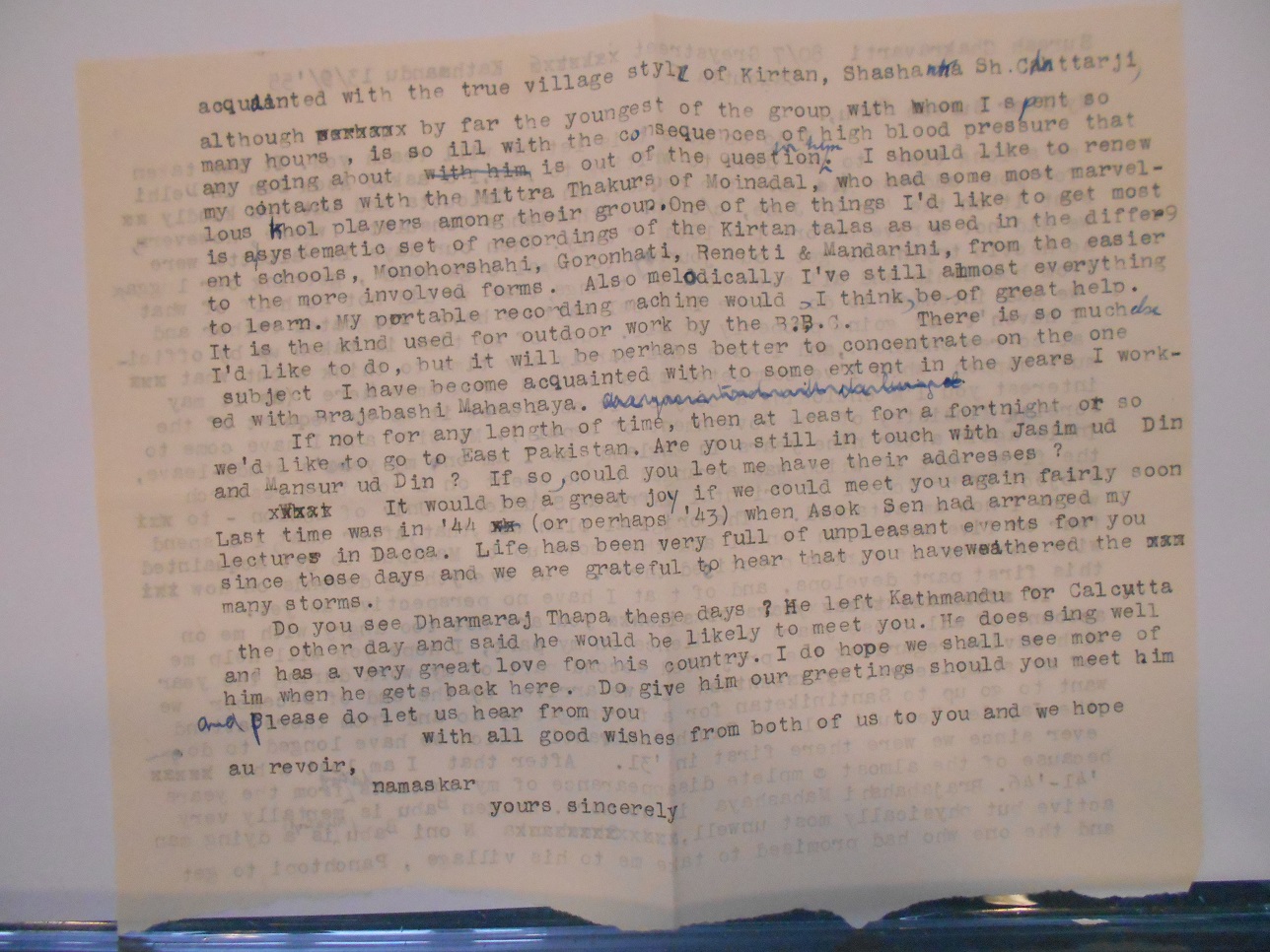
Arnold Bake letters to Suresh Chakravarti written in 1955 in which he wrote about his interest to return to kirtan studies. Image courtesy: Special Collections, Leiden University Library, photographed by me while working as a Scaliger Fellow in 2015.
Yet, when Bake went to Mainadal, he made his recordings and left, and he hardly left any traces of his visit. At least, there was no memory in the village or the family of such a visit. I think that once they learned from us about Bake’s recordings from Mainadal, the family realised that not only by passing the songs from one generation to the next, but another way of memorialising and preservation was also possible. The archive entered the consciousness of this place which itself was an archive. It kindled in the family an urge to search and look for old records. This video recording was one of the things they found and shared with us.
It shows, however, that the need to record, archive and perpetuate was being felt much before our visit. The Mitra Thakurs were talking about the urgent need to preserve the tradition way back in 1994. This video recording had been initiated by Nandalal Mitra Thakur, who had something of a historian’s instinct and wrote a book about religious rituals and songs of Mainadal. Nandalal’s son, Milan, the artist who has over the years become a close friend of The Travelling Archive, has taken a lead in digging the family’s history for things he considers worth keeping. It is he who had digitised these VHS tapes, from which we have created these seventeen short pieces.
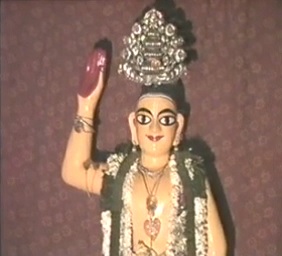
|
Introducing the songs, singers and listeners of Mainadal. | |
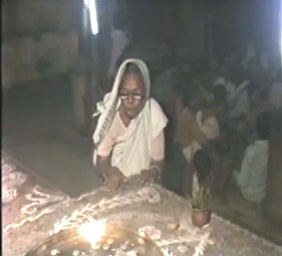
|
Kirtan | |
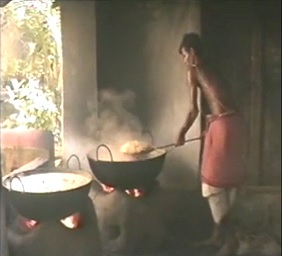
|
Bhog or communal feeding | |
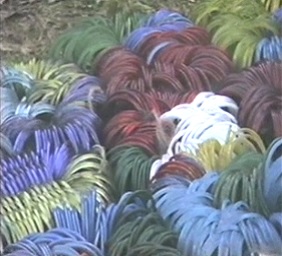
|
Mela |
Those who sang a hundred years ago are no more, there are no recordings or photographs either. Those who had seen them are also about to depart. What do we do? In this footage, there are musicians Arnold Bake had recorded in 1933, as well as some whom we met in 2014 and later. Hence, there is a continuity here, of almost a hundred years, of a family that has been singing kirtan for five centuries.
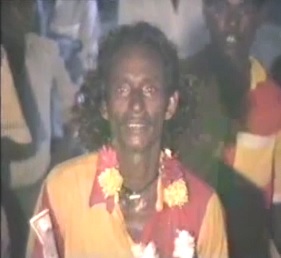
|
Dhol players Jiten Badyakar and team | |
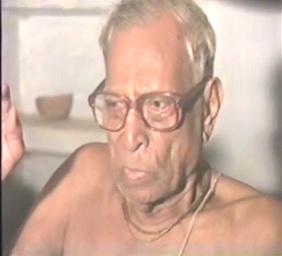
|
Gobindagopal Mitra Thakur (whom Bake had recorded) | |
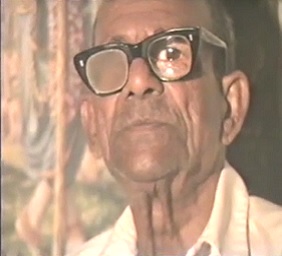
|
Kaliakanta Mitra Thakur and sons (whom Bake had recorded) | |
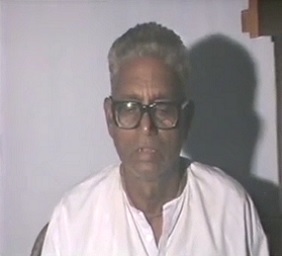
|
Nandalal Mitra Thakur | |
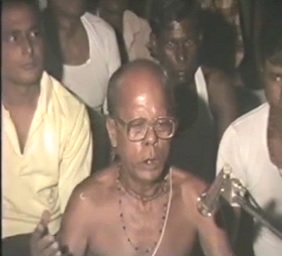
|
Manikchand Mitra Thakur (whom The Travelling Archive recorded) |
I believe that there is a time for such ‘discoveries’–it is only after years of excavation that we reach the precious thing buried under the ground. This film was lying in one of my hard drives, and I was not even aware of its existence. It is only now, when I was finishing my thesis and going through the collection which has built up over the years, that I ‘found’ this material. In fact, I do not think I would have understood the value of this material without these years of preparation. Here I have presented the clips in my own way, adding words, images and sounds from my time as well as from Bake’s time and from other times before and beyond us. They are self-contained units, but they are also parts of a larger narrative. Hence, from Clip 1-17, they are chapters of a story, leading to many other stories.
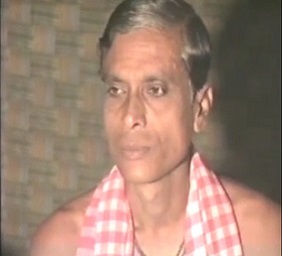
|
Prabhat Mitra Thakur | |
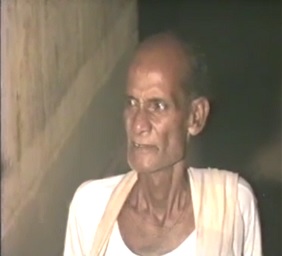
|
Nandotsav arati and interview of Krishnagopal Mitra Thakur and sons | |
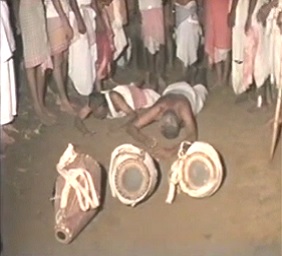
|
Drums as deity | |
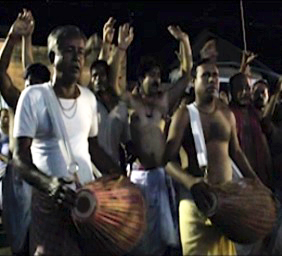
|
‘O he Gouranga’ | |
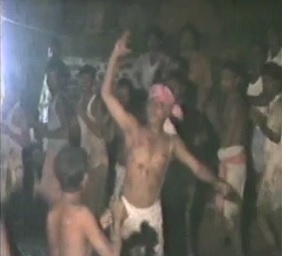
|
Nitai dances, ‘Byom byom Shib nache’ |
What Milan Mitra Thakur had given to us, and of which he did not keep a copy, were DAT files which had to be converted to mp4s. Then I sent the mp4s back to Milanda and he wrote a basic introduction and timeline for me. Based on his information, I found the edit points and wrote a ‘script’ of sorts. I had in mind the form and style of the silent films of Arnold Bake. Finally, based on my ‘script’, Kaushik Hafizee edited these 17 short pieces. Here we have recordings of Arnold Bake from 1933 as well as The Travelling Archive’s recordings through the years from 2014, and recordings and other material from the archives of the Mitra Thakurs from the 1970s. The Dutch letters of Arnold Bake, as always, were translated by Jan-Sijmen Zwarts.
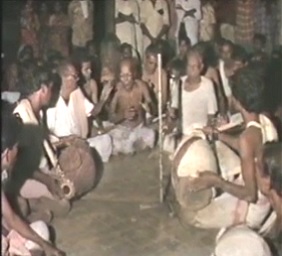
|
Nandotsav song | |
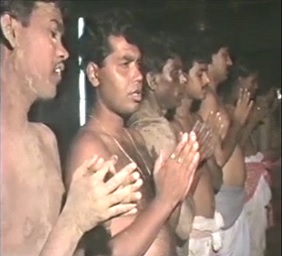
|
Invoking the ancestors | |
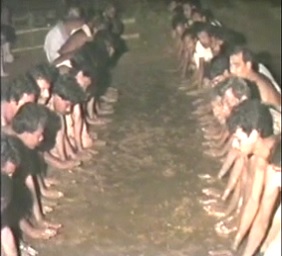
|
Final prayer ‘Sachir nandan nath’ |
Post Script, 30 March 2023, 8:30 pm
A thought has been on my mind about the dance ‘Byom byom Shib nache’, clip number 14, above. I was thinking, how come the Mitra-Thakurs, being such deep Vaishnavs, sing this song to Shiva? Was there no conflict here between Vaishnava and Shakta practices? The thought occurred to me, unlettered as I am in matters of religion. I had this conversation in the afternoon of 30 March 2023 with my all-time guide in Mainadal, Nirmalendu Mitra Thakur, and here is what he said on the phone.
Nirmalda explained to me that there was no problem in singing the song of Shiva, or Shib, as they see Shib as a param Vaishnava or a highest devotee of Krishna. How come? I asked. Their Shib was not Tantric, he told me. The way he spoke, it appeared to me that it was a matter of unquestioned belief. I found it too complex to understand. Nirmalda said we would have to discuss this in another session some other day. In this song that we are singing, Nirmalda said, we are not only talking about the dance of Shib (byom byom Shib nache) but of the entire heaven and earth. Everyone is rejoicing the birth of Krishna. Brahma is dancing, Indra is dancing, Shiva is dancing, as the cowherds are also dancing–there is no end to our ananda (happiness). Then he sang some more songs about Shib from their own kirtan repertoire. For example–and here he was citing a composition of Chandrashekhar of Kandra, Bardhaman–there is this song when Ma Yashoda (Jashoda in Bangla) is typically afraid to let her child Krishna go out with the cowherds. Krishna’s friend Sridama (or Sreedam as we say in Bangla) tells Jashoda that there are these protectors who are around when Krishna goes to the field or the woods, one is a strong man and appears to be in rage; he is covered in ashes. The cowherds have no idea who this might be. He comes riding a bull and on his left side is a woman. He offers flowers and the water of the Ganga to our little Gopal. Ganga, in Vrindavan? Jashoda asks. Yes ma, Sridam says, it is strange, He has matted hair, shakes his head and water keeps flowing (he is referring of course to the story of the birth of the Ganga from Mahadev or Shiva’s dreadlocks) and with that they wash your Gopal’s feet. And the woman? Well, ma, you are so proud of your wealth of cows and how you can feed curd to your boy, but you can do that with only two hands, can’t you? With one hand you lift your child, with the other you feed. This woman can feed him with her ten hands! So, don’t you worry ma, they are there to protect our little Krishna, there can be no harm.
It was a beautiful song that Nirmalda was singing. He moved at ease as he sang and talked. He told me about some other padakartas (composers) and their compositions, namely Shashishekhar of the same Kandra family and Shibai Das (whose origins he could not tell me). I listened but it is not easy to grasp the depth of this knowledge which they have been holding for generations. They wear it so lightly. As always, I was truly glad we had this conversation centred around the beautiful, dancing body of Nityananda Mitra Thakur whose charm does not wear off for me and whom I cannot help missing, even regretting we did not make the most of our very brief encounter with him. Yet, it is also in such moments when we talk about him that Nitai comes alive and stands in our midst. I see him dancing and singing in joy, as the one who always stood out in a crowd.
Post Post-Script, 30 March 2023, 10:39 pm
A message from Milan Mitra-Thakur, after he read the above note. I had called him first this morning to ask about the Shiva dance and he asked me to talk with Nirmalda.
তখন মনে পড়ল না , কীর্তনে রাসলীলা গানের শেষে শিব নৃত্য হয়, নিতাই এই শিবনৃত্য করতে করতেই আসরে মারা যায়। রাসলীলায় শিব নৃত্য কেন হয় সেটাও নির্মলই বলতে পারবে।
Nirmalda and Milanda are cousins. Milanda guides me in matters relating to archiving and the history of Mainadal, Nirmalda teaches me things about their songs. Now Milanda has written: ‘I did not remember at the time when you called. But there is a dance of Shiva that happens at the end of our Rasleela kirtan, and this is what Nitai was dancing, at the close of Rasleela [in 2015] when he collapsed on the floor and died. Why they dance the Shib-Nritya at the close of Rasleela is also something Nirmal will be able to tell you.’
I am dumbstruck to read this message.
Imam Bux Boyati and his team, were jarigan singers from Atharobari, Mymensingh. They were recorded twice at the Suri Mela, Suri, district headquarters of Birbhum; first on film in 1931 and then on wax cylinders, Bake India II/112-17 the next year. It was Gurusaday Dutt (1882-1941), the district magistrate, who used to organise this festival.
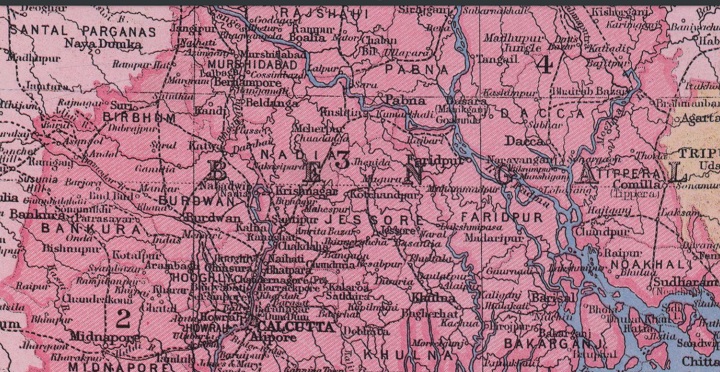
A section of a map from the Imperial Gazetteer of India Atlas, India and Sikkim 1931. Map kindly shared by poet and comparativist Taimoor Shahid. Original can be accessed here.
Arnold Bake’s field trips in and around Bengal were facilitated by Gurusaday Dutt, who was not only the district’s principal administrator but was himself a compulsive collector of folk songs and dances and craft of undivided Bengal, and a folk revivalist who had started the Bratachari Movement, ‘that blended nationalism, folk dance, “aerobics” and physical fitness, encouraging self-confidence, especially among women, spread throughout India. But its original inspiration was the Bengali village,’ as art historian Partha Mitter wrote. With such shared interest, it was natural for Bake and Dutt to become friends.
Jari dance from Mymensingh at Suri Mela in 1931. Filmed by Arnold Bake. Copy of film from Archives and Research Centre for Ethnomusicology (ARCE), Gurgaon, with kind permission. No copies of this may be made without ARCE’s permission.
In 1932, Bake recorded extracts of jarigan, where the singers began with the invocation or bandana gaan to the Creator and protectors, divine and human, and went on to sing vignettes from the tragic Battle of Karbala (680 CE). On 23 February 1932, Arnold Bake wrote to his mother, ‘We went to stay for just a day, but when we were there we discovered such interesting things, that we decided to stay until Tuesday night. I managed to get hold of the songs that I missed during Gurudev’s parties in Calcutta. Moreover, on Monday night, we saw some dances from Faridpur that were incredibly interesting. […] Our visit to Suri has been fruitful; just meeting Shivratan Mitra would have made the journey worthwhile, and I am so very happy that I finally managed to get the songs that go with the dances that I filmed there last year.’ (Translation from the Dutch by Jan-Sijmen Zwarts)
Interesting that Bake should talk about Faridpur, because the jarigan singers and dancers were from Mymensingh. Who then is he talking about? Could it be that while the leader of the jari team was from Mymensingh, the dancers and singers were also from Faridpur? I am confused. Faridpur though has been such a special place for The Travelling Archive, and you will see that if you go through the rest of the website. We had the first taste of jarigan here. Then there is also the work of Mary Frances Dunham, on jarigan which she had so generously shared with us. Interesting is the fact that Jasimuddin, the folk poet and song collector, was from Faridpur and we can hear him on Dunham’s page.
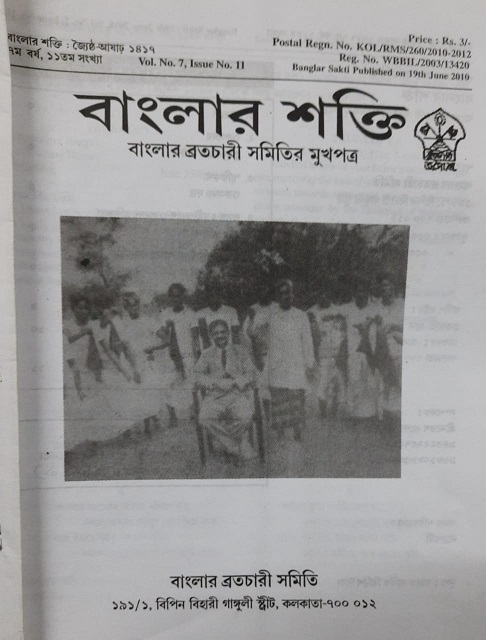
Gurusaday Dutt with Imam Bux Boyati and his jarigan team from Mymensingh on the cover of Banglar Shakti 2010, originally printed in Bangalakshmi (year unknown). Photo courtesy: Naresh Bandopadhyay
Jarigan sessions are long, as they are narrative songs which can take days to sing. Whatever could then be inscribed on a three-minute cylinder? Yet, the recordings are a record of a time, and much more. Arnold Bake did not write down the names of the singers, only that it was jarigan from Maimensingh. It is from Naresh Bandopadhyay, a Bratachari practitioner and teacher, that I came to know about Imam Bux Boyati of Atharobari. Gurusaday Dutt was methodical in the way he collected songs, dances, folk art and craft. His work did not stop with his collection but he also researched, discovered and drew conclusions about folk forms and worked all his life to propagate them, also from his station as a senior civil servant. The Gurusaday Museum was opened in Kolkata with his lifelong collection, in 1961. Sadly as I write in 2021, the museum is facing closure owing to a funds crunch and also administrative lapses. Naresh Bandopadhyay, or Bratachari Nareshji as he is called in their Bratachari circles (Dutt had introduced this system of adding the suffix ‘ji’ to every member’s name, as a mark of respect. Hence Gurusaday was Guruji), has been associated with this museum and with the Bratachari Samiti for over four decades.
Telephonic conversation in Bangla with Naresh Bandopadhyay on 20 March 2021, in which he also sings bits of songs. As an aside, it will be interesting to note the evolution of the recording device in the life of the field recordist; how we now record a ‘virtual field’ and the quality and character of the sound which comes out of it.
I had called Nareshji to ask for some clarification about Bake’s jarigan films and recordings, but I got much more than what I was seeking to know. Did Imam Bux and his team of singers come twice, once in 1931 and then in ’32 again? Nareshji explained the circumstances of Imam Bux Boyati’s visits to Suri Mela and elsewhere, about how Gurusaday Dutt used to travel with them to showcase jarigan and nach (dance), along with a team of Raibenshe (the martial dance of Bengal which Dutt propagated) dancers and bauls. He told the story of how Dutt found baul dance in Mymensingh and song in Birbhum and put them together, which seemed like a curious experiment to me. When was Gurusaday Dutt posted in Birbhum? After Mymensingh, right? After he was given a punishment transfer because he refused to take action against Gandhian protestors? Yes, Nareshji explained, but that was the last time he worked in Birbhum. He explained how it was not only in the 1931-32 period, when he started the Suri Mela, but from way back in 1915. Gurusaday and his social worker wife Saroj Nalini did much work for the uplift of the people of Birbhum in those early days. Later Suri Mela was designed as an agricultural fair, a platform for the farmer to display his produce—a krishi mela. There would be folk dance and music performances there too. And martial arts. That is where he brought in Imam Bux Boyati and his team, whom he had met during his posting in Mymensingh. In the above conversation, Nareshji also talked about how Gurusaday worked with Nabanidhar Bandopadhyay or Alaji, an assistant teacher of a school near Suri, in whom Dutt had seen the potential of becoming a great organiser of his Bratachari movement. Nareshji also talked about the folk dance of Bengal, Raibenshe; about how ancient it was and how Dutt had researched its mythological origins. We must remember that one of the main inspirations for Dutt’s work was Cecil Sharp in England Nareshji also mentioned Gurusaday’s work with Shivratan Mitra and his Ratan Library in Suri, the same Shivratan Mitra Arnold Bake had mentioned in his letter to his mother. He talked about the big pond with high embankment in Sultanpur, named after the Dutts as ‘Dutta Pukur’, which had been dug to alleviate the water crisis of the farmers and the local people of Sultanpur. I told him I had seen a photo of a ‘baby show’ in Sultanpur in the Arnold Bake Archives in Leiden.
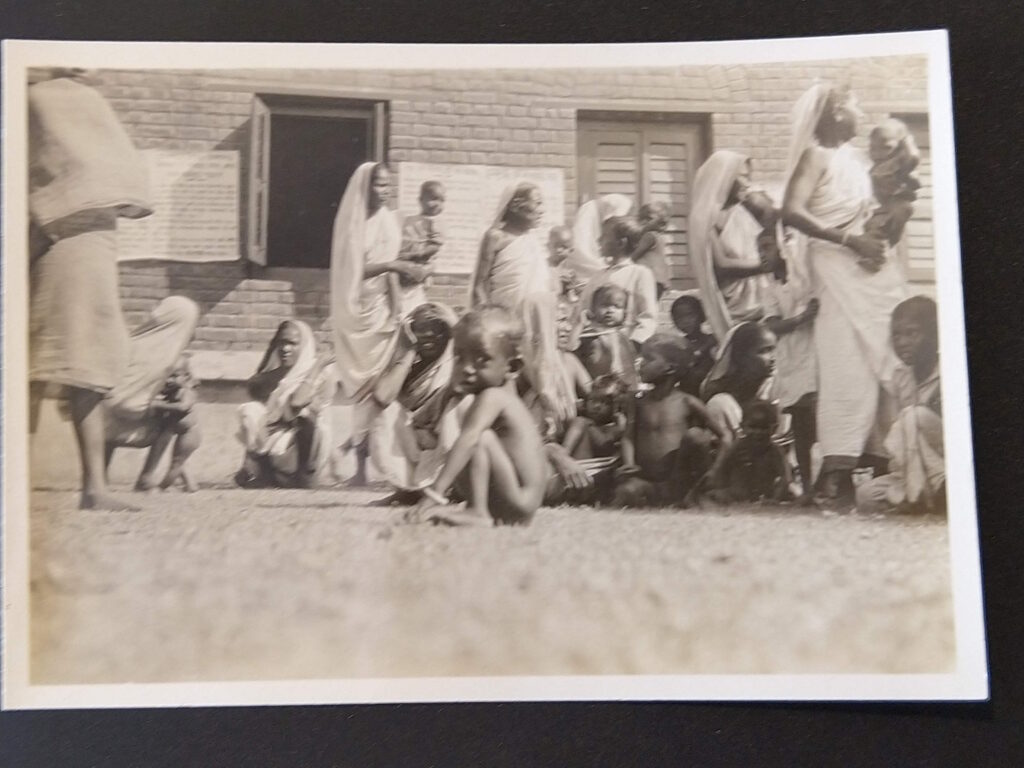
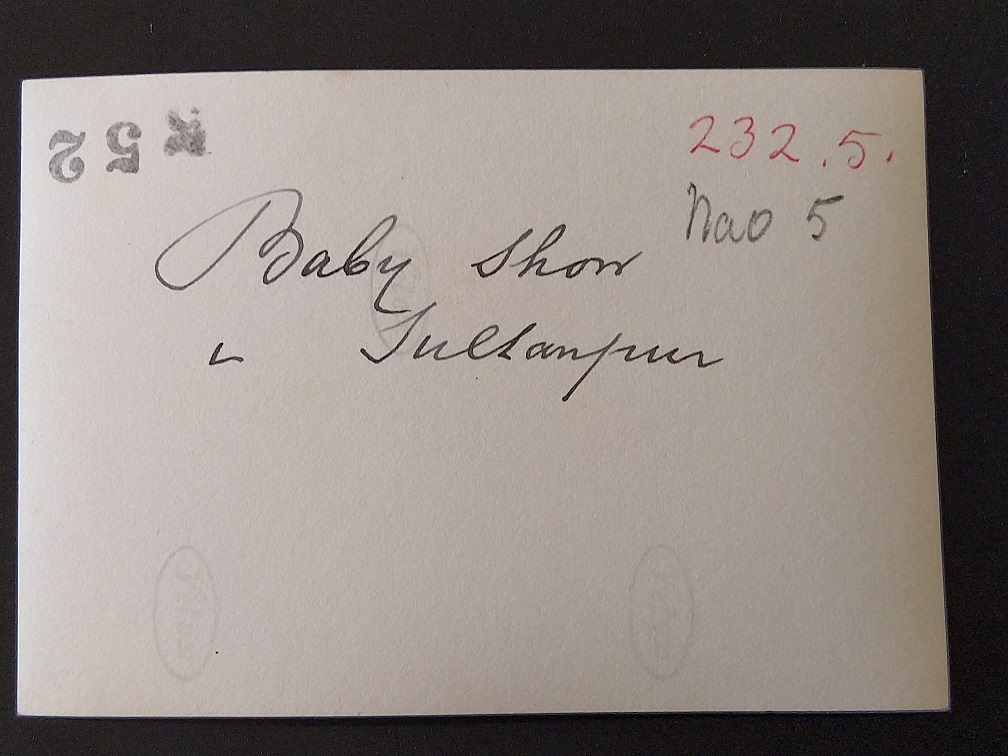
The images are self-explanatory. Naresh Bandopadhyay said that since Saroj Nialini Dutt worked for/with women, perhaps this was one of her missions. The baby show was probably designed with mother-and-child health in mind. Interestingly, this image is marked Nao 5, but has nothing to do with Arnold Bake’s Naogaon trip. So, the image was probably from 1932, when Bake went to Suri, because within a few days he went to Naogaon in Rajshahi, now in Bangladesh. This photo had probably got mixed up with his Naogaon photos. Source: Arnold Bake Collection, Special Collections, Leiden University Library.
It was the name of Imam Bux Boyati of Atharobari which took me to Helim Boyati (76) in Kendua Rajibpur, Kishoreganj in Bangladesh in 2019, renowned singer of jari and puthi (there is more on Helim Boyati in the Prisoners of WWI chapter). Listening to Imam Bux Boyati’s song, Helim Boyati began to sing the same song. He reminisced about the jari festival in Bhatgaon village near Sadhur Lau char in Kishoreganj. He talked about old times, old songs, sport, days of leisure, of eating and sharing food. He described how the dancers used to wear mekurs or anklets, which were later replaced by the ghungur.
Helim Boyati in his home in Kendua Rajibpur, Kishoreganj, Bangladesh on 13 October 2019. Recording, mine.
It was Imam Bux Boyati’s song which also took me to Haresuzzaman Hares, a folk song and folk arts collector of Binnagram, Kishoreganj who follows the footsteps of his father, Muhammad Saydur, who was a famous folk song and folk arts collector. I met Haresbhai on 16 October 2019 in Dhaka, in his office in the Liberation War Museum. Amid a lot of noise of people chattering, in the new building of the museum with its hollow sound, we talked about Imam Bux and Muhammad Saydur, who had apparently recorded Imam Bux. Then we made plans to go on field trips together, mainly in Kishoreganj. Haresbhai also promised to look for his father’s recordings of Imam Bux. Some day we shall find them.
And it was the jarigan recordings of Arnold Bake which had taken me to the Gurusaday Museum, also because I became part of a campaign to save the museum from closure. There I was surrounded by the art, embroidery, dolls and toys and scroll paintings and musical instruments which awakened all my senses of sight, sound, touch, taste and smell.
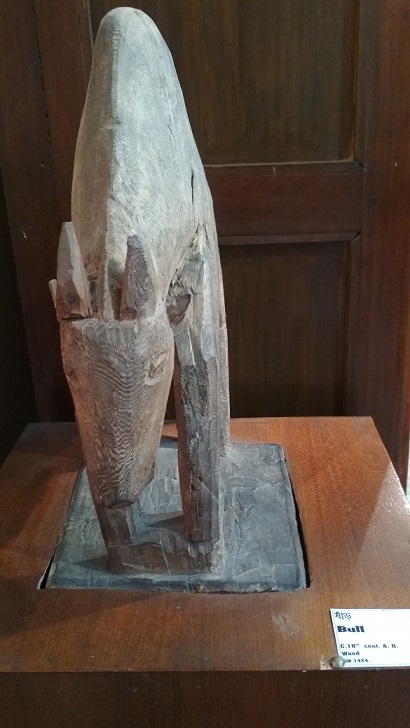
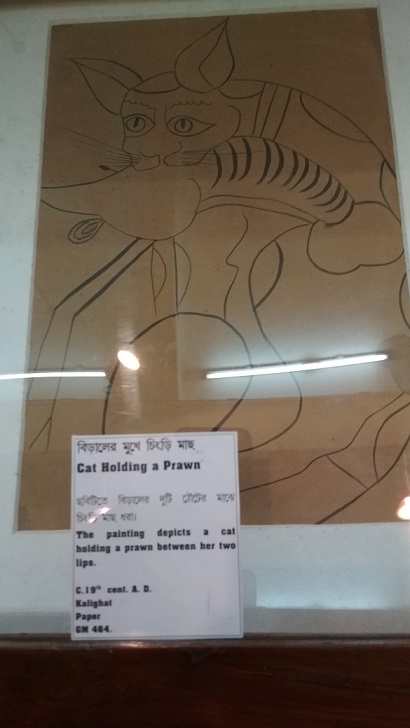
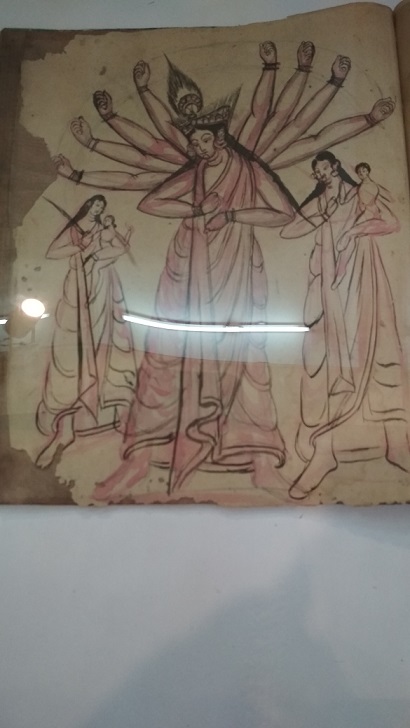
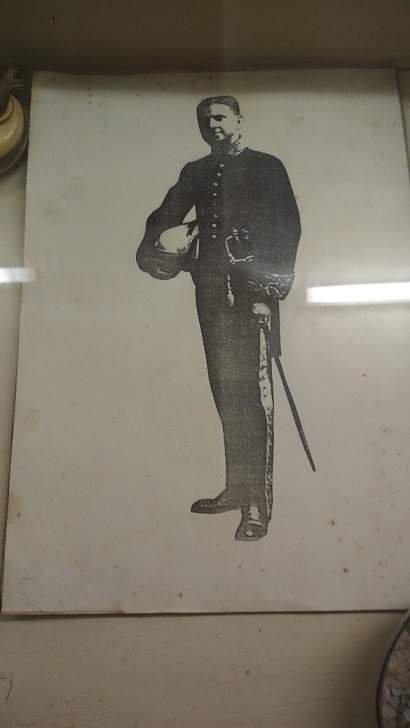
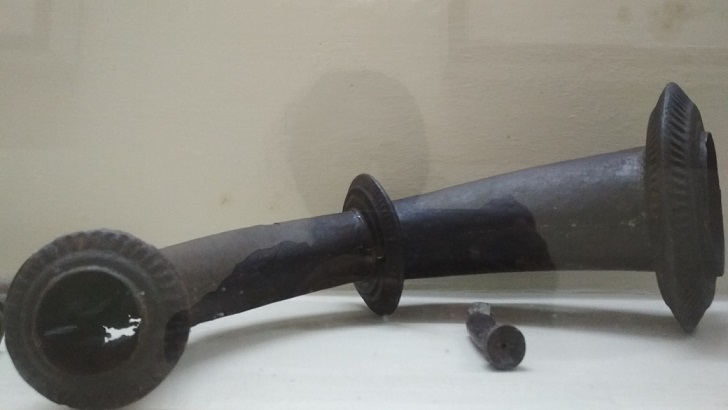
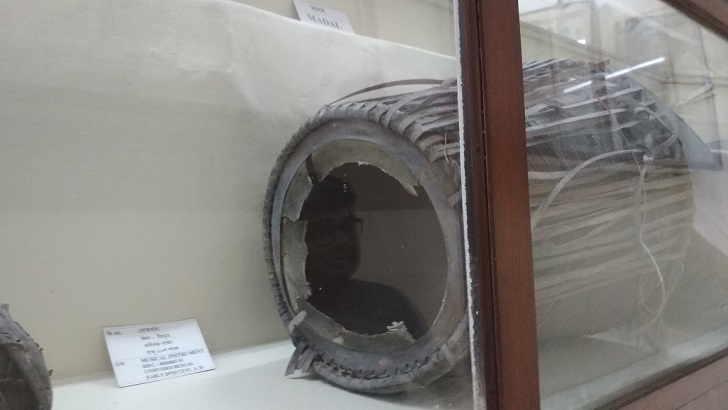
Visit to Gurusaday Museum, Thakurpukur, Kolkata on 11 April 2019
Postscript
On 26 August 2022, Bratachari Nareshji sent me a Whatsapp message with some photos. The message read: এ গুলো দেখুন। “ফোক ডান্স ডিসপ্লে” র ফোল্ডার।১৯৩৩এ। মনে ছিল। খুঁজছিলাম অনেক।আজ হঠাৎই পেয়ে গেলাম। পুরাতন অনেক,-এই সংক্রান্ত-কাগজের মধ্যে। ঠিক আছে।ভাল থাকবেন। (See this. The folder of the ‘Folk Dance Display’ organised in 1933. I had this in mind, had searched hard. Suddenly I found it today, tucked inside some other related papers. Very old stuff. Anyway, take care.)
Once again, the archive open the door to other archives.
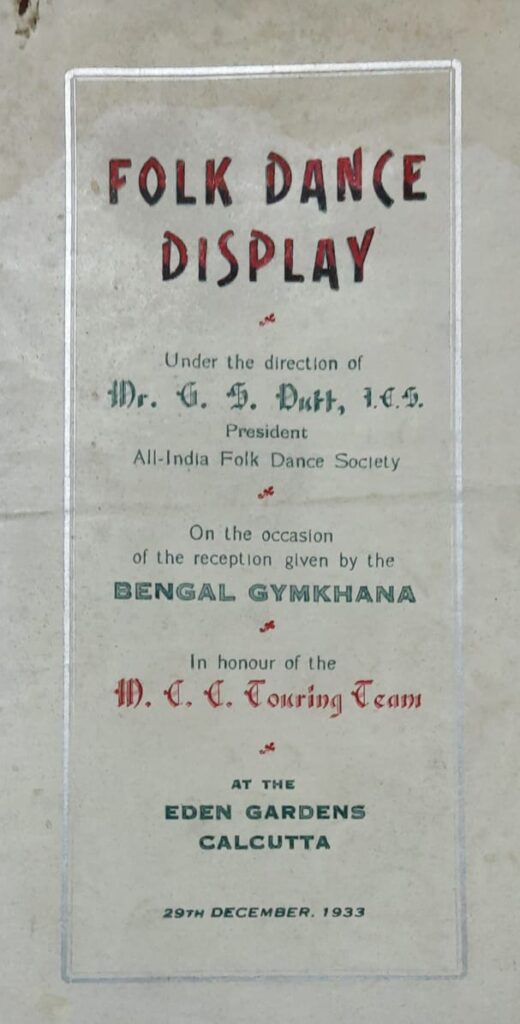
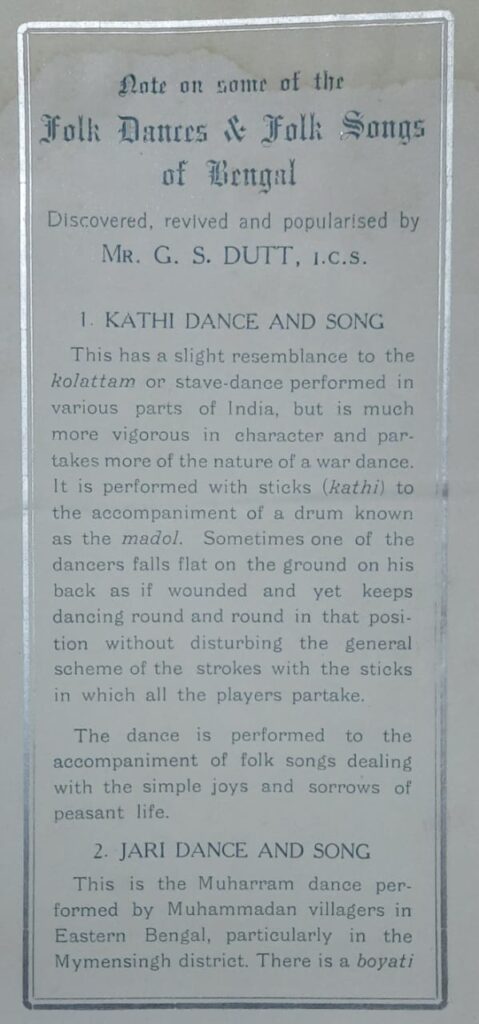
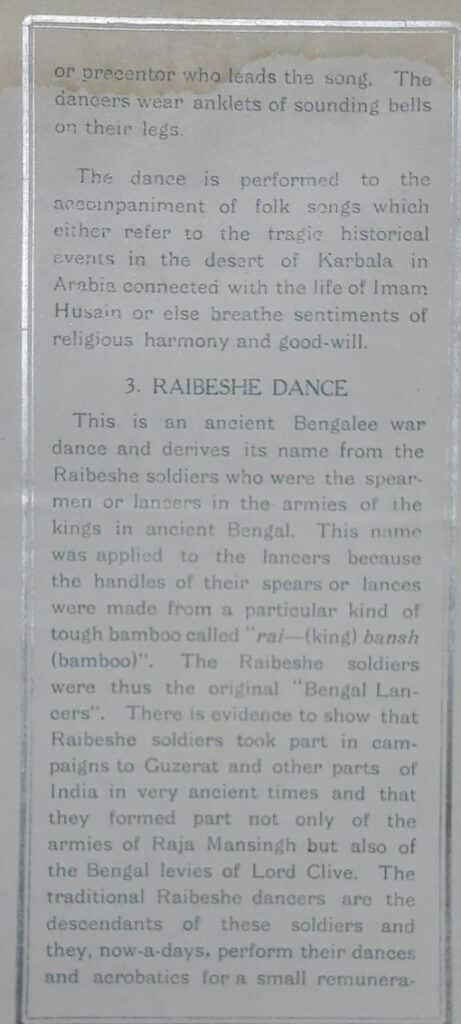
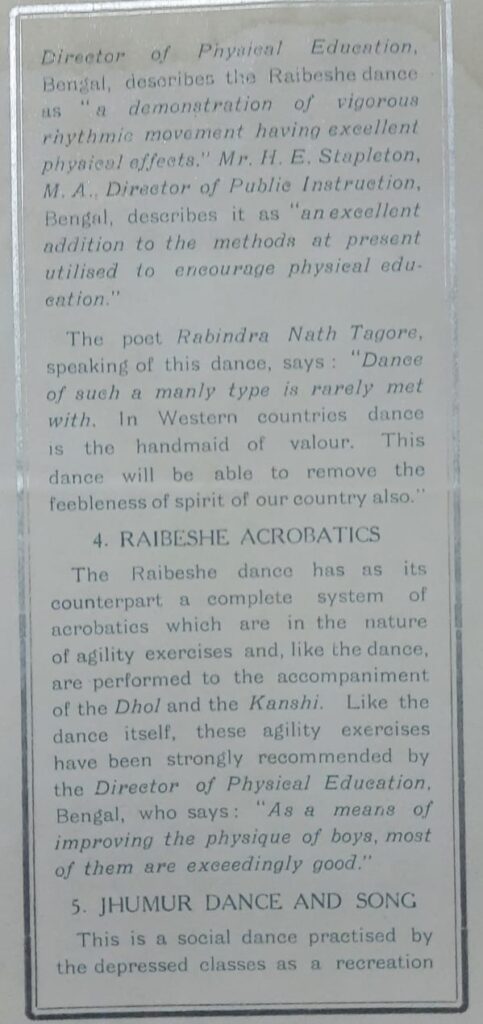
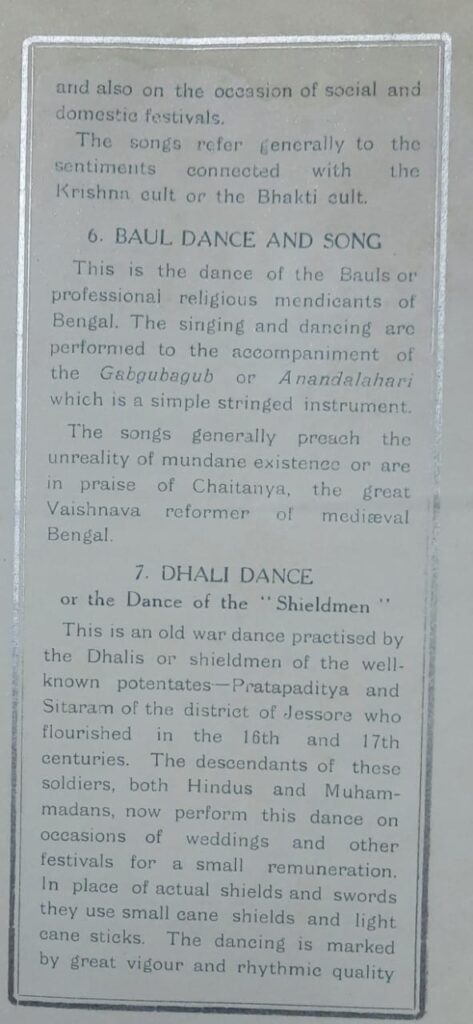
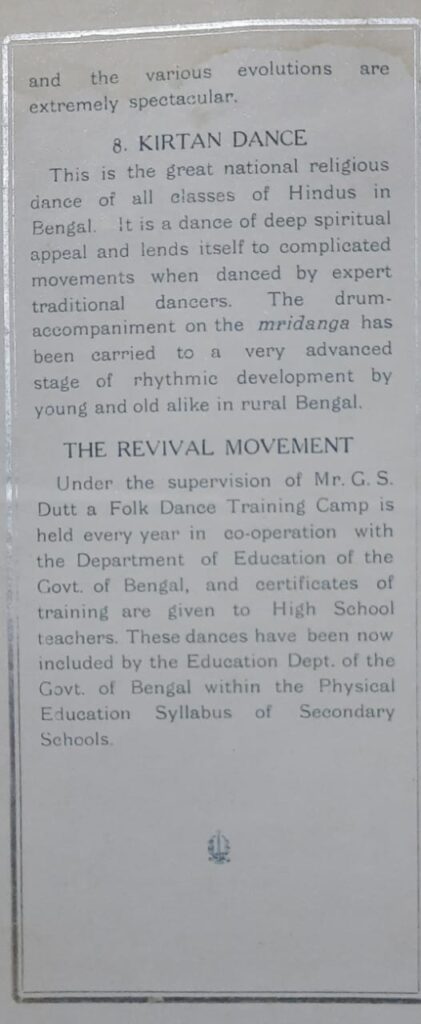
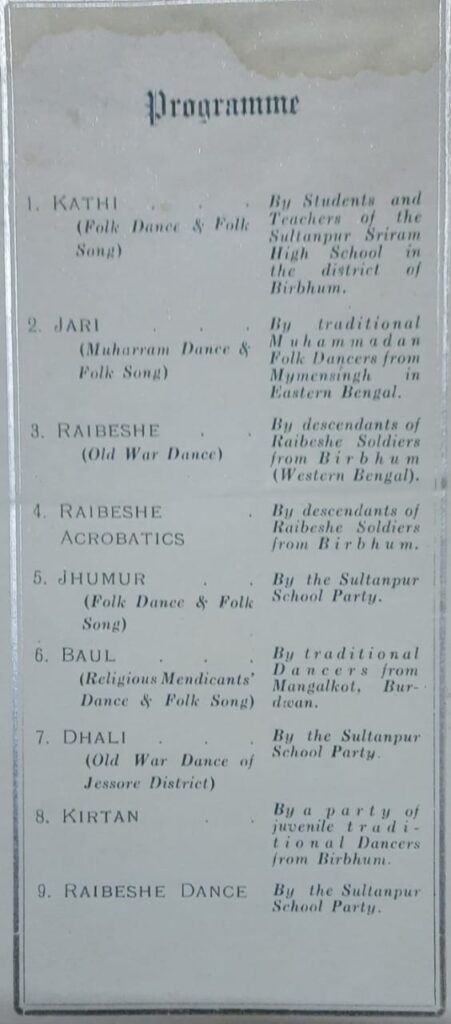
It began with a photograph. Jaya Tagore, grand-daughter of Satyendranath Tagore, elder brother of Rabindranath, with Kulprasad alias Motru Sen, her husband. As much as I understand, the photograph was taken in front of the thatch-roof house, the aatchala, where Arnold and Corrie Bake used to stay during their first four years in Santiniketan, between 1925-29. Jaya Sen was, incidentally, my close college friend Ayesha (journalist Ishani Duttagupta)’s grandmother, her Didimum, whose stories she used to tell us all those years ago. When I saw the photo in the archives, and read the description on its back, something seemed very familiar, but I could not make an instant connection. From there to Tagore’s songs sung by Motru Sen, recorded in 1962–it was another rich world of sound, image and story which I was led into.
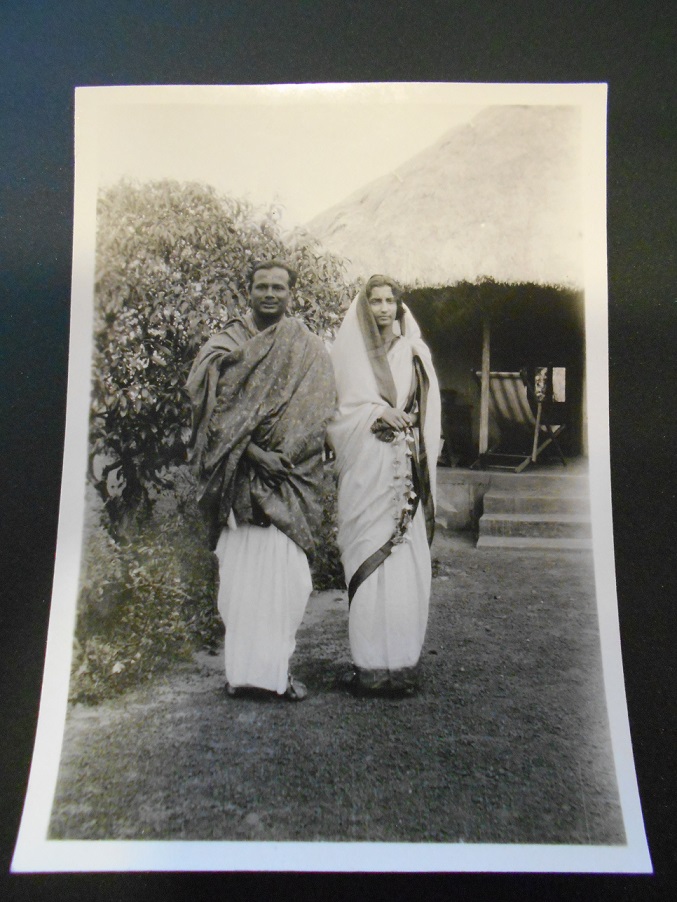
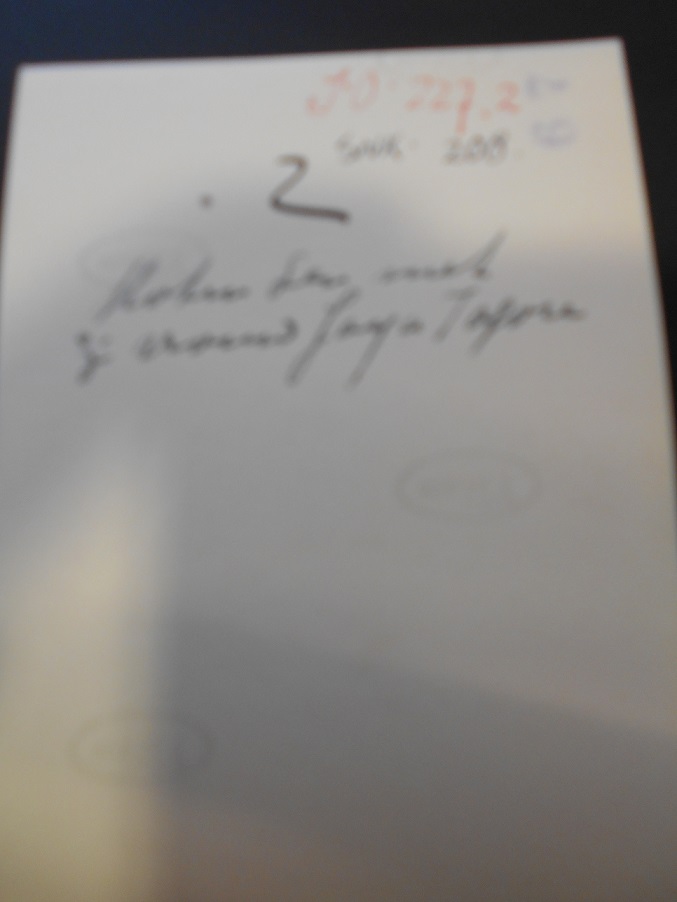
Arnold and Corrie Bake were friends of Jaya, her sister Manju, and Jaya’s husband Motru Sen as we know from Corrie’s diary entries and photos in the Arnold Bake archives of the Special Collection of Leiden University Library.
It was my old teacher Shibaditya Sen, Kshitimohan Sen grandson, who helped me identify the photograph when we (Sukanta Majumdar, Dutch translator Jan-Sijmen Zwarts and I) visited his house with the photographs of Arnold Bake on 18 January 2016, in preparation for The Travelling Archive’s Time upon Time exhibition. I called Ayesha and asked her if I could go over to meet her mother. So, on 22 February 2016, I met Haimanty Dattagupta, daughter of Jaya and Motru Sen, in her home in Kolkata. Ayesha was there too and they brought out their photos and I opened my files and there was so much unpacking of anecdotes which happened that day. This sub-chapter demonstrates how unpacking the anecdote works as a research methodology, the simultaneity of its lightness and depth, because what seems like mere adda is also when we were peeling off and piling up layers and layers of history. We were munching biscuits, having tea, looking through photographs and talking. Where is this one from? O from England, Ayesha said. ‘Didimum and her sister, Manju, were sent off to school in England. Where did they go, Ma?’ Ayesha asked. ‘To Bristol. To Duncan School. Rabindranath arranged for his two grand-nieces to be educated there. It was a crazy plan. They did not know a word of English and here they were in the English countryside, left to fend for themselves. All the girls gone home during the holidays, the two girls alone in the huge big school.’
Jaya Tagore and Motru Sen were a beautiful and romantic couple in Santiniketan. They married in 1927, on a Spring day, ‘Phaguner Choutha’, the fourth day of the Bengali month of Phalgun. Rabindranath had gifted them a poem, While wishing for them a long, happy conjugal life, he also pulled his grandniece Jaya’s leg and told her she better learn to fry nice round luchis for her husband and not serve him leathery round things which will make the cobbler jealous!
পাক প্রণালীর মতে কোরো তুমি রন্ধন,
জেনো ইহা প্রণয়ের সব সেরা বন্ধন।
চামড়ার মতো যেন না দেখায় লুচিটা,
স্বরচিত বলে দাবী নাহি করে মুচিটা,
পাতে বসে পতি যেন নাহি করে ক্রন্দন।।
Born in 1939, Haimanty was one of the triplets Jaya had, after two sons. In this clip from her nearly hour-long recording, we can hear the joy in her voice at seeing her parents’ photograph, and her aunt in another one.
Haimanty Dattagupta talks about her father
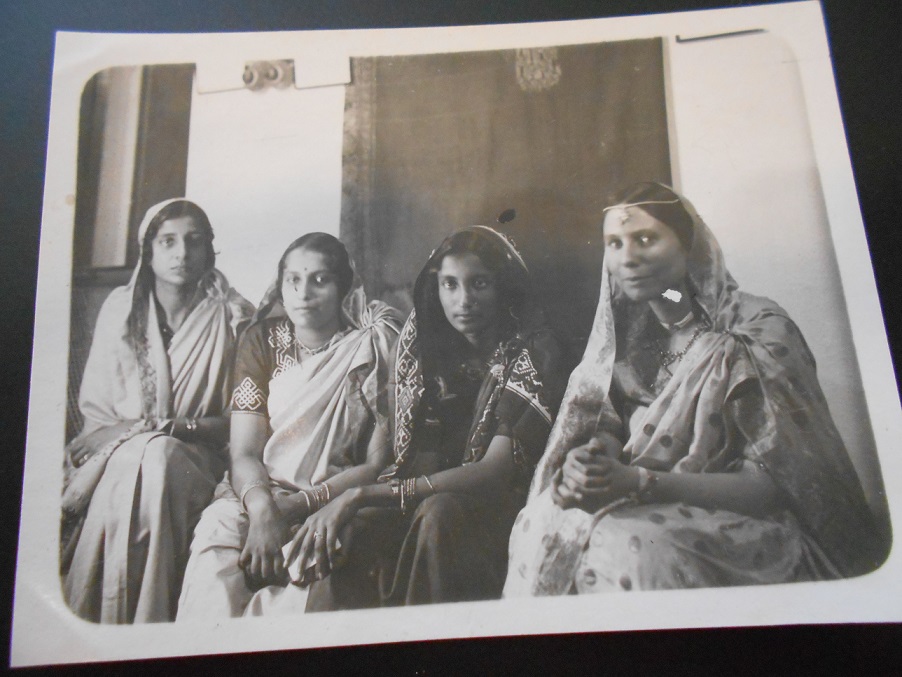
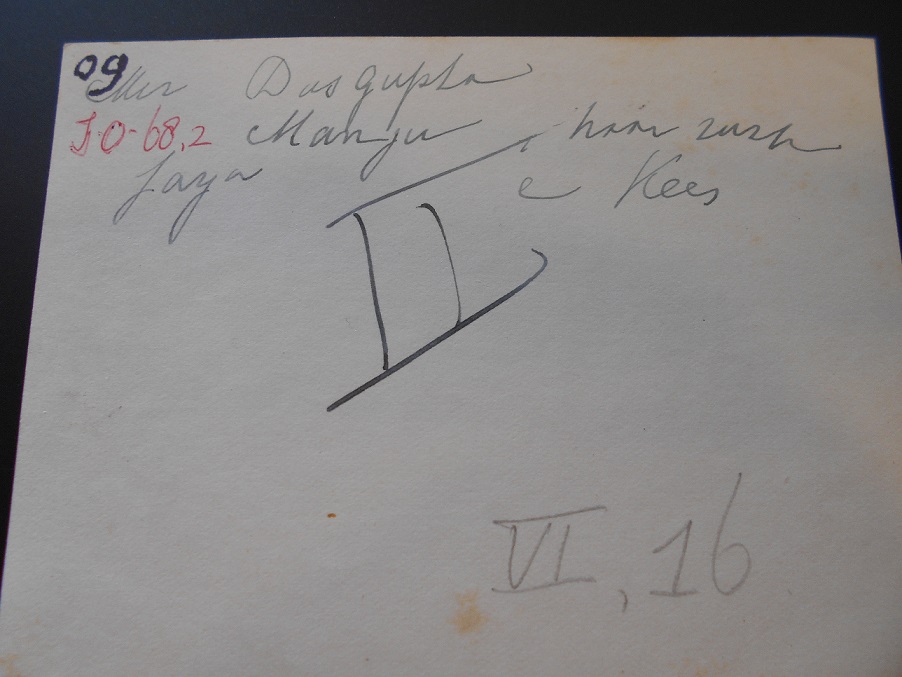
Cornelia Bake with Jaya and Manju Tagore and a Mrs Dasgupta. ‘Who in this group is Mashi?’ Haimanty Dattagupta and her daughter were slightly confused at first, then settled for the woman next to her mother. This is a photo of a photograph from the Arnold Bake archives of the Special Collection of Leiden University library.
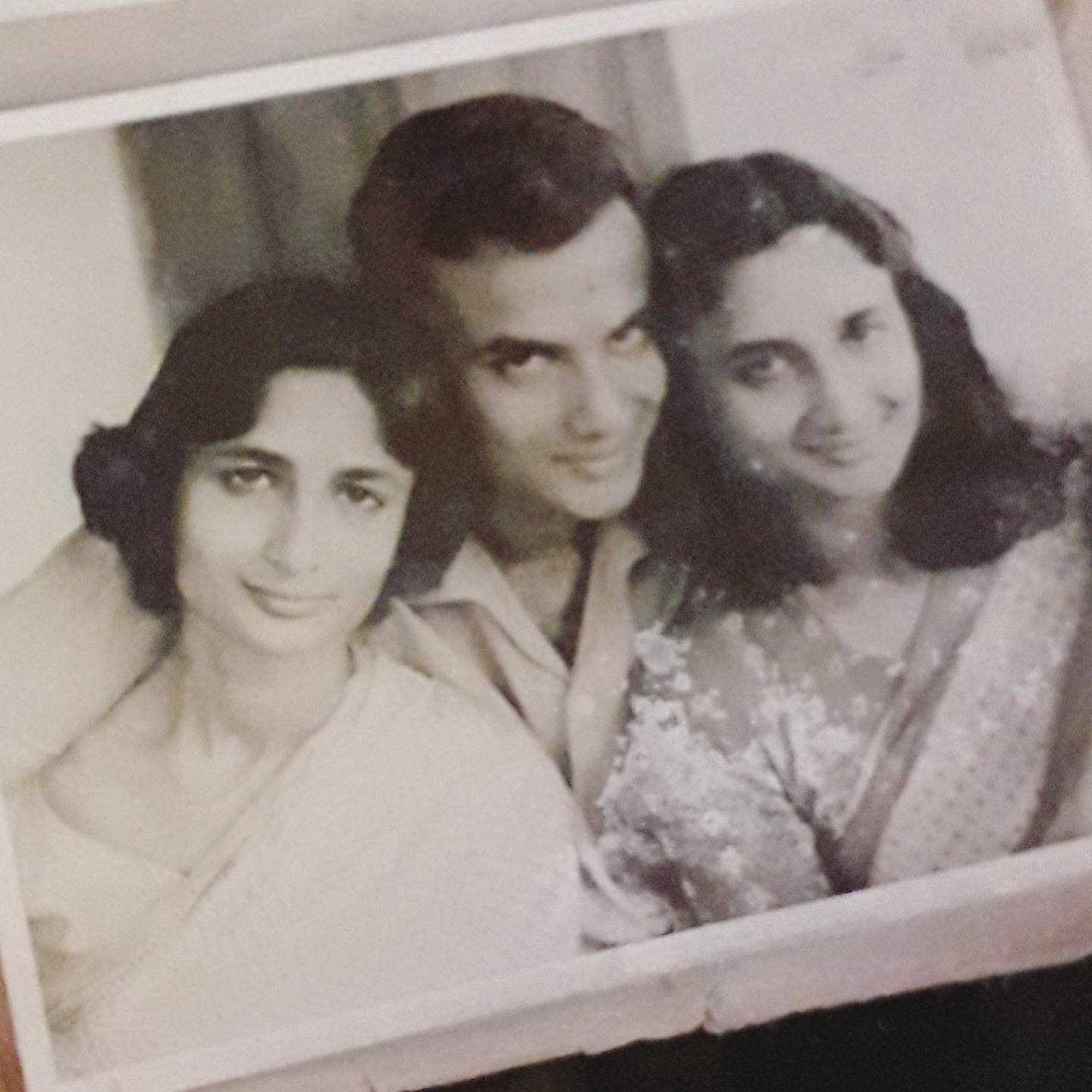
The triplets, Jayanti, Haimanty and Sunandan. Courtesy: Family of Haimanty Dattagupta
Haimanty began to recall stories, as Ayesha and I prodded her with questions. What was her father’s connection with Santiniketan? Where was their ancestral home? Soft-spoken Haimanty Dattagupta described her father, Kulaprasad Sen, as a ‘truly fantastic’ person. He used to work in the postal services and retired as Post Master General, so they lived in many places and the children kept moving school. Then he bought 12 bighas of land in Santiniketan, to grow things, build a house and settle down, while also working as the officer in charge who set up the museum in the Tagore house in Jorasanko, Kolkata, during Tagore’s centenary year. He was given the task by the then Chief Minister of West Bengal, Bidhan Roy. Kulaprasad was also responsible for propagating the works of Tagore by organising the publication of the low-price edition of his complete works. Their Santiniketan connection went back a long way, to Kulaprasad’s grandfather’s time, because the Tagores and the Sens were family friends—early ICSs, first batch, second batch and so on. When Kulaprasad’s father died, they were very young—he was five, his younger sister was three. Their mother, Snehalata Sen, was one remarkable woman who came from a highly Anglicised family, went to Loreto Convent, but later when she had to fend for herself and bring up her children by herself, she taught in various schools till Rabindranath asked her to join the asram as the supervisor of the first girls’ hostel.
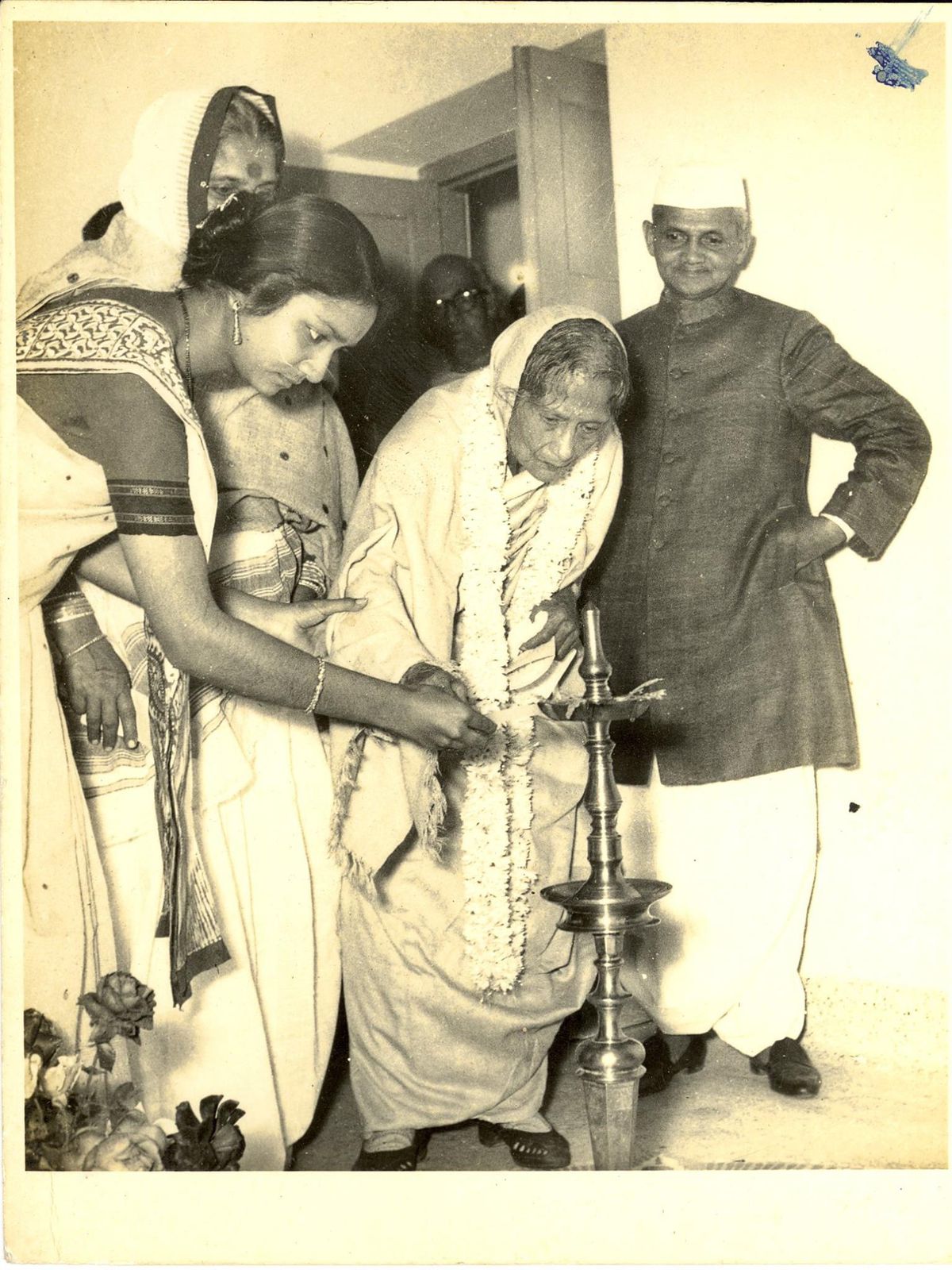
Former Indian PM Lal Bahadur Shastri looks on as Snehalata Sen lights a lamp to inaugurate a girls’ hostel in Santiniketan. The year, possibly, was 1964. Photo very generously shared by Ishani Duttagupta.
Haimanty on her paternal aunt, Malati, as an untameable young girl.
As I was showing her photos from my folder, we came upon one of C. F. Andrews and P. Lal, both of whom were very active in the Sriniketan rural reconstruction project (the latter I get mixed up with the Swiss-French linguist, Fernand Benoit in the above audio clip).
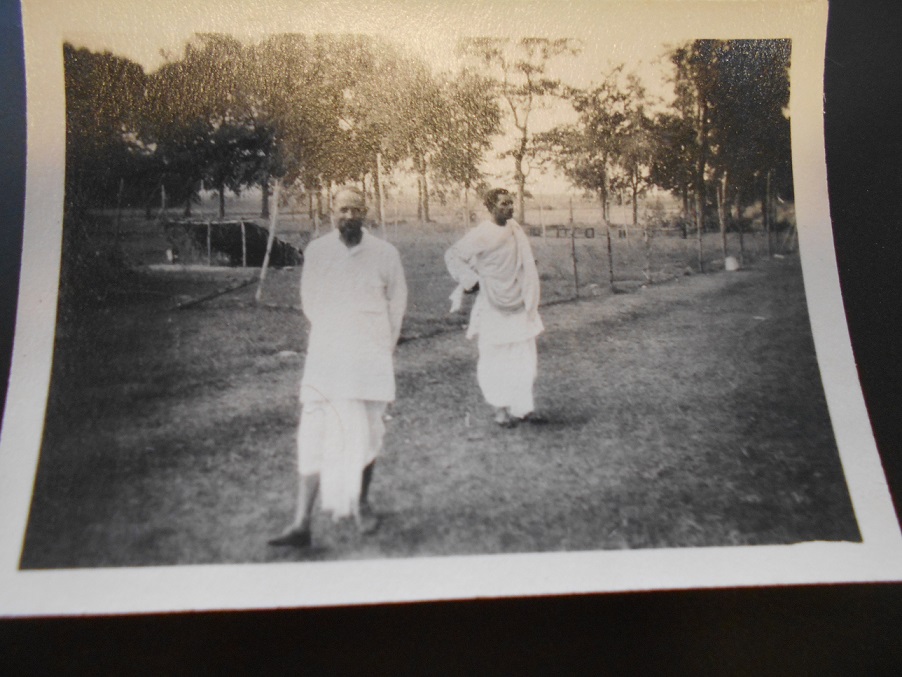
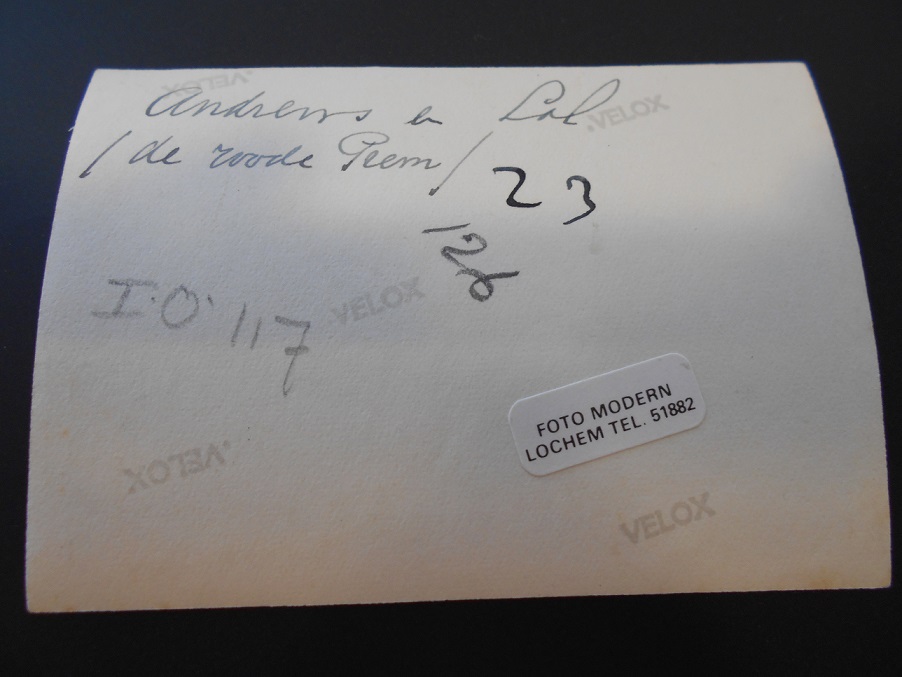
Andrews and Lal. Photo from Arnold Bake Collection of Special Collections, Leiden University Library
We got talking about Andrews, the Anglican priest who was close to Gandhi and Tagore. Haimanty Dattagupta said, ‘There is a funny story about my aunt, Malati, then just a school girl. Once she had this idea and went to Andrews’ house with a friend. He was out at the time. So she said to whoever opened to door, “O, but he had invited us!” Then this person made food for them, which the girls happily ate and left.’ Ayesha and I laughed so much. This wild girl later went on to become a famous social worker in Orissa. Haimanty looked through the photos to see if there was one of her pishi too, but we could not find any.
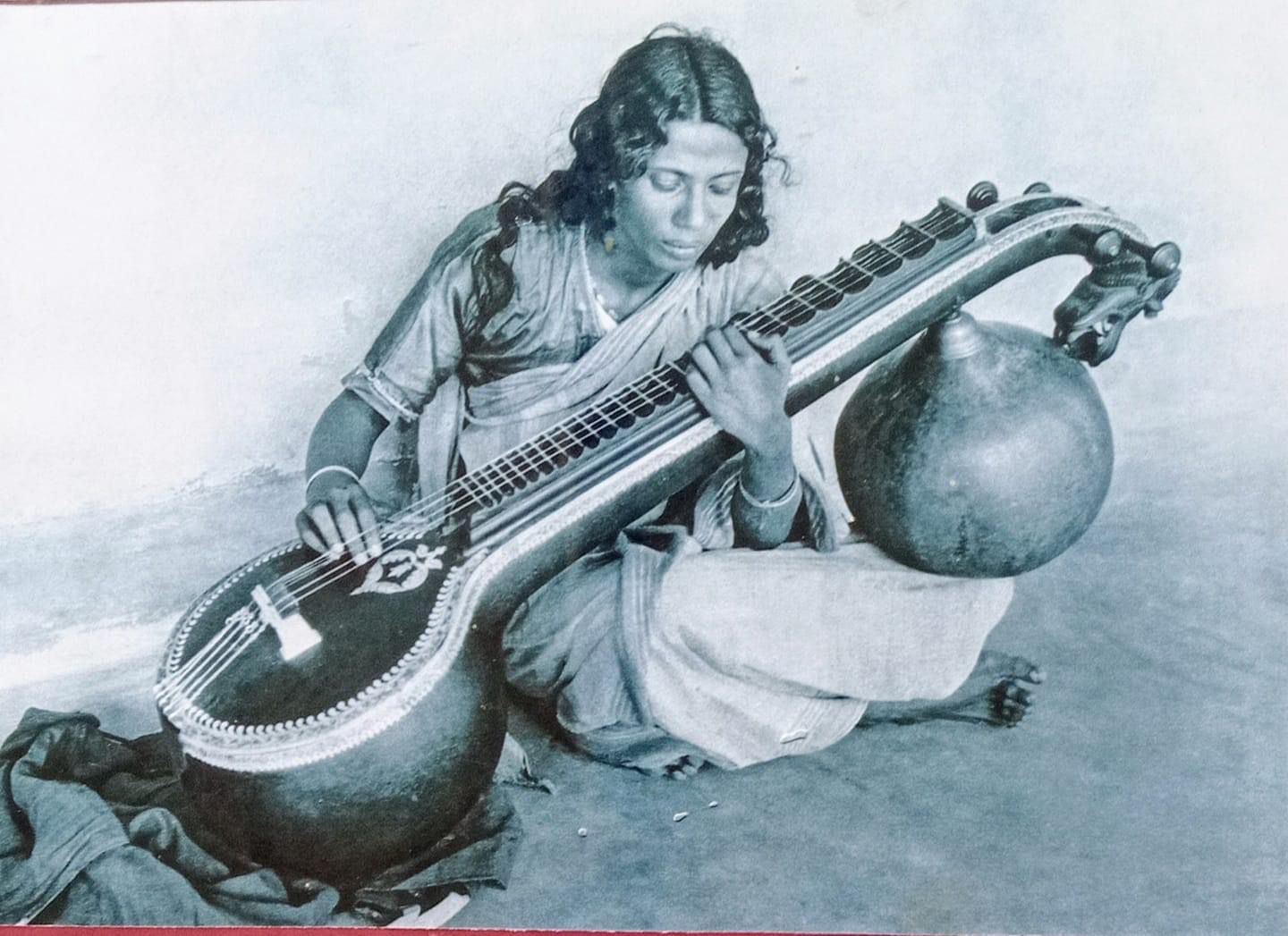
This picture of Malati Sen was once on the cover of Illustrated Weekly of India. Ayesha sent it to me with the following note from Malati’s daughter, Krishna Mohanty: Malati Sen was a student of Visva Bharati, Santiniketan from 1920-26, in the first batch of girl students. Her mother Snehalata Sen was superintendent of girl’s hostel and also a teacher. Malati/Minu, besides her regular studies in Visva Bharati, learned music, dance, drama and so on from Gurudev Rabindranath himself and Dinendranath, Pandit Bhimrao Shastri and the veena from Guru Sangameshwar Shastri. Among all the pupils of Sangameshwar Shastri, Malati continued her practice of veena even after she married Nabakrushna Choudhury, a famous social worker of Odisha, who later became Chief Minister of the state. They were Gandhians, lived away from the city, did farming and worked among the rural poor. It was Malati’s earnest desire to see a society without any creed, caste or class. With her very busy schedule, whenever she got little leisure she used play the flute. Early in the mornings she would play tunes of Rabindrasangit or Karnataka music on her veena. Malati sang in her melodious voice to gather crowds at freedom movement meetings or marches between 1930-42. She lost her this veena in the 1942 movement, when she was imprisoned for three and a half years. About this she would say, ‘We have lost Gurudev, we have lost Bapu, this is a mere instrument.’
Music clearly was in their blood, because Malati’s elder brother, Motru Sen was a gifted singer and he could also play many instruments. In 2020, Ayesha sent me two songs of her grandfather on whatsapp and I was amazed to listen to them. She said there was a whole set of songs which had been recorded in 1964, in Jorasanko, after the house had been converted into a Tagore museum. Kulaprasad Sen had been officer in charge of this project, as we know. There might have been a studio or an office in the house where these recordings were made—the family is unsure of the provenance of these recordings. However, Kulaprasad’s younger son, one of the triplets, had the original tapes and made copies for the rest of the family. One other granddaughter of Jaya and Motru Sen, historian Samita Sen, later digitised the magnetic tapes and I am very grateful to the family of Jaya and Motru Sen for allowing me to keep these songs in my archive of Arnold Bake. The recordings below are many times removed from the original, yet they are a record of a time and of a style of singing and training early singers of Tagore’s songs received. Arnold Bake and Motru Sen were about the same age, the former born in 1899 and latter in 1902. They were taught by the same teachers–Rabindranath and Dinendranath. Moreover, they were also friends.
The tape starts with the following announcement, which I have learned was in Kulaprasad’s own voice. But he speaks in a way as though he was talking about someone else. We can hear him turning on the recorder. ‘These recordings in the voice of Kulaprasad Sen are being made as part of a project to archive and preserve the melody and style of Rabindrasangit of India. He goes by the name of Motru in known circles. His maternal grandfather Biharilal Gupta’s family were close friends of the family of Rabindranath Tagore. Kulaprasad’s mother, Snehalata Devi, now over 90 years old, was a classmate and close friend of Indira Devi. Snehalata Devi was proficient in Western music and she learned Rabindrasangit in the early days in the Jorasanko house itself. Kulaprasad’s first lessons in Rabindrasangit were from his mother. Later, as a boy, he had lessons from Sangitacharya Surendranath Bandopadhyay. He had the opportunity to learn directly from Rabindranath and Dinendranath in 1328 BS (1921 CE), during the first Barsha Mangal or Monsoon Festival in Santiniketan. Kulaprasad participated in that programme. He was 19 at the time. After this He went to Santiniketan and lived there for about three years. He used to take regular lessons from Dinendranath at the time, and also from Rabindranath and took part in the asram’s various ceremonies and festivals. Once he performed solo at the [Brahmo] Magh Utsav on 11 Magh [in February] and was much praised for his songs. Here he is has sung those songs which he learned directly from Rabindranath or Dinendranath. Kulaprasad is now 62 years old and his voice is not good enough. We cannot however expect him to have the voice he once had. First he will sing two songs which were written for the first Barsha Mangal, to the accompaniment of the pakhawaj.’
Here is the list of songs on this recording, with the starting time in brackets. After the first two songs, Kulaprasad Sen strums the guitar to the beat of the song, and sings. He does not play any chords, it is just a regular rhythmic strumming, as if he was playing the drone. That it is him strumming is something his daughter Haimanty told me, because he used to sing this way at home too.
Jhoro jhoro borishe (00:02:35)
Aaj bari jhore jhoro jhoro (00:06:33)
Ogo amar kheya torir majhe 00:09:56)
Timiro abagunthane (00:13:23)
Ei srabaner buker bhitor aagun achhe (00:16:08)
Badalo meghe madalo baje (00:18:52)
Megher kole kole jaay re chole (00:22:10)
After this set Kulaprasad announces that while the earlier songs were specially written for the first Barsha Mangal, the next ones are monsoon songs which already existed and which were also sung on that occasion.
E bhora badoro, maho bhadoro (poem of Vidyati, composed by Rabindranath) (00:24:50)
Abar eshechhe asharh (00:28: 31)
Haare re re re re amay chhere de re de re (00:30:57)
Kulaprasad then makes an announcement about the next song and says he is singing it in two rhythmic patterns and in two tempos as there are two versions of the song.
Amar nishitho raater badalo dhara (00:33:09)
When he sings in the slower 4/4 beat, he says nishitho, badolo. When the song becomes a faster paced dadra in 3/4 rhythm, nishitho becomes nishith, badalo becomes badal.
Bishwabina robe bishwajono mohichhe (00:38:37)
Srabaner dharar moto poruk jhore (00:40:56)
Dukkher boroshay chokkhero jol jei namlo (00:00:10)
Gaaner shurer aashonkhani (00:01:54)
After the first two songs, Kulaprasad gives a brief description of what is to follow. In the beginning of 1921, a bunch of students joined Gandhi’s non-cooperation movement and went to Surul Kuthi to stay and work. Departed teacher of Santiniketan. Nepal Chandra Roy, led the team, which Kulaprasad had also joined. There used to be meetings in village Surul, in Bolpur and other neighbouring places. Dinendranath would often join the meetings with a team of singers. Kulaprasad will now sing some of the patriotic/national songs they used to sing in those days. The tunes might vary from how they are sung now, but Kulaprasad is singing as he had been taught by Dinendranath.
Nishidin bhorsha rakhish (00:07:43)
Ami bhoy korbo na bhoy korbo na (00:10:19)
Je tore pagol bole taare tui bolish ne kichhu (00:12:08)
Jodi tor bhabna thake phire ja na (00:13:52)
Ma ki tui porer daare pathabi tui gharer chhele (00:16:40)
Amra pathe pathe jabo shaare shaare (00:18:54)
Before the next song the announcement goes that this is the song Kulaprasad had sung at Jorasanko on the day of the Magh Utsav; he had learned it from Indira Devi.
He moro debota (00:21:34 )
Then he talks about the department of agriculture in Surul which the British agronomist Leonard Elmhirst had started in 1921. Later it came to be called Sriniketan. In the beginning there were some 10-12 boys, Kulaprasad was one. The next song is related to this project.
Phire chol maatir taane (00:28:36)
Then Kulaprasad explains how the next song came to be composed, how a dance with small cymbals that Rabindranath had seen was the inspiration
Dui haate kaaler mandira (00:31:02)
It sounds like there were more songs, but the tape abruptly stops.
The files Srila Sen, my friend Ayesha’s cousin, sent to me came with this photograph of Jaya and Motru Sen. It must have been taken around the same time when Arnold Bake took his photo.
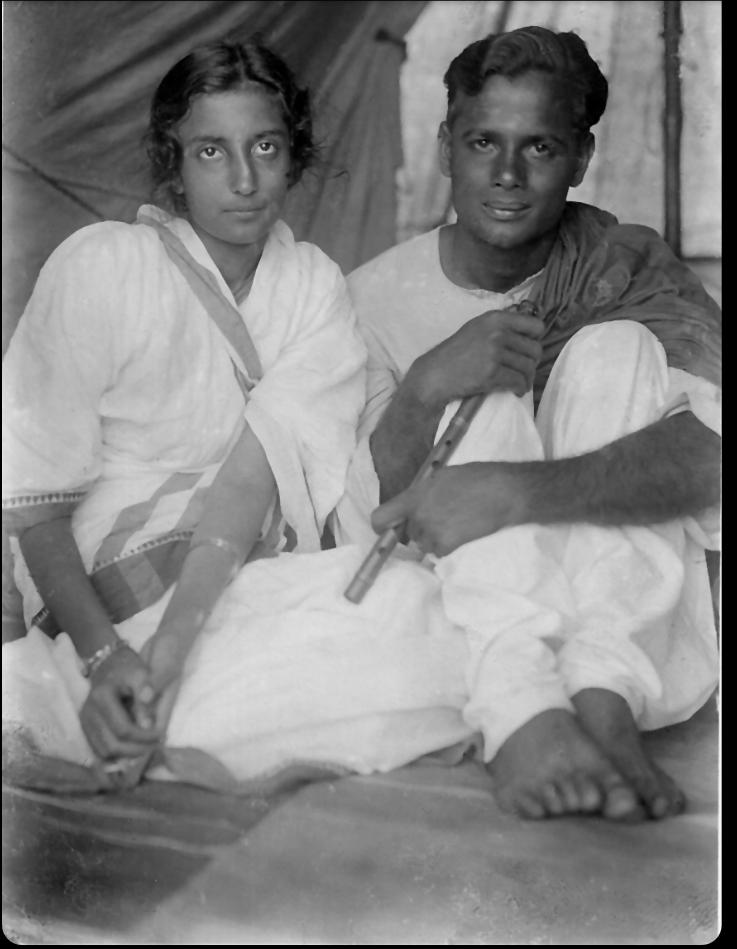
And here are some pages from a commemorative volume on Kulaprasad Sen, published by his family. This piece was written by the Marxist historian Gautam Chattopadhyay (1924-2006), son of Jaya’s sister Manju.
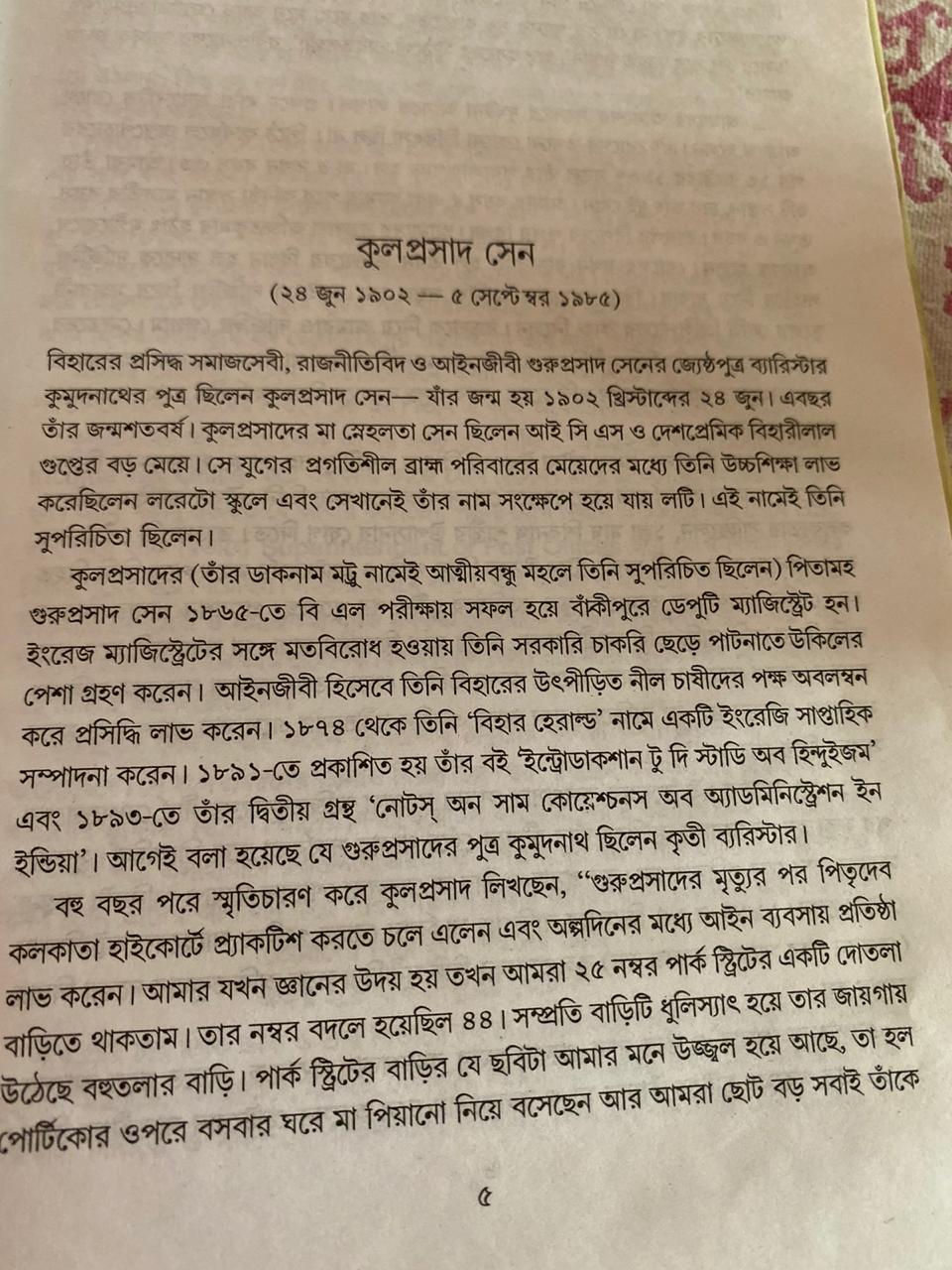
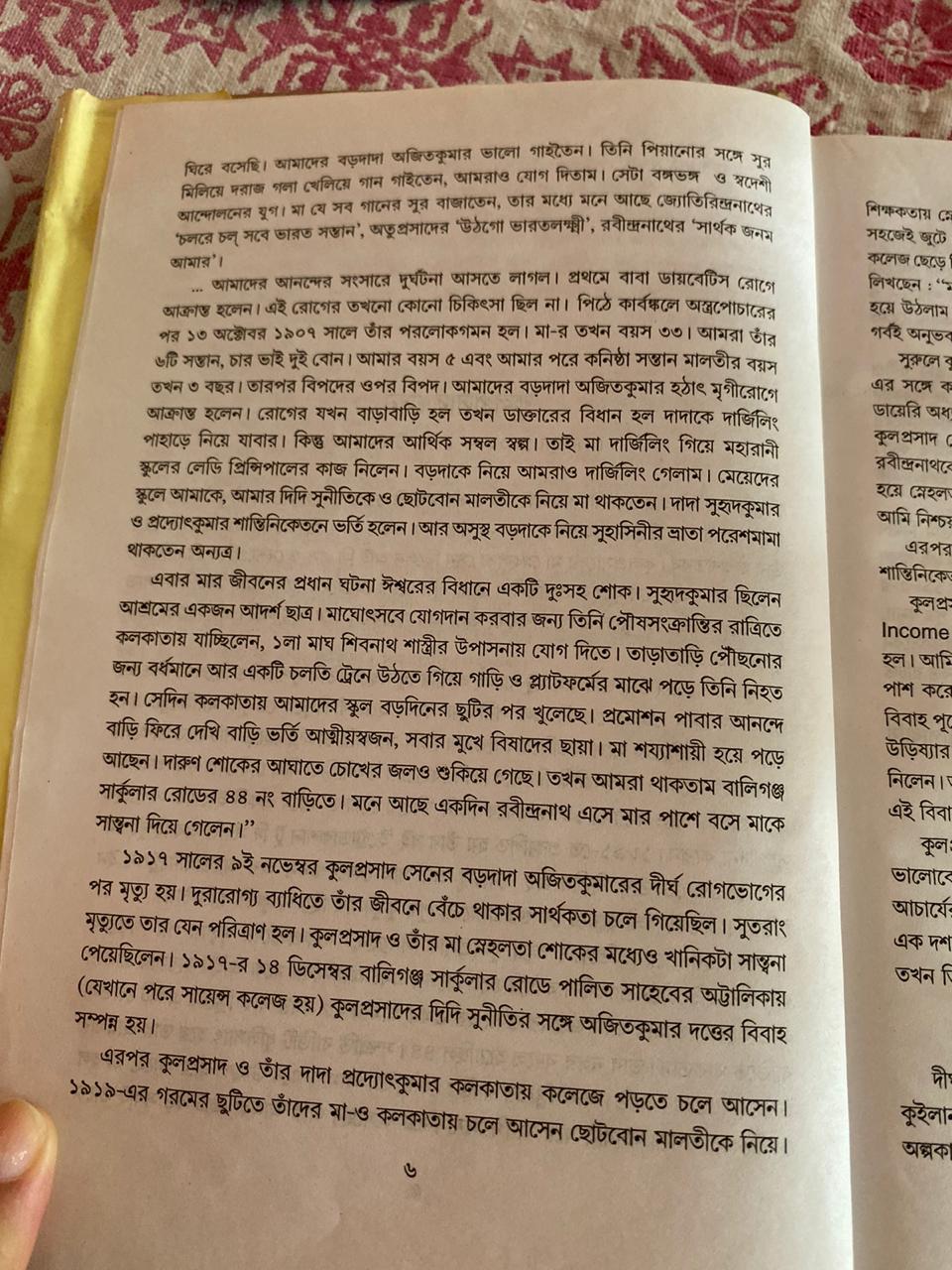
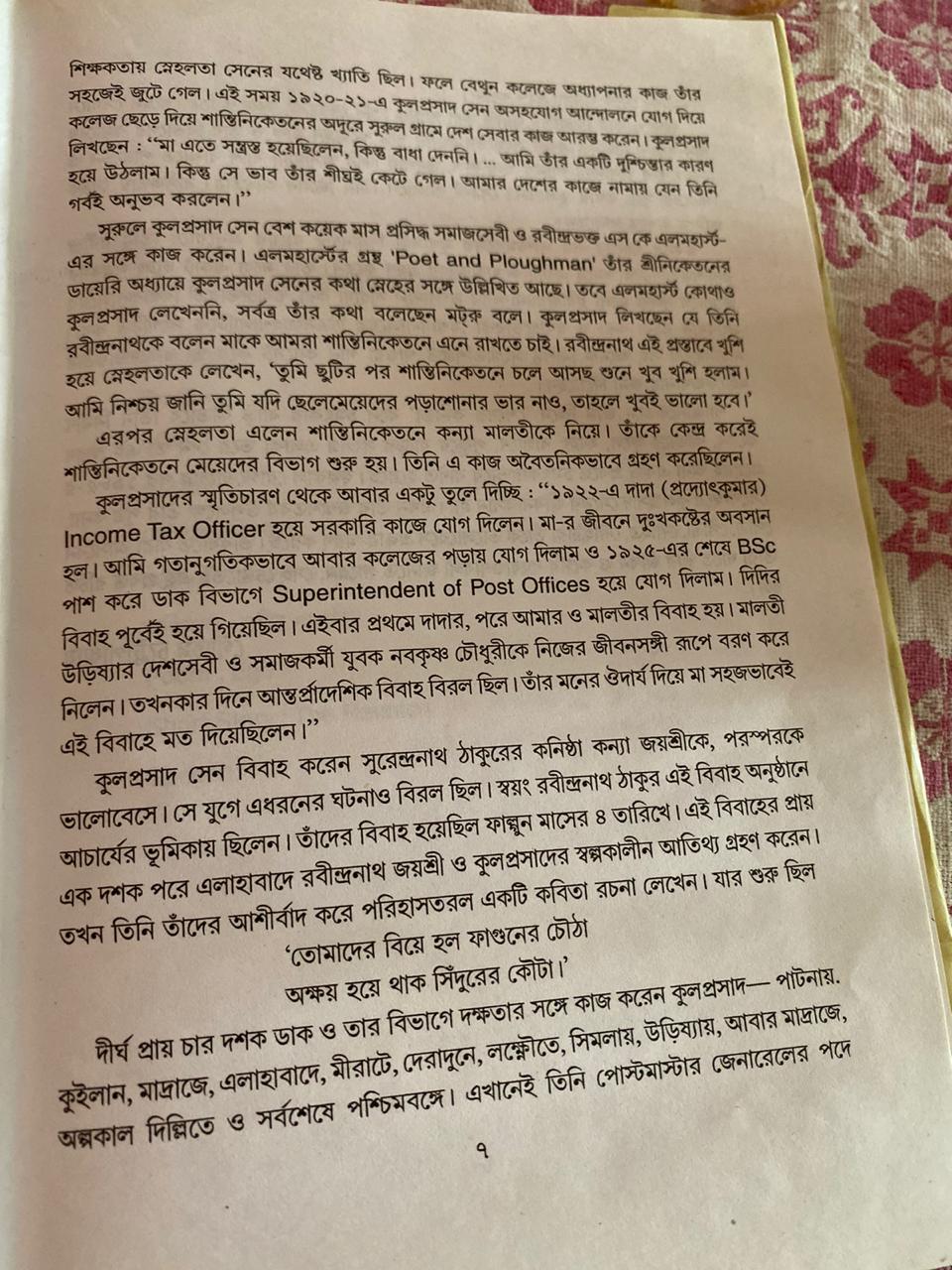
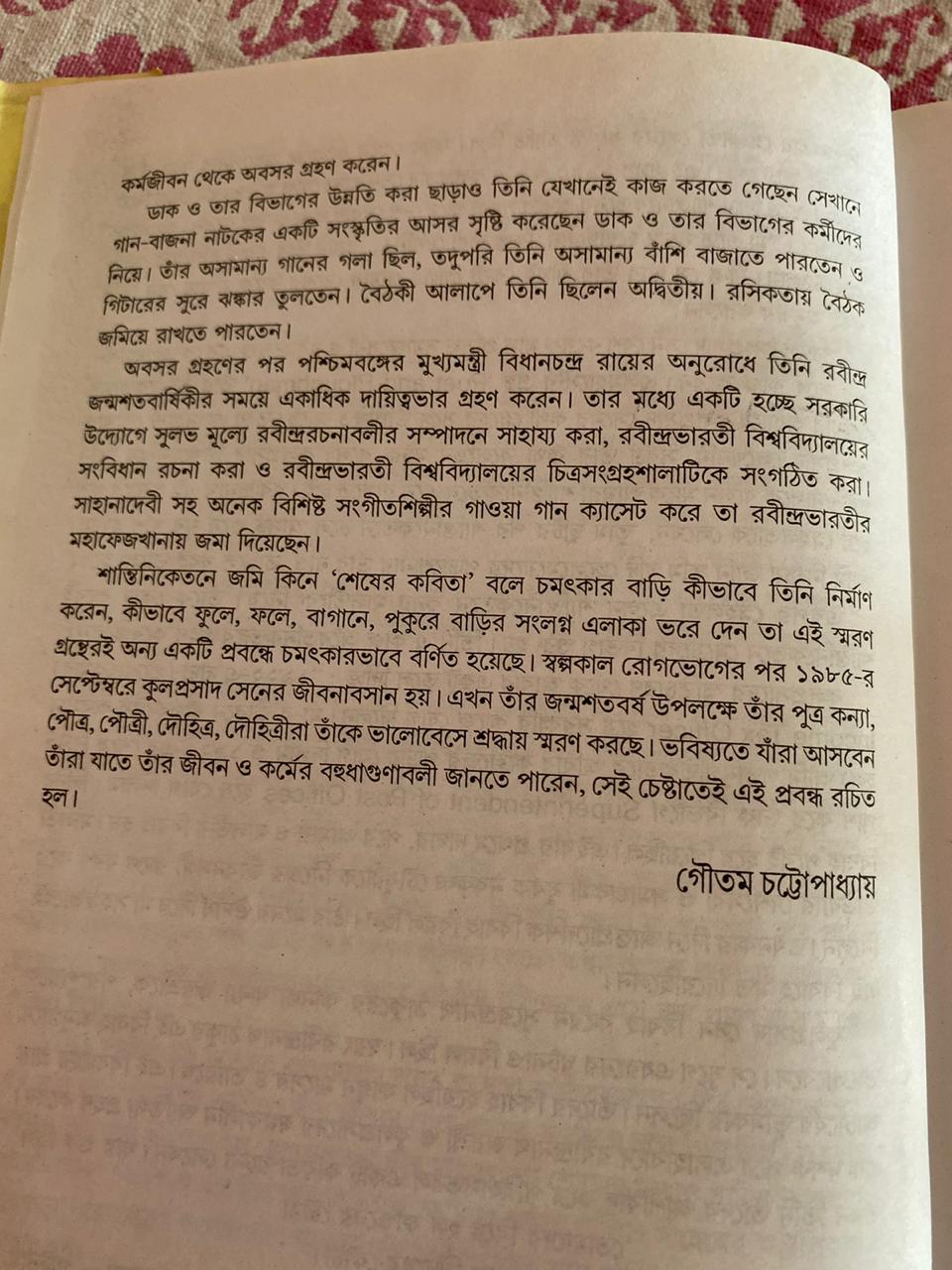
G. Mapara was a 20-year-old Marathi student of Visva-Bharati, from Mahad in the Konkan region. He sang a lavani and Marathi composition in Raag Bihag and two palna or cradle songs, which Arnold Bake recorded with his Ediphone machine in May 1931. The songs are at the British Library Sound Archives only, Berlin does not have copies. I did not have copies of these recordings with me, hence could not listen with experts in the field, as I did with many of Bake’s other recordings. All I had was the metadata attached to the recordings—British Library files C52/2098 C1 and C52/2095 C1. The first cylinder holds the lavani (folk song associated with Marathi theatre, sung to the rhythm of the dholak, often pungent in socio-political satire) and the Bihag song; the second two palnas—the BLSA catalogue has the names as ‘Viṭhucyā darvājyālā’ and ‘Vājīvare bāḷa velhāḷa’.
As I did not have the actual recordings of the songs with me, the way to work was to start from names—names of the songs, the singer, places. I sent the song-names to my musician and listener friends in/from Maharashtra, and they asked friends, but the search did not really yield any specific result. Except that the eclectic singer of Kabir and other mystic poets and researcher of women in the warkari tradition of Maharashtra, Shruthi Vishwanath recorded two beautiful palnas for me to keep in my archive, and she sent them to me via Whatsapp (As an aside, when we think of the archives and changes in the context of technology and the transportation of recordings—it is interesting to note that what used to take days and months now happens in seconds. There was always the fear around Bake’s wax cylinders that they would catch the mould in the hot humid climate of South Asia and they would change shape, get decentred.)
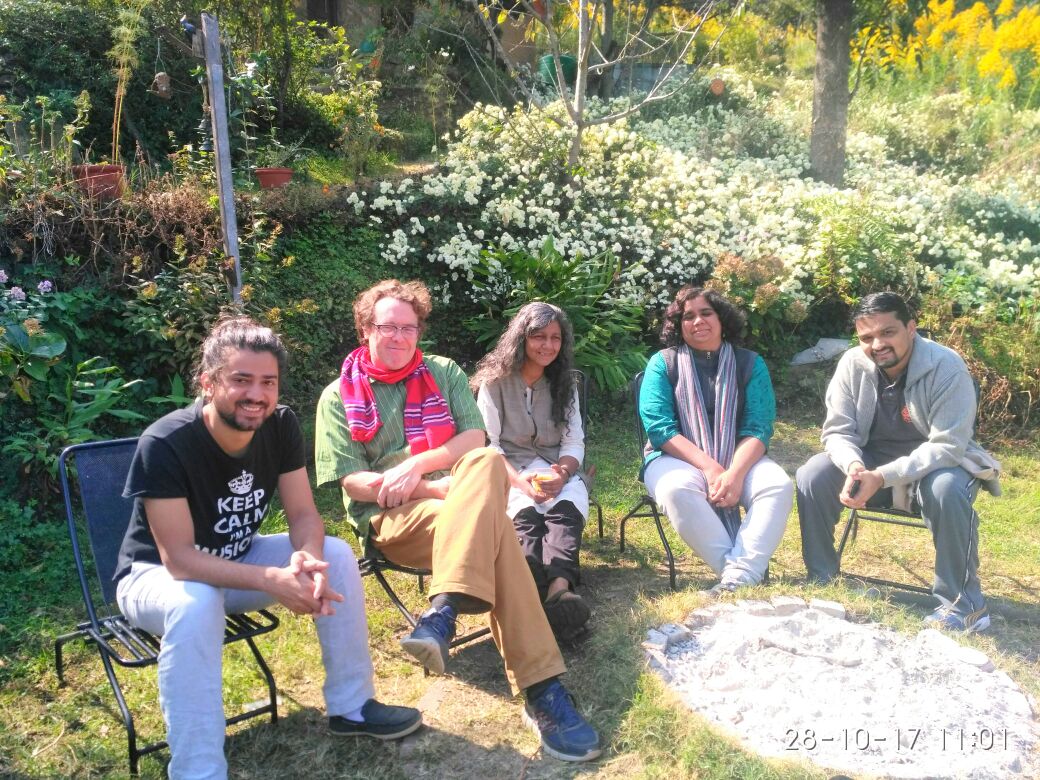
Shruthi Vishwanath, Harpreet Singh and I were the singers at Sonapani Music Festival in Uttarakhand in October 2017. Also in the photograph is sound artist and singer Robert Millis. Photo by filmmaker and actor Gurpal Singh.
Then to search with the name of the singer. Who was G. Mapara? I have searched with friends, mainly with music scholar and singer Budhaditya Bhattacharyya. We seem to have both found the man and not found him. It is a strange thing, because if the G. Mapara we are looking for was indeed the trade unionist Govardhan Mapara, born in 1910, as evidence seems to suggest, then he became an important trade unionist before and after Independence and organised railway workers from the 40s onwards. When this Govardhan Mapara died in 1975, he was in Dhaka attending an international trade union conference. Yet, we cannot find him easily. We get from records that his father’s name was Lalji Mapara, his wife was Agnes Gath (1930-2016). We know that Govardhan Mapara wrote in the Afro Asian Lan Bulletin, V, 4(11), 1969 an article entitled ‘Gandhi’s Close Association with Labour’ and in 1969, he wrote an article in German, ‘Tagore und die Indische Musik’. When I am able to trace these articles, I will in all likelihood know something more about him. But the question is, even if we know more about him, will there be a home to take his voice back to?
We asked labour historians and trade unionists; perhaps if we ask more we will reach somewhere. The pandemic and lockdowns made it difficult to search thoroughly. Budhadityya managed to find Agnes Mapara’s funeral card on the internet, which starts with a Rabindranath quote. There are many Maparas named on the card; we assume them to be Govardhan and Agnes’ children, and grandchildren perhaps. Agnes was born in Koln, and she died in Wurzburg. The funeral was held in Eibelstadt. I wrote to two of the people named on the card: ‘Might you be Govardhan Mapara’s children? Then I have something to share with you. Your father’s voice, when he was 20-21, is in the files of the British Library Sound Archives.’ No one has so far come to claim the voice.
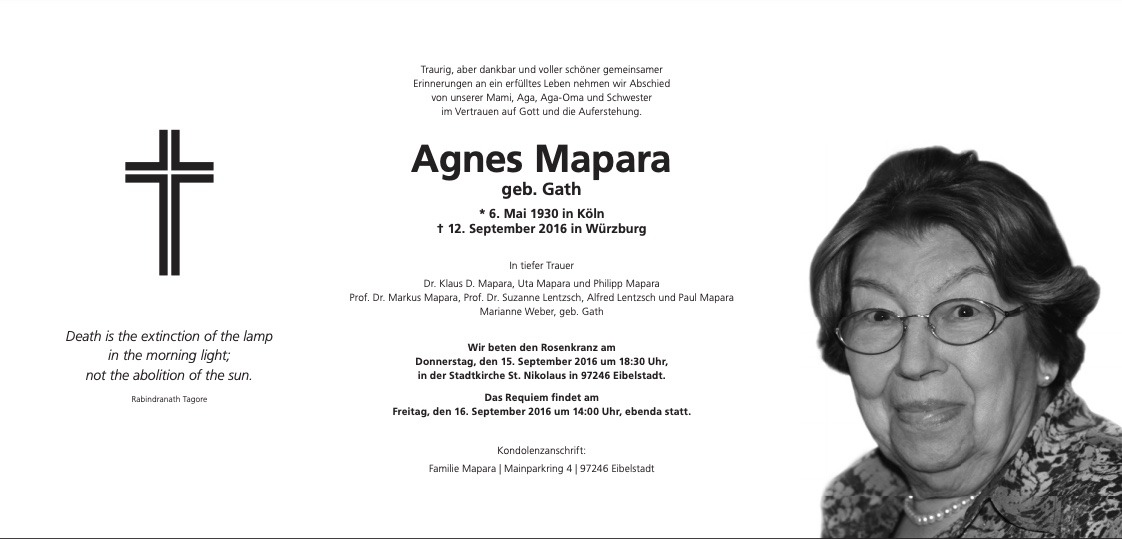
Funeral card of Agnes Mapara nee. Gath. Source: Internet.
This was that trip to the festival of the bauls that Arnold Bake had been planning with Kshitimohan Sen ever since he came to Santiniketan for the first time in 1925 and since he began to learn about baulgaan. He did not go on this trip with Kshitimohan, however, but with Gurusaday Dutt, the district magistrate of Birbhum. He wrote long letters to his mother on 12 and 20 January 1932, the first one about preparing for the trip and the second about their experiences in Kenduli, recording kirtan and baul. The bauls he names in his recordings from 15 January 1932—Bake India II cylinders 103-06 and 109—are Haridas Khaepa, Murali Das, Krishnaballav and Acintadashi.
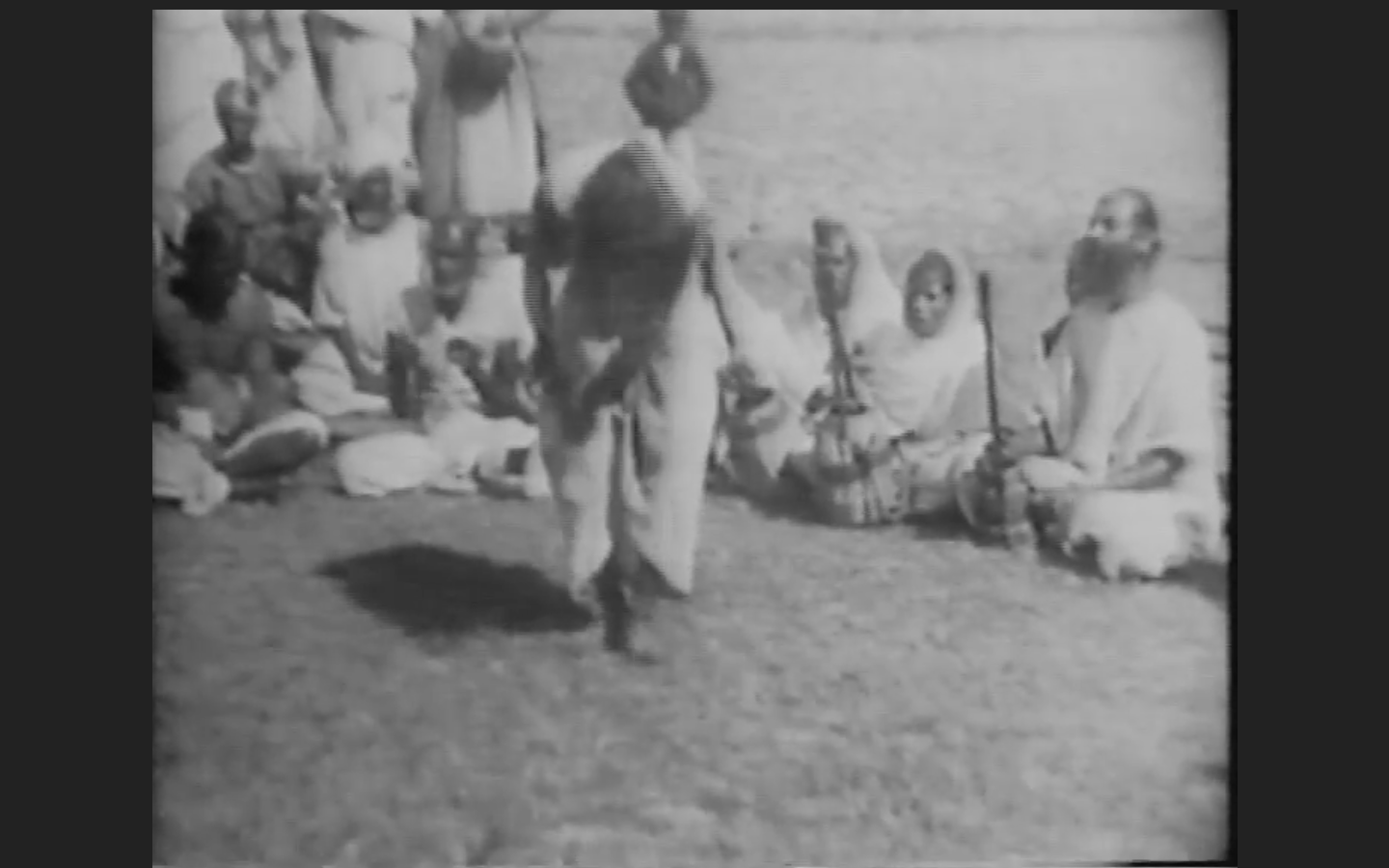
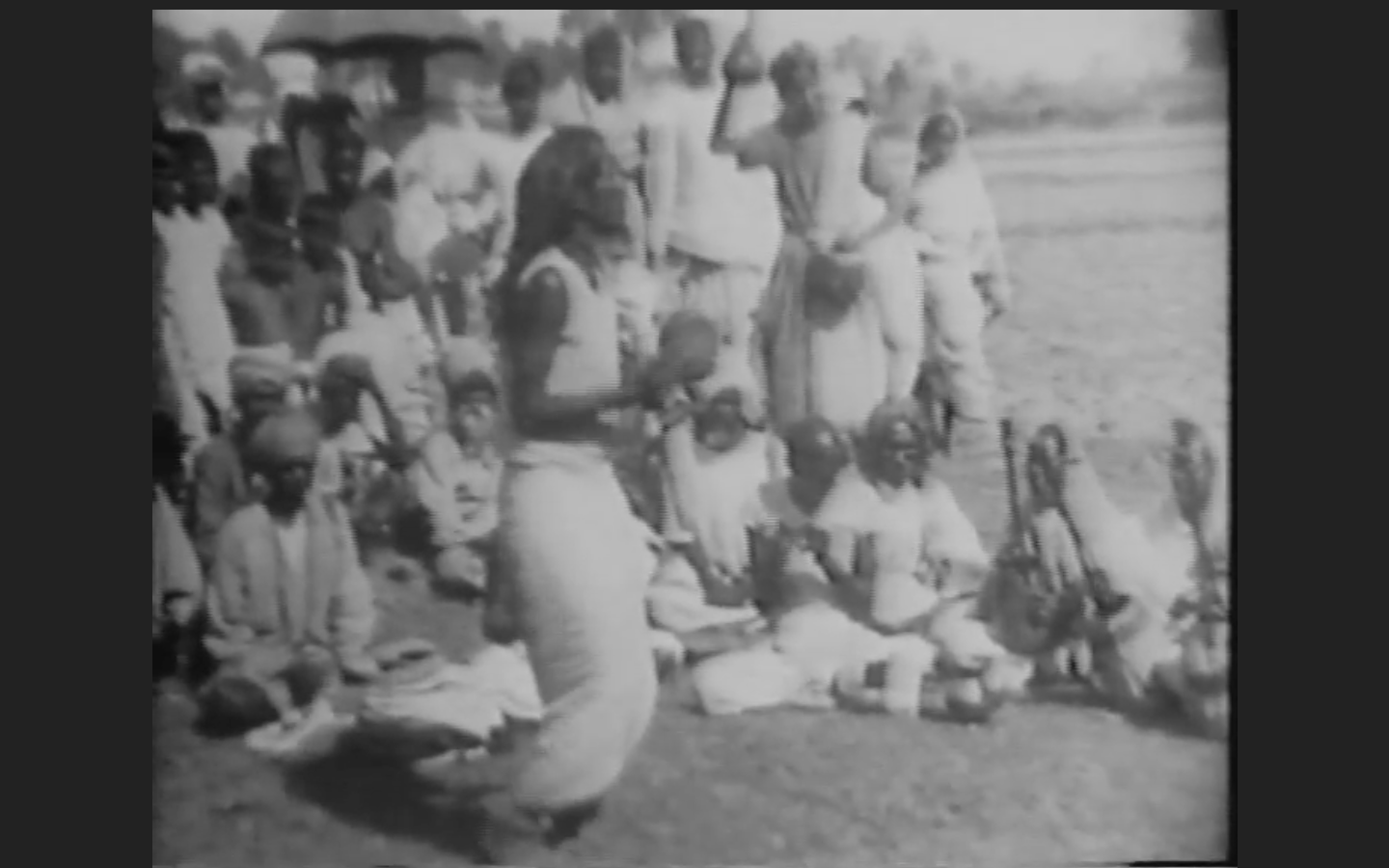
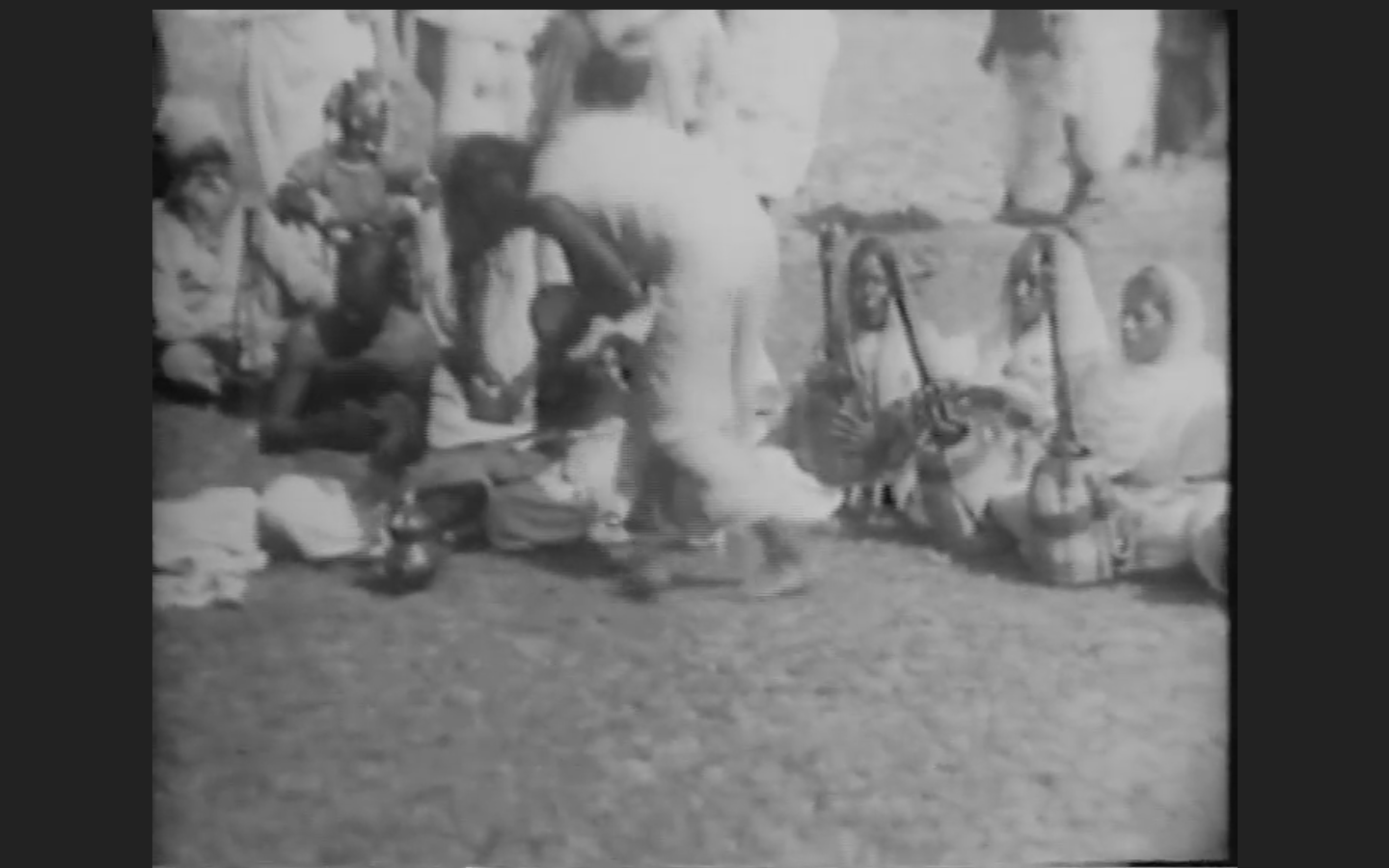
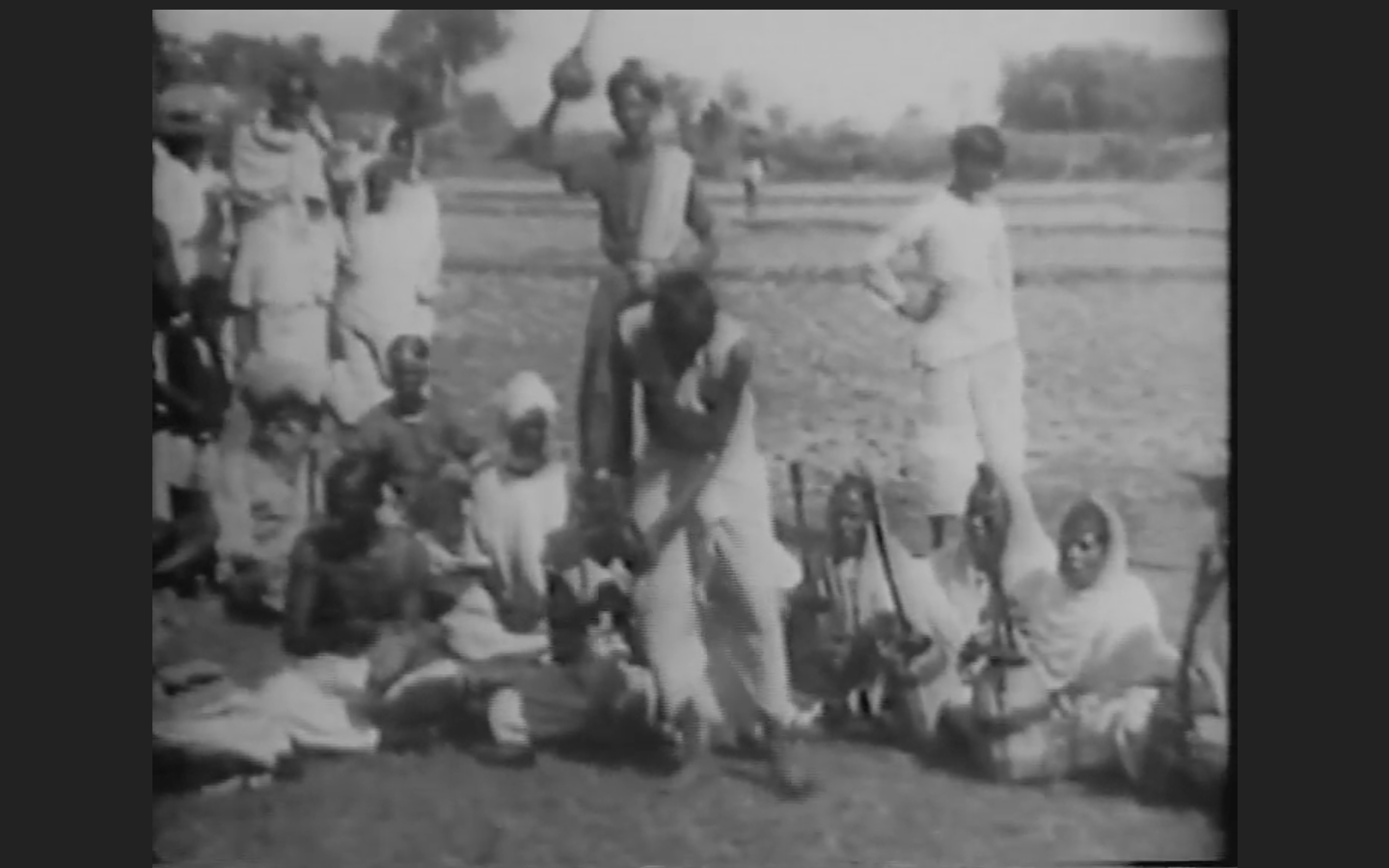
Stills from Arnold Bake’s Kenduli footage. Source: Archives and Research Centre for Ethnomusicology, American Institute of Indian Studies, Gurgaon.
I do not have any audio material or video recordings of my own to add to this archive, because when I shared the songs with experienced practitioners of this music such as Debdas Baul and Parvathy Baul and they shared the songs with others, none has so far (July 2021) been able to identify the songs with certainty. Hence my attempts at writing down the words have remained unfinished. I tried to notate the songs too. But I could not get too far. Here are some scribbles from my notebooks. Just to keep a record of the process of an unfinished work. The recordings per se are extremely important as they come out of a time when Kenduli was still very much an insider’s experience—by ‘insider’ I mean insider to the practice, faith and way of life. Not all bauls of course. The listener, the villager who came and bought things at the fair, those who came to bathe in the waters of the Ajay—they were the insiders then. Bake and people like him would be rare in Kenduli at the time. That does not mean of course that it was not crowded. The Films of Bake on this website, uploaded more than ten years ago when my knowledge on Bake and Bengal was even more tentative than now, show scenes from the Kenduli mela in 1932.
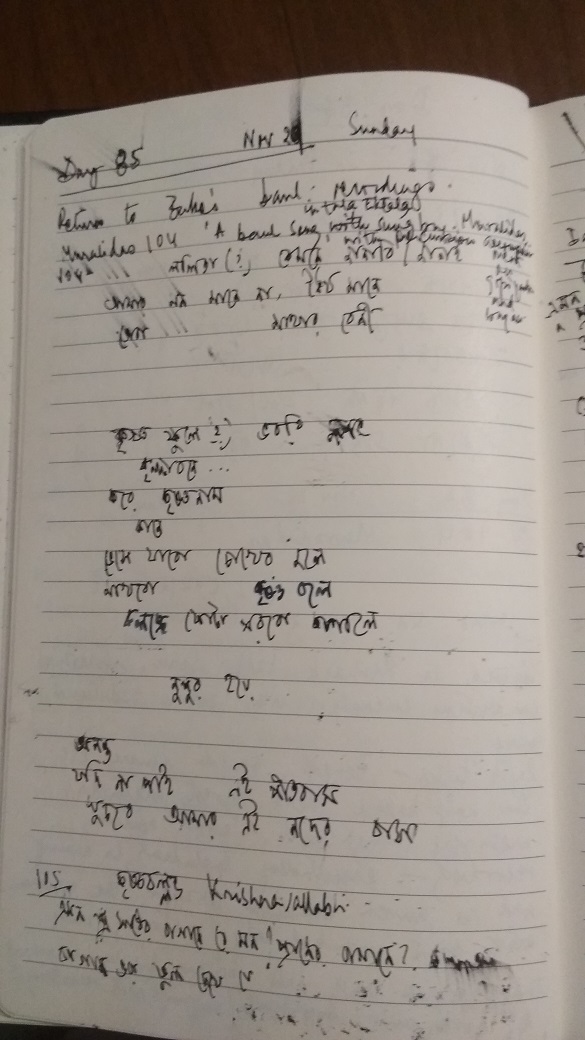
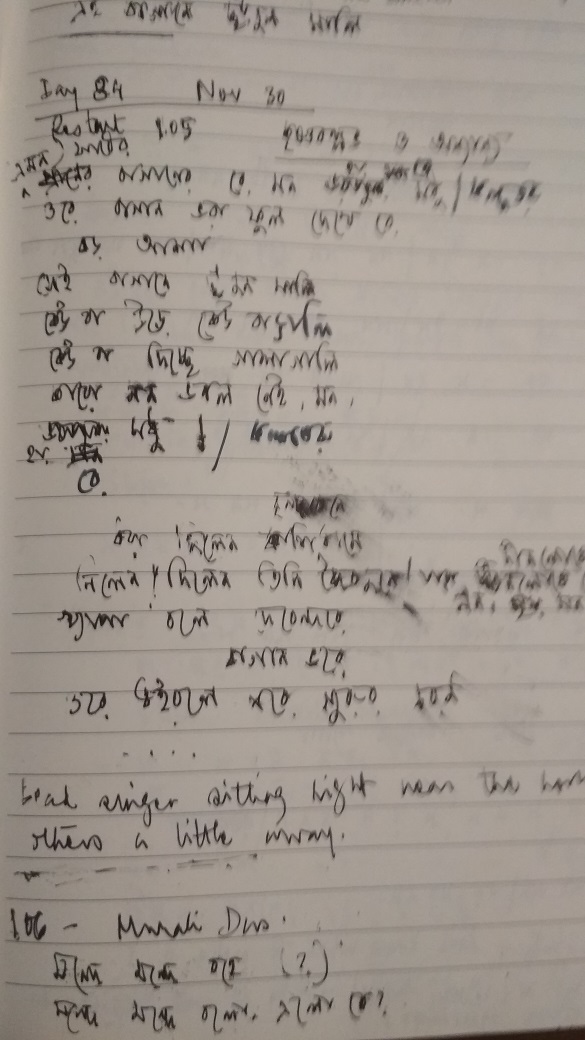
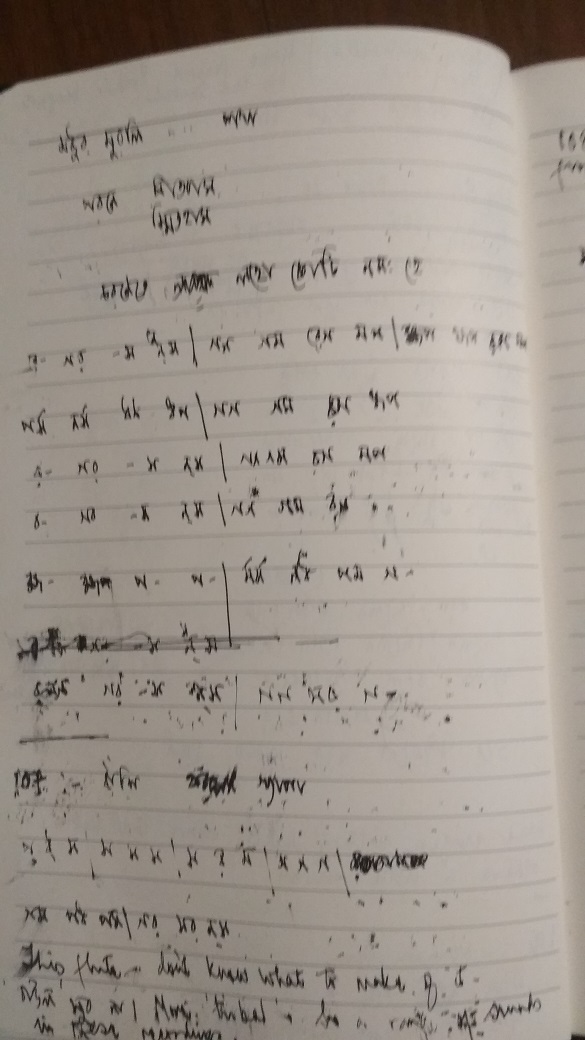
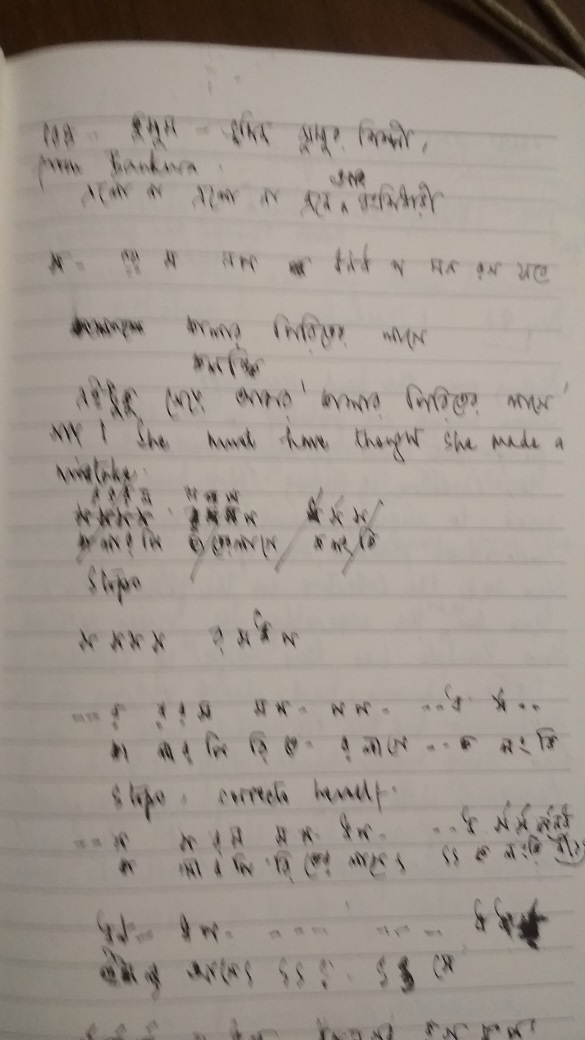
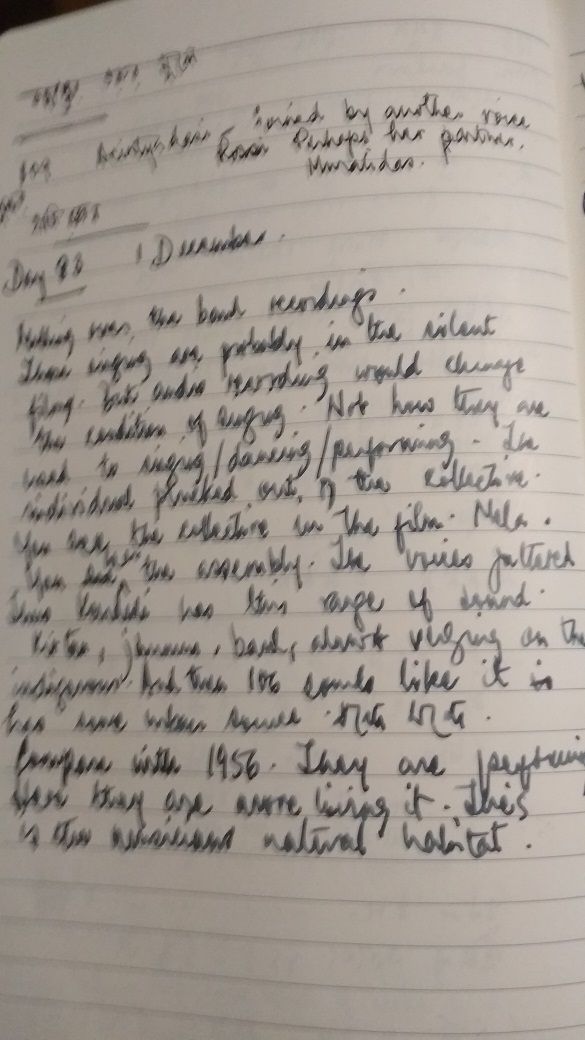
Pages from my notebook, 2021
Jan-Sijmen Zwarts, the young Dutch student of Utrecht University, who had come to stay with me in 2016 and 2017, and help me work with the Arnold Bake letters I had photographed at Leiden the previous year, summarised the content of the letters Bake wrote to his mother about Kenduli and it is something like reading pages of a diary (I have retained the spellings in the letters).
12 January 1932. Bake will leave for Kenduli after writing this letter. He wonders if it will be interesting. Mr. Datta himself will be there, too. Bake says that it will be nice to see him, but he thinks his enthusiasm might drive the bauls to madness.
Bake mentions that before going on a concert tour in March he wants to do two things: see the warriors’ dance in the Dumka Hills and visit Naogaon for baul songs.
20 January 1932. Bake has been to Kenduli and they had the most amazing time – even though he was not expecting too much after Khiti Mohan Sen telling him that nowadays it’s not really worth going there anymore.
The mela was at least three times bigger than the largest he’d ever seen before.
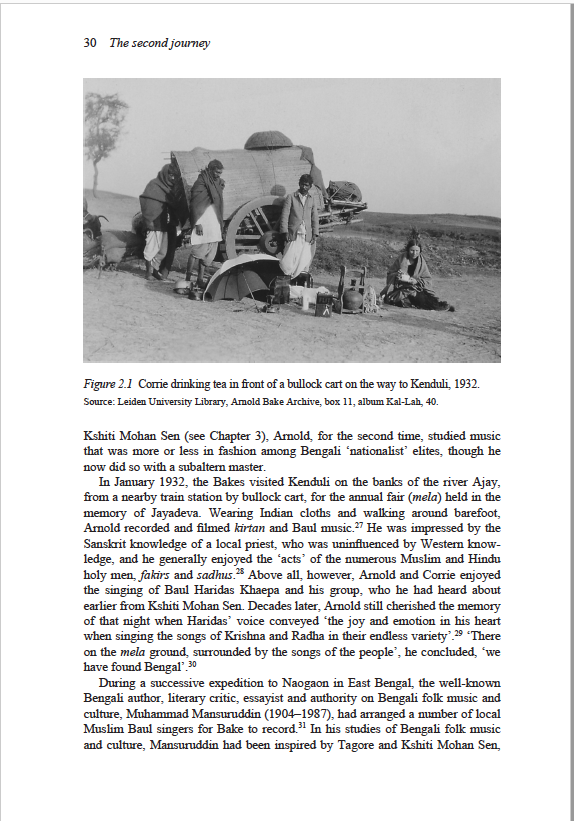
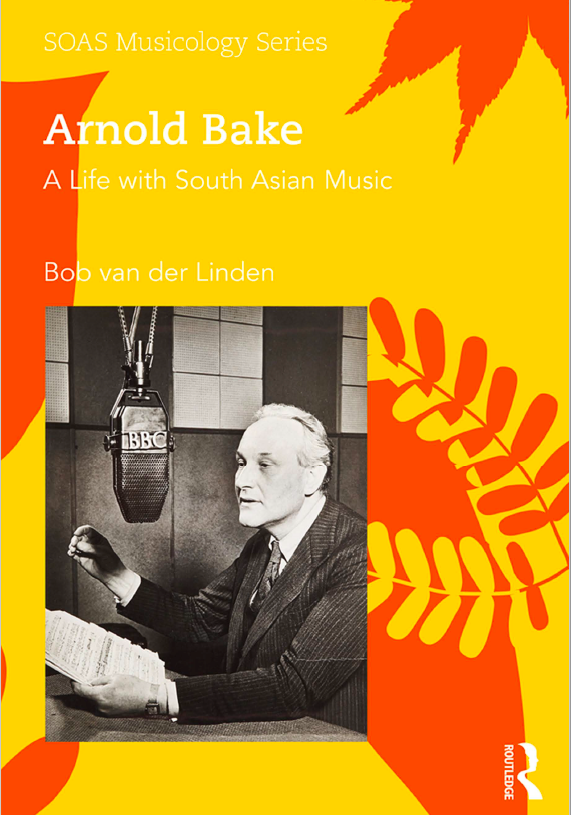
Cover and a page from Bob van der Linden’s Arnold Bake: A Life with South Asian Music (2018).
Bake meets a very friendly sadhu when making his way to the mela from his camping site. The man shows him the sunset from a nice place, and then takes him to the place where the bauls and their companions are staying. There is a huge banyan tree just outside of the village where all kinds of ‘freaks and outsiders’ have made their camp.
The villagers are very hospitable when showing Bake the temple. He is allowed to enter and get very close to the idols. Just then Datta shows up. A number of dances are performed in Datta’s honour, and three bauls play some music – other than that, the first evening is not very special.
The high priest promises to arrange a recital of Jayadeva’s Gitagovinda. Jayadeva was born in Kenduli.
Bake comments that there was a large number of women present at the mela, who were surprised to see Kees in a sari. He also notices that being dressed as an Indian causes the locals to speak freely, something Bake thinks would not have happened if he’d looked like a ‘sahib in English clothes’.
There is also a large number of fakirs. One of them sat on a bed of nails, another had held his arm straight up for twenty years. Bake comments however that this ‘entertainment’ is not what makes a mela interesting. What makes visiting a mela worthwhile, according to Bake, is the devotion, bathing in the river, visiting the temple and having the texts recited, and the gatherings of sadhus beneath the banyan tree.
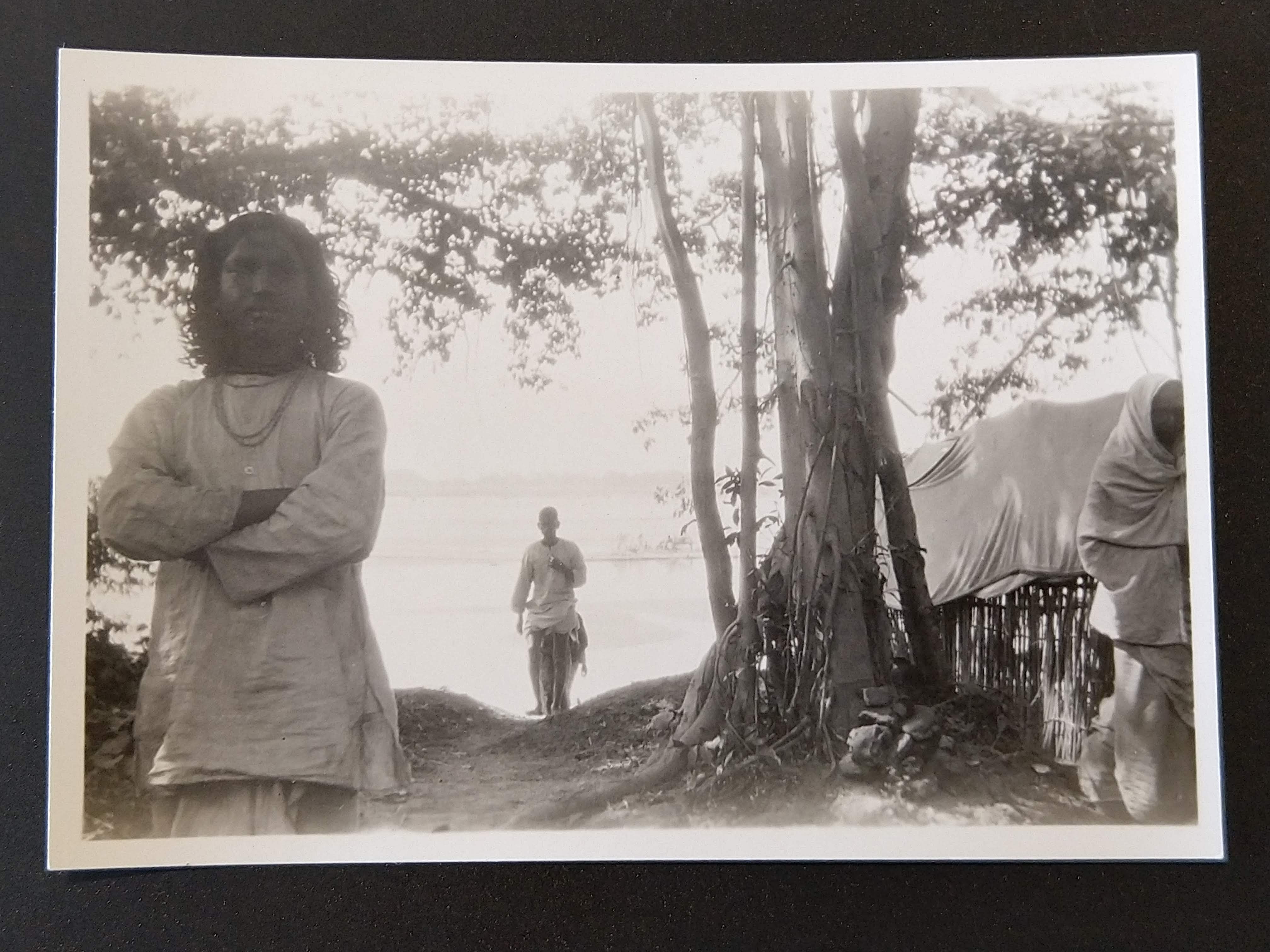
As if from a film. Kenduli 1932. Source: Arnold Bake Collection, Special Collections, Leiden University Library. (Photo of photo, by me)
It was difficult to find ‘good’ bauls. Many people who invited him to listen to their music were only mediocre, says Bake. He was starting to feel a little desperate but comforted himself with the thought that he would only start recording the next day, so there was still time.
After dinner, the group (now in company of several others from Santiniketan) make their way to the temple. The ceremony starts with a seemingly endless stream of namsankirtan performances. Bake, Kees, and Charley make their escape from the rest of the group and Mr. Datta to investigate a small group of men and women who made their camp a little further from the tree. They find a man by the fire playing the bamboo flute, and his music is otherworldly, so good. When the flute player was finished another man sang a song, which was really beautiful too. Bake is very pleased and overjoyed to hear that the men would be happy to come to his tent the next day to be recorded. The flute player’s name was Hari Das.
The next day, Bake meets a woman, Ms. Sen, who is looking for Hari Das, because according to Khiti he is the only one worth listening to at the mela. Hearing this makes Bake proud of the fact that he already discovered him as being such.
At the temple Bake tries to do some recording. It proves difficult because the leader of the singers has a weak voice. He mentions that he can afford to experiment a little, because he can just scrape clean the cylinders that turn out badly. It takes longer than he expected, and Bake is only able to head back to his tent by half past 5. He finds Hari Das and a number of others already waiting for him. Despite the slight delay he succeeds at recording everything he wants.
The next day Bake meets Hari Das another time in the evening. This time he also has a chance to meet his 120-year-old guru. Hari Das agrees to teach Bake some of his songs, much to Bake’s delight. This final meeting concludes Bake’s time in Kenduli.
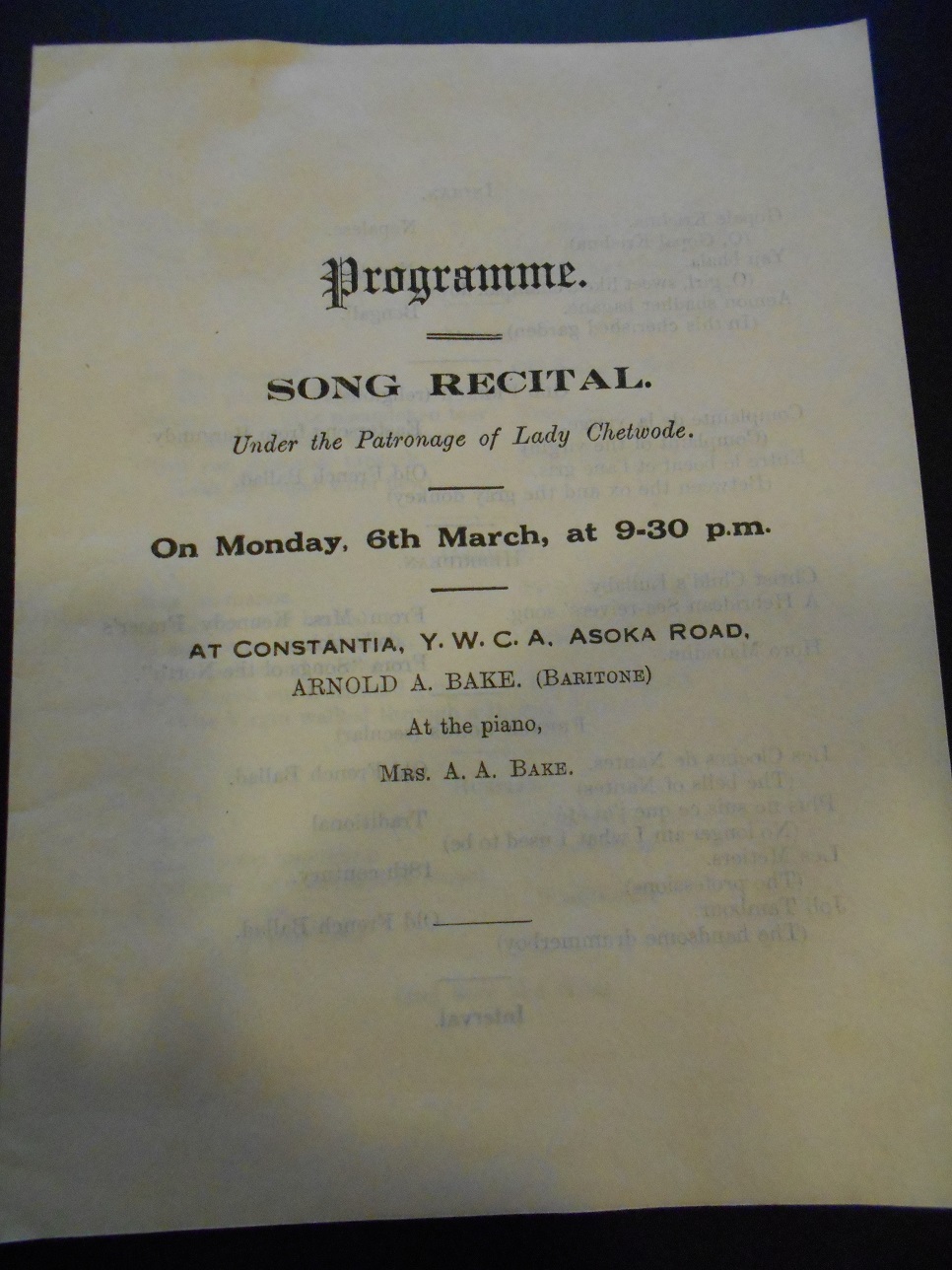
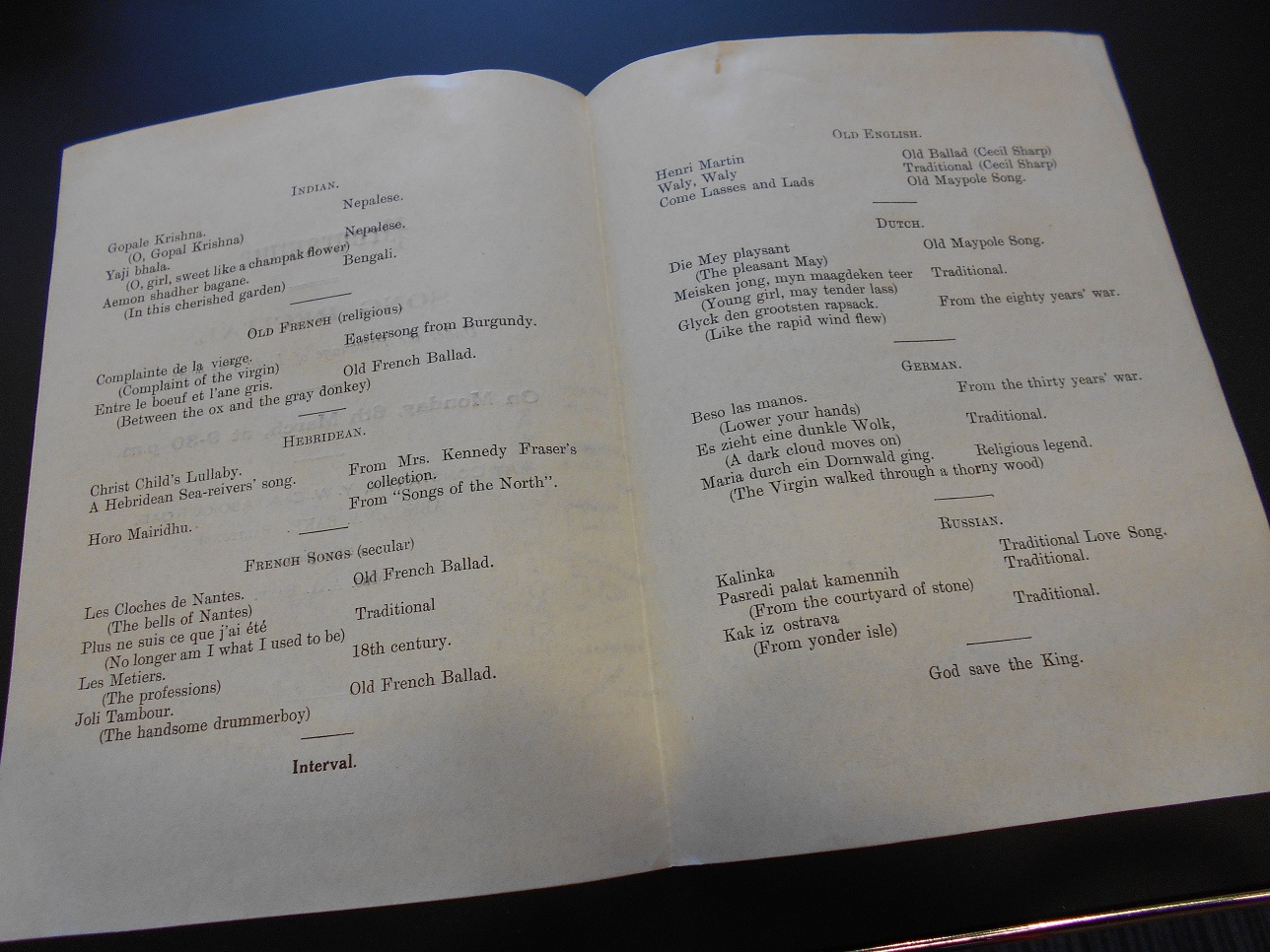
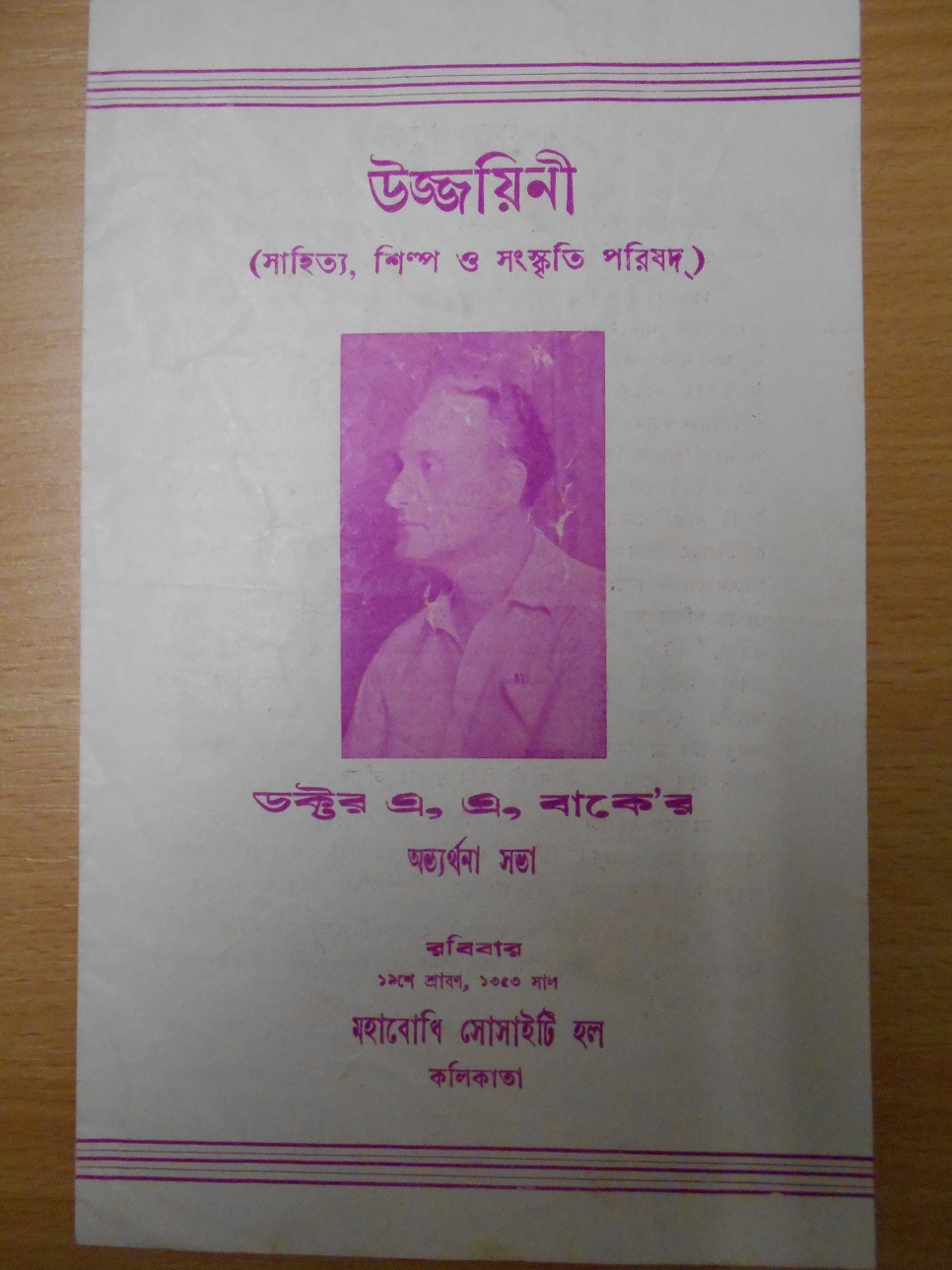
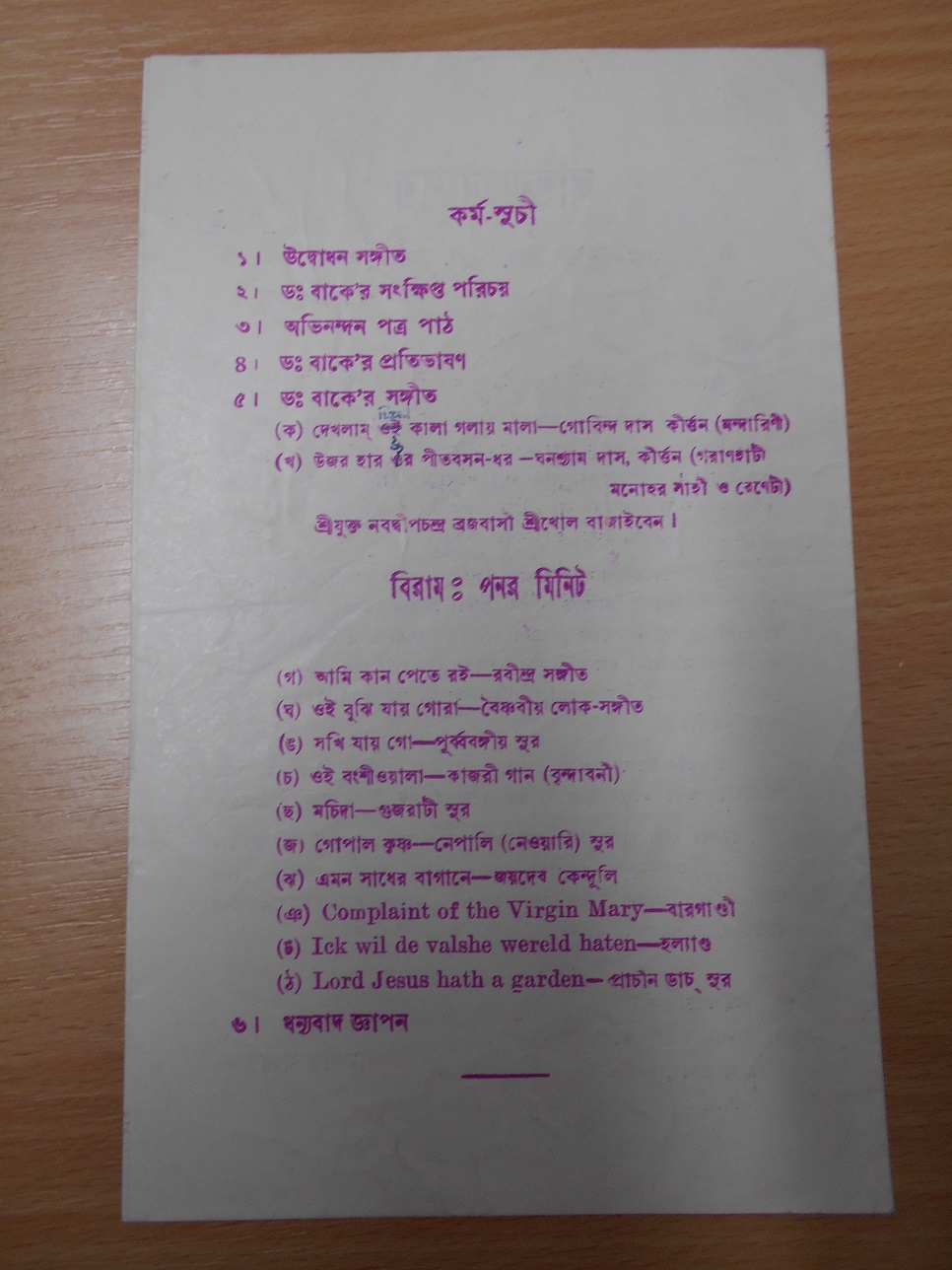
Arnold Bake had learned the song ‘Sadher bagane’ which was sung by Krishnaballav and was recorded on Bake India II, cylinder 105. He would perform it as ‘In the cherished garden’, in concerts. Source: Arnold Bake Collection, Special Collections, Leiden University Library.
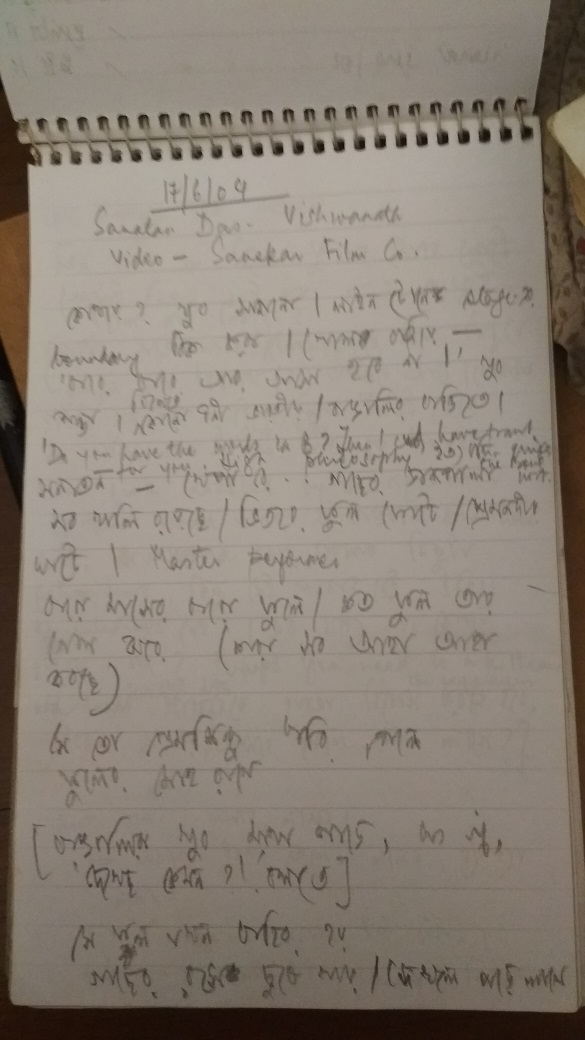
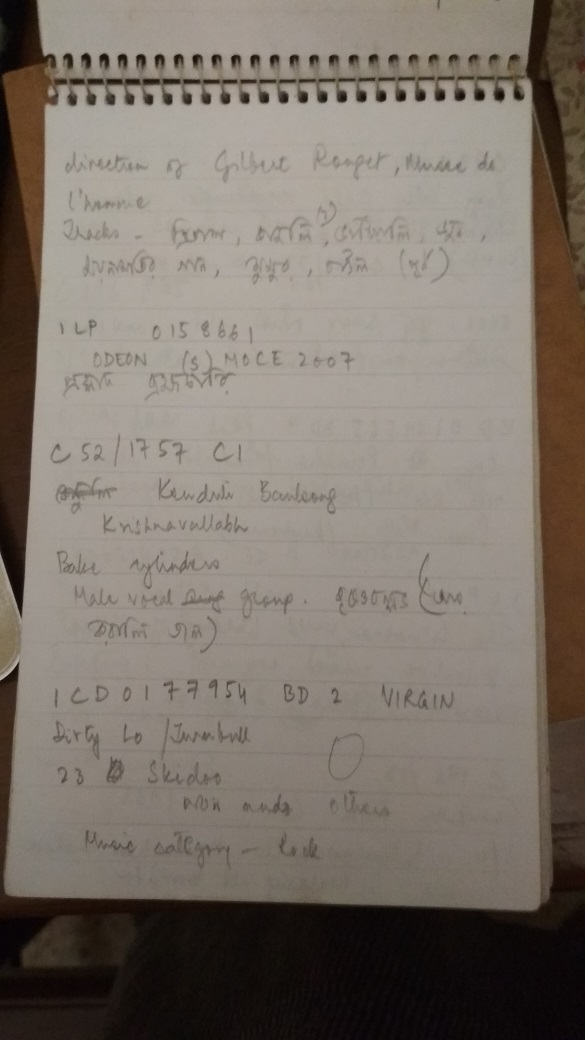
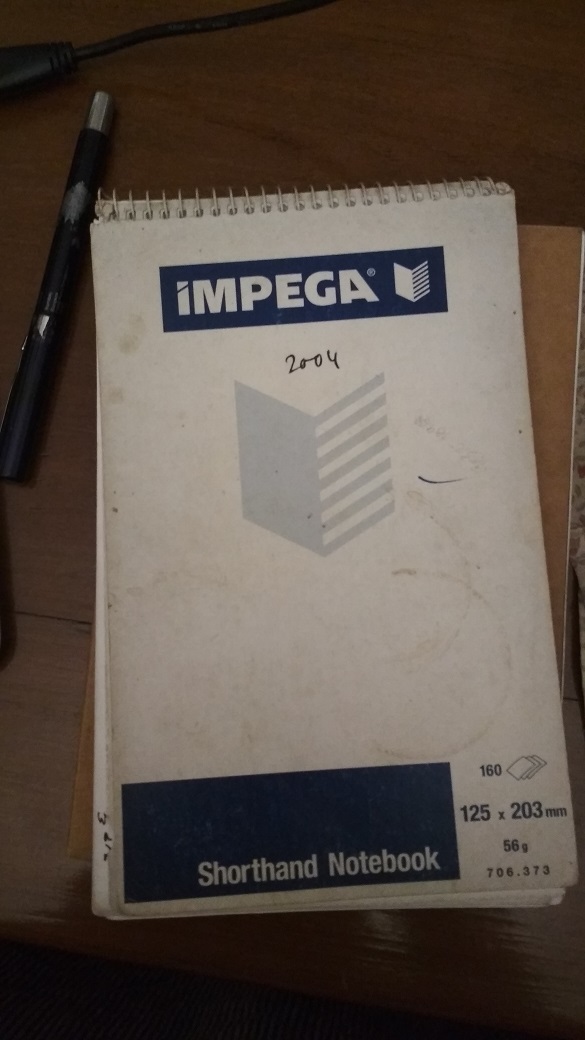
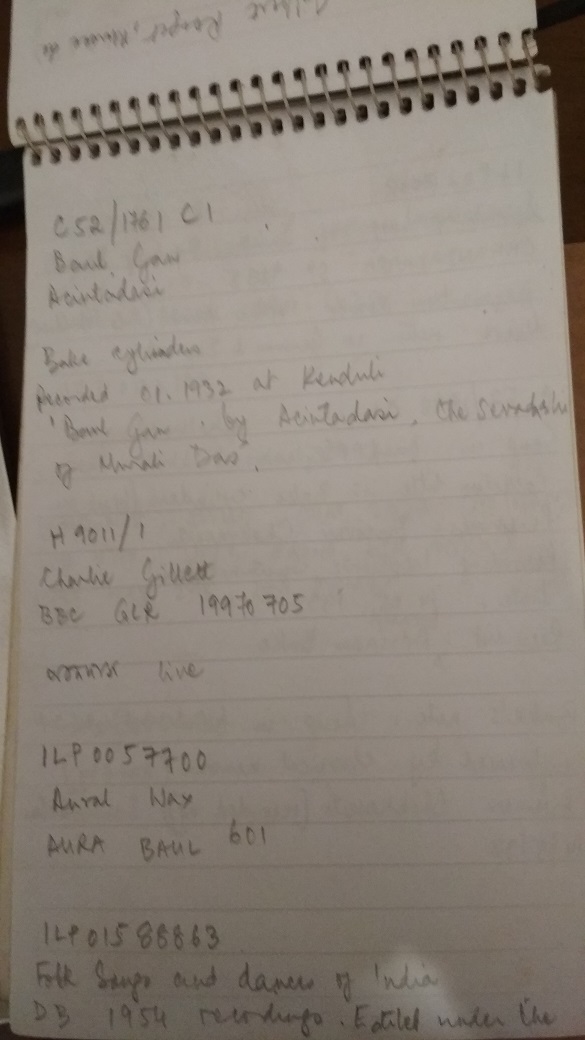
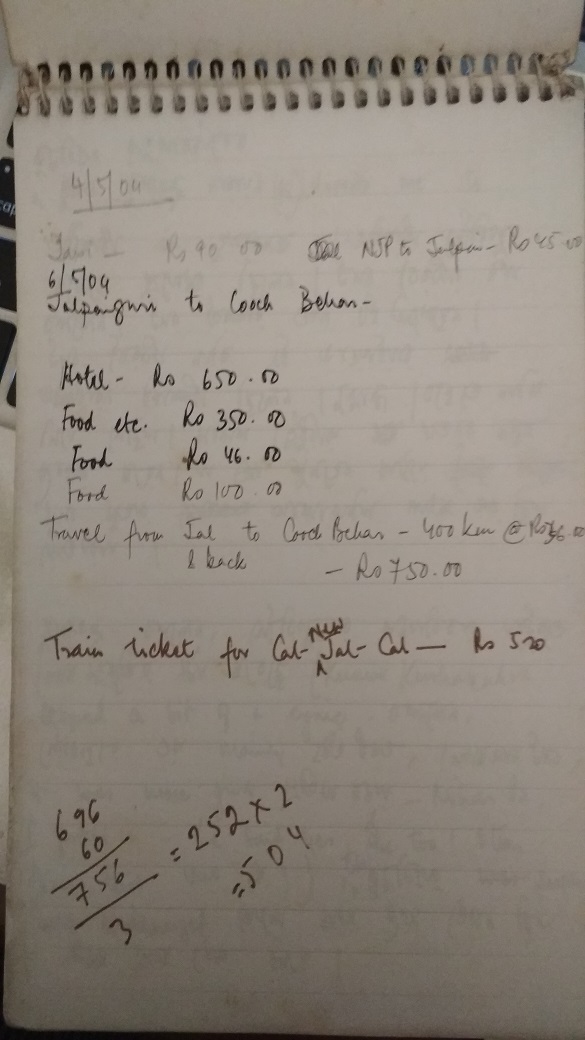
Pages from my notebook of 2004.
Personally, I have a very special connection with these baul recordings of Arnold Bake. Way back in 2004, when I was working in the British Library, looking through the catalogue, listening to this and that, taking random notes, I had come across three things which struck me. Kenduli, Acintadashi, sevadashi of Murali Das and baul. The catalogue gave the recording date as 1932. At that time I had no idea what a cylinder recording was or who Arnold Adriaan Bake might be. But a recording from Kenduli in 1932 was reason enough for me to stop and think. In a sense, my Bake research grows out of that seed.
Here is that recording. Bake India II, cylinder 109. I had it from the Berlin Phonogramm-Archiv, of course, but also from ARCE, as far as I remember (I requisitioned the ARCE recordings too long ago, in 2009).
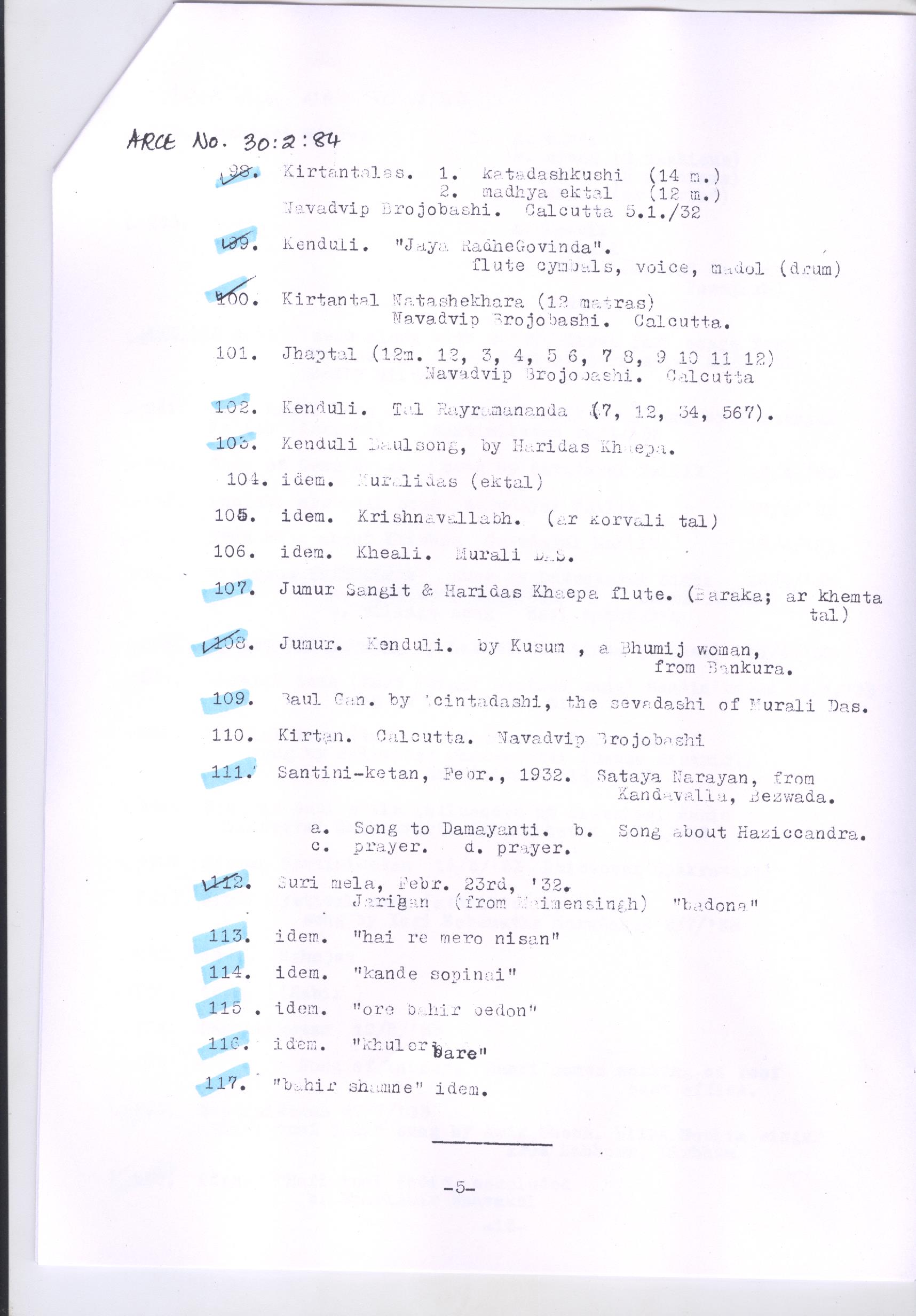
Page from the Bake cylinders catalogue of the Archives and Research Center for Ethnomusicology (ARCE), Gurgaon, India.
Now after almost 20 years, when I have acquired some experience of listening to wax cylinder recordings and can sense the voice flowing under the ground of noise, I can hear two things in this song. I implore the listener to listen with headphones and to listen again and again. Firstly, you will listen to a dubki and you will hear a voice joining the main voice after the first line. I assume this voice to be Murali Das’s, because they were partners and so they would have sung together. And I assume he was playing the dubki, standing next to her, she was mainly facing the funnel of the phonograph, he was to her side. I can picture this. And I see the women in Bake’s baul film, and think Acintadashi would be one of them, or one like them. And one of the men standing around would be Murali Das. And I think, this Acintadashi, sevadashi of Murali Das—they were names on a catalogue to me and when I finally heard the two voices coming together in the recording, it became a moment of jugal milan for me, a moment of ultimate union.
Secondly, the other thing is the text of the song Acintadashi is singing. ‘Sundaro hridiranjana guru’ it begins. I cannot get all the words, but the song is in the voice of Radha, there is mention of the river Jamuna and she complains about her sufferings for love. She’s lost both shores—e kul and o kul, both. She wants Krishna, her beautiful lover, to take her across the river. The tune is very typically of Bangla kirtan. I wonder about Rabindranath’s composition of 1901 ‘Sundaro hridiranjana tumi’. Although different in tone and temperament, the connection seems quite obvious. I wonder if an existing kirtan might have been at the back of Rabindranath’s creation.
Pinakin Keshavlal Trivedi was a 21-year-old Gujarati student in Santiniketan whom Arnold Bake had recorded in 1931. I met his son, Devkumar Trivedi (born 1939), in Delhi in 2019. The British Library has Pinakin’s age as 19, because that is what Arnold Bake’s notes say, but Devkumarji clarified that his father was born in 1910. Their original home was in Kapadganj, but following his elder brother, Pinakin had come to Santiniketan, from Umreth, where their father was a doctor.
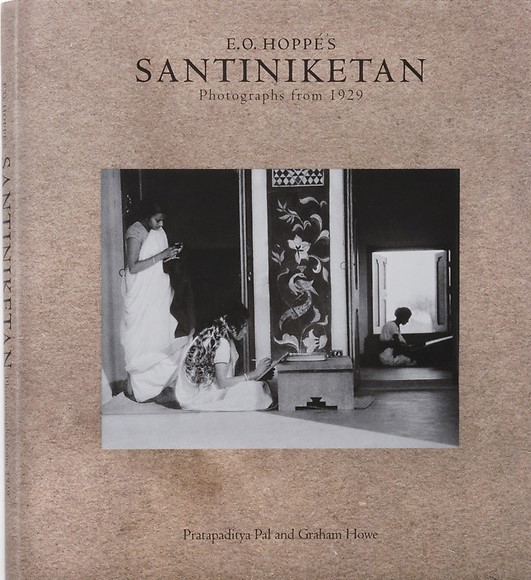
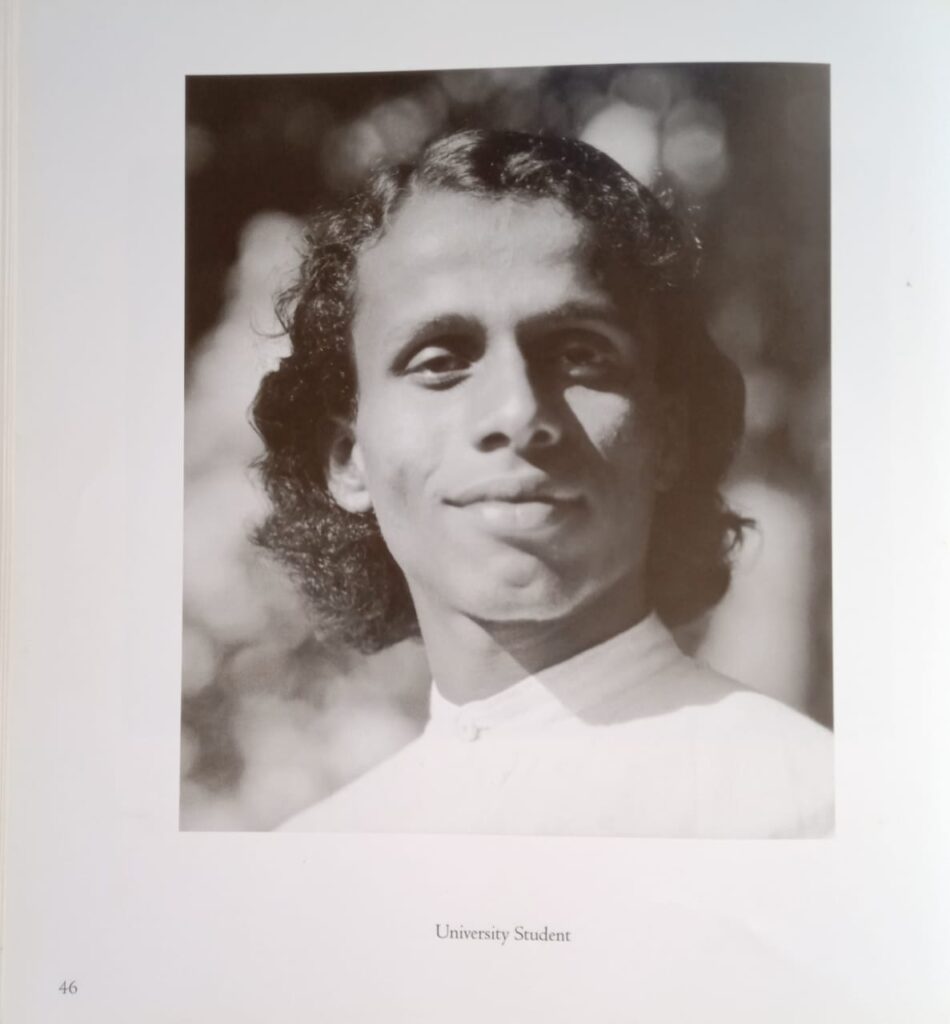
Pinakin Trivedi in E.O. Hoppe’s catalogue, Santiniketan (The Marg Foundation, 2010), although the caption does not give his name, just mentions him as a ‘University Student’.
Bake recorded Pinakin on 13 wax cylinders (four with the phonograph he had loaned from the Berlin Phonogramm-Archiv and nine with his Ediphone machine); songs of Kabir and Mirabai, garba songs and a cradle song, a few of which can be heard here. The archive’s metadata does not give the exact date of recording, but I think they were recorded on two separate days. Because, on 7 April 1931, Bake wrote to his mother: ‘In addition, I have reached out to several students to try and get hold of songs from other provinces. The one boy that came here and sang these interesting ballads from Gujarat has returned from Calcutta, so I will start working with him soon.’ On 15 April 1931 he wrote that he had already recorded Pinakin and was hoping to record some more.
I had heard the Pinakin Trivedi recordings at the archives in London and then after the Time upon Time: Arnold Bake in Bengal exhibition in Santiniketan in 2016, when Lars Christian Koch, the then director of the Berlin Phonogramm-Archiv, proposed to work with The Travelling Archive to produce a set of CDs on Arnold Bake (a project which did not materialise), they shared copies of their Bake in Bengal holdings with us. So, I had four songs of Pinakin Trivedi in my possession. It is these songs which lead me to a fabulously rich collection of material from the life of Pinakin Trivedi, especially relating to Santiniketan, which is kept closely guarded by his son, Devkumar Trivedi. I have only just begun to unpack this collection and for now I am presenting a few snapshots from this wonderful material, which I will work on more in the future. The Pinakin Trivedi collection is an archive of its own, which leads us to many other archives.
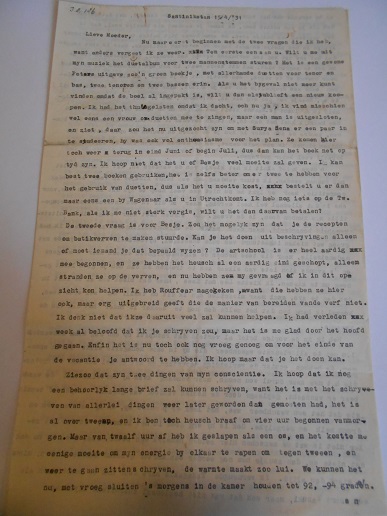
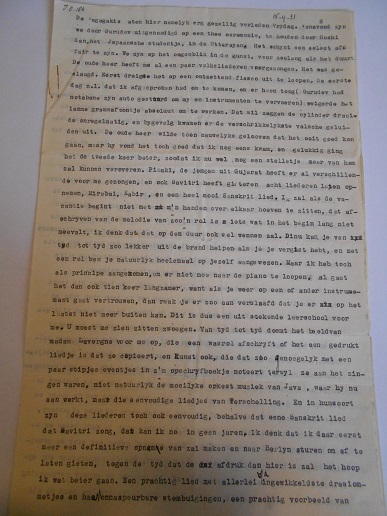
Pages from Arnold Bake’s letter to his mother of 15 April 1931. Mark how Bake wrote Pinaki, minus the ‘n’ in his letter! Photographed while working at Special Collections, Leiden University Library in 2015
I asked writer, filmmaker Ruchir Joshi, a friend, if he would listen to Pinakin Trivedi’s songs, since he would understand the language. He wrote back to say he had shared them with his friend Salil Tripathi, the writer, and Salil said Pinakin Trivedi was the music teacher of his New Era School in Bombay; that was before his time, but everyone knew about him as he had composed their school anthem; he had even seen him at school functions. I met Salil in London on 23 October 2018 and we had a long chat. Salil sang me their school anthem, ‘Dhanya New Era’, and I jumped with joy. This was the exact same melody as ‘Amader Santiniketan’, the Santiniketan anthem! I felt as though I had already started to find the Pinakin Trivedi of Santiniketan whom Arnold Bake had recorded and who I was looking for.
Later, on 11 December 2018, when Salil was in Mumbai, I went from Kolkata to meet him and the musician Atul Merchant, who was also a student of New Era. The idea was that Atul would put me in touch with Pinakin Trivedi’s son, whom he knew.
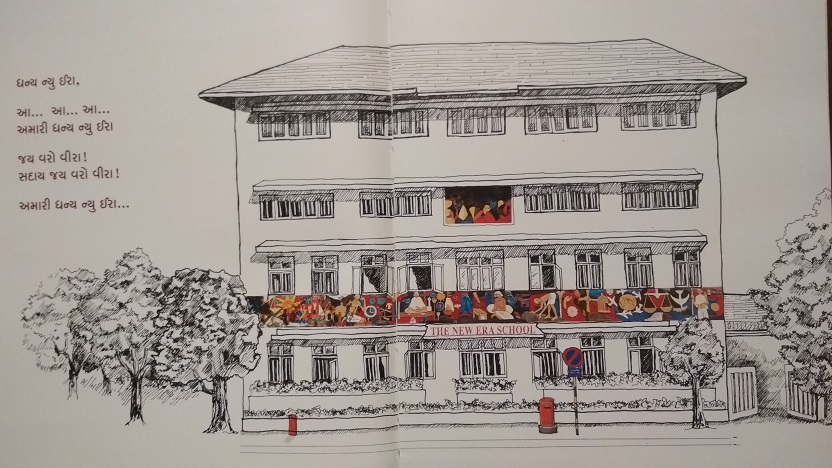
Sketch from The New Era Odyssey, a commemorative volume published by the school alumni in 2017, which Atul very kindly gifted to me.
In the Foreword to this commemorative volume on New Era School, Salil wrote: ‘In 1930, as the Indian tricolour was unfurled on the banks of the river Ravi in Lahore and the Indian National Congress unleashed the struggle for poorna swaraj, or “complete independence”, two brothers from Rajpipla in Gujarat, Chandulal and Maganbhai Vyas, founded a school opposite Gowalia Tank maidan in the city that was then known as Bombay […] The Vyas brothers were inspired by the philosophy of Annie Besant […] They named the school New Era. Later Chandulal’s son, Kantibhai and his wife Bhanuben, carried the torch forward. […] New Era ushered in a new way of thinking, where education had to be compatible with the new age and be relevant for a new time, where the child’s potential was more important than what the school’s curriculum insisted; where the teacher was the artist who helped the child discover her or his talent and set the child free; where the mind was without fear and the head held high. That Tagorean reference is not incidental – for a major source of inspiration for the Vyas brothers was India’s first Nobel Laureate Rabindranath Tagore.’
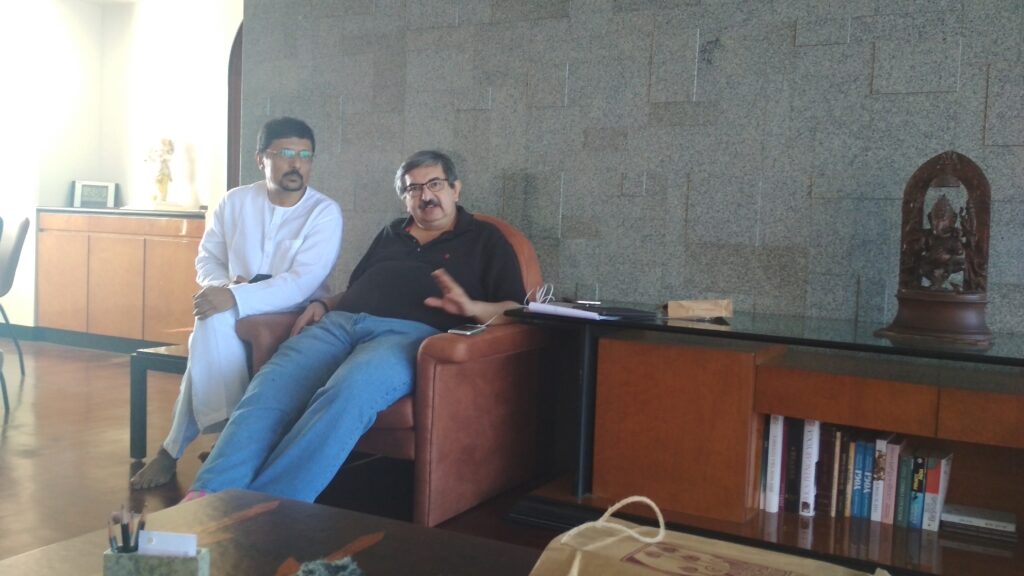
Atul Merchant and Salil Tripathi in Atul’s home in Mumbai. 2019. Photo by Moushumi
Salil, Atul and I had a long conversation about Pinakin Trivedi and music in New Era School and I left my recorder open for whatever we were saying. Atul played me songs of Pinakin Trivedi, arranged by him. This is a clip from the recordings I made that day.
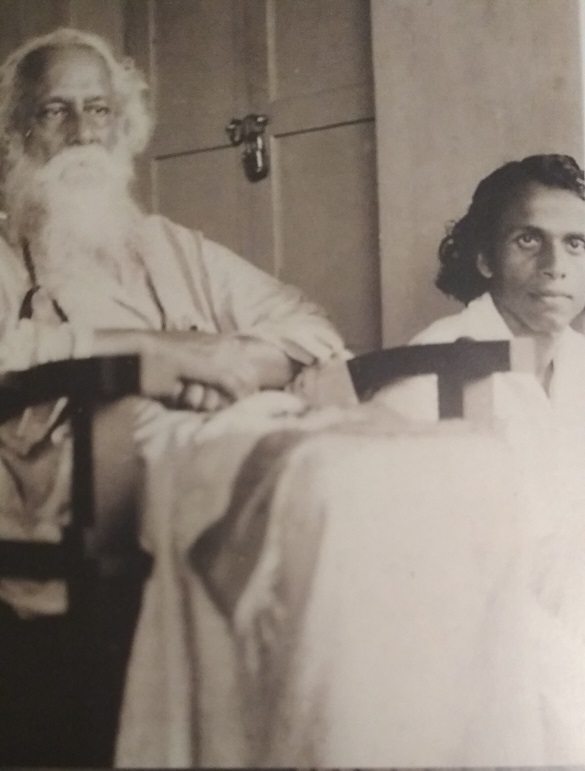
In the ‘Santiniketan archive of Pinakin Trivedi’, there are more photos of others which he had taken, fewer of him with others. Like Arnold Bake, he was recording the place and the time with his camera. There are amazing overlaps, because when we look at Bake’s photos and films and Pinakin’s, such as of Basantotsav, 1931, we know they were in the same place at the same time. At the same time, their archives are also very different, as they were on campus in different capacities and saw the place with different eyes. As his son Devkumar Trivedi said, Pinakin took so many photos of Rabindranath that at one point Gurudev asked him: Have you got a thousand photos now? This one of guru and shishya is from the New Era commemorative volume.
It is through Atul and Salil that I was able to connect with Devkumar Trivedi. I spent two delightful days amidst Pinakin Trivedi’s things in Devkumarji and his wife Ashokaji’s home in Delhi on 27-28 January 2019, over meals and many cups of tea.; sometimes their musician son Kem would come down from his upstairs apartment. A whole world of Santiniketan as recorded by Pinakin and archived by his son opened up before my eyes. Devkumarji preserves his father’s archive with utmost care. A retired senior bureaucrat, he is himself a beautiful singer and extremely proud of their family heritage—music runs in our blood, he said. He did not know about these recordings of his father from 1931 and as he listened, he remembered things and sang along. Devkumarji brought out his father’s photographs from Santiniketan, neatly kept in files, wrapped in plastic. It felt like we were entering a temple. He brought out copies of the handwritten Gujarati magazine Usha, volumes of Pinakin’s diary Manasi. He talked about Gurudev as though he himself had been taught by the poet, and about Khuku (Amita Sen, the Tagore singer who died prematurely), with inherited intimacy. Devkumarji preserves the long message Khuku had written in Pinakin’s notebook as a parting gift. He asks me to read it out, as it is in Bangla. I read, and explain.
On 27 February 2019, Devkumar Trivedi listens to Bake India I, cylinder 15, song ‘Avi rudi ajavali raat’, a garba song sung by Pinakin Trivedi in Santiniketan in April 1931, exact date unknown. I recorded this video with my phone.
I asked Devkumarji what had taken his father to Santiniketan. He sang bits of song to me and explained that it was Tagore’s songs in the first place that had caught his father’s imagination. Devkumariji is such a beautiful singer!
He also told me about his Pinakin Trivedi’s very deep connection with the songs of Tagore and sang lines of several songs that his father had rendered into Gujarati.
The photographs record the dynamic world of students and teachers of the asram, across age and gender, the close relationship of the teacher and the student and a flow of life and creativity within Santiniketan. His photos are different from Arnold Bake’s, who recorded other aspects of asram life through his images. Bake recorded lives of teachers and scholars and their families; the international community; village life surrounding Santiniketan or the accidental encounter with the itinerant singer.
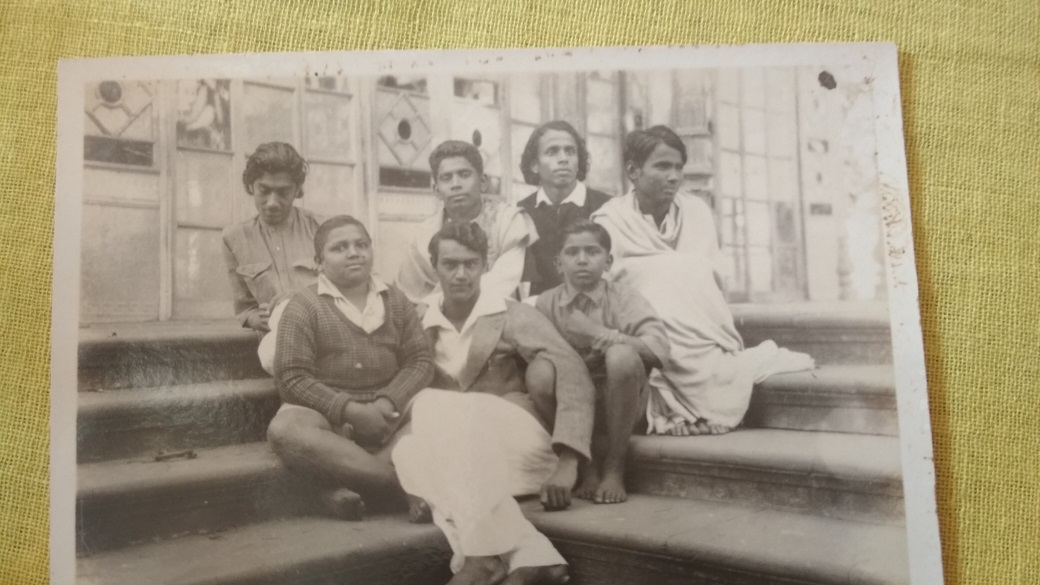
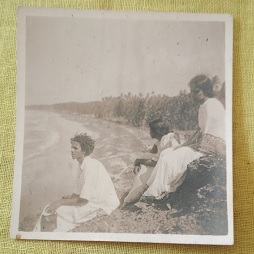
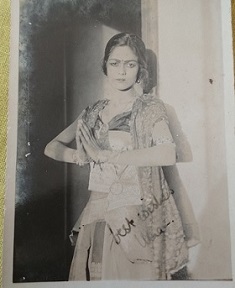
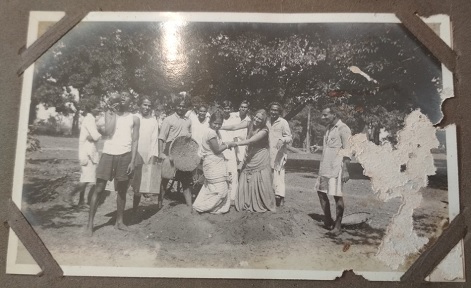
Photos from Pinakin Trivedi’s Santiniketan albums. I took these photos of his photos with Devkumarji’s kind permission.
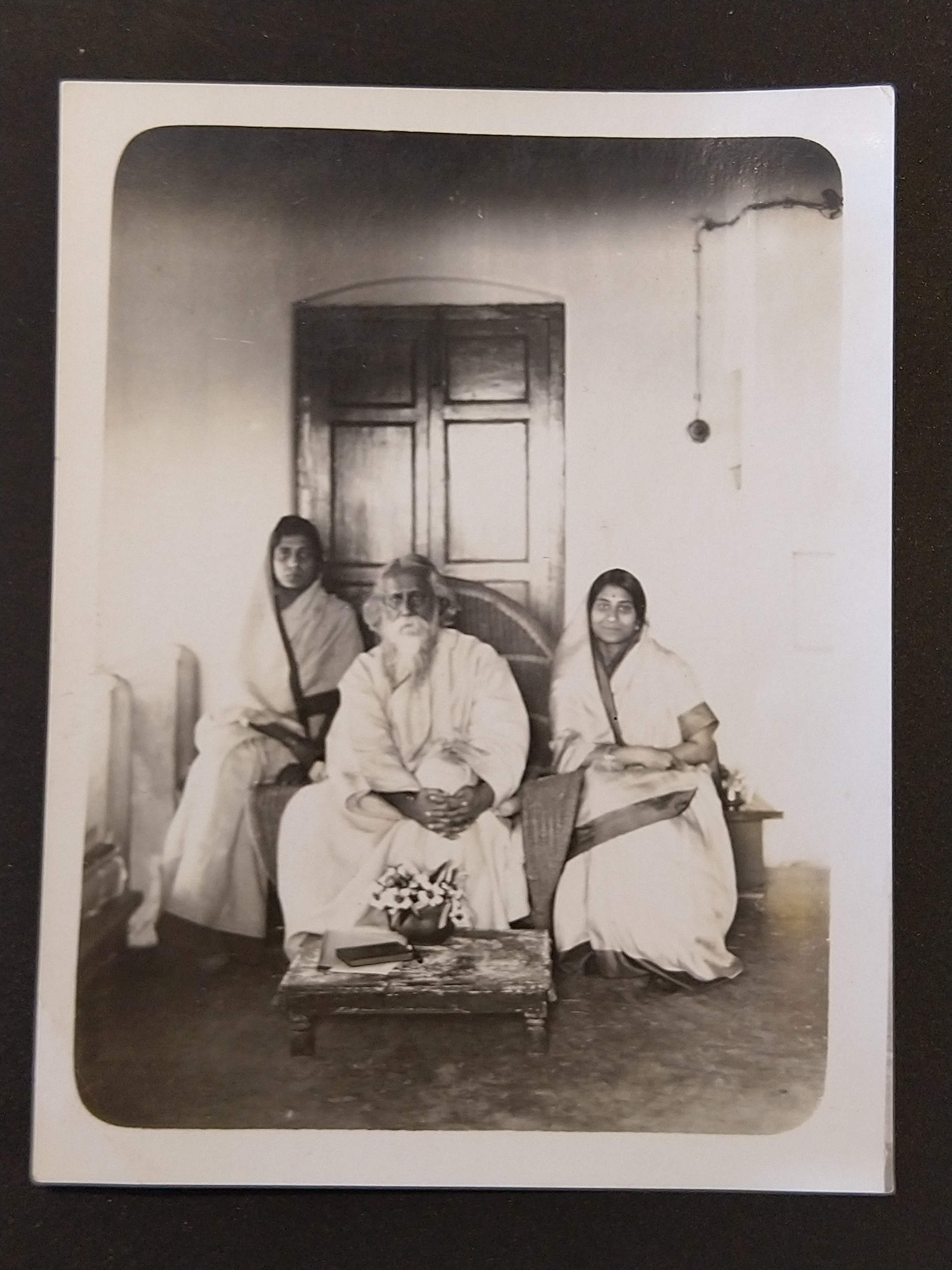
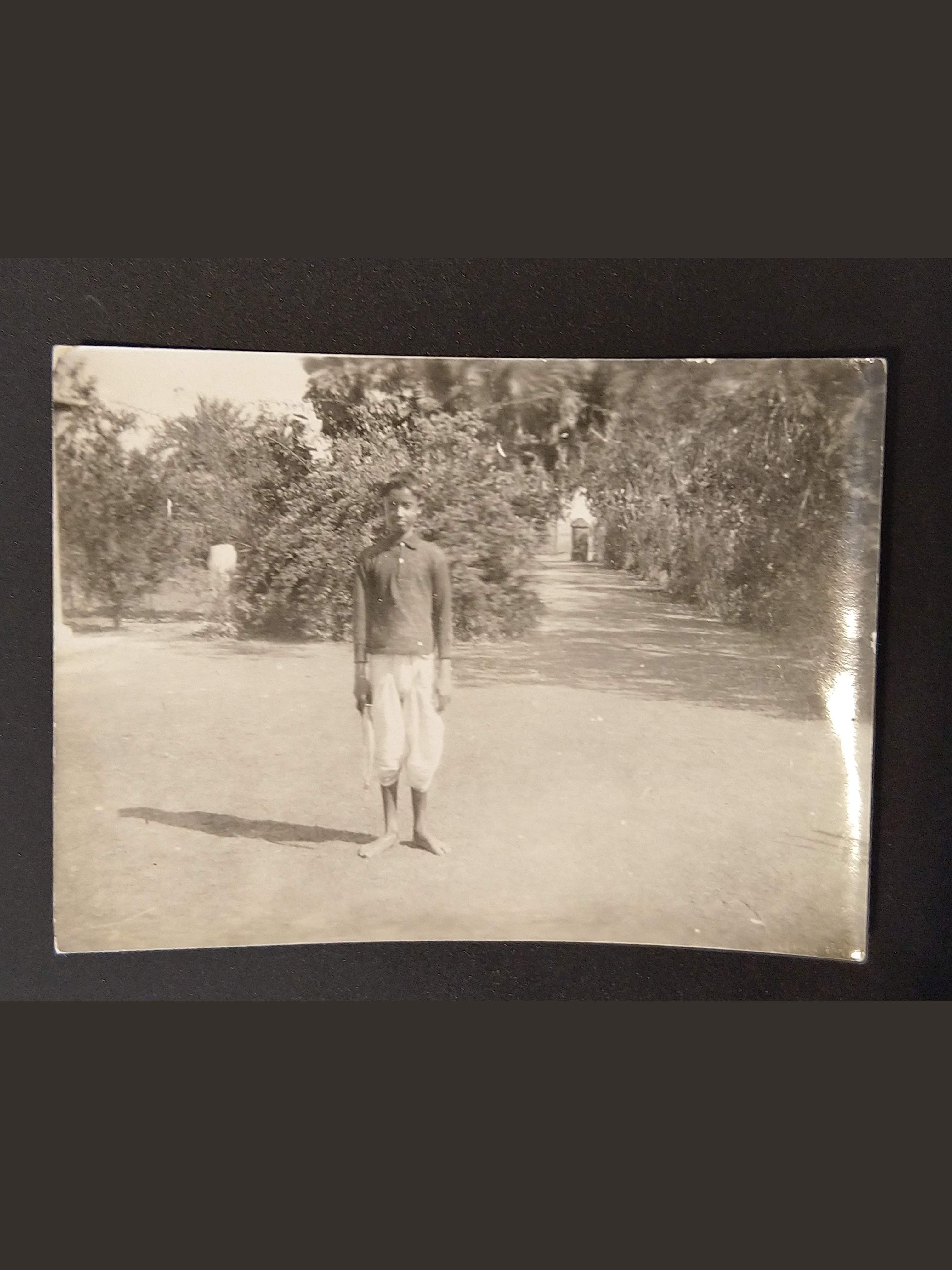
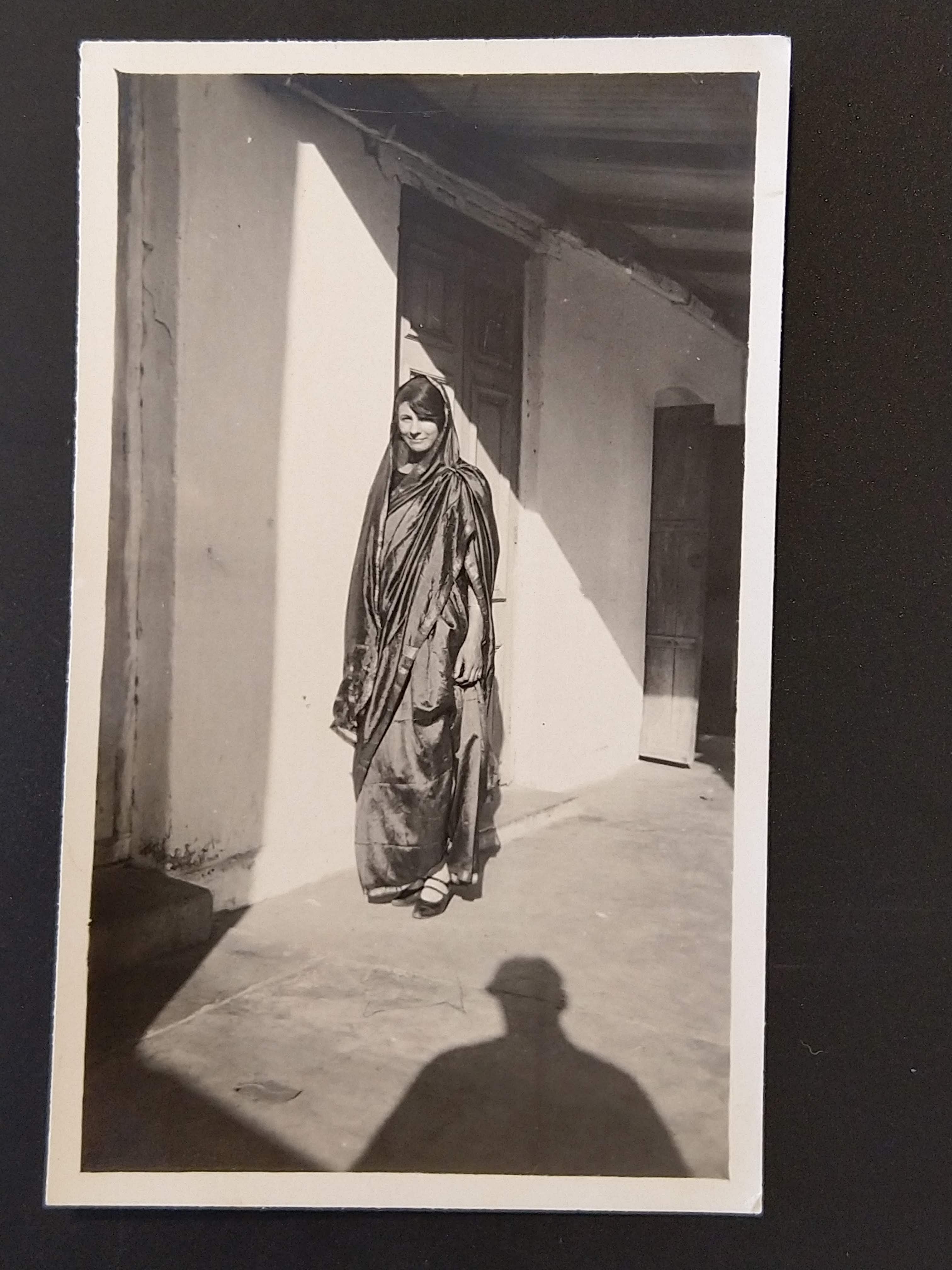
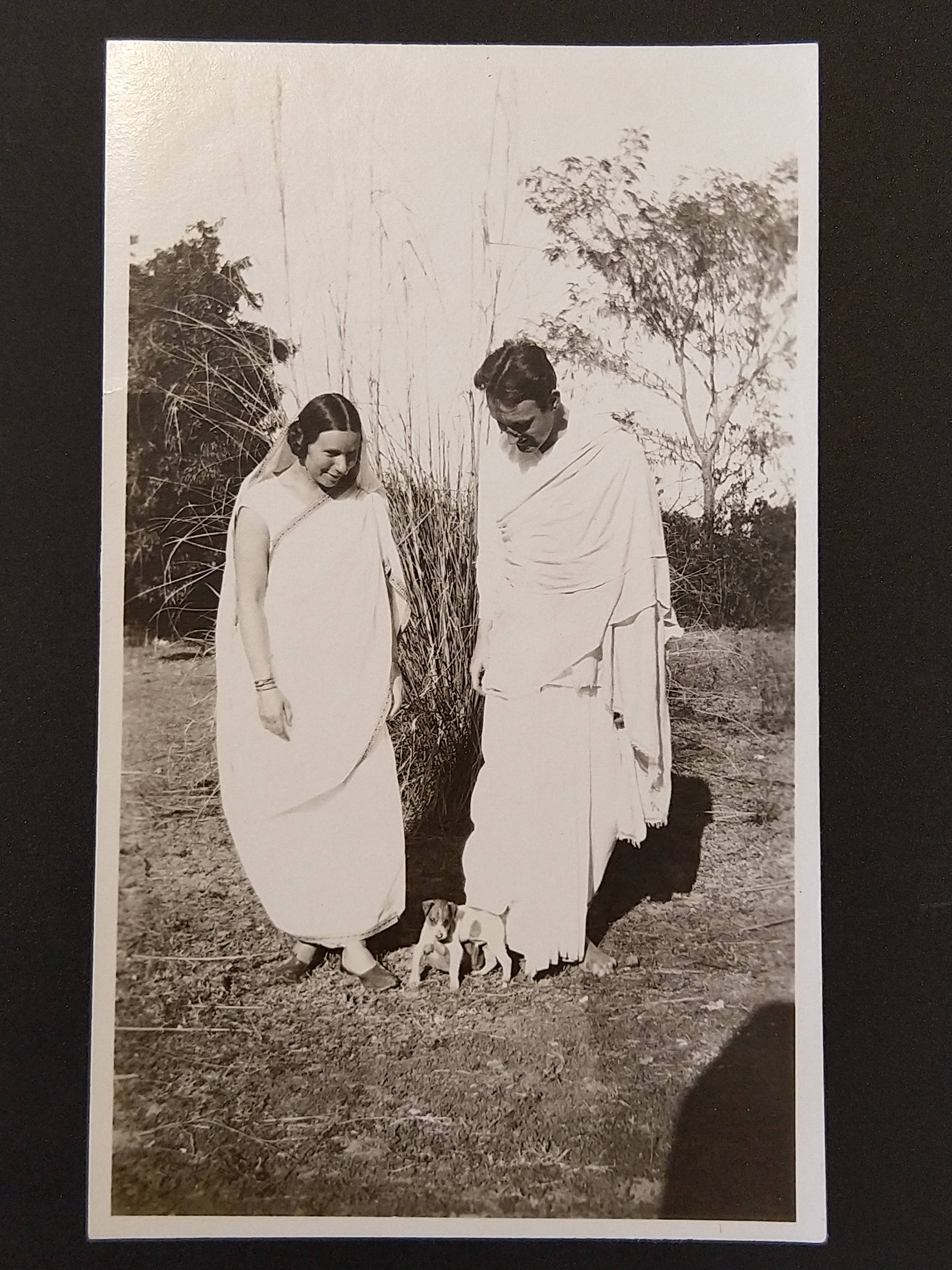
Contrast Pinakin’s images with Arnold Bake’s Santiniketan photos. Source: Special Collections, Leiden University Library (photos of photos)
The last and final treasure that Devkumarji brought out to show to me was Pinakin Trivedi’s autograph book. It is hard to describe this book, because it holds so much wealth. The material feels too delicate to touch. There are signatures and messages, poetry and song from the widest range of people who passed through Santiniketan during the years of Pinakin’s stay, between 1928 and 1933. What is most interesting is that Arnold Bake’s signature and message too are in this book. I have started to work with this material with some colleagues. Hopefully, I will be able to make something worthy of it at some point. For now, I am sharing a few photos. After meeting Devkumar Trivedi, I brought my recordings and images from his home to Santiniketan and shared them with art historian and curator of Nandan gallery of Kala Bhavan, Visva-Bharati, Sushovan Adhikary on 27 April 2019. I went to him with my publisher friend Sumita Samanta. Sushovanda was clearly amazed to see the images, and he helped me identify a large part of the material. There are many voices from different times and places which the material leads us to.
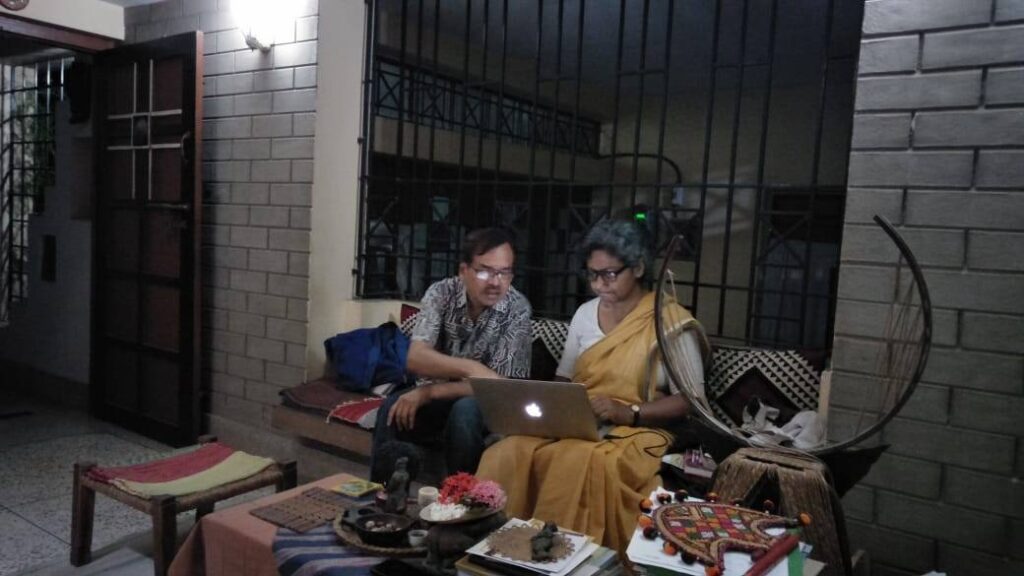
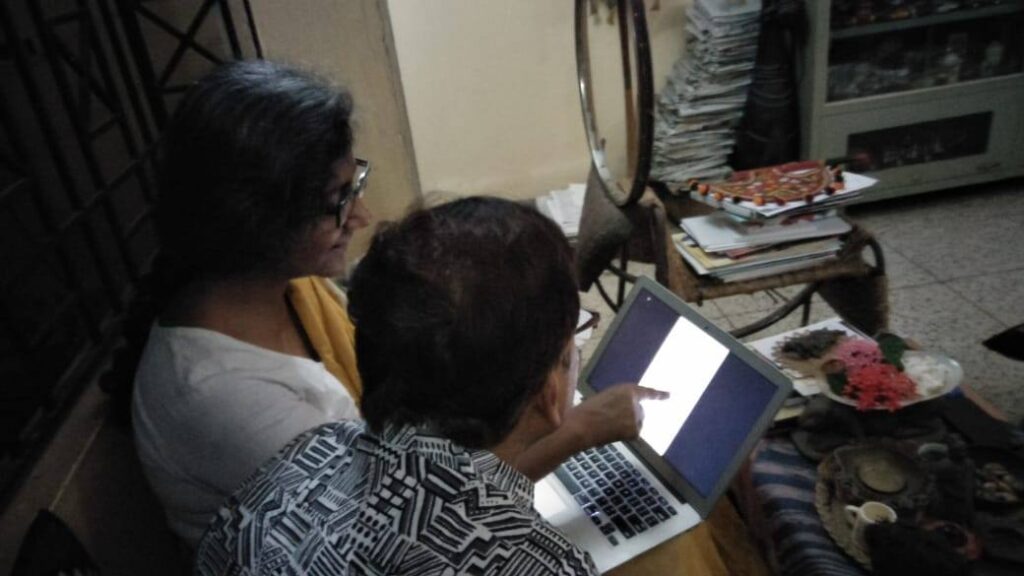
Moushumi and Sushovan Adhikary look at images from her Pinakin Trivedi collection, in the latter’s home in Santiniketan on 27 April 2017. Photo by Sumita Samanta
Sushovan Adhikary and Sumita Samanta look at images of the autograph book, Santiniketan, 27 April 2017.
Pinakin Trivedi shared a deep friendship with Amita Sen (Khuku), the Tagore singer, who was a kind of repository of Tagore’s songs. Student of Dinendranath, Khuku was a fiery spirit, rebellious who did not hesitate to oppose Tagore himself. Khuku died very young. Anyway, when his studies in Santiniketan were over in 1933, Pinakin was preparing to leave and step into his own world, Khuku wrote him a most poignant message in an exercise book. I was telling Sushovanda about it, and reading out the message to him on 27 April 2017, in Santiniketan.
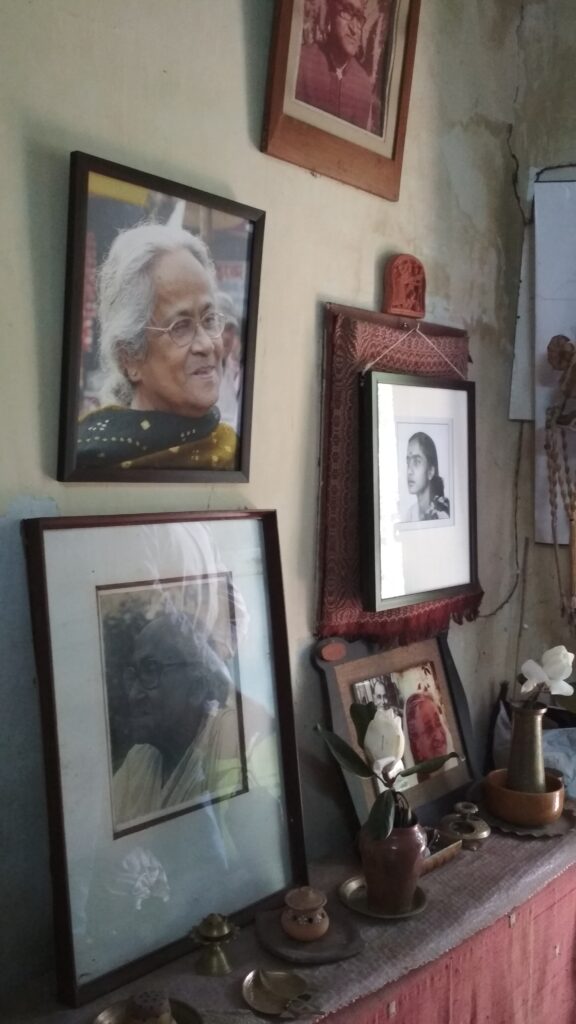
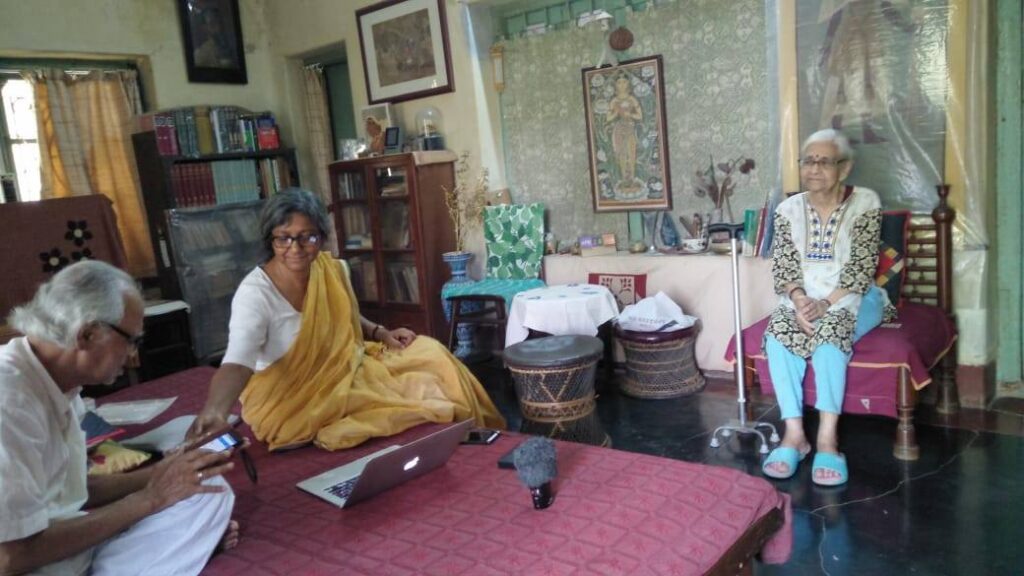
Another old member of the Santiniketan asram with whom I spent time looking at Pinakin Trivedi’s and Arnold Bake’s photographs from the 1920s and 30s was Sri Pradyot Bhanja. Pradyotda has died since, but that morning on 28 April 2019, he had shared with me many stories about life in Santiniketan in the early days. His mother was the famous artist and dancer Gauri Bhanja, who also taught at Kala Bhavan. As dancer and actor, she had played Nati, the court dancer, in the Tagore’s Natir Puja in 1925. Gauri Bhanja’s father was the great guru of Indian art, Nandalal Bose. Sadly, my recorder had run out battery on the day I met Pradyotda in his home in Santiniketan. But I have some photos from his home, and retain in my mind impressions of our very special meeting. He would also send me messages and photographs on my phone. Photos: Sumita Samanta
Finally, a glimpse of the autograph book.
Pages from Pinakin Trivedi’s Autograph Book. All photos taken by Moushumi in Devkumar Trivedi’s house in Delhi in 2017.
Postscript
I sent the website link to Devkumarji and on 5 August 2022, he responded thus:
‘Every passion borders on the chaotic but the collector’s passion borders on the chaos of memories,’ wrote Walter Benjamin in ‘Unpacking My Library’.
My first encounter with Arnold Bake’s Bengal recordings was at the British Library in 2004. It took years for this encounter to start becoming a ‘collector’s passion’. I kept meeting Bake as he was part of the road that I was walking, alone, or with fellow travellers. It was in the course of my work with his recordings that I became conscious of the fact that Bake’s sounds and images from and from around Bengal, made about ninety years before me, were my communal and personal inheritance and they held my history. As I went following his sounds, digging up my history, maps opened up for me and I got lost in them. I learned to listen to sounds, echoes and silences. This, therefore, became a story about absence and presence, about memory and forgetting.
I was in Dhaka, staying with my friends economist and political activist Anu Muhammad and geography lecturer Shilpi Barua in their eighth floor flat in Khilgaon, in January 2018. Khilgaon is a busy and noisy part of the city (where in Dhaka is it quiet anyway?). I had only just come back from a trip to Sylhet where I had met the sons of one of the sailors Arnold Bake had recorded on his ship home in 1934. It was one of my most profound experiences on this journey. On this day in Khilgaon, there were fakirs in the street below, singing and asking for alms. The honey-gatherers. The song was very beautiful and I placed my little Zoom H4n recorder in the balcony. You can hear me fumbling with the windshield, and the metal holder which can be attached to the recorder-cum-microphone. The fakirs went through the lanes and the sound moved in and out of my frame. Later when I listened, I realised there was a problem with the mic and it had added a layer of noise to the recording. Perhaps imitating the surface noise of Bake’s wax cylinders.
Arnold Bake (1899-1963), a Dutch scholar of Sanskrit and Indology and a singer, had come to Santiniketan in 1925 with his wife Cornelia Timmers or Corrie, for his doctoral research on a seventeenth century Sanskrit text of Damodara, the Sangiatadarpana (Mirror of Music), and stayed there till 1929. He was also a keen student of Rabindrasangit, taking lessons from Tagore himself but mainly from Dinendranath. He made Western Staff notations of several of Rabindranath’s songs which were later compiled into a book, Twenty-Six Songs of Rabindranath Tagore (with Philippe Stern, published in Paris in 1935). From 1931 to 1934, Arnold Bake, now on his second trip to India, once again based in Santiniketan, travelled and made recordings on wax cylinders with a phonograph loaned from the Berlin Phonogramm-Archiv. He recorded songs, rhythms and mantras in and around Bengal and in other parts of India as well as in Nepal and Sri Lanka. The recordings are now digitised and archived at the British Library Sound Archive and the Ethnologisches Museum in Berlin, as well as the Archives and Research Centre for Ethnomusicology (ARCE) of the American Institute of Indian Studies, Gurgaon. Other than Rabindrasangit, Bake also learned to sing kirtan and other folk songs and performed them too. Bake had made two more trips to India, in 1937 and then in 1956. Meanwhile, he had started to teach Indian music and Sanskrit at SOAS.
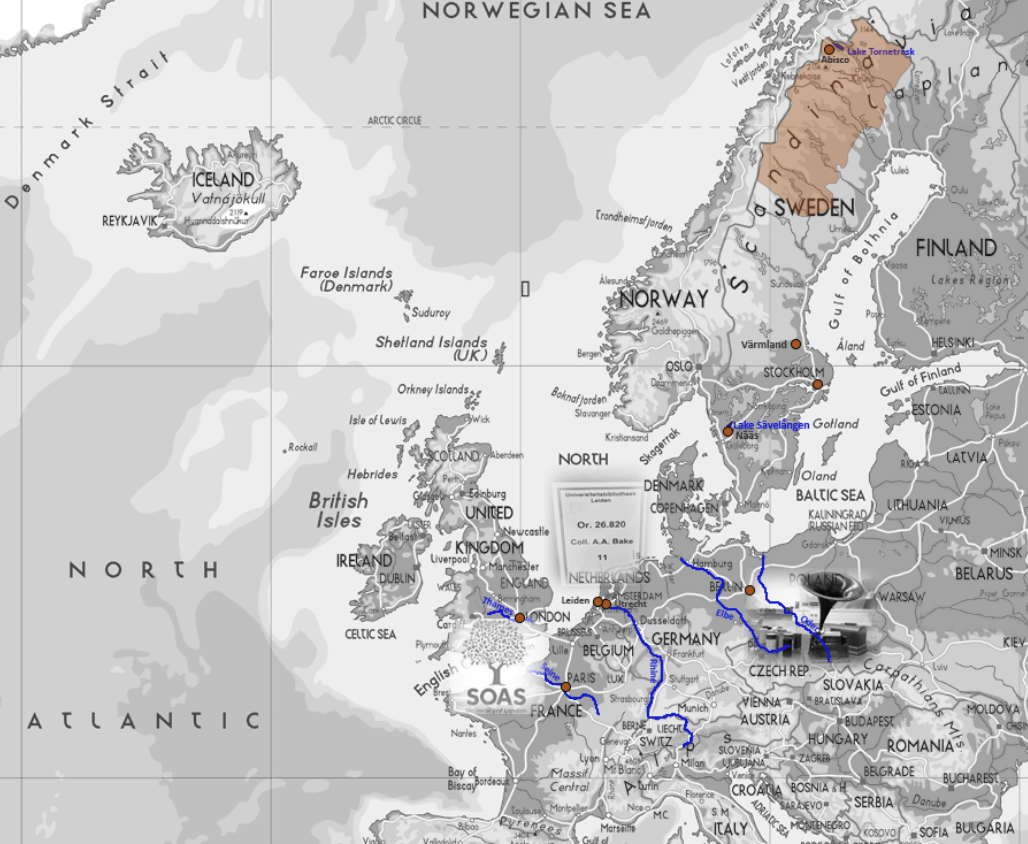
The many archives and institutions in Europe to which Arnold Bake was attached in some way or another; places where he studied and taught. Map by Purba Rudra.
From the end of 2013, I began to formally work on Arnold Bake’s recordings from and from around Bengal, made between 1931 and 1934, and then on his final trip to India in 1956. From the Bake in Bengal archive is born my own archive, marked by what Benjamin says is a ‘dialectical tension between the poles of disorder and order’.
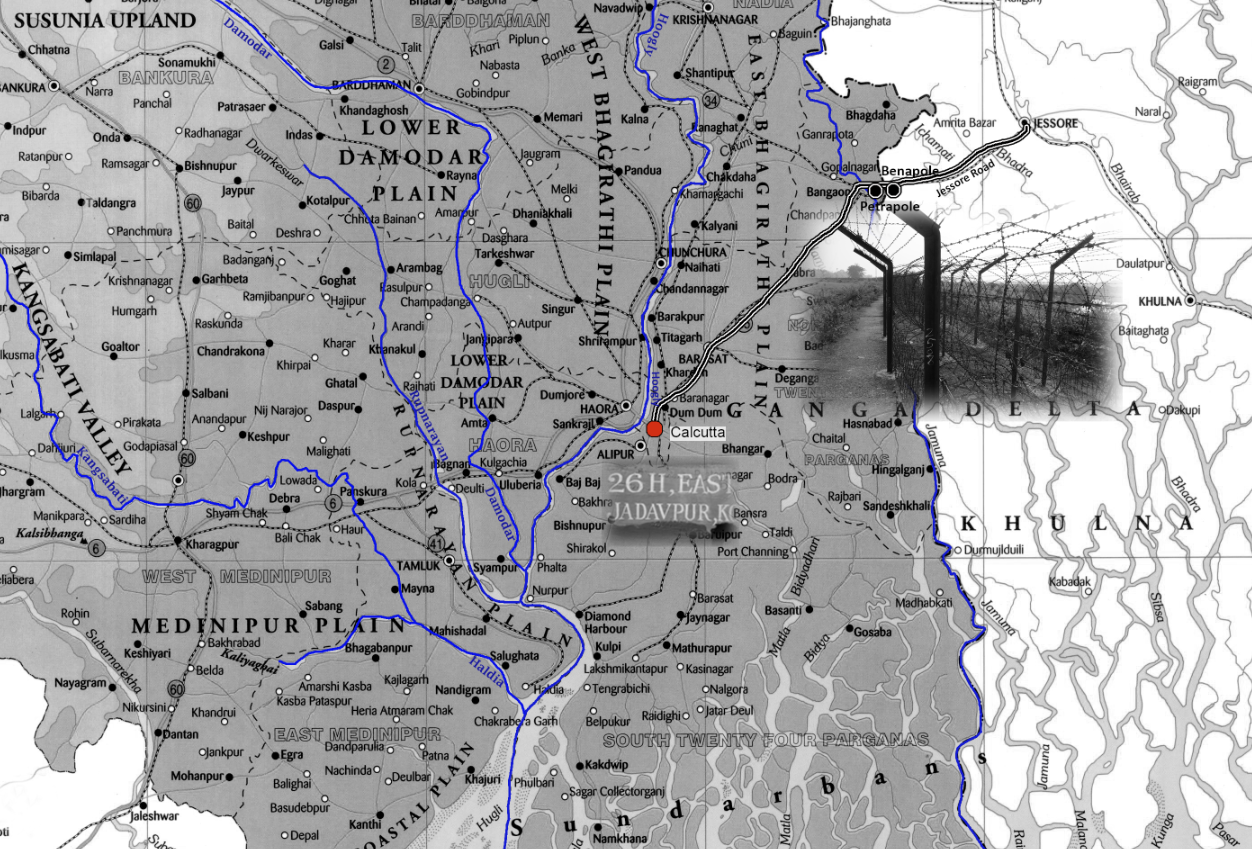
This is where all my journeys begin and where they end. My home. Map: Purba Rudra
No research is ever done by any one person, there are many who are involved in the making of this archive. Firstly, there are the sound recordists who have been part of my journey; they are individually acknowledged for each recording. Secondly, the images, still and moving, and those too are credited individually. Finally, the maps and sounds and their styling on these pages; I have been helped by countless scholars, researchers and translators, and I have tried to credit all of them in the pages which follow; if I have missed anyone, I did not mean to. My work of all these years would not be possible without the support of my institution, the School of Cultural Texts and Records, Jadavpur University and the encouragement of my supervisor Professor Amlan Dasgupta. For this archive I travelled extensively and too many friends were too generous with their hospitality. I try to name them in the separate chapters and sub-chapters. Many artists have contributed songs and other recordings to this archive, and I name them separately in the specific chapters and subchapters.
Beginnings also have beginnings. As I look back, I find a funny email dating to 2007, in which the director of the Archives and Research Center for Ethnomusicology (ARCE), Dr Shubha Chaudhuri, wrote to me about an article I had written for the first issue of IFA’s ArtConnect journal. ‘I just read ur piece in Arts Connect and remembered meeting you here! Glad it all went thru and it is a lovely evocative piece of your “journey”. I hope you will consider archiving your recordings with us here at ARCE and think about making some recordings available on Smithsonian Globalsound … I would like to also add some information – that the Bake collection is at ARCE also and has been here and much used since 1982- and not available only in England. Also, the name is Arnold Bake.’ Whatever made me write Adriaan Bake instead of Arnold is something I cannot figure out now nor rectify! I don’t suppose anyone has ever called Arnold Adriaan Bake by his middle name before or after this huge faux pas! However, that surely was the beginning of something.
All that we get from the catalogue of Arnold Bake’s cylinders is that on 19 August 1933, he recorded a ‘Song of labour’ of some ‘Baori women working on the roof of the post office’, in Santiniketan. Their names, age and where they came from remains unrecorded, Bake only marked them by their caste and professional identity. In fact, the two go together in Birbhum—lower caste Boari women have traditionally worked as roof-makers and thus they have been singers of chhad-petanor gaan or roof-making songs. The cylinder number of this song was 254 of the Bake India II collection.
The words of this chhad-petanor gaan are hard to hear. This is a work song that the Baori women working on the roof of the post office, beating to make it smooth and flat were singing. Bake must have heard them singing and arranged to record them. The special character and power of such songs is in the sound of the voice melding with the sound of the work the singers are doing. However, the recording could surely not be made while the women were working and singing in unison, since he would need the singers to come close to the horn of his phonograph. Therefore, the recording we have from Arnold Bake could not have been the real sound of this music. The words are hard to hear, but there are details of social history held within the layers of this song. Bake did not make many recordings of work songs in Bengal (although songs such as the bhatiyali are also sung by fishermen or farmers, during work); however, he specifically recorded work songs in other places. For example, he recorded the Newari people’s rice-seeds-sowing and transplanting songs in Nepal (Bake India II/22-23), road-making song (Bake India II/61); lullaby in the Malabar coast of Quilon (Bake India II/159), fishermen’s songs in Travancore (Bake India II/152) or the plantation/cultivation song (Bake India II/158) or chaffing song (Bake India II/135) recorded in Ceylon (Sri Lanka).
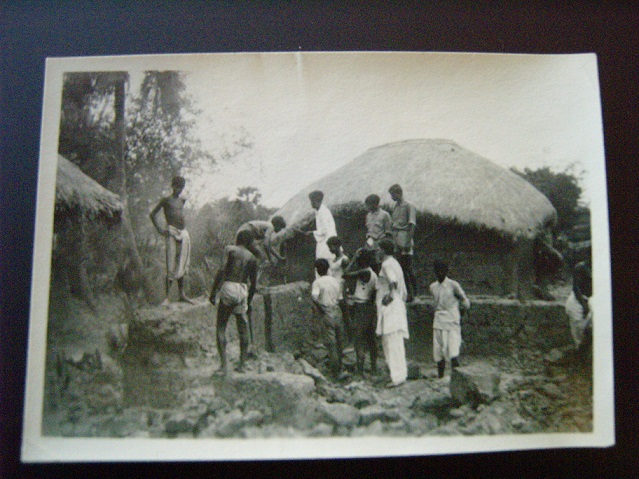
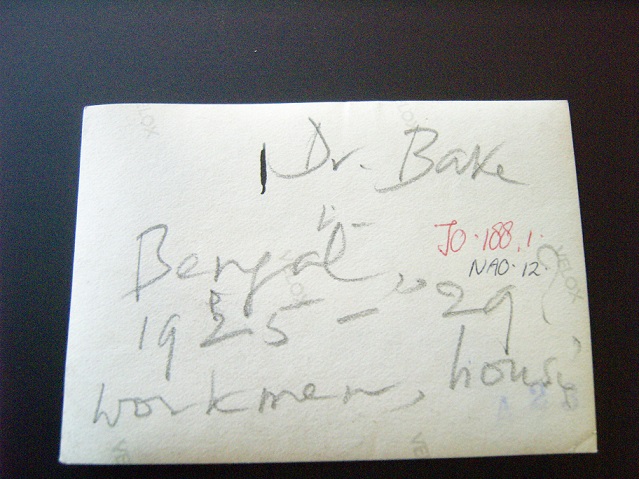
This photo is not from the recording session of course. But it creates an atmosphere and shows the kind of engagement Arnold Bake had with his surroundings; how he saw, felt and listened to things and kept records of some of his experiences. Source: Special Collections, Leiden University library. (Photo of photo, taken while working in the library in 2015)
Who might these nameless singers have been and what might this hard-to-listen-to song be all about? I have had many recordings from the archives, where the song lies buried under layers of noise of the machine, and the noise of the material on which the recording was made and under layers of dust and time. But when I have taken those songs to people who know, the results have been quite amazing. Those who know the songs or about the songs, they can hear things which we can’t. They hear even absent sounds. The real thing, therefore, is to find the ones who know.
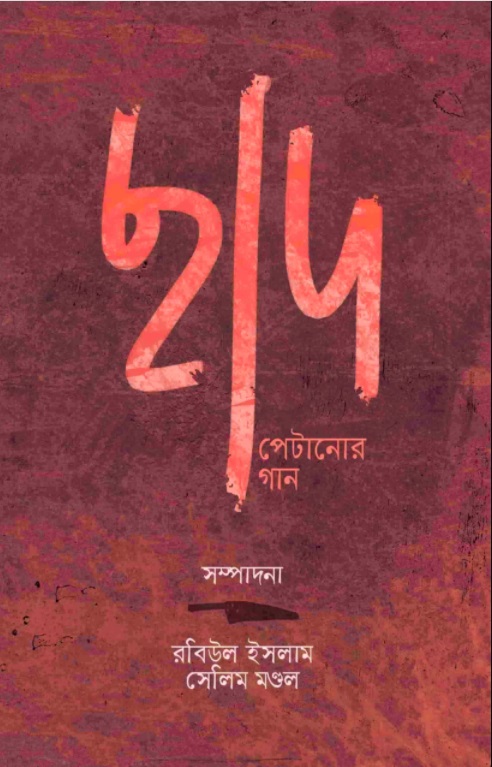
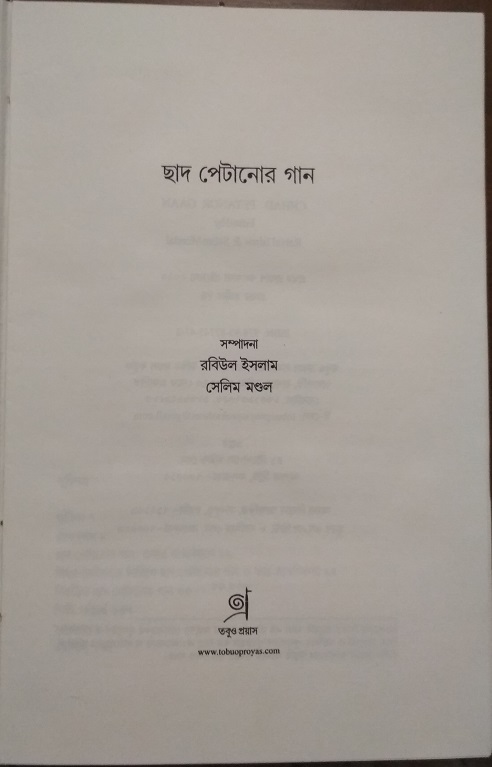
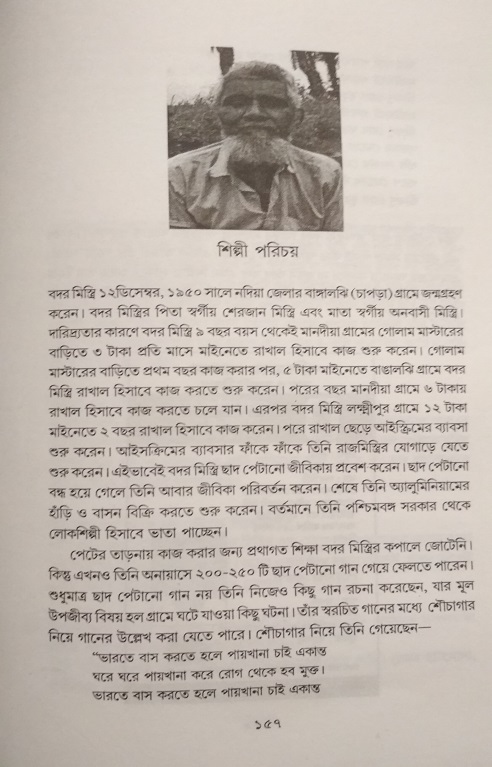
It was quite a matter of coincidence that Selim Mondal of Bangaljhi (Chapra) vilage, Nadia contacted me in 2020 to say he and his friends had compiled an anthology of chhad-petanor gaan, which they wanted to send to me. Edited by two friends Robiul Islam and Selim Mondal, and published by their own Tobuo Proyash, the book has a few short essays on roof-making songs in the context of work songs of Bengal, followed by an anthology of chhad-petanor gaan, collected from local singer and living archive of the genre, Badar Mistry, once a builder who made roofs but now does odd jobs. Mistry talked about the art and craft of roof-making, a tradition mostly lost now and sang many songs for Selim and Robiul. They recorded him on their phones. They had a hard time finding the right time and quiet place to make their recordings. Working like true archivists, Selim and Robiul recorded, transcribed and notated the songs. They then published the volume, while the songs remain in their folders. I am grateful that they shared two soundtracks with me.
The songs of Badar Mistry are nothing like the song Arnold Bake recorded. They are an assortment of tunes and styles—chatka, bhatiyali, something comic, some social commentary—they have a radio-like quality, things which go by the name of palligeeti, or a generic rural song. How can this be chhad-petanor gaan or roof-making song? I wonder. Then I think that perhaps a song becomes a chhad-petanor gaan at the time of its performance, during work. When a group of people sing these songs together, the lead and the chorus, the song is transformed. The rhythm of work gets built into the song, the steady beating of oars on the water (sarigaan), dhenki threshing the paddy (dhenkir gaan), wooden ‘pikni’ pounding the roof (chhad-petanor gaan)–whatever the work is, it makes the song.
If we listen to these workmen from Bangladeshi director Kamar Ahmad Simon’s 2012 film, Shunte Ki Pao! Are You Listening!, I think the point becomes clear.
Clip posted with kind permission of the filmmaker.
Without the chorus, without the action, how would this song be? We can try to imagine this. How would this song work as a solo piece, paced down, no collective breathing to create the rhythm, no action to give it its extra dimension and particular identity? How would it be if the singer was taken to a quiet place to sing to the recorder of a phone in order to keep a record of the song?
With such thoughts in mind, I tried a little experiment. I played Bake India II cylinder 254 on my laptop and tried to listen to it first on its own and then adding roof-beating sounds from a recent art installation of Sanchayan Ghosh.
The Bake recording is from the Berlin Phonogramm-Archiv, which I have had with me since 2016, when there was a plan to work together with them to produce an album. Having the recordings helped hugely in my fieldwork, even if the album could not be made. The song has also been made available for listening by the British Library as a ‘Song of labour’. The roof-making sound is from Sanchayan Ghosh’s work, Chhad Petanor Gaan, also available for free listening here.
From 2016, Sachayan Ghosh, a visual artist and Associate Professor of Kala Bhavan, Visva Bharati, Santiniketan, started working with a group of Bauri (same as Arnold Bake’s Baori) women of Mohammad Bazar, Birbhum, to understand the now near obsolete process of making petano chad or roofs with brick dust, lime and molasses; the other ingredient of this roof is the song. Singing while rhythmically pounding the mortar to make it hard as betel nut was an integral part of this roof-making process, till concrete took over. The Baoris/Bauris are lower caste people and in Birbhum, traditionally, it is the community’s women who have built these roofs. Chhad petanor gaan, as Sanchayan writes in his book on this project which was published by Rhito, Kolkata, in 2020, ‘would often reflect observations and expressions of everyday life, about power, love, suffering, sexuality’ and so on.
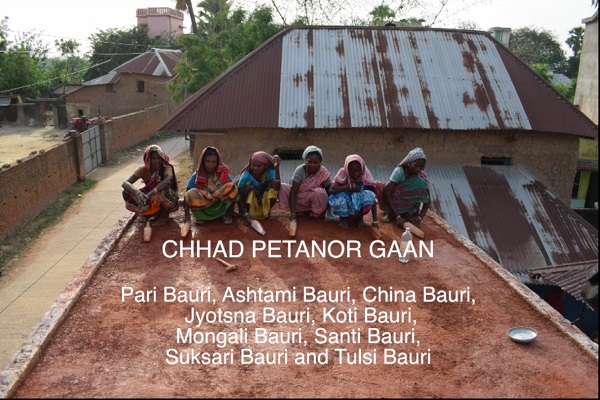
From Sanchayan Ghosh’s video.
Although unnamed, Bake’s Baori women would be the same as Durga, Pari, China, Jyotsna, Koti, Mongoli, Santi, Suksari and Tulsi, with whom Sanchayan has worked. He organised an old-style roof-making in the village, and documented the process, while recording their songs. As I had shared my work with Sanchayan, he sent the Baori women’s work song from 1933 to his collaborators in Mohammad Bazar. At first, the women sent us some rough recordings. Pari Bauri is really their leader and she was not around during the first attempts made on 21 December 2021. Two days later, Pari, about 50 years old, sat down with some women, listened to the Bake recording and they sang a song. It is clear from the final recording that she could connect with the old song. They had recorded on their mobile phones on both days.
Recorded on 21 December 2020, Bauri women of Mohammad Bazar.
Led by Pari Bauri, recorded on 23 December 2020
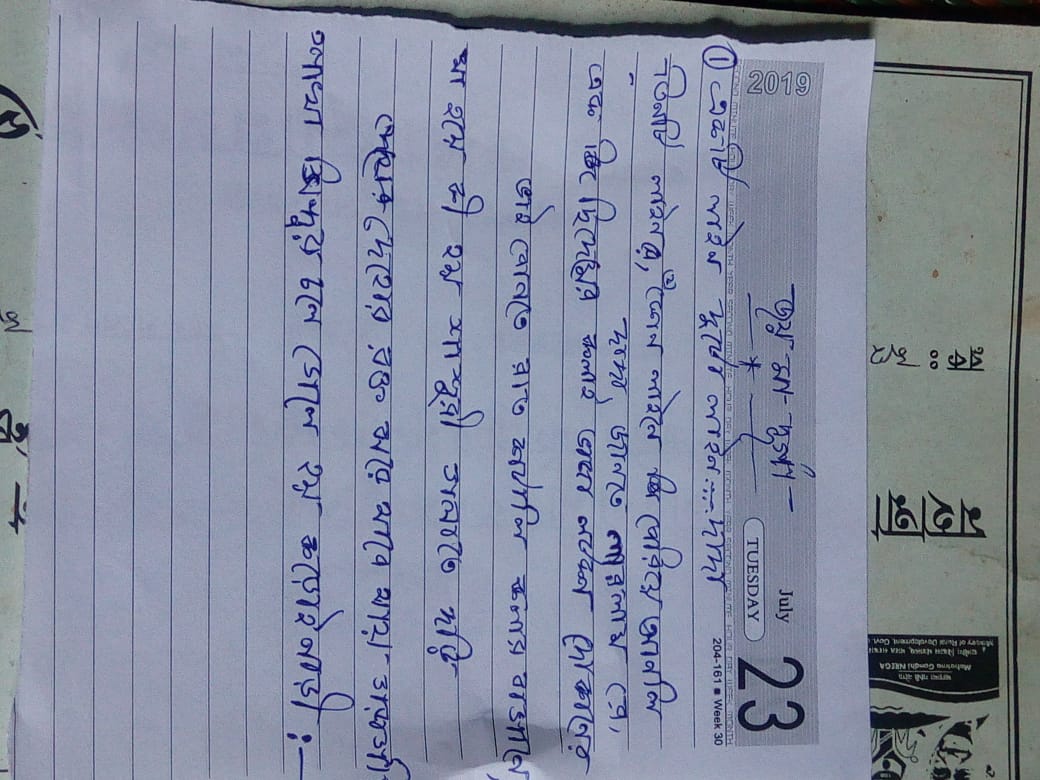
Words of the song Pari Bauri and the other women sang. On close listening again to Bake’s recording, it seems we can hear similar words in the old song and the structure is certainly the same.
It might be interesting in this context to listen to a work song that the father-and-son ethnomusicologist team of John and Alan Lomax recorded in the Darrington State Prison Farm in Texas 1934. I found this freely downloadable song here and there is much more about work songs on the Library of Congress website. ‘Long John’ was sung by a man identified as ‘Lightning’ and a group of fellow black convicts. ‘Black prisoners working in gangs to break rocks and clear swamps relied on the repeated rhythms and chants of work songs (originating in the forced gang labour of slavery) to set the pace for their collective labour. Long John mixed religious and secular concerns, including the notion of successful escape from bondage, a deeply felt desire of both slaves and prisoners.’
In 2019, I went to meet Haresuzzaman Hares, folk song and folk art and craft collector from Kishoreganj, whose father was the famous collector Mohammad Saidur, (1940-2007), to talk about jarigan and puthi-path of the Mymensingh-Kishoreganj-Netrokona area. These are places from where the prisoners of war of our story and our sailors and our jarigan singers all came, those recorded by Bake or even earlier by Wilhelm Doegen, between 1917/18 and 1934.We met at the Liberation War Museum in Dhaka, where Haresbhai worked. He has promised to take me to record the women who sing the Ramayan in his region.
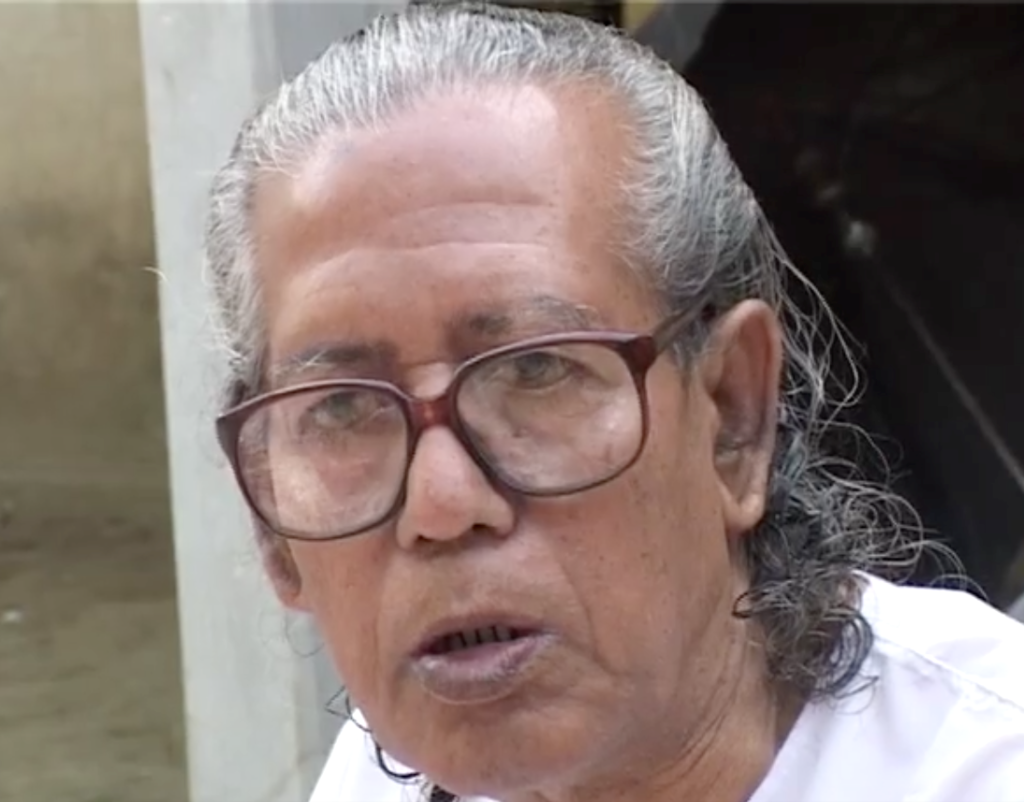
Mohammad Saidur (1940-2007), collector of punthi, kantha, scrolls, clay things, as well as songs and stories, who also worked with Henry Glassie.
I stayed in touch with him and the next year, in the middle of the pandemic and at the close of my doctoral research, I called him several times to talk about this and that. We did not get very far in our search through these conversations, but the quality of these recordings reveals something unique about this research and I want to keep records of our conversation, because of that special touch that Haresbhai brought to it. A research is not always about results. If we are going round and round in circles, then we should talk about that too. These conversations show something about that process of this research.
In 2019 we had talked about going in search of Imam Bux Boyati’s descendants and finding old recordings of Imam Bux’s voice . Haresbhai had said that day that his father might have also made some recordings and they might be with Bangla Academy, Dhaka. He was not sure. I have this above recording on the Imam Bux sub-chapter of Santiniketan and Others, but I am keeping it here again, to show how a continuity built up in our communication.
When it came to working on Keramat Ali’s voice. I called Haresbhai from my home in Kolkata. Here are recordings of four pieces of telephonic conversations we had between July and September 2020. Being the son of Mohammed Saidur, Haresbhai has grown up in a tradition of listening, collecting and recording. I gave him the words of the puthi, as transcribed by Ali Ahsan, and he took them to many puthikars and boyatis (folk musicians) of the Mymensingh-Kishoreganj region, but they have not yet been able to identify the text.
‘I have talked with many of them, they have different opinions [bhinno mot]. Rahamat Ali Boyati of Hossainpur (80), said it might be Shahi Modina, an old puthi, but I have not heard of such a book. Then Lal Mahmud had said it could be the Taale Modina, but I don’t know that one either. We have to find the original book. They are illiterate poets [nirokkhor kobi], you see, but they have the song in them [shur ase] and will sing out the words, but they can’t read and that is the problem’.
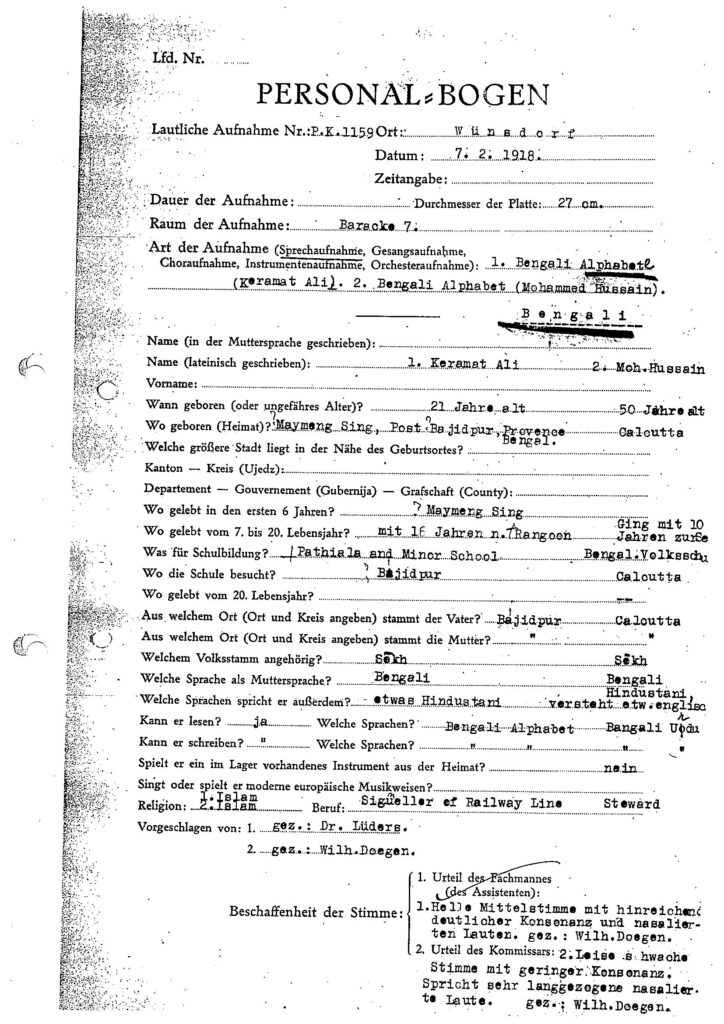
This is the personal information sheet for Keramat Ali Image courtesy Britta Lange
Haresuzzaman Hares told me that the main problem was that these singers were nirokkhor kobi, they were unlettered poets. But, Keramat Ali wasn’t nirokkhor, he could read and write, he went to pathshala and minor school. We know this from his Personal-Bogen.
On 13 October 2019, I went with sound recordist Sukanta Majumdar to meet Helim Boyati of Rajibpur, Netrokona, to learn from him about jarigan and puthi-path, both forms of narrative song, the latter called melodic reading by David M. Kane in his detailed study of the form and its usage in Sylhet. Helim Boyati, a living master of these forms of narrative song of this region, talked about their current practice and described how things used to be in the past. He talked more about jari, but he also read out a puthi for us. I have discussed Helim Boyati’s jarigan recordings in my sub-chapter on Imam Bux Boyati in the Santiniketan and Others chapter. So we can read and listen to this sub-chapter in conjuntion with that one.
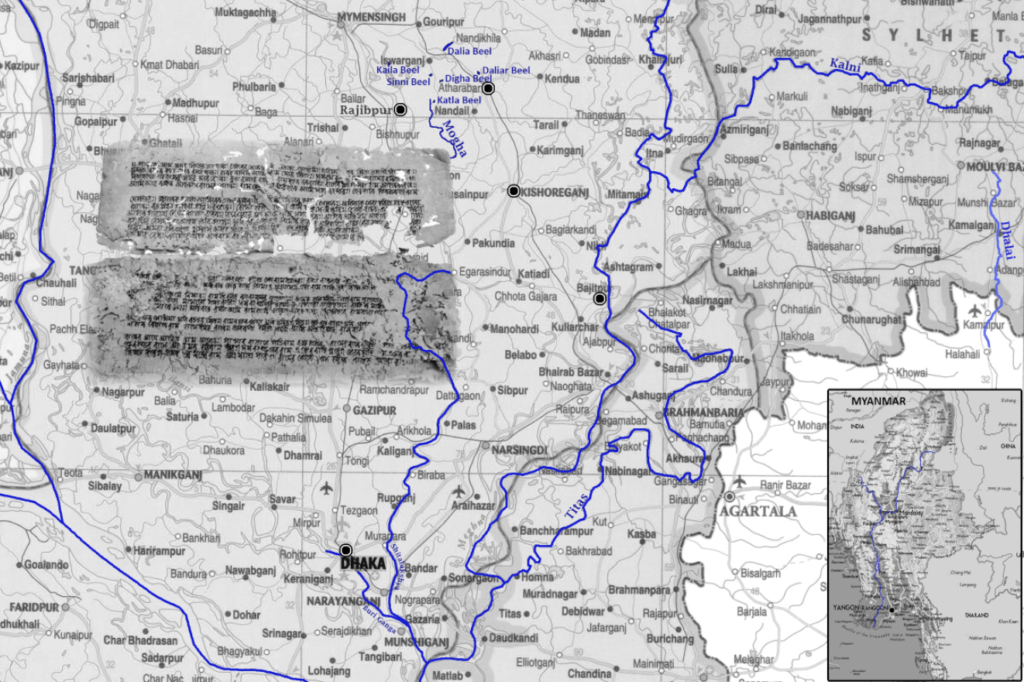
Map of the places from where these songs and our singers came, with a page from an old puthi placed as an inset. Created by Purba Rudra
There was a sense of fullness, of a pitcher brimming with songs in 78-year-old master singer Helim Boyati’s recollection of jarigan in the Mymensingh-Kishoreganj-Netrokona region in the early days of his career in the days of his youth, just after the Shongram or the Liberation War of Bangladesh of 1971.
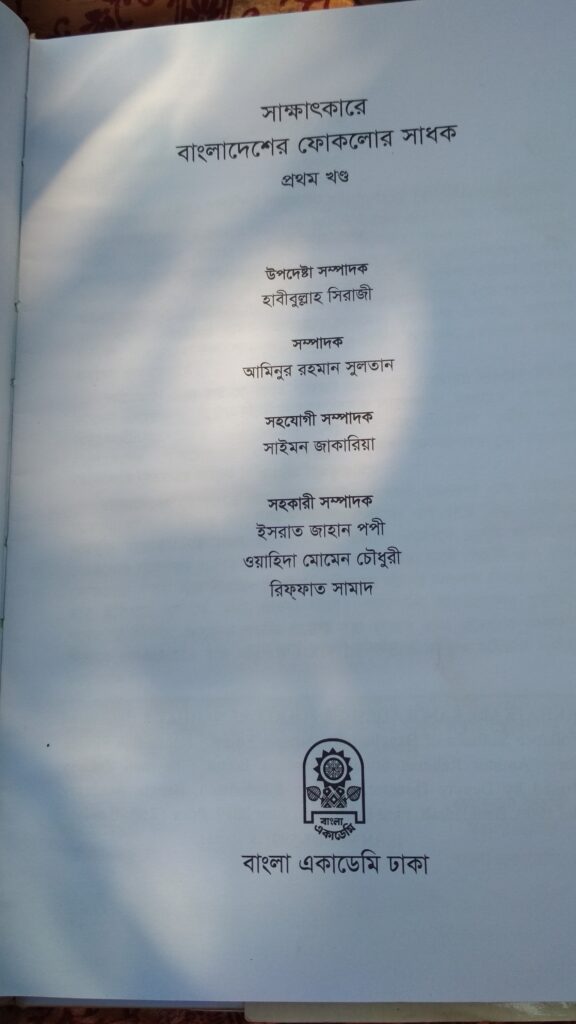
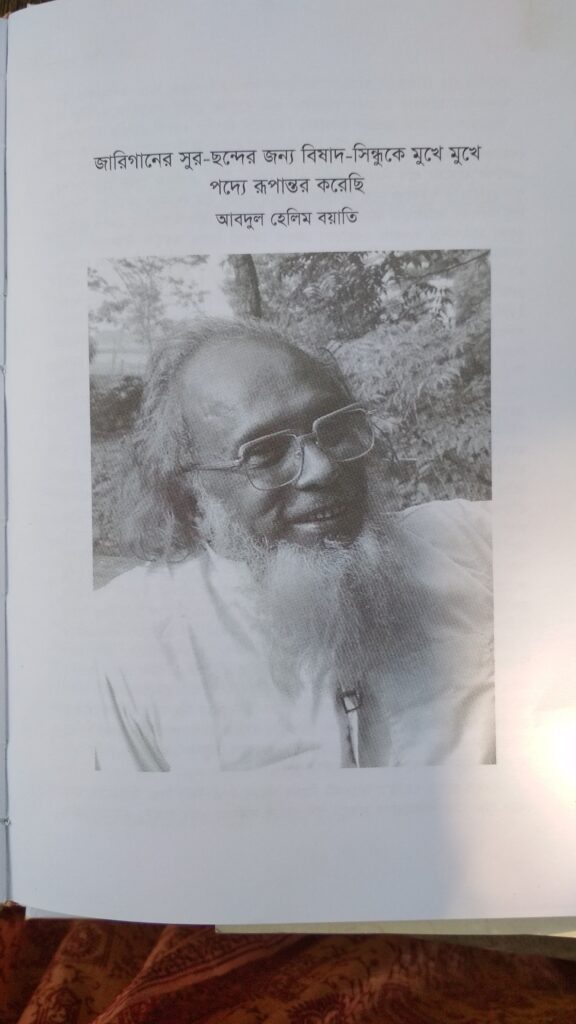
Pages from Sakkhatkare Bangladesher Folklore Sadhak, Vol. 1 (Conversations with some folklorists of Bangladesh), compiled by Saymon Zakaria and published by Bangla Academy, Dhaka.
We talked mainly about Arnold Bake’s recording of jarigan, when Imam Bux Boyati and his team from Atharobari, Netrokona, had visited Suri in Birbhum in the west of Bengal in 1931-32. The experienced and learned boyati listened to Bake’s recordings and responded with songs and stories. It was a sunny morning, there were children running around, ponds and cows and green fields beyond. Helim Boyati spoke with pride and nostalgia about a time he missed but could not go back to.
Helim Boyati listens to Bake recording of jarigan in 1932. Video by Moushumi
Helim Boyati also read the puthi of Layla and Majnu that day. I was not asking him about Keramat Ali, whom Doegen had recorded in the Wunsdorf POW camp in 1918. But generally about songs of this land of waterbodies. What he was saying, however, was taking me to Keramat Ali’s song. Helim Boyati also writes his own puthi. That day he told us about a puthi of Sheikh Mujibur Rahaman that he was working on.
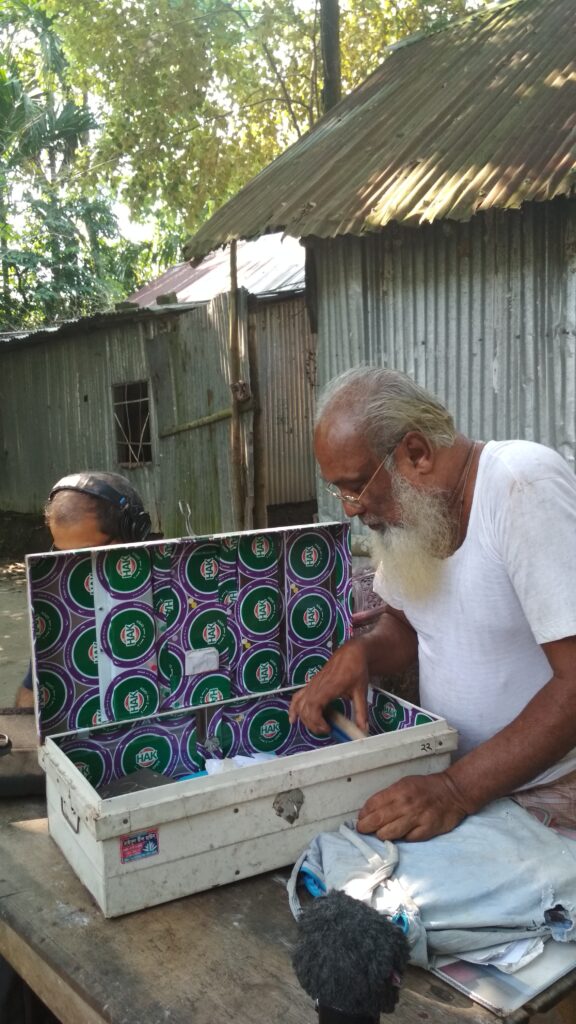
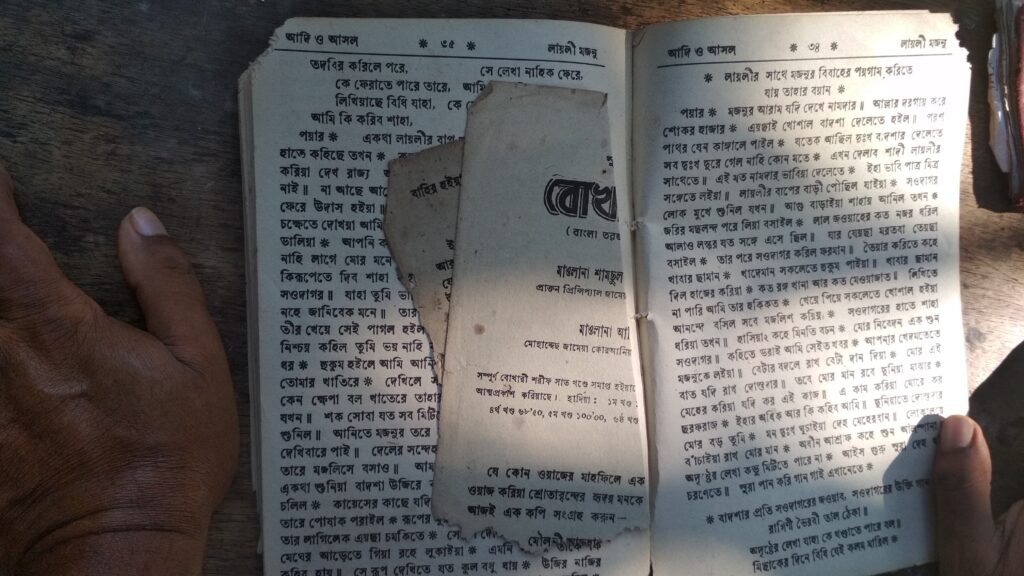
This puthi was inside his trunk of treasures.
Jarigan and puthi-path come out of this land of rivers and beels or lakes. Here the singer is also the storyteller. Such as in Ramayan-gan, based on the Hindu epic of the Ramayan. While the tradition of puthi-path has lost its place of prominence in rural life, jarigan performances and competitions continue here, especially in the month of Muharram. On the other hand, in spite of its depleted Hindu population, the Ramayan-gan too continues to be popular in these parts of Bangladesh. The day after we went to Rajibpur, we went to the house of Shankar De, a singer of Ramayan-gan in Shatal, Kishoreganj—again part of what would have fallen within Mymensingh district during Keramat Ali’s time. In the time of Imam Bux too. Ramayan-gan is sung in these parts during shraddha (Hindu rites for the dead) observance, yet, as Shankar explained, Muslim listeners also gather, waiting for the lines about the grief of Ma Fatema, which are inserted into the story of the Ramayan.
It is Sukanta who had first met Shankar when he was working on the sound for a film on Chandrabati, the sixteenth century female poet who had written the story of the Ramayan from the perspective of Sita. Shankar works as a carpenter in Kishoreganj and lives a life of real hardship, located as he is on the margins of society, on multiple counts of class, religion and caste. Such is the story of so many powerful singers of our land that Shankar’s story is no exception. Here in this clip, he is singing the story of the twins Lab and Kush, when they meet their father Ram for the first time and tell him about their mother, Sita. ‘Who are we, King, what can we tell you about ourselves? All we can tell you is about our mother.’
This journey in search of Imam Bux and his jari, and Keramat Ali and his puthi-path, brought us in contact with many interesting singers and song-collectors of the region. Anwar, who has a music shop in Atharobari (from where Imam Bux was supposed to have journeyed to Suri in 1931-32) collects old audio tapes and videos and digitises them and then he distributes them among his customers and friends. He is a passionate local archivist.
We can end this little sub-chapter with a clip from a CD that Anwar had diigitised from what must have been a VHS tape. Here Behula has set sail in her raft to go to the heavens and ask the gods to bring her husband, killed by the angry snake goddess Manasa, back to life. The audience laps up the story, quite like how Keramat Ali’s audience might have listened to him when he was a free man and when he had not gone to war. Therein lies the continuity from Keramat Ali to Shakar De, from Imam Bux to Helim Boyati—all of them singers, sailing in the river of time.
Meanwhile, there was an exhibition on the archaeology of sound, entitled A Slightly Curving Place, curated by Nida Ghouse in the House of World Cultures, Berlin in 2020 and in 2022 it travelled to Alserkal Art Foundation in Dubai. This installation was an eight-part sound play and one of the parts which The Travelling Archive had created (we made three separate parts) was on the voice of Keramat Ali. Here is a page from the book, A Slightly Curving Place: An Archaeology of Listening (Berlin: Archive Books, 2022)
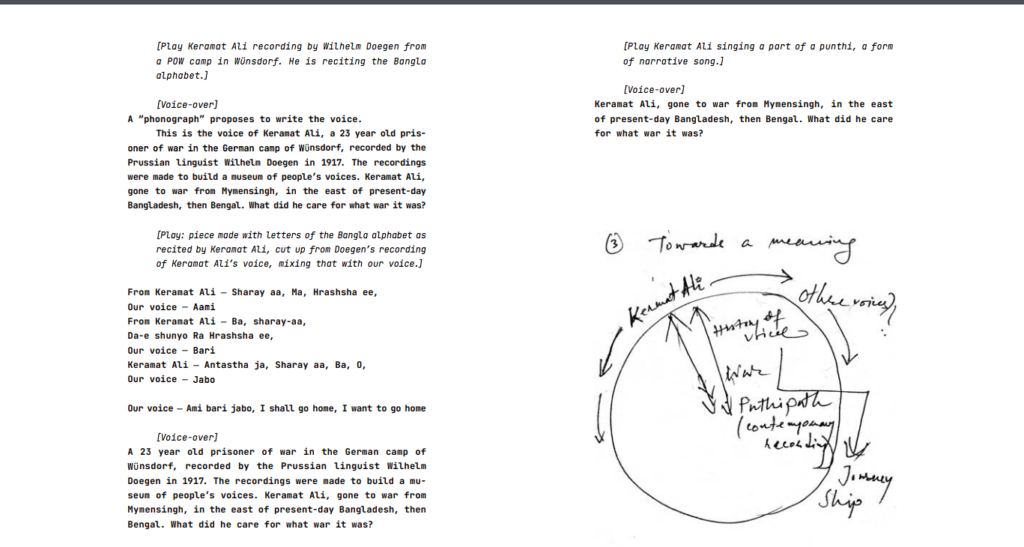
Script: Moushumi Bhowmik, Score: Sukanta Majumdar
On 9 October 2019, I set out for Rajshahi again, this time with the intention of finally reaching the village named in Arnold Bake’s note for his Naogaon recordings: ‘Kunij gram; p. o. Kampur or Darilpur. Naogaon subdivision p.o. Soregachi’. I went by train from Sealdah to the Gede border, crossed to the other side, took a van rickshaw to the bus stand where a friend from Faridpur, Sanjay, whom I had met for the first time all the way back in 2006 said he would come and meet me. And then we took a bus to Kushtia. (You will find Sanjay’s mention here, even though he was with us on our trip to Fulsuti and Baotipara in Faridpur earlier that year)
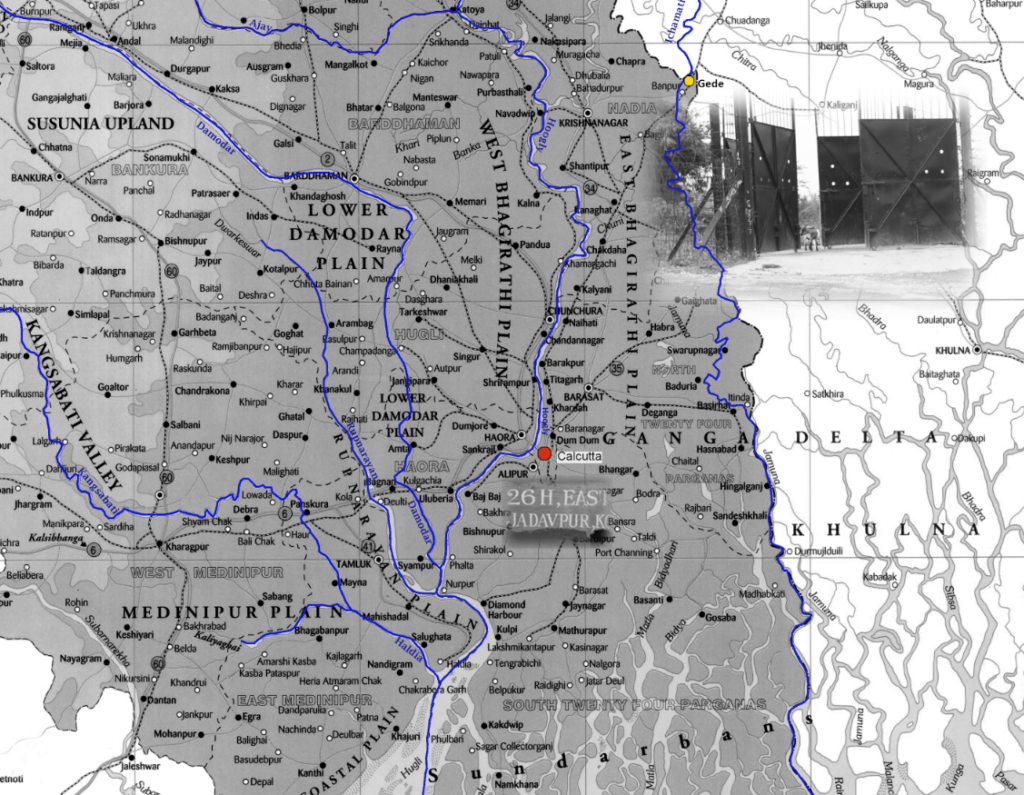
Over the years, from my home, house no. 26H, to the border, be it Benapole or Gede, has become an easy train ride. Sometimes, though rarely, I have also hired a car. But this one was by train. I watched and listened to the fields and faces with both my eyes and ears as well as with the camera on my phone.
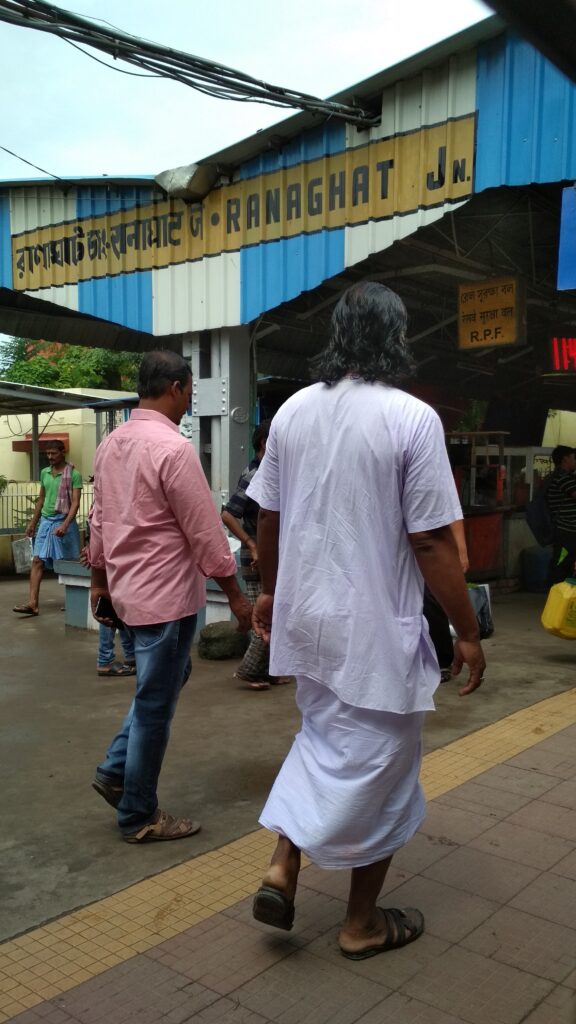
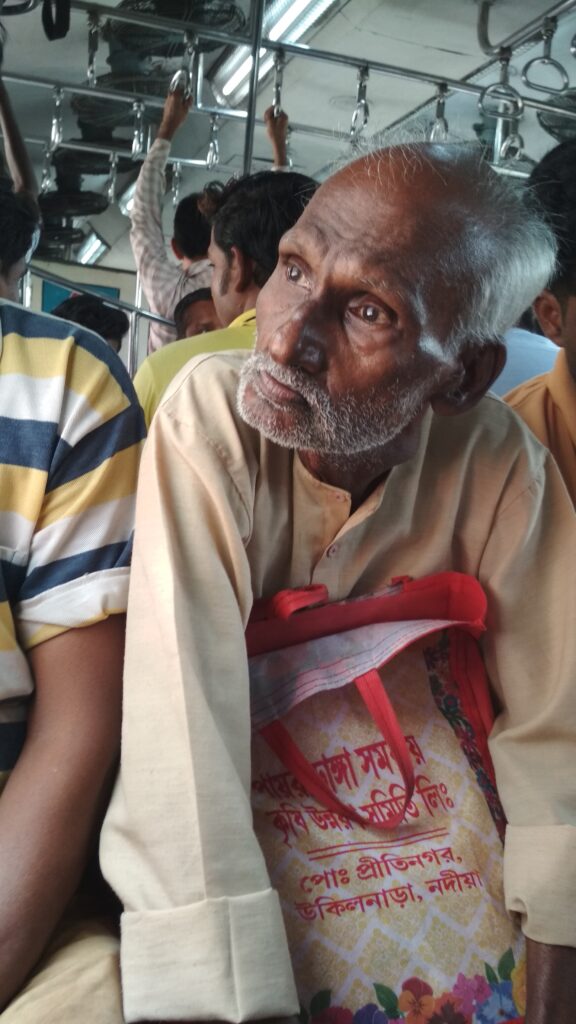
Once on the other side, I feel such a sense of homecoming that I must take it all in to my fill. It starts with the sky.
Then, cake and tea, and shop signs and street sellers open up a world that speaks to me in many time signatures. Sadhana Ayurvedics or what remains of that hundred-year-old pharmaceutical company ; the medicine seller on the street who makes me think of our favourite singer Ibrahim Boyati and how he had started life in music as a ‘canvasser’ or one who gathers buyers by the power of his voice and songs.
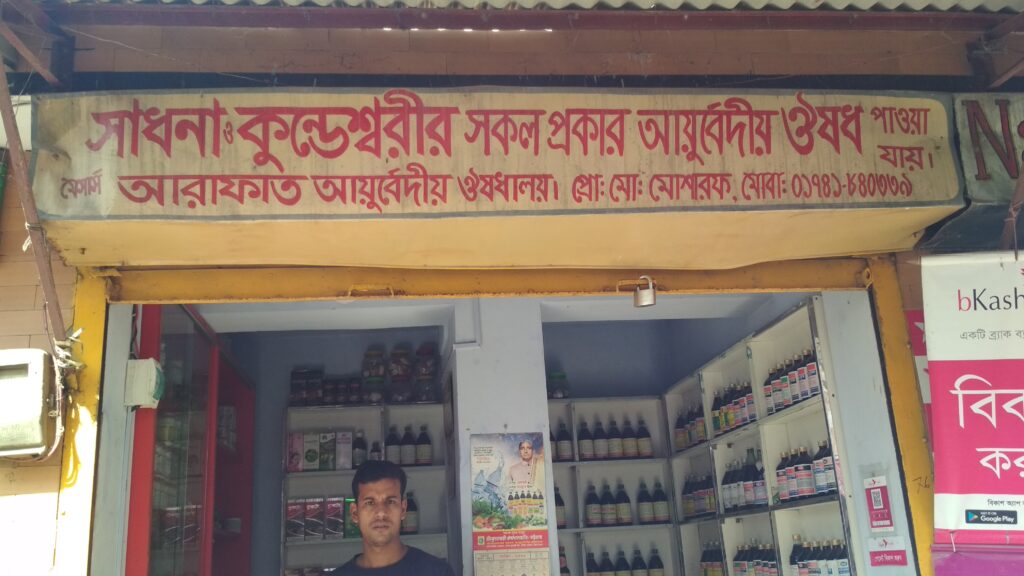
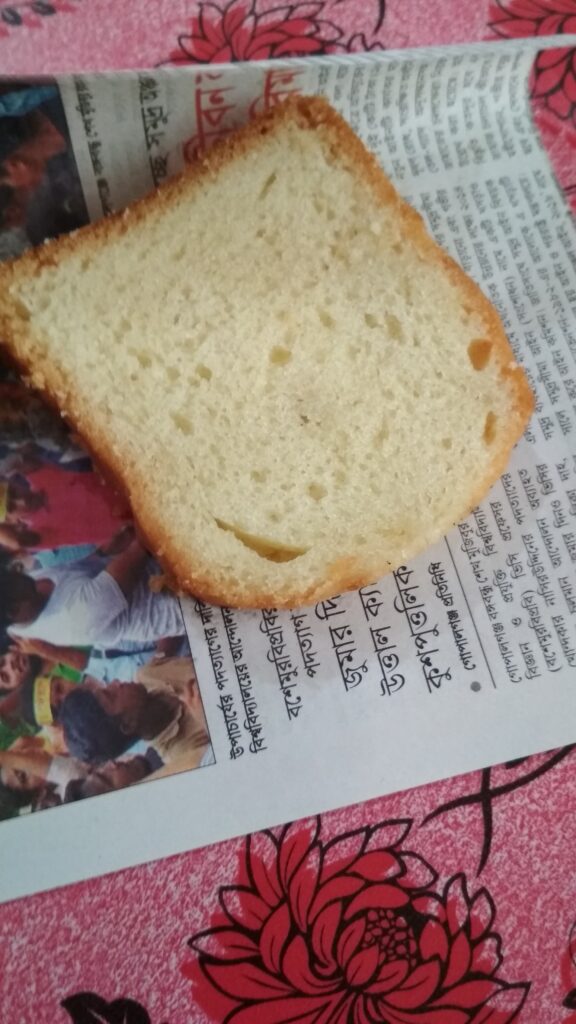
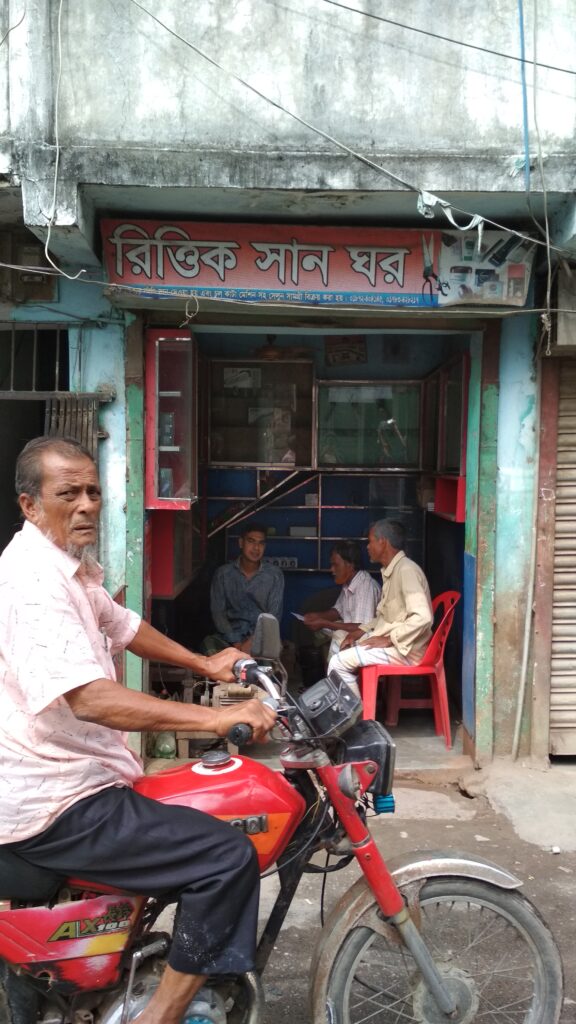
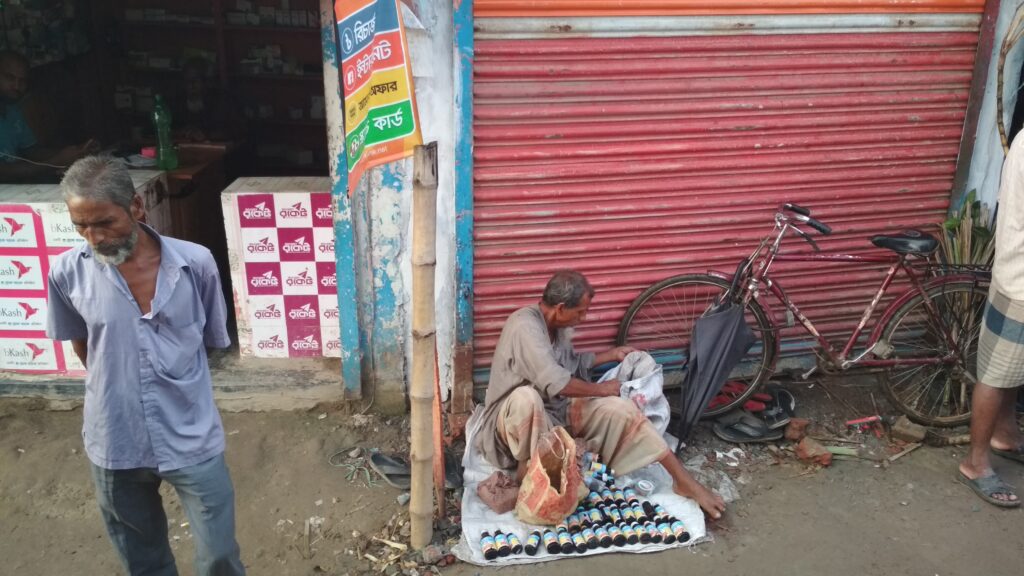
I met Nazrul Fakir in Kushtia. Nazrul, whom we have known for a long time, a very gentle creature, of whom Salamot Bhai, my dear departed friend and teacher in Faridpur, had said that he had the makings of a true fakir. I suppose it is because I was searching for some elusive fakirs with unfixed homes, that it felt as if there were footsteps of past walkers and seekers in every corner of this land–in Kushtia, Joshor, Naogaon, Mahasthangarh and everywhere I went. Nazrul took me to Lalon Sai’s mazaar, and there was singing going on there. Just regular singing, everyday things, and you knew how this was all part of the same world of sound. The sound from which Khoda Baksha Sai came and the sound of Nazrul too; something of that sound was in the recordings of Arnold Bake. These travelling musicians he recorded might have sung here in Kushtia, they might have come to Lalon’s urs.
I had my recorder open and was just walking through the place, and it was listening and recording, like I was doing with my ears and my mind. I don’t know who was singing, I did not try to know the name.
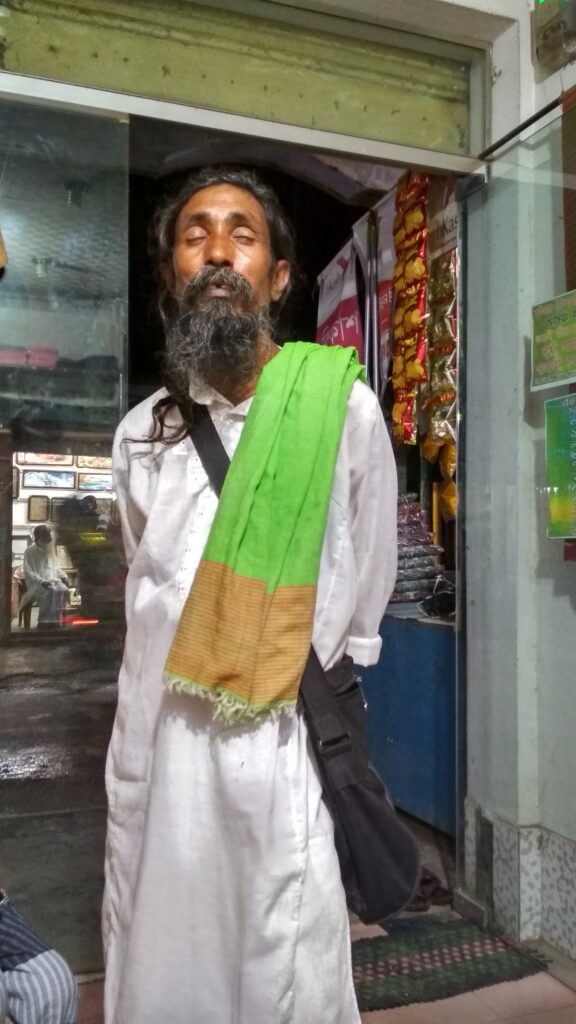
Nazrul Fakir, 9 October 2019.
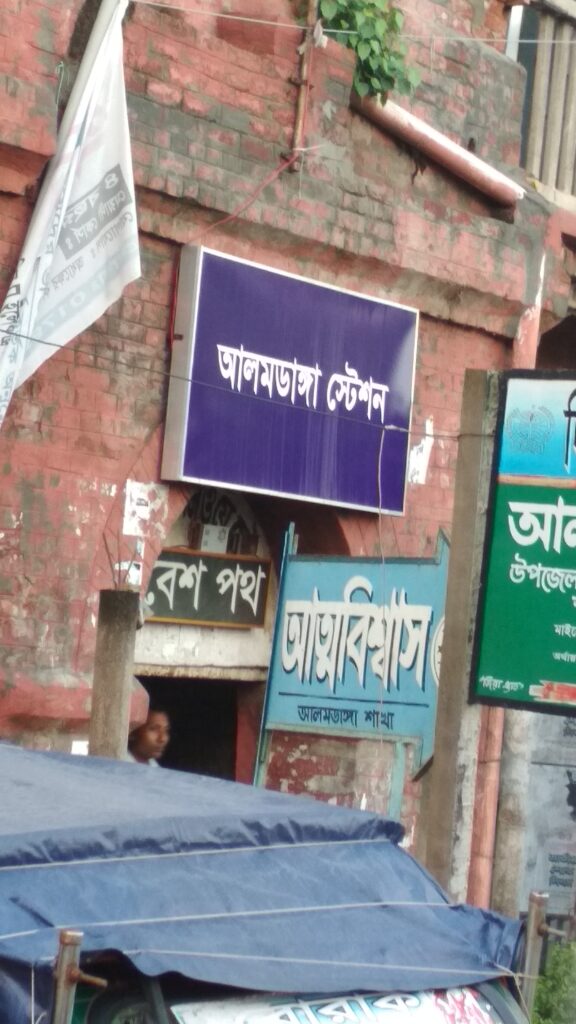
From Kushtia I would have to go to Amdanga and then take a train to Rajshahi. But before that, outside the shrine of Lalon Fakir in Kushtia, there was a man selling a balm for every kind of bodily pain. And he was most concerned for the downtrodden, the ones who worked in the field and in factories, for the krishak and sramik bhai. For the hapless proletariat, Shanti Natural Pain Out!
There was still light in the sky when we reached Amdanga. Sanjay would go in the opposite direction, back to Faridpur. My train chugged along, it went over the Paksey Bridge and then someone mentioned the nuclear power plant in Rooppur and I pricked my ears. By now it was dark and the lights of ‘development’ shone in the passing landscape.
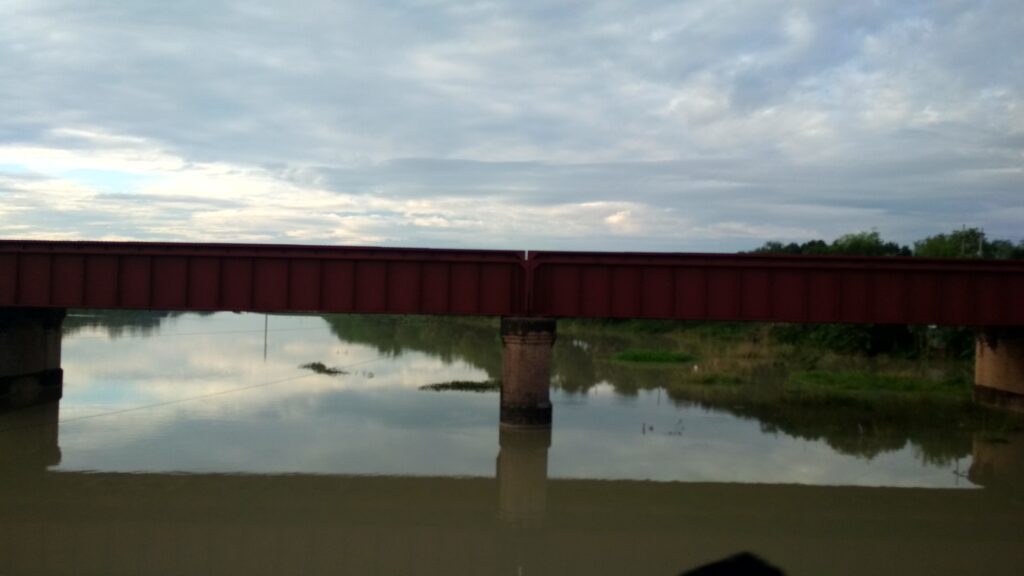
On 10 October 2019, with my usual companion on my Naogaon trips. folklorist Uday Shanker Biswas of Rajshahi University, and his friend and colleague in the Bangla department, Shoikat Arefin, who was with us last year too, we took the same rail route from Rajshahi, via Abdulpur, going along the Chalan Beel, to reach Kunuj, written as Kunij gram in Arnold Bake’s notes for the Naogaon singers. Diljan Fakir was supposed to have come from here.
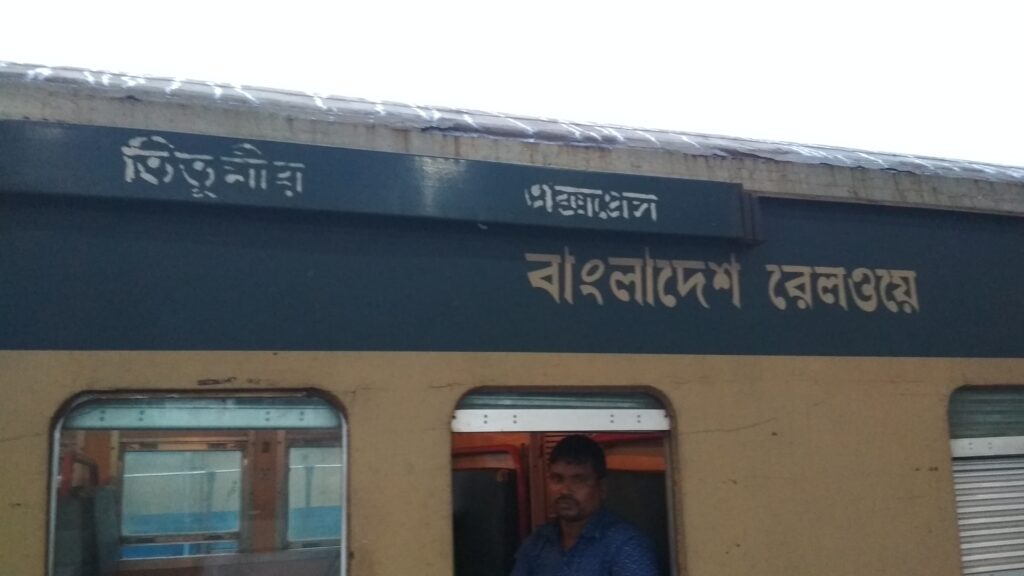
Chalan Beel 2019
On the last trip the previous year, we had gone as far as Shailagachi—Soregachi in Bake’s notes—and learned that Kunuj and Dariapur (not Darilpur, as Bake wrote) were more or less adjacent villages. This time we got off at Santahar station and took a CNG (three-wheeler) to Kunuj. Uday, who knows these parts like the palm of his hand was showing me things at the station that were also signs of a simultaneously erased, memorialised, forgotten and excavated history.
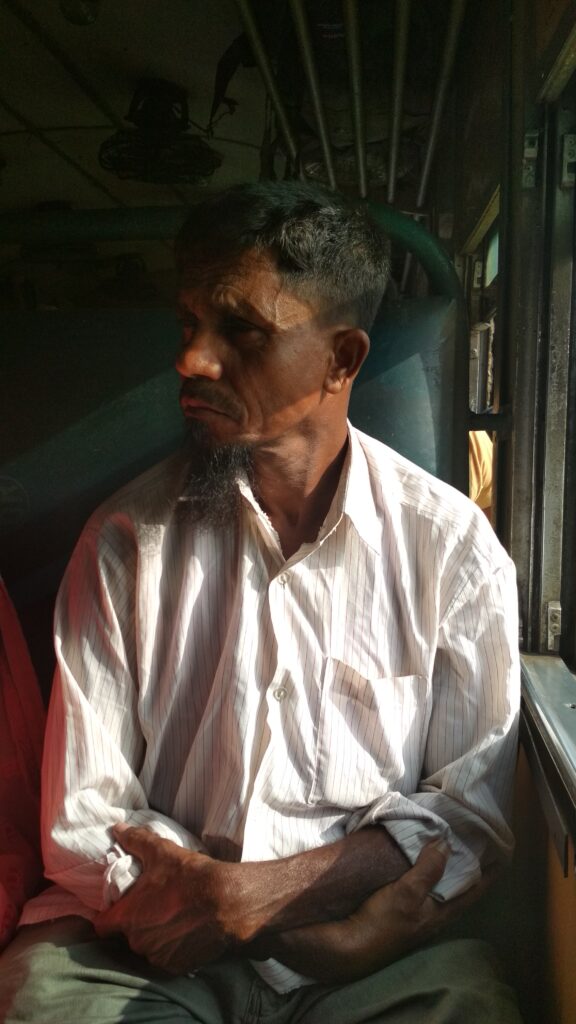
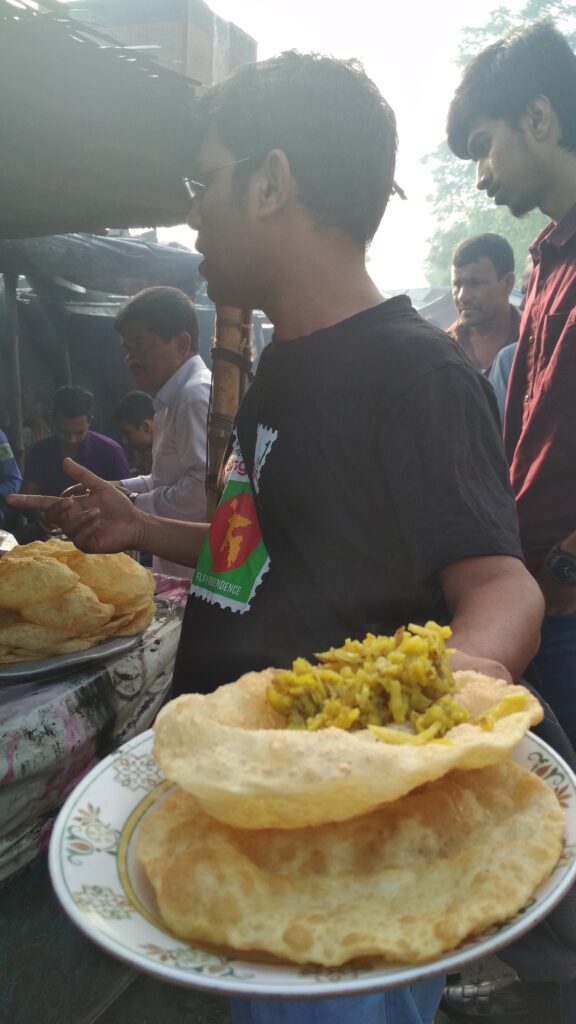
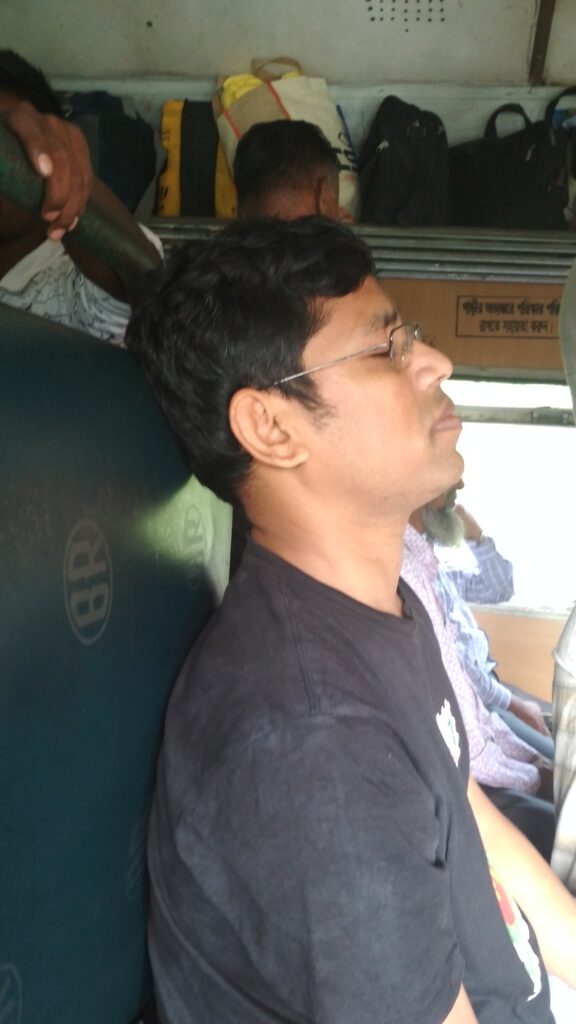
Following the same rituals like last time. Same route, same people, same food, same seeing, same listening. I think rituals (sometimes invented) and repetitions have been a trope in my work.
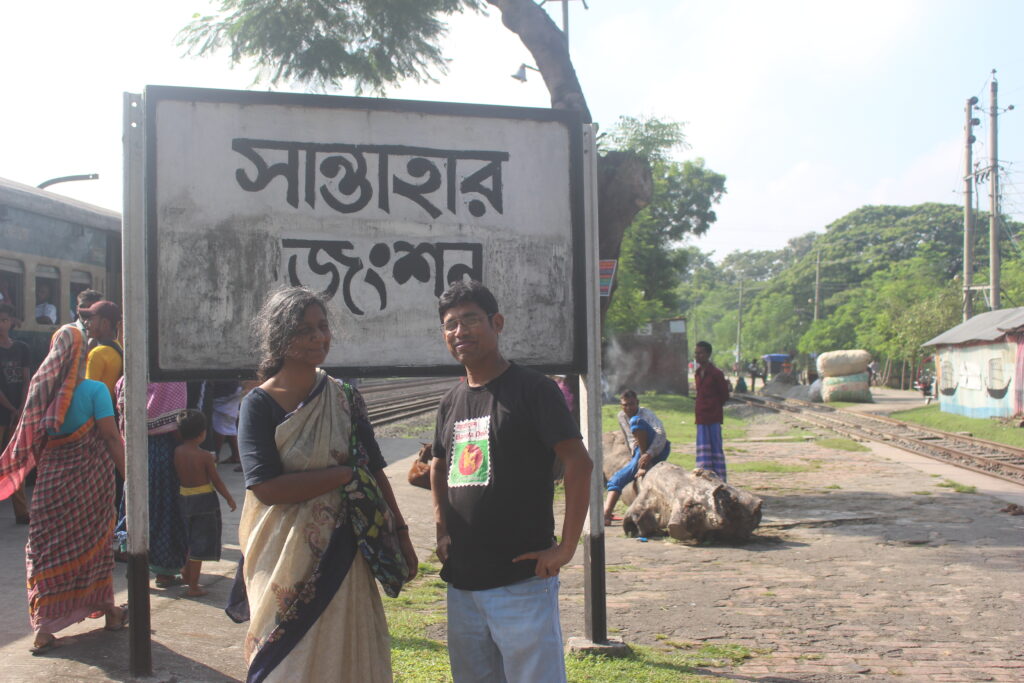
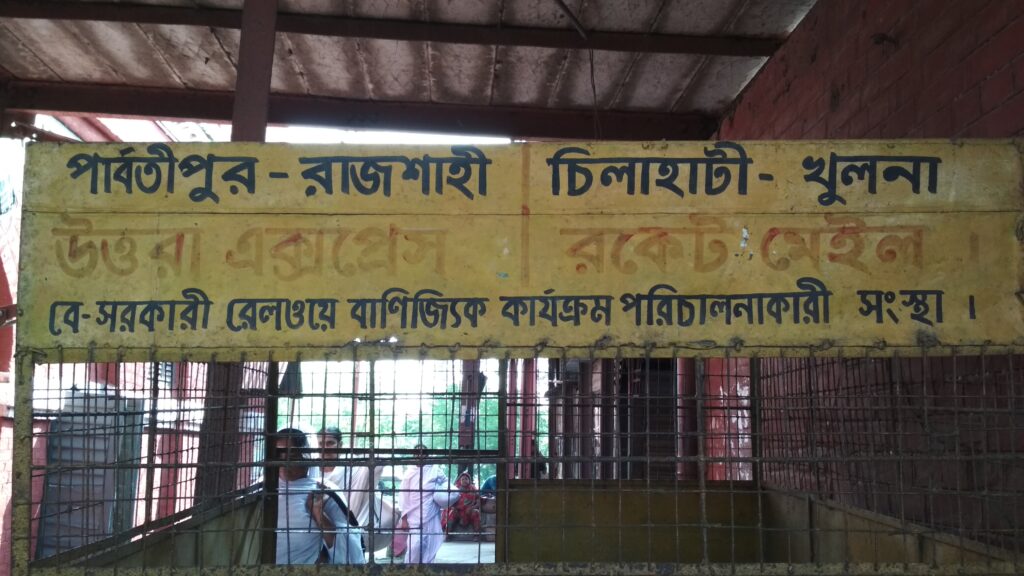
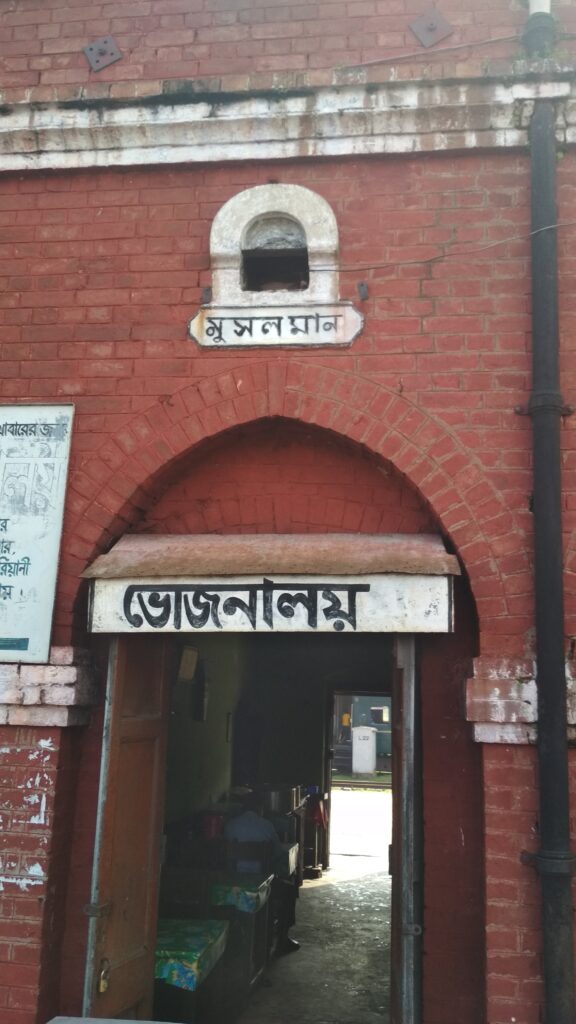
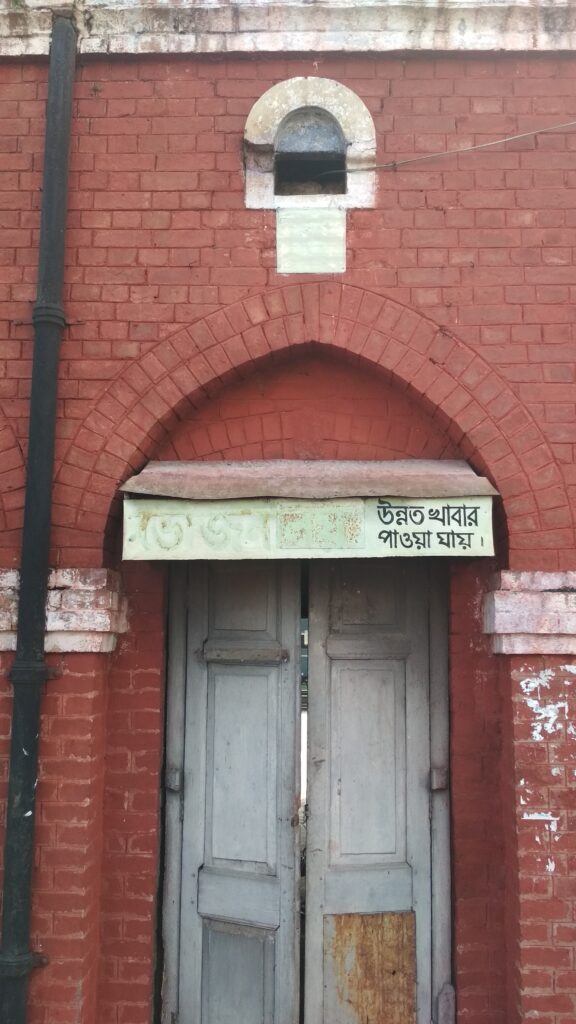
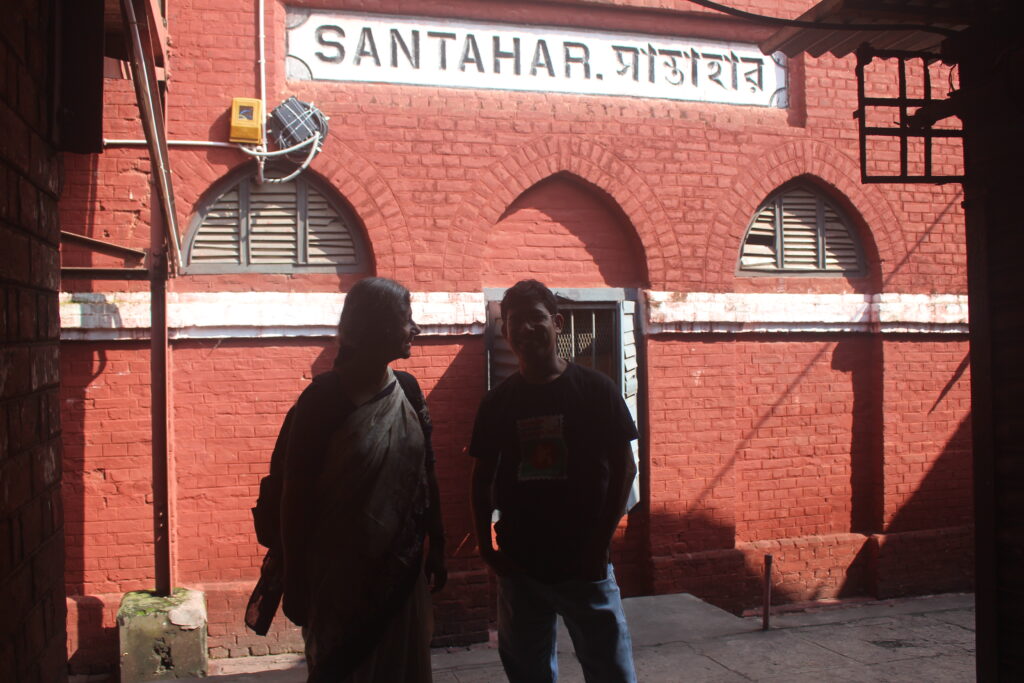
Santahar station is old and has its own history, and it wears that nineteenth century look in part. Interestingly, there used to be two separate canteens, one for Musalmans and one for Hindus. The sign Hindu Bhojanalay has been whitewashed now since the times have changed, the demography has changed, gradually since Partition in 1947.
Anyway, finally we reached Kunuj, under Raninagar police station. Raninagar is where we had gone on our very first Naogaon trip, with friend Tapas Majumdar, a banker in Rajshahi. Sukanta Majumdar was part of that journey. Then we had gone to a tea stall by the station in Raninagar, because those are places where you get to meet people. No one appeared to know then about where we could find the fakirs, or the songs. From that trip to now, we had come some way.
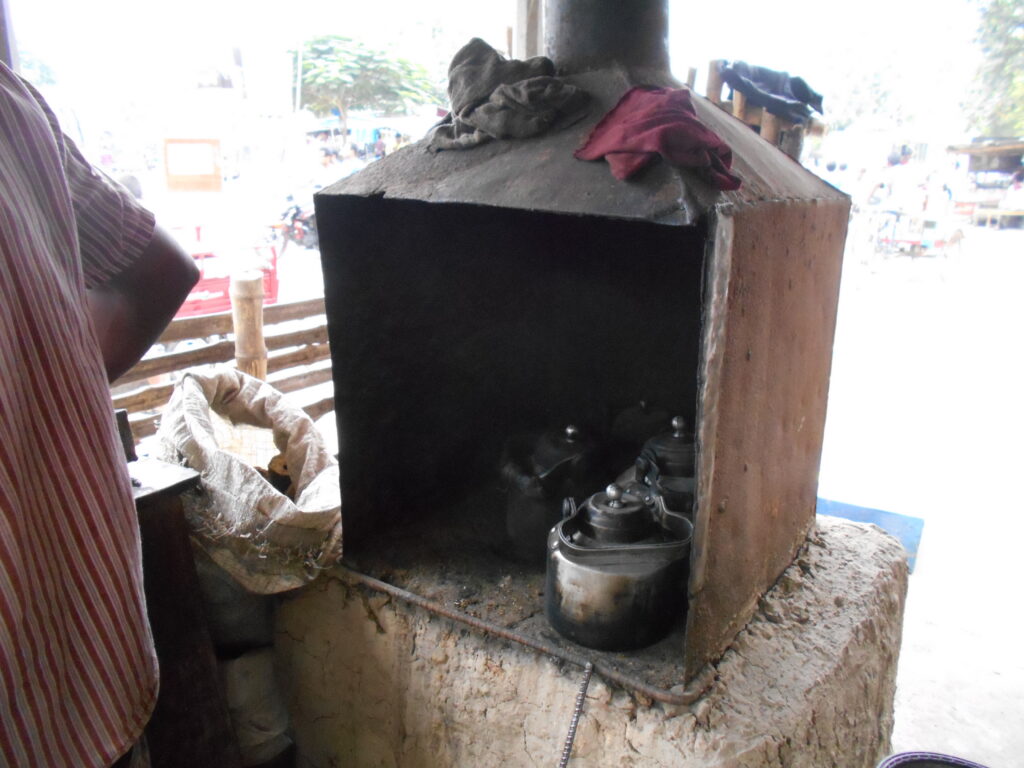
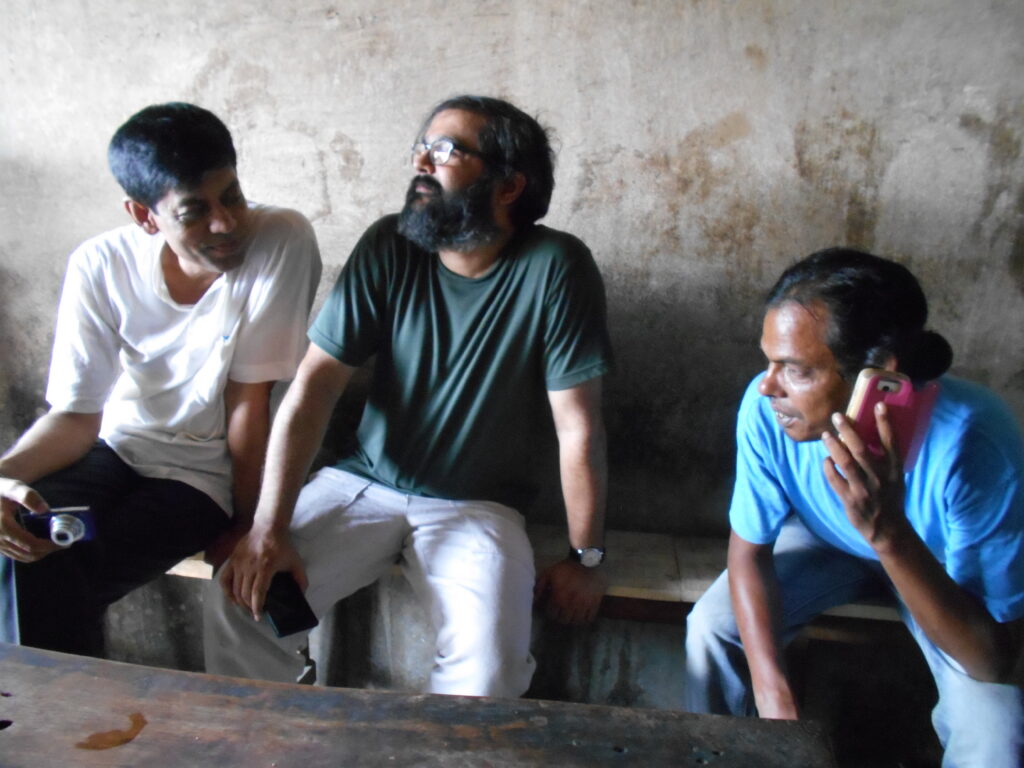
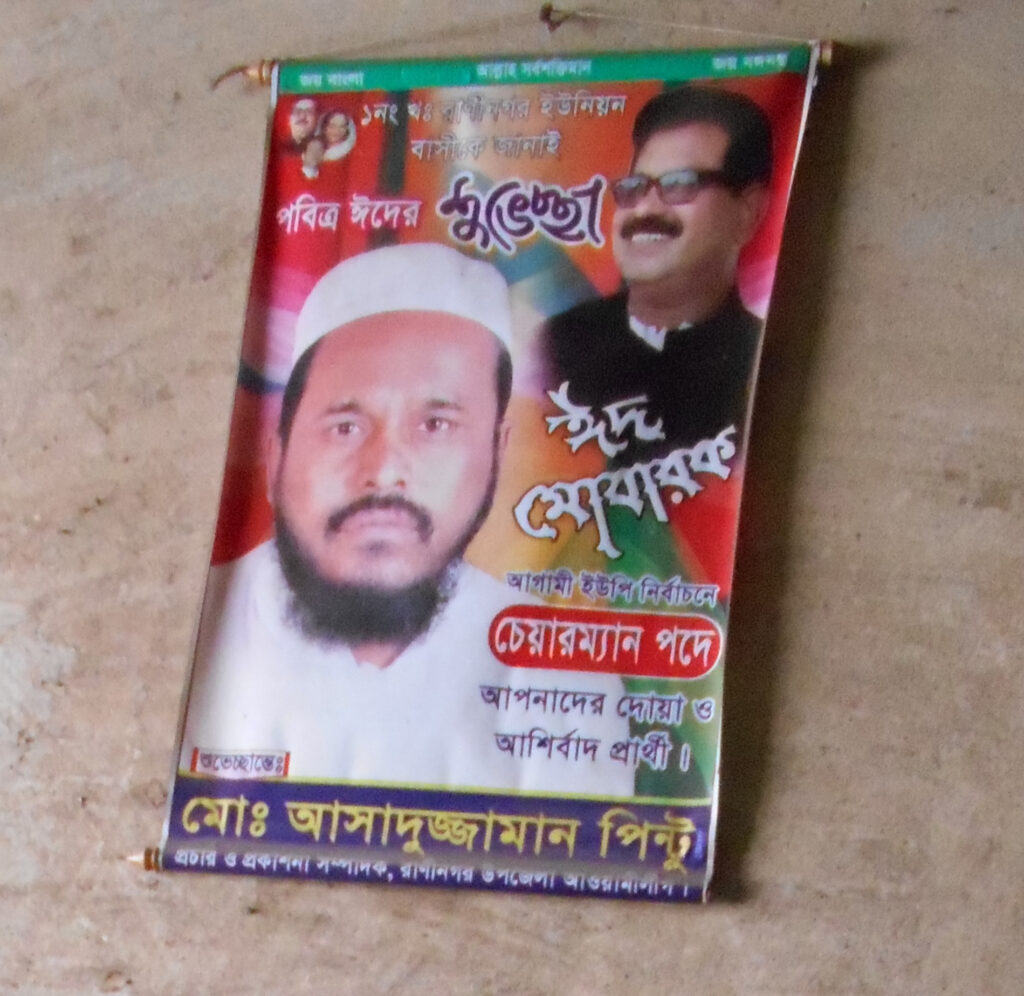
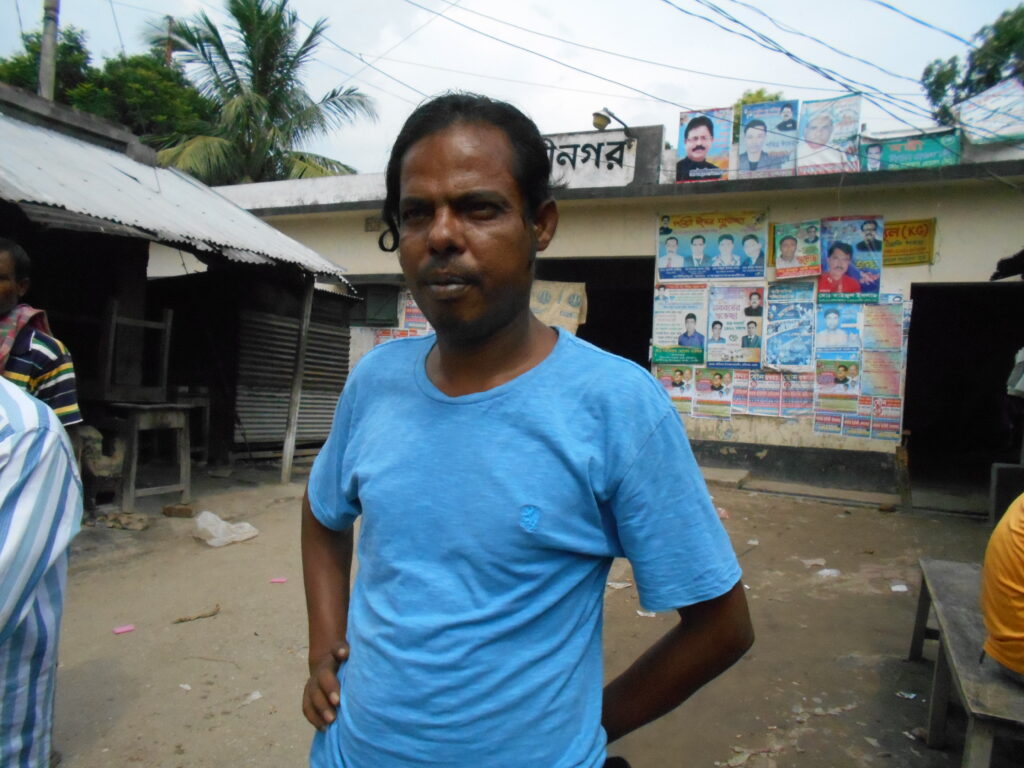
Photos: The Travelling Archive, 2015
Since the name Kunij gram was written on Bake’s notes against the name of Diljan Fakir, we specifically asked about him at the grocer’s after reaching Kunuj. Do you know of a man named Diljan Fakir who lived here a long time ago? A crowd gathered. A man by the name of Abdur sat with us in an empty shack opposite the grocer’s, listening to our story. He then said that Diljan (I am not sure if he said Diljan or Dilchan) Fakir was his father, who had died an old man in the 1990s. That kind of matched the time we were looking for. He said that there were many singers in this entire area. It was a strange moment of revelation, yet there was also a level of disinterestedness on Abdur’s part. He did not want to listen to the song of his father; he was more worried for the fish in his basket, which he would have to sell before it got late. He promised to come and meet us later, but I somehow knew he couldn’t come and I was right.
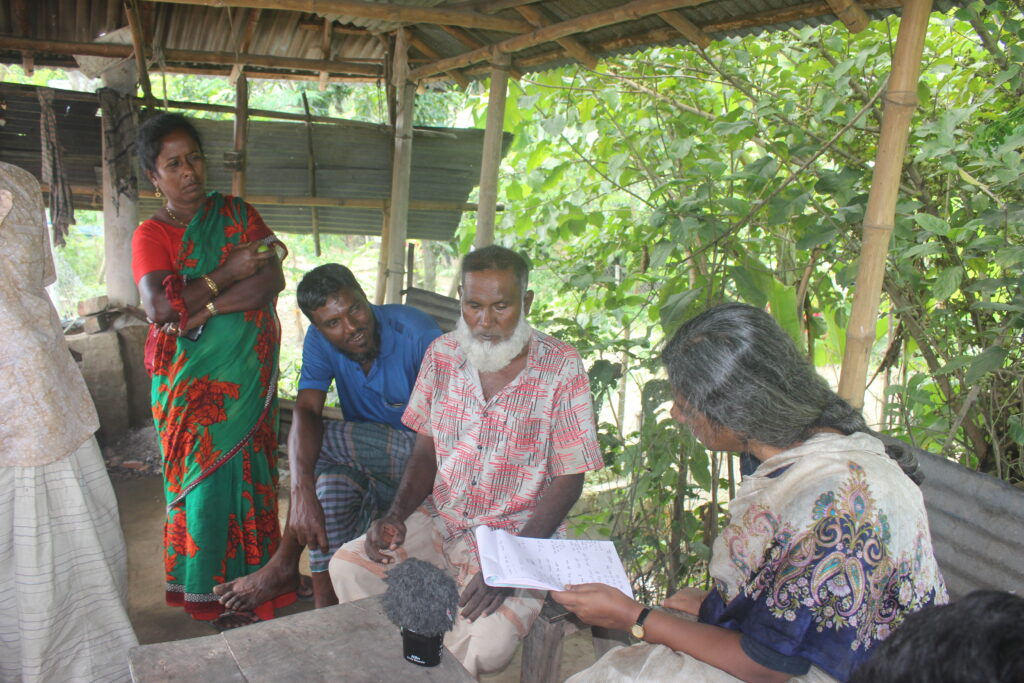
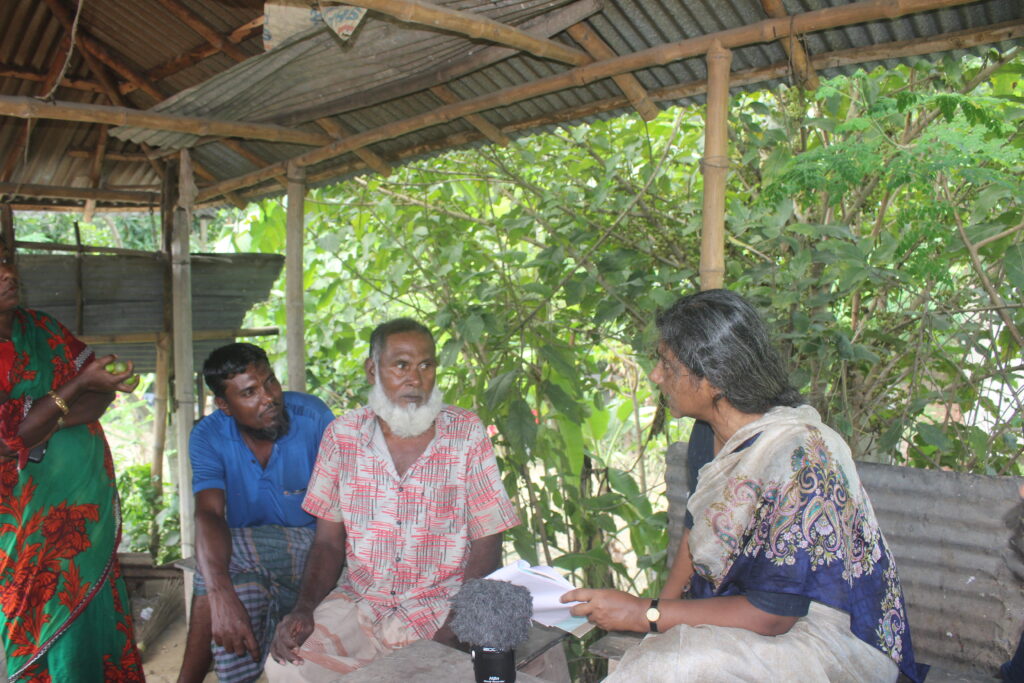
With Diljan Fakir’s son, Abdur, in Kunuj. 2019.
All these recordings and images are made with my camera and Zoom H2N recorder
Other people had gathered around us, including a very lively woman. Her name was Aklima and she was also a singer, she said. They heard the names on my Naogaon list and told us we should go to Dariapur, the next village, and meet Mukunda Fakir’s grandson, Mohammad Shamser Fakir. Mukunda Fakir was on Bake Cylinder No. 85, Diljan is 87. Suddenly things were happening so fast that it felt unreal. Meanwhile Abdur, who had identified Diljan Fakir as his father, had left and Aklima led the way to Dariapur, to Mohammad Shamser Fakir’s house. The man looked like a fakir, with his long wavy hair and a calm face. People had already gathered in his room. Uday, Shaikot, and I took turns to tell them the story of Bake’s Naogaon recordings. This is a village of singers, Shamser Fakir said. It’s traditionally been this way. He recognised almost all the names on Bake’s list. Not the ganja workmen; they might have been just labourers who worked in the ganja plantation, not fakirs. As a boy Shamser Fakir used to hang around with Basiruddin Fakir, of Cylinder No. 86. Nasiruddin was his brother — the name won’t be Masiruddin, he corrected me. Nasir, Basir, Tasir — they were brothers. Then Diljan (chand?), Tiljan …
Now everything was becoming absolutely clear to me. When Bake had asked where they were from, they must have said something like, ‘Kunuj, Shailagachi, Dariapur—but it’s all the same. We are all from the same place.’ The description for Masiruddin Fakir on the Berlin archive’s Naogaon list was ‘Sänger einer religiösen Bruderschaft,’ singer of a religious brotherhood. This then was that brotherhood — they were all part of it! ‘Fakirer daria’, Shamser Fakir said. ‘We have many fakirs here, almost like a daria, a flowing river; which is why the place is called Dariapur’.
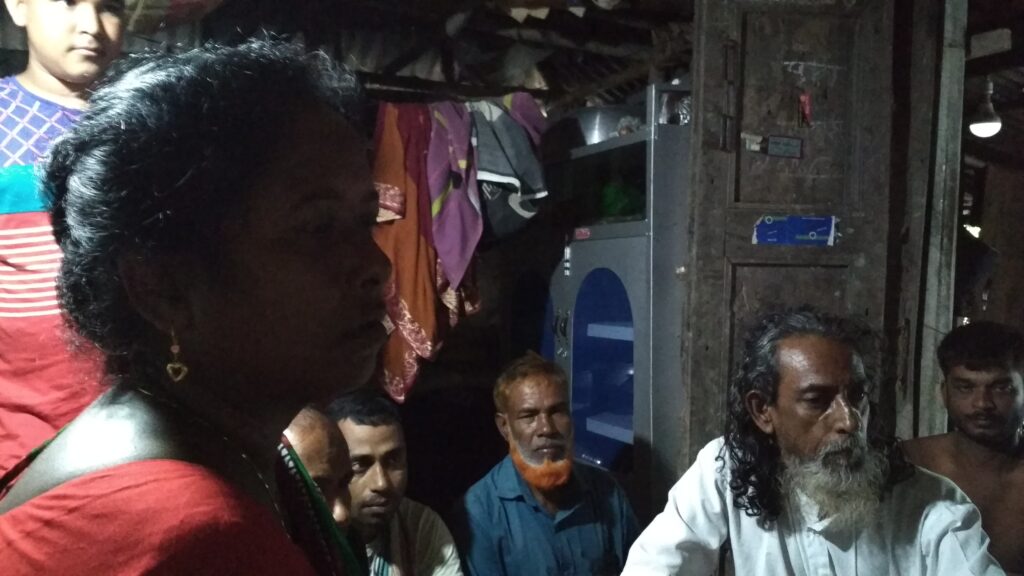
I took out my laptop; I had my portable speaker with me this time, so that I could amplify the sound . I played the recording on the first cylinder. This was the song, ‘Amar kotha moner jaoa hoi.’ The cylinder started to roll, the gyrating noise began. The first two words were gobbled up by that sound of the machine. The song started from the third word, ‘mone’. Shamser Fakir said: Diner katha mone jar hoy — that was the song. Mansooruddin’s text for Song no. 223 on page 142 of the second volume of Haramoni was exactly as Shamser Fakir had said. Others in the room also agreed. They heard in audible words in the recording because they already knew the song.
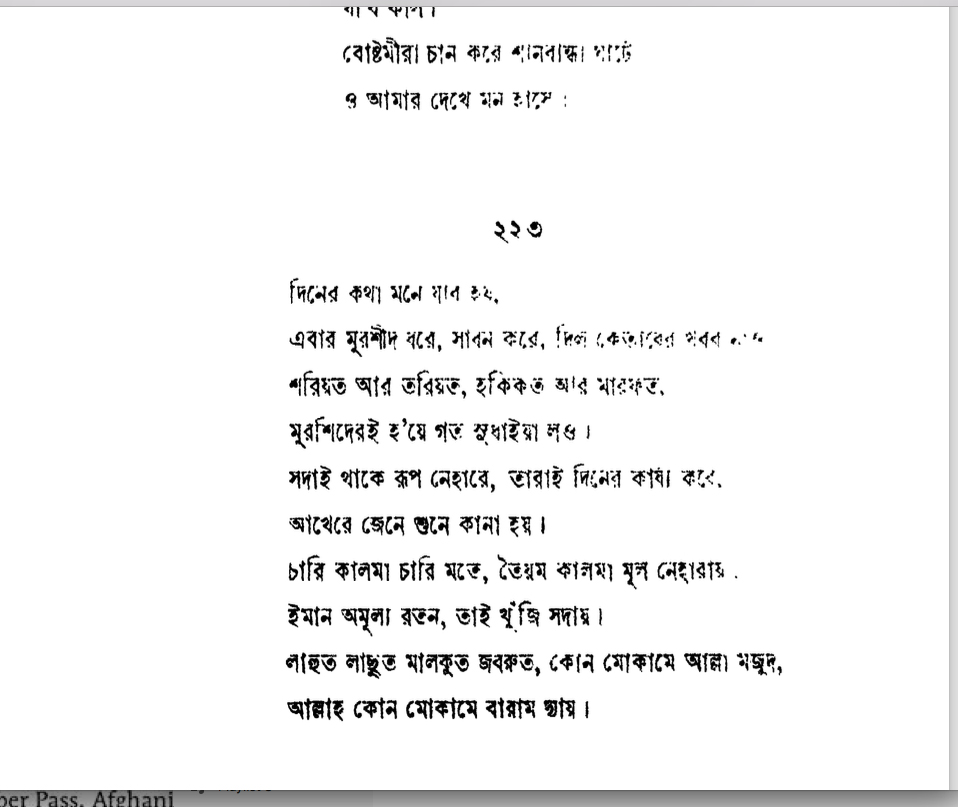
‘Diner katha mone jar hoy’. Page from Mansooruddin’s Haramoni Vol. 2, published in 1942.
I played more songs. Then they sang and I made a recording. Shamser Fakir’s dada or paternal grandfather Mukunda Fakir had sung ‘Tin baerar ek bagan achhe’ for Arnold Bake. Shamser Fakir and his friends sang it again for us. Then they sang more songs, ‘Diner katha’ too. And Aklima sang a song of Lalon Fakir. She was much travelled—hard worked in Lybia, Jordan, Qatar and then she also went to Saudia Arabia for Haj. ‘Now that you have gone on haj, you cannot sing anymore, I imagine,’ Uday asked. ‘Our system is different. Our faith is different. We can always sing,’ she said. We also talked about the time of ganja (cannabis) cultivation in this Naogaon region, when Bake had come, and when there used to be the gatherings of the fakirs at the plantations.
Shamser fakir sings ‘Tin berar ek bagan’ and ‘Diner katha’ playing his harmonium. There is a joyous participation of everyone gathered. They clap, play the mandira (small cymbals) and one plays on the plastic badna (pot for ablutions) as his hand drum. I remember Ahmed Moyez in London, who had used the popcorn tumbler for his dubki. That was way back in 2007.
They listen to the songs of Jaura Khatan Khaepi. I play them, one by one. They have no idea who she was. But I play the song ‘Namaz porite jai cholore’ and ask for a clarification. This is a question that had been on my mind for years. ‘How come she is singing about the importance of namaz? Does that not contradict the fakiri belief that namaz, roza, haj, jakat are mere rituals and what matters more is one’s intrinsic devotion and an inner piety?’ ‘She is not talking about the masjid outside,’ they explain to me, ‘but the masjid within. The “del masjid”, the shrine in the heart.’
‘I have some photos with me which I can show you, I said. Maybe you will recognise your grandfather?
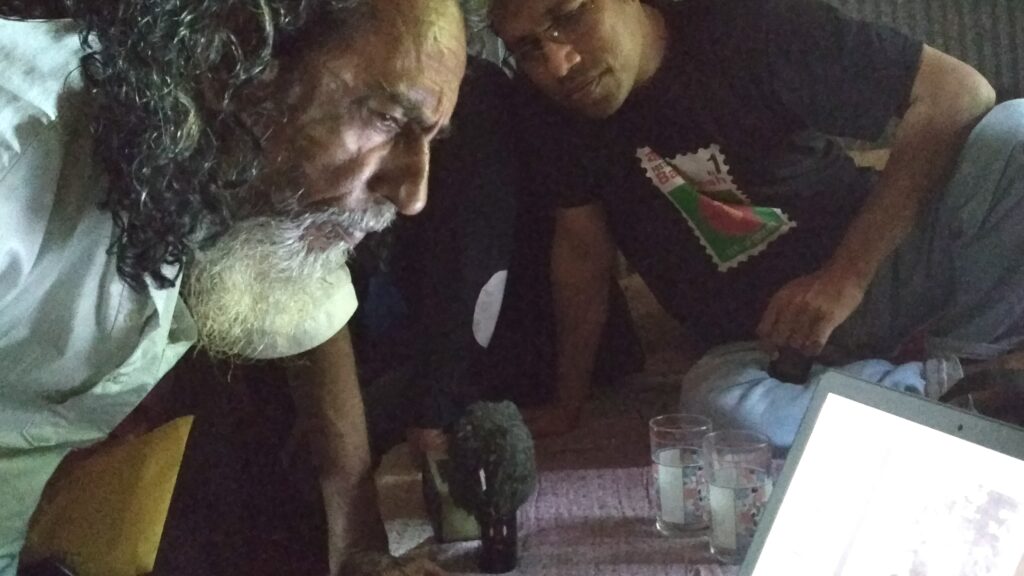
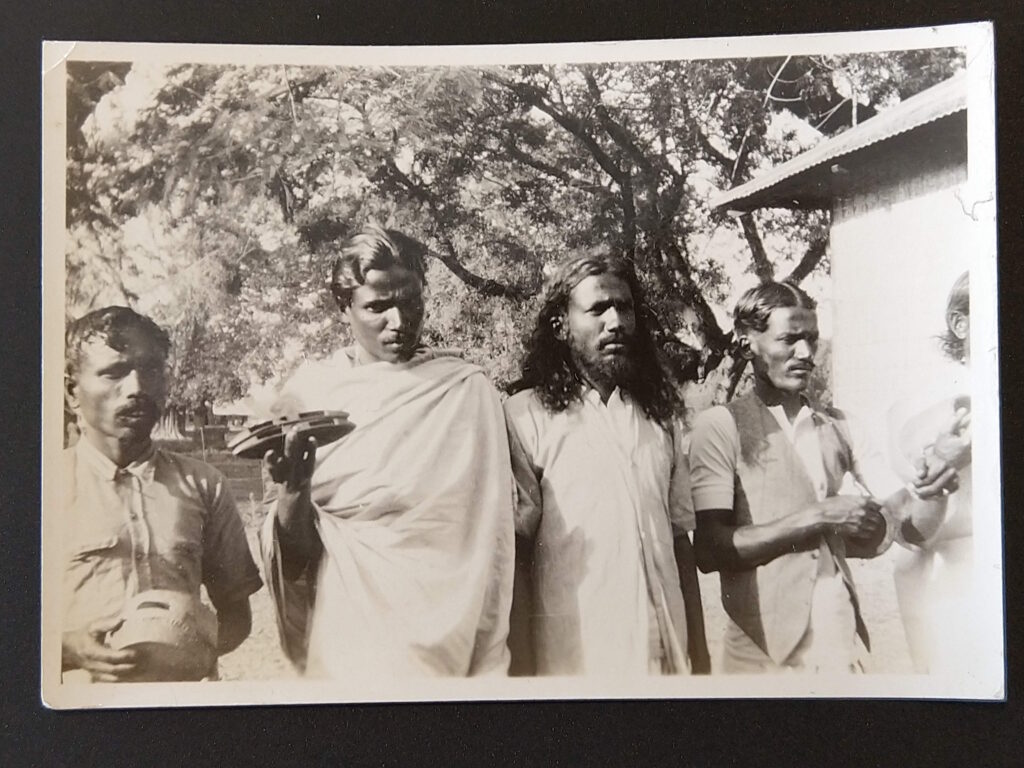
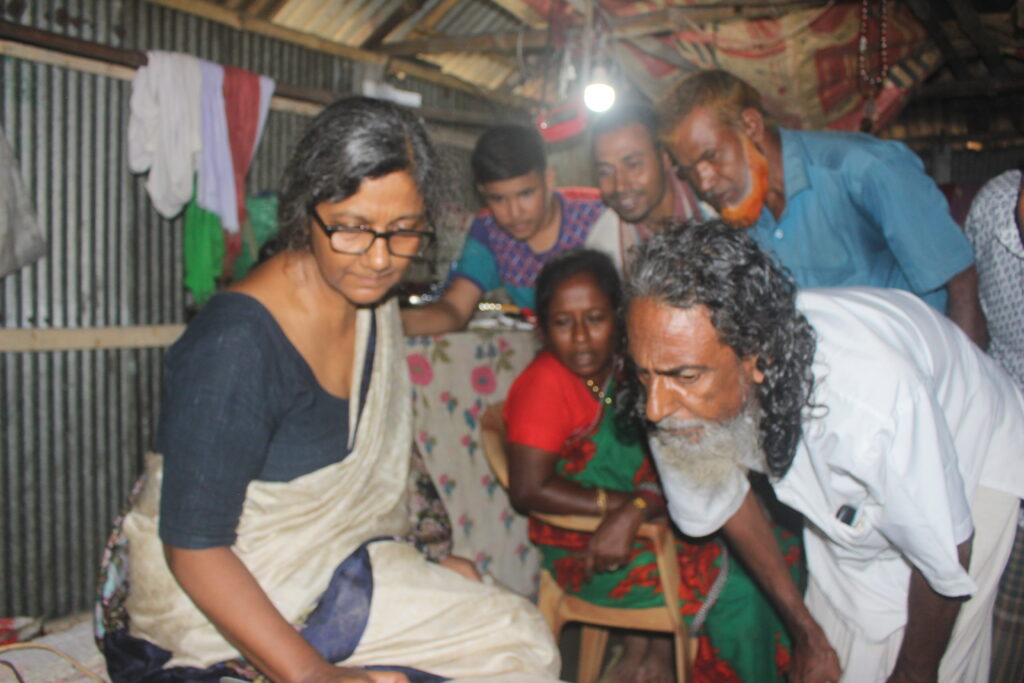
The ancestors in the black and white image in the centre is a photo of a photo from the Special Collections of Leiden University Library that I took in 2015. Above and below are two photos from this trip, The Dariapur fakirs are looking at/for their ancestors in the photographs.
I start showing the photos. They bend over my laptop. Shamser Fakir looks at Naogaon 9 and points to one of the four men standing with instruments. ‘This is Basir Fakir. I know him; spent so much time with him.’ I pause over Naogaon 7. Shamser Fakir moves even closer to the screen. ‘Ah, this must have been my grandfather!’ he said. I would think so too.
In 2019, I mostly concluded this series of trips in search of the fakirs whom Arnold Bake had recorded in Naogaon in 1932. Except that such journeys never really end. Abdur, Diljan Fakir’s son—did he get to sell his fish that day? What about the shrine of Basiruddin? Shall we go there at the time of their urs? What about our plans to meet again for an evening of music? Finally, who then was Jaura Khatan Khaepi? Kabari no longer lives in Shailagachi, where has she gone?
On our way back, we went to nearest point on the Chalan Beel from Dariapur, from where we got a boat to Bandaikhara and then walked over the bridge on the Atrai river and reached the bus stand to go back to Rajshahi.
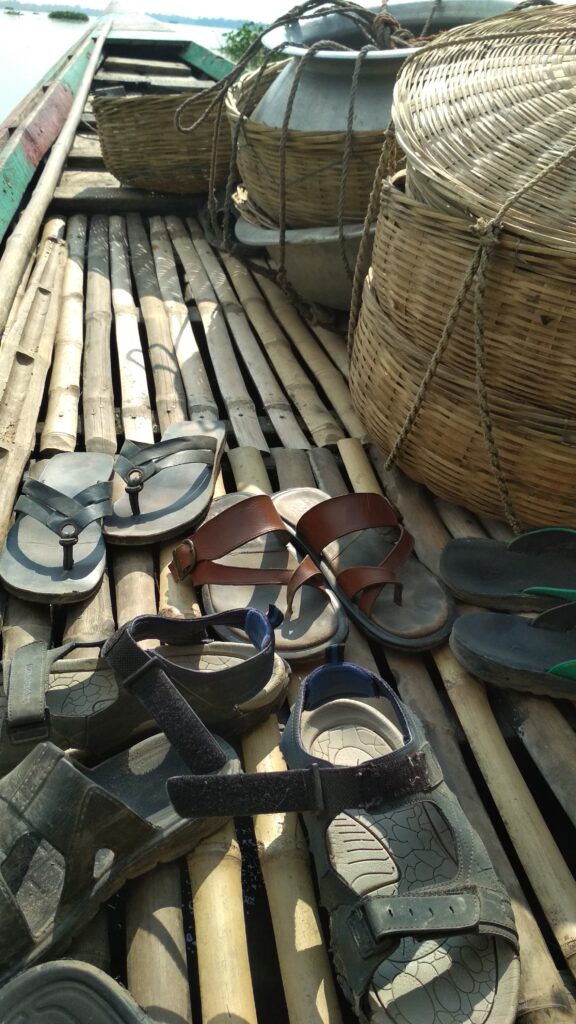
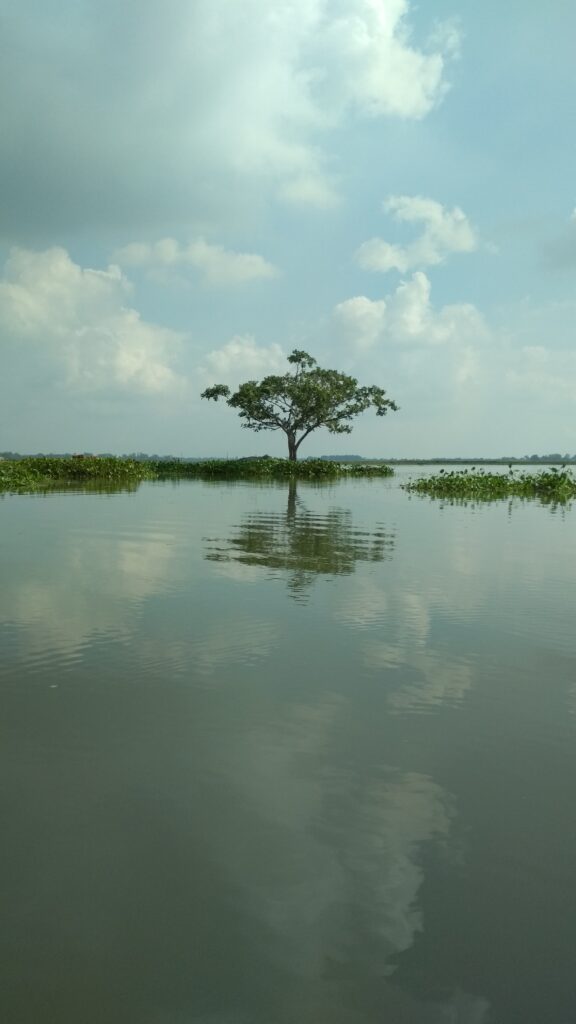
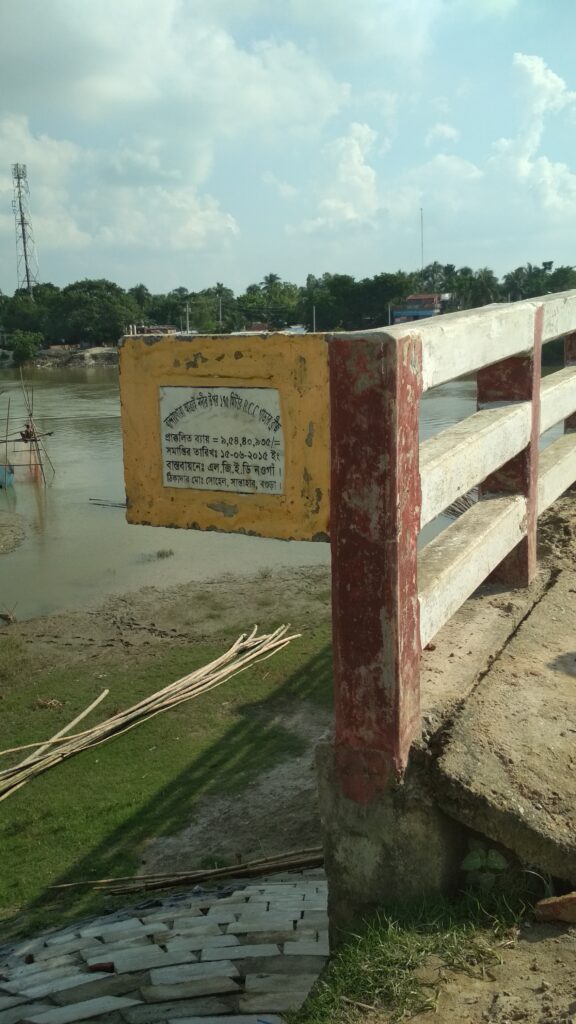
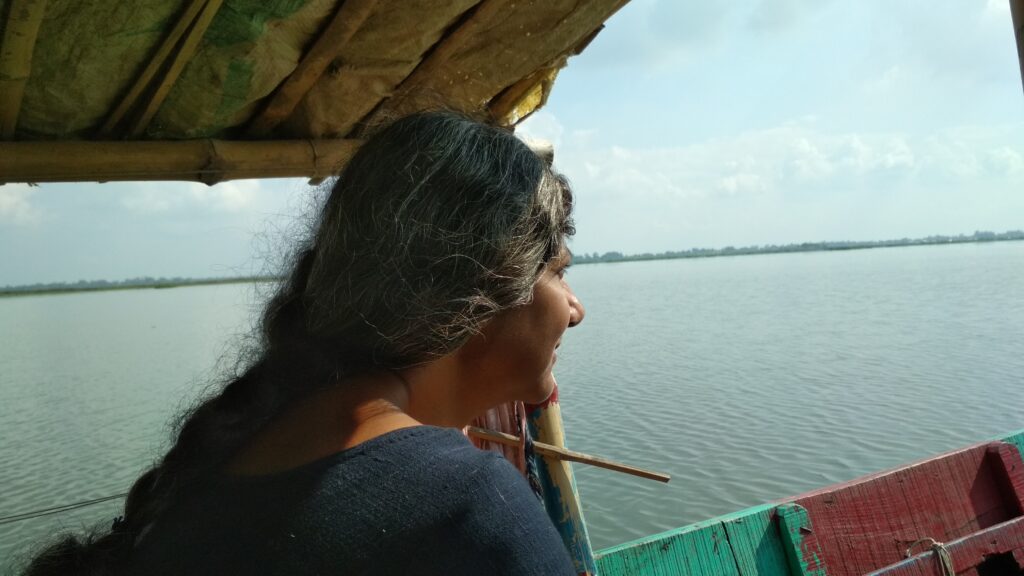
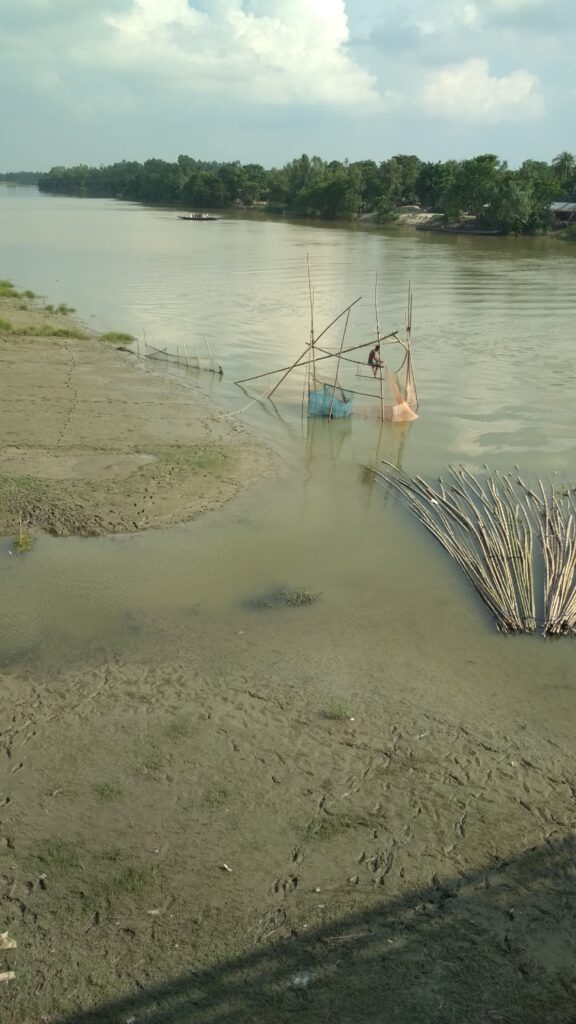
Ali Ahsan is a sound recordist from Kushtia in the west of Bangladesh, its border touching Nadia in West Bengal. That is a land fertile with song, where people talk in riddles. Both his maternal and paternal grandfathers—his nana and his dada—used to read and sing the puthi. His ears are hence more ready than mine to catch and write down the words of Keramat Ali’s melodic reading, as it was recorded by Wilhelm Doegen in the Prisoner of War camp in Wunsdorf, Germany, in 1918. The following is from my recorded conversation with him over the phone on 4 June 2019. I was at home in Kolkata and Ali was talking from Dhaka. The conversation happened in Bangla and the translation is mine.
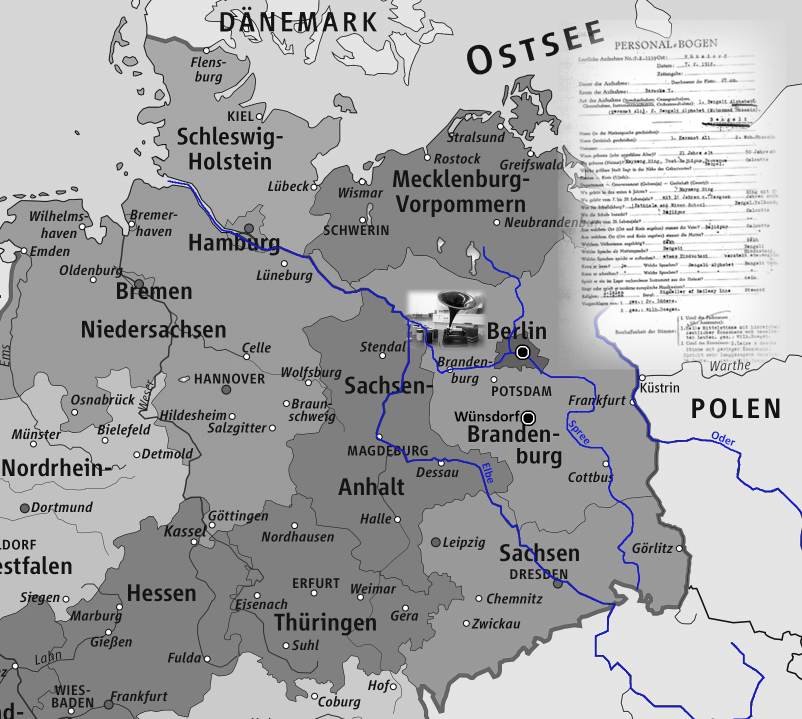
Map of where the recording happened and where the archives are. Designed by Purba Rudra
Ali Ahsan’s telephonic conversation with me
‘I used to listen to my nana read the puthi. They have many Arabic and Farsi words. For the sake of the poetry. That is its problem, but that makes it unique too. Their speech is melodic’.
‘Is this an Islamic mythological story’?
‘It is a story about Medina. There are many stories about Medina. Shoitan or the Devil sees this woman who is pure, pious and beautiful, beloved of Allah (Allaro-piyara). He is attracted to her. But he fails to seduce her. Then one night he sends a dream to her husband. The husband sees that there is a lot of commotion outside, he takes it for real and so he gets up and goes to check. But he finds nothing. Then he comes back inside and finds his double, talking with his wife. The one who went out and the one in the room talk in the same way. The woman becomes very confused. She says, both of you will remain locked in this room tonight, tomorrow we will go to Ali and ask for justice. [It is impossible to translate or write down all the knowledge held in the sound. Ali Ahsan had said, ‘Tokhon ekdin raate taar husband shopno dekhe. . . tarpor shey confused hoye jaay’, using the English words husband and confused and they fit in so naturally with the Bangla. ‘Shey bole, tomra dujonei ei gharer modhye atka thakba’, Ali continues, and his way of speaking is marked by his place—a little bit Dhaka, a little bit Kushtia. There is a certain intimacy in this telling, which makes the characters into everyday people; this is no longer just a story about some distant holy land where Hazrat Ali, son-in-law of Hazrat Muhammad, blessed with divine powers, provides justice to people and shows them the way]
‘Ali, the Khalifa of Medina, finds a solution [ekta solution koren], because he is wise. Hazrat Muhammad has said that, if I am the Ocean of Knowledge (gyaner shagor), then Ali is its Doorway (shadar darja). There will be a verse of praise [bandana gaan] at the start of a puthi, it isn’t here in this recording’.
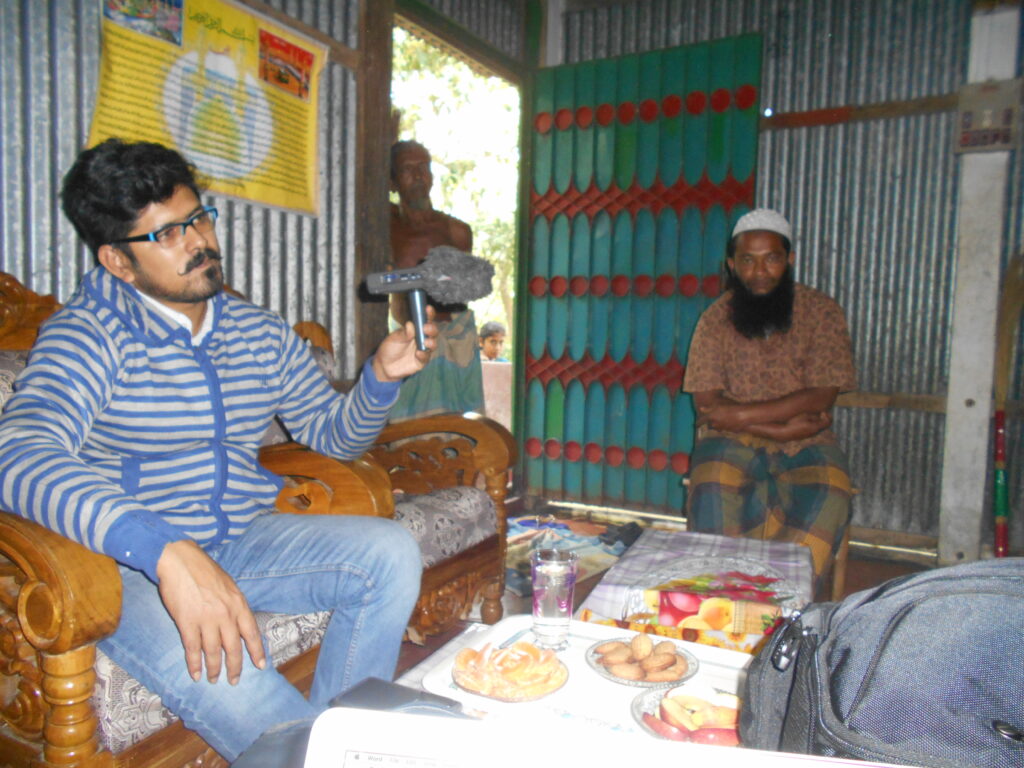
Ali Ahsan and I had gone to Noakhali. This photo is from Batoiya in Noakhali, taken on 25 November 2016.
There is no way of knowing what solution Hazrat Ali came up with because the second part of Keramat Ali’s song abruptly stops while the trial is on. This song does not begin where it starts in the recording, nor end where it stops. To know the story, we will need to find the puthi and our collective search has not yielded any conclusive result so far.
Ali Ahsan and I had talked about the question of literacy. ‘Nana used to say that there were two forms of song which the men sang without any instrumental accompaniment. One was shastor which was the telling of old (pouranic) tales and stories about kings and queens. The other was puthi. One night they would start telling a shastor and it would go on up to seven nights. They would sing and with one hand beat the rhythm. There was a special melody for these. And the women sang the geet at weddings and khatna [circumcision]’.
‘You think Keramat Ali actually knew the art of puthi-path’?
‘He surely did. He had a kind of puthi-pora gola [voice for melodic reading]. It is not possible to read the puthi in this way if you don’t have practice. It takes time for the melody to carve out a seat in the voice (shurta golay boshte shomoy laage)’.
‘Could they read and write, did the puthi singers have okkhor gyan (basic reading writing skill)’?
‘They needed to have okkhor gyan. These were long texts of several hundred pages’.
Be it as it may, Ali, an old friend, shared with me some music of Mymensingh, Kishoreganj, Netrokona, broadly the place of Keramat Ali. The singer is Himangshu Bhowmik, whom Ali recorded in Nehal Park in Kishoreganj town in August 2015. He cannot remember the date. Such and other voices Keramat Ali would be listening to in his time.
And then there was this song by one Zaker Mahmud, Beautiful!
And this great session with Abu Hanif Pir and others.
The two years between the last trip and this one was spent trying to find out more about the singers and the songs from Naogaon. And, I was looking for them in Mansooruddin’s books and in the archives, in old photographs and by studying the archival notes over again. It is then I came across the name of a place in Naogaon which might have been where at least one of the singers came from. The name was next to the name of Dijan Fakir. Rather, there seemed to be several names of seemingly one place. Or, possibilities of names. At least there was something to go looking for. The overriding question for me continued to be, who was Jaura Khatun Khaepi? Who was the woman who had sung for Bake?
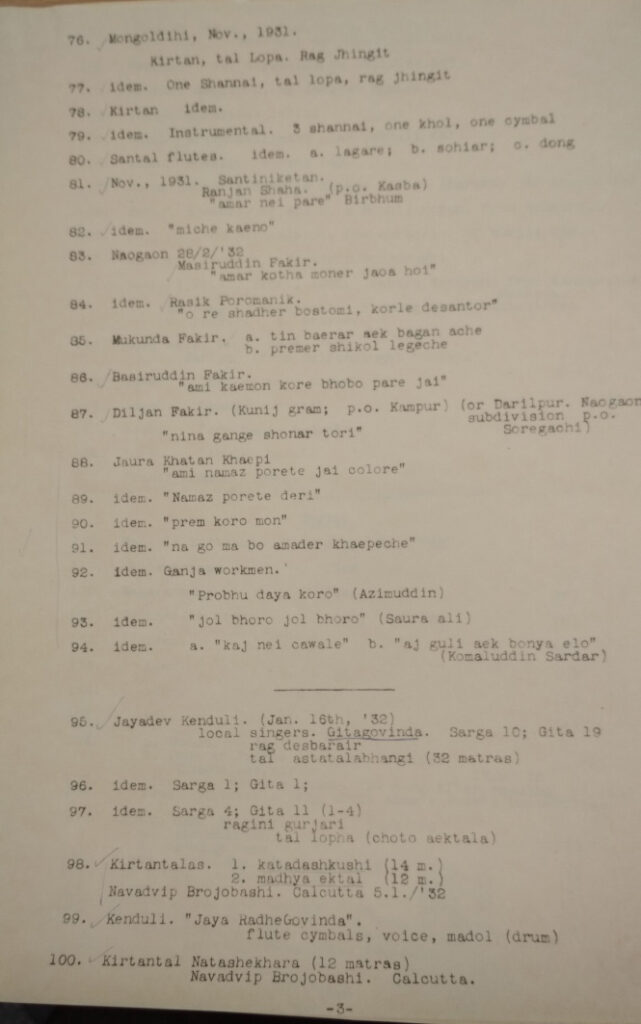
A page from the same archival note found with the British Library, Berlin Phonogramm-Archiv and the Archives and Research Center for Ethnomusicology, Gurgaon. See note for Bake India II, cylinder no. 87, against the name of Diljan Fakir.
In November 2018, I was in Rajshahi again. As I was saying, I had finally noticed the names of Kujij gram; P.O. Kampur. (or Darilpur, Naogaon subdivision, p.o. Shoregachi) against the name of one of the singers, Diljan Fakir, who had sung the song ‘nina gange sonar tori’. So I asked Uday Sanker Biswas, my folklorist friend from Rajshahi University, if he had any idea about these places. Uday said, the names were probably not correct, but they suggested other names to him, and one place was close to his in-laws’ house, and we could go looking there. Shoregachi was likely Shailagachi, he said. Darilpur could be Dariapur, he thought.
On 25 November 2018, I went by train to Rajshahi from Dhaka, my recorder receiving what sounds it found on the way.
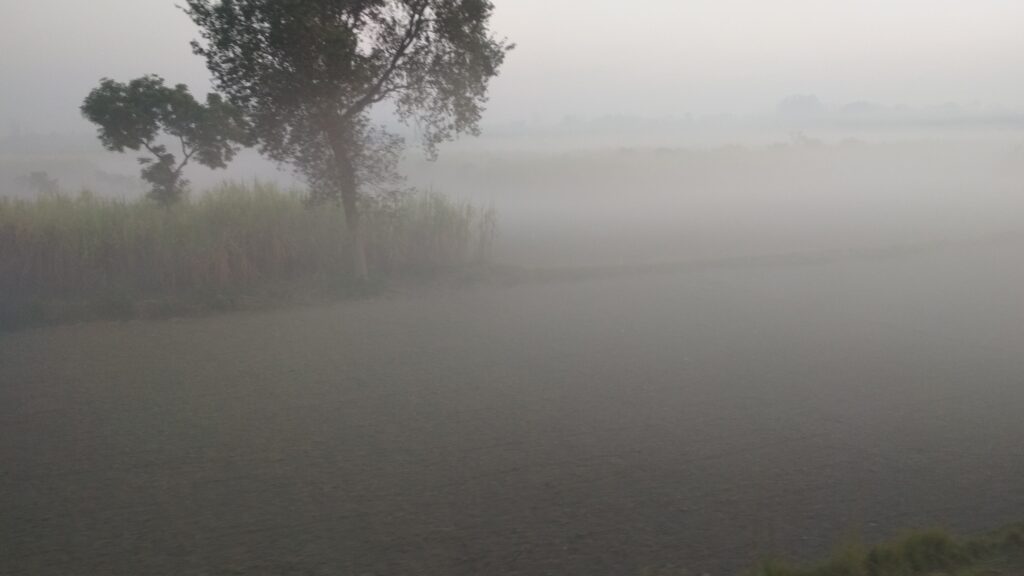
On the 26 November 2018, Uday Shanker Biswas, Shaikot Arefin—both teachers of Rajshahi University—and I went to look for Diljan Fakir in Shalagachi. Uday charted out the route, so from Rajshahi we would take the train to Ishwardi and then go to a Dariapur and from there wherever the road took us. The train went through the fog, towards Abdulpur, halted and we got off and ate luchi and alur tarkari while the engine moved to its tail. Then we got on again and the train started to go towards Ishwardi.
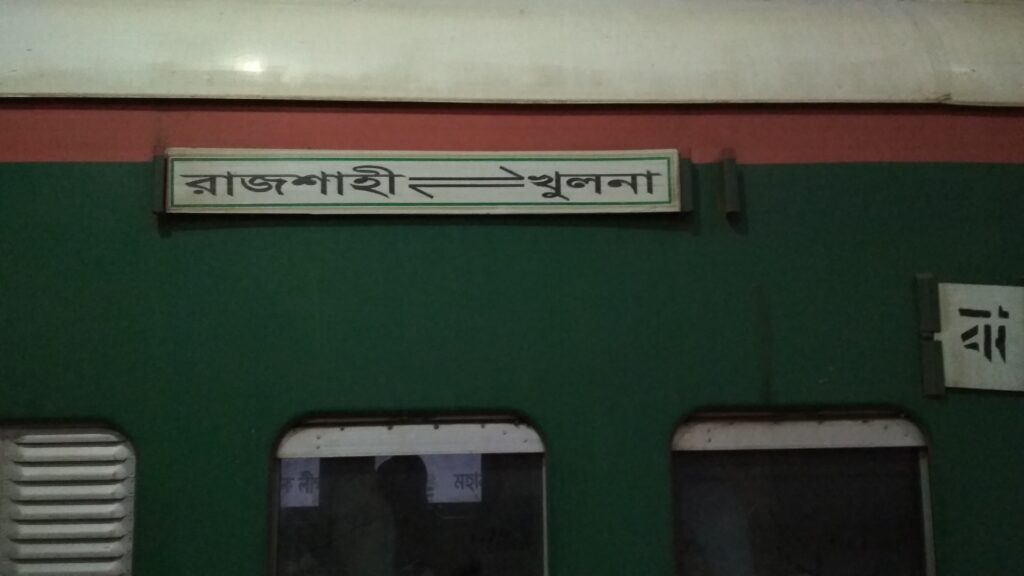
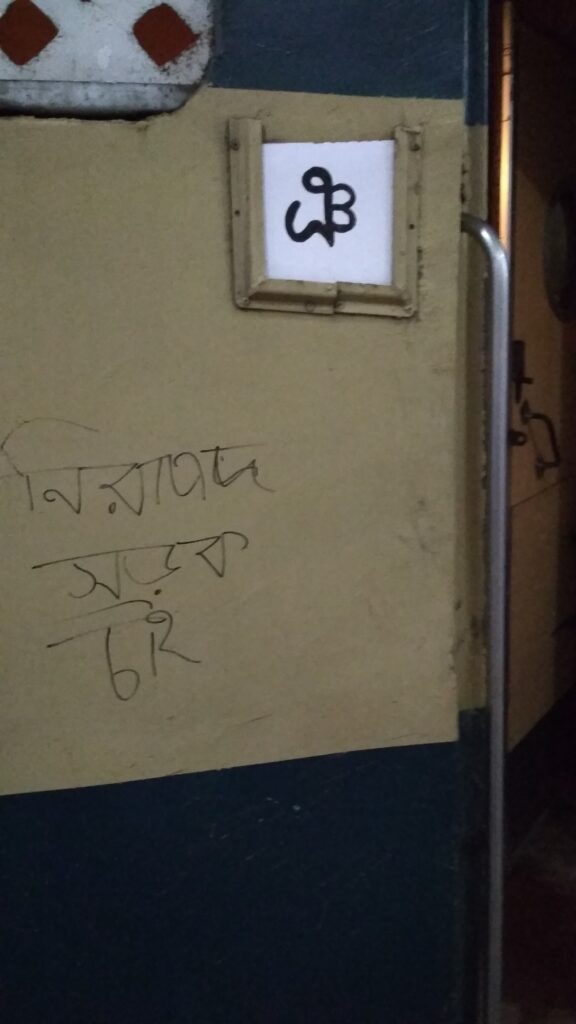
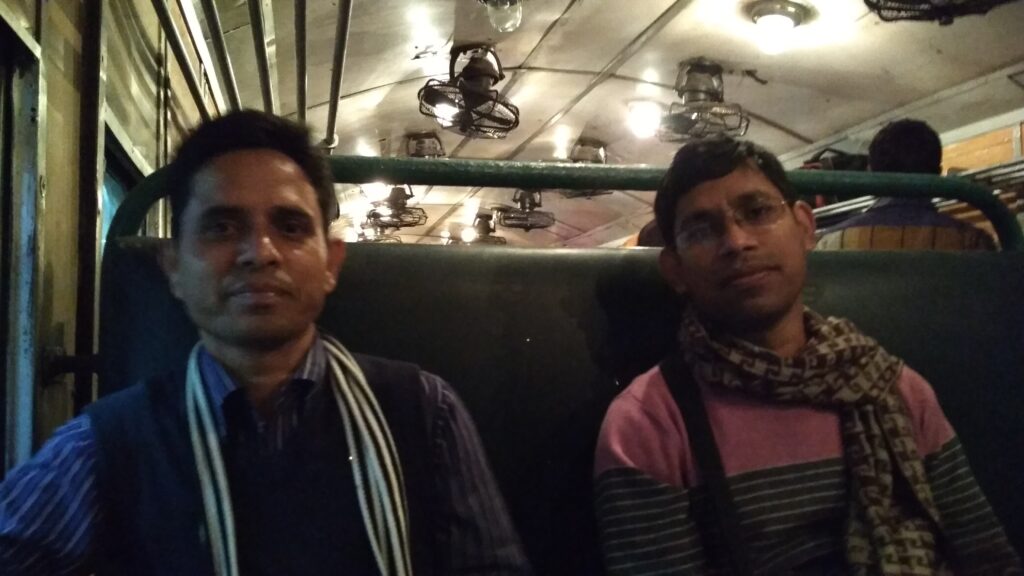
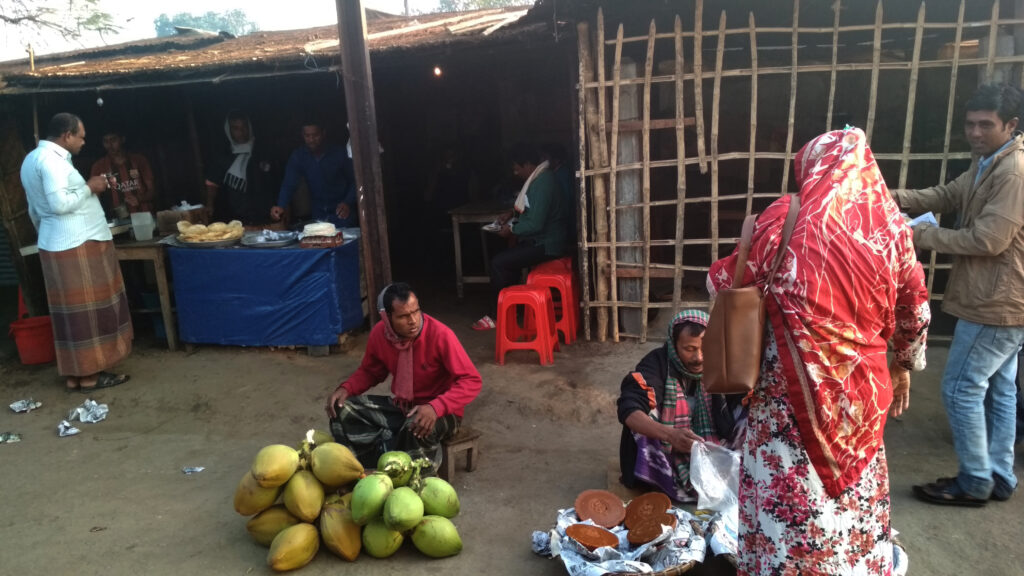
I was sitting by the window looking out, as the train started to move. At one point I turned my face and was taken aback by what I saw. I was carrying Arnold Bake’s images from Naogaon with me, not only on my computer but also in the recesses of my memory as I had seen them so many times. Suddenly it seemed to me that his photos had turned from black and white to colour.
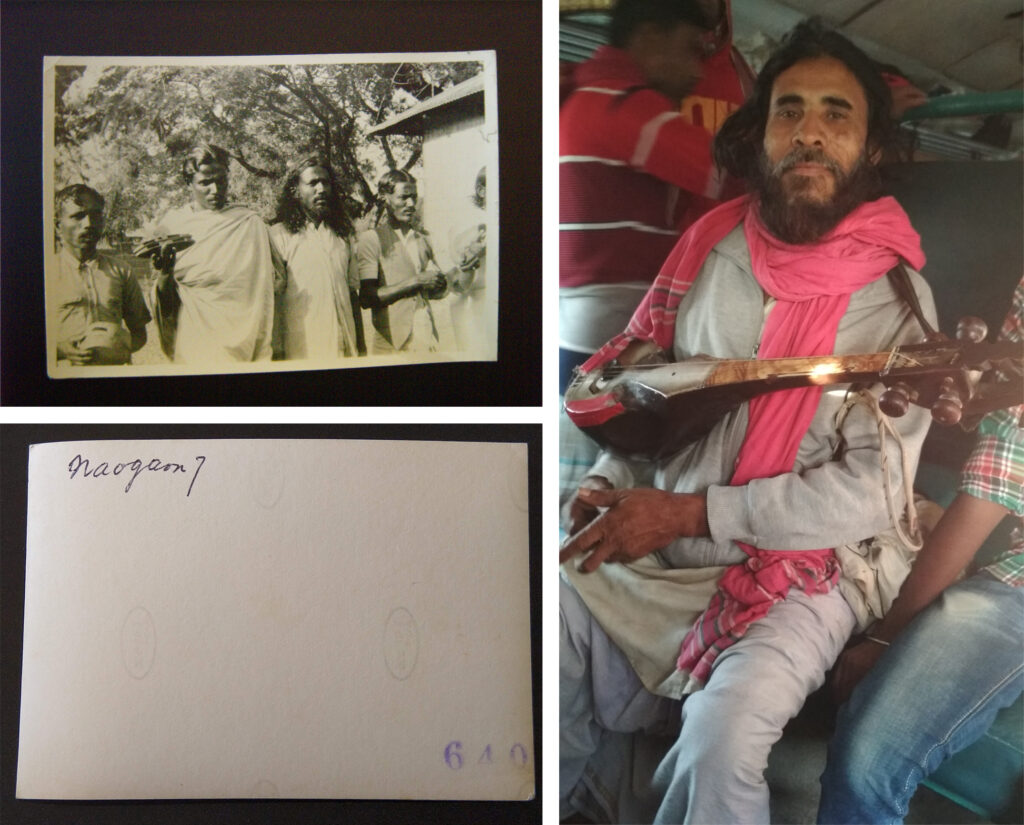
Arnold Bake took a series of photos of the Naogaon fakirs. This one was marked Naogaon 7. The man sitting opposite us on our train to Santahar said his name was Ataur Rahaman Chishtia or Shah Alom. His home was in Lalpur thana of Natore district, he said, but he goes roaming and singing and that is what he does for a living. Slowly we talked more and he sang for us too. He said he was going to Ishwardi to fix his instrument, I asked him if he would come with us on our trip, he said he had work to do, I asked if it could wait for a day. Other people on the train said, how can he go with you? He has a living to make by singing. So then we reassured them and said that if he came for the day, we would certainly take care of his earnings for that day. At which he agreed to come with us. Then he said, best would be for us to get down at Akkelpur. We could then set out on our journey.
Ataur Rahaman Chishtia sings. Milon hobe kotodine, Char peyala hrid komole, Ami opaar hoye boshe achhi, all songs of Fokir Lalon Sai. And in the second clip, he talks about how he came into this spiritual line of music.
At Akkelpur, we met one of Uday’s students and went to her house to freshen up. Then we hired an auto rickshaw and went in the direction of a place called Dariapur. Perhaps it would be the Dariapur we were looking for? Now Ataur Rahaman was our guide. There was someone he had in mind, a singer, whose house we went to, but the man was not at home. We could find him in Badalgachi, we were told. All these places were within close proximity. So next we went to Badalgachi, to a kind of club where local singers meet. Here we met several people, who explained to us that this was most probably not our Dariapur, but the best place for us would be Shailagachi. (Perhaps that was Arnold Bake’s Shoregachi?) Meanwhile, the singers of Badalgachi also listened to the Bake recordings and sang some songs for us.
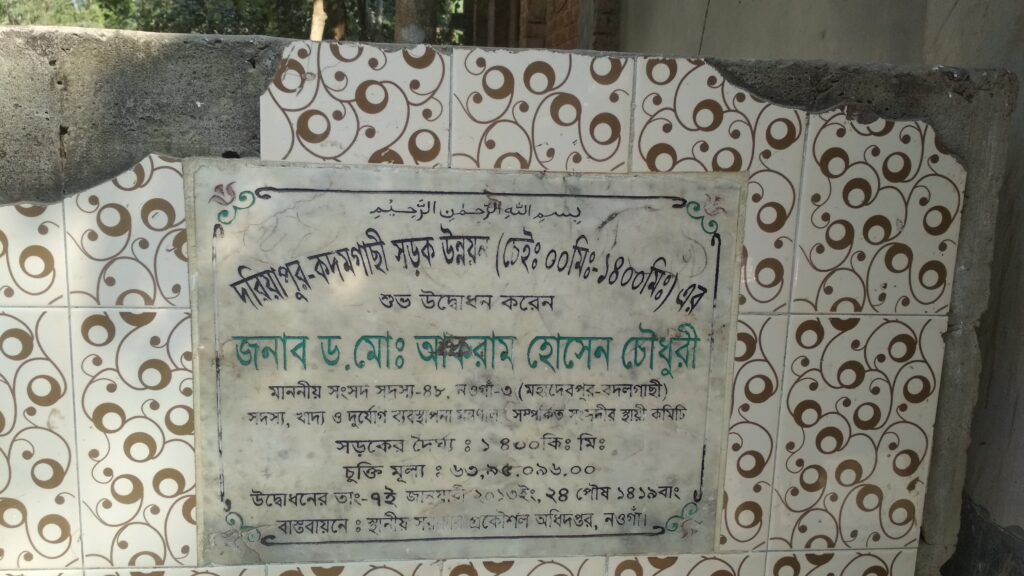
A plaque in the wrong Dariapur
Aroj Ali of Badalgachi Shilpi Goshthi sang for us.
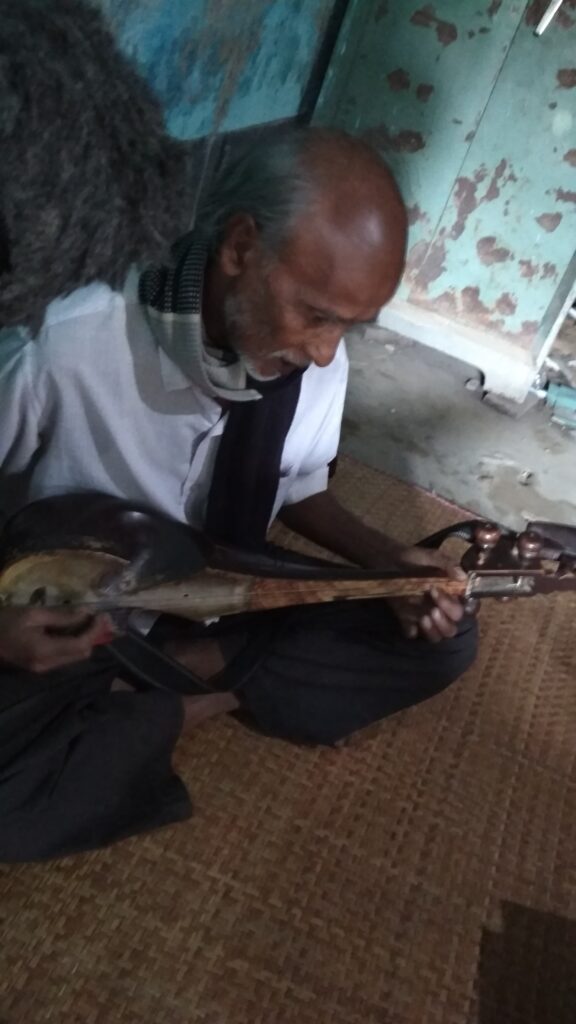
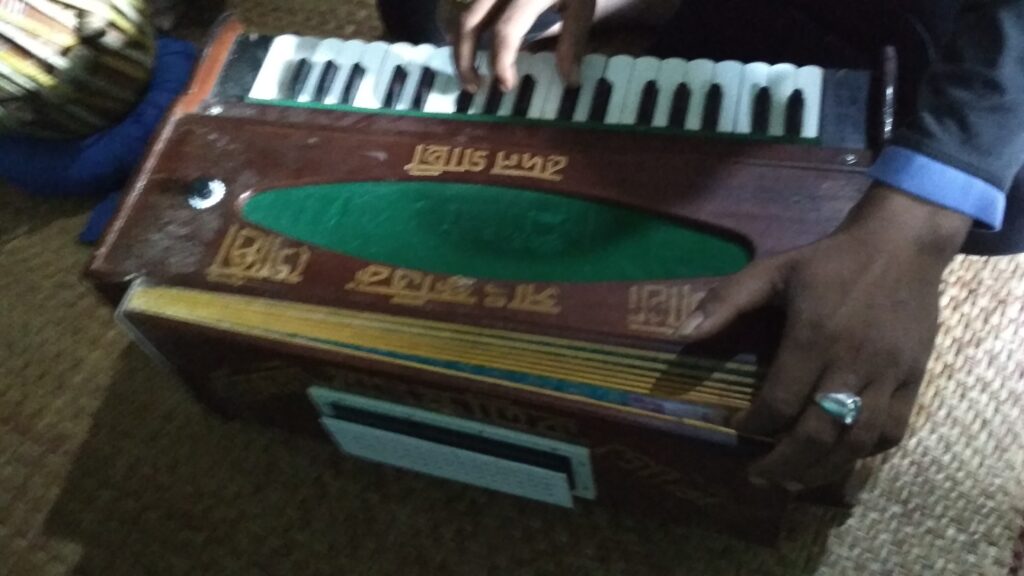
Aroj Ali sings
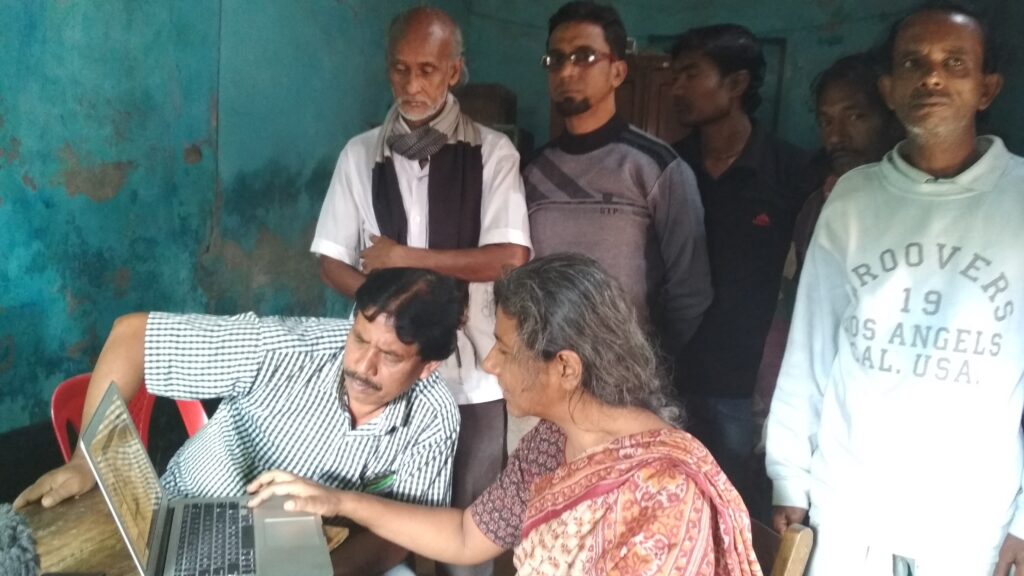
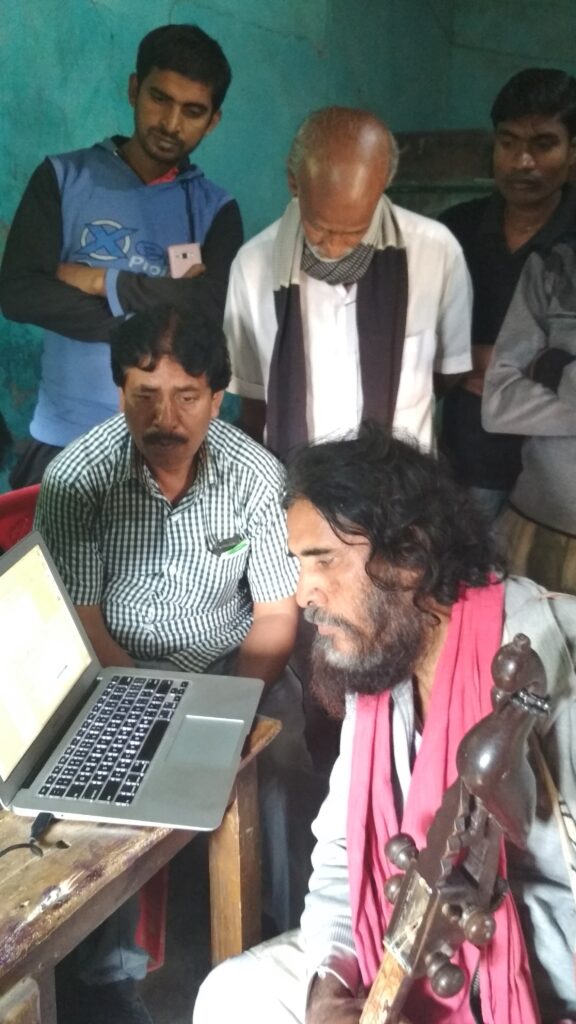
Listening in Badalgachi
Next stop was Shailagachi, via Pintur More. There were some comic moments along the way. At Pintur More, we asked for directions to the house of Rahim Chand. Why Rahim Chand?
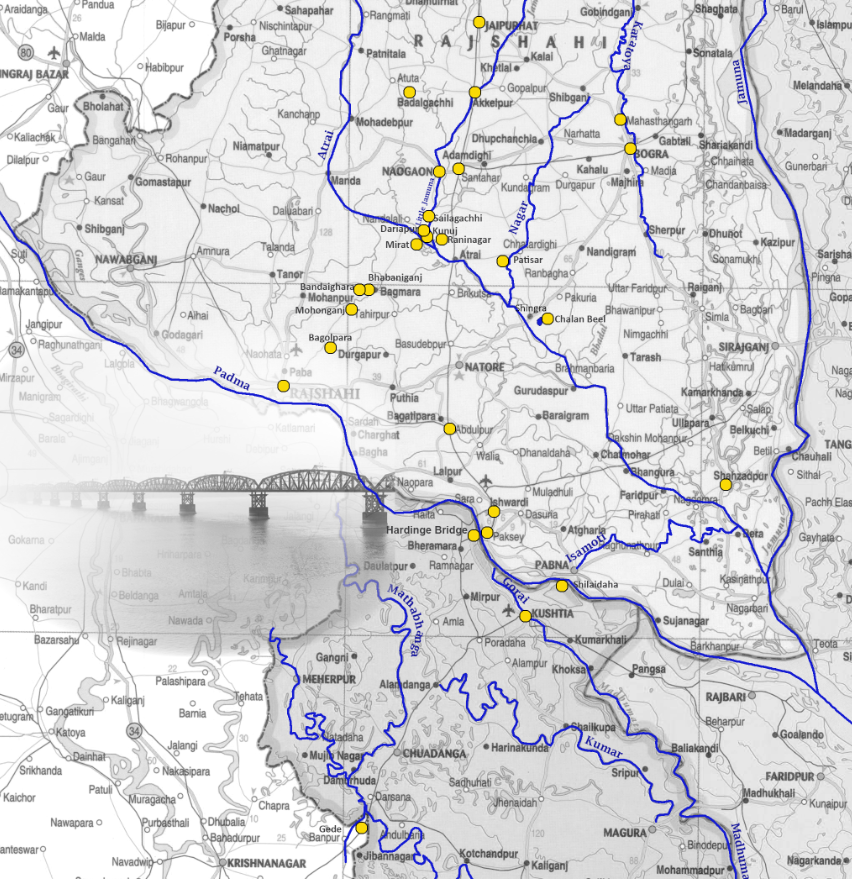
Map of all the places we went to in Rajshahi in search of the Naogaon singers of Arnold Bake. Includes image of Hardinge Bridge by Sarker Protick. Map designed by Purba Rudra
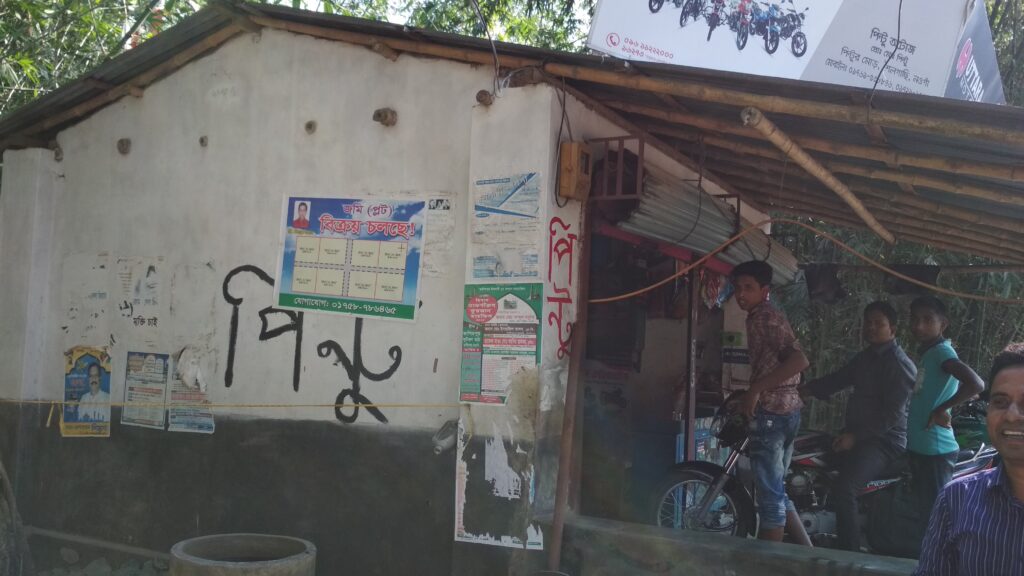
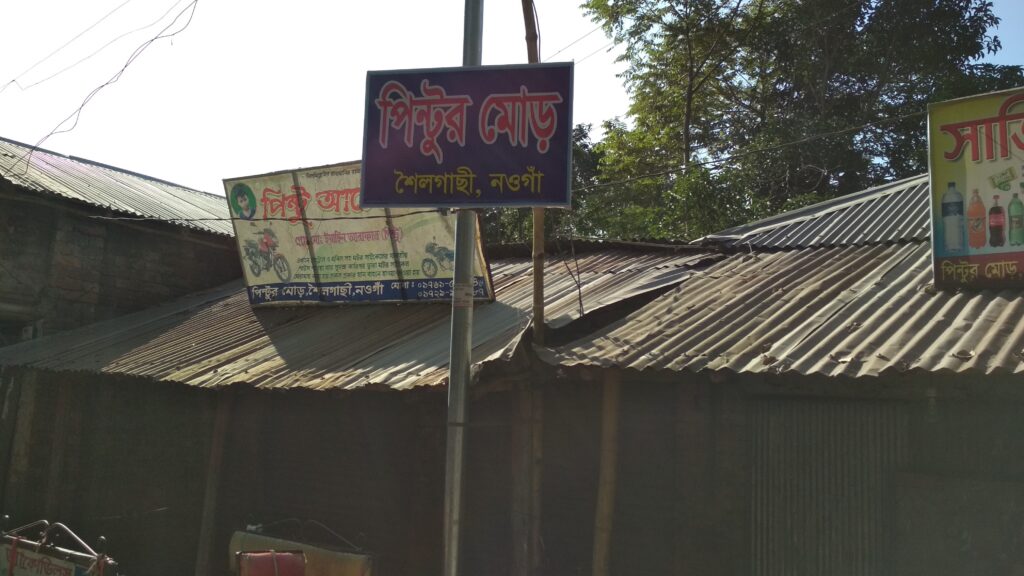
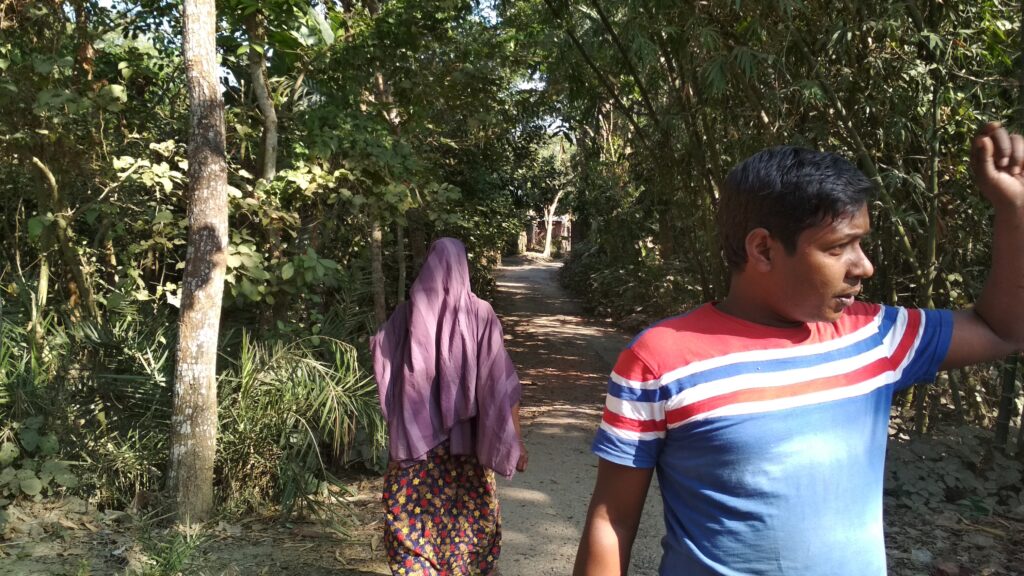
It was Ataur Rahaman Chishtia who suggested that we go to the house of Rahim Chand Dewan, a famous singer of Shailagachi. This was a family of musicians. Rahim Chand was dead, also his eldest son, singer Abu Bakkar. But Rahim Chand’s widow, Bilkis, who was also a singer, could know something. Rahim Chand would be about a hundred if he was alive. So he could have known Bake’s singers.
One of Rahim Chand’s sons is the famous flautist of Bangladesh, Jalal Ahmed. Yet economically, they are people who live on the margins of society.
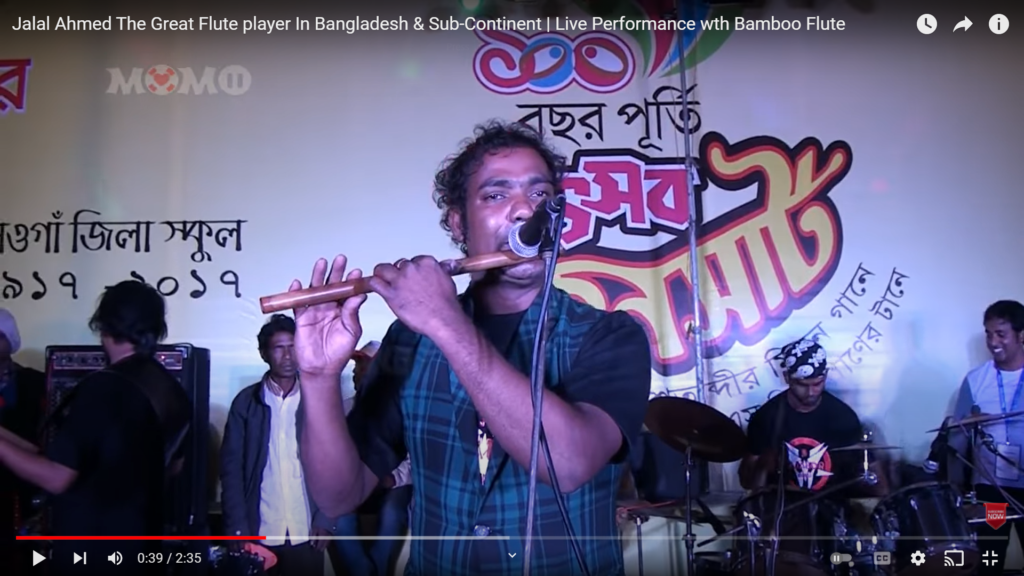
Finally, we reached Shailagachi. The sign board had something interesting inscribed on it: an NGO named Moushumi!
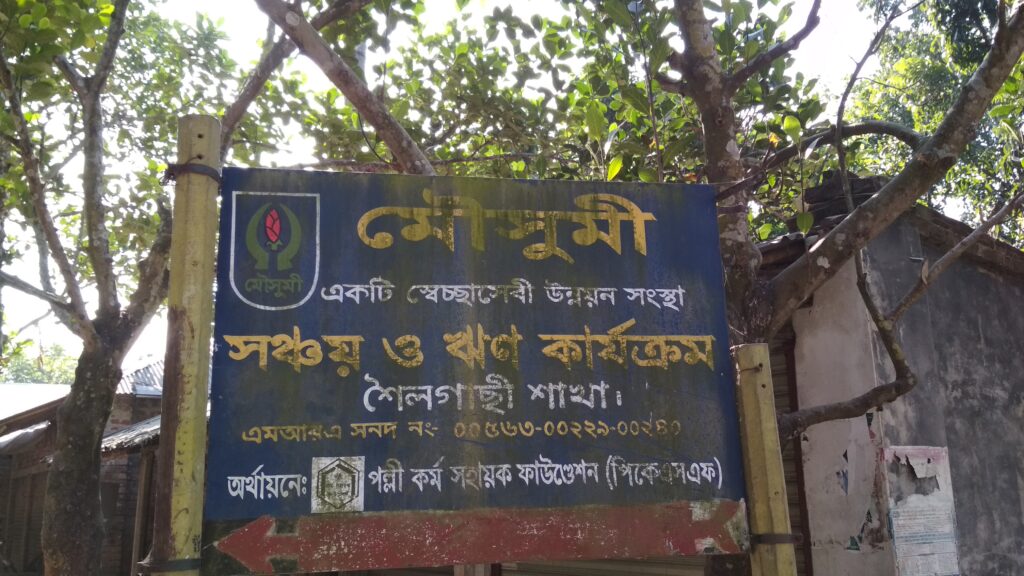
Ten-year-old Ahsan Habib takes us to the house of Rahim Chand Dewan. We reach the door of Kabari Dewan.
Kabari Dewan’s tin door was half open and we went in. This was the house of Abu Bakar Dewan. He had two wives, Kabari was the younger one. Is your mother-in-law in? Ataur Rahaman asked. No, she is in the other house, she replied. Can you call her? I don’t have her number, she said. There was clearly some tension between mother and daughter-in-law. Never mind that. Kabari’s voice was husky. Her face was a little swollen. She said she had only just come home from a night-long soiree.
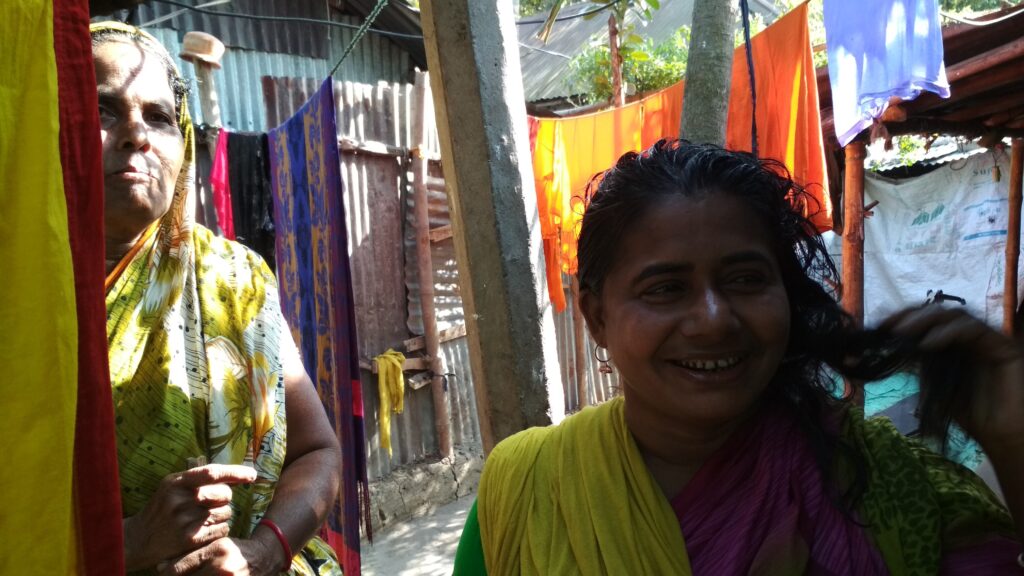
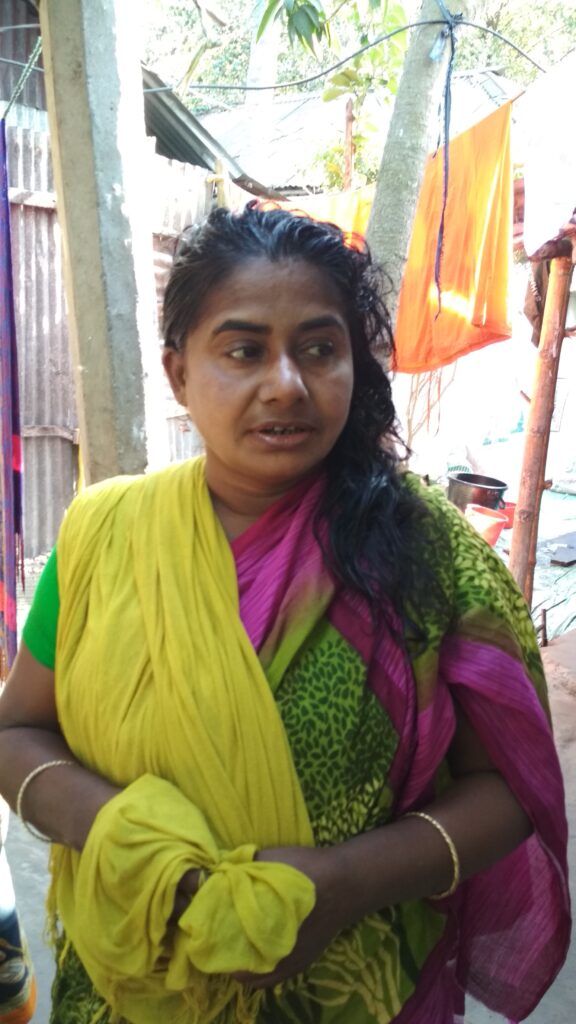
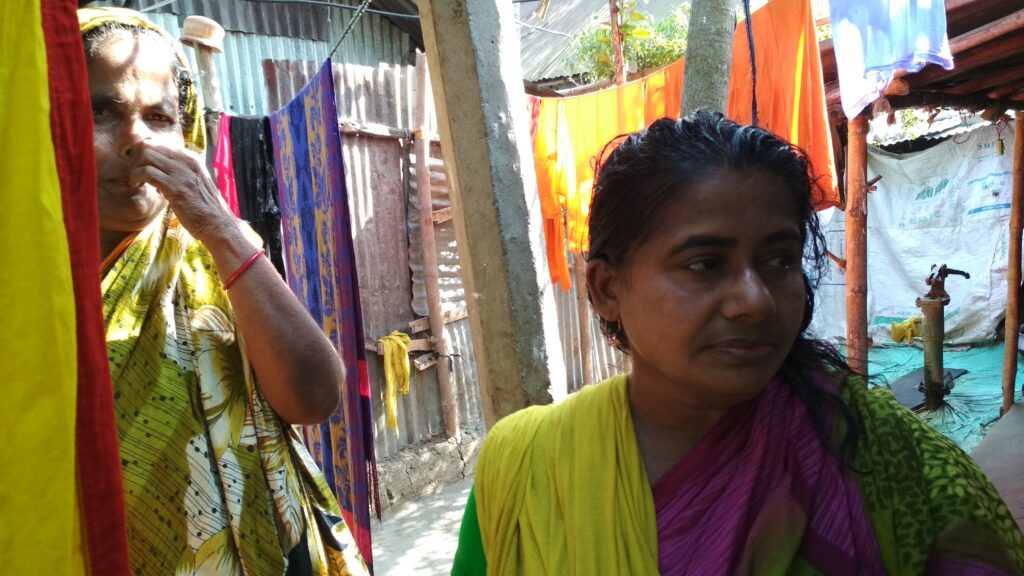
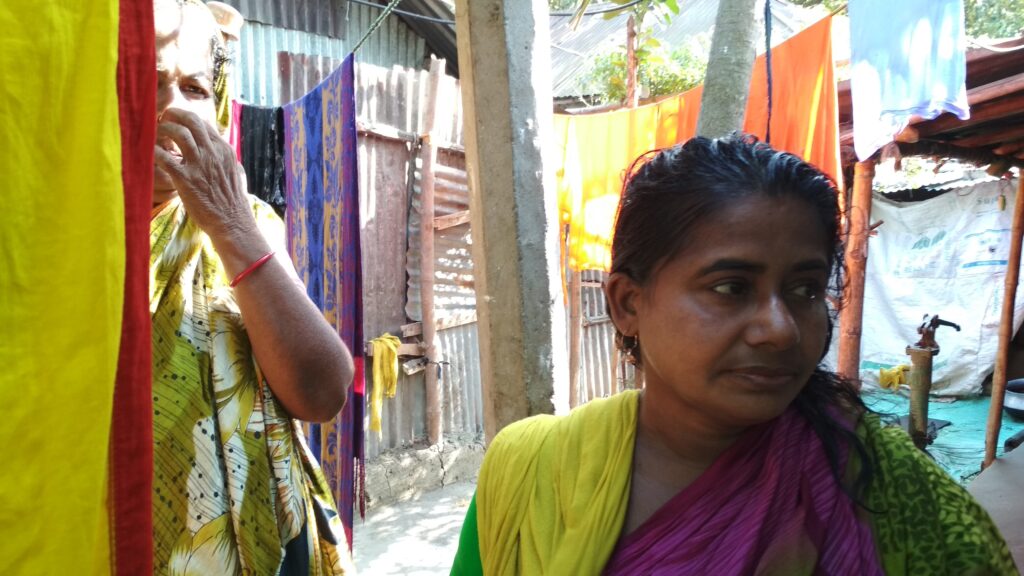
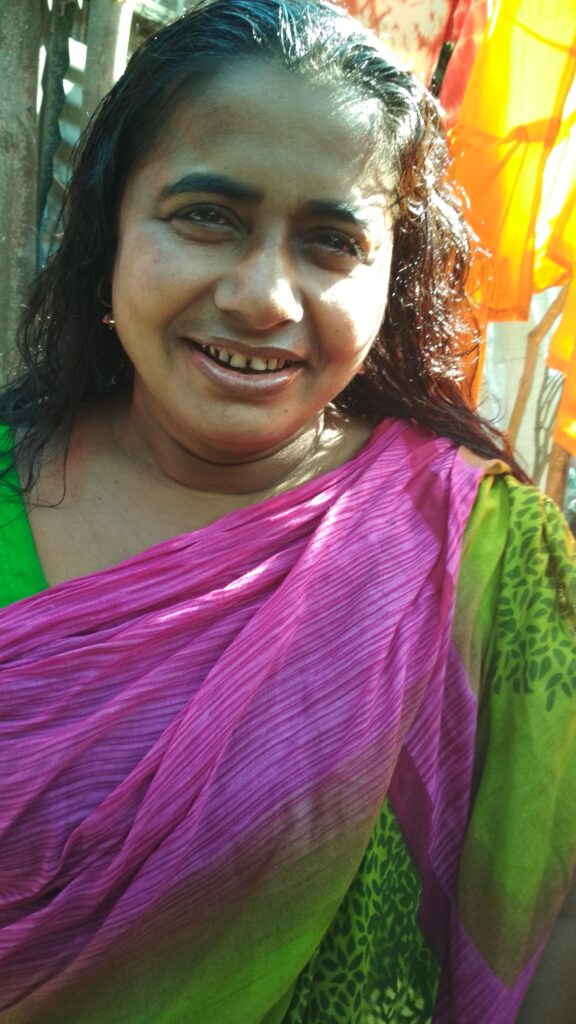


The Naogaon Fakirs Arnold Bake had recorded were all men, except for one fakirni, Her name was Jaura Khatun Khaepi. Jaura? Johura? I had her image from the archives, I also had her voice. Arnold Bake had specifically mentioned her in his letter to his mother on 2 March 1932. I had song collector Mansooruddin and author and civil servant Annada Sankar Ray’s reminiscences of her, but who exactly was she?
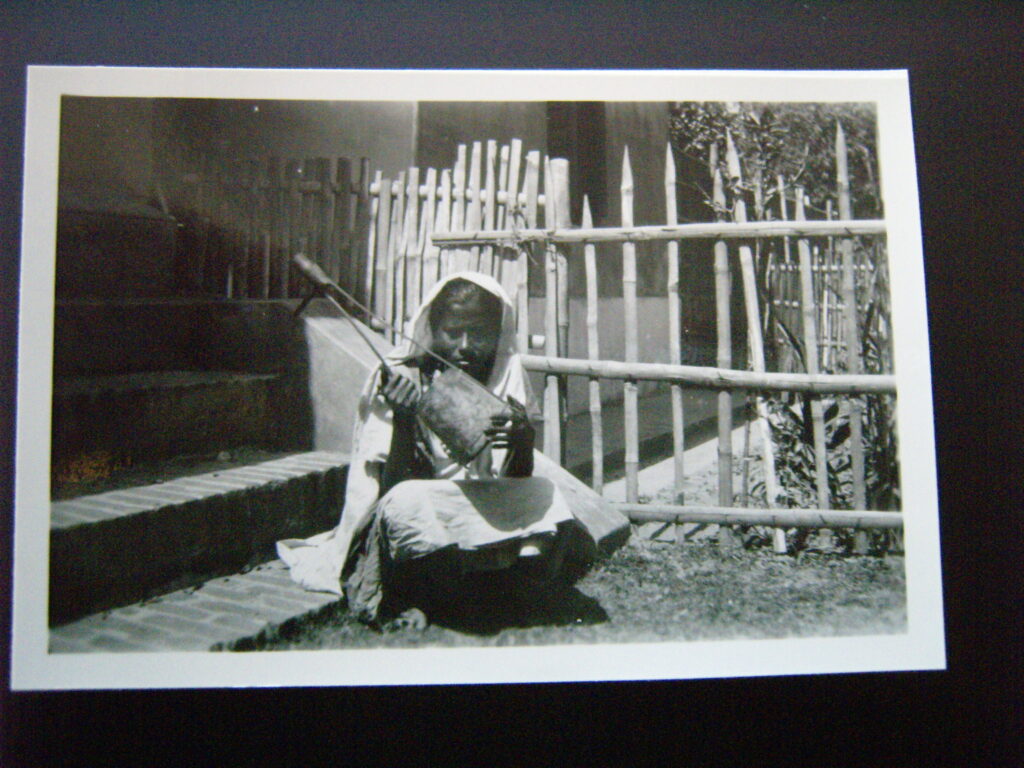
Photo of photo, taken when I was working on the Arnold Bake Collection in the Special Collections section of the Library of Leiden University, in 2015.
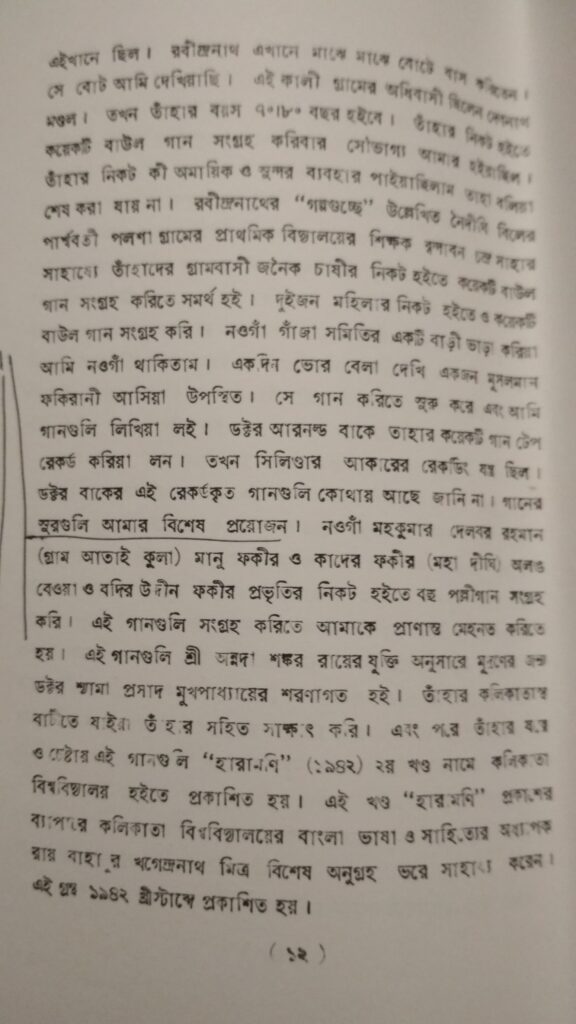
Page from Mahammed Mansooruddin’s Haramoni, Vol 8. (Dhaka: Bangla Academy, 1976)
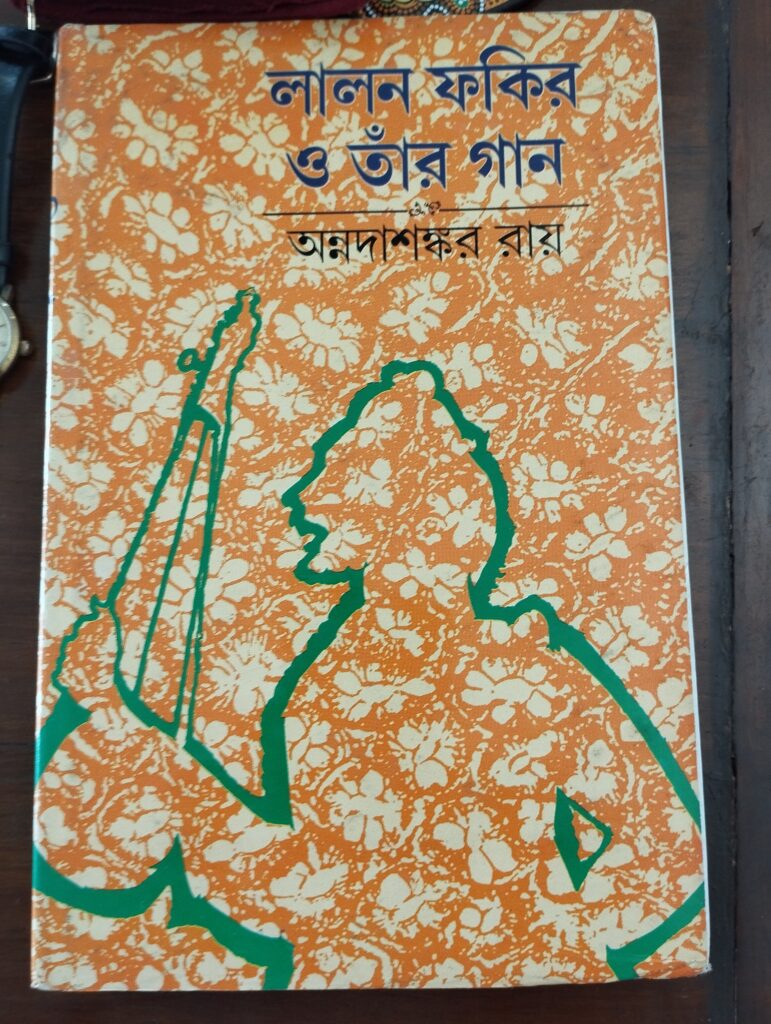
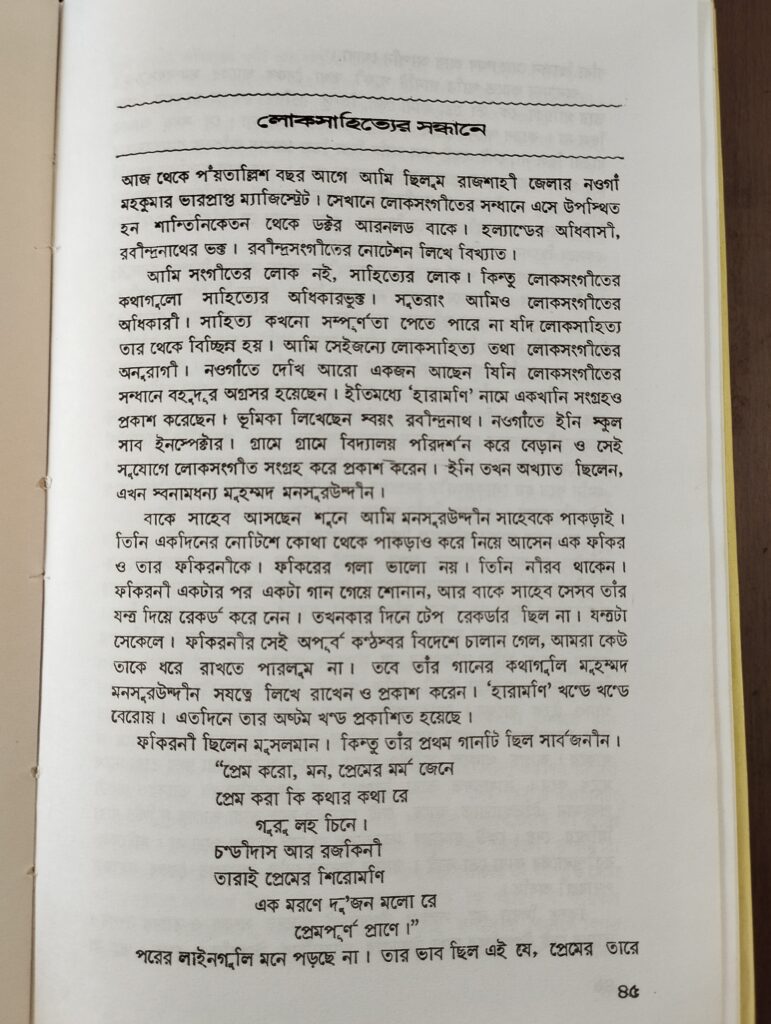
In 1978 the late Bengali poet and essayist, also a civil servant in British India, Annada Sankar Ray, published a book Lalon O Tanr Gaan on Lalon Fakir, the famous nineteenth century mystic poet of Bengal. There is an essay in the book entitled Loksahityer Sandhane (In Search of Folk Literature) which starts with the author reminiscing about an incident which took place ‘about 45 years ago’, which must have been 1932, when he was posted as the sub-divisional officer in Naogaon. division of Rajshahi district in undivided Bengal, now Bangladesh.
‘There arrived one day a man from Santiniketan, in search of folk songs. Dr Arnold Bake, Dutch citizen, admirer of Rabindranath Tagore, who was famous for his transcription of Tagore’s songs. . . In Naogaon there was another man who had come a long way with his collection of folk songs and who had already published an anthology of these songs, Haramoni [Lost Jewels], with an Introduction by Tagore himself. He was a sub-inspector of schools in Naogaon. While he went about the countryside on his inspection duty, he also collected [texts of] folk songs from people. Not many knew of his work then, but today he is the famous Mohammad Mansooruddin.
‘When I heard of Bake’s visit, I put Mansooruddin on the job. Within just a day he got hold of a fakir and fakirni; who knows where from? The man’s voice was not great, so he was mostly silent. The woman sang one song after another and Bake saheb recorded them with his machine. There weren’t any tape recorders in those days. Bake’s instrument was old-fashioned. The beautiful voice of the fakirni got packed and sent abroad (the precise word Ray uses is ‘chalaan,’ which means invoice and thus conveys a sense of transaction. Her voice got chalaaned, Ray writes). We could not keep her. However, Mahammed Mansooruddin wrote down the songs and later published them. Haramoni is being published as volumes and recently the eighth has come out.
‘The fakirni was Muslim. But the sentiment of the song she sang was universal. Prem koro mon, premer marma jene (Love, O heart, knowing what love is worth/It is no easy game/ Learn to seek and find your guru.)’
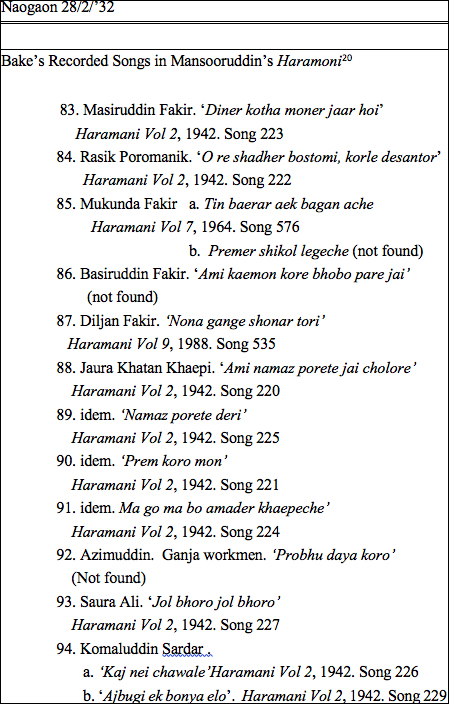
Mansooruddin’s ‘recordings’ of the songs that day when Bake was making his recordings on wax cylinders are scattered in various volumes of his Haramoni. The song that Annada Sankar Ray remembered all those years later, had appeared as song 221 in Haramoni Vol.2, published in 1942.
Kabari talked about love and loss. The men had moved to the adjacent house of Rahim Chand’s other son, Habibur Rahaman, while Kabari and I had kept talking. Her husband had died only a year ago and then her only daughter too had died. It was her love of music and love for this man that her brought her into this life. Now all is lost, nothing remains, she whispered.
Somehow, for me, the empty corridors of the ganja society office where we had been in 2015 and Kabari’s voice, talking about love, loss and longing began to become one and the same thing. This video, which I used during my Artist Talk for Chobi Mela X in Dhaka in 2019, was made by Sukanta Majumdar, based on my script. The audio recording is mine. Images are collectively authored by The Travelling Archive.
After talking with Kabari I went to meet Habibur Rahaman. Ataur Rahaman steered the conversation—he had indeed become our leader that day.
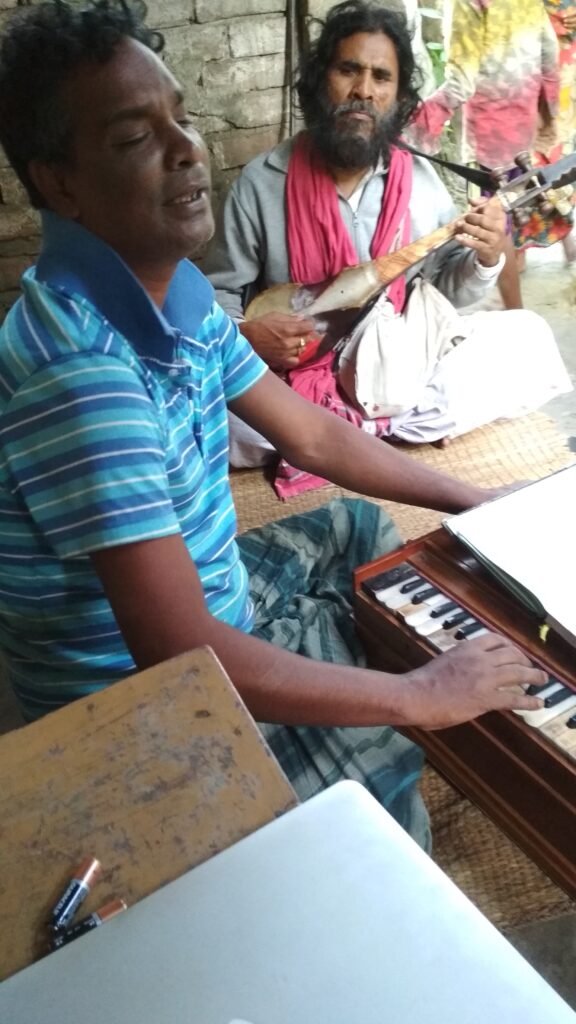
Habibur Rahaman sings while Ataur Rahaman accompanies him on the dotara. He sang a Lalon song and one of his own.
More importantly, he asked me, why was I looking for these places and people? What would I do with this knowledge? And then I had to think very hard. How to answer such a easily-worded but extremely difficult question? I talked about the flow from Bake’s voices to his own and how with the voices of Bake we cannot know who the people were, but they were real people, like you and me. And so I want to know who the voices belonged to. Just as it is important for people to know who you are, I told Habibur Rahaman.
It was Ataur Rahaman Chishtia, sometimes Uday Biswas, sometimes Shoikat Arefin who were taking the lead on this field trip. I was more the observer. So, in the recording above, you can hear Shoikat ccoming into its frame, announcing that there was indeed a village called Kunij and one called Dariapur too, not far from where we were! Ah, so we had found them then! It was getting late in the afternoon and we would have to return to Rajshahi, so we would not be able to make it to Kunij or Dariapur that day (the actual name of the place is Kunuj, as we would learn on the next trip). That visit would have to wait for another time.

